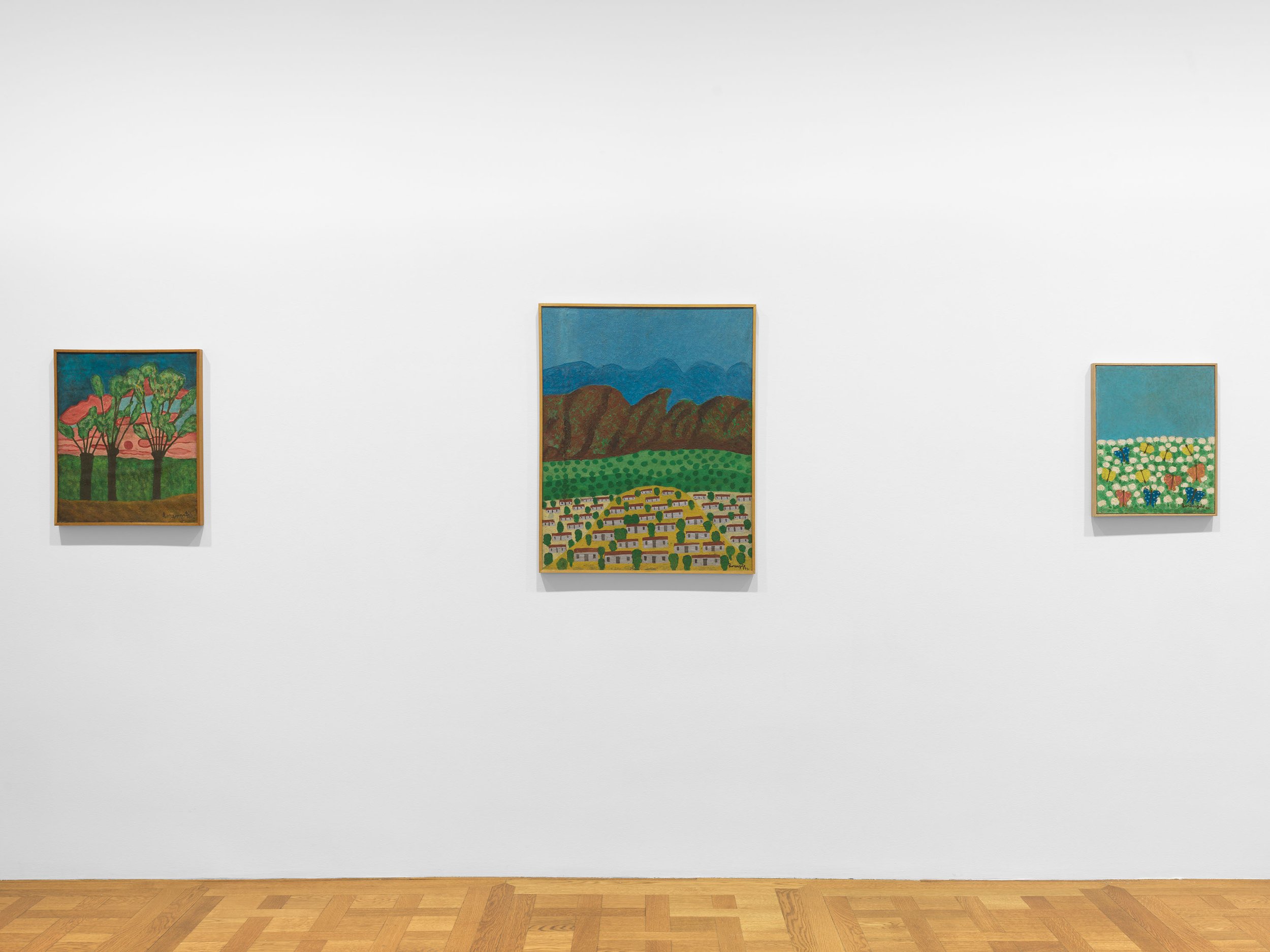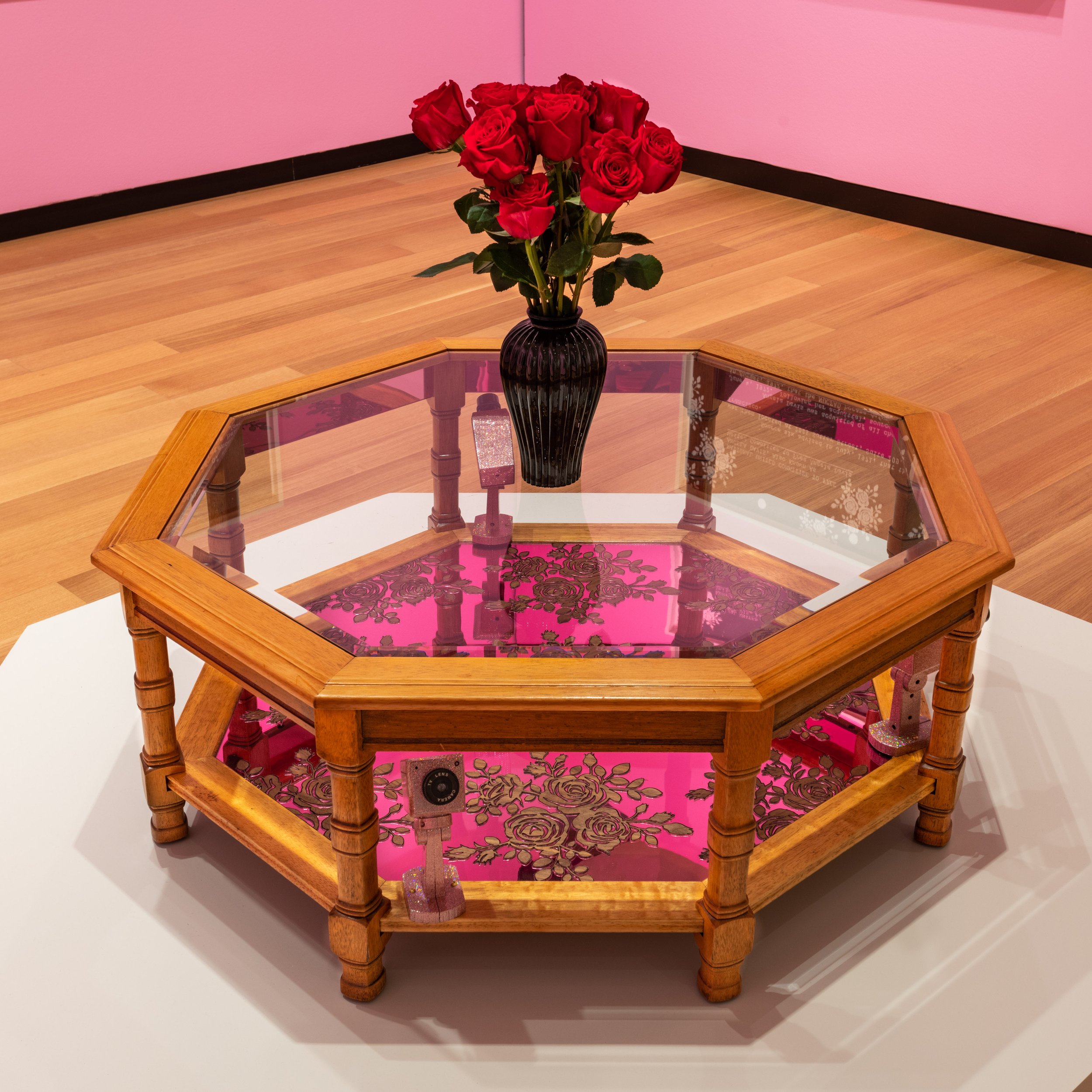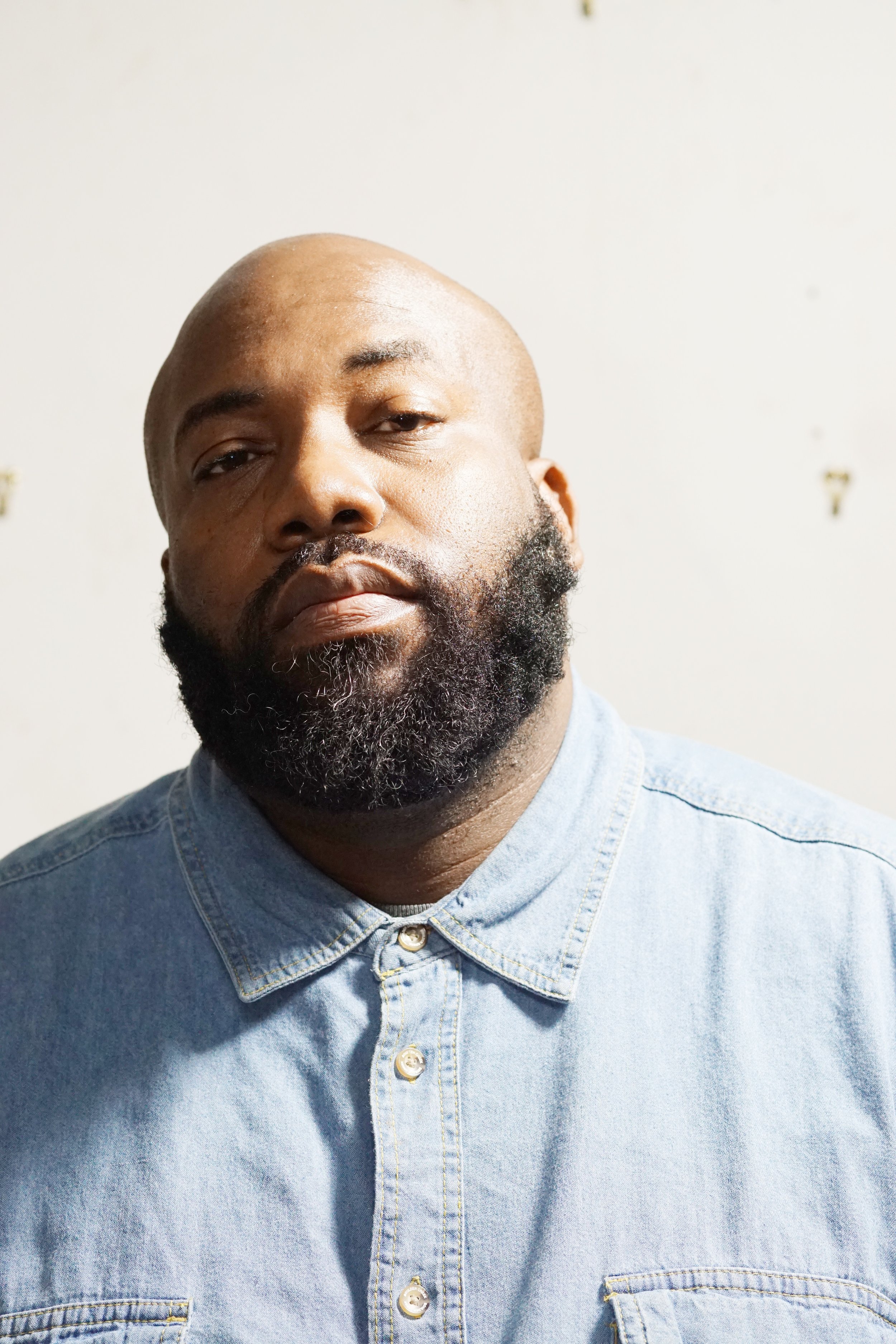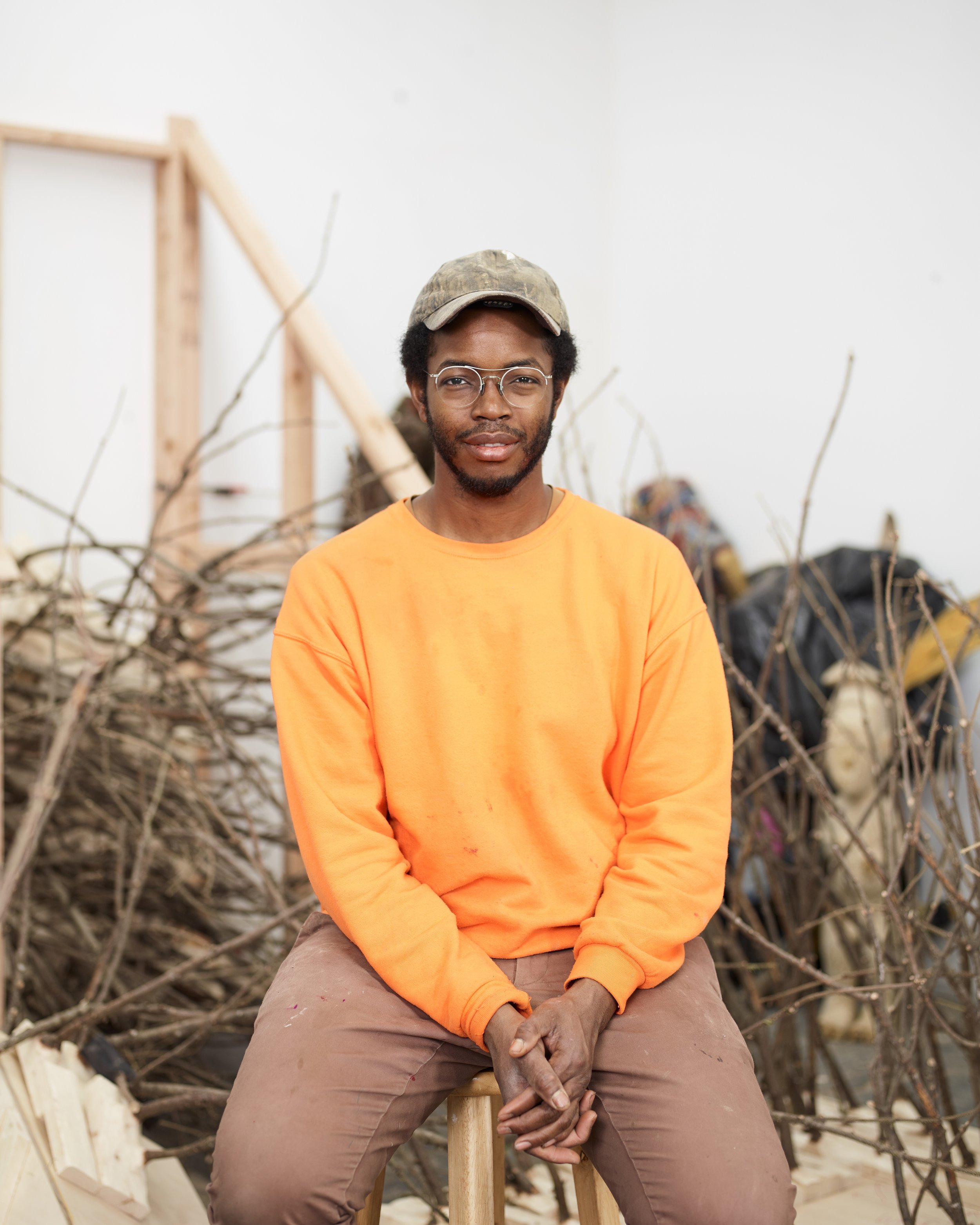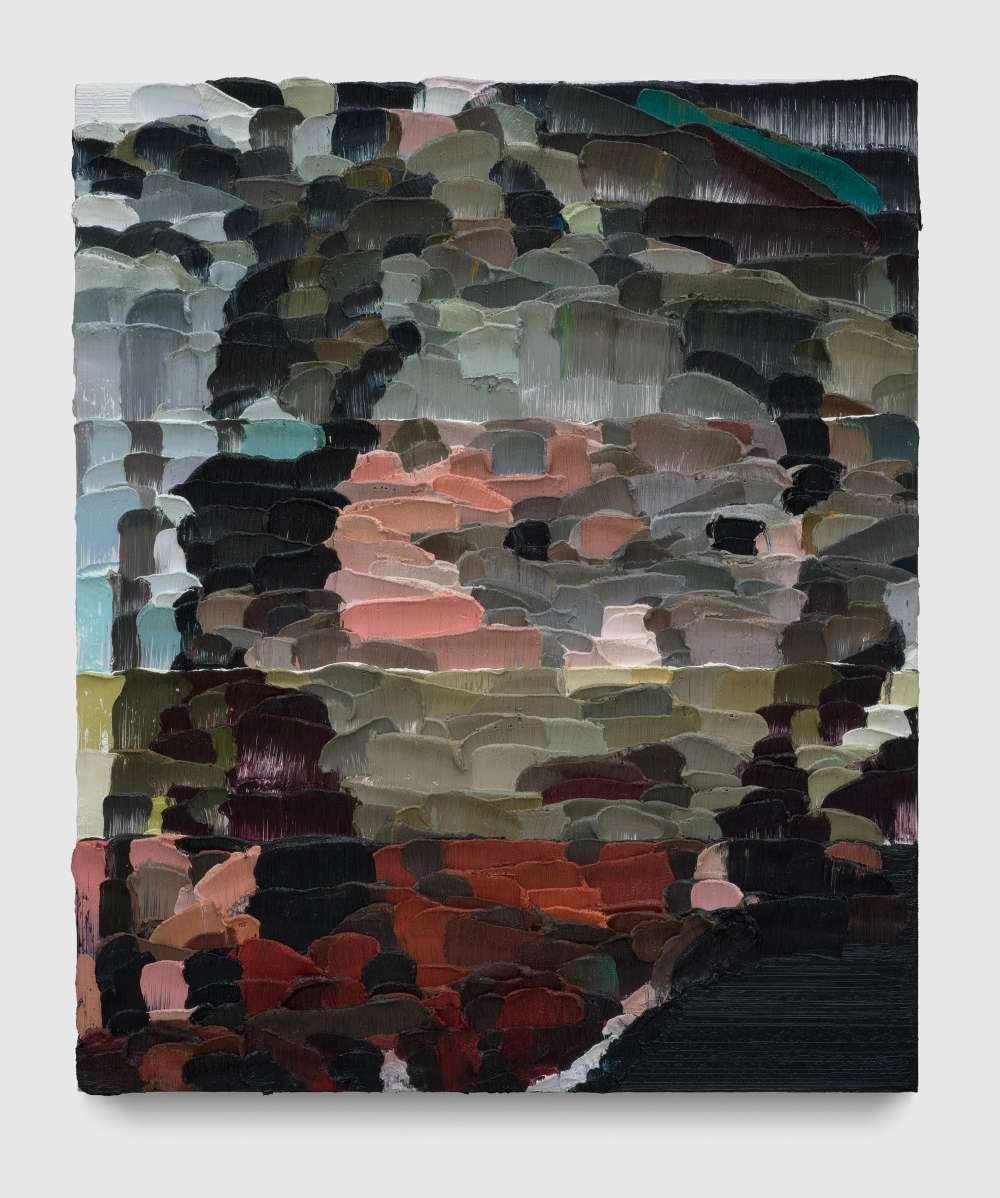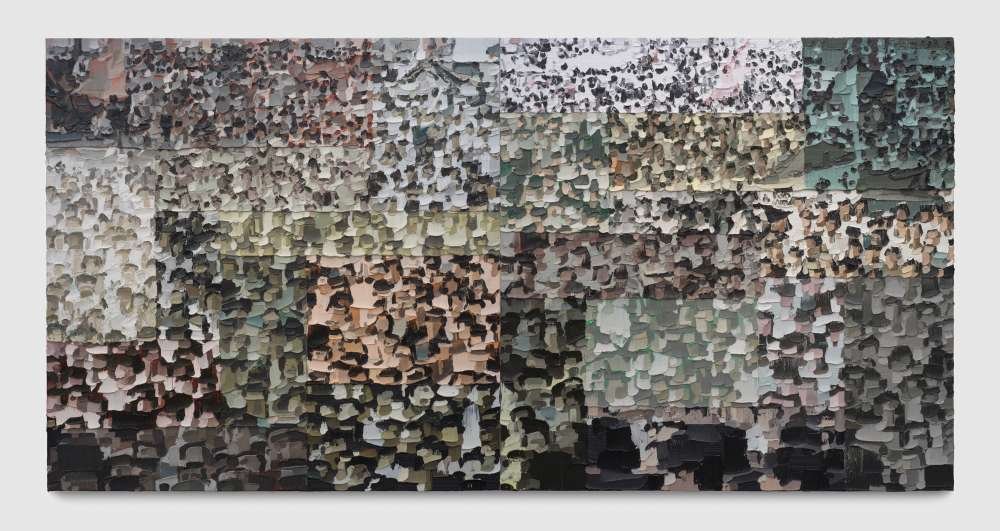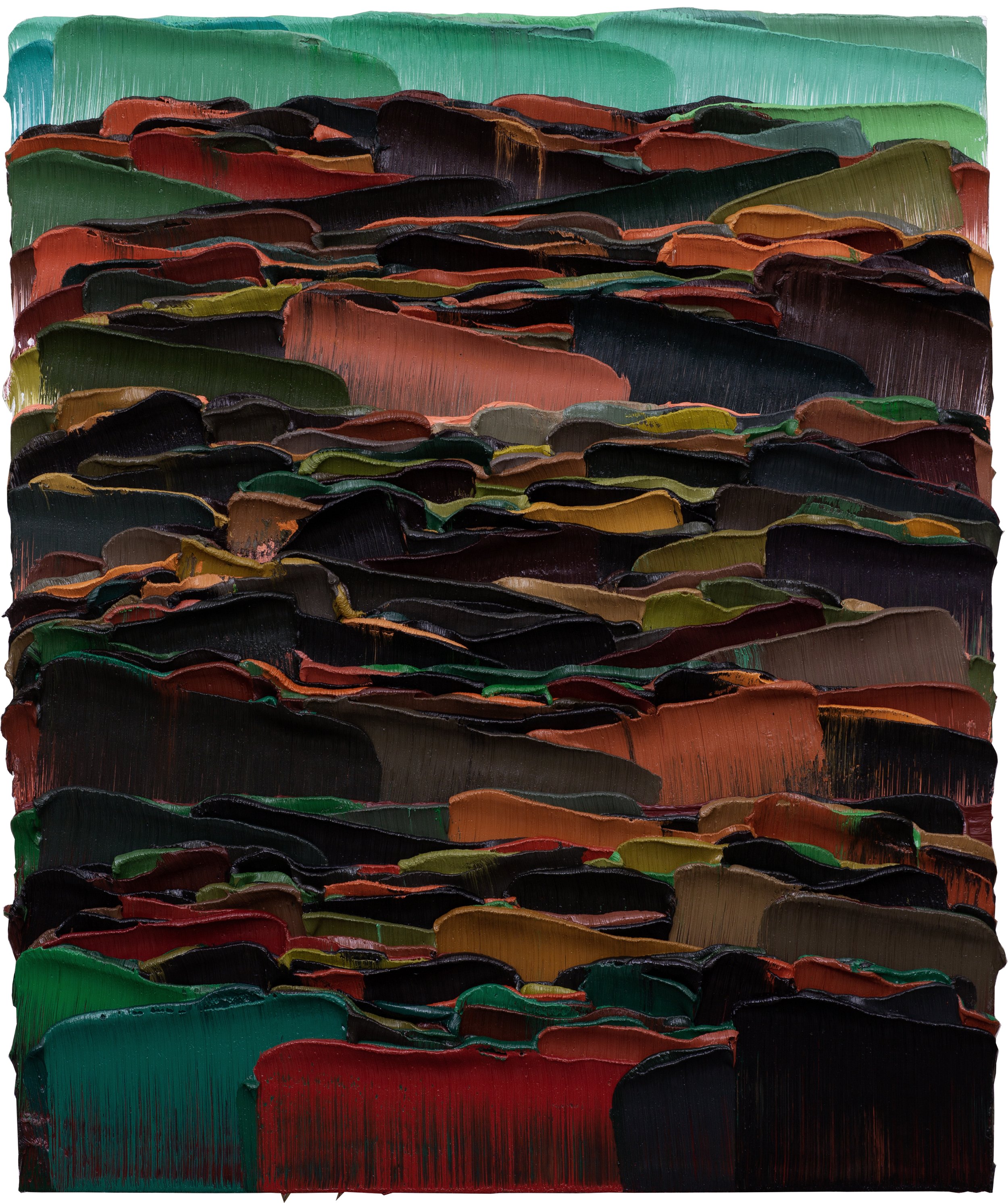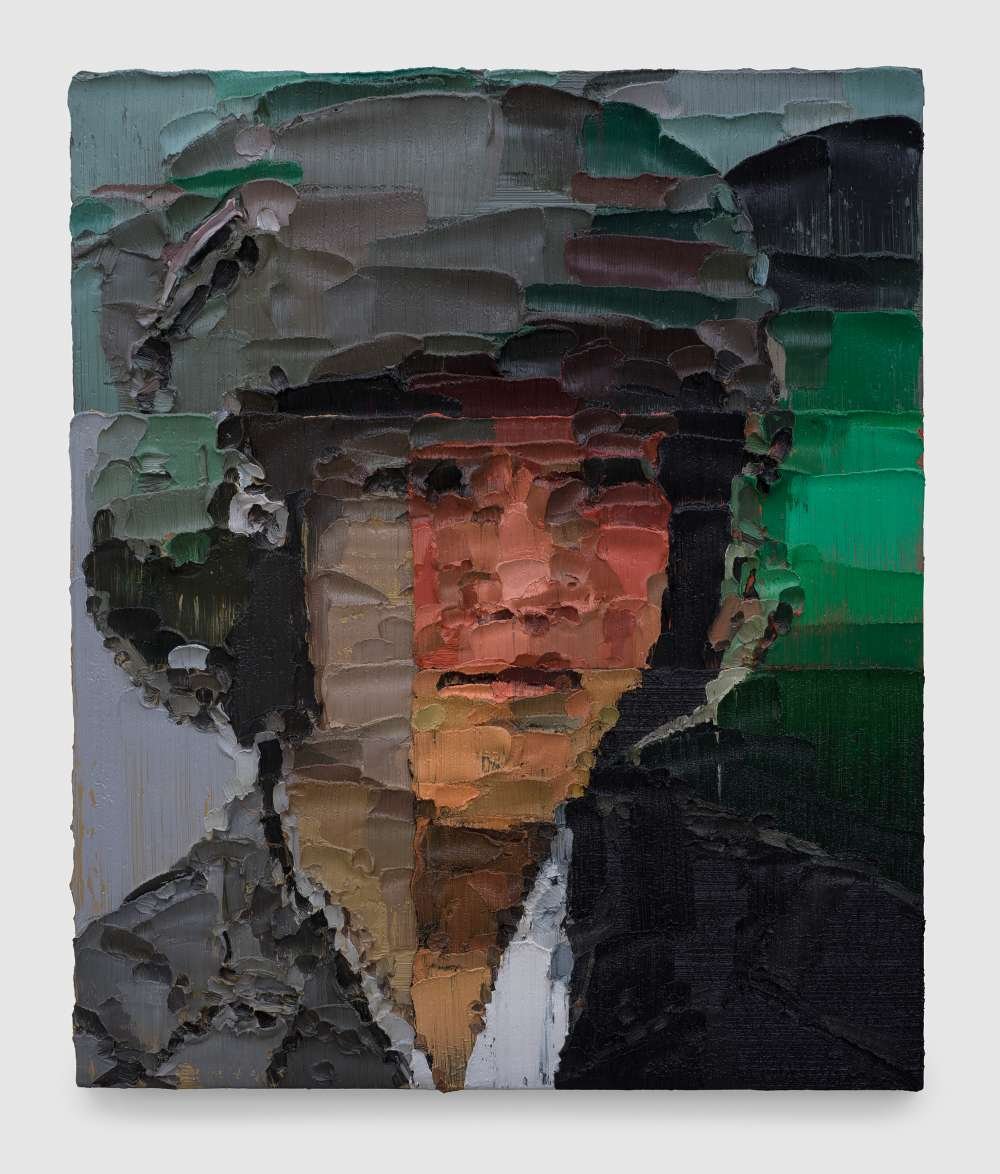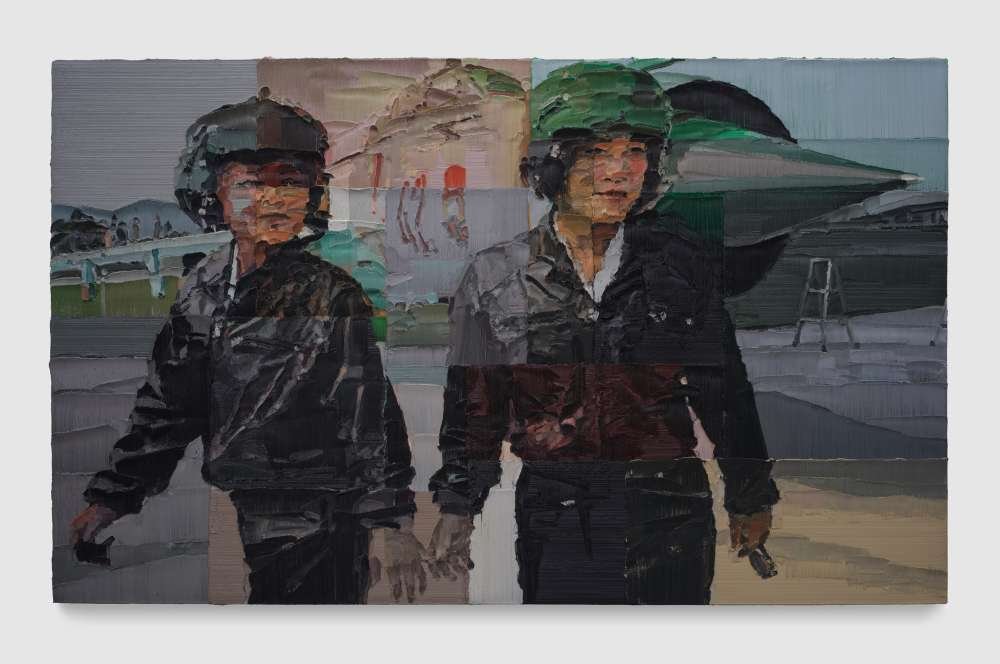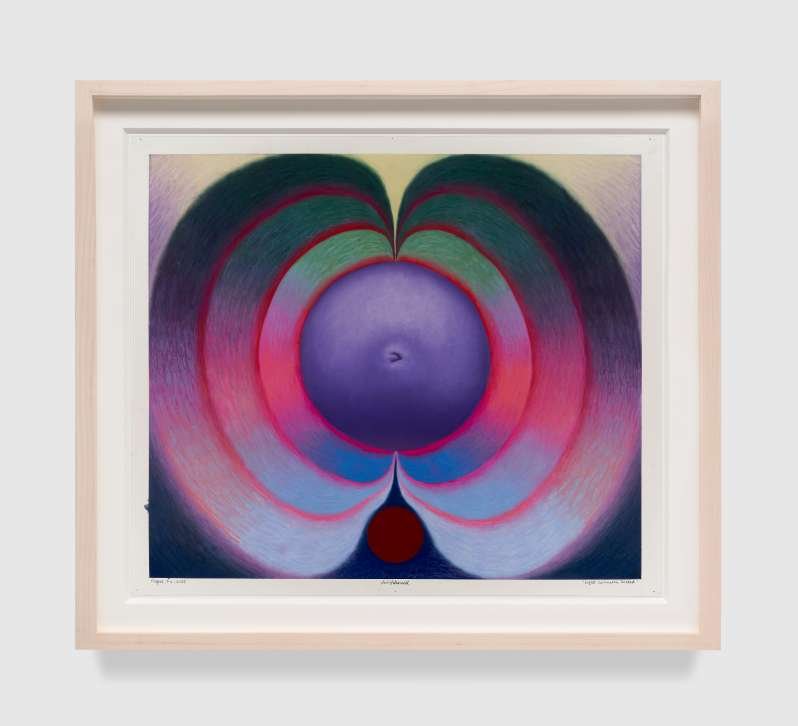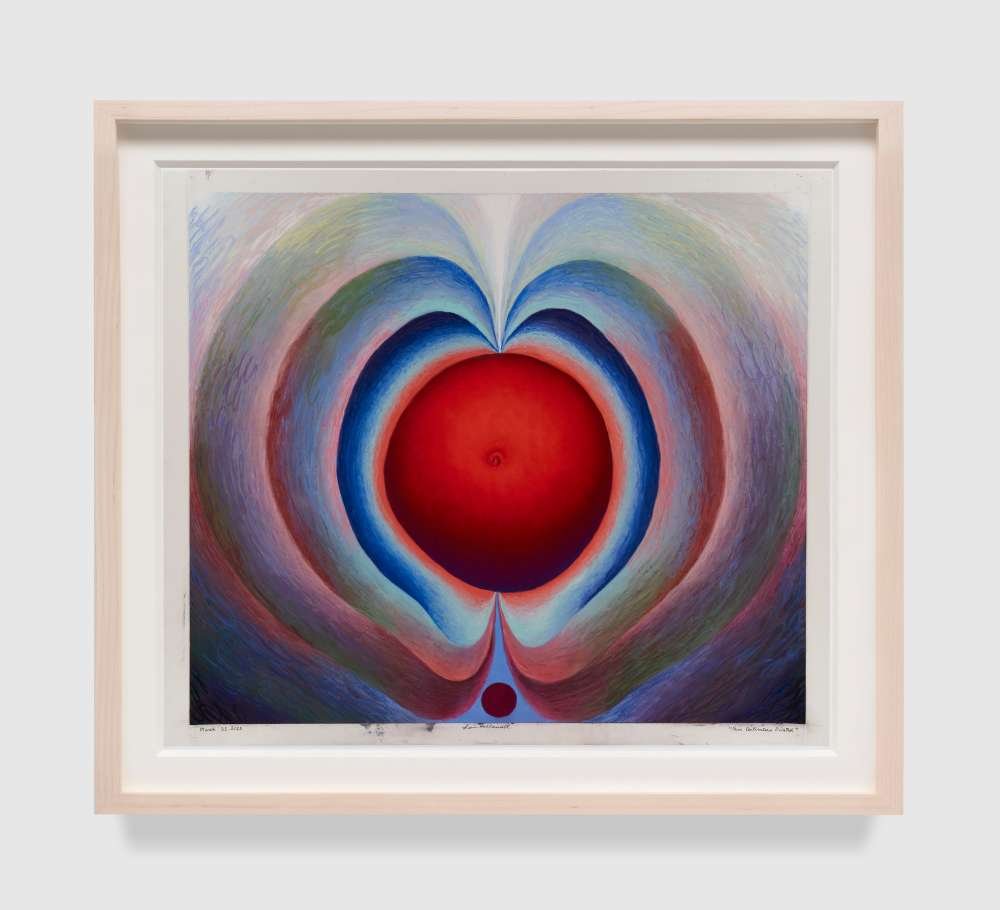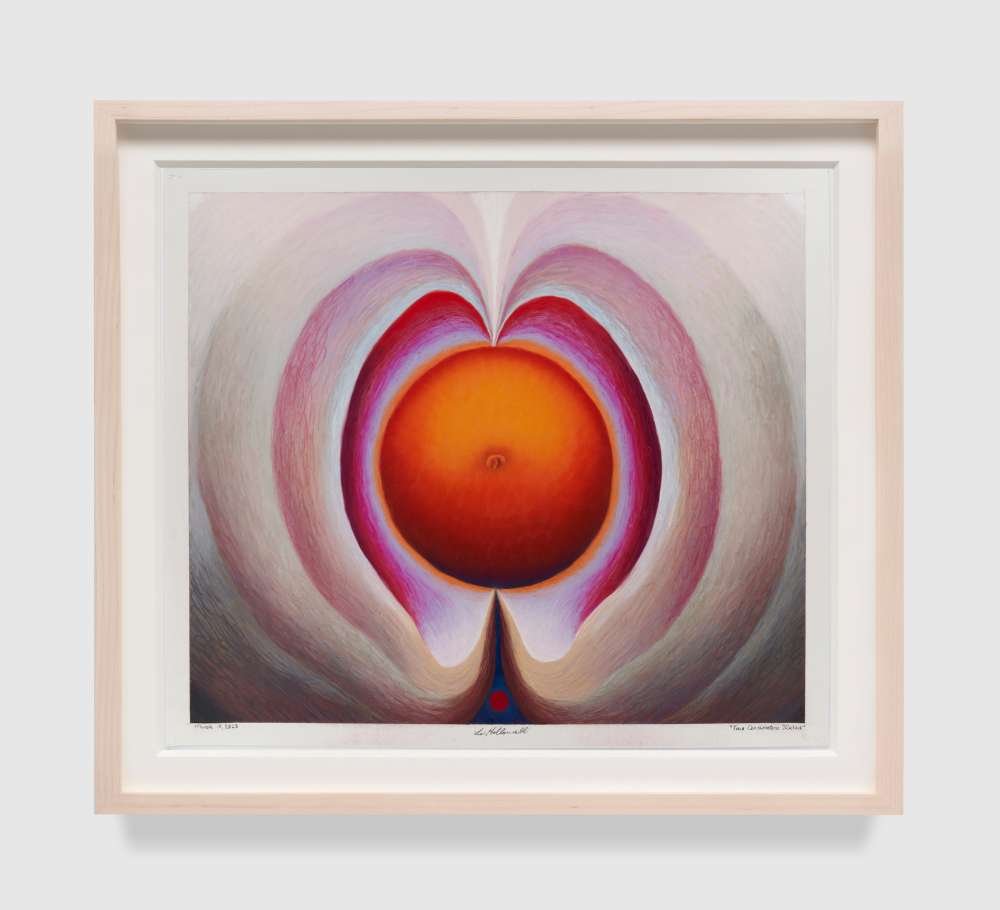Lucas Arruda : Assum Preto
Lucas Arruda, Untitled (from the Deserto-Modelo series), 2022 © Lucas Arruda. Courtesy the artist and David Zwirner
David Zwirner is pleased to present new work by Brazilian artist Lucas Arruda, on view at the gallery’s 537 West 20th Street location in New York. The exhibition includes paintings and a site-specific light installation from his ongoing Deserto-Modelo series, marking the artist’s fourth solo presentation with the gallery.
Lucas Arruda, Untitled (from the Deserto-Modelo series), 2022 © Lucas Arruda. Courtesy the artist and David Zwirner
Assum Preto continues Arruda’s investigations into the painted medium and its ability to serve as an evocative and transcendental conduit for the unveiling of light, memory, and emotion. The exhibition is titled after a species of blackbird native to eastern Brazil—whose mundane birdsong, according to local tradition, is said to transform into a beautiful melody if the bird’s eyesight has been shaded. As the artist explains: “It’s as if, when the bird has everything in sight, and is full of information and distractions, it can’t organize itself. Only when it’s no longer surrounded by images, can it organize everything in its head. In a certain way, I think this has to do with light.... For me, light is related to remembering.”1 In the works on view, light takes on a multitude of forms, surfacing in various physical, ideographical, and affective manifestations.
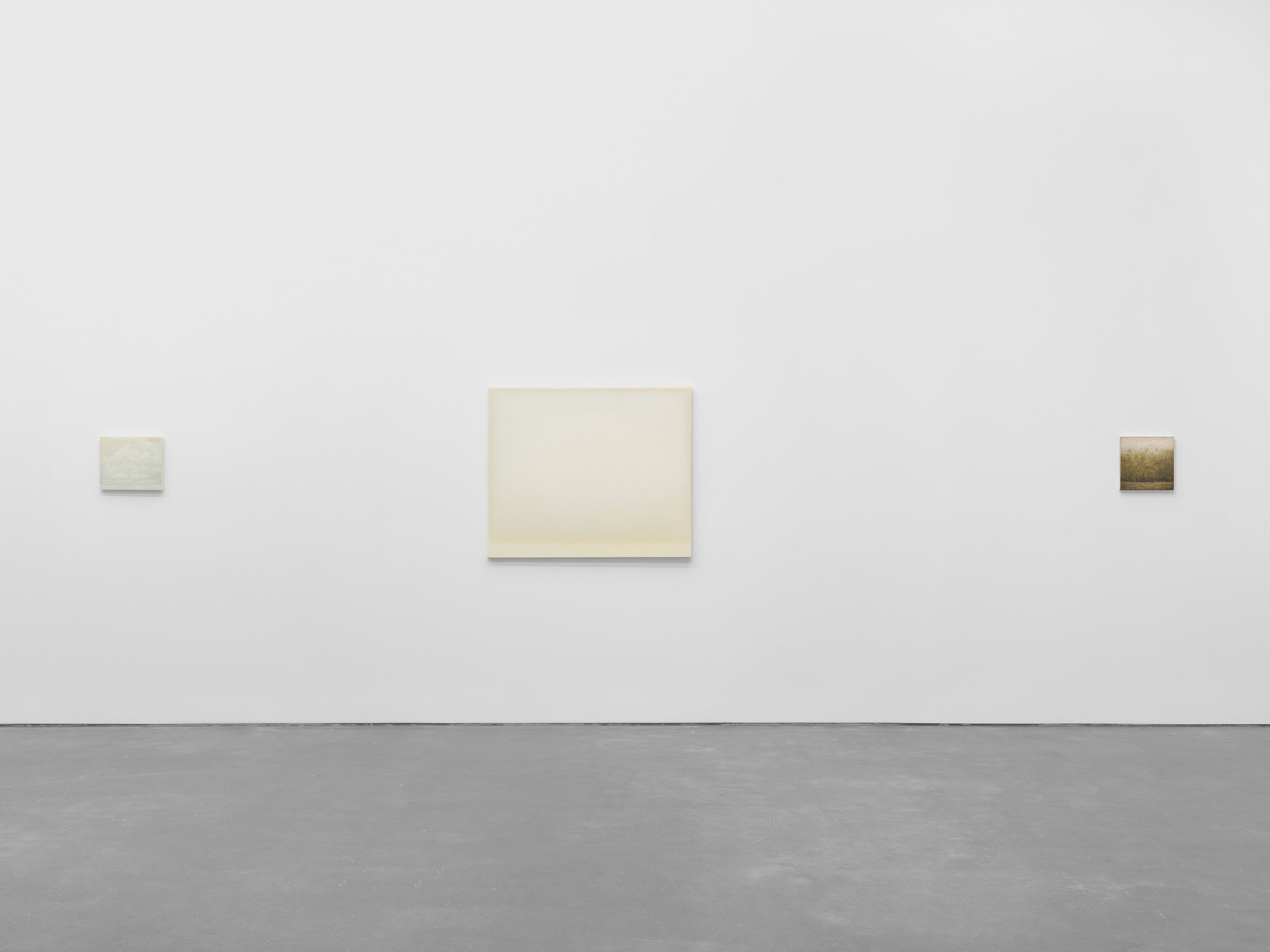

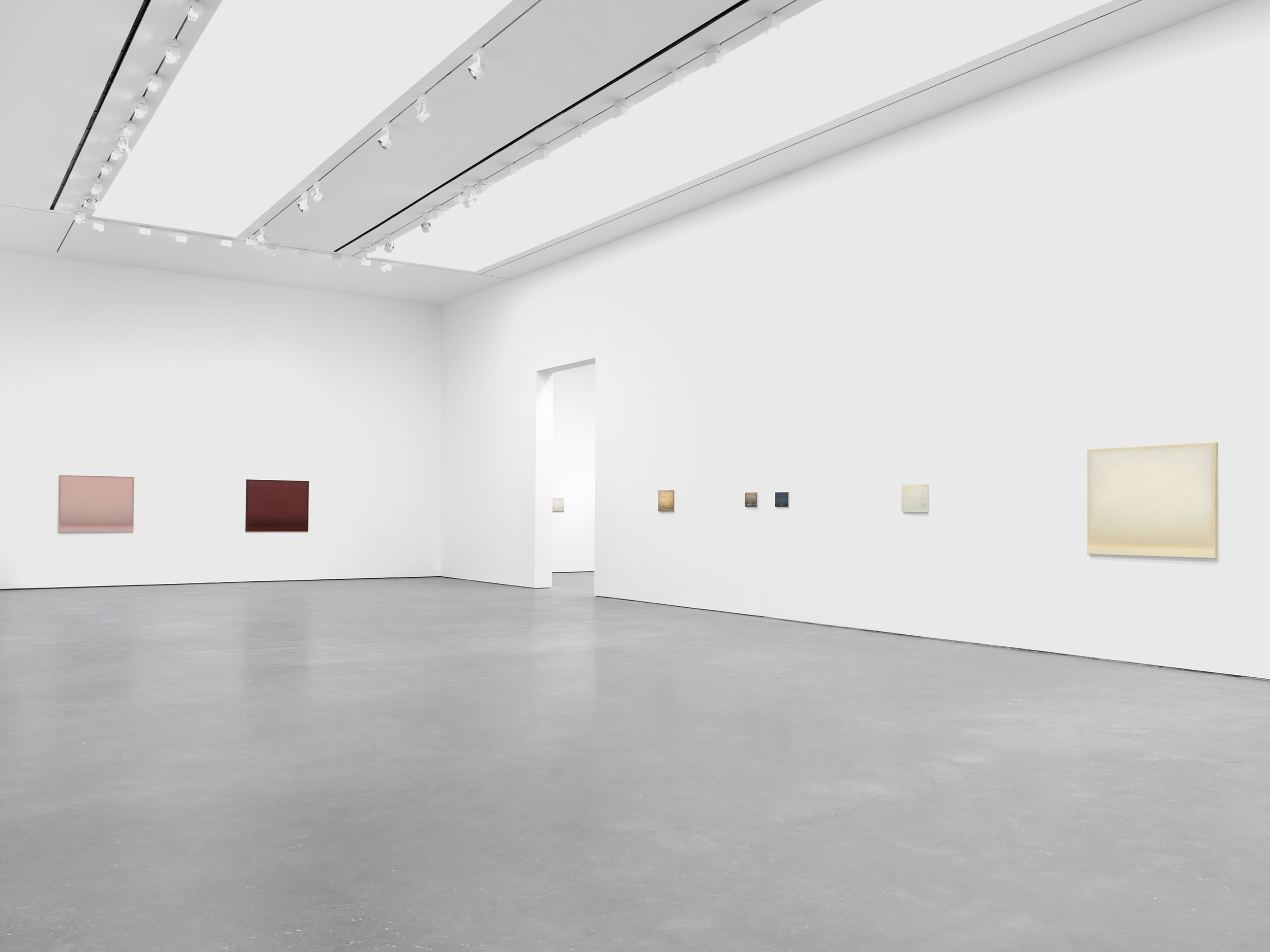

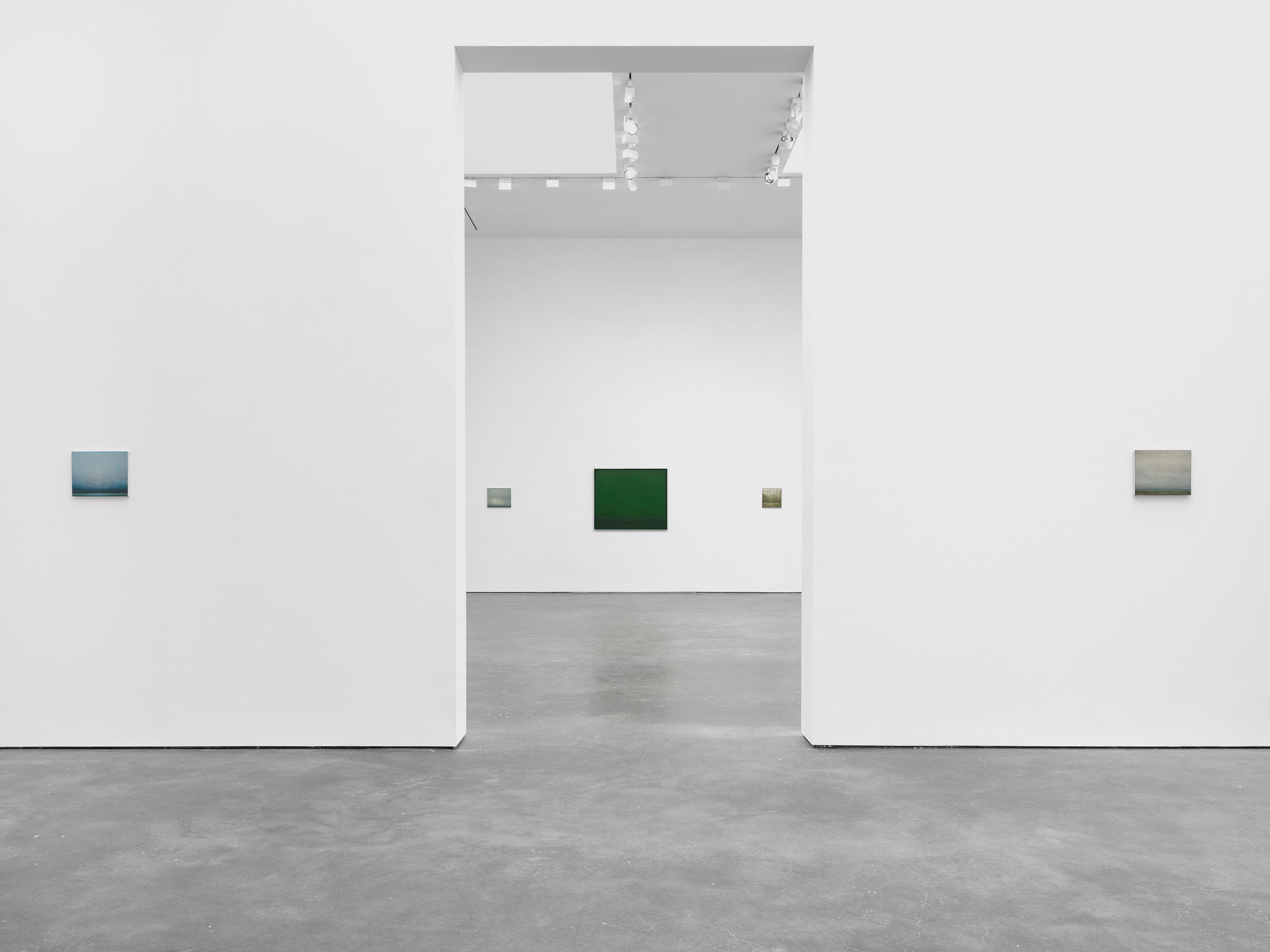
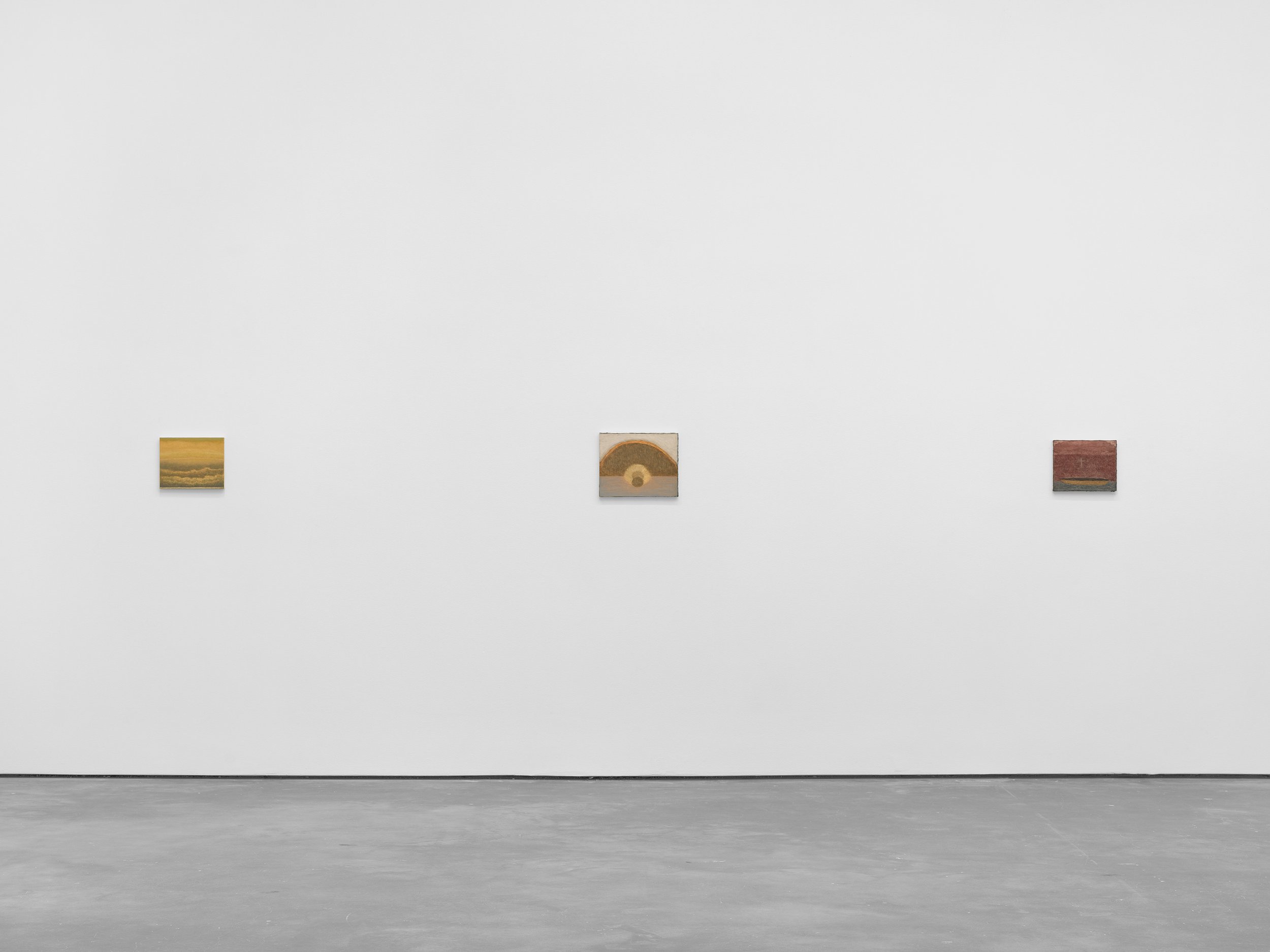
Installation view, Lucas Arruda: Assum Preto, David Zwirner, New York, May 2–June 15, 2024 Courtesy David Zwirner
The exhibition is primarily composed of new paintings from Arruda’s established body of seascapes, junglescapes, and abstract monochromes; together, these works bring about a complex understanding of landscape as a product of a state of mind rather than a depiction of reality. The works on view are notable for their fogged colors—exploring subtle but intricate variations within a single hue—that range from dense reds to ethereal and almost intangible veils of white. For the monochromes, Arruda adds layer upon layer of pigment to pre-dyed raw canvas in an attempt to replicate its tinted hue in paint, methodically returning to each work for weeks or even months on end until the composition slowly builds into a hazy and ever-shifting wall of light.
Lucas Arruda, Untitled (from the Deserto-Modelo series), 2023 © Lucas Arruda. Courtesy the artist and David Zwirner
The seascapes and junglescapes, on the other hand, are made on prepared surfaces using a reductive process whereby the impression of light is attained through the subtraction of pigment. Devoid of specific reference points, Arruda’s seascapes are all grounded only by their thin horizon lines. Above and below this border, charged atmospheric conditions engage further dichotomies between sky and earth, the nebulous and the solid, the psychic and the visual. The jungles, by contrast, dwell in verticality; their genesis lies in the artist’s formative memories of the verdant foliage outside his bedroom window. For Arruda, the quasi-mythical scenery of the Brazilian rainforest coaxes out tensions between reality and human imagination. Towering and impenetrable, yet containing a sense of the infinite that surpasses its physical bounds, in Arruda’s work the jungle becomes a site of power and enlightenment as much as it is a harbinger of darkness and uncertainty—a place where one can be lost to the world and find themselves again.
Lucas Arruda, Untitled (from the Deserto-Modelo series), 2023 © Lucas Arruda. Courtesy the artist and David Zwirner
As curator Lilian Tone writes: “[Arruda’s] paintings suggest a tenuous, fugitive, and mediated relation to nature as that which informs an aesthetic language. As viewers, we tend to make sense of the slightest mark within an open field, to immediately perceive a horizontal line as a horizon line, to create clouds from a change in direction of brushstrokes, and to perceive ground from a thick impasto. Arruda makes paintings we experience as at once beyond abstraction and yet before representation.”2
Lucas Arruda, Untitled (from the Deserto-Modelo series), 2024 © Lucas Arruda. Courtesy the artist and David Zwirner
In Assum Preto, Arruda debuts a group of small-scale, semi-abstract paintings that are constructed from a lexicon of symbolist motifs, marking a new turn in the artist’s practice while also harking back to the planar and architectonic forms that characterize his early oeuvre. In these works, he takes visual cues from the geometries and rich colorscapes found in the Brazilian modernist paintings of José Pancetti (1902–1958), Alfredo Volpi (1896–1988), and Amadeo Luciano Lorenzato (1900–1995). Arruda handles his brush lightly but with intense control, creating clouds and thickets of markings that delicately carve through the painted surface of the canvas in a manner recalling the textures and physicality of intaglio printmaking processes. Potent and open-ended, the symbols and motifs that populate these compositions—darkly brewing storms, empty canoes, and strings of outdoor lights—visualize the themes that permeate Arruda’s body of paintings, including the artist’s own dreams, experiences, and intuitions, through the lens of the sacred and the surreal. The images shift in and out of focus, as if hovering at the precipice of memory itself.
Lucas Arruda, Untitled (from the Deserto-Modelo series), 2024 © Lucas Arruda. Courtesy the artist and David Zwirner
Additionally featured is an example of Arruda’s site-specific light installations. These works comprise a pair of vertically balanced rectangles rendered directly on the gallery wall—the top one created through a light projection and the bottom one physically applied with paint—thus translating the genre of landscape into its most elemental form.
Born in São Paulo, Brazil, Lucas Arruda (b. 1983) received his BFA from Faculdade Santa Marcelina, São Paulo, in 2009. In 2023, Arruda’s work was on view in Assum Preto, a site-specific solo exhibition, curated by Hans Ulrich Obrist, that was presented in the library of the Ateneo de Madrid. A solo exhibition of the artist's work, Lugar sem Lugar, was on view at Fundação Iberê Camargo, Porto Alegre, Brazil, in 2021, and traveled to Instituto Tomie Ohtake, São Paulo, in 2022. The artist’s first large-scale institutional solo show, Deserto-Modelo, was on view at the Fridericianum, Kassel, Germany, in 2019. Arruda’s work has also been included in numerous prominent group exhibitions worldwide, including 38° Panorama da
Lucas Arruda, Untitled (from the Deserto-Modelo series), 2023 © Lucas Arruda. Courtesy the artist and David Zwirner
Arte Brasileira: 1000°, Museu de Arte Moderna, São Paulo (2024); Liquid Intelligence, Museo Nacional Thyssen-Bornemisza, Madrid (2023); Natureculture, Fondation Beyeler, Basel (2021); and Luogo e Segni, Punta della Dogana, Venice (2019).
In 2018, a monograph on the artist was published by Éditions Cahiers d’Art, Paris, with texts by Fernanda Brenner, Chris Sharp, and Hans Ulrich Obrist. In 2020, David Zwirner Books published a comprehensive monograph on Arruda’s work, with texts by Will Chancellor and Barry Schwabsky. In 2022, the Fridericianum, Kassel, published an accompanying catalogue to the artist’s 2019 solo exhibition, with texts by Vincenzo de Bellis, Fernanda Brenner, Marlene Bürgi, Lilian Tone, Theodora Vischer, and Moritz Wesseler.
Arruda’s work has been represented by David Zwirner since 2018, and he has had three prior solo exhibitions with the gallery in London (2017), New York (2019), and Paris (2022).
Lucas Arruda, Untitled (from the Deserto-Modelo series), 2023 © Lucas Arruda. Courtesy the artist and David Zwirner
His work is included in the permanent collections of the Art Institute of Chicago; Buffalo AKG Art Museum, Buffalo, New York; Centre Pompidou, Paris; Fondation Beyeler, Basel; Fondazione Sandretto Re Rebaudengo, Turin; Hirshhorn Museum and Sculpture Garden, Washington, DC; Institute of Contemporary Art, Miami; J. Paul Getty Museum, Los Angeles; Museo Jumex, Mexico City; K11 Art Foundation, Hong Kong; Kunstmuseum Den Haag, The Hague, the Netherlands; Long Museum, Shanghai; Moderna Museet, Stockholm; Museo Thyssen-Bornemisza, Madrid; Museum of Fine Arts, Boston; Museum Ludwig, Cologne; Pérez Art Museum, Miami; Pinacoteca do Estado de São Paulo; Pinault Collection, Paris; Rockbund Art Museum, Shanghai; Solomon R. Guggenheim Museum, New York; Stedelijk Museum, Amsterdam; Tate, United Kingdom; and the Walker Art Center, Minneapolis. Arruda lives and works in São Paulo.
Lucas Arruda, Untitled (from the Deserto-Modelo series), 2022 © Lucas Arruda. Courtesy the artist and David Zwirner
The exhibition opened at the New York location, 537 West 20th Street on May 2nd and will conclude on June 15, 2024. For more information about this exhibit, visit David Zwirner’s site; you can also follow them on Instagram and find the gallery on Artsy here.
Footnotes:
1 Lucas Arruda, “Lucas Arruda in conversation with Hans Ulrich Obrist,” in Lucas Arruda: Assum Preto. Exh. cat. (Madrid: Ateneo de Madrid and Fundación Sandretto Re Rebaudengo, 2022), p. 22.
2 Lilian Tone, “Painting as Liminality,” in Lucas Arruda: Deserto-Modelo. Exh. cat. (Kassel/Cologne: Museum Fridericianum and Buchhandlung Walther König, 2022), p. 149.
Amadeo Luciano Lorenzato
Amadeo Luciano Lorenzato, Sem título (Untitled), 1972. Courtesy David Zwirner
Amadeo Luciano Lorenzato Self-taught painter and sharpshooter
Submits to no school
Nor to this or that trend
Belongs to no clique
Paints whatever tickles his fancy
Amen
— Amadeo Luciano Lorenzato, 1948 1
David Zwirner is pleased to present an exhibition of paintings by Brazilian artist Amadeo Luciano Lorenzato (1900–1995), on view at the gallery’s East 69th Street location in New York. Marking Lorenzato’s second solo exhibition with the gallery and the second solo presentation of the artist’s work in the United States, this exhibition will coincide with his inclusion in the 60th Venice Biennale, organized by curator Adriano Pedrosa (April 20–November 24, 2024).
Among the foremost Brazilian artists of his generation, Lorenzato developed a singular body of paintings centered on his fastidious observations of the everyday subjects he encountered in his hometown of Belo Horizonte—including favelas, semi-urban landscapes, and scenes of agriculture and rural industry.
Lorenzato’s distinctive compositions are characterized by reduced geometric forms and densely textured surfaces that the artist achieved through the use of richly colored self-made pigments applied with brushes and enhanced with combs and forks. Imbued with an assured freedom of expression, these canvases masterfully capture the vitality of the artist’s surroundings as well as the colors and textures of the natural world. As Rodrigo Moura, Lorenzato scholar and chief curator at El Museo del Barrio, New York, notes, “Lorenzato’s paintings are not only born out of the desire to construct his own reality but also to contain the other dimensions that coexist within it, such as gesture, nature, and silence.” 2
Installation view, Amadeo Luciano Lorenzato, David Zwirner, New York, April 11–May 25, 2024. Courtesy David Zwirner
Spanning the last three decades of Lorenzato’s career, the paintings in this exhibition embody many of the primary concerns of the artist’s mature oeuvre, both in subject matter and form. Depicting scenes ranging from vast rural horizons of sun, sky, and land to close-up nature studies wherein tree branches or a single plant fill the entire picture plane, these works exemplify the artist’s restrained formal approach combined with his signature treatment of texture and color. Also on view will be contemplative still lifes and pastoral figurative scenes whose subject matter points to more personal, domestic aspects of Lorenzato’s practice while continuing the artist’s formal explorations of pattern and surface.
Writing on Lorenzato’s works, art historian Claudia Giannetti Nölle observes, “Especially through his ability to represent reality, he is able to transform or metamorphose elements of nature or human figures, conferring upon them a magical quality that can only be achieved through genuine abstraction of real forms and figures. His method of capturing everyday life and expressing it in drawings or oil paintings goes well beyond mere simplification.… The image seems to go through a process of distillation. He eschews finer details and focuses instead on the essential lines which make up the image he observes. The same can be said about his use of color.” 3
Installation view, Amadeo Luciano Lorenzato, David Zwirner, New York, April 11–May 25, 2024. Courtesy David Zwirner
Seen together, these works express an important crosscurrent between Brazilian art and broader modernist movements of the twentieth century. While he kept on hand a worn copy of painter Giorgio Vasari’s (1511–1574) famous book on Italian artists and was known to express admiration for painters such as Cézanne, Van Gogh, Monet, and Manet, Lorenzato operated as a singular and distinctly Brazilian artist—with European roots. Lorenzato’s practice was an amalgamation of Brazilian styles and a unique take on the influence of European art. In this way, his work is linked to the ideology of antropófago (anthropophagy), invented by poet Oswald de Andrade and inspired by a 1928 painting by Brazilian artist Tarsila do Amaral (1886–1973). Like Amaral, Lorenzato heeded European styles while avoiding any direct influences—in some ways anticipating the tropicália artistic movement that emerged in the late 1960s.

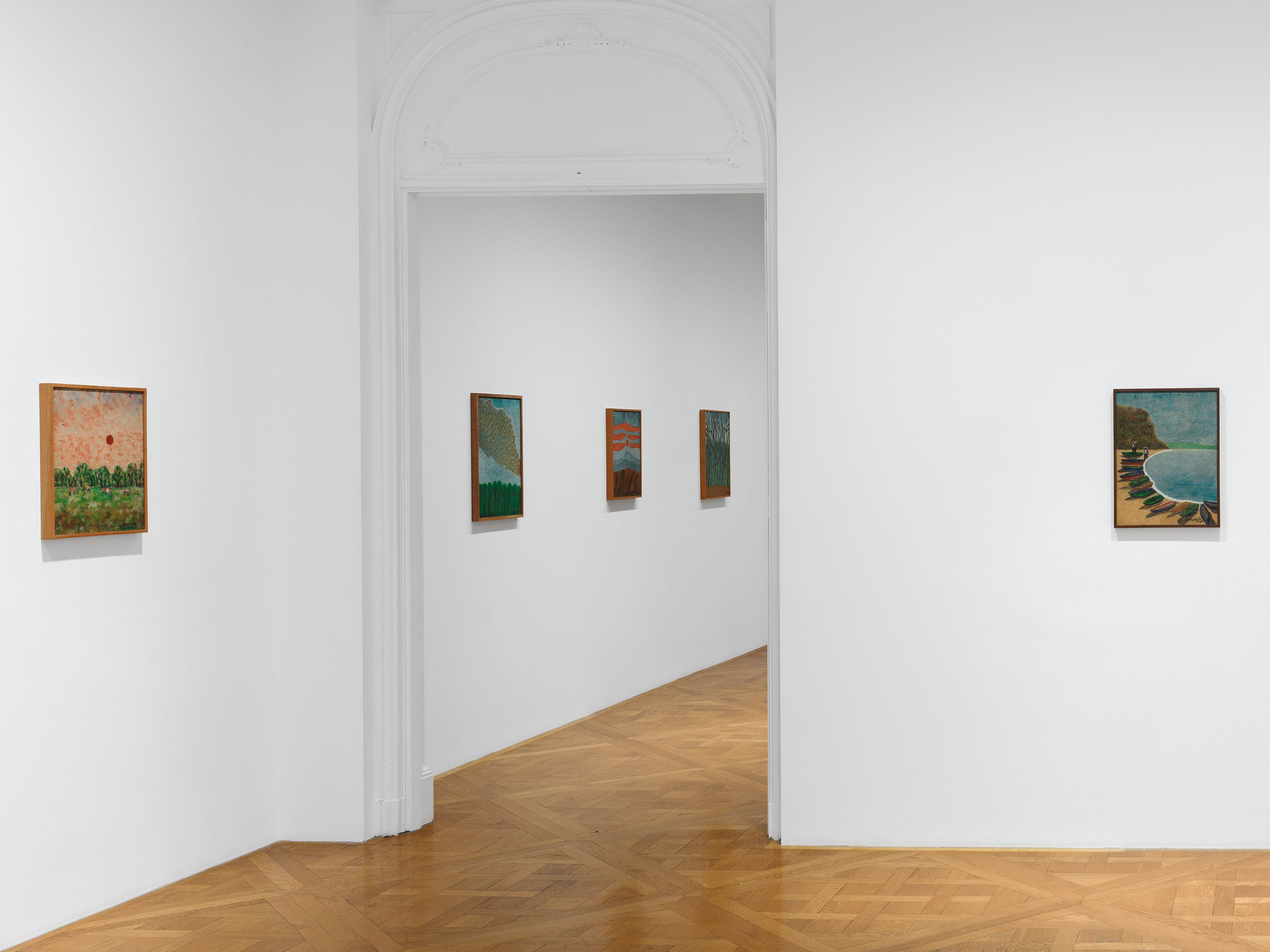

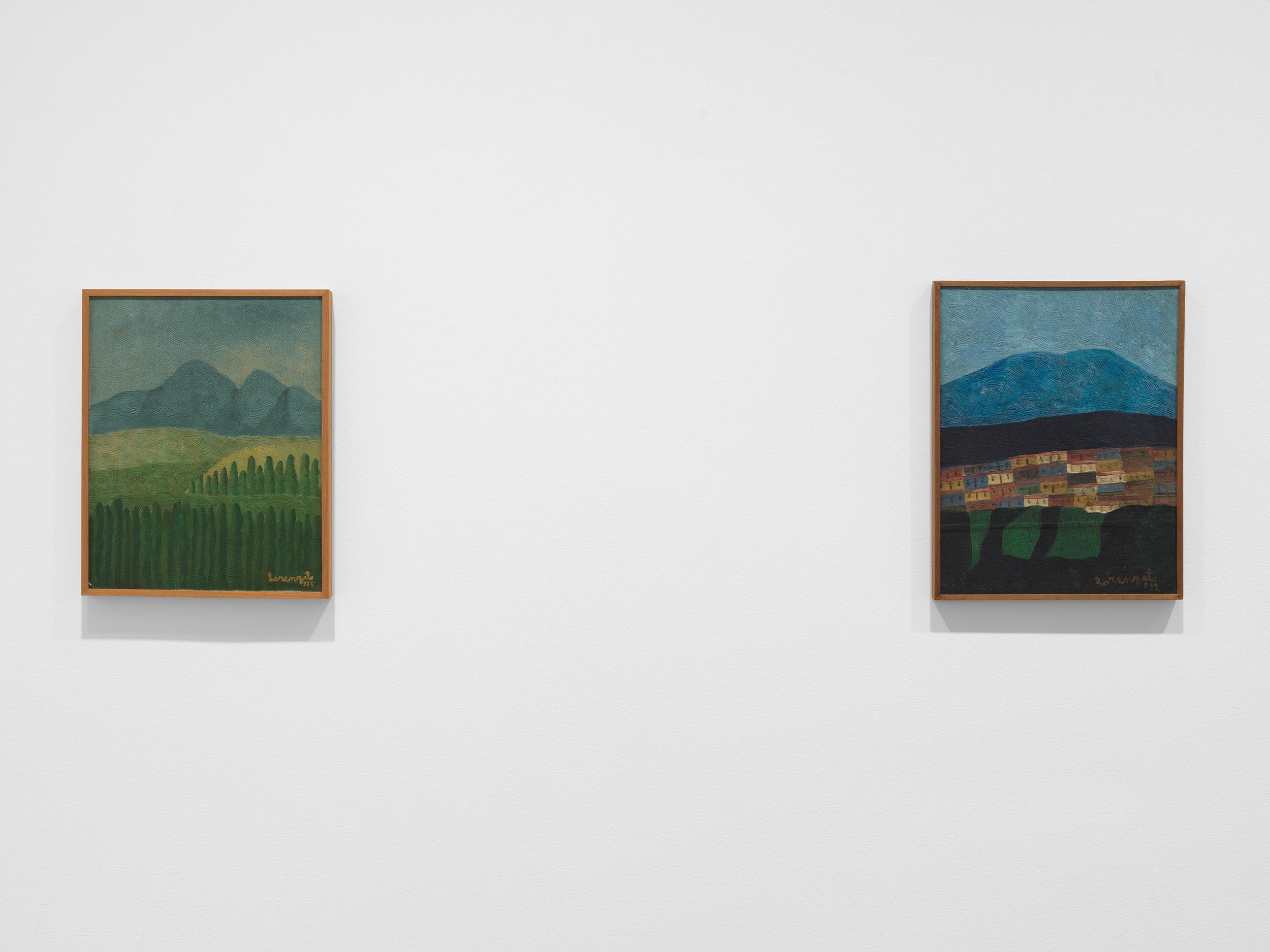
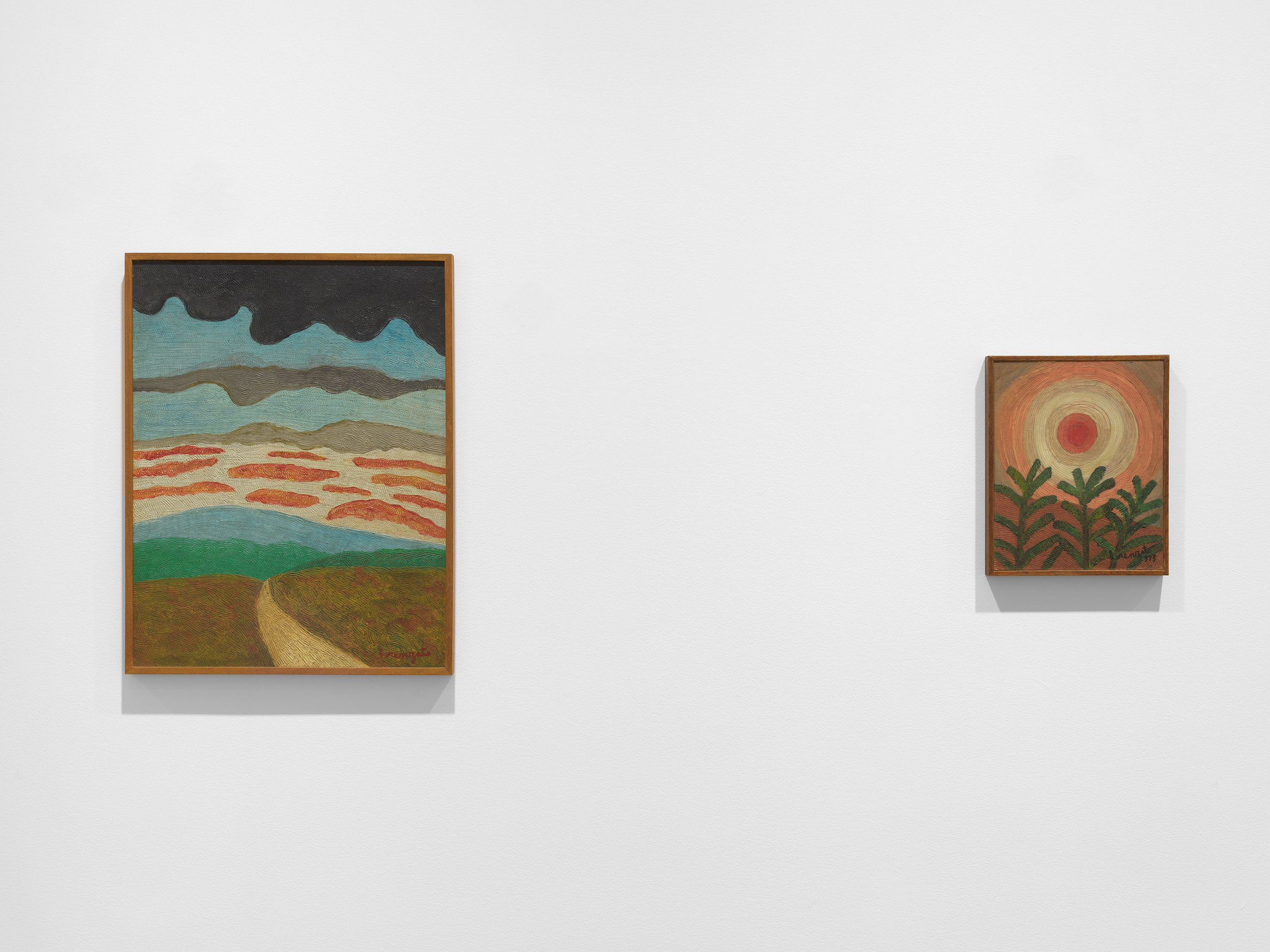

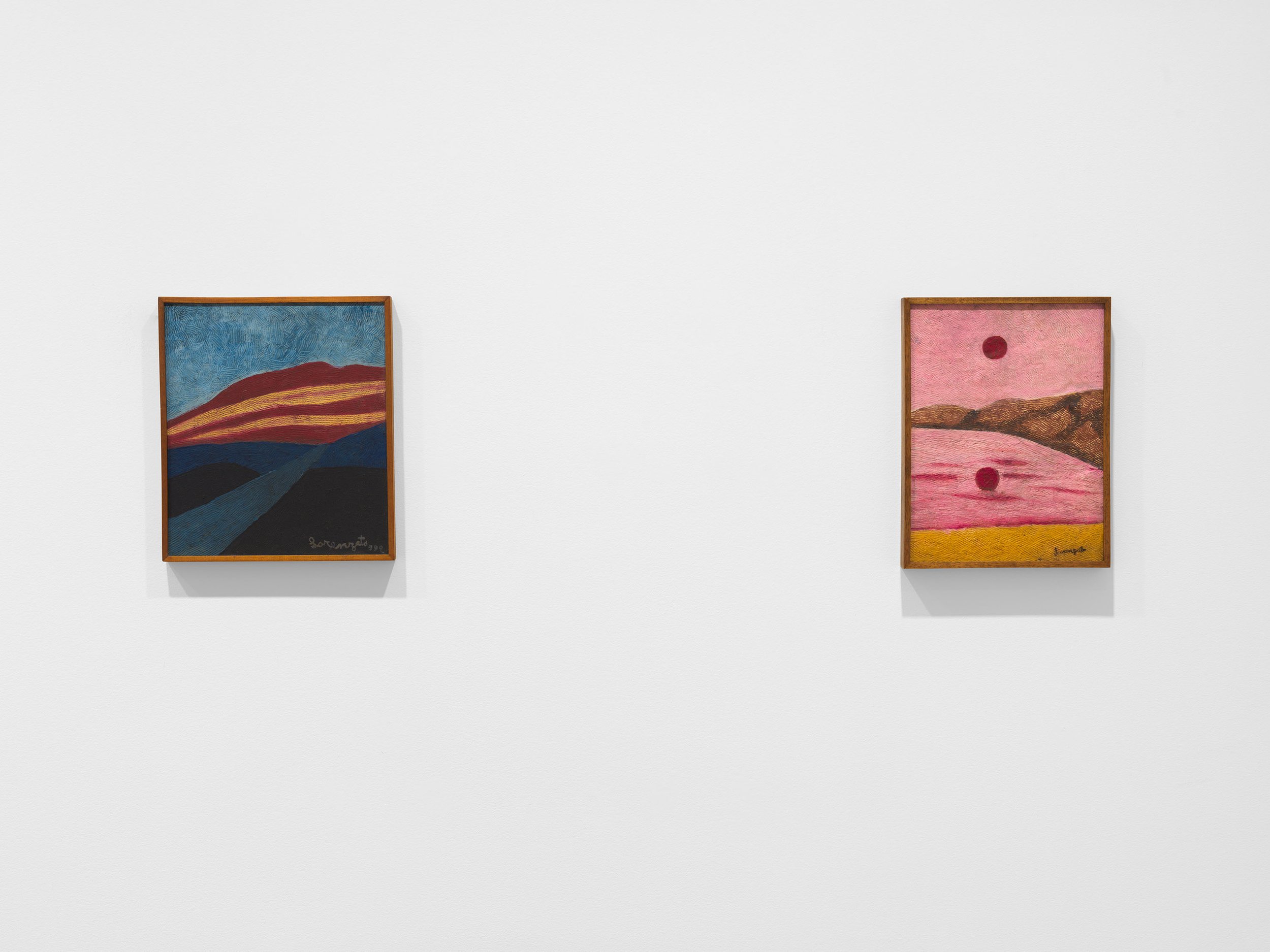
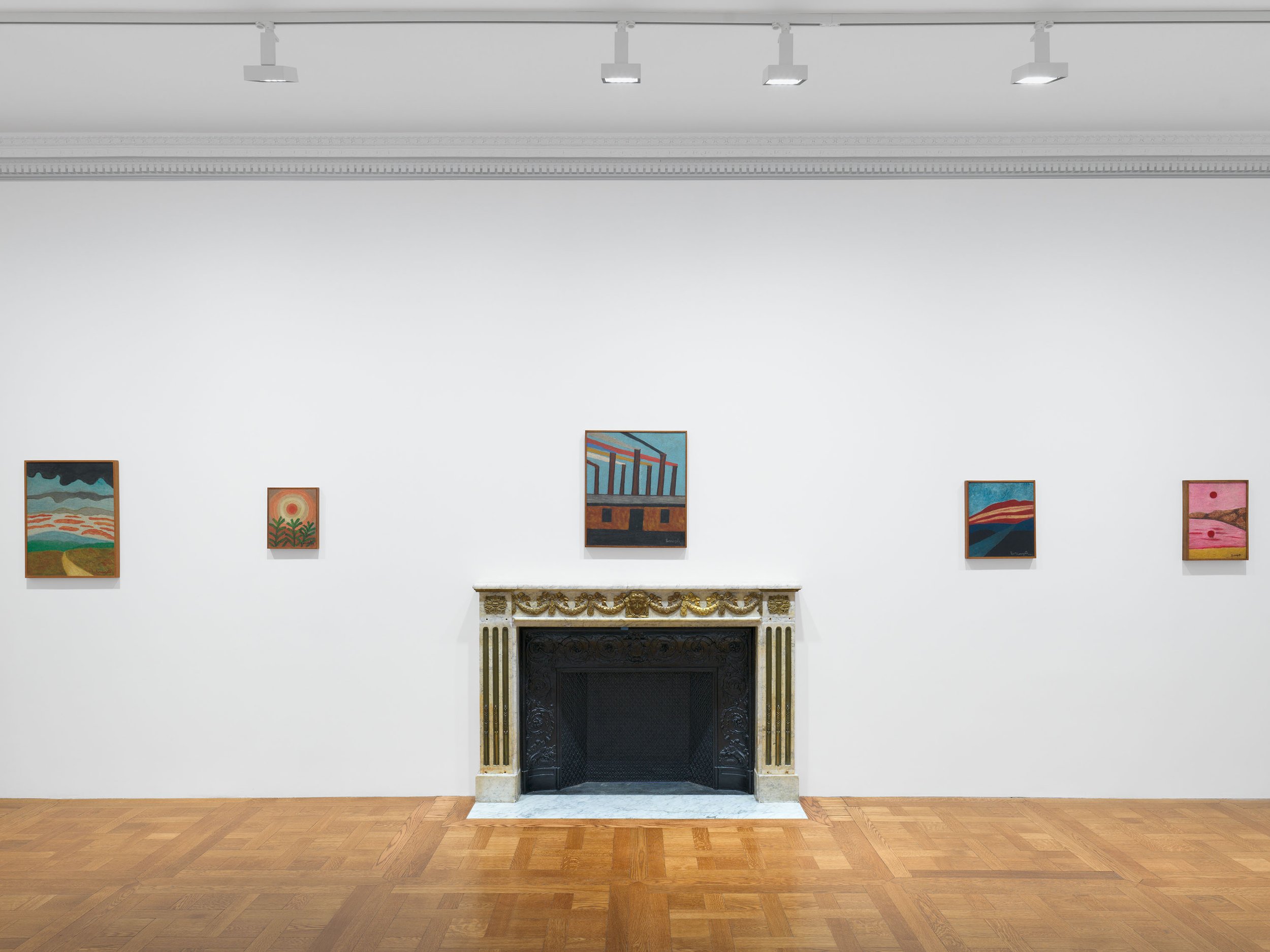
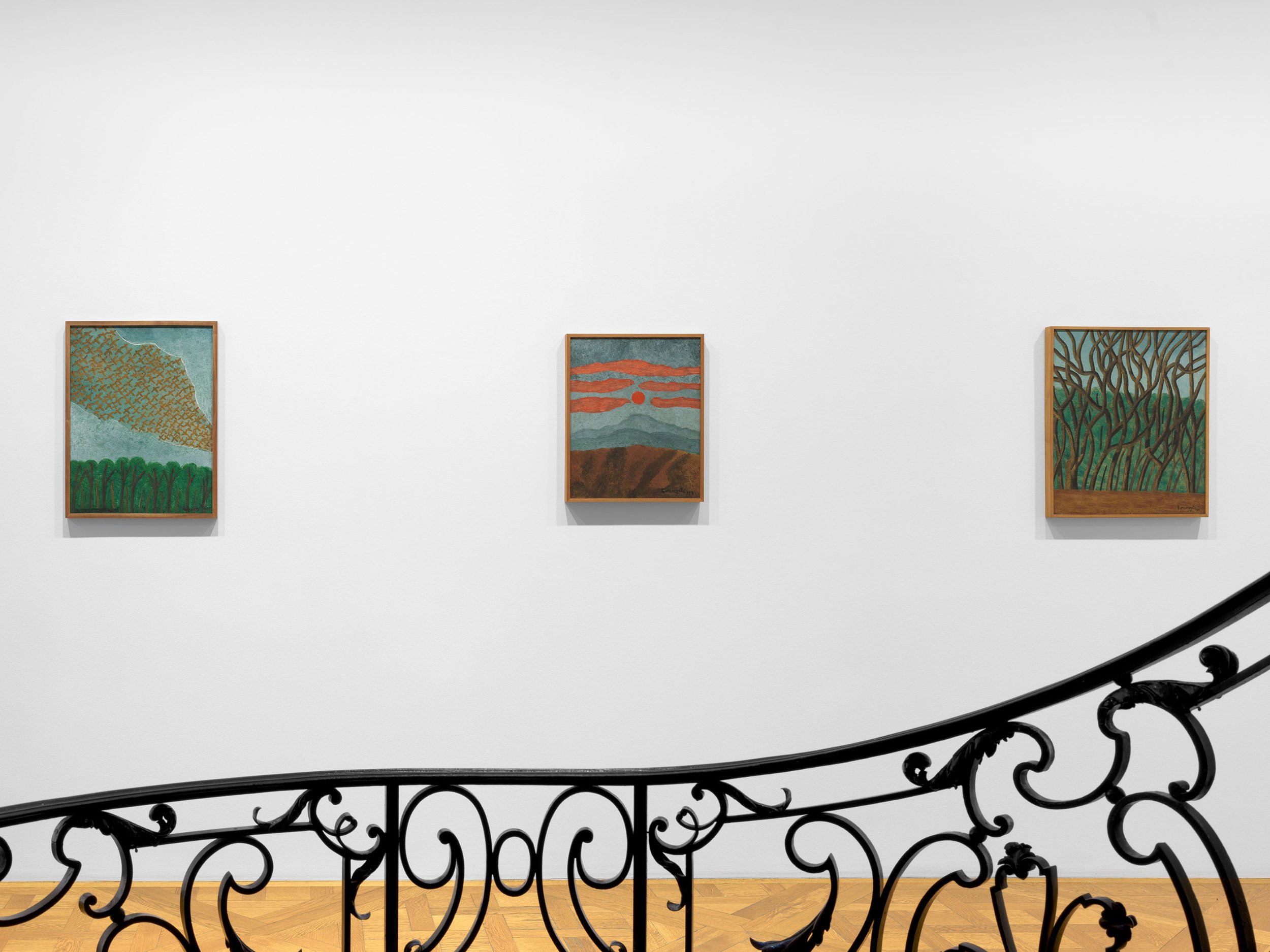
Installation view, Amadeo Luciano Lorenzato, David Zwirner, New York, April 11–May 25, 2024. Courtesy David Zwirner
Often using geometric shapes to suggest objects in real space, in his paintings Lorenzato shows a visual parallel to the work of Italian-born Brazilian modernist painter Alfredo Volpi (1896–1988), who similarly emphasized a deep rootedness in a Brazilian culture through painting everyday subjects, in São Paulo. Lorenzato’s position as a working-class artist—an atypical identity in Brazilian cultural circles until the later decades of the twentieth century—set him apart, both for his perspective on the rural vernacular and for his influence on local contemporaries. Legendary in his hometown, Lorenzato’s work was collected by fellow artists in Belo Horizonte, who introduced it to new audiences in São Paulo when they moved to the urban center in the 1990s, bringing wider awareness to the artist’s oeuvre. Recent critical and institutional attention to Lorenzato’s work has expanded the appreciation of his art far beyond the 3 Claudia Giannetti Nölle, Lorenzato: 90 Años. Exh. cat. (Belo Horizonte: Manoel Macedo Galeria de Arte, 1990), n.p. 2 Moura, Lorenzato, p. 31. regional recognition it received during his lifetime. This exhibition celebrates Lorenzato’s contribution to a global modernist canon, in which the nuances and textures of the artist’s intimate compositions can be considered alongside the universality of his colorful language.
Amadeo Luciano Lorenzato was born in 1900 to Italian parents who immigrated to Brazil in the last decade of the nineteenth century. In 1920, the artist moved with his parents to Italy, where he worked various construction and painting jobs on and off throughout Europe. Though he studied for a brief period at the Reale Accademia delle Arti in Vicenza, in 1925, Lorenzato was mostly self-taught, and he developed his technical proficiency in painting through a job restoring frescoes in Rome, having previously worked as a mural painter in Brazil.
Installation view, Amadeo Luciano Lorenzato, David Zwirner, New York, April 11–May 25, 2024. Courtesy David Zwirner
Lorenzato permanently returned to Belo Horizonte in 1948, and after sustaining an injury to his leg in 1956, he committed himself to painting full time. In 1964, he had his first solo exhibition at the Minas Tênis Clube in Belo Horizonte, followed by his inclusion in two group shows there the following year and a second solo exhibition in 1967. In the decades following, his work was exhibited in solo and group exhibitions in Brazil, including a retrospective exhibition at the Museu de Arte da Pampulha, Belo Horizonte, in 1995—the year of the artist’s death. In 1972, Lorenzato represented Brazil in the 3rd Triennial of Self-Taught Art in Bratislava, Czechoslovakia.
In 2019, Lorenzato’s first solo exhibition outside of Brazil was presented at David Zwirner London. In 2022, the artist’s work was included in the major group exhibition Histórias Brasileiras at Museu de Arte de São Paulo, curated by Adriano Pedrosa, which was part of a two-year program at the museum celebrating the bicentennial of Brazilian independence. Lorenzato is included in the 60th Venice Biennale, Stranieri Ovunque – Foreigners Everywhere, organized by Pedrosa and on view from April 20 to November 24, 2024.
Lorenzato’s work is represented in public collections internationally, including Fundação Clóvis Salgado, Belo Horizonte; Museu de Arte da Pampulha, Belo Horizonte; Museu de Arte de São Paulo; Nouveau Musée National de Monaco; Pinacoteca de São Paulo; and Universidade Federal de Viçosa, Brazil.
In 2023, with the support of Brazilian cultural institute Itaú Cultural, the Projeto Lorenzato was established with the mission of identifying and digitally cataloguing the artist’s work.
This exhibition opened on April 11th and will conclude on May 25, 2024. It is featured at 34 East 69th Street, New York. For more information about this exhibit, visit David Zwirner’s site; you can also follow them on Instagram and find the gallery on Artsy here.
Footnotes:
1 Amadeo Luciano Lorenzato, 1948, cited in Rodrigo Moura, Lorenzato, trans. Pedro Vainer (New York and São Paulo: KMEC Books/Ubu Editora, 2023), p. 14.
2 Moura, Lorenzato, p. 31
3 Claudia Giannetti Nölle, Lorenzato: 90 Años. Exh. cat. (Belo Horizonte: Manoel Macedo Galeria de Arte, 1990), n.p
The Yearlings by Kira Maria
Installation Views: Kira Maria Shewfelt, The Yearlings, Make Room Los Angeles © Kira Maria Shewfelt Courtesy the artist and Make Room LA
Presented by Make Room, The Yearlings by Kira Maria Shewfelt is a solo exhibition devoted to moments of becoming. The exhibition opened on April 20 and will conclude on May 24, 2024. In each painting, figures of lovers and children, horses and butterflies alike, convene, sharing touch or experience in scenes the artist describes as moments of “high transference and action”— and so, touch is a relational reminder, a promise that we are bound together, interconnected through our relationships, with potential for becoming more.
Installation Views: Kira Maria Shewfelt, The Yearlings, Make Room Los Angeles © Kira Maria Shewfelt Courtesy the artist and Make Room LA
Kira Maria’s paintings dispense with artifice and caring too much about the wrong things. Intimacy is a holding, an embrace, a kiss, a touch, but it is also the incremental appearance and shedding of expectations— there is permission to be observed as we really are and to want for more. Intimacy, care, and affection verge close to the goals of art, a meditation on what intuitively moves us. Intimacy is truthful— it is the personal made sublime, an ode to transformative experiences.
Installation Views: Kira Maria Shewfelt, The Yearlings, Make Room Los Angeles © Kira Maria Shewfelt Courtesy the artist and Make Room LA
Gestures and marks are applied so honestly that parts of paintings are rendered nearly translucent. Thin washes of oil paint dapple across a worked and cared for surface and the effect of accumulated layering creates new spaces of depth and richness. Made bold and tender, swiftly with action as with repose, these canvases carry marks of an extended process, holding intuitive making as dearly as the finish.
The artist’s scenes of nature allude to the efforts of 19th century Romanticism, expanding themes of the individual’s relationship with awe and grandeur to encompass the personal and domestic. Amid paintings of home, portraits of friends and lovers, and natural wonders, we experience splendor through color and gestural impressions. These artworks assign significance to the sensual, affective, and deeply connected, a testament to holding close spectacular moments, wherever we may find them.


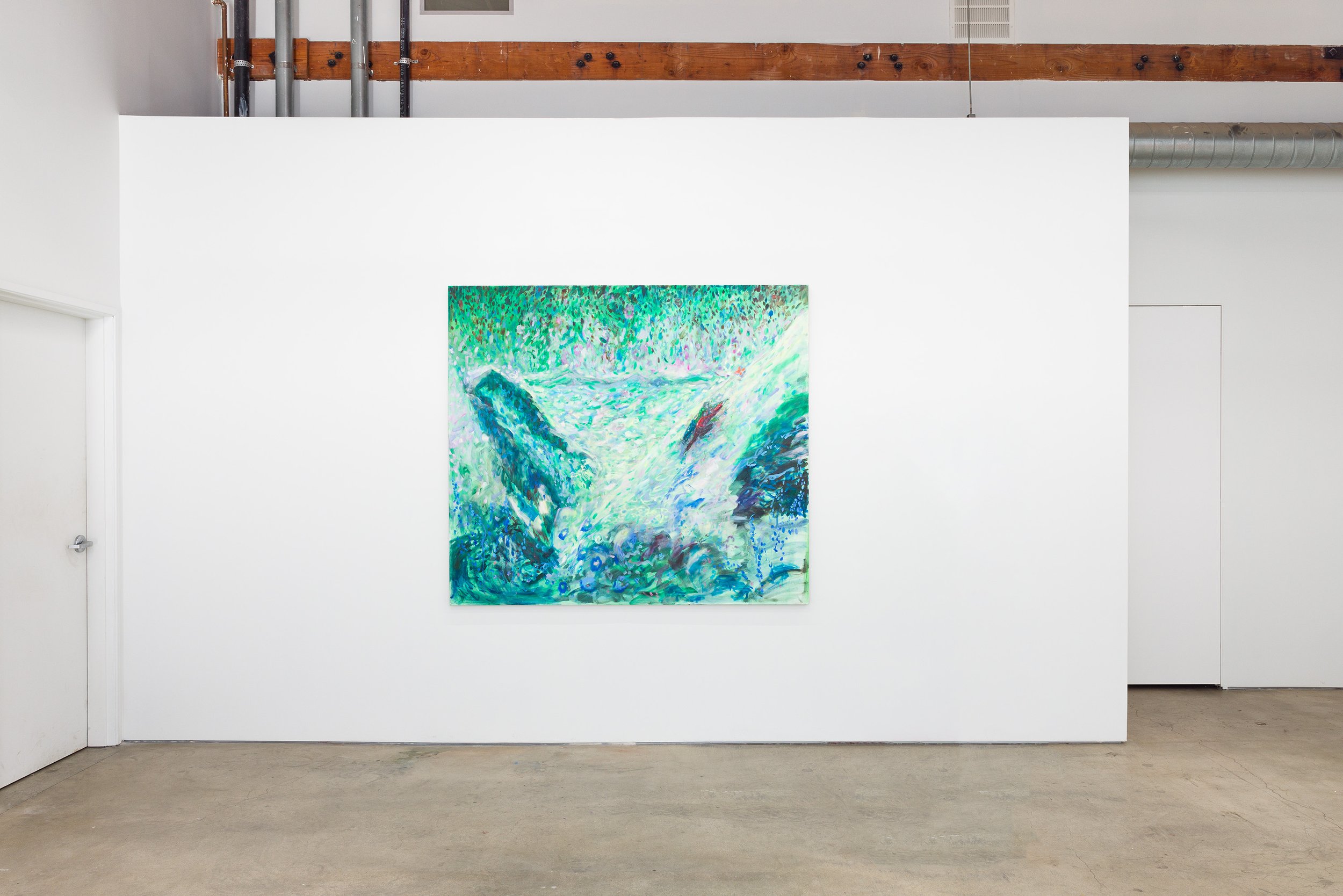
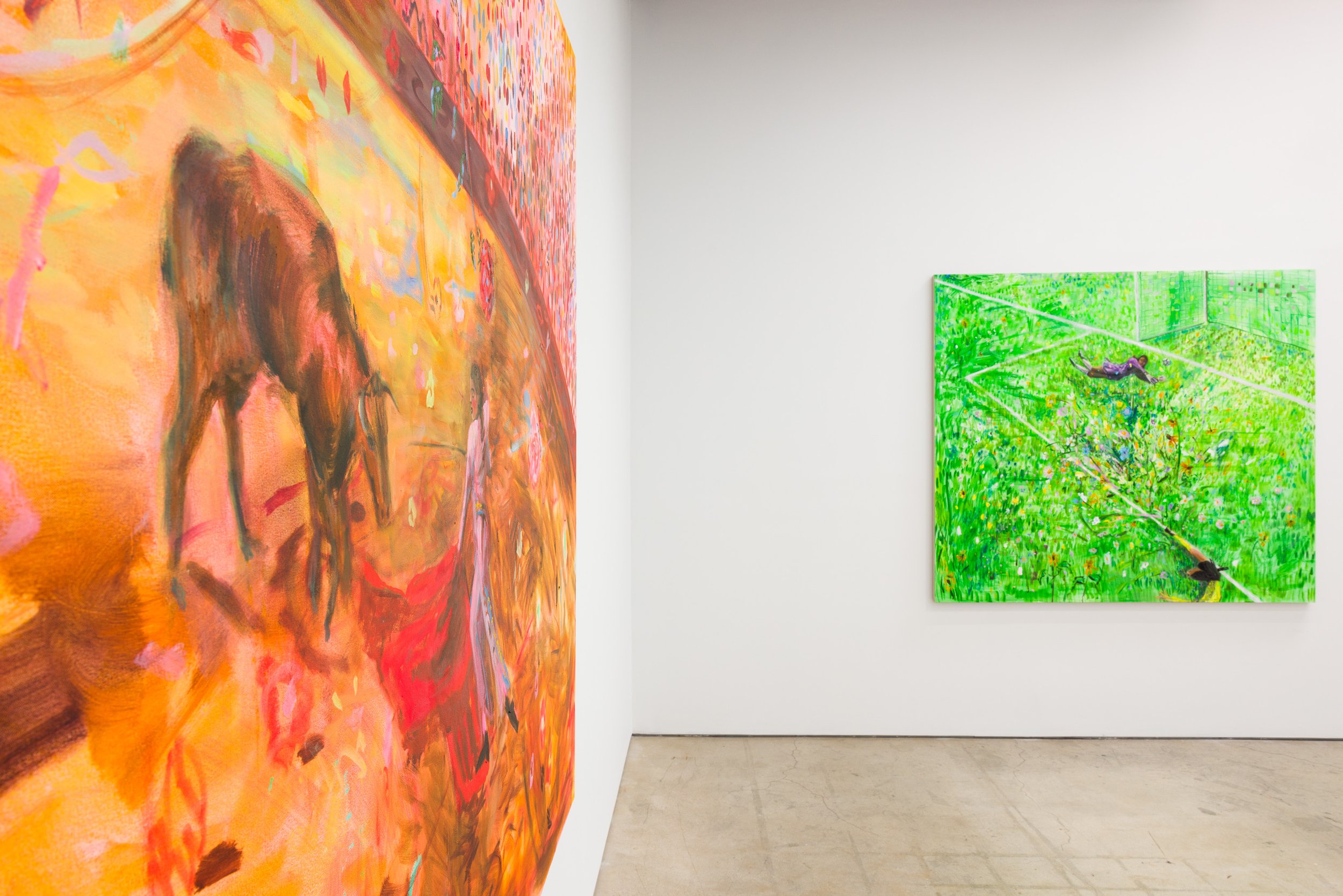
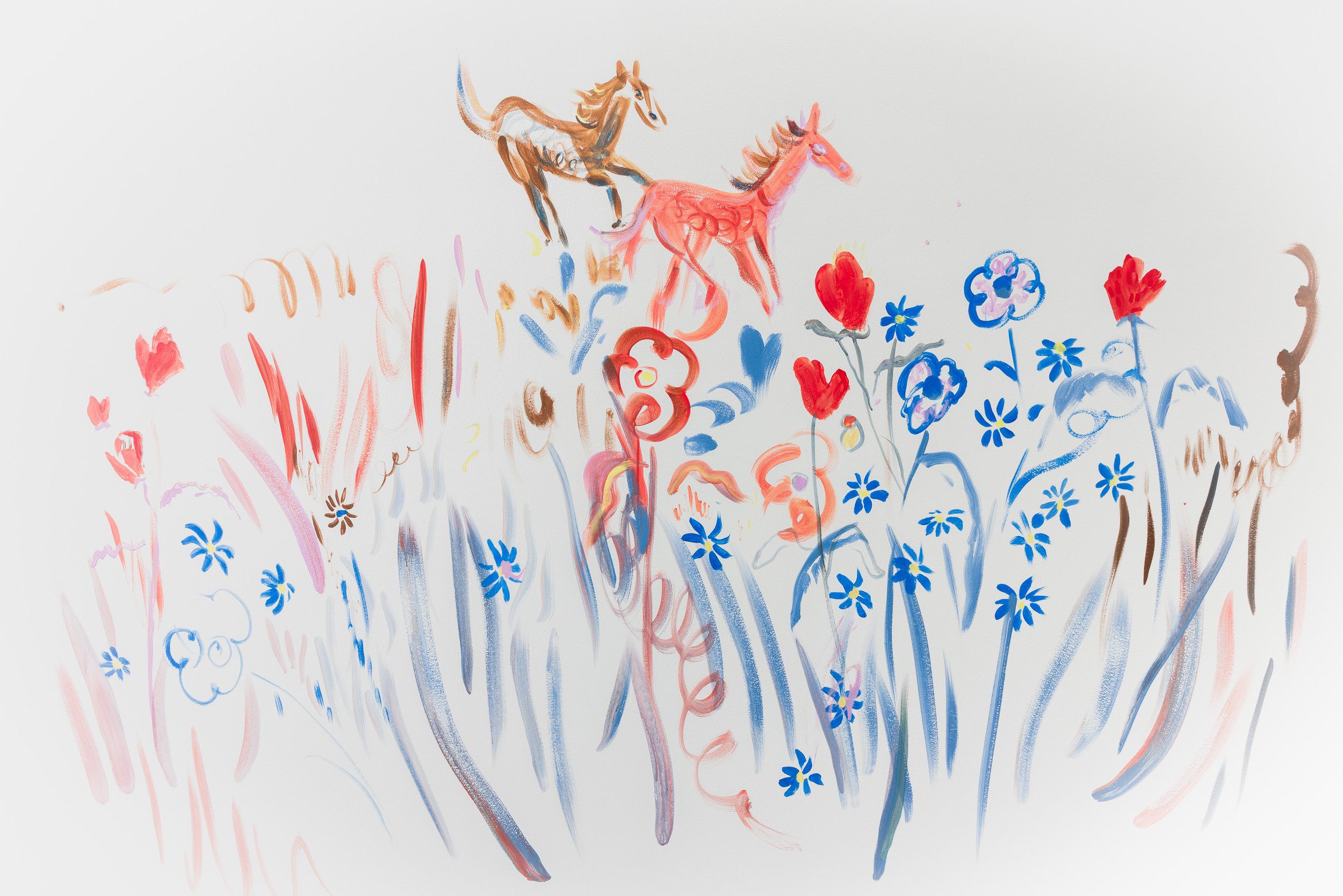

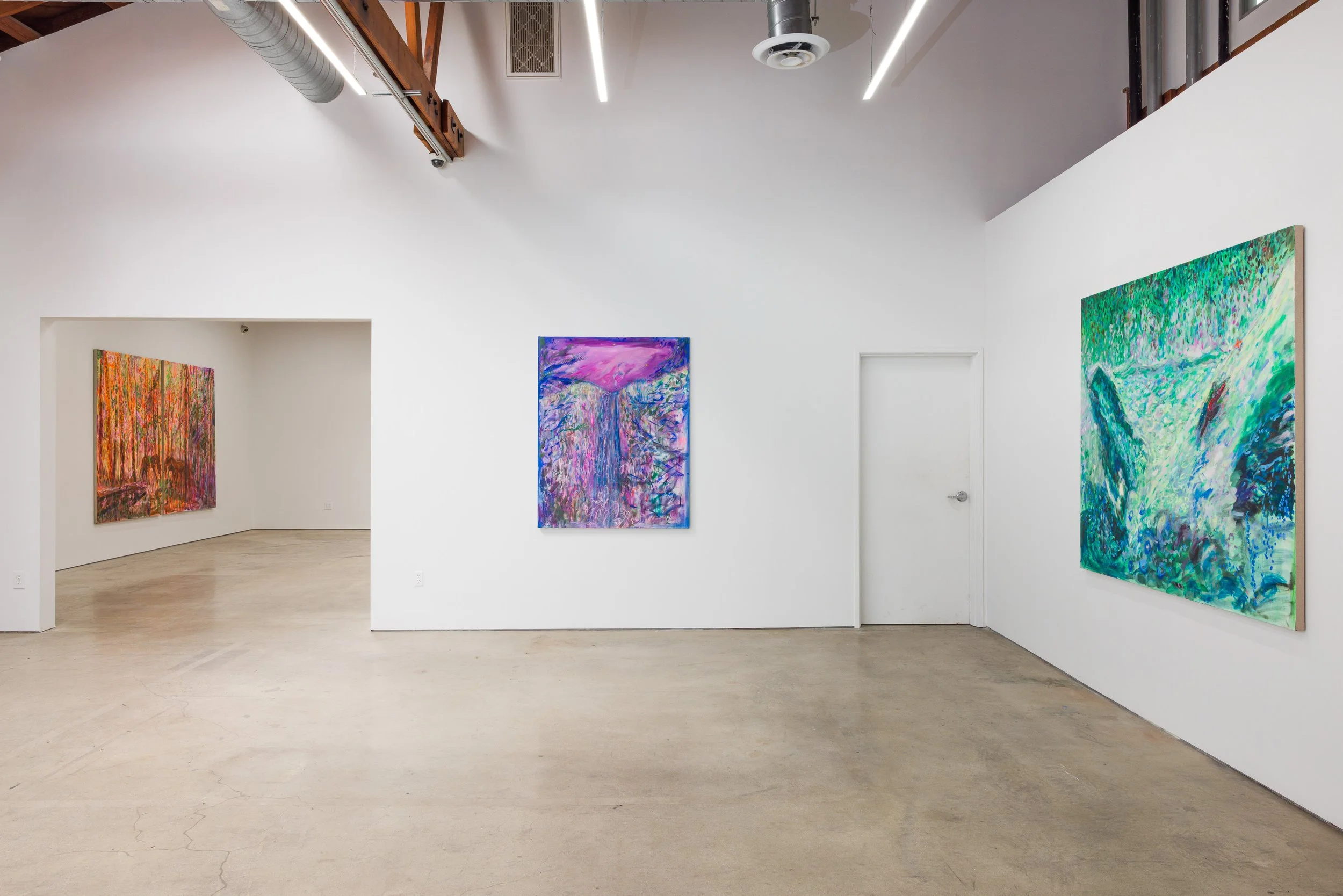
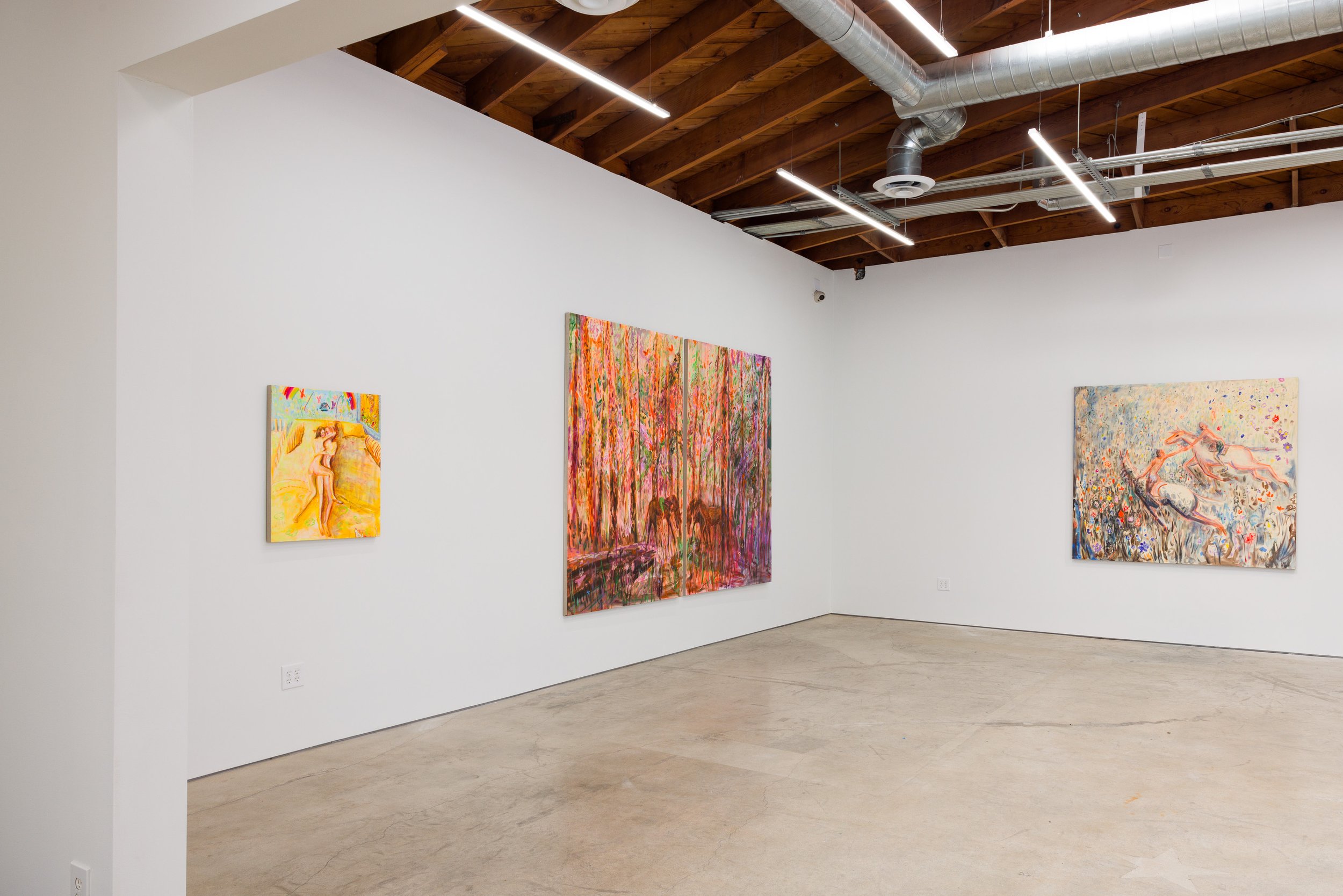
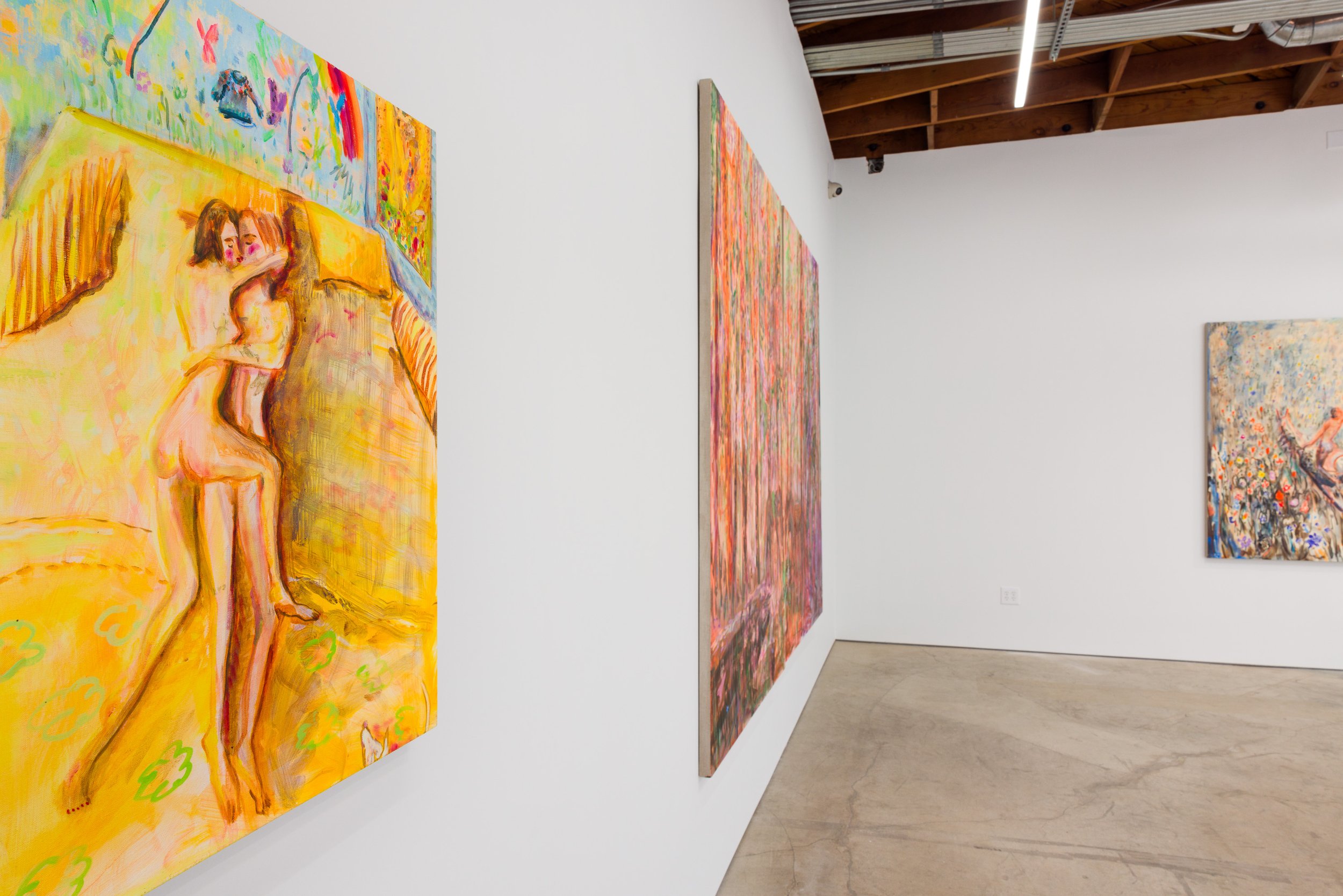
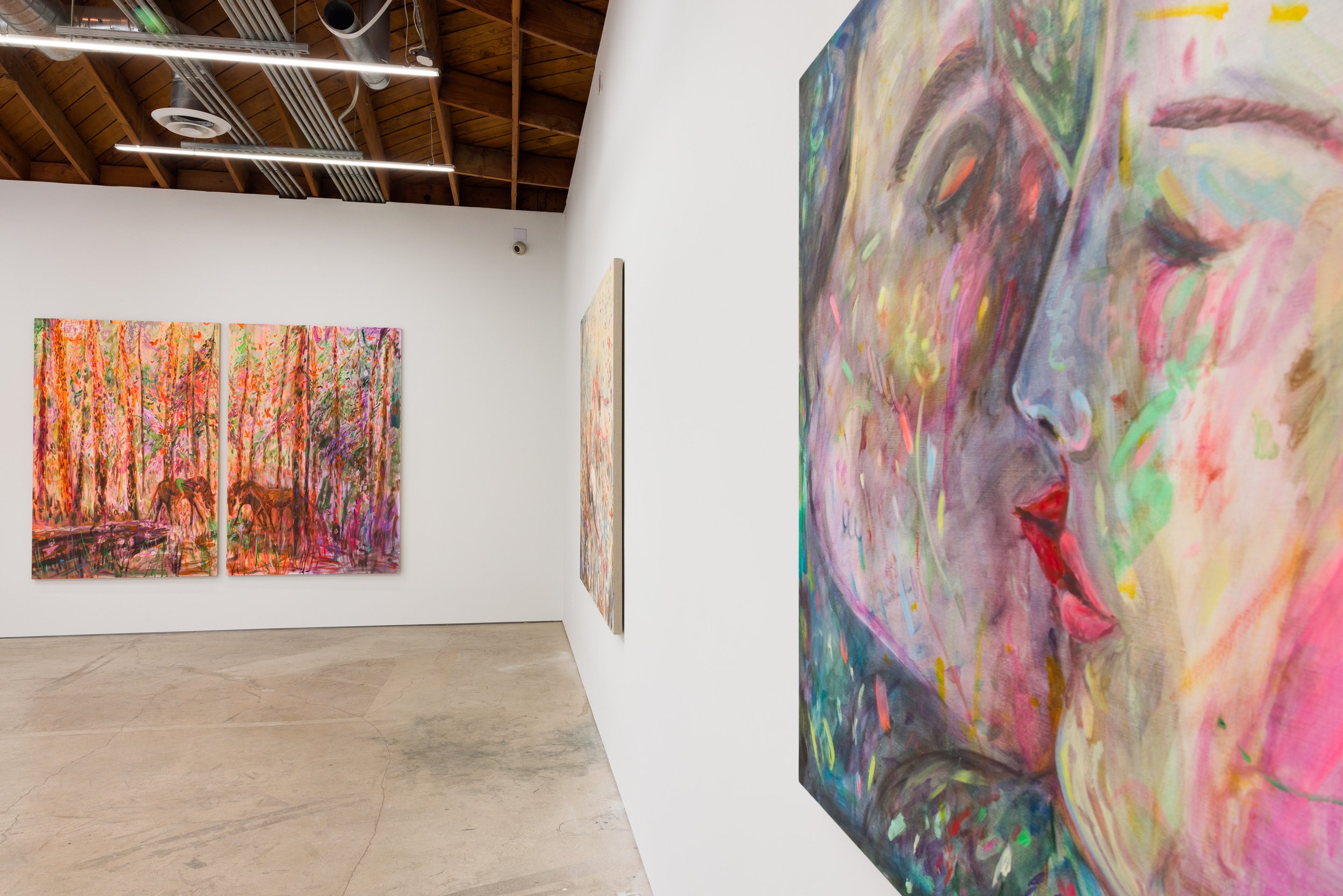
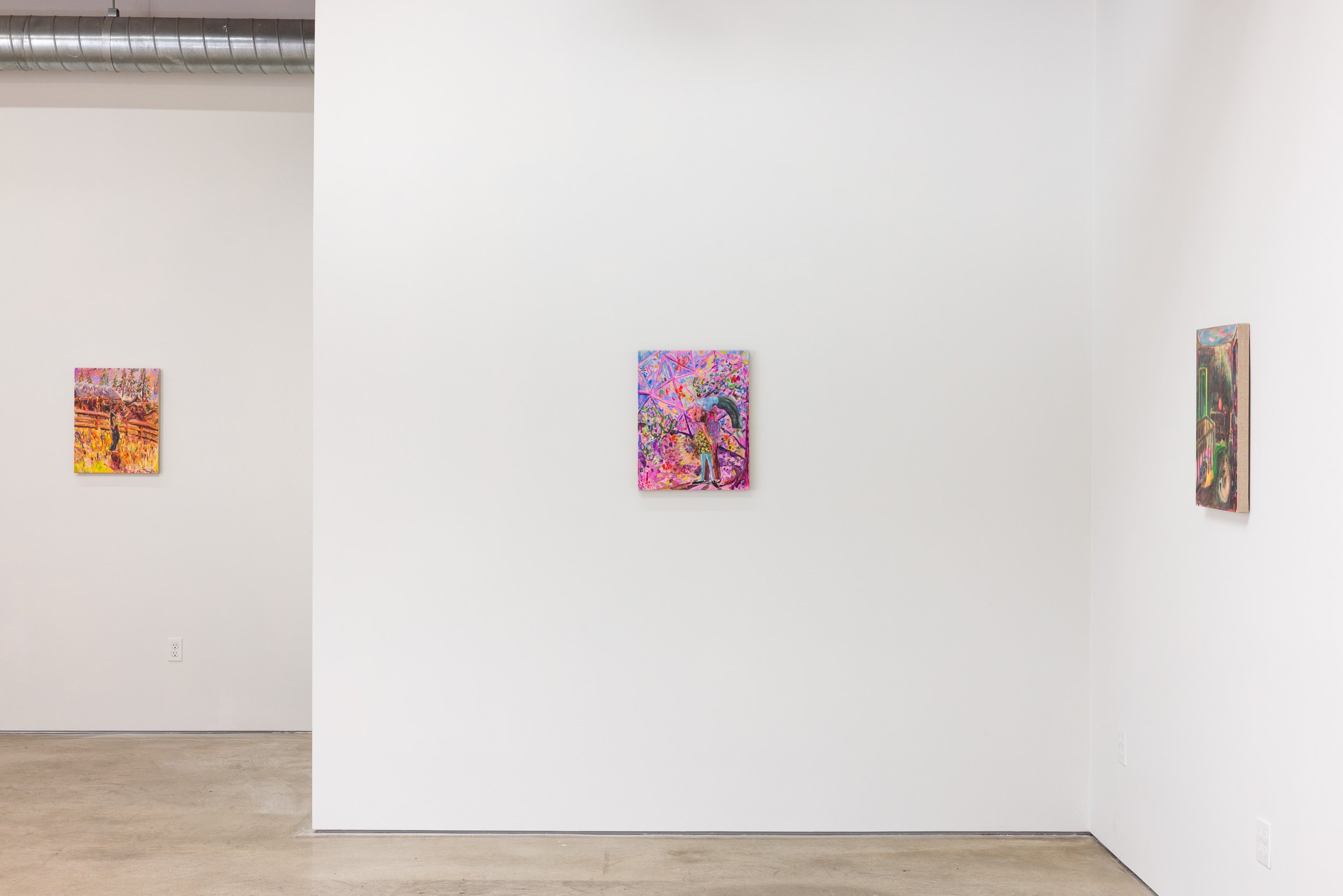
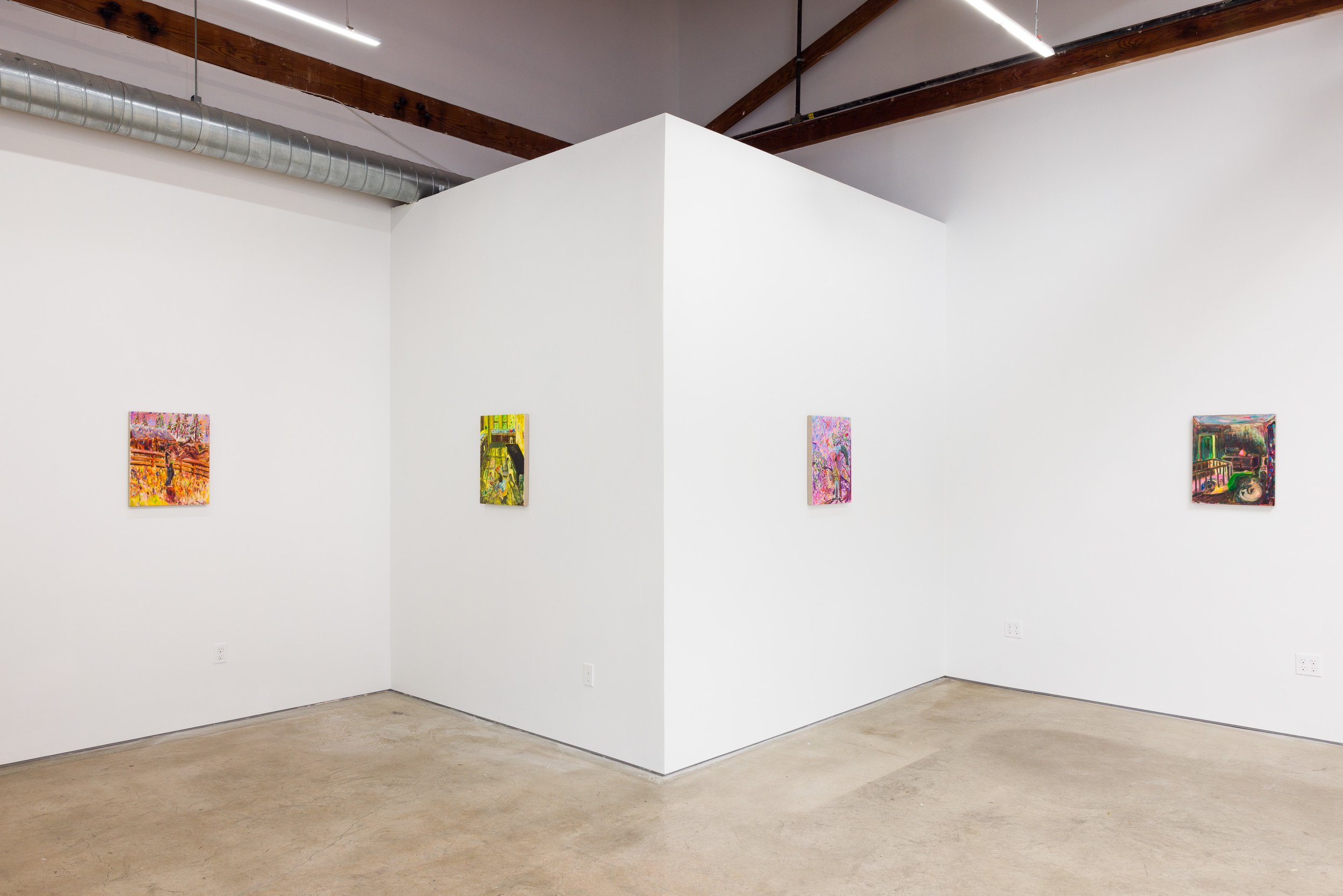
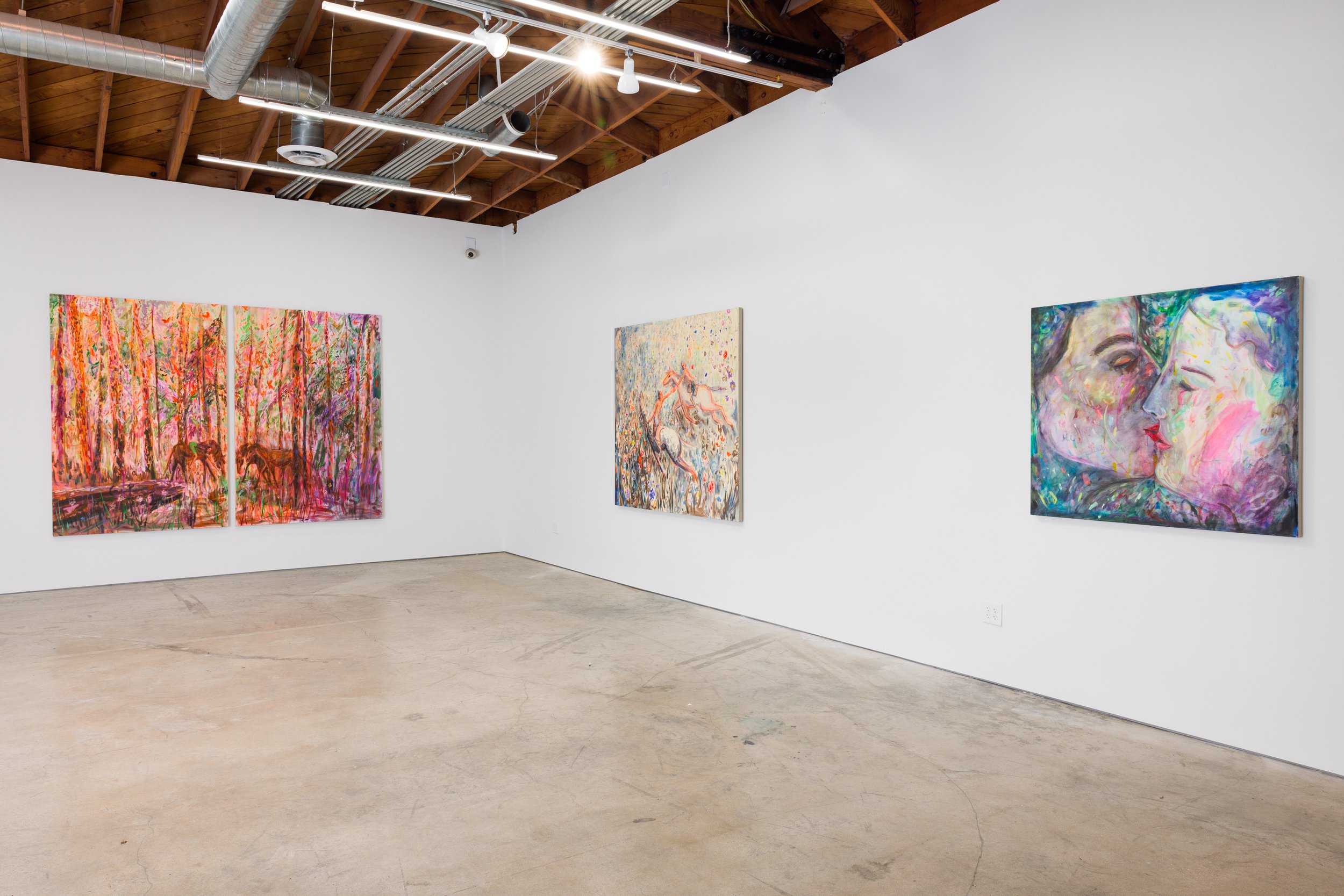
Installation Views: Kira Maria Shewfelt, The Yearlings, Make Room Los Angeles © Kira Maria Shewfelt Courtesy the artist and Make Room LA
Drawing imagery from an expansive archive, the artist’s references span cultural figures like the female matador Conchita Cintrón to autobiographical experiences, such as trips to Lake Tota in Colombia and horseback rides in December at the Michoacán butterfly sanctuary in Mexico. Dashes of color layered atop an image of lovers kissing call to mind visible supernovas, which Kira Maria has expressed as fascination with “the idea that stars are born and also die in moments of particulate friction”. For the artist, the personal can be a microcosm for the universal and understanding infinity can be as easy or challenging as knowing ourselves and relating to one another. Each point of contact imagines a shared reality. Romantic hues imbue the natural world with perceptual wonder. The corporeal body is flexible, elastic, strong, and tender. If color, light, the body, and touch are all mutable, so are the edges of the memory, dream, or images depicted. Sometimes in life, the more you wish for something, the more it becomes true, and so, with layered accumulations and veils of romantic color, the artist’s painterly incantations form visual continuities, conjuring the possibility of a synchronized, intimate, and dream-like world. The subconscious, now conscious, is the threshold where our dreams and reality collide and the artist effortlessly lets these boundaries blur. Each image is on the cusp of becoming. I encourage you, the viewer, to look long and longingly at Kira Maria’s paintings, not just at the surface, but at what glows in deep, romantic hues, shining from underneath. -Candice C. Chu Artist, writer, and contributing art editor —
© Kira Maria Shewfelt Courtesy the artist and Make Room LA
About the Artist:
Kira Maria Shewfelt (b. 1990, Los Angeles, CA) received her MFA in Drawing and Painting from New York University, her M.A. in Art History from the University of Southern California, and B.A. in Comparative Literature from Yale University. Solo exhibitions include the forthcoming The Yearlings, Make Room, Los Angeles, CA (2024). Group exhibitions include Unseen Orchestra, Make Room, Los Angeles, CA (2024); Piano, Piano, Et Al Gallery, San Francisco, CA (2023); The Angels, Baik Art Gallery & The Noblesse Collection, Seoul, Korea (2023); Untitled, Make Room Gallery, Art 021, Shanghai, China (2023); Untitled, Make Room Gallery, Art SG, Marina Bay Sands, Singapore (2023); LA Dreams 2: Light Touch, CFHILL, Stockholm, Sweden (2022); Flower Shop, Smoke the Moon, Santa Fe, NM (2022); Telescoping, False Cast Gallery, Santa Monica, CA (2022); A Body is a Home, Hyperspace, Culver City, CA (2022); Hot Tropic, La Loma Projects, Eagle Rock, CA (2021); Peripheral Reverie, Penske Projects, Montecito, CA (2020); So Far, La Loma Projects, Eagle Rock, CA (2020); In Excess, Jacob’s West, Spring Break, Art Show, Los Angeles, CA (2020).
Established in 2018, Make Room Los Angeles is a contemporary art gallery owned and directed by Emilia Yin. The newly relocated 4,500-square-foot gallery is situated in the heart of Hollywood and includes multiple exhibition spaces, an outdoor courtyard, and a garden. The gallery’s dynamic program champions emerging artists, many of them female, with a particular emphasis on artists of the Asian diasporas. In both its physical gallery – which features solo and group exhibitions – and its ambitious off-site projects with international collaborators, Make Room supports its artists’ visionary projects and the development of new bodies of work. Since its opening, Make Room and its programming has been featured extensively in leading arts and news publications, including Artforum, Artnet News, Hyperallergic, Juxtapoz, the Los Angeles Times, Office Magazine, Ocula Magazine, the Observer, Purple Diary, and the Financial Times, among others. In 2022, Emilia Yin was named one of Forbes’ 30 Under 30, highlighted as a new force in the contemporary art world.
For more information about this exhibition and others, please visit Make Room Los Angeles website here. The gallery can also be found on Facebook and Instagram.
Joe Bradley : Vom Abend
Joe Bradley, Salute, 2023-2024 © Joe Bradley Courtesy the artist and David Zwirner
David Zwirner is pleased to announce Vom Abend, an exhibition of new paintings by Joe Bradley at the gallery’s 533 West 19th Street location. This will be Bradley’s debut exhibition with David Zwirner, following the announcement of his representation by the gallery in May 2023. On view will be a group of large-format paintings that build on the forms and compositional structures Bradley has been exploring in recent years.
Joe Bradley, Flat Earth, 2023-2024 © Joe Bradley Courtesy the artist and David Zwirner
Developed over several years through a deliberate process of painterly accumulation and adaptation, the works in this exhibition are marked by an unassuming yet assertive sense of compositional balance whereby the interrelation of individual parts—such as patches of color, stipples of paint, and lines that at times outline shapes and forms and at others float freely—cohere into a resounding whole. As the artist notes, “I think these things couldn’t be made any other way, and there’s a sort of quality that they get from brewing and developing over time. There’s a pleasure to making a mark next to a mark that you made a year and a half ago, and a certain disconnect that happens there that I think is meaningful, that allows for a sort of forward motion. Part of what I’m looking for is a surface quality, and that’s something that you can’t arrive at in a day or a week or a month. It has to feel like it has a sort of history and that it’s been through some skirmishes.” 1
Joe Bradley, Hash Eater, 2023-2024 © Joe Bradley Courtesy the artist and David Zwirner
Bradley worked on the paintings simultaneously, letting the process of developing each one play off of or influence the others. As a result, shared or related elements and palettes recur throughout in different and surprising ways. Modest-sized circular forms that appear in the periphery in one painting find larger, more centralized counterparts in another. Specific colors from Bradley’s lively palette of reds, blues, greens, yellows, and oranges are applied in large swaths of paint in some works and in others they are used like accents or interjections that create strong visual contrasts. Densely applied passages of speckled paint and daubs of oil provide texture and color modulation in certain areas of individual paintings, while in others the dots are larger and more sparingly applied, appearing like celestial expanses or evening skyscapes.
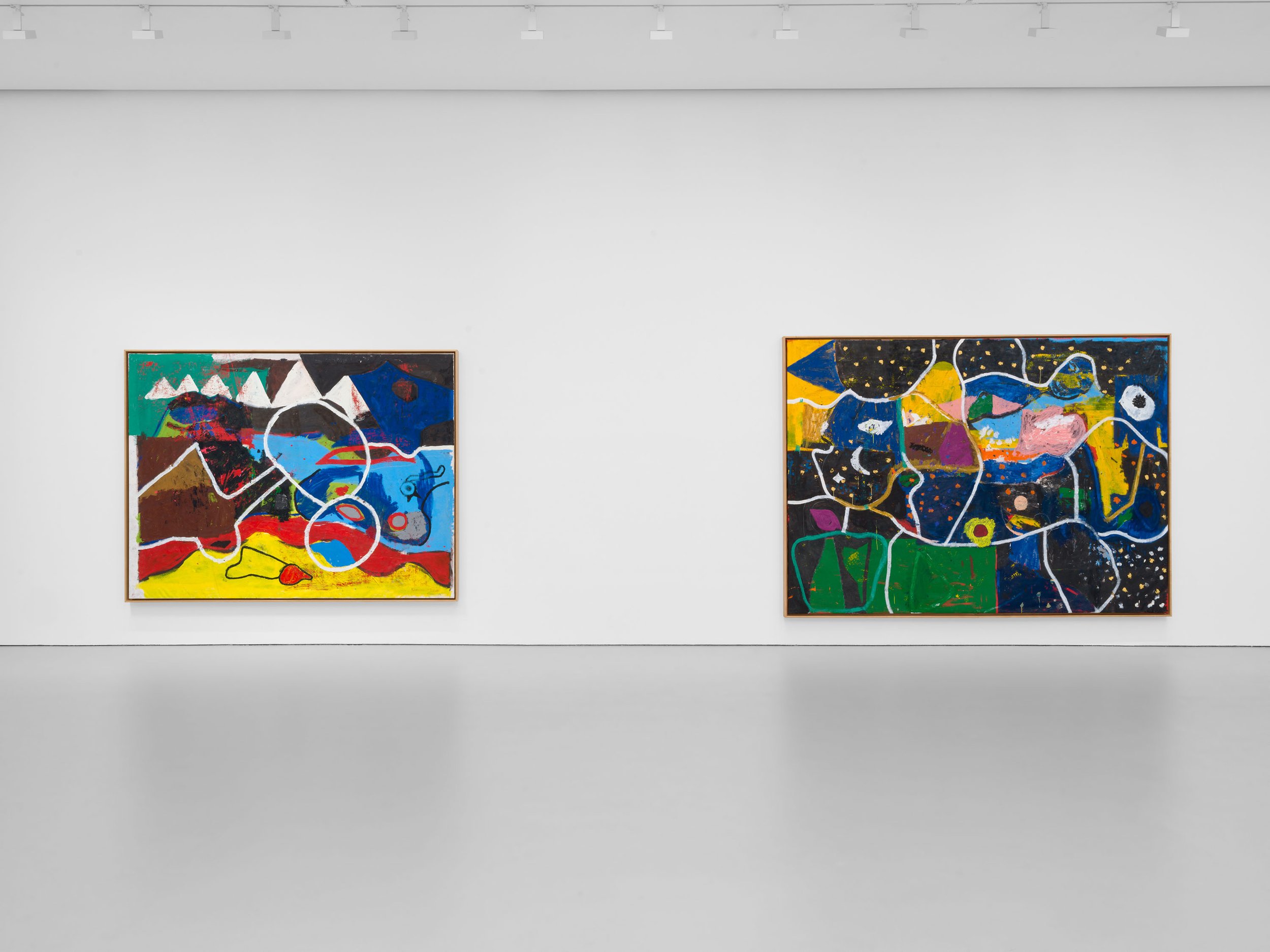
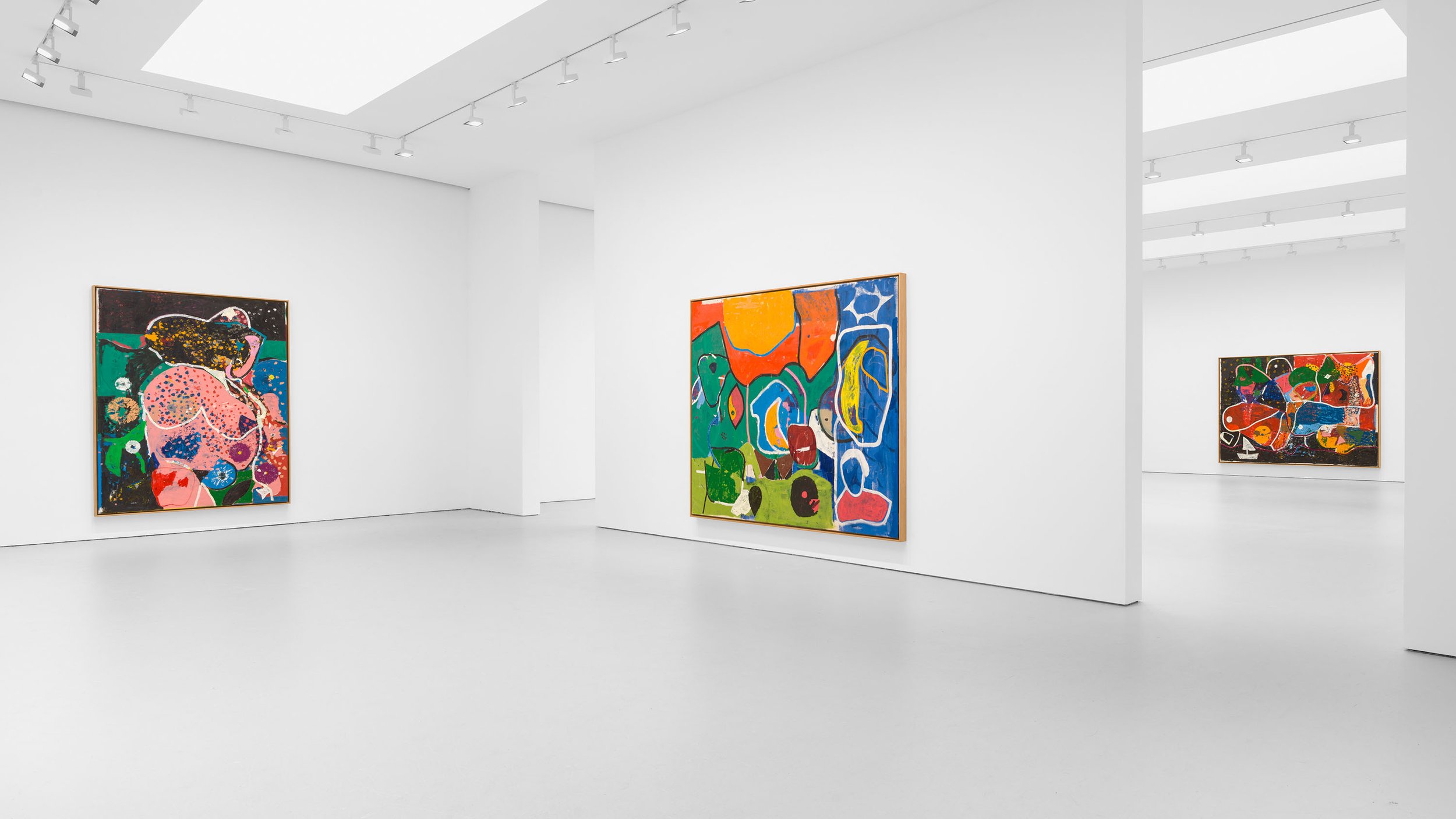
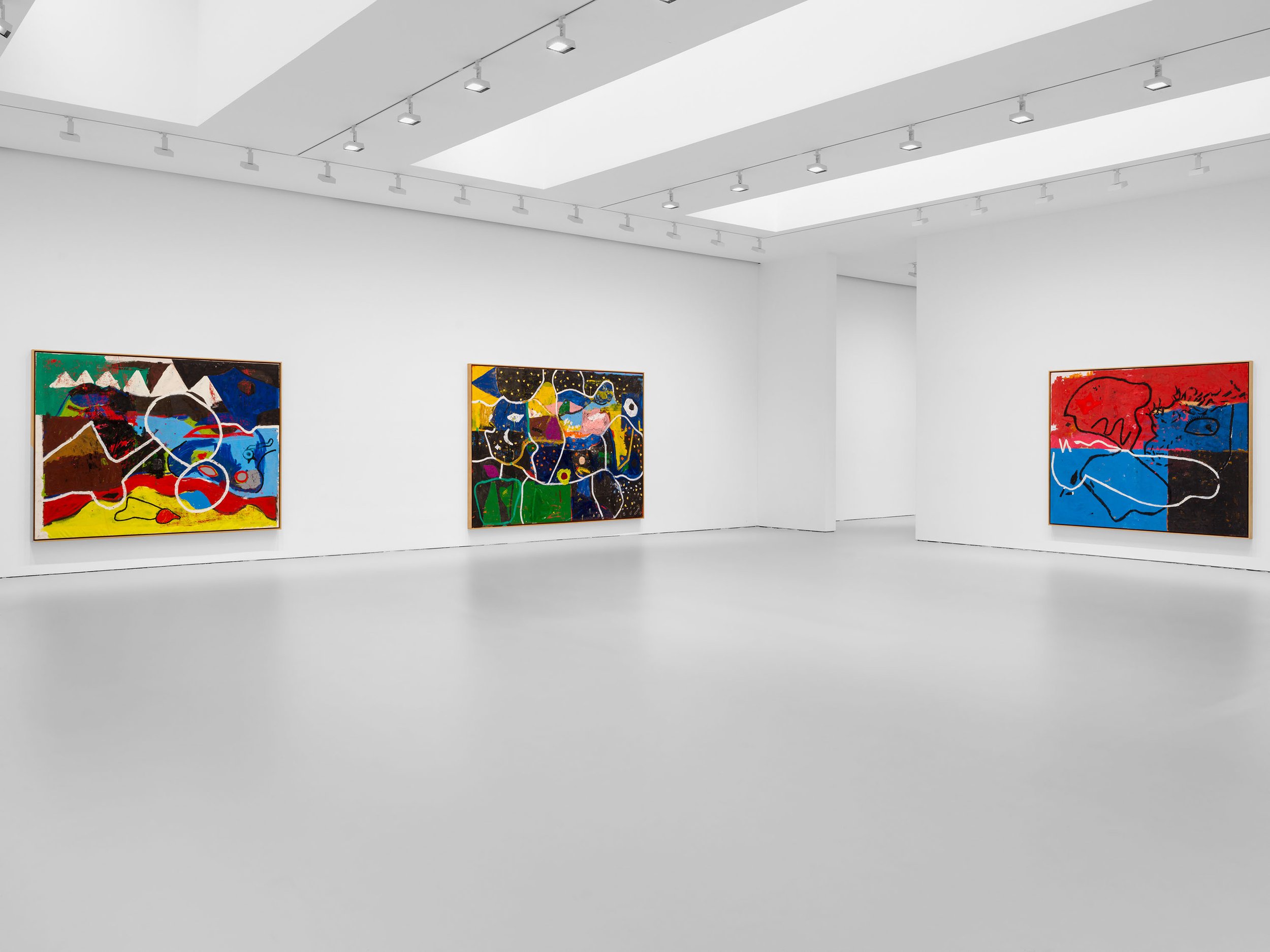
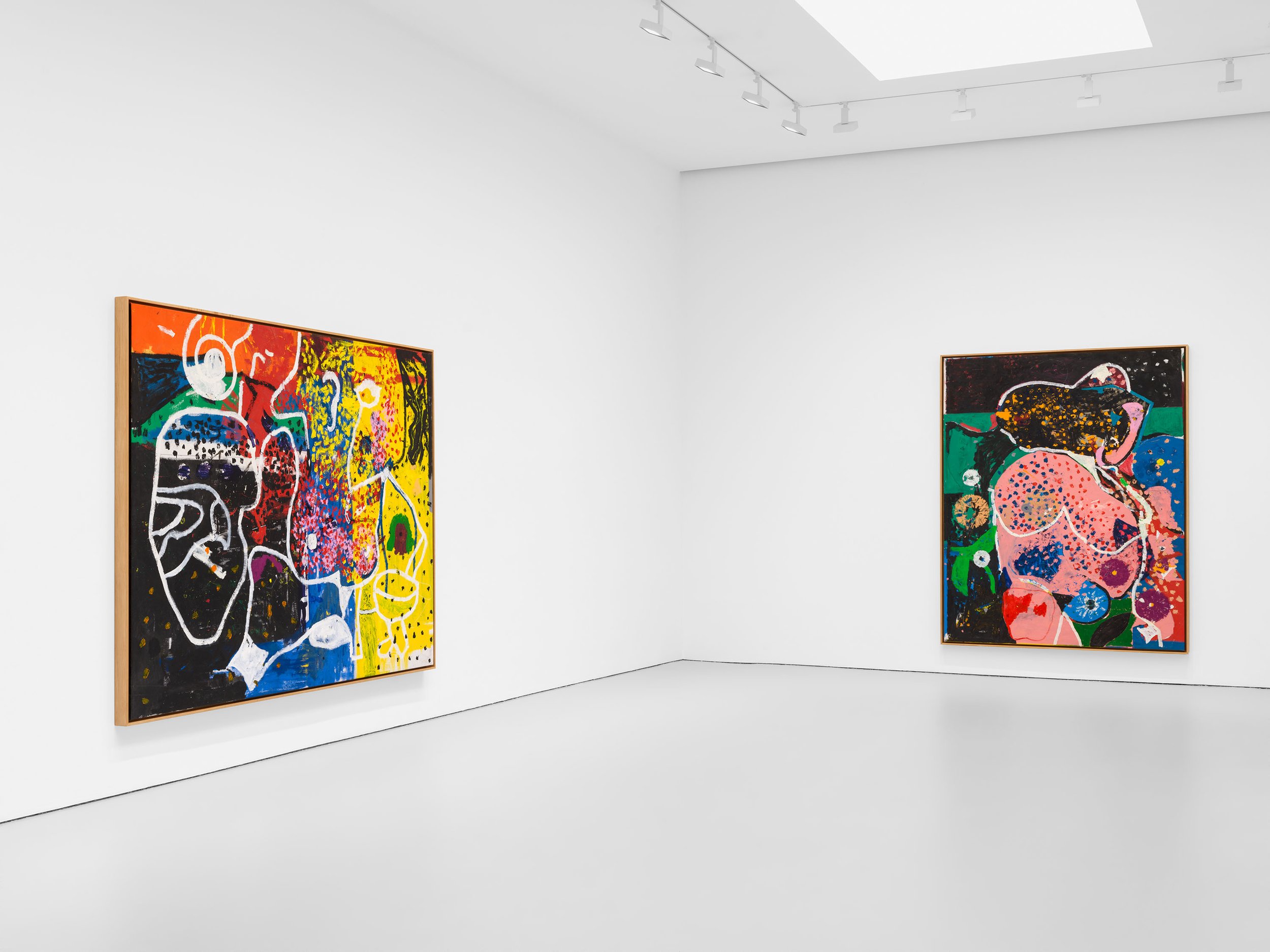
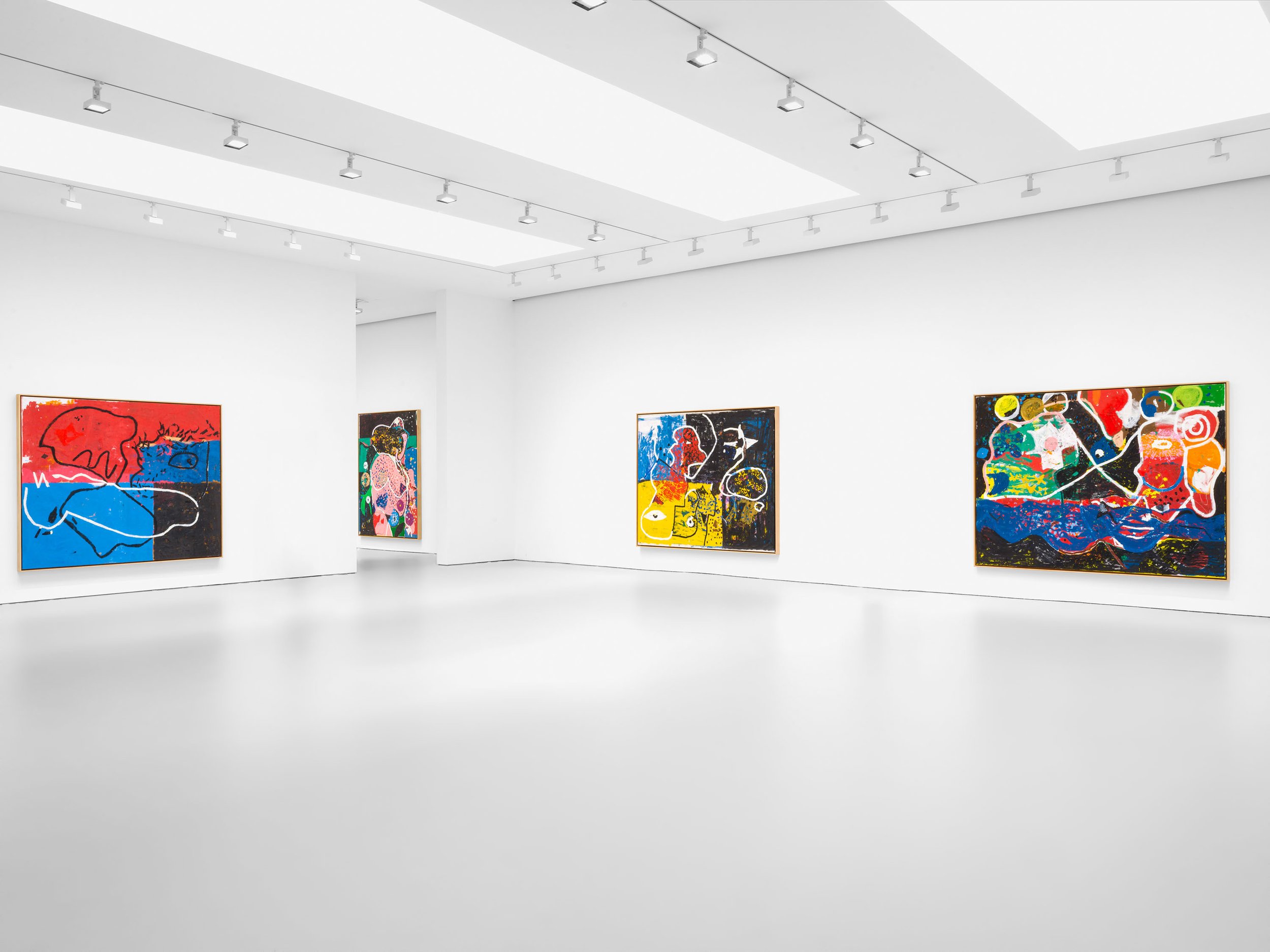
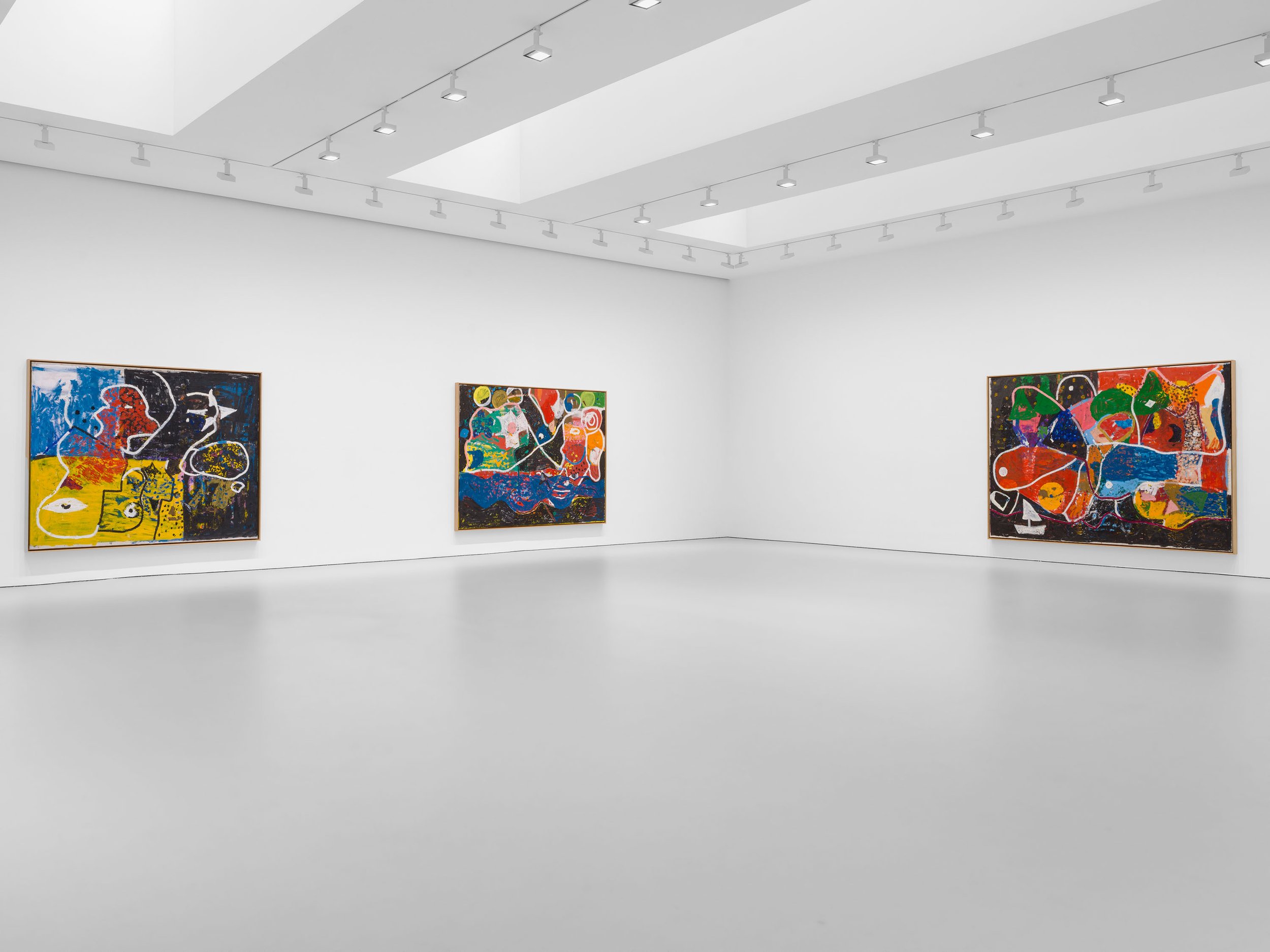
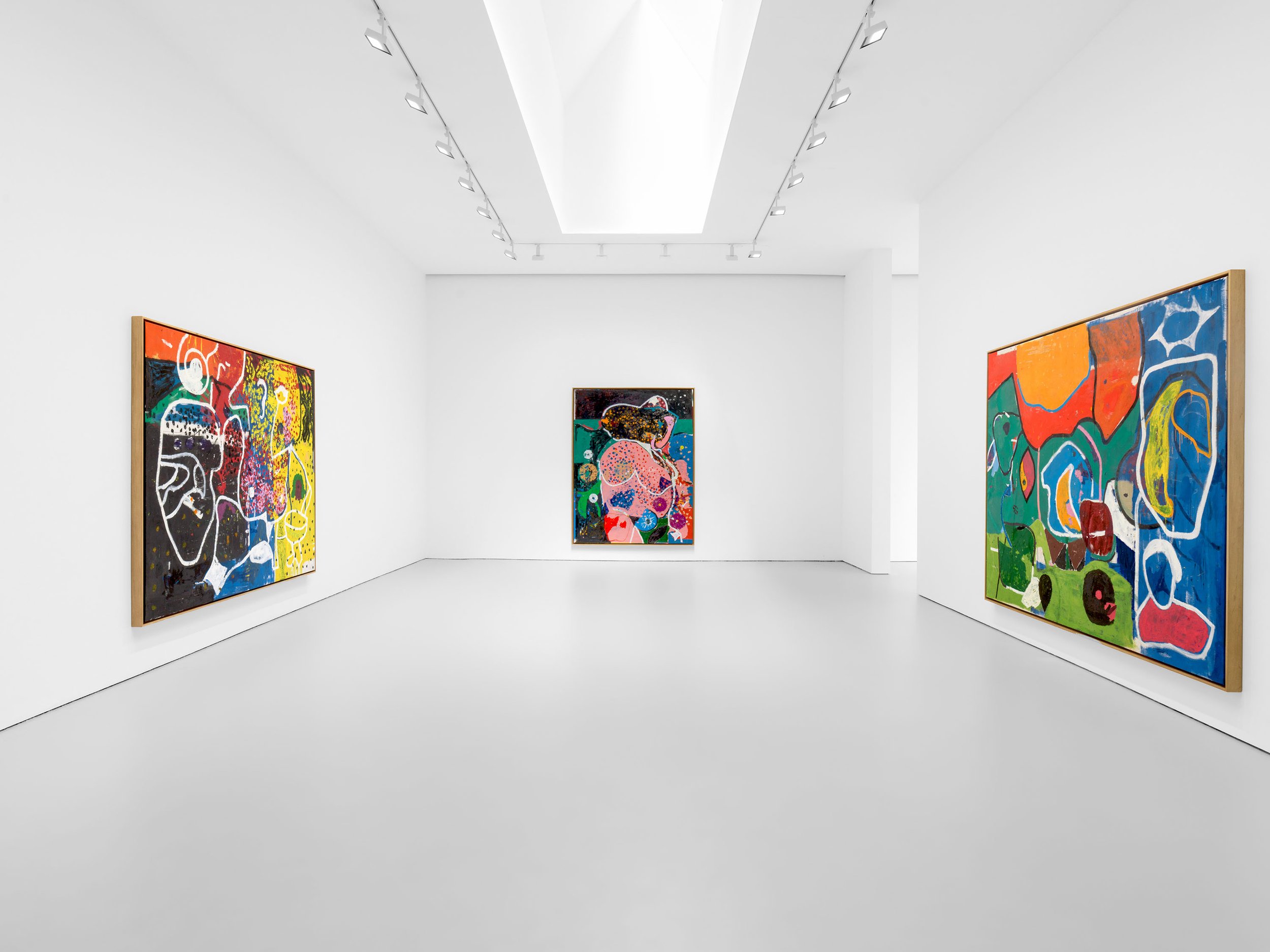
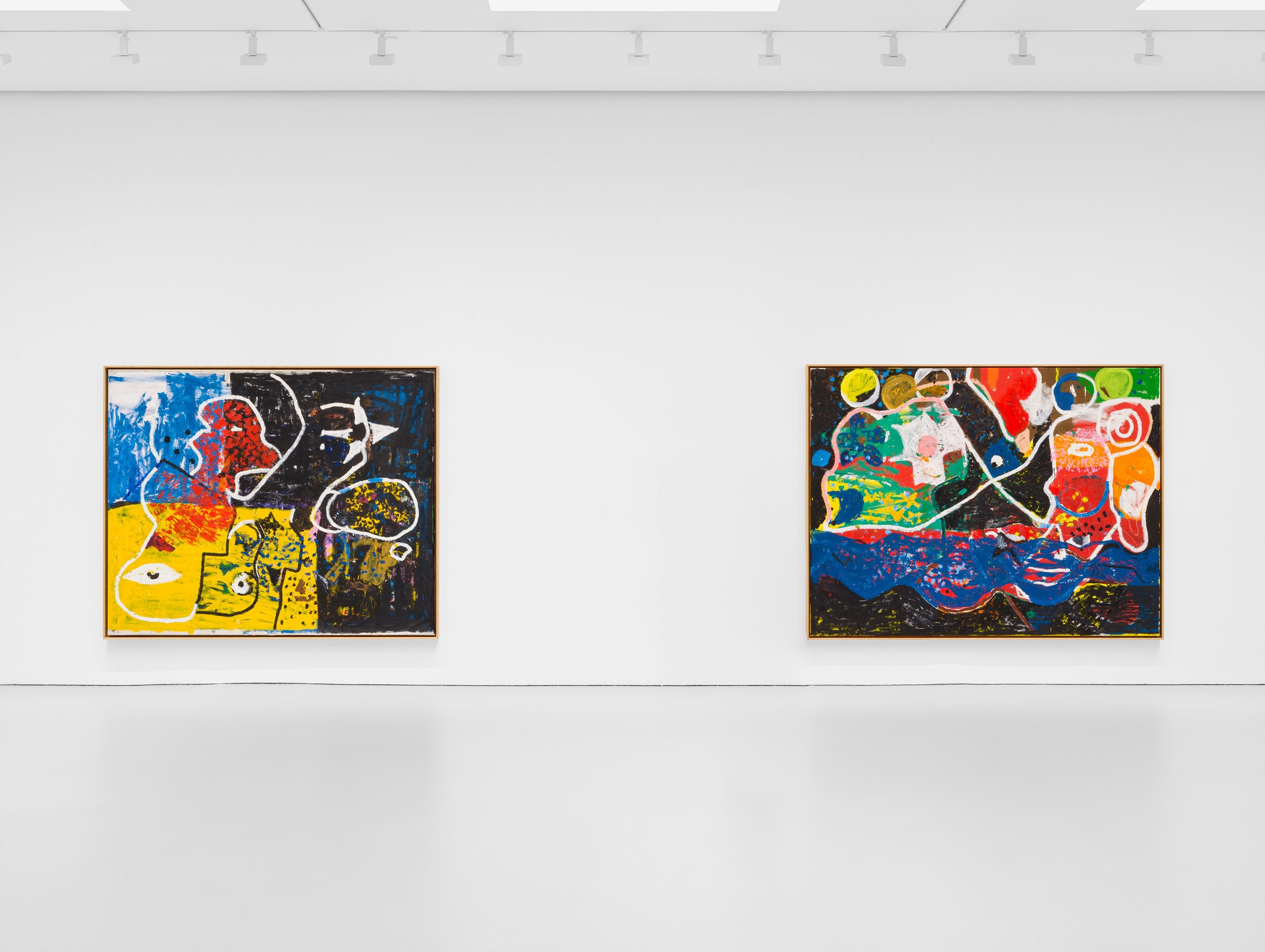
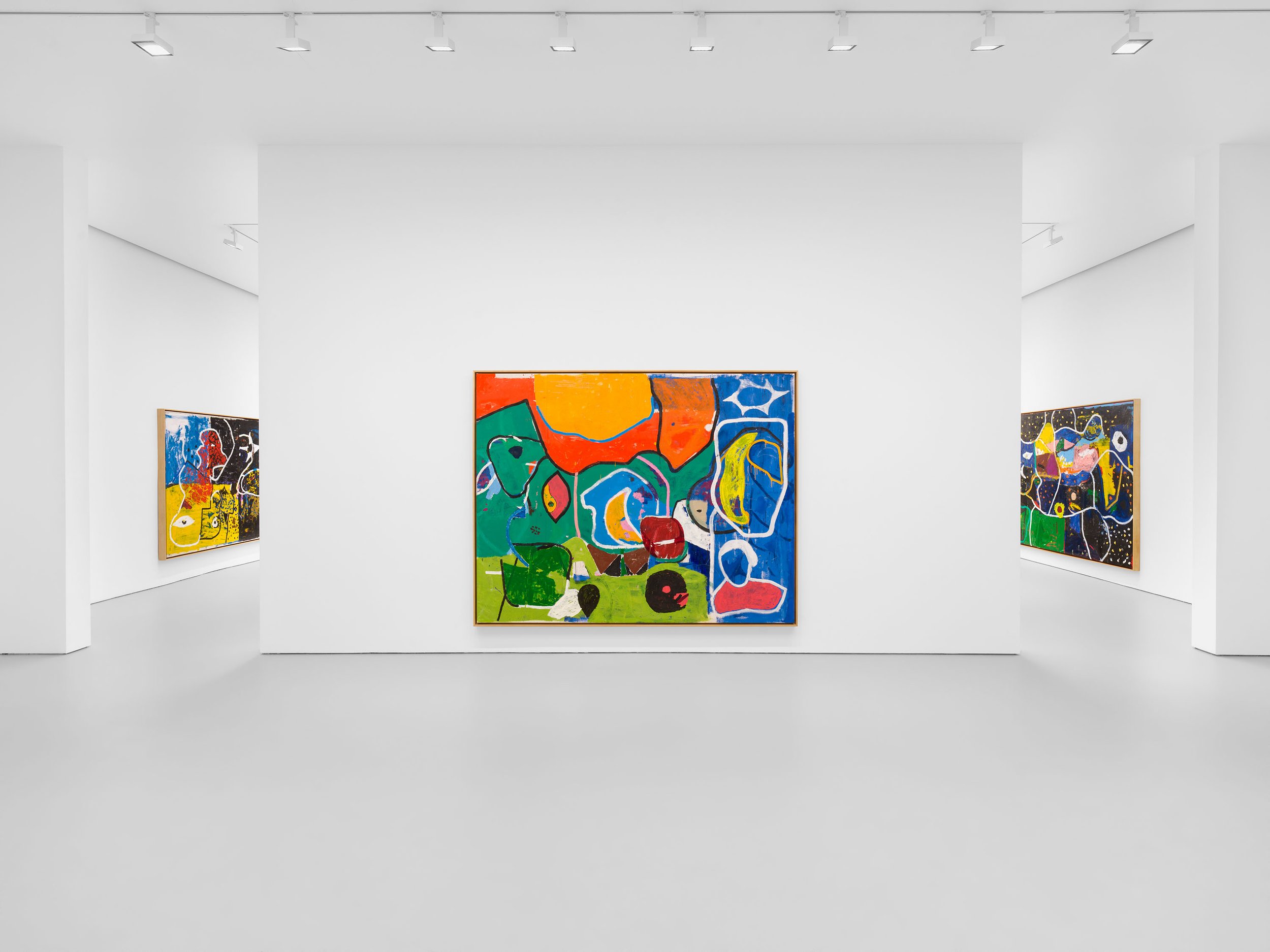

Installation view, Joe Bradley: Vom Abend, David Zwirner, New York, April 11–May 18, 2024 Courtesy David Zwirner
Though they represent a continuation of the painterly trajectory the artist has been pursuing since the middle of the 2010s, these paintings also reflect new turns in Bradley’s practice. As part of the evolution of the artist’s work over the past ten years, figurative elements have started to become more evident in these paintings than in prior ones. The subtle suggestion of faces, animal-like figures, plants, and other organic forms are legible throughout the works. Cosmic abstractions that look like moons or suns mix with eye-like shapes that recall the works of Alexander Calder or Joan Miró, and yet any figurative or stylistic references appear as part of an overall collaging of form, color, and facture without any one feature dominating. On this, Bradley says, “Abstract painting doesn’t feel totally on the nose with these anymore. There are nods and references to the world around us, and to forms and nature, and animals and plants. Those sorts of things are really starting to come to the surface. I think that’s something that interests me. The idea of things emerging. Things forming and dissolving in and on the painting.” 2
Joe Bradley, Kalparush, 2023-2024 © Joe Bradley Courtesy the artist and David Zwirner
Line, which had faded from Bradley’s painterly repertoire for a period of time, has reappeared in recent years—here as white and dark bands that read like pictographic overpainting in some areas, or like outlines demarcating patches of colored ground. Drawing has long been an important medium for Bradley, and his use of line in these paintings reflects the novel ways in which he has come to balance the linear and the painterly in his work.
In addition to the exhibition, David Zwirner Books will be producing a major publication on Bradley, which is scheduled to be released in 2025.
Joe Bradley, 2023. Photo by Jason Schmidt. Courtesy David Zwirner.
Joe Bradley (b. 1975) was born in Kittery, Maine, and received his BFA from the Rhode Island School of Design in 1999. He presently lives and works in New York.
Joe Bradley, Occident, 2023-2024 © Joe Bradley Courtesy the artist and David Zwirner
The artist’s inaugural solo exhibition took place at Allston Skirt Gallery, Boston, in 2002. In 2006, Bradley’s first institutional solo exhibition opened at MoMA PS1, New York. The artist’s work has since been the subject of several international exhibitions. Notably, a mid-career survey of Bradley’s work was organized in 2017 by the Buffalo AKG Art Museum (formerly known as the Albright–Knox Art Gallery) in Buffalo, New York, which later traveled to the Rose Art Museum, Brandeis University, Waltham, Massachusetts. In the same year, the Fundación Almine y Bernard Ruiz-Picasso organized a presentation of Bradley’s sculptures at Pablo Picasso’s former home and studio at the Château de Boisgeloup, Gisors, France. A solo exhibition of Bradley’s work was presented at Le Consortium, Dijon, France, in 2014.
Joe Bradley, Angel's Trumpet, 2023-2024 © Joe Bradley Courtesy the artist and David Zwirner
Significant group exhibitions including the artist’s work have been presented at the de la Cruz Collection, Miami (2019 and 2020); The Brant Foundation Art Study Center, Greenwich, Connecticut (2017 and 2018); Kunstmuseum Bonn, Germany (2015); The Museum of Modern Art, New York (2014); MoMA PS1, New York (2013); and Centro per l'arte contemporanea Luigi Pecci, Prato, Italy (2013); among others. In 2008, Bradley was selected to participate in the Whitney Biennial.
This solo exhibition of Bradley’s work at David Zwirner, New York, is the gallery’s first presentation of his work since the announcement of his representation in May 2023.
Work by the artist is held in distinguished public collections such as the Buffalo AKG Art Museum, Buffalo, New York; de la Cruz Collection, Miami; Fondation Louis Vuitton, Paris; George Economou Collection, Athens; Hall Art Foundation, Reading, Vermont; Mead Art Museum, Amherst College, Amherst, Massachusetts; The Museum of Modern Art, New York; and Whitney Museum of American Art, New York.
This exhibition opened on April 11th and will close on the 18th of May 2024 at the New York location at 533 West 19th Street, New York. For more information about this exhibit, visit David Zwirner’s site; you can also follow them on Instagram and find the gallery on Artsy here.
Citations
1 Bradley in conversation with the gallery, March 2024.
2 Ibid
Richard Serra : Six Large Drawings
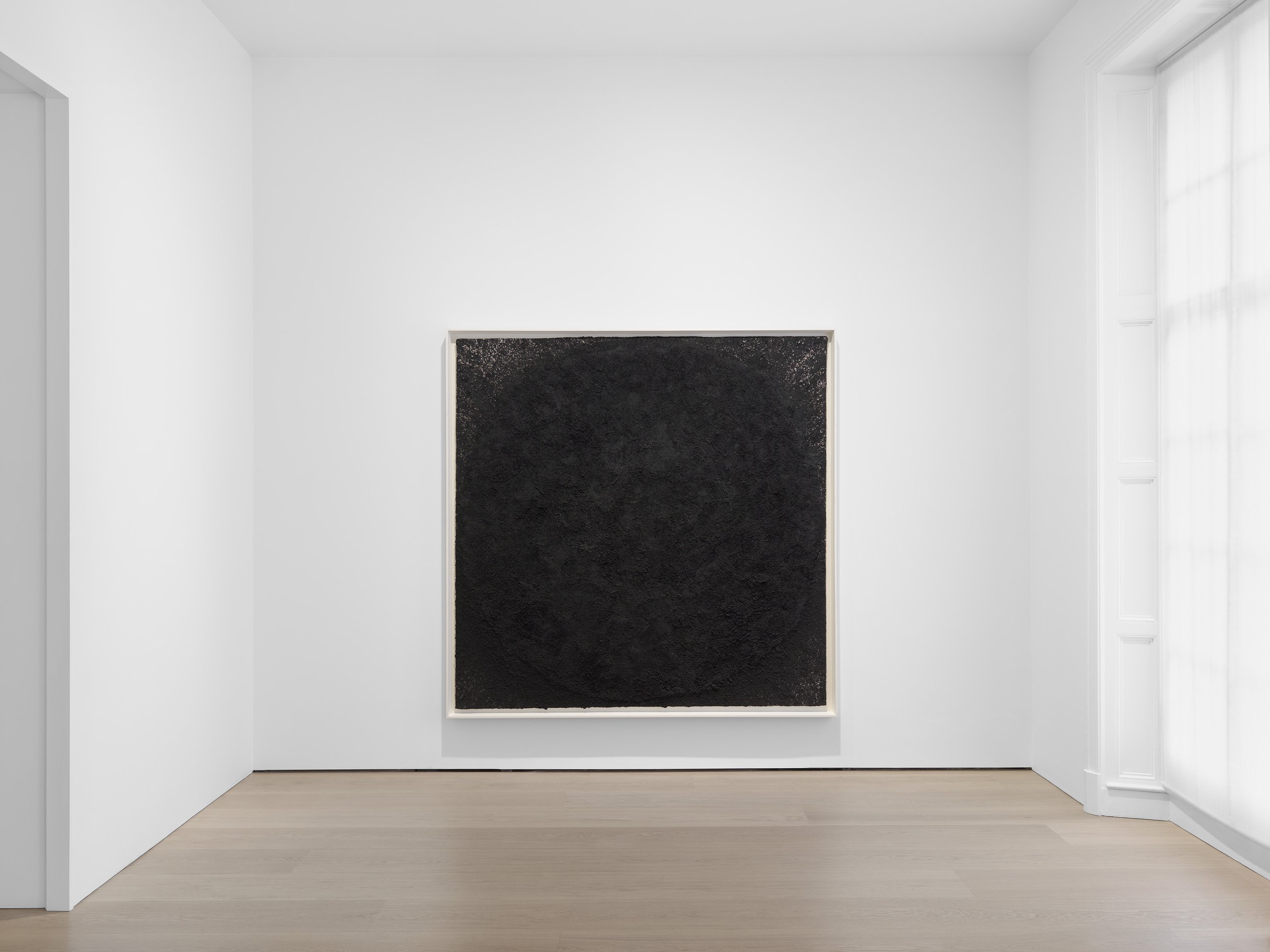
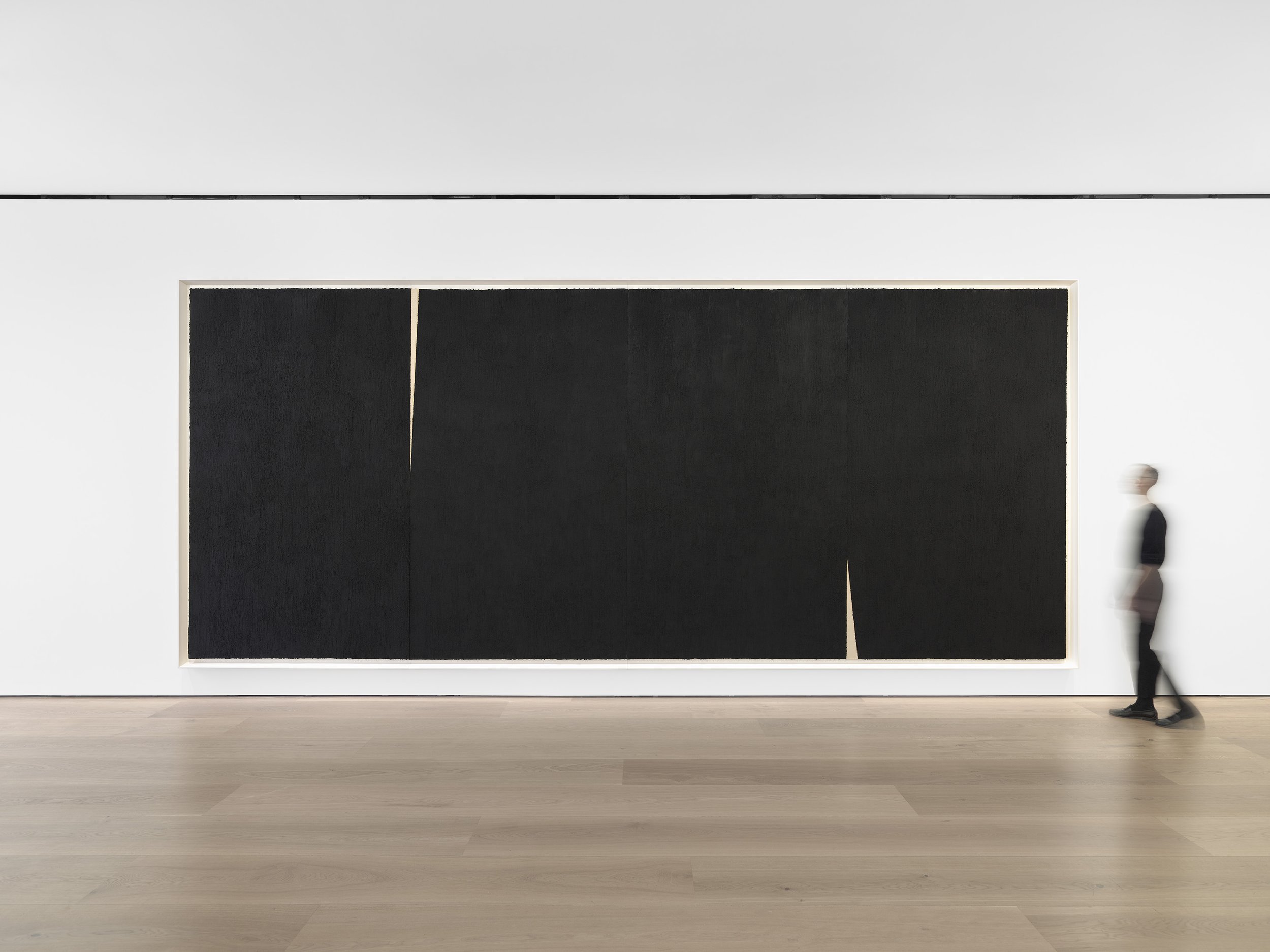
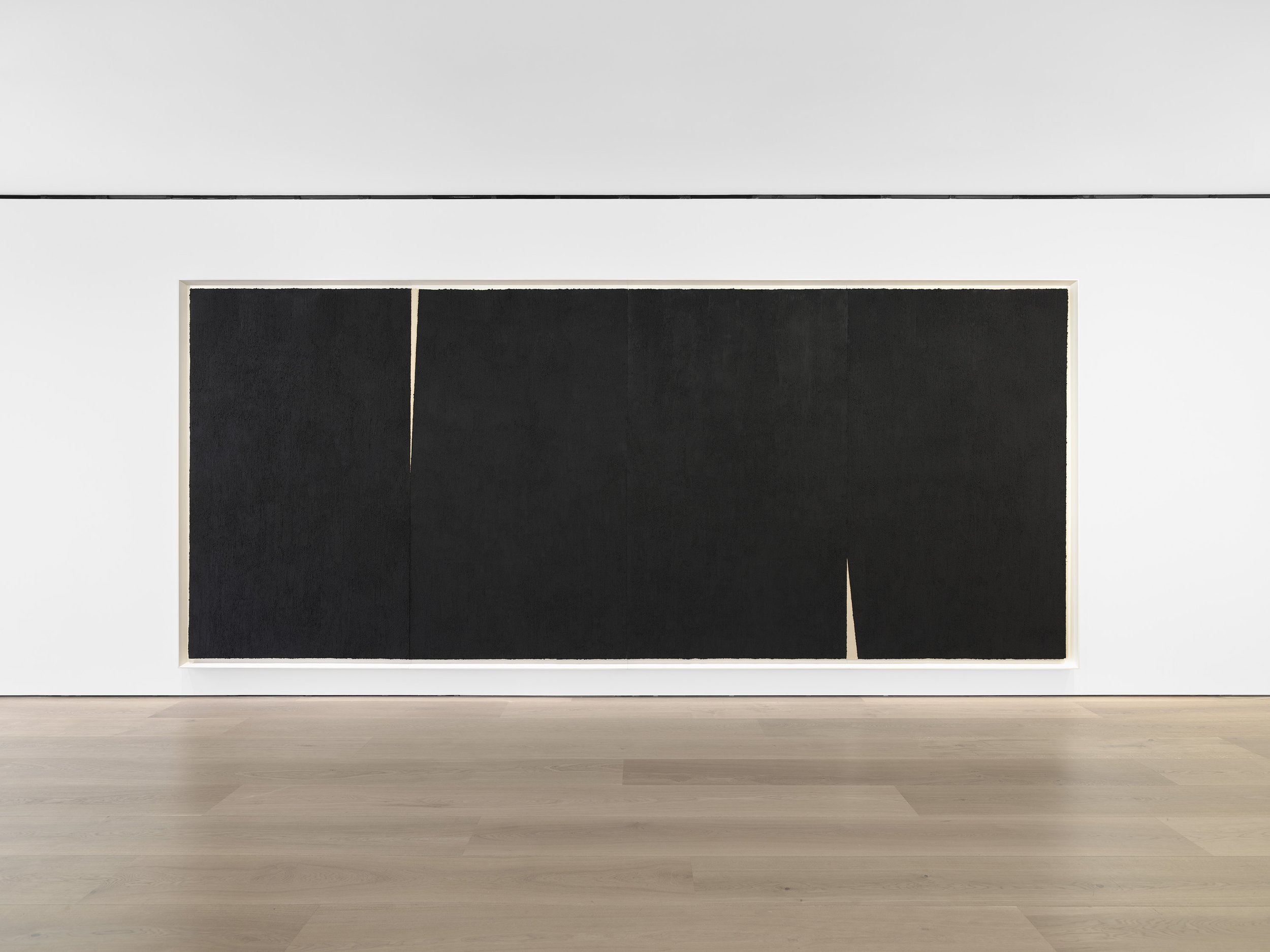
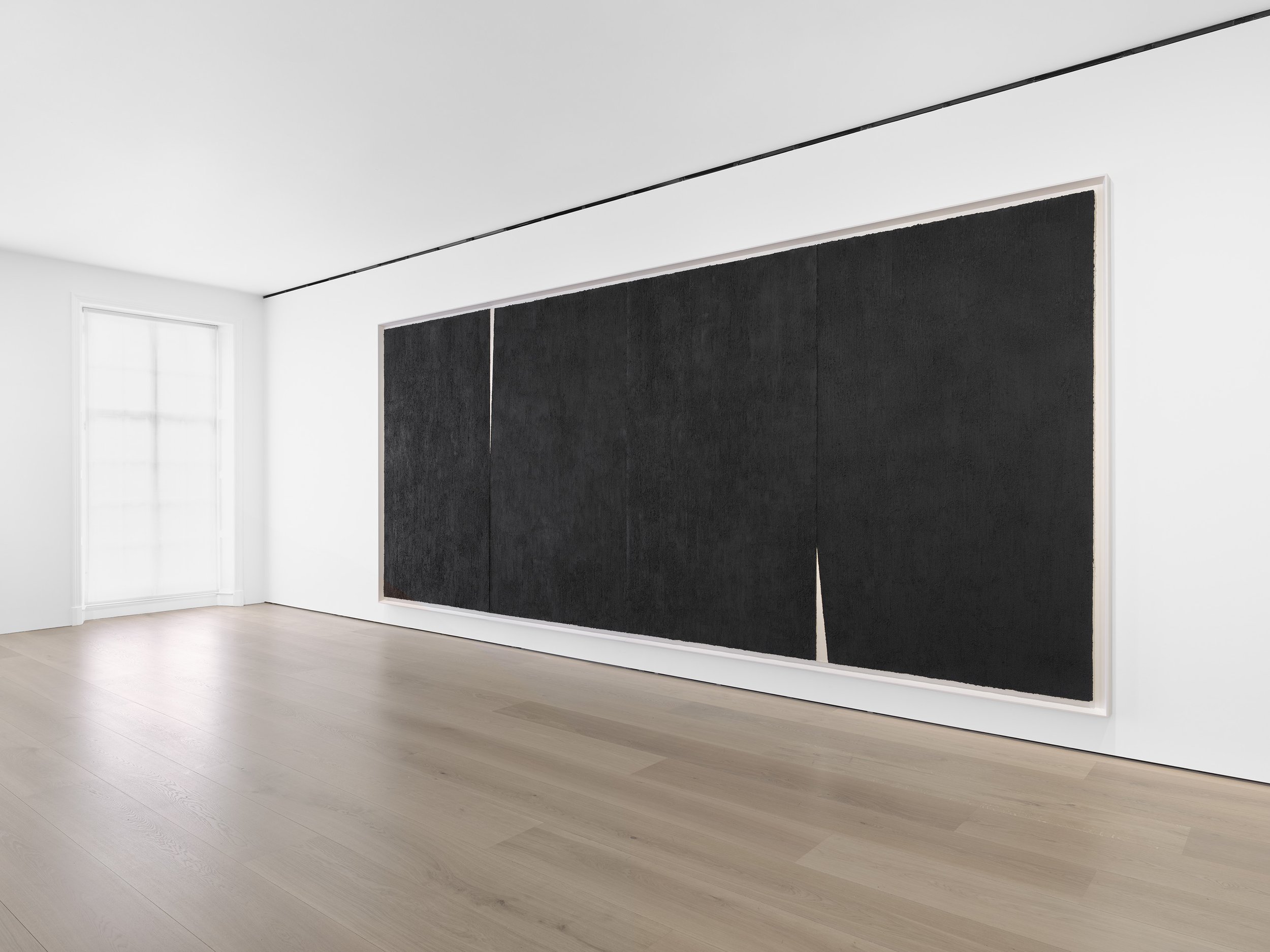
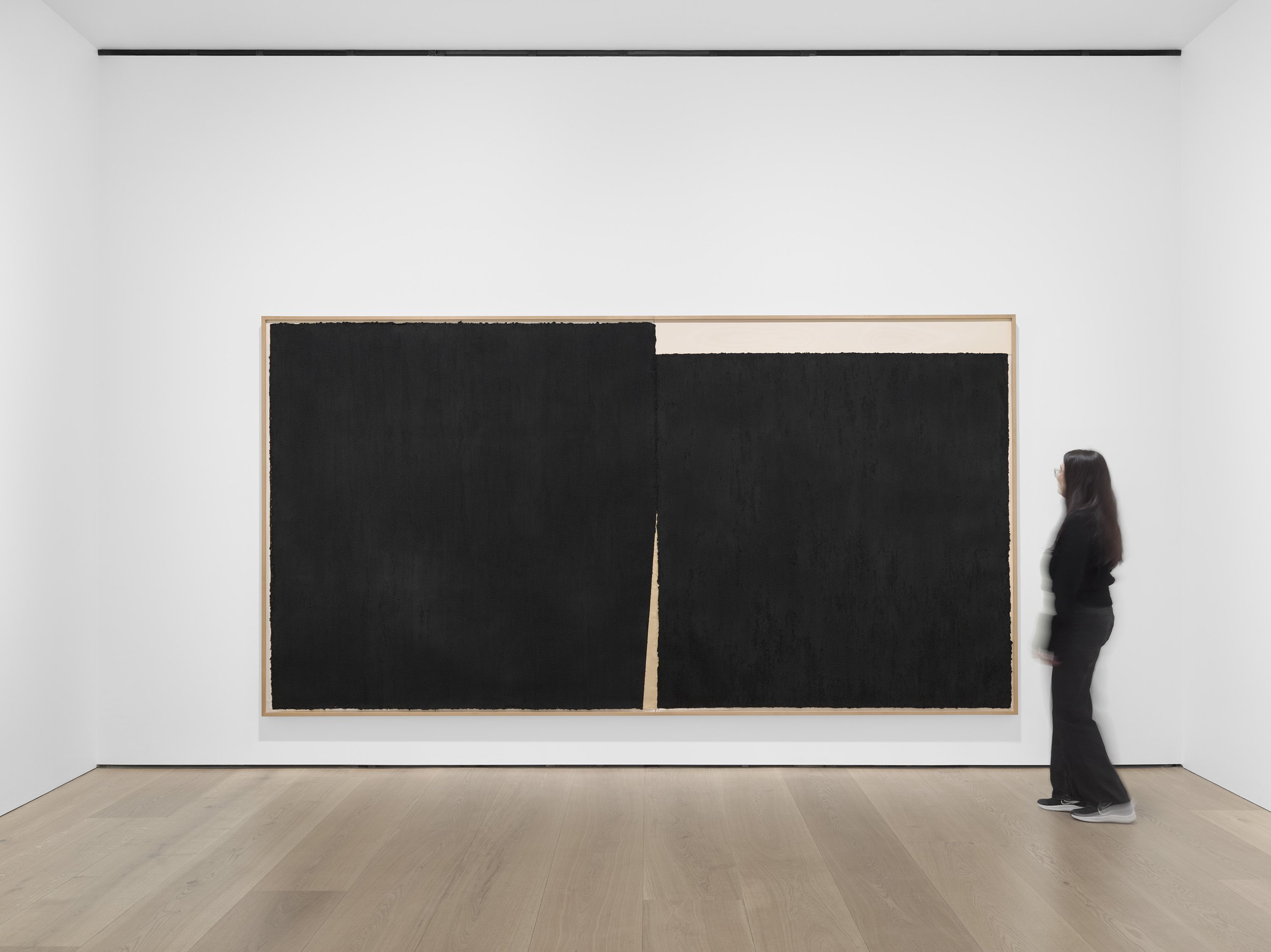
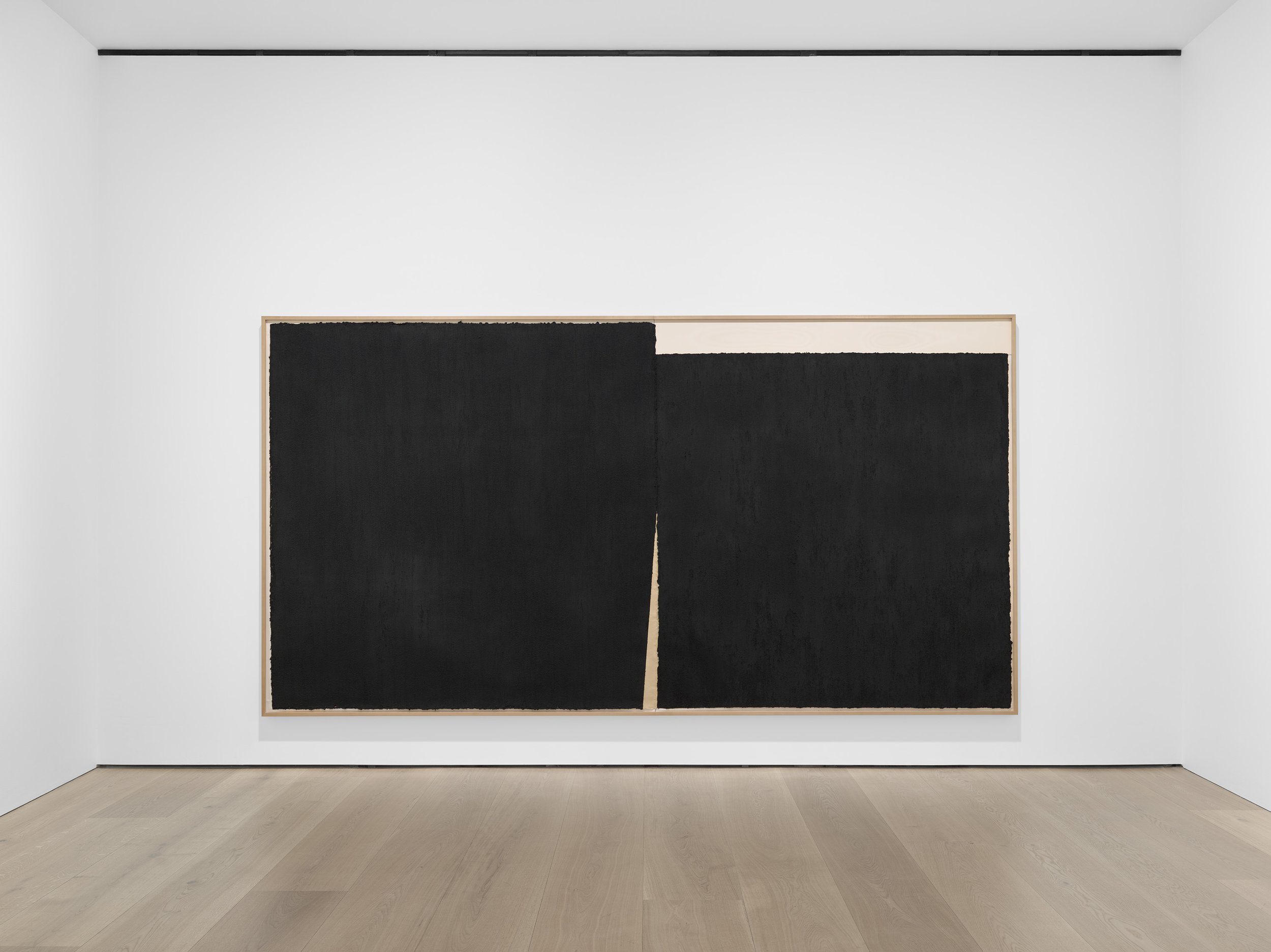
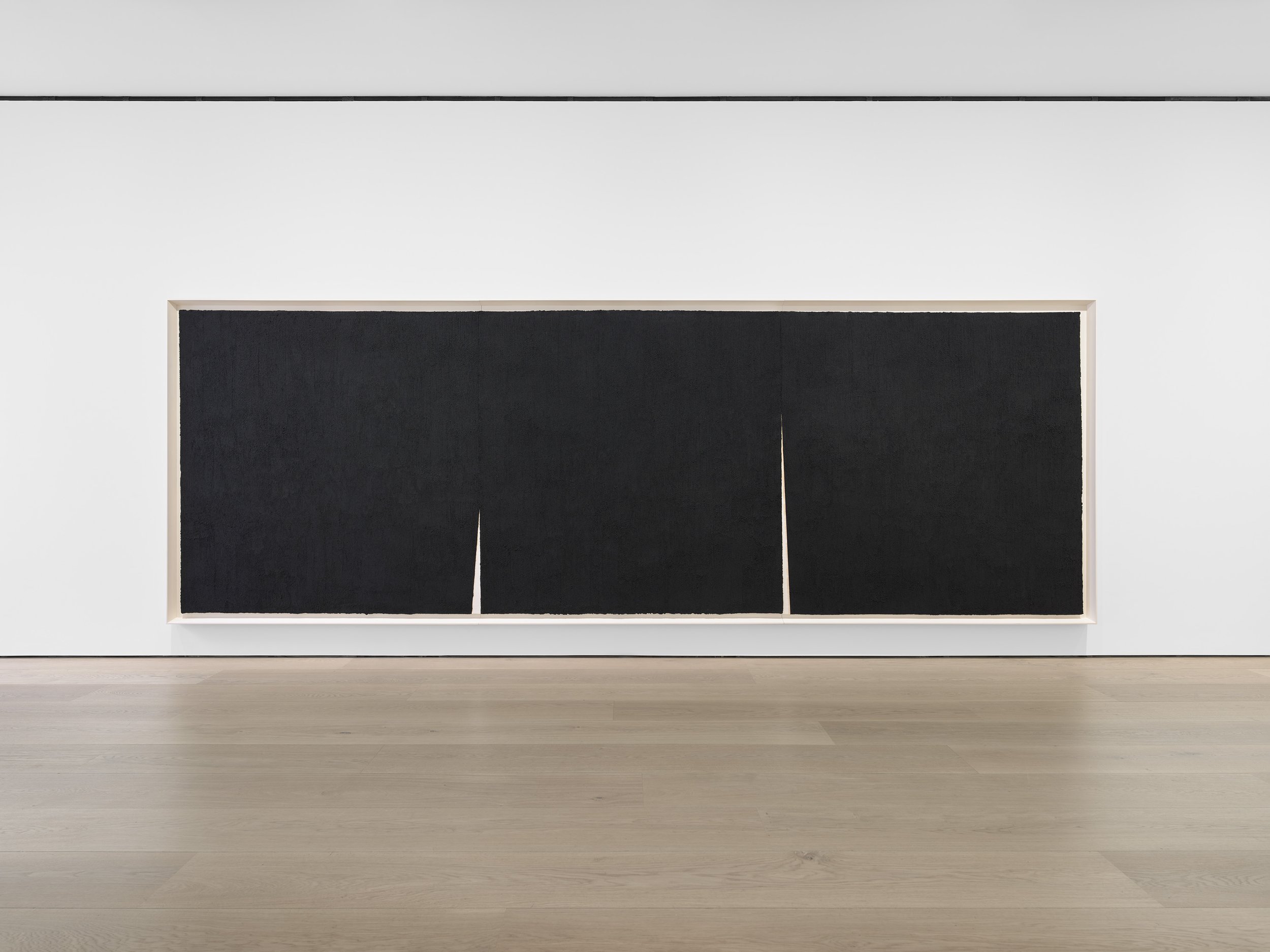
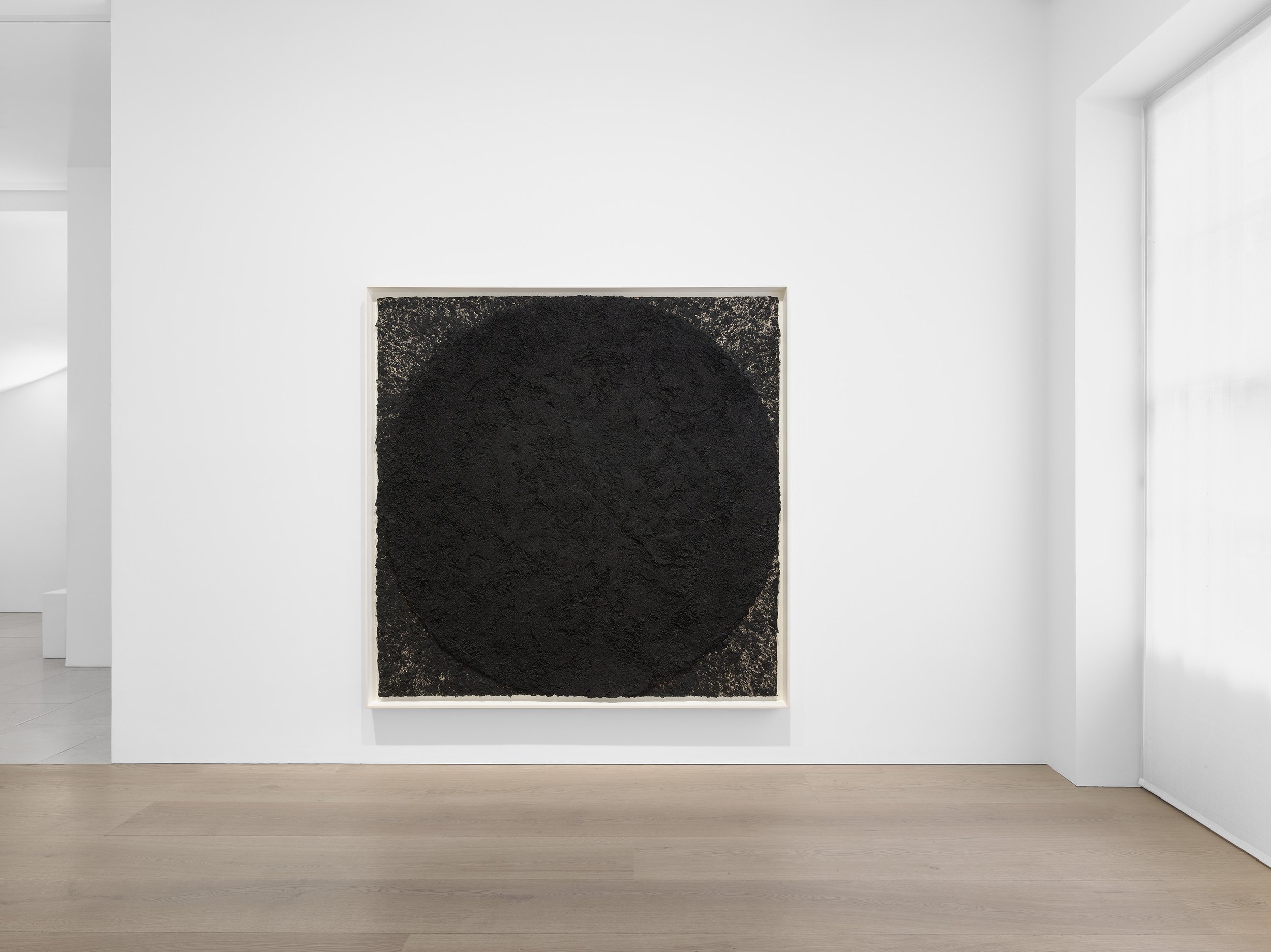
Installation Views: Richard Serra, Six Large Drawings, David Zwirner, London © Richard Serra Courtesy the artist and David Zwirner
Black is a property, not a quality. In terms of weight, black is heavier, creates a larger volume, holds itself in a more compressed field. It is comparable to forging. Since black is the densest color material, it absorbs and dissipates light to a maximum and thereby changes the artificial as well as the natural light in a given room. A black shape can hold its space and place in relation to a larger volume and alter the mass of that volume readily. 1 –Richard Serra
The exhibition of six significant drawings by American artist Richard Serra (1938–2024) are on view at the gallery’s 24 Grafton Street location in London.
Known for his large-scale, site-specific sculptures, Serra consistently produced drawings throughout his career. Beginning in 1971, the artist employed black paintstick (compressed oil paint, wax, and pigment) to create these works. Six Large Drawings is the last exhibition conceived by the artist during his lifetime. Reflecting a considered installation across both floors of the gallery, the presentation includes two of Serra’s large-scale diptychs from the early 1990s, two works from his series of Greenpoint Rounds (begun in 2009), and two multipanel Rift drawings (begun in 2011).
Richard Serra Triple Rift #2, 2018 Paintstick on four sheets of handmade Japanese paper © Richard Serra/Artists Rights Society (ARS), New York/ (DACS), London Courtesy the artist and David Zwirner
As Serra noted about the diptychs: ‘They are masses in relation to each other. They are not about composition or figure ground. They emphasize the comparison of different weights in juxtaposition.’ 2 He has also noted: ‘The construction of these large horizontal drawings refers to something I observed in Machu Picchu in Peru when I went there in 1974. The builders of Machu Picchu cut stones on the site and fit irregular shapes together; oftentimes, the edges only touch on one facet, and then there’s a void between them. It’s not that I went back to look at the notebook notations that I made in Cuzco when I started these drawings, but I’m sure it’s something that seeped into my memory. It is not that these horizontal constructions represent something I’d seen, but it means that there’s something in the reservoir of my understanding of how forms came together that I applied.’ 3
Since 1996, Serra revisited the circular format of ‘rounds’ in various iterations over the course of his career. On view are two works from the artist’s 2009 series of Greenpoint Rounds, which measure approximately eighty inches square. As he noted: ‘What happens in the [earlier Rounds] is that splatters, which are results of the process of making, start to animate the field. I've been working on a new series of large Rounds now since July [2009], trying to see if I could find a way to obliterate the shape even more, so that you are immediately drawn into the field of the drawing without focusing on the shape. What I tried to achieve with the Rounds was to make the mass flood the paper. I am trying to obliterate the shape to the degree that what you're looking at is a black field in which a tremendous amount of matter is pulverized into the paper.’ 4
Installation Views: Richard Serra, Six Large Drawings, David Zwirner, London © Richard Serra Courtesy the artist and David Zwirner
As Neil Cox has written of the Rifts, ‘Serra continues to work as a draftsman on a large scale. These polyptychs, drawn with prepared bricks of noxious black paintstick, made on huge sheets of handmade Japanese paper, were first shown in 2011. They are articulated by “rifts,” very thin vertical triangles where the paper is left blank, intersections that mark out the point of division of the constituent sheets.… The Rift drawings are formidable presences; they are typically at least 8 feet (2.5 metres) high, so giant in comparison to the standing spectator, and between 16 and 20 feet (5 and 6 metres) across, so capable of dominating the visual field.’ 5
Richard Serra was born in San Francisco and lived and worked in New York, the North Fork of Long Island, and Nova Scotia. His first significant solo exhibition was held at the Leo Castelli Warehouse, New York, in 1969. His first solo museum exhibition took place at the Pasadena Art Museum in 1970. Serra subsequently participated in numerous international exhibitions, including Documenta (1972, 1977, 1982, and 1987) in Kassel, Germany; the 1980, 1984, 2001, and 2013 editions of the Venice Biennale; and the Whitney Museum of American Art’s Annual and Biennial exhibitions of 1968, 1970, 1973, 1977, 1979, 1981, 1995, and 2006.
Richard Serra Double Rift #6, 2013 Paintstick on three sheets of handmade Japanese paper © Richard Serra/Artists Rights Society (ARS), New York/ (DACS), London Courtesy the artist and David Zwirner
Solo exhibitions of Serra’s work have been held at numerous public institutions worldwide, including, among others, the Museum Boijmans Van Beuningen, Rotterdam, the Netherlands, 1980; Musée National d’Art Moderne, Paris, 1984; Museum Haus Lange, Krefeld, Germany, 1985; The Museum of Modern Art, New York, 1986; Westfälisches Landesmuseum für Kunst und Kulturgeschichte, Münster, Germany, 1987; Städtische Galerie im Lenbachhaus, Munich, 1987; Stedelijk Van Abbemuseum, Eindhoven, the Netherlands, 1988; Kunsthaus Zürich, 1990; CAPC Musée d’Art Contemporain, Bordeaux, France, 1990; Museo Nacional Centro de Arte Reina Sofía, Madrid, 1992; Kunstsammlung Nordrhein-Westfalen, Düsseldorf, 1992; Dia Center for the Arts, New York, 1997; Centro de Arte Hélio Oiticica, Rio de Janeiro, 1997–1998; Trajan’s Market, Rome, 2000; Pulitzer Foundation for the Arts, St. Louis, 2003; and Museo Archeologico Nazionale di Napoli, Naples, 2004. In 2005, The Matter of Time, a series of eight large-scale works by Serra from 1994 to 2005, was installed permanently at the Guggenheim Museum Bilbao, and in 2007, The Museum of Modern Art, New York, presented the retrospective Richard Serra Sculpture: Forty Years. Promenade, a major site-specific installation, was shown at the Grand Palais, Paris, for MONUMENTA 2008. In 2011, the artist’s large-scale, site-specific sculpture 7 was permanently installed opposite the Museum of Islamic Art in Doha, Qatar. In 2014, the Qatar Museum Authority presented a two-venue retrospective survey of Serra’s work at the QMA Gallery and the Al Riwaq exhibition space, Doha, and East-West/West-East (2014) was permanently installed in the Brouq Nature Reserve in the Zekreet Desert, Qatar. In June 2020, a new major sculpture by Serra was installed on the West Quad of Kenyon College, in Gambier, Ohio. In 2022, Glenstone, Potomac, Maryland, opened a new building designed by Thomas Phifer in collaboration with the artist to house Four Rounds: Equal Weight, Unequal Measure, Serra’s monumental sculpture that debuted at David Zwirner in 2017.
Richard Serra Navajo, 1990 Paintstick on two sheets of paper © Richard Serra/Artists Rights Society (ARS), New York/ (DACS), London Courtesy the artist and David Zwirner
Museum exhibitions that have focused on the artist’s drawings include Richard Serra: Tekeningen/Drawings 1971–1977, Stedelijk Museum, Amsterdam, 1977; Richard Serra: Zeichnungen 1971–1977, Kunsthalle Tübingen, Germany, 1978; Richard Serra: Drawings, Louisiana Museum, Humlebæk, Denmark, 1986; Richard Serra: Tekeningen/Drawings, Bonnefantemuseum, Maastricht, the Netherlands, 1990; Richard Serra: Drawings, Serpentine Gallery, London, 1992; Richard Serra: Drawings and Prints, The National Museum of Art, Osaka, Japan, 1994; Richard Serra: Rio Rounds, Centro de Arte Hélio Oiticica, Rio de Janeiro, 1997–1998; and Richard Serra: Drawings: Work Comes Out of Work, Kunsthaus Bregenz, Austria, 2008. A major travelling retrospective dedicated to the artist’s drawings was presented at The Metropolitan Museum of Art, New York; the San Francisco Museum of Modern Art; and The Menil Collection, Houston (which was the organising venue), in 2011–2012. The Courtauld Gallery, London, presented Richard Serra: Drawings for The Courtauld in 2013, and Richard Serra: desenhos na casa da Gávea was on view at Instituto Moreira Salles, Rio de Janeiro, in 2014. Richard Serra: Drawings 2015–2017, a significant overview of the artist’s recent works on paper, was on view at the Museum Boijmans Van Beuningen, Rotterdam, the Netherlands, in 2017. In 2022, the Guggenheim Bilbao presented Serra/Seurat. Drawings, an exhibition pairing a selection of Serra’s recent drawings alongside those by Georges Seurat. Serra was the recipient of many notable prizes and awards, including a J. Paul Getty Medal (2018) awarded in honour of extraordinary contributions to the practice, understanding, and support of the arts; the Chevalier de l’Ordre national de la Légion d’honneur, Republic of France (2015); Orden de las Artes y las Letras de España, Spain (2008); Orden pour le Mérite für Wissenschaften und Künste, Federal Republic of Germany (2002); Leone d’Oro for lifetime achievement, Venice Biennale, Italy (2001); Praemium Imperiale, Japan Art Association (1994); Carnegie Prize (1985); a National Endowment for the Arts Fellowship (1974); and a Fulbright Grant (1965). In 2013 in New York, David Zwirner presented Richard Serra: Early Work, a critically acclaimed exhibition that brought together significant works from 1966 to 1971. The accompanying catalogue extensively covers this period of the artist’s career with a compendium of archival texts and photographs and an essay by Hal Foster. In 2014, the gallery presented an exhibition of new drawings, Richard Serra: Vertical and Horizontal Reversals; a catalogue accompanied the exhibition and included an essay by Gordon Hughes. Richard Serra: Equal, an installation in forged weatherproof steel, was presented at David Zwirner, New York, in 2015. That work is now in the collection of The Museum of Modern Art, New York. In 2016, David Zwirner Books/Steidl published Richard Serra: Forged Steel, which surveys the artist’s work in forged steel since 1977 and features scholarship by Richard Shiff and texts by the artist. In 2017, the gallery presented an exhibition of new sculpture and drawings by the artist at its New York location. In 2018, David Zwirner presented a series of new drawings by Serra in Hong Kong.
In 2022, Serra’s last realised sculpture, a forged steel work titled 2022, was presented at David Zwirner, New York, alongside a series of drawings by the artist; these two presentations were accompanied by the publication Richard Serra: 2022. Six Large Drawings is the first show of the artist’s work at David Zwirner’s London location.
Richard Serra Periodic Table, 1991 Paintstick on two sheets of paper © Richard Serra/Artists Rights Society (ARS), New York/ (DACS), London Courtesy the artist and David Zwirner
Citations
1 Richard Serra, “Notes on Drawing” (1988), in Richard Serra: Drawings/Zeichnungen 1969–1990. Exh. cat. and cat. rais. (Bern: Benteli, 1990), p. 11
2 Gary Garrels, ‘An Interview with Richard Serra.’ in Richard Serra: Drawing: A Retrospective. Exh. cat. (Houston: The Menil Collection, 2011), p. 79.
3 Richard Serra, quoted in Phong Bui, ‘In Conversation: Richard Serra with Phong Bui.’ The Brooklyn Rail (July–August 2011), accessed online.
4 Garrels, ibid., p. 82.
5 Neil Cox, ‘The Shape of Feeling,’ in Richard Serra: Drawings 2015–2017. Exh. cat. (New York/Göttingen, Germany: Gagosian/Steidl, 2017), p. 14.
This exhibition opened on April 9th and will close on the 18th of May 2024, at the London location at 24 Grafton Street. For more information about this exhibit, visit David Zwirner’s site , along with following them on Instagram and find the gallery also on Artsy here.
Wolfgang Tillmans : The Point Is Matter
Installation view, Wolfgang Tillmans: The Point Is Matter, David Zwirner, Hong Kong, March 25—May 11, 2024 Courtesy David Zwirner
David Zwirner is pleased to present The Point Is Matter, a solo exhibition of new and recent work by Wolfgang Tillmans at the gallery’s location in Hong Kong. The exhibition’s title stems from Tillmans’s long-term understanding of his work sitting between the physical reality and presence of the world he works and lives in and the conceptual, sociopolitical, sensual, and spiritual concerns that underpin his practice. Presented across both floors of the gallery, the works on view include depictions of changing forms of atmosphere and elusive natural phenomena; pictures that explore notions of time and temporality; and images that engage with the artist’s expansive conceptions of the still life and the portrait. Tillmans punctuates the exhibition with works made in Addis Ababa, Berlin, Lagos, and Mongolia, along with those taken in Hong Kong and Shenzhen, sensitively invoking resonant associations between the local and the world at large, while advocating for an experience of connectedness that is rooted in the process of looking.
In each of the gallery spaces, distinct subject matter emerges. Among them is a room that focuses on images that picture the cycle of water as it transitions from a liquid to a solid (ice) to a gas (water vapor). In Lunar Landscape (2022), the Atlantic Ocean glows at great luminosity, the image colliding the celestial plane with the surface of the Earth. Sirius Through a Defocused Telescope, a–f (each 2023) show Sirius, the brightest star visible to the human eye, at distinct moments as the star “twinkles.” The works depict air currents and air cells of different densities that result in an ever-changing flicker, blur, and display of spectral colors and shapes. Astronomy represents the artist’s earliest passion, having trained his eye through the observation of the physical universe, the sky, and celestial phenomena.
Wolfgang Tillmans, Badehose, photocopy II, 1996 Courtesy David Zwirner, New York/Hong Kong; Galerie Buchholz, Berlin/Cologne; and Maureen Paley, London
Tillmans further indicates the subtle geological movements and natural states of matter in a world undergoing historic and rapid changes. In Ulaanbaatar Still Life (2023), arranged in Mongolia, silk flowers rest on a heating unit in front of a window that overlooks a snowy landscape and a ger, a portable tent that can withstand fierce winter winds, used in the region as a nomadic, adaptable home. Summer Storm Rain Drops Freeze Frame (2023) captures rain droplets outside the artist’s studio in Berlin in an otherwise imperceptible moment of transition.
Other works in the show delicately evince a sense of temporality. These pictures evoke the cumulative passage of time in the distinct moments they depict.Filled with Light, a (2011) exposes in large scale the luminous shifts that Tillmans observed in his studio, rays of light casting the shadows of window frames onto the bare floor, walls, and ceiling. InWindow Left Open (2023), another work Tillmans made in his studio, we see a layered interplay between light and shadow, interior and exterior architecture, and domesticized vegetation. In other works on view, Tillmans reflects further on transformative processes. In Office Paper For Food Wrapping Recycling, Addis Ababa (2019), discarded business papers are repurposed as packing material. InTemporary Shoe Shop (2022), a car hood and windscreen are covered in trainers—the surfaces effectively converted into a retail outlet in Lagos.
Wolfgang Tillmans, Window Left Open, 2023 Courtesy David Zwirner, New York/Hong Kong; Galerie Buchholz, Berlin/Cologne; and Maureen Paley, London
Tillmans’s expanded approach to still life and the portrait are emphasized throughout the exhibition. In a large still life, citrus fruit and a smoked cigarette in an ashtray are laid atop a copy of the Los Angeles Times from 2001. In Badehose, photocopy II (1996), the sculptural qualities of swimming trunks are translated into two-dimensionality, their folds abstracted further by the photocopying process. Though recognizable, the otherwise distorted, crumpled form is suggestive of the way in which figuration and abstraction coexist within Tillmans’s oeuvre, as well as the relationship of photography to surface and three-dimensionality.
Tillmans’s portraits are at times long-planned, at other times the result of unexpected interactions or in-the-moment encounters. The portraits shown in this exhibition range from Anders Stretching On the Carpet (2022), of his oft-photographed long-term friend, the Danish artist Anders Clausen, toZaur Abduraimov (2023), a Crimean Tatar refugee whom Tillmans shot in Toronto, where Abduraimov works; from Jodie Foster, an actor long admired by the artist, photographed in his kitchen, to the women of Maraljingoo, Sambuunyam & Norimaa in their ger (2023), which shows multiple generations of a Mongolian family in their home. Tillmans’s portraits have served as an ongoing investigation: what does it mean to depict a person?
Wolfgang Tillmans, Filled with Light, a, 2011 Courtesy David Zwirner, New York/Hong Kong; Galerie Buchholz, Berlin/Cologne; and Maureen Paley, London
A new video work on view, Build from Here (Video Room) (2024), extends Tillmans’s fascination with the interplay between his video and music-making languages and showcases his interest in sound and movement. The video features tracks from the artist’s forthcoming album, Build From Here, to be released on April 26; Tillmans will be working on the video right through the installation period, in response to the exhibition. The video consists of footage recorded by Tillmans at different times and locations. In the opening and closing sequences, we see Tillmans’s body at moonrise, silhouetted as the full moon illuminates the ocean; he performs gestures with a large stick-like form that exaggerates the body’s improvised movements as he effectively draws in space. Another sequence shows telescopic imagery of the surface of the moon: shot in real time, it reveals the rotation of the earth as the moon gradually moves across the screen. Punctuating the footage is close-up imagery of an industrial offset printer in action, in which ink rollers covered in paint show the different stages of the analogue printing process.
Tillmans has visited and returned to Hong Kong and Shenzhen on numerous occasions in his extensive travels and across his body of work. HKG Airport Interior (2023) shows a largely dysfunctional informational display wall, with a pixelated screen frozen in a moment of technological rupture. In HK drive (2018), an image of an outreached hand on the back of a Hong Kong bus merges with the porticoed stairwell on the street—the public built environment seamlessly flowing into the visual excesses of advertising. Portraits such as those of a young woman, Yixue, seated in a banquet hall, and a scene of packages toppling onto a Shenzhen street connect the presentation to the surrounding metropolis and region.
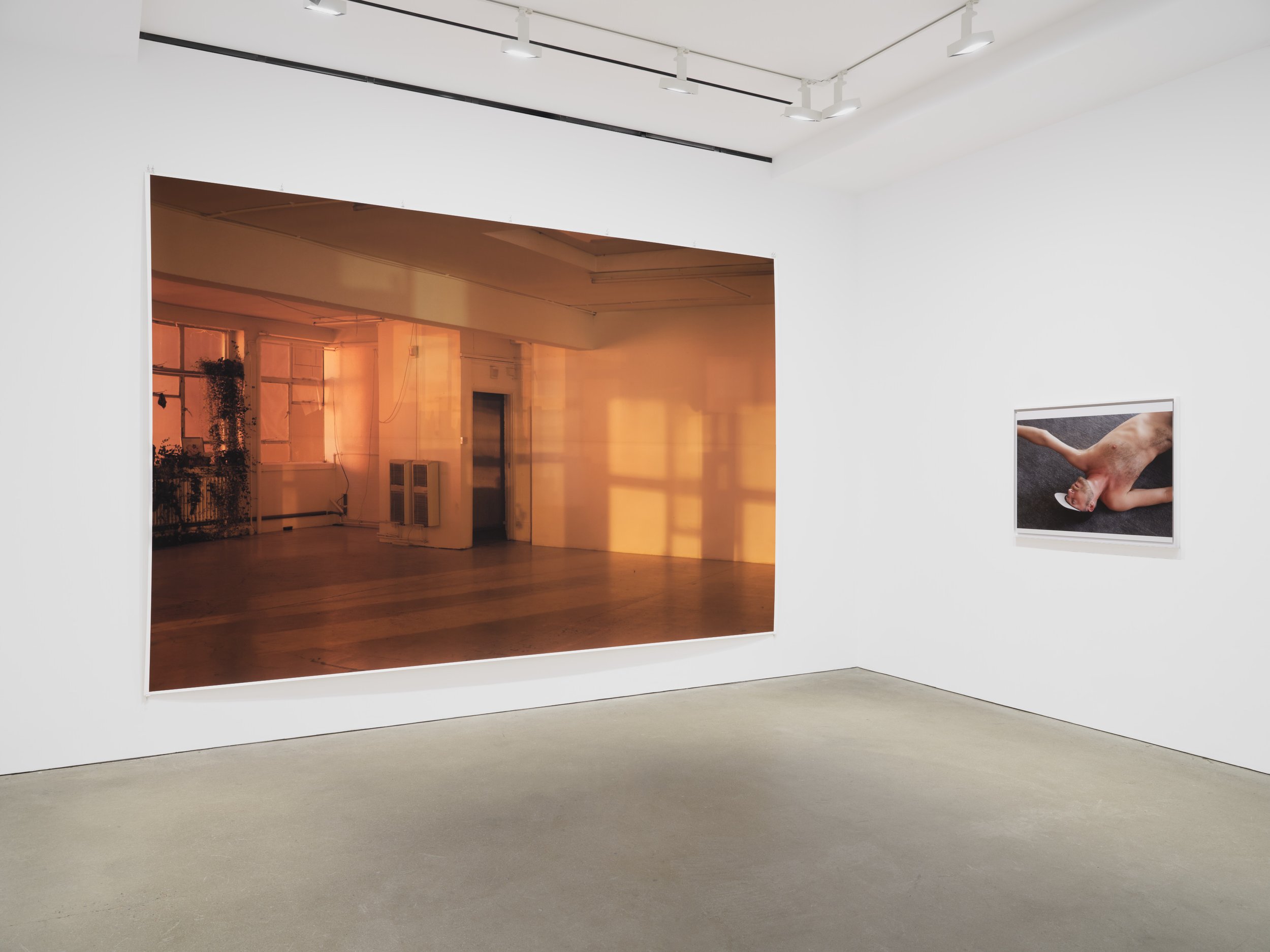
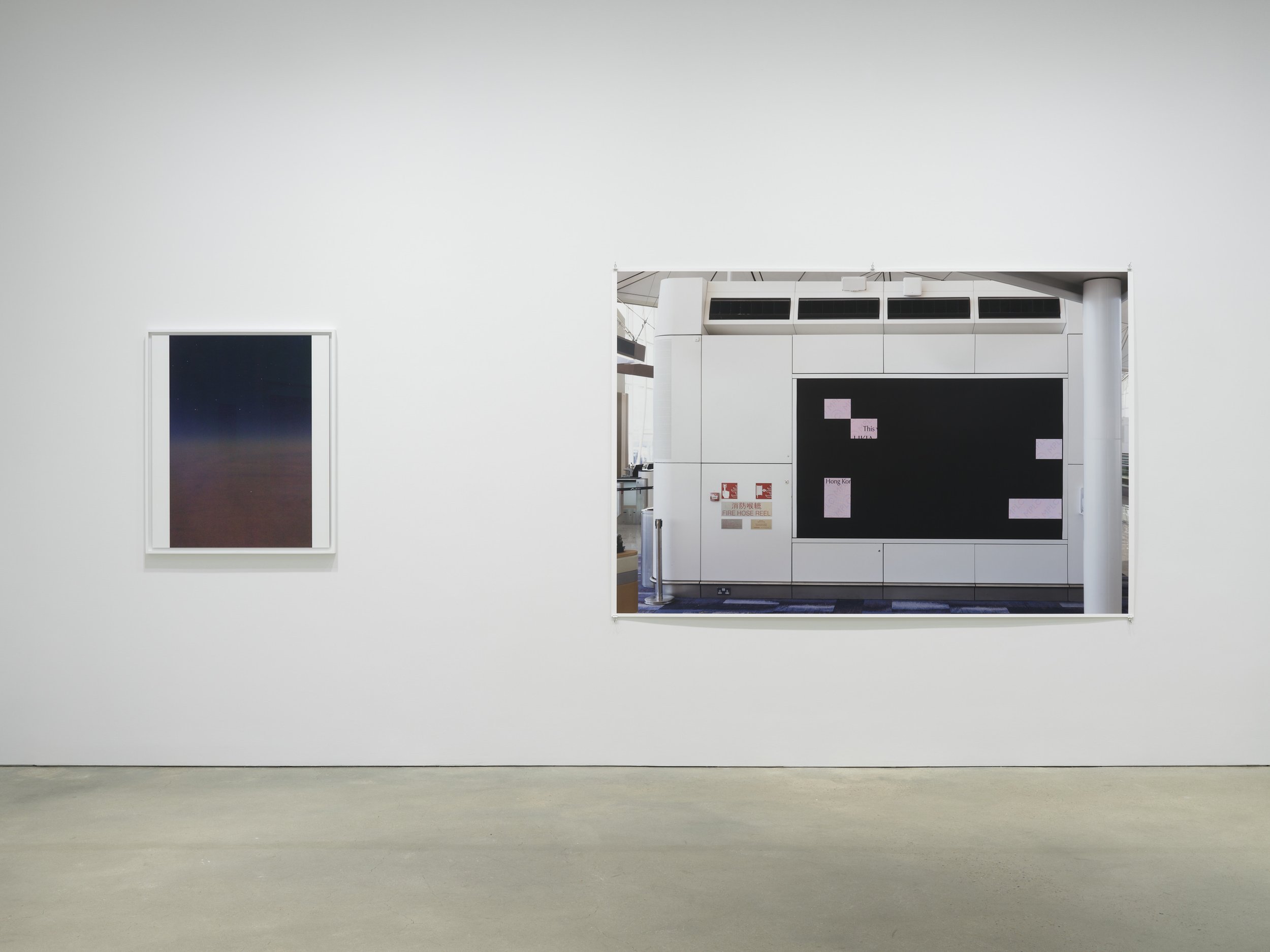
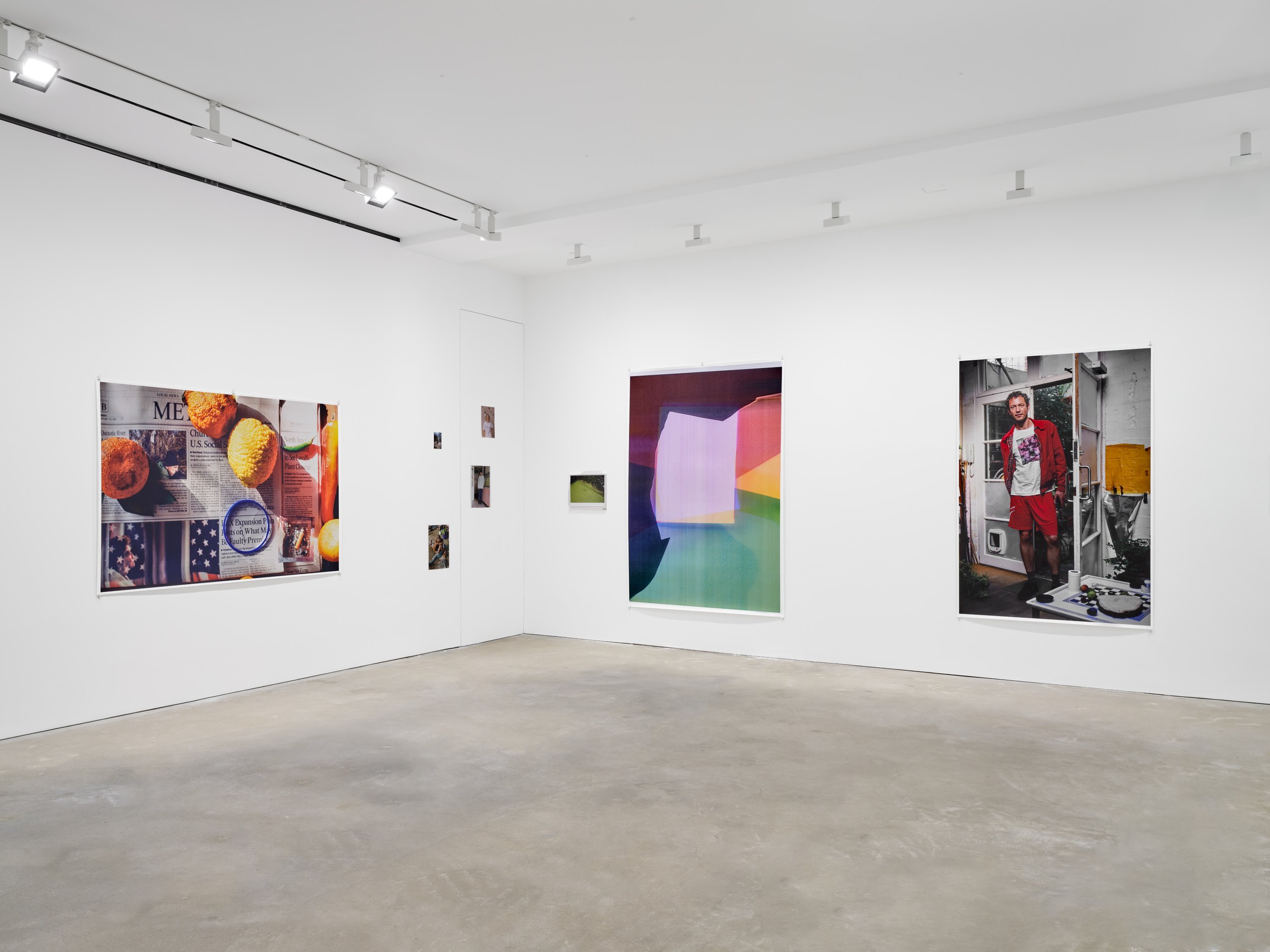
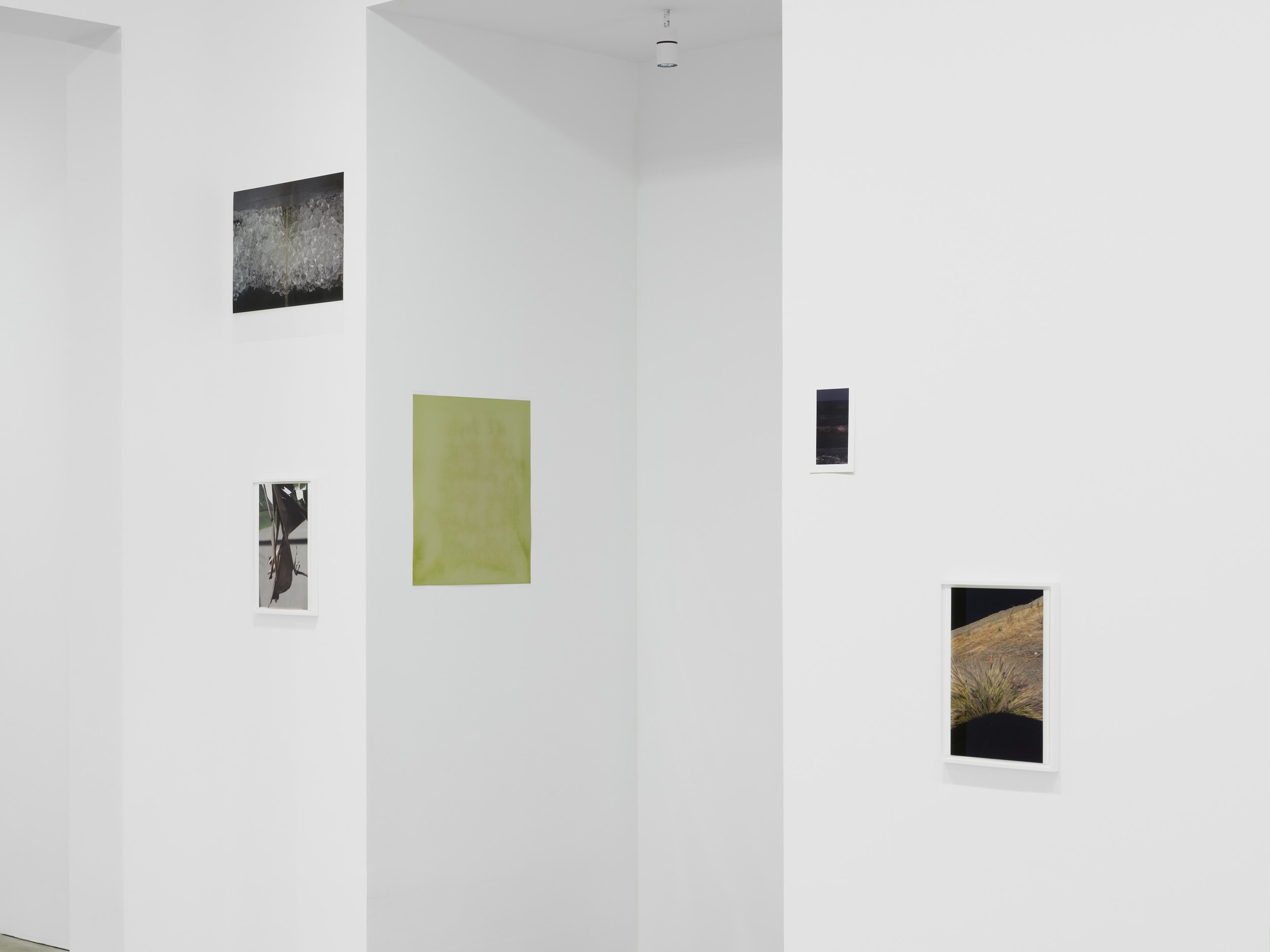
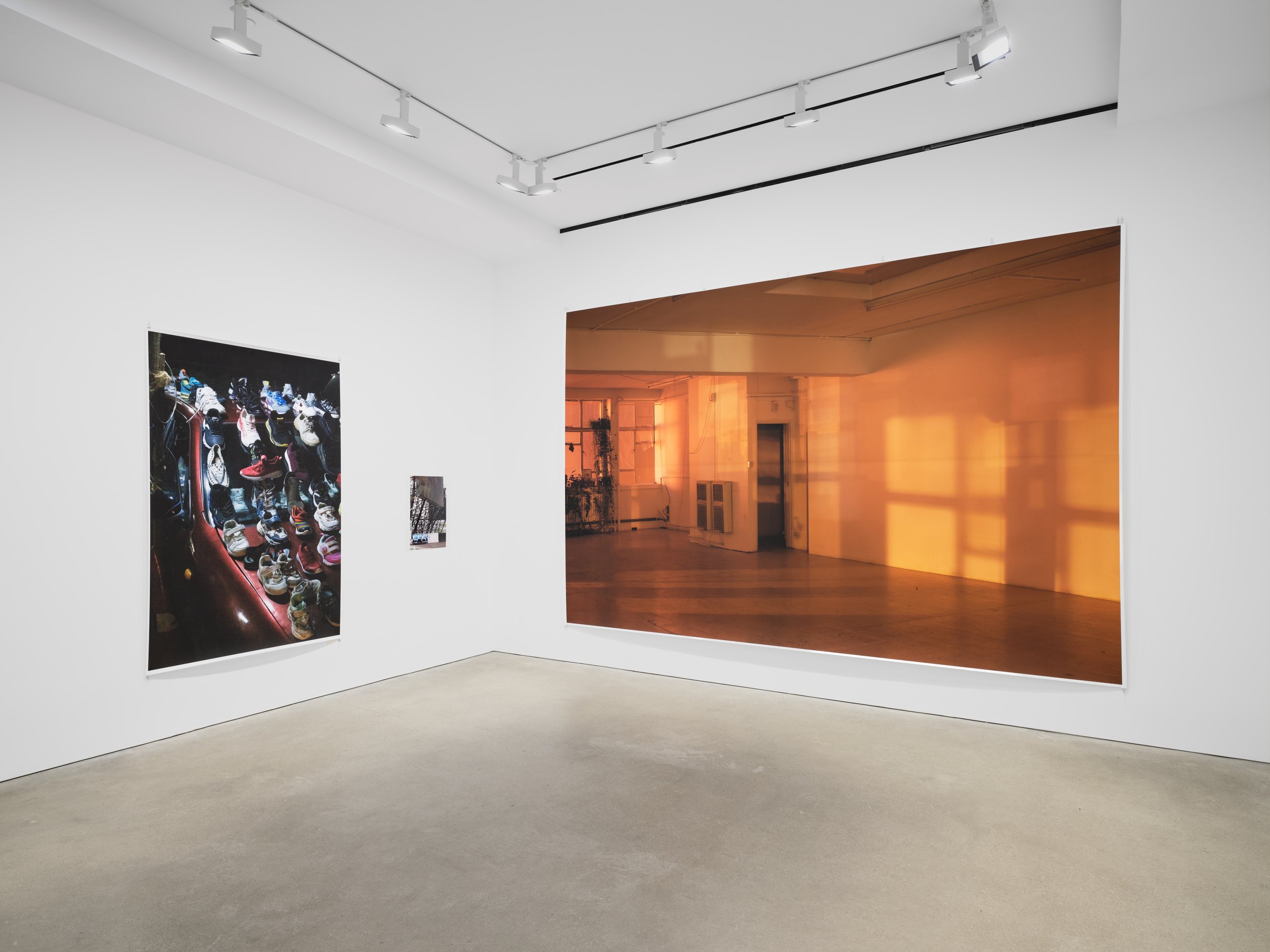

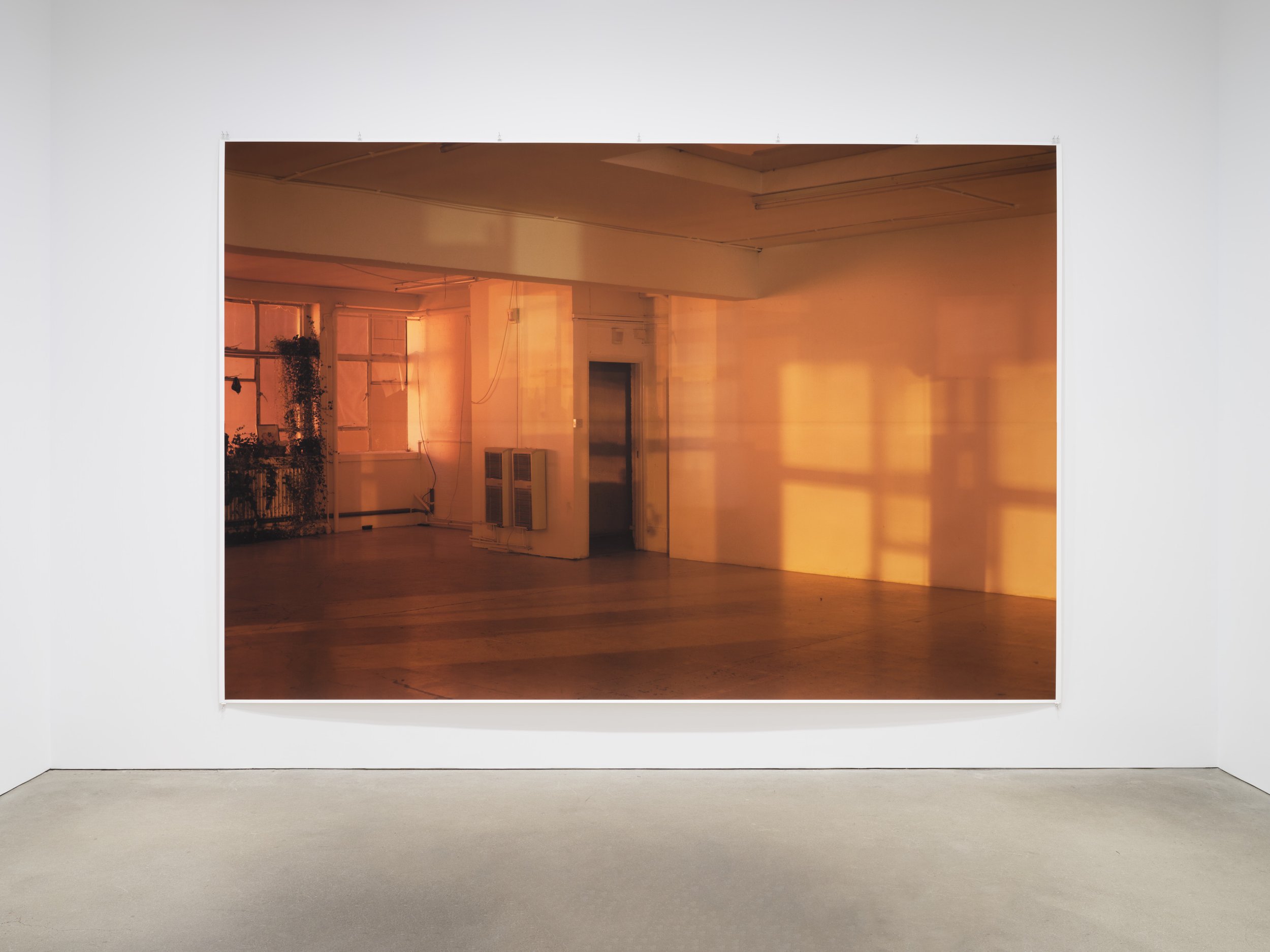
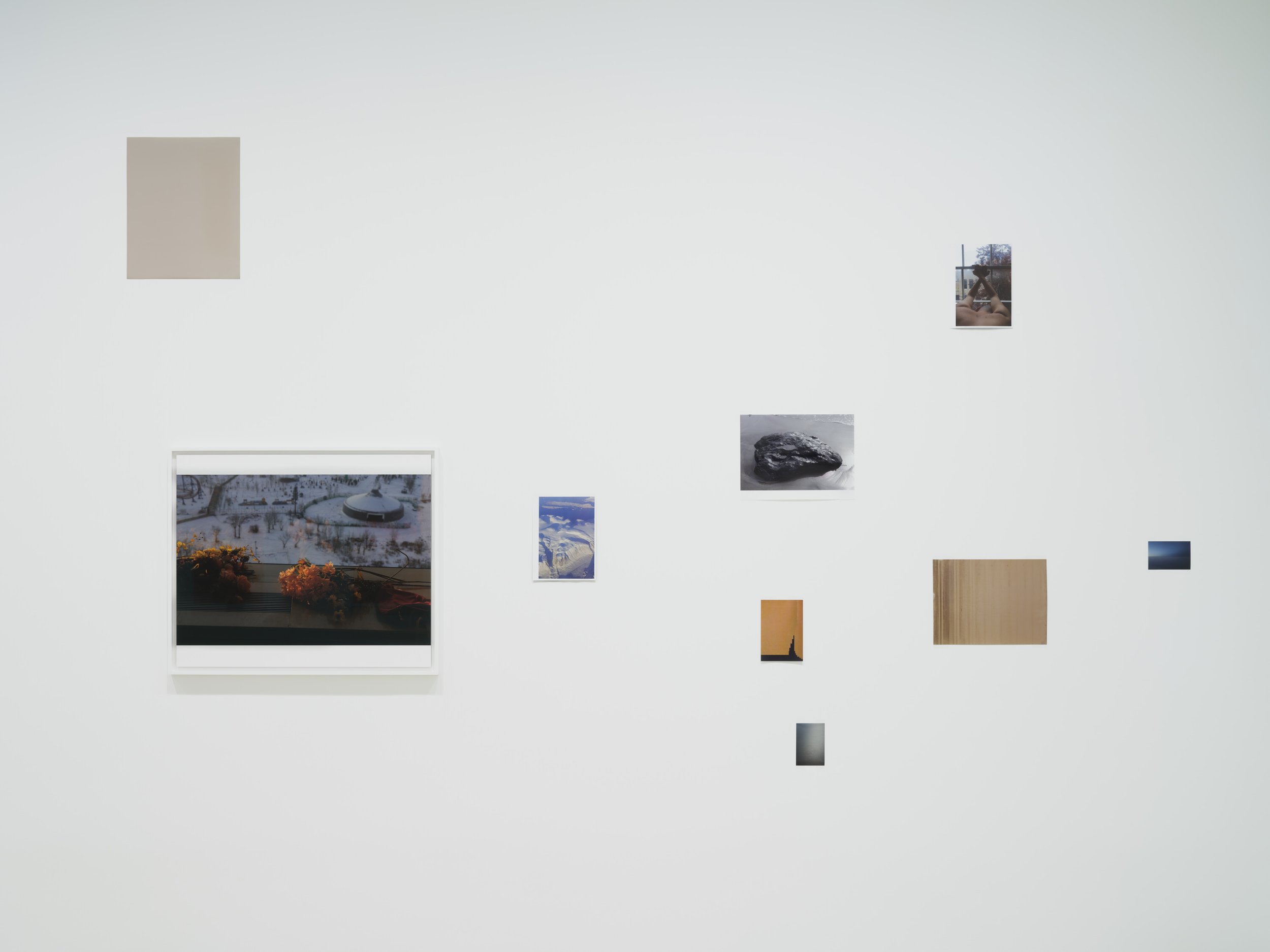
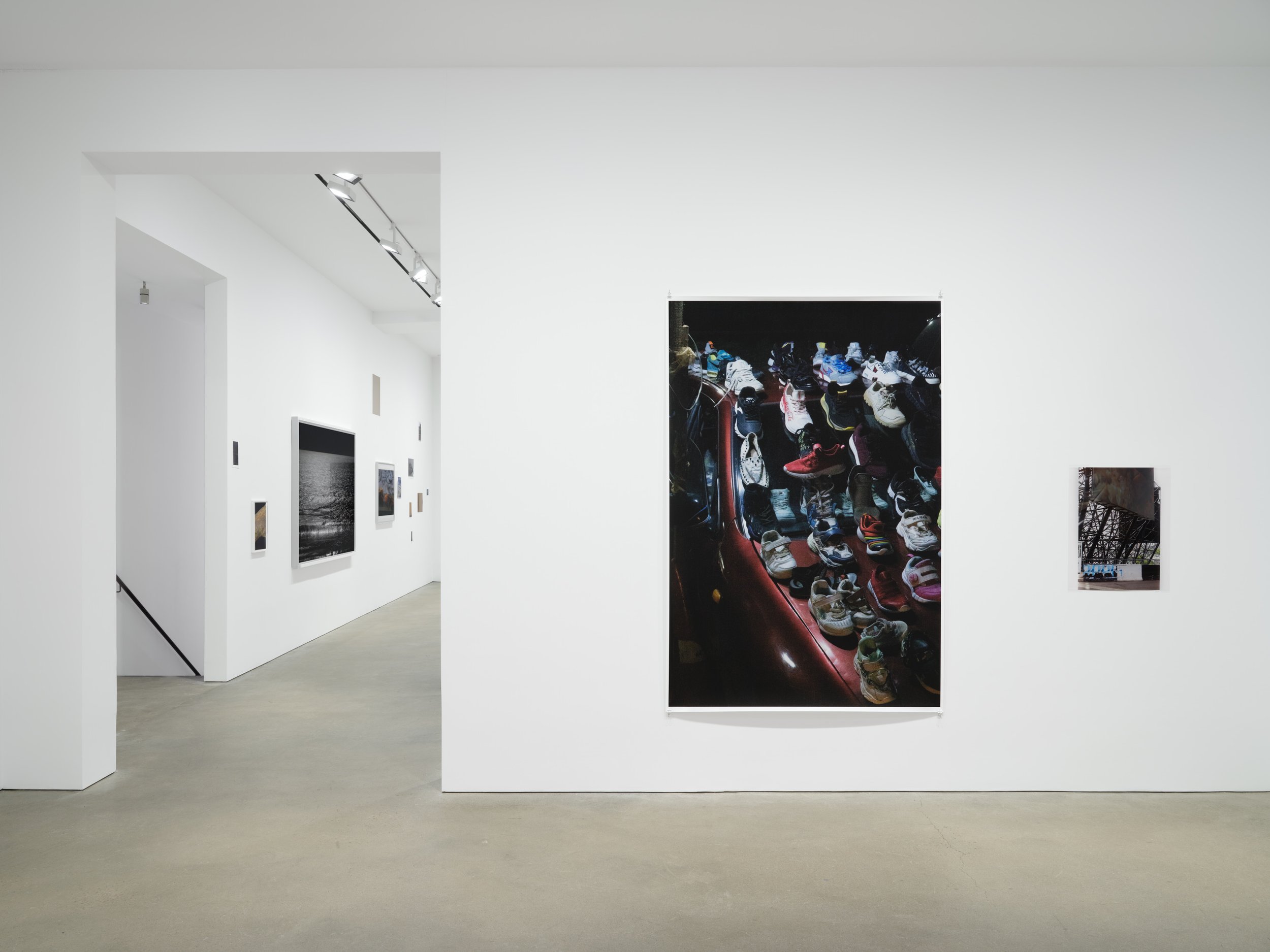

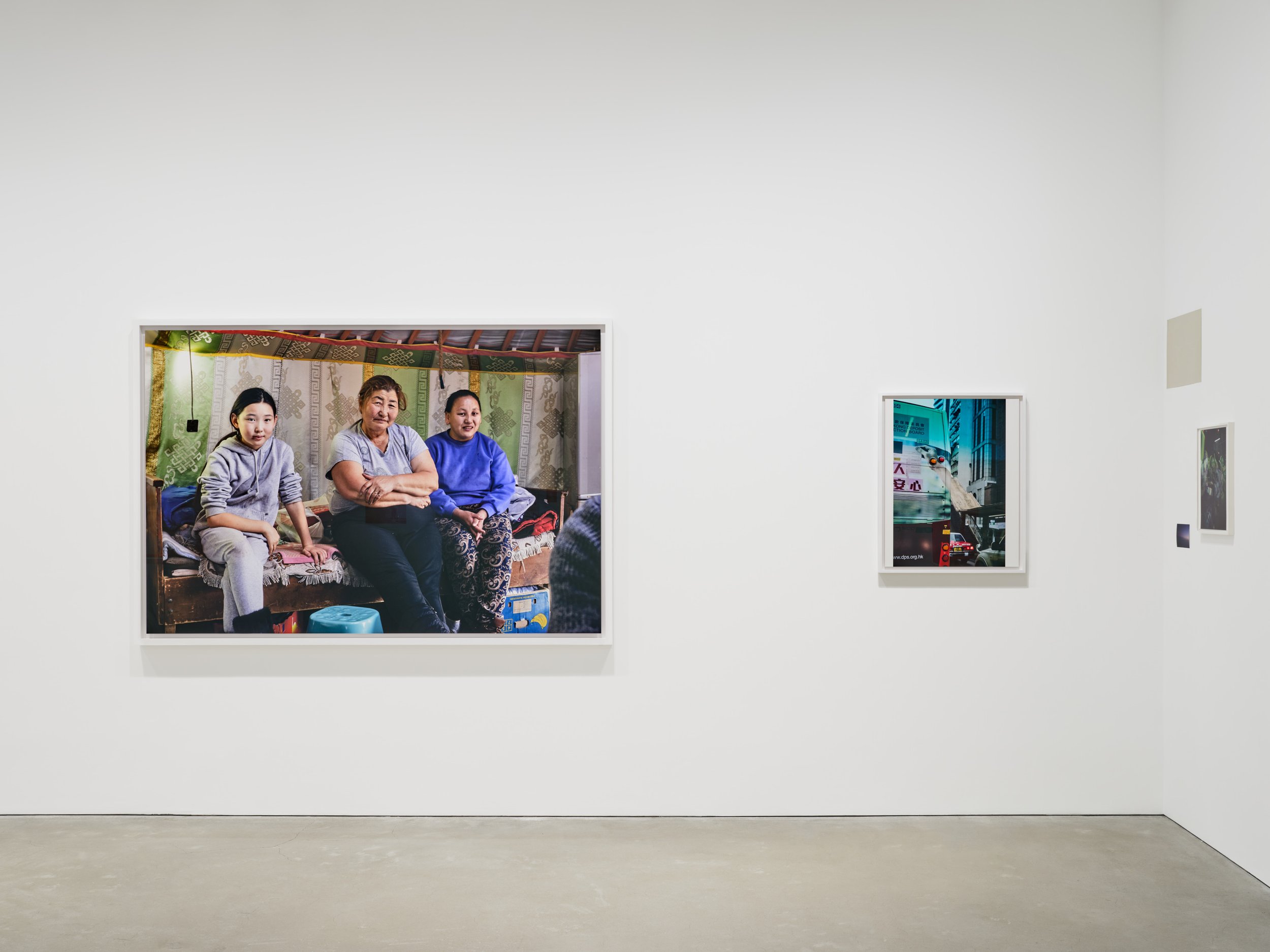
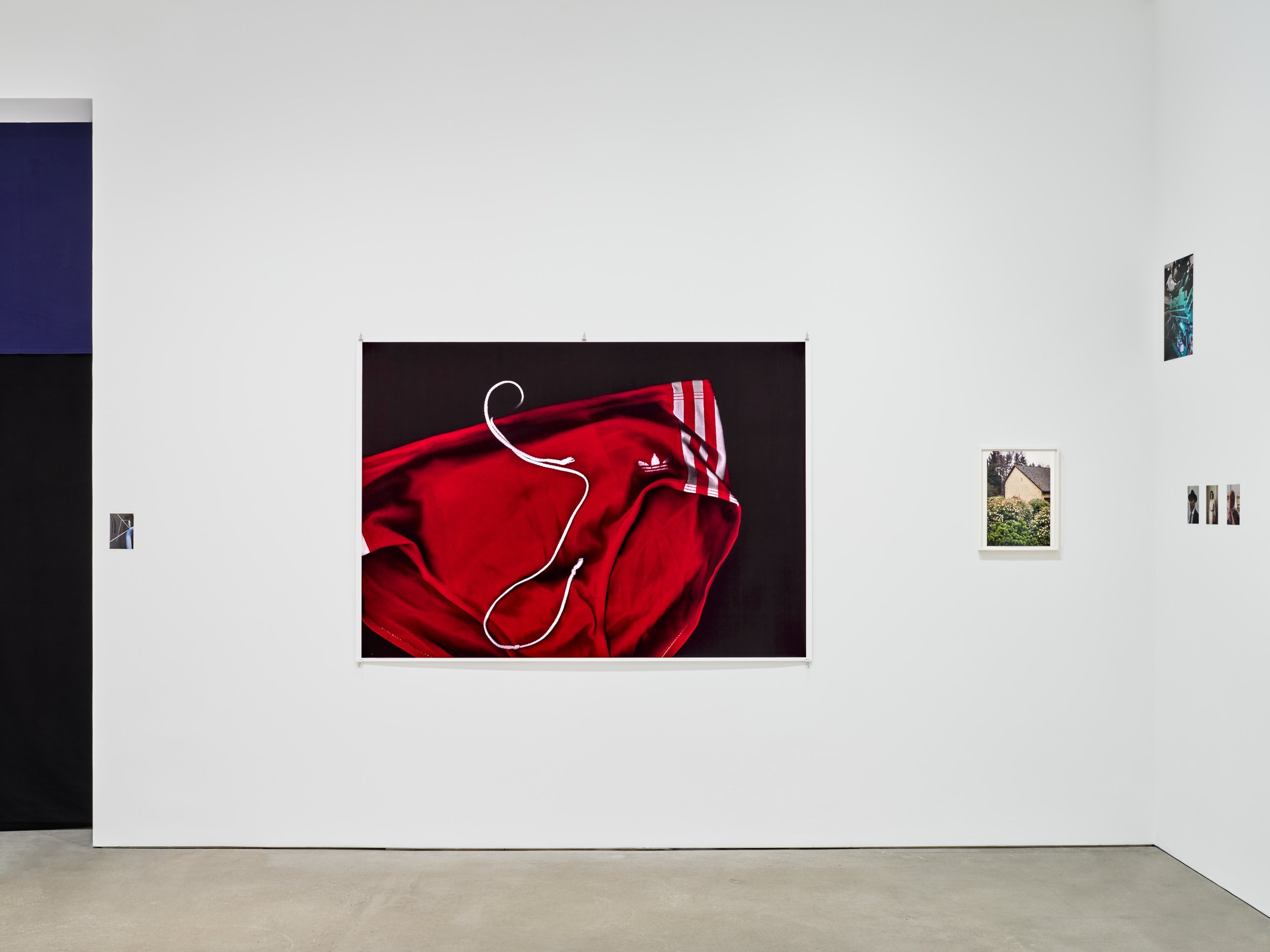
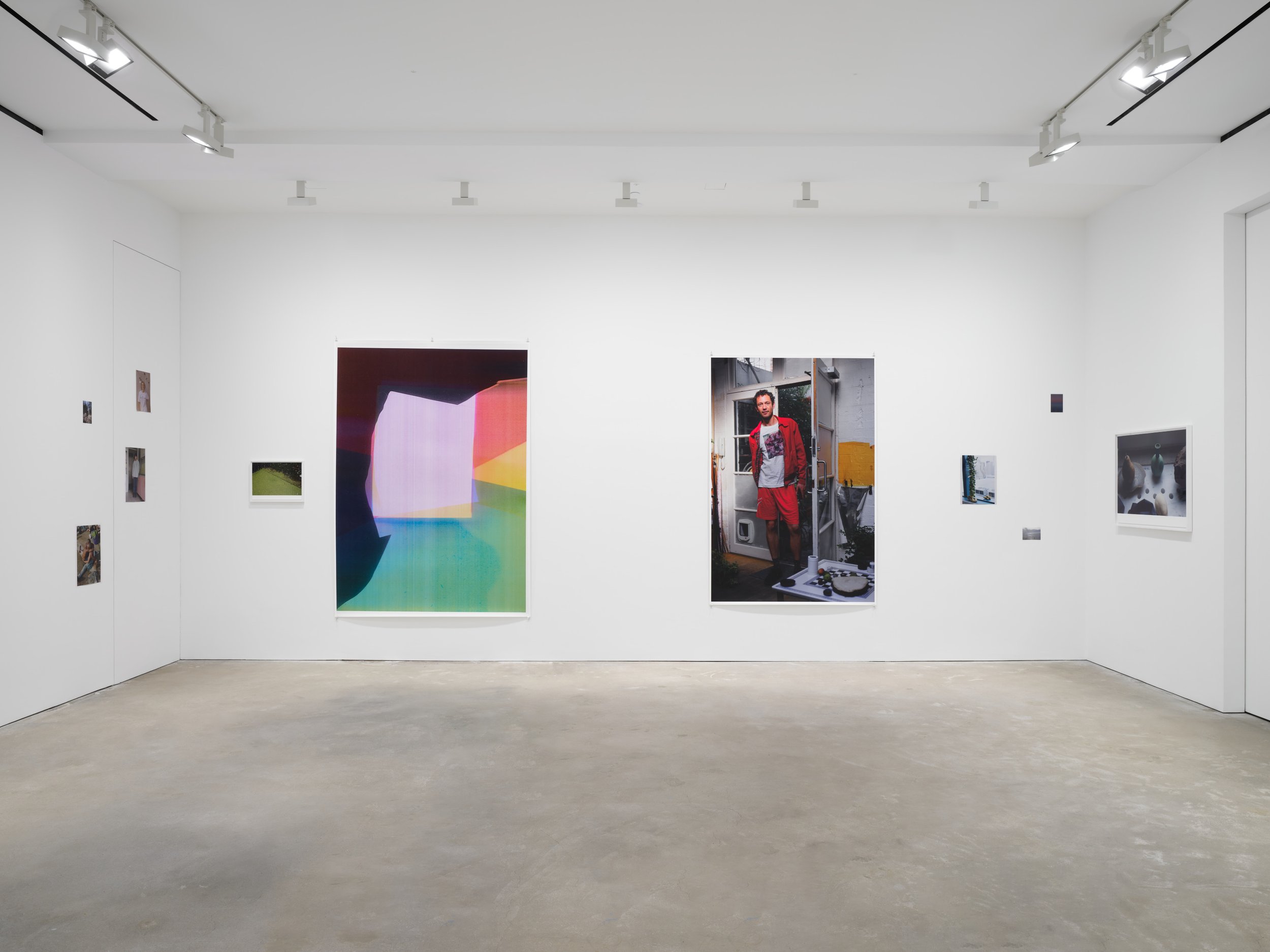

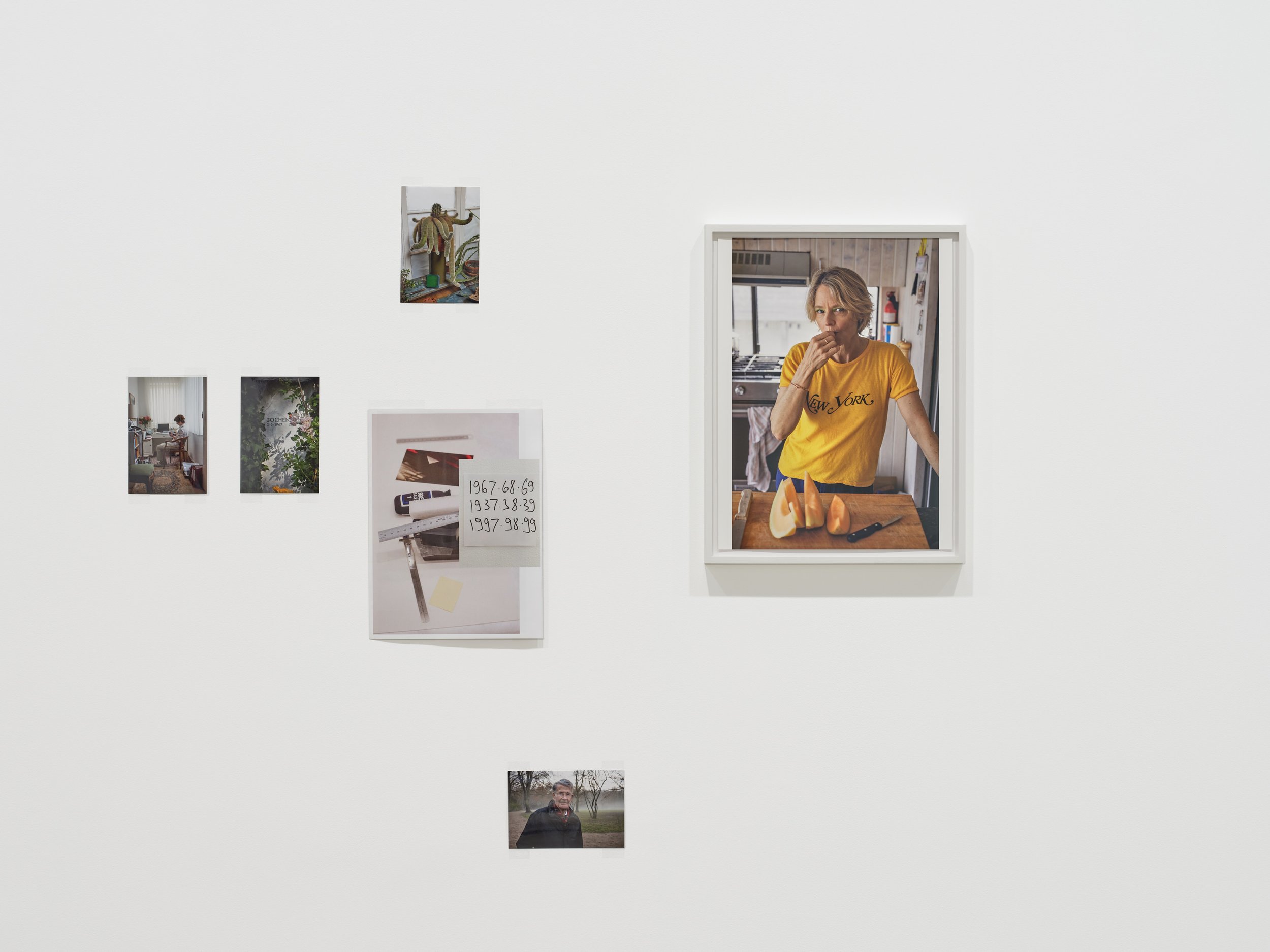
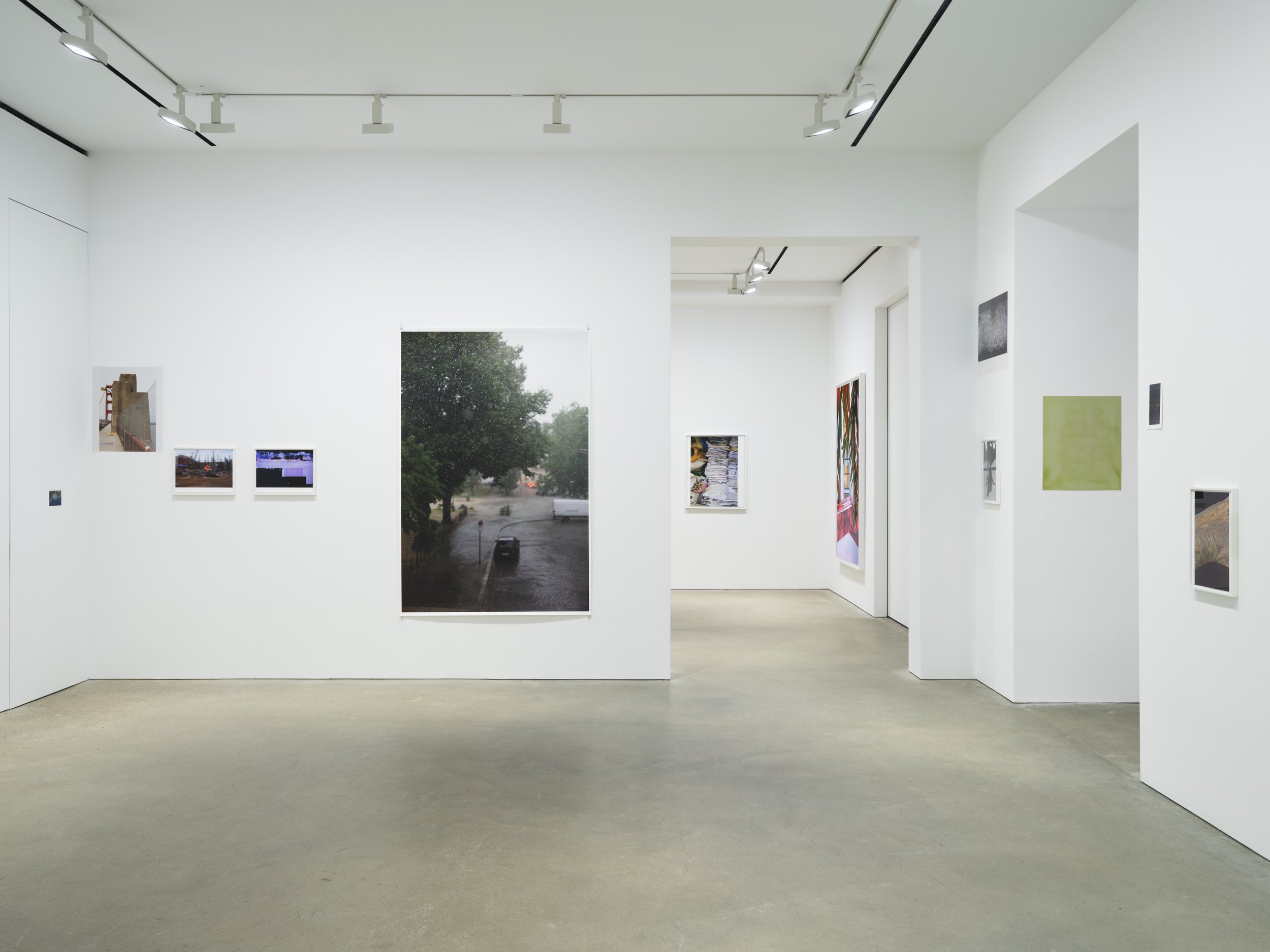
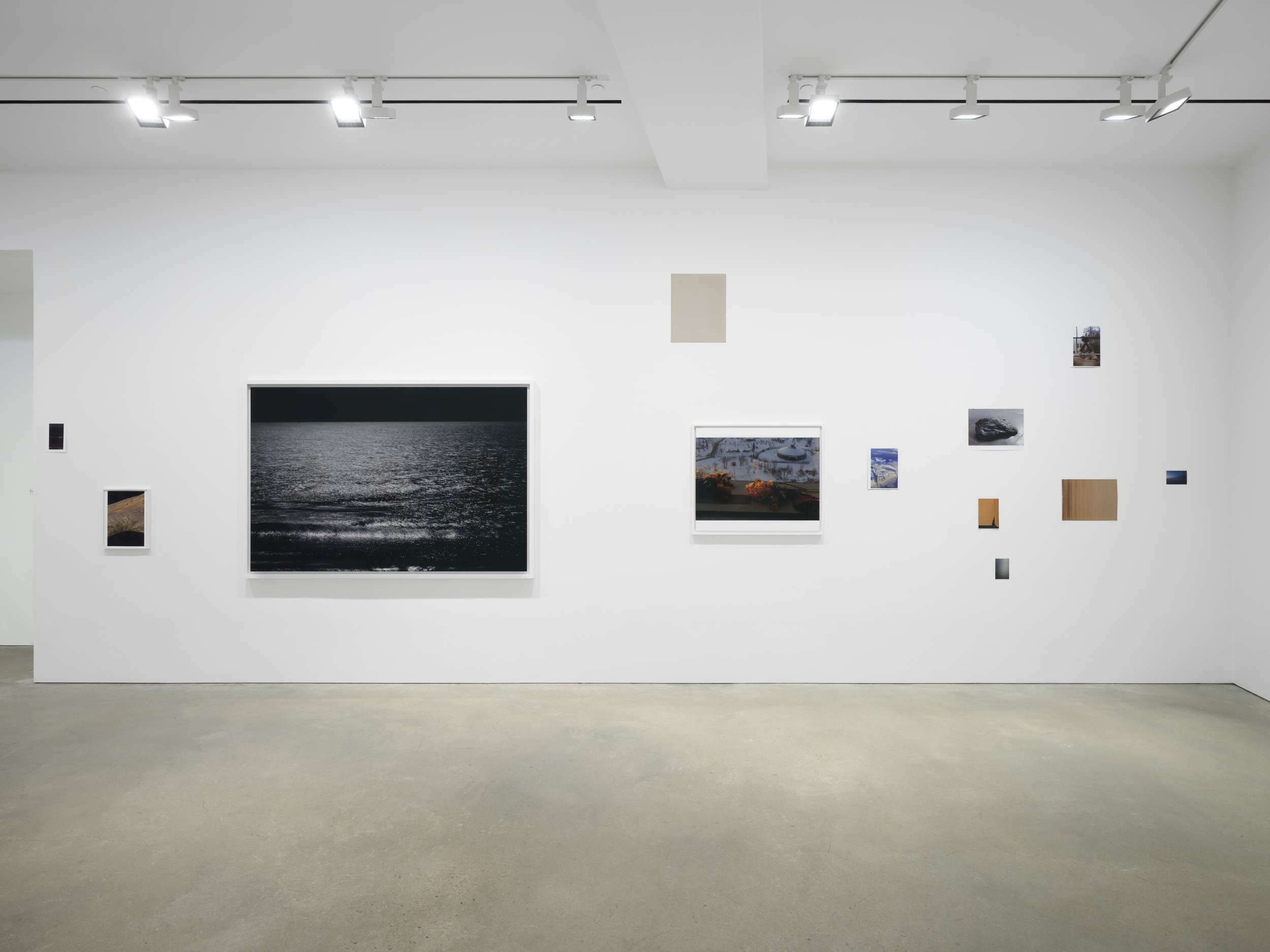
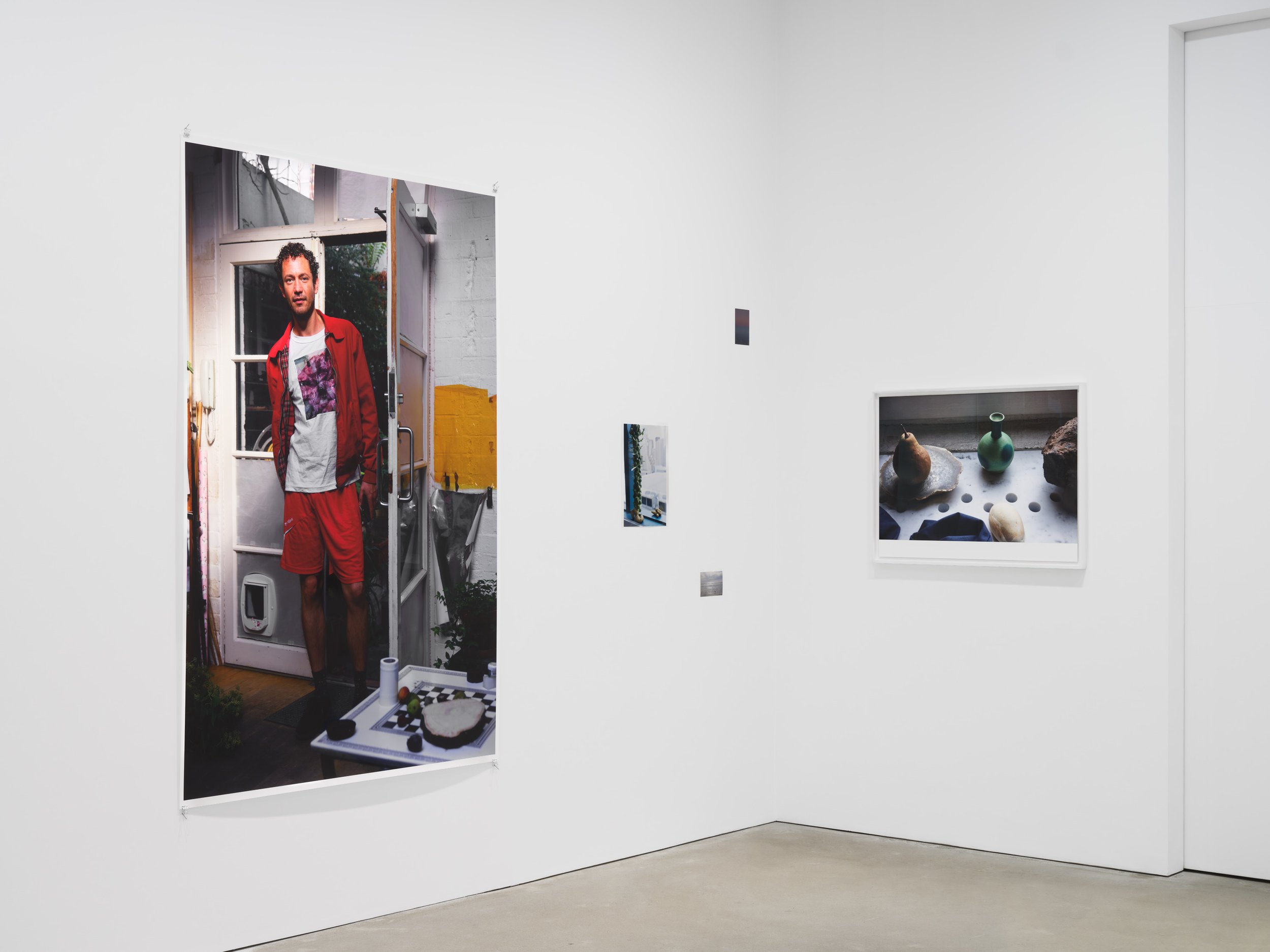
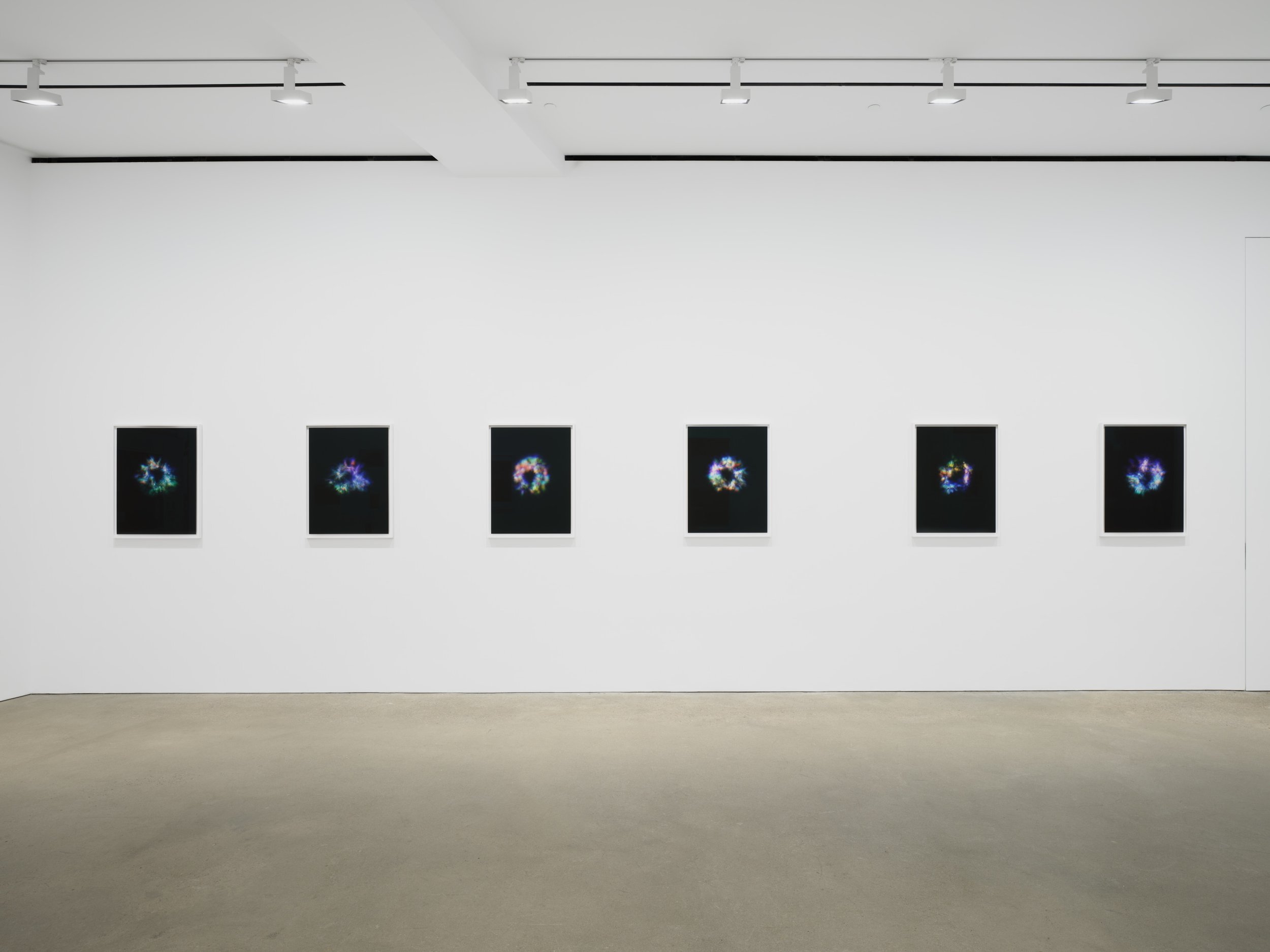

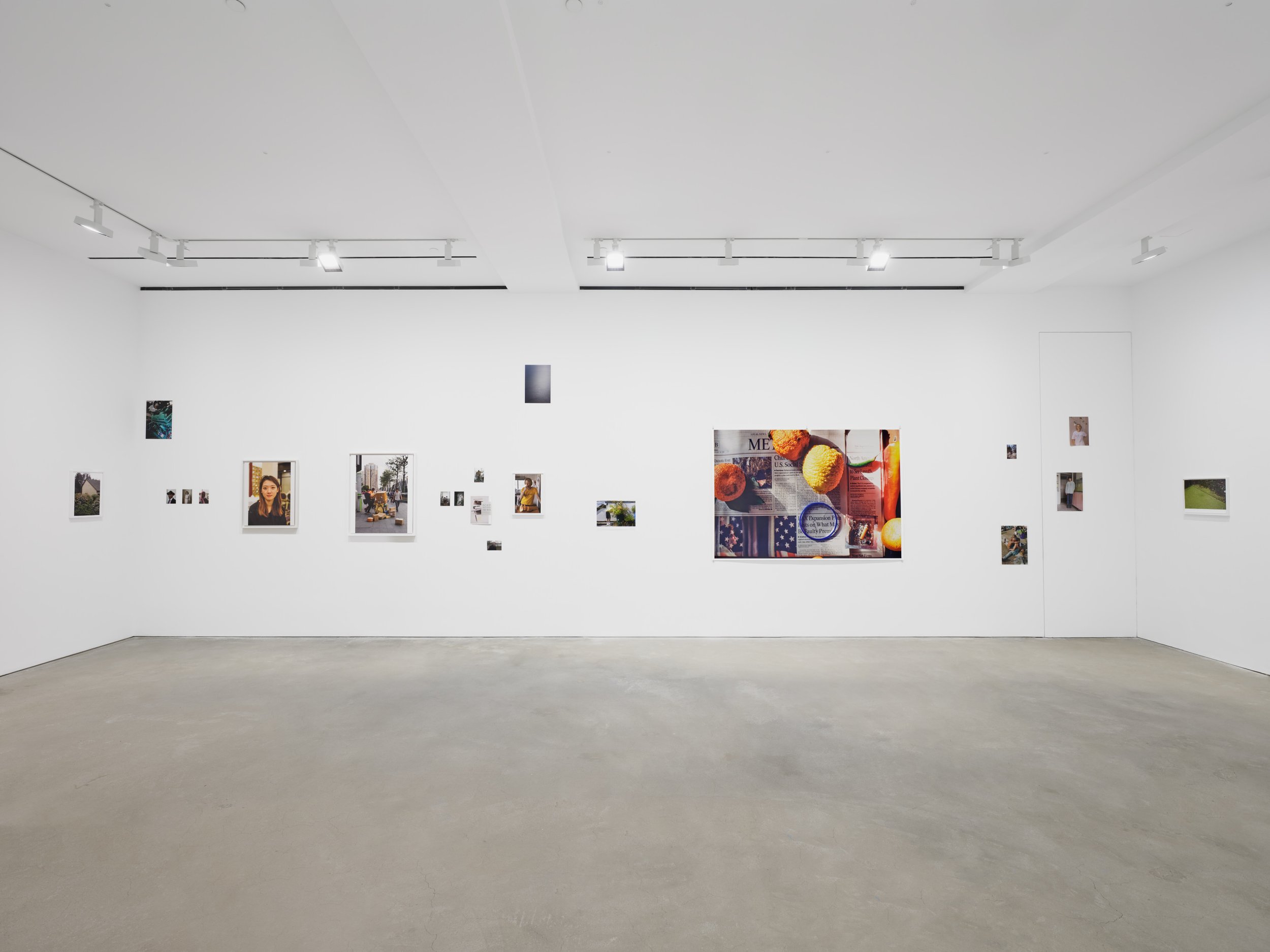
Installation view, Wolfgang Tillmans: The Point Is Matter, David Zwirner, Hong Kong, March 25—May 11, 2024 Courtesy David Zwirner
This exhibition follows his 2023 solo exhibition Fold Me at David Zwirner New York and his major 2022–2023 traveling retrospective To look without fear at The Museum of Modern Art, New York, the Art Gallery of Ontario, Toronto, and the San Francisco Museum of Modern Art. This will be the artist’s fifth solo exhibition with the gallery and his second at David Zwirner Hong Kong.
Wolfgang Tillmans, 2024 Photo: Mustafah Abdulaziz
Wolfgang Tillmans was born in 1968 in Remscheid, Germany, and studied at Bournemouth and Poole College of Art and Design in Bournemouth, England, from 1990 to 1992.
Few artists have shaped the scope of contemporary art and influenced younger generations more than Tillmans. In a career spanning almost four decades, he has consistently redefined the medium of photography through a seamless integration of genres, subjects, techniques, and exhibition strategies. His inventive practice pairs intimacy and playfulness with a commitment to social awareness and a persistent questioning of existing values and hierarchies. Guided by a profound sense of curiosity and care towards his subjects, Tillmans seeks to expand the poetic possibilities of the medium while addressing the fundamental question of what it means to create pictures in an increasingly image-saturated world. As the artist states, “The underpinning of my work has always been the use of my medium and everything it offers in order to make a new picture.”
In 2000, Tillmans was the first photographer and first non-British artist to receive the Turner Prize, an award given annually by Tate in London. From 2003 to 2009, Tillmans served as a professor at the Städelschule in Frankfurt. In 2009, he was selected to serve as an artist trustee on the board of Tate. He has been a member of the Akademie der Künste, Berlin, since 2012 and was appointed a member of the Royal Academy of Arts, London, in 2013. Tillmans was the recipient of the 2015 Hasselblad Foundation International Award in Photography and in January 2018, he was awarded the Kaiserring (Emperor’s Ring) prize from the city of Goslar in Germany. Tillmans was named one of the TIME100 Most Influential People of 2023.
Wolfgang Tillmans, Sirius Through a Defocused Telescope, f, 2023 Courtesy David Zwirner, New York/Hong Kong; Galerie Buchholz, Berlin/Cologne; and Maureen Paley, London
Since the early 1990s, Tillmans’s work has been the subject of prominent solo exhibitions at international institutions, including Tate Britain (2003); P.S.1 Contemporary Art Center, New York (2006); Museum of Contemporary Art Chicago (2006), which traveled to Hammer Museum, Los Angeles (2006–2007), Hirshhorn Museum and Sculpture Garden, Washington, DC (2007), and Museo Tamayo, Mexico City (2008); Serpentine Gallery, London (2010), which traveled to venues in South America including Museu de Arte Moderna de São Paulo, Museo de Arte del Banco de la República, Bogotá, Colombia, Museo de Arte de Lima, Peru, and Museo de Artes Visuales, Santiago, Chile; Kunsthalle Zürich (2012), which traveled to Les Rencontres d’Arles, France (2013); Moderna Museet, Stockholm (2013); and The National Museum of Art, Osaka (2015). Also in 2015, Book for Architects, a two-channel video installation, was on view at The Metropolitan Museum of Art, New York. In 2016, a solo show of the artist’s work was hosted by Museu Serralves, Porto, Portugal.
In 2017, Tate Modern, London, held a major survey of Tillmans’s work. The artist also presented a new immersive installation featuring his work in music and video in the South Tank at the museum. Later that year, solo shows of Tillmans’s work were on view at the Fondation Beyeler in Basel, marking the institution’s first comprehensive examination of photography as a medium, as well as at the Kunstverein in Hamburg.
Wolfgang Tillmans, Ulaanbaatar Still Life, 2023 Courtesy David Zwirner, New York/Hong Kong; Galerie Buchholz, Berlin/Cologne; and Maureen Paley, London
Fragile, a major solo exhibition of the artist’s work, opened in 2018 at the Musée d’Art Contemporain et Multimédias in Kinshasa, Democratic Republic of Congo, organized by Institut für Auslandsbeziehungen, Stuttgart, Germany, and traveled throughout Africa, with its last stop at Art Twenty One and Centre for Contemporary Art, Lagos, Nigeria. Qu’est-ce qui est différent? was presented at Carré d'Art - Musée d’art contemporain, Nîmes, France, in 2018. Rebuilding the Future was on view at Irish Museum of Modern Art, Dublin, in 2018–2019. The exhibition Today Is The First Day was presented at WIELS, Brussels, in 2020. Sound is Liquid was on view at the Museum moderner Kunst Stiftung Ludwig Wien, Vienna, in 2022. A major traveling exhibition of Tillmans’s work, To look without fear, opened at The Museum of Modern Art, New York, in September 2022, and subsequently traveled to the Art Gallery of Ontario, Toronto, in the Spring of 2023; and to the San Francisco Museum of Modern Art in November 2023– March 2024.
The artist has operated the nonprofit exhibition space Between Bridges since 2006. Located in London until 2011, Between Bridges has exhibited a range of work by artists, including David Wojnarowicz, Ull Hohn, Charlotte Posenenske, and Charles Henri Ford. In January 2014, it reopened in Berlin with a solo show of work by Patrick Caulfield.
Installation view, Wolfgang Tillmans: The Point Is Matter, David Zwirner, Hong Kong, March 25—May 11, 2024 Courtesy David Zwirner
Tillmans considers the printed page to be an important venue for his work. He is deeply involved in the publication of artist books and monographs, and regularly contributes to magazines. Publications that have been designed and edited by the artist include manual (Verlag der Buchhandlung Walther König, 2007); Lighter (Hatje Cantz, 2008); Abstract Pictures (Hatje Cantz, 2011); FESPA Digital / FRUIT LOGISTICA (Verlag der Buchhandlung Walther König, 2012); Neue Welt (Taschen, 2012); The Cars (Verlag der Buchhandlung Walther König, 2015); What Is Different? (Sternberg Press, 2018); and four books (Taschen, 2020); amongst others. In 2019, the artist guest edited Aperture’s “Spirituality” issue.
In recent years, Tillmans has been more directly involved in political activism. In tandem with his ongoing Truth Study Center project (begun in 2005), he has created posters for the anti-Brexit campaign in Britain and in response to right-wing populism in Germany.
Work by the artist is held in museum collections worldwide. Tillmans lives and works in Berlin and London.
The exhibition opened on March 25th and will end on May 11, 2024. For more information about this exhibit, visit David Zwirner’s site , along with following them on Instagram and find the gallery also on Artsy here.
Khalif Tahir Thompson: Chilly Winds Don't Blow
Installation View: Khalif Tahir Thompson Chilly Winds Don't Blow, March 28-May 11, 2024 Galerie Zidoun-Bossuyt (51 Rue de Seine) Photography courtesy of Galerie Zidoun-Bossuyt
Chilly Winds Don't Blow, Thompson's third solo exhibition with Zidoun Bossuyt Gallery (the 1st in Dubai, 2nd in Luxembourg), features all new work created while completing his master’s degree at the Yale School of Art (many featured in the monograph too). The work delves further into Thompson's series of portraiture sourced from his own family's photographic archive; these images are transformed & reimagined through the use of layered elements of paper, fabric, and paint, moving towards vividly realized representational forms.
Installation View: Khalif Tahir Thompson Chilly Winds Don't Blow, March 28-May 11, 2024 Galerie Zidoun-Bossuyt (51 Rue de Seine) Photography courtesy of Galerie Zidoun-Bossuyt
In his groups of figures, some are posed, while others are impulsively painted without paying any attention to the painter, all adding to the feeling of immediacy of an artist in love with depicting reality. Despite the vulnerability of his characters, elsewhere, Thompson also depicts isolated figures engulfed in an atmosphere of serenity. His works are also filled with mysterious letters and numbers, these signs echoing the diversity of materials used by the artist.
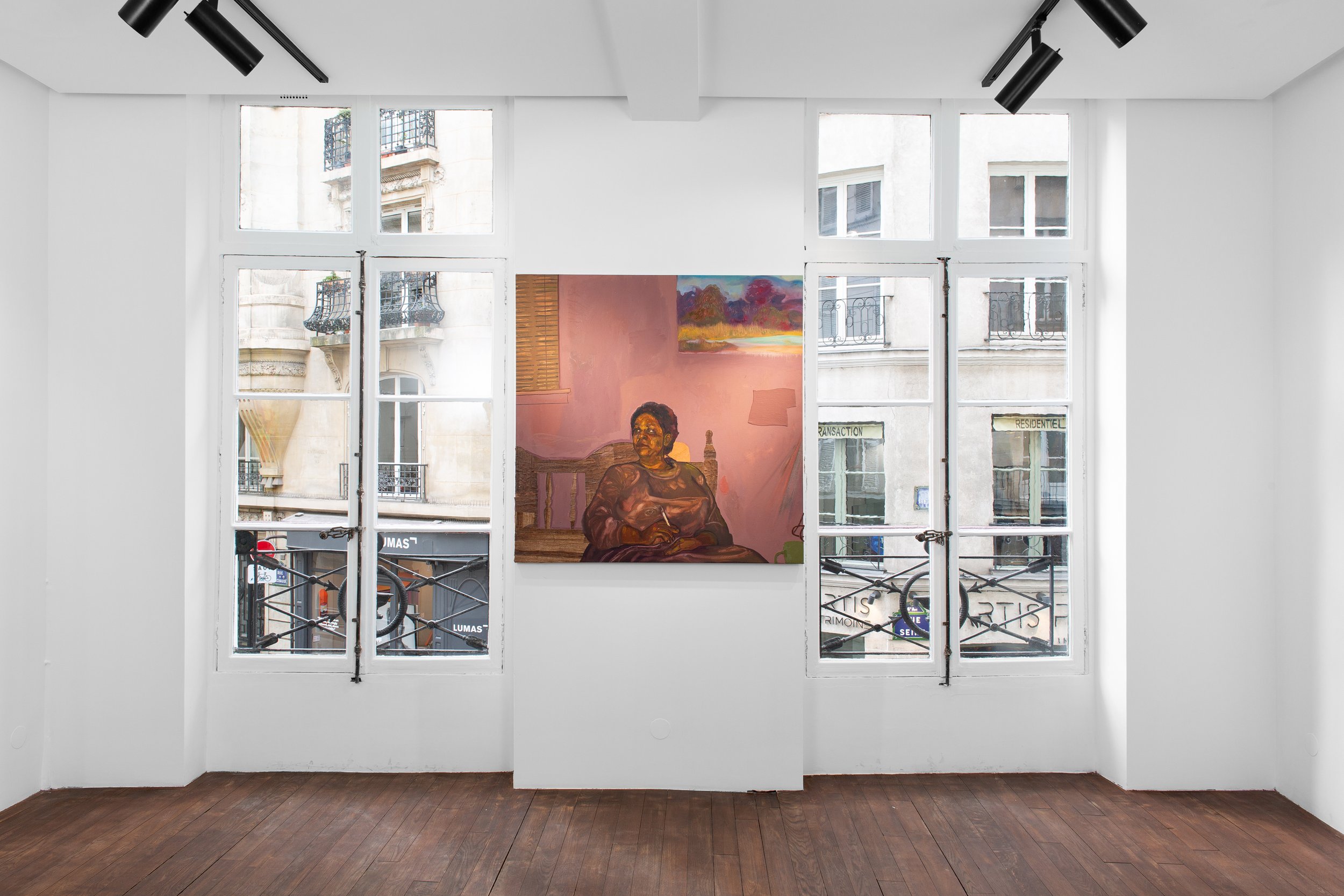

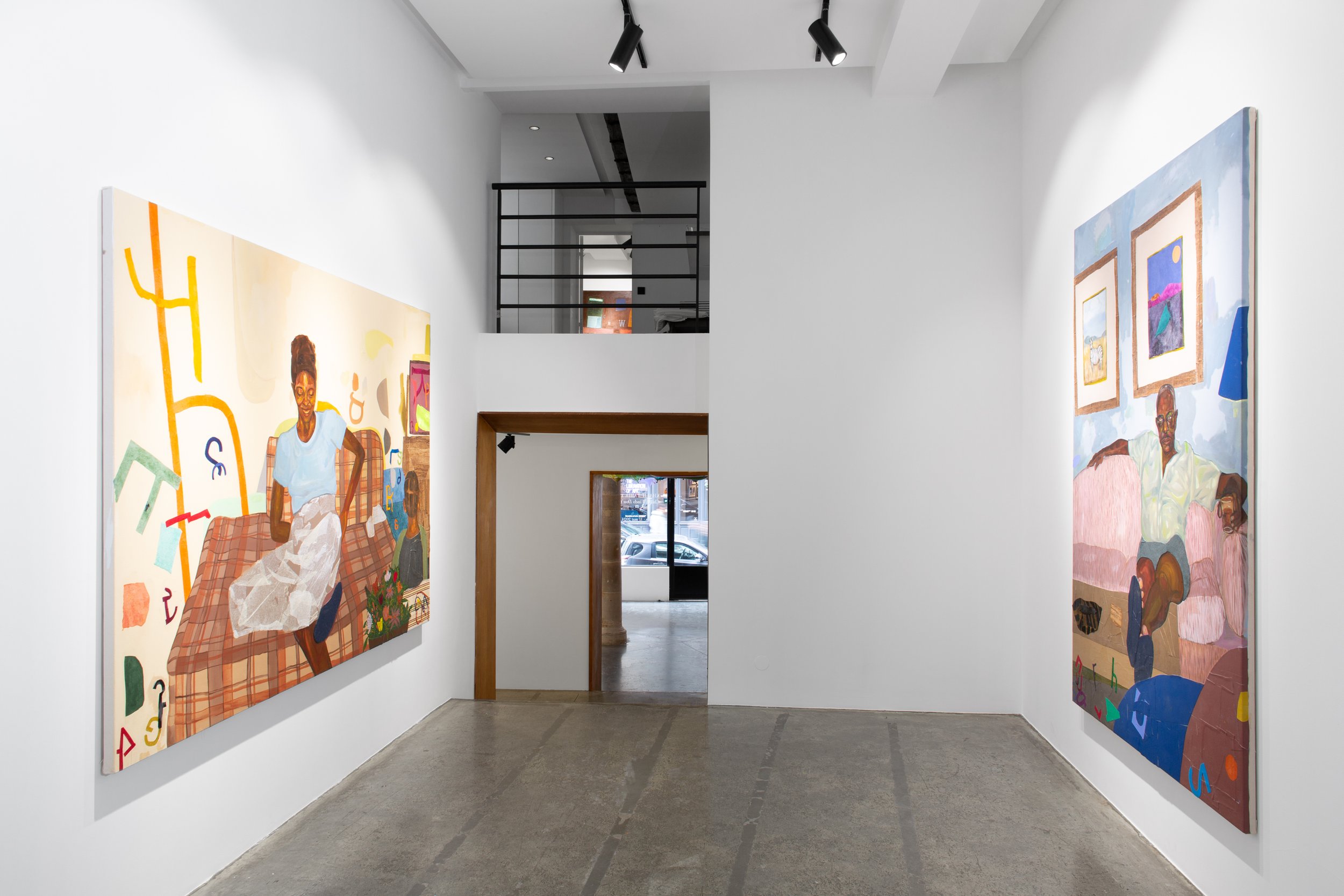
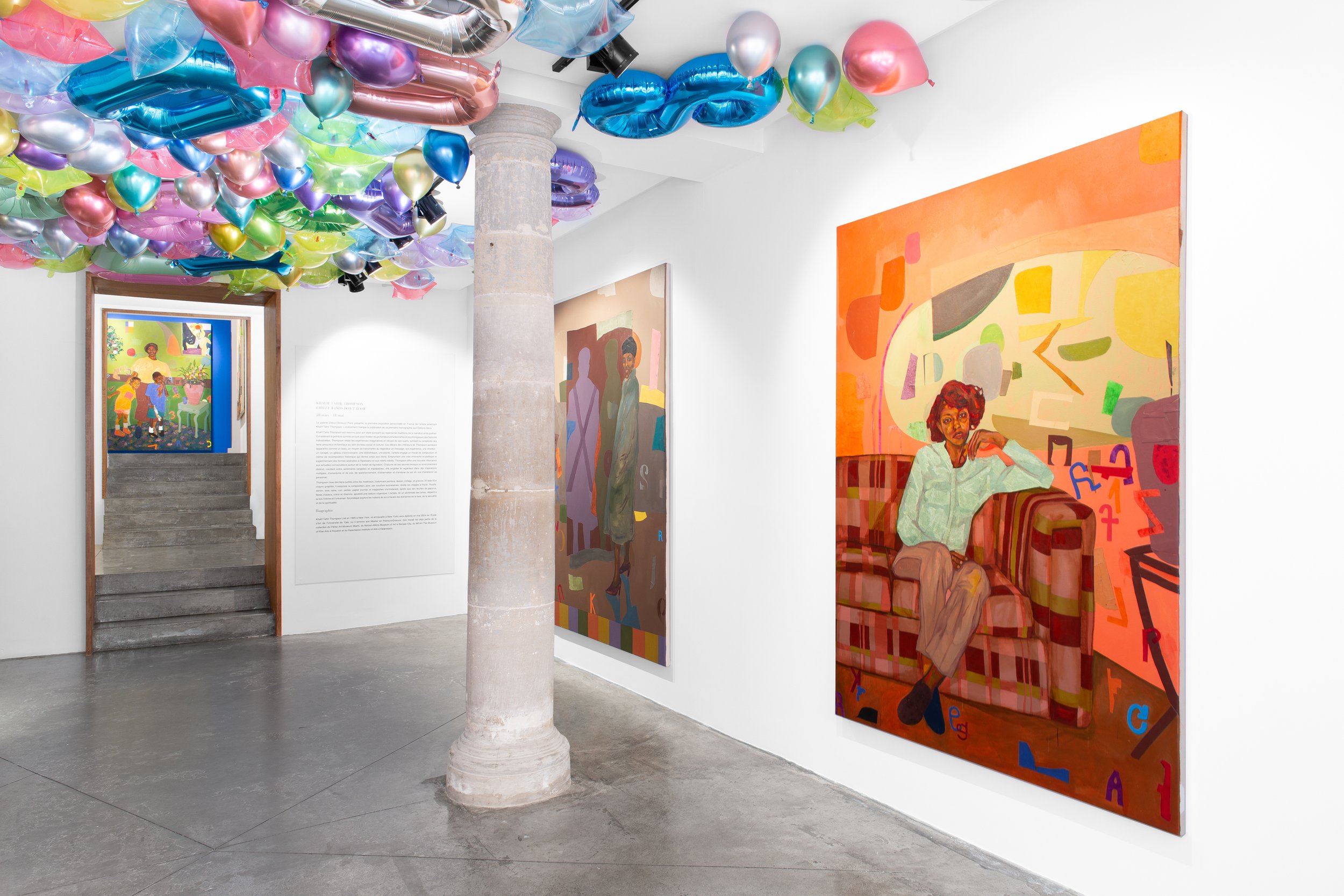
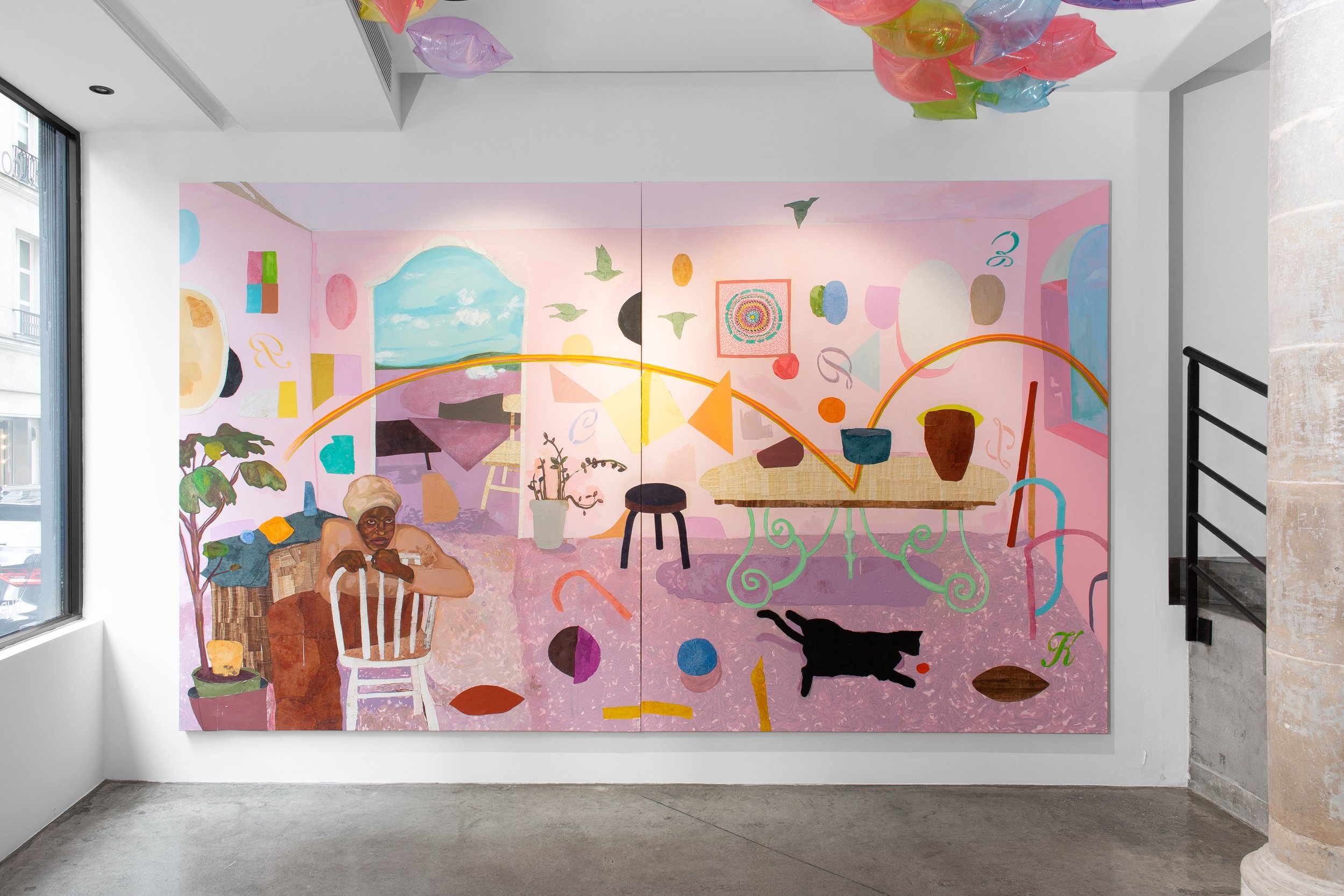
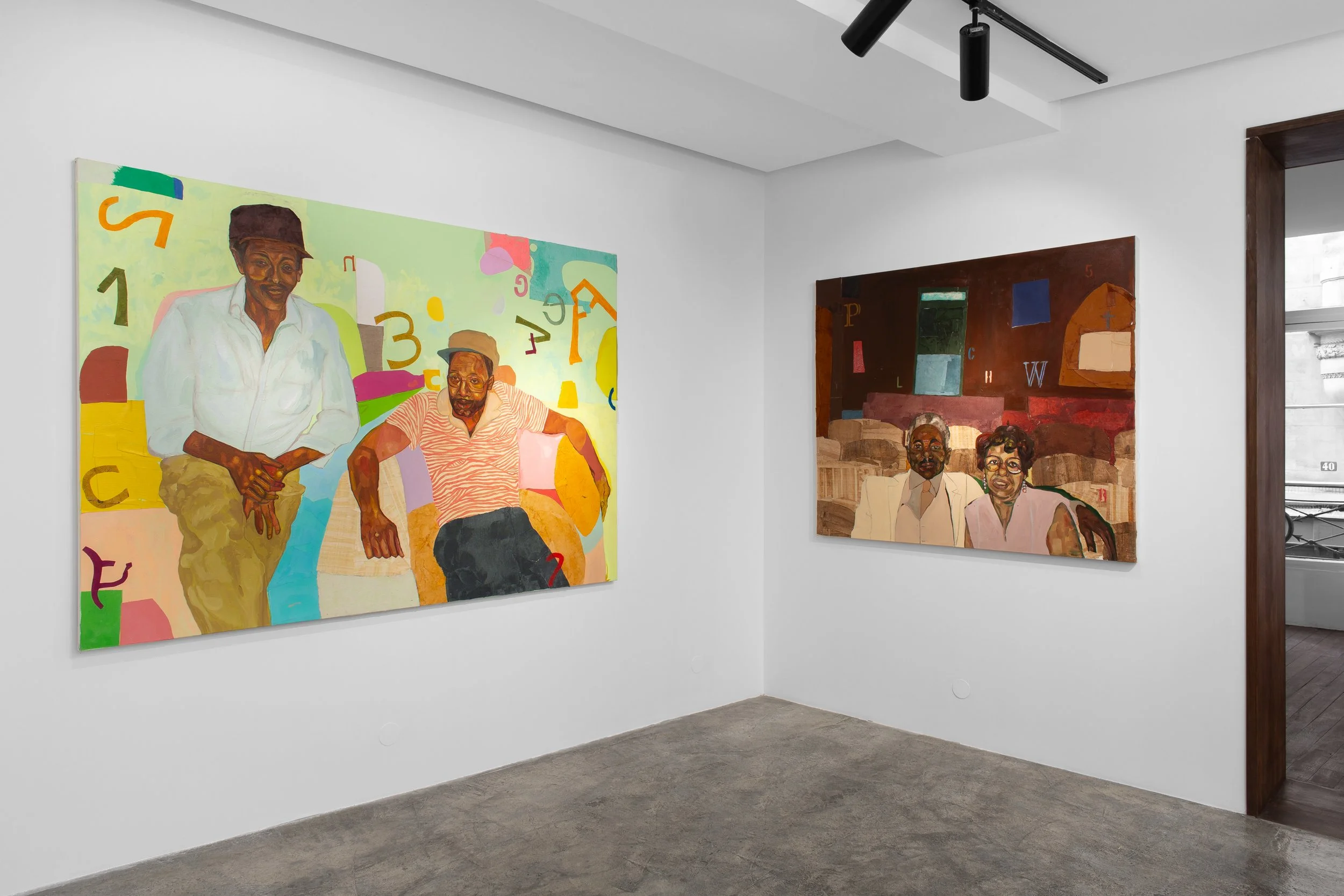

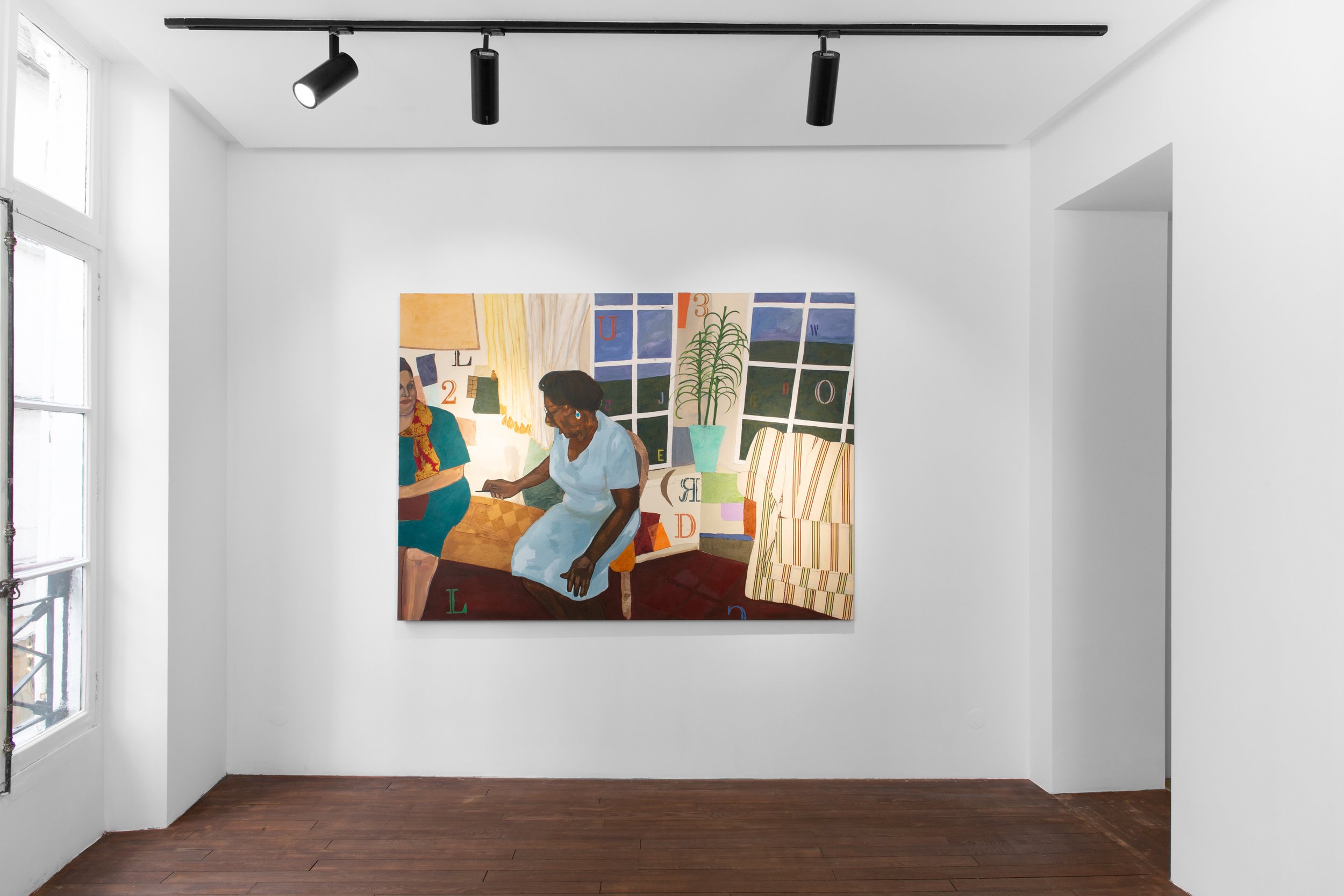
Installation View: Khalif Tahir Thompson Chilly Winds Don't Blow, March 28-May 11, 2024 Galerie Zidoun-Bossuyt (51 Rue de Seine) Photography courtesy of Galerie Zidoun-Bossuyt
About the Artist:
Khalif Tahir Thompson (b. 1995, NYC) is an African-American painter who just graduated from The Yale School of Art. His work explores notions of self through the scopes of race, sexuality, and spirituality, creating imagery that connects one to the realm of another. He alters perception and invokes empathy towards his subjects, depicting their reality across a visceral lens (subjects include family, friends, and cultural figures placed in constructed settings). Populated by black figures set in colorful, shimmering environments that can resemble patchworks verging on abstraction, his work is also rooted in reality. Painting in oils and acrylics, the artist creates his own paper, which he then applies to the canvas; he also likes to mix in pearls, fabric, velvet, newspaper, and leather to create wonderful material effects. An outstanding portraitist, the artist imbues his figures with a uniquely visual psychological identity, revealing a captivating depiction of figurative portraiture within a deeply defined mood. His palette and use of color are all devices to convey mood and harmony within his imagery, and he believes color works in tandem with texture, weight, and form in telling stories. Gravitating toward warmer earth tones typically found in domestic spaces, he also enjoys expanding into different realms of bright, imaginative color, typical of palettes found in fauvist works. His paintings are currently held in prestigious institutions, including Kalamazoo Institute of Arts, Kalamazoo, MI; The Museum of Fine Arts, Houston, TX; Pérez Art Museum, Miami, Fl; The Columbus Museum of Art, Columbus, OH; The Grant Hill Collection, Orlando, Fl; The Nelson-Atkins Museum of Art, Kansas City, MO.
For more information about Khalif’s exhibition, please visit the Zidoun Bossuyt Gallery’s website here.
Derek Boshier : Strange Lands
Installation View: Derek Boshier: Strange Lands 2276 E 16th Street Los Angeles CA 90021 March 16–April 20, 2024 Photography courtesy Night Gallery
Night Gallery celebrated an opening called Strange Lands, an exhibition of new work by Derek Boshier, on March 16, 2024. It concluded on April 20th, 2024. It was the artist’s fourth presentation with the gallery, following Headlines (2021), On The Road (curated by Jamie Kenyon, 2017), and Journey/Israel Project (2014). Boshier's work inspired the group show Cogwheels Carved in Wood (curated by Jonathan Griffin, 2014).
Strange Lands: Corporate Ladders, 2022 acrylic on canvas 60 x 72 in (152.4 x 182.9 cm)
Derek Boshier’s latest series of paintings, Strange Lands, beckons viewers into carnivalesque realms that defy the constraints of time and space. Bizarre characters appear both in earthly and extra-planetary scenes where ancient, medieval, modern, and future eras collide: Alien acrobats twirl fire batons; a demon brandishes a tomahawk while leaping off a flying, severed arm that holds a tiny mosque; centaurs joust with scepters on a blue and orange planet; and the clown- headed “Former Guy” grasps a bow and arrow as he leads a procession of zombies under a sky blackened by bombers and helicopters.
Strange Lands: Combined Bot Cities Festival and Games, 2023 acrylic on canvas 60 x 72 in (152.4 x 182.9 cm)
Since 1962, when he emerged as a significant figure in British Pop Art along with Royal College of Art peers including David Hockney, Pauline Boty, and Peter Blake, Boshier has critiqued the media’s mechanisms of influence. His art considers how the Cold War nuclear arms race encroached on our domestic spaces via TV and cereal boxes and how we’re now affected by the 3.2 billion images shared daily on the internet. In the Strange Lands series, he takes satirical swipes at organized religion, MAGA-era politics, corporate malfeasance, and the audacious fantasy of colonizing other planets while heedlessly exhausting our own. Like Samuel Beckett, whose plays he has admired since his youth, Boshier focuses his incisive wit on the vagaries and absurdities of the human condition.
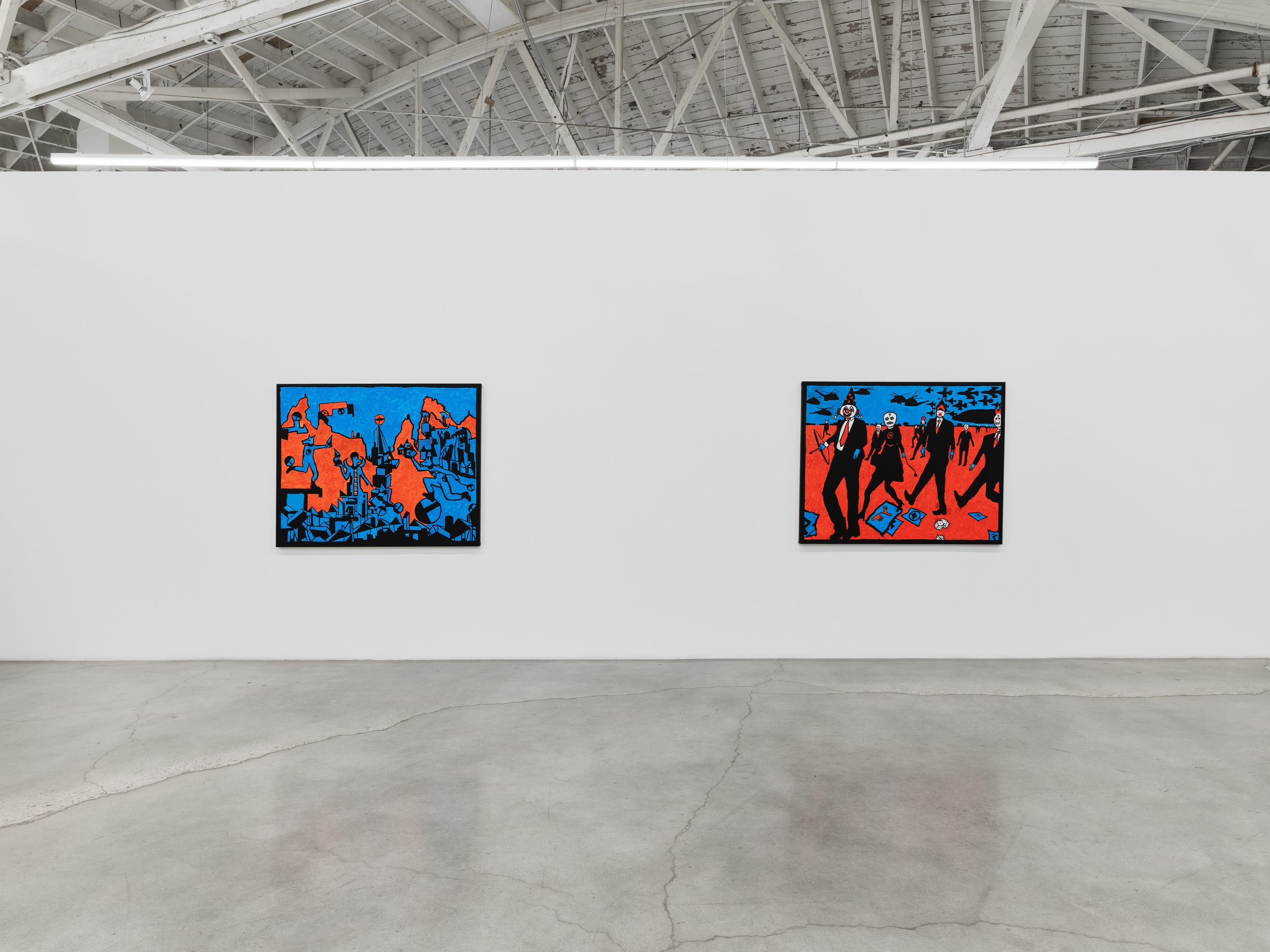
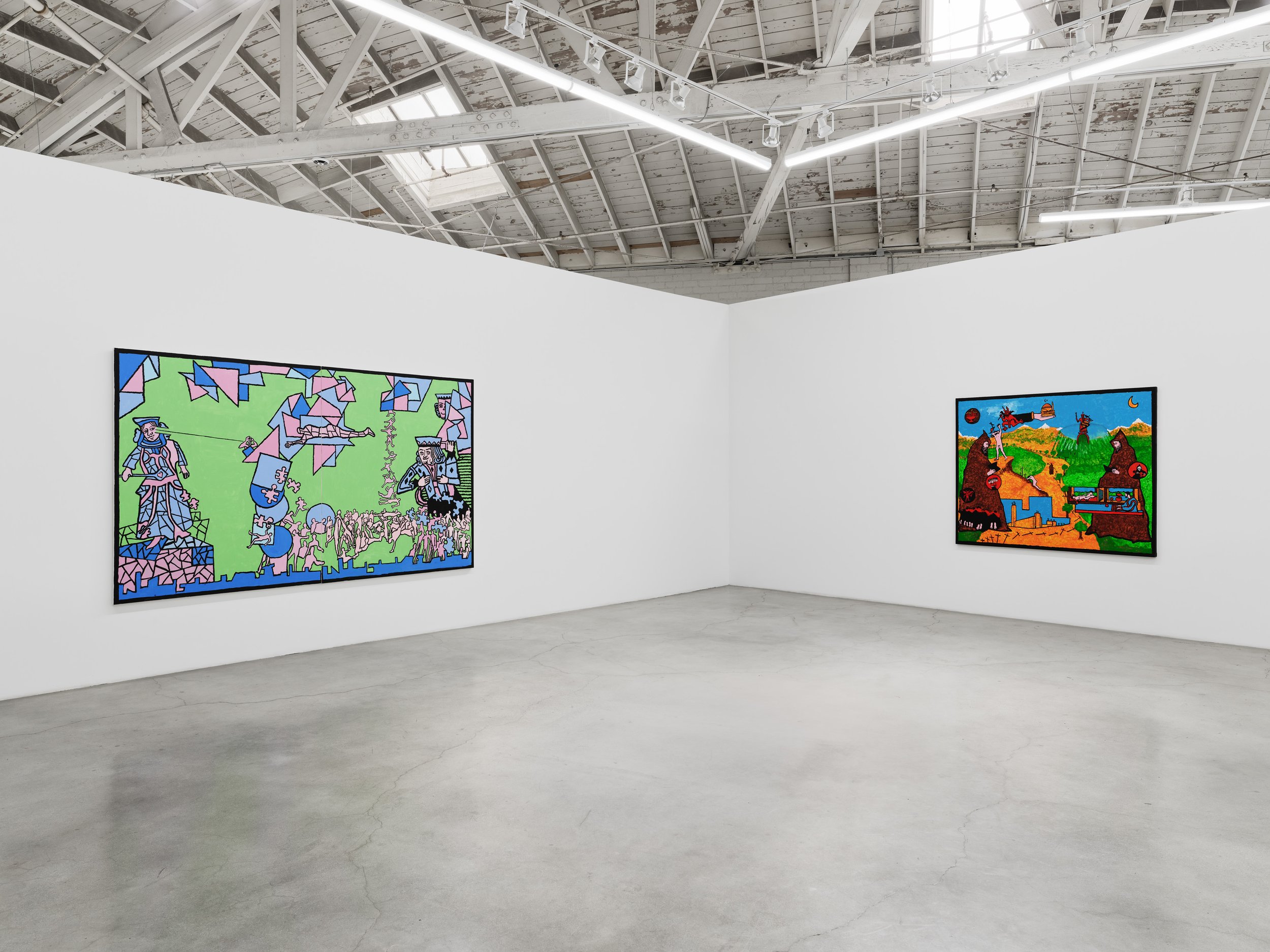


Installation View: Derek Boshier: Strange Lands 2276 E 16th Street Los Angeles CA 90021 March 16–April 20, 2024 Photography courtesy Night Gallery
A bracing interpenetration of figurative elements and sheer geometric form has been critical to Boshier’s conceptual strategy. This approach is at play in his experimental films, his stage set maquettes for David Bowie, and his drawings, collages, and paintings. In Strange Lands, bold, reductive colors; thick, jittery outlines; and vibrant spatial ambiguities activate the network of images that Boshier has culled from art history, science fiction, mythology, and the media. Squares, triangles, circles, pyramids, and cuboids hover on many of the new paintings’ surfaces. In Strange Lands: Planet Orange, these primary shapes appear to magnetically align and attach to others to create multifaceted architectural structures. In Strange Lands: Corporate Ladders, silhouetted triangles morph in stages into stemmed trapezoids, a skirt with legs, and, finally, full figures that veer off into a queue of spectators.
Strange Lands: The Game, 2024 acrylic on canvas 60 x 120 in (152.4 x 304.8 cm)
Boshier’s masterful blending of representational and complex abstract systems is also evident in Strange Lands: Landscape #1, a medieval village scene with a background detail from Pieter Brueghel’s The Triumph of Death. At the center of the composition, a saint clutches an elongated cross that leans towards—and nearly merges with—a floating rendition of El Lissitzky’s 1920slithograph, New Man, which consists of squares, trapezoids, triangles, and crescents. To the left, a courtier descends a pathway of rectangles that appear as if windswept from the Lissitzky. In the saint’s anachronistic revelation, we see in a flash what a brilliant instrument of design the cross was, traversing from pre-Christian times into pure modernist abstraction.
Strange Lands: Planet Kyano, 2023 acrylic on canvas 60 x 72 in (152.4 x 182.9 cm)
A decade ago, in his foreword to Derek Boshier’s monograph, Rethink/Re-entry, David Hockney remarked of his former classmate that he is an artist “who has never lost his sense of wonder at the world.” Boshier’s insatiable curiosity, fierce imagination, and dynamism of spirit radiate throughout Strange Lands. Installed together in the gallery space, these eleven paintings resonate like a bank of stained glass windows in a futuristic cathedral.
—Barry Blinderman
Photo credit: Thelma Gaskell
About the artist
Derek Boshier (b. 1937, Portsmouth, United Kingdom) began his career exhibiting in London in the 1960’s after graduating in 1962 from the Royal College of Art, where he studied alongside fellow Pop Artists David Hockney and RB Kitaj. Boshier has shown extensively in the U.S. and Europe, including recent solo exhibitions at Gazelli Art House, London, United Kingdom; Wolverhampton Art Gallery, Wolverhampton, United Kingdom; and City Museum of Novi Sad, Novi Sad, Serbia. His work has been acquired by The Menil, Houston, TX; The Tate Gallery of British Art and The British Museum, both London, United Kingdom; The Brooklyn Museum, New York, NY; The Centre Pompidou, Paris, France; and Nora Eccles Harrison Museum of Art, Logan, UT, among many other collections. He lives and works in Los Angeles.
For more information about Derek and his exhibit and the accompanying catalog, please visit the Night Gallery’s website here.
Emancipation: The Unfinished Project of Liberation
John Quincy Adams, The Freedman, 1863 Bronze 19 3/4 x 14 1/4 x 10 1/2 inches , Amon Carter Museum of American Art, Fort Worth, Texas
WILLIAMSTOWN, Mass. — In conjunction with the 160th anniversary of the Emancipation Proclamation, the Williams College Museum of Art (WCMA) presents a newly commissioned and recent works by Sadie Barnette, Alfred Conteh, Maya Freelon, Hugh Hayden, Letitia Huckaby, Jeffrey Meris, and Sable Elyse Smith in a new exhibition visualizing Black freedom, agency, and the legacy of the Civil War today and beyond.
The Block is Hot: the Resurrection, 2023 Plaster cast, AC motor, steel, concrete blocks, aircraft cable, U link, pulleys, ratchet strap 96 x 66 x 32 inches Courtesy of the artist with fabrication support from Fadel Sculpture and funding from the Amon Carter Museum of American Art and Newcomb Art Museum
The seven installations featured in Emancipation: The Unfinished Project of Liberation— spanning sculpture, photography, and paper and textile fabrications—will react to the legacy of John Quincy Adams Ward’s bronze sculpture The Freedman (1863) from the Amon Carter Museum of American Art’s collection and will highlight the diversity of materials and forms in sculpture, installation, and mixed media today.
Ms. Angela and the Baby, 2022 Pigment print on fabric with embroidery 71 x 41 inches Courtesy of the artist and Talley Dunn Gallery
Co-organized by WCMA and the Carter, the exhibition demonstrates how historical art collections can serve as a resource and inspiration for contemporary artistic practices. Emancipation will be on view at WCMA from February 16 through July 14, 2024, before traveling to its last destination at the Telfair Museums in Georgia. The exhibition opened at the Carter in the spring of 2023 and traveled to the Newcomb Art Museum atTulane University this past fall.
Home Good: Centerpiece, 2021 Altered table, wood, glass, plexiglass, metal-fake security cameras Table: 38 x 38 x 14 inches Courtesy of the artist and Jessica Silverman, San Francisco
WCMA hosted an opening celebration from 6 to 8 p.m. on Friday, Feb. 23.
Seeking a deeper understanding of what freedom looks like for Black Americans after 160 years, Emancipation interrogates the role of sculpture in American life by bringing the perspectives of contemporary Black artists into dialogue with the multi-faceted form and content of Ward’s The Freedman. Initially envisioned and sculpted by Ward before the end of the Civil War, the figure is depicted on the cusp of liberation, with bonds ruptured but not removed. The work is one of the first American depictions of a Black figure cast in bronze, and the Carter’s cast from 1863—dedicated to the 54th Massachusetts Regiment, an all-Black infantry unit—is the only copy of its kind with a key that releases a shackle from the figure’s wrist. While considered aspirational in its time, over a century and a half later, The Freedman’s reflection of uncertainty and endurance seem to manifest the long reach of American slavery.
Float, 2014, Mixed media. Clark Atlanta University Art Museum, Gift of Dr. Larry J. and Barbara Schulz in memory of their beloved son, Daniel Schulz, 1988-2021. © Alfred Conteh. Courtesy of the artist
In the WCMA venue of the exhibition, curators Destinee Filmore and Kevin Murphy aim to provide museum visitors with a deeper understanding of the nuanced histories of enslavement, abolition, and emancipation in Massachusetts through objects from the museum’s collection and others borrowed from local partners.
“Collaboration has been at the heart of this exhibition since its inception, so our decision to engage our local partners in telling the story of emancipation in the Berkshire region was a natural call to make,” said Filmore, a former WCMA Mellon Curatorial Fellow who is now Assistant Curator at the Metropolitan Museum of Art. “This exhibition encourages each venue or visitor to form their own understanding of enslavement and freedom by following the example of the contemporary artists as they respond to the show’s theme and historical materials.”
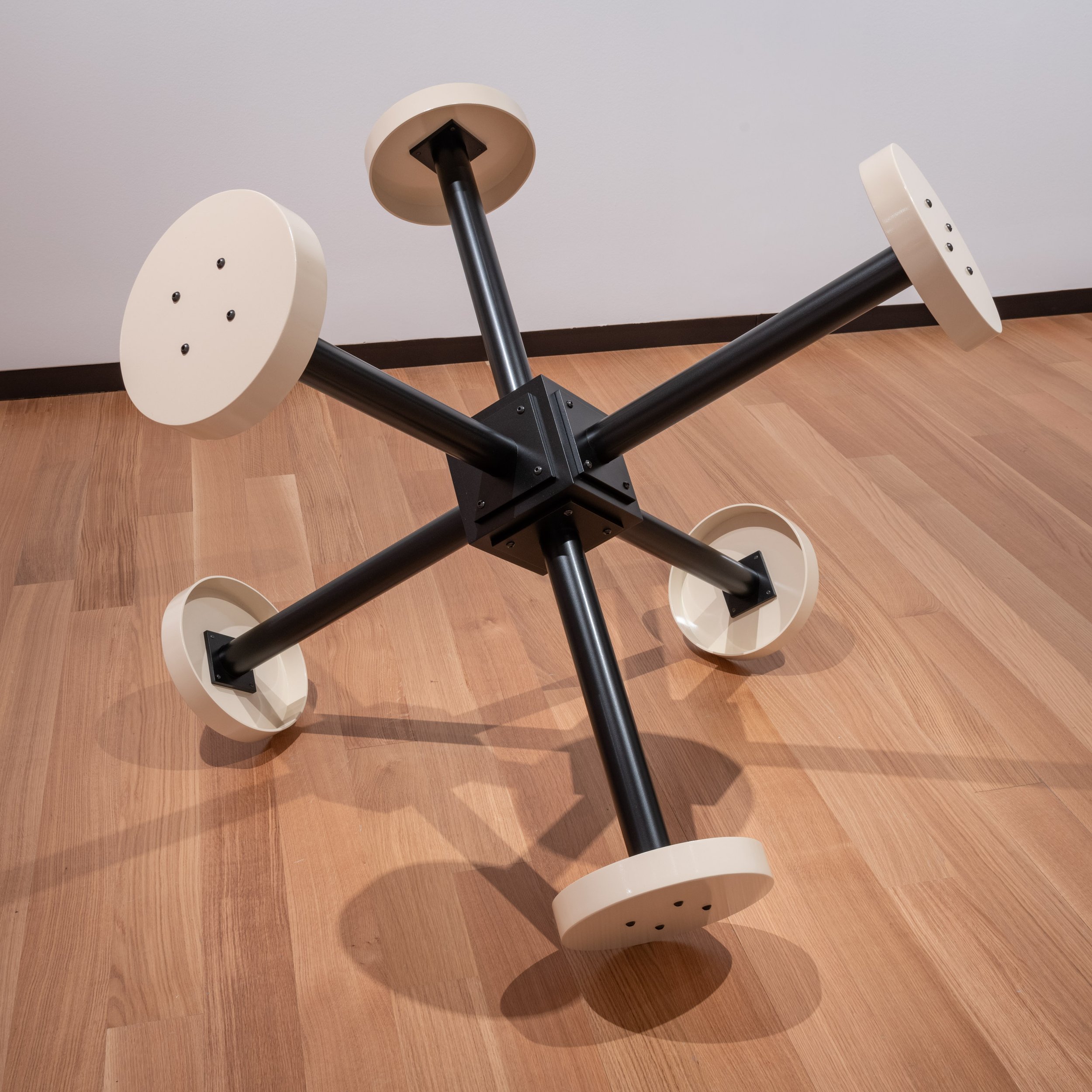
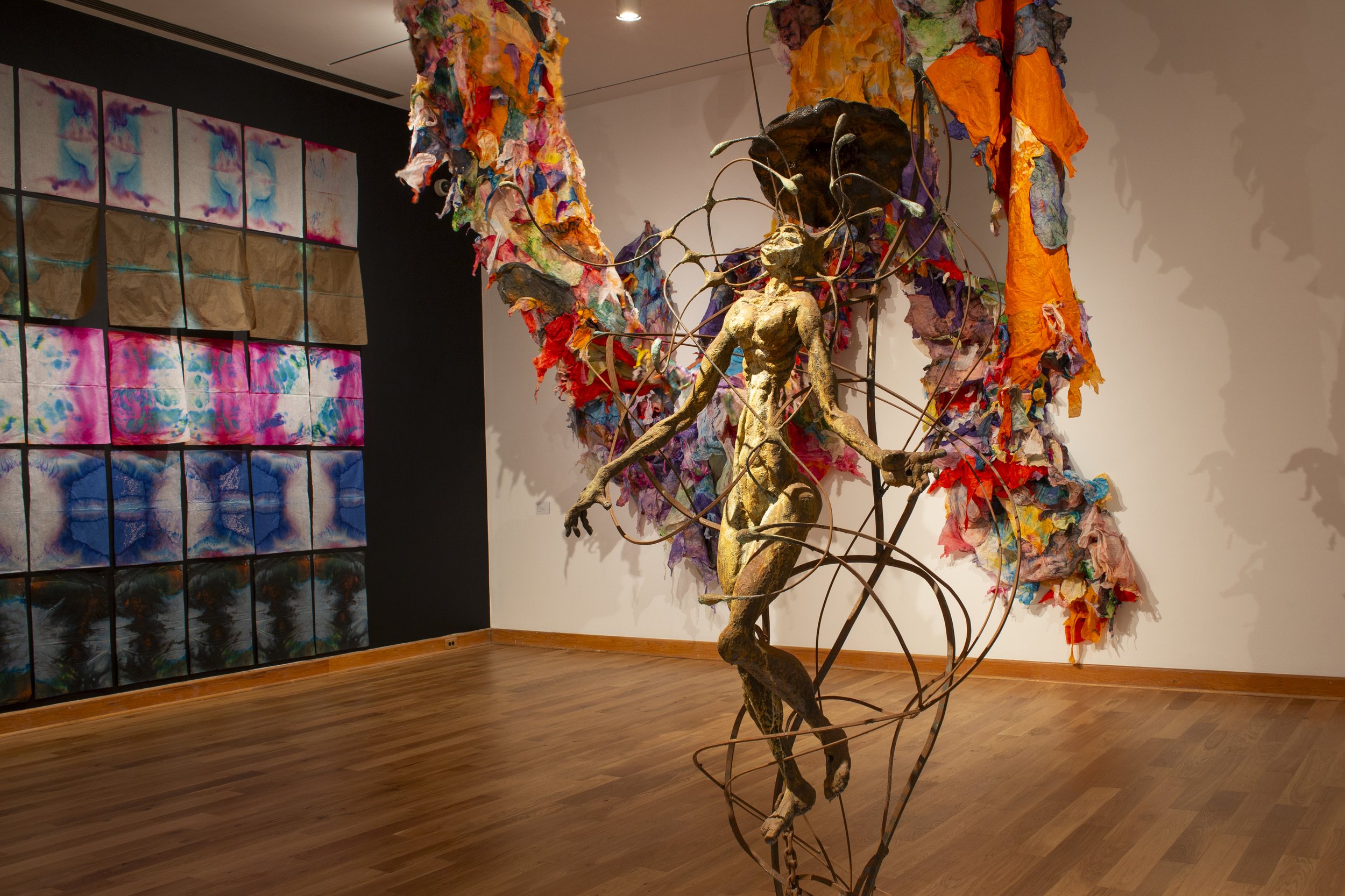
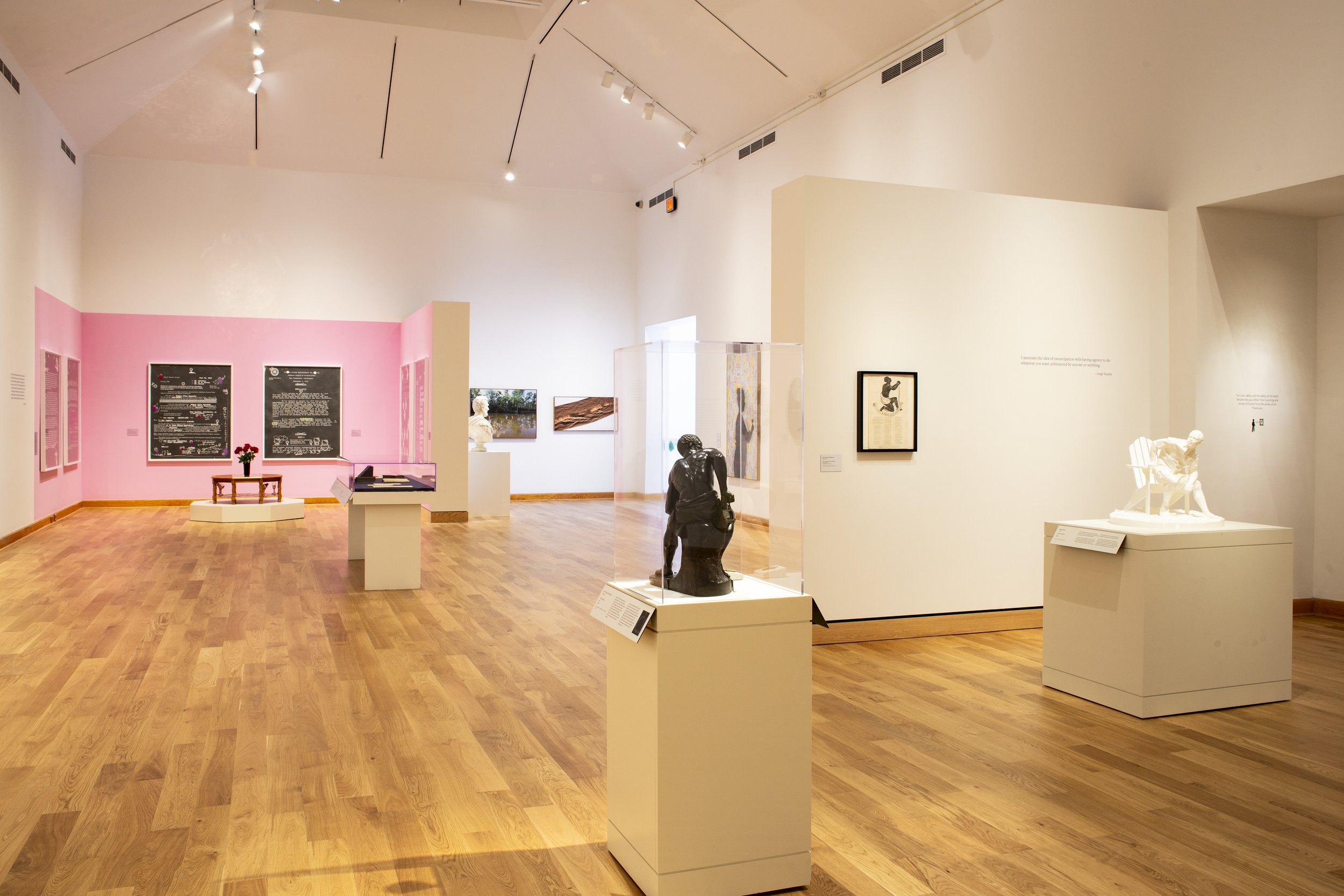

Installation view: Emancipation: The Unfinished Project of Liberation, 2024 The Williams College Museum of Art (WCMA) Courtesy of The Williams College Museum of Art (WCMA)
The WCMA iteration of Emancipation displays a new set of archival objects, including an early copy of the Emancipation Proclamation and a pamphlet of Frederick Douglass’s iconic 1852 speech Oration from the Williams College Chapin Library of Rare Books. A stunning example of Josiah Wedgwood’s Medallion produced for the Society for Effecting the Abolition of the Slave Trade, on loan from the Clark Art Institute, will be situated amongst other historical materials that tell the story of abolitionist causes. A recently conserved bust of Abraham Lincoln by Sara Fisher Ames–an artist with direct ties to Williamstown and Williams College–from WCMA’s collection rounds out the additions to the exhibition and actively contributes to the show’s goal of revisiting the enduring legacy of liberation.
The seven living artists represented in Emancipation were each invited to explore The Freedman through the lenses of their own lives and the multiplicity of meanings those contexts create for the form of emancipation.
● Sadie Barnette (b. 1984) is premiering new drawing works—based on FBI files that document how her father’s work for the Black Panther Party caused him to live under surveillance—and a sculptural table featuring her signature glitter paint. Barnette’s interpretation of “emancipation” draws on themes of abolition and decommodification, introducing fantastical, celebratory materials like glitter to exist in conversation—and in conflict—with challenging historical materials.
● Alfred Conteh (b. 1975) presents his celebrated sculpture work Float together with a large-scale work on canvas to explore the relationship between freedom, economic stability, and citizenship, including African Americans’ right to bear arms for the protection of their families. Throughout his work, rust and decay serve as metaphors for the vulnerability of Black citizens under the corrosive weight of White supremacy.
● Maya Freelon (b. 1982) has made an entirely new site-specific work utilizing her signature approach to large-scale, colorful tissue-paper installations. For Freelon, using recycled materials, or “maximizing the minimal,” is itself an emancipatory act–dissolving barriers between “high” and “low” art and allowing accessible materials like tissue paper to take up space within historically inaccessible institutions. Her artistic practice has been influenced significantly by her grandmother, who provided Freelon with both experiential and literal material, as well as by her godmother and namesake, Dr. Maya Angelou.
● Hugh Hayden (b. 1983) creates work that serves to delight and repulse with seemingly comfortable elements and sharp, foreboding features that reference the discomfort of American historical narratives. For this exhibition, Hayden will create his own version of The Freedman, departing from his signature woodworking with a 3D-printed piece that locates the subject firmly within the present day.
● Letitia Huckaby (b. 1972) presents her new silhouette and photo series, The Descendants, responding to the recent discovery and excavation of the Clotilda, the last known slave ship, from Alabama’s Mobile River. The series will be joined by Huckaby’s multipart artwork Under Two Greenwoods, featuring autobiographical photo-textiles that reference sites of the Tulsa Massacre as well as the artist’s family origins in Greenwood, MS. These projects continue Huckaby’s ongoing exploration of questions surrounding heritage
● Jeffrey Meris (b. 1991) is activating new and recent work using plaster, including The Block is Hot, a kinetic sculpture that dispels dust onto the floor for Meris to then draw with. The artist, who was born in Haiti and raised in the Bahamas, sees his body of work as just that: a body—or rather, as possessing a dual identity of bodily and architectural, working in symphony to create something both technical and conceptual, as seen in The Block is Hot.
● Sable Elyse Smith (b. 1986), in her interpretation of “emancipation,” calls to attention the nuances of visibility and how the most apparent manifestations of violent systems do not capture their full scope. For this exhibition, Smith has created a new iteration of her well-known jack sculptures, Riot I and Pivot II, which will allude for the first time to the unmistakable black, white, and blue colorway of a police car.
“As a curator, I’m tasked with unlocking the multiple meanings artworks accumulate over their lifetimes, but I hold the firm belief that historical works find their true potential in the hands of contemporary artists,” said Maggie Adler, Curator of Paintings, Sculpture, and Works on Paper at the Carter. “The Carter is committed to fostering the efforts of living artists whose work resonates with history, and Emancipation is a case study in the new creative possibilities that can be realized by seeking inspiration from historical collections.”
“This exhibition is timely since Americans are reckoning with history and how to interpret the impact and after-effects of slavery,” said Maurita Poole, Executive Director of Newcomb Art Museum and co-curator of Emancipation. “The contemporary art breathes new life into the notion of emancipation and hopefully will encourage audiences to reconsider their perspectives about freedom and full citizenship in the United States.”
Emancipation: The Unfinished Project of Liberation is co-organized by the Amon Carter Museum of American Art and the Williams College Museum of Art. The exhibition is co-curated by Maggie Adler, Curator of Paintings, Sculpture, and Works on Paper at the Carter, and Maurita Poole, Executive Director of Newcomb Art Museum, Tulane University. The WCMA exhibition is supported by the Michael S. Engl 1966 Williams College Museum of Art Fund with generous support for the living artists’ installations made possible by Sasha and Edward P. Bass.
The exhibition will be presented with a companion book, co-published with the University of California Press, featuring Q&As with the exhibition’s seven contemporary artists and essays by Kelvin L. Parnell Jr. (PhD candidate, University of Virginia, Department of Arts and Sciences); Kirsten Pai Buick (professor, art history, University of New Mexico); Andrew J. Walker (Executive Director, Amon Carter Museum of American Art); Thayer Tolles (Marica F. Vilcek Curator of American Painting and Sculpture, Metropolitan Museum of Art); Pamela Franks (Class of 1965 Director, Williams College Museum of Art); and the co-curators, Maggie Adler and Maurita Poole. The book will also include a short story by N. K. Jemisin (Hugo Award winning Black science fiction/fantasy writer).
About Williams College Museum of Art
The Williams College Museum of Art (WCMA) creates and inspires transformative experiences with art that are integral to a liberal arts education, lifelong learning, and human connection. The museum is a partner in nurturing the cross-disciplinary inquiry catalyzed by art; advancing the academic and experiential preparation of arts leaders; enriching the cultural ecosystem of the Berkshires; engaging artists; and creating a shared learning community that spurs new thinking, creative making, and civic engagement. Located on Main Street in Williamstown, Massachusetts, on the Williams College campus, the museum draws on the diverse perspectives and collaborative ethos of the college to enliven the more than 15,000 works in its growing collection. The museum is open to the public Tuesday through Sunday from 10 a.m. to 5 p.m. Admission is free.
For more information about this exhibit and other exhibits at the Williams Museum of Art, please visit here. For information about Williams College, visit here.
Li Songsong : The Past
Li Songsong: The Past 1201 South La Brea Avenue, Los Angeles, CA 90019 March 16–April 27, 2024 Photography courtesy Pace Gallery
Los Angeles – Pace is pleased to present an exhibition of new and recent paintings by Chinese artist Li Songsong at its Los Angeles gallery. The exhibition opened on March 16 and will be on view until April 27 of this year, the presentation marks the artist's first-ever solo exhibition in LA as well as his first solo show in the US since 2019.
We are Masters of the New World, 2022 oil on canvas 47-1/4" × 39-3/8" (120 cm × 100 cm) No. 90932
One of the most celebrated contemporary painters in China, Li has honed his distinct style—marked by his use of reliefs, tense brushstrokes, and solid color blocks—over the last 20 years as part of his pursuit “to paint something that had a certain distance from reality,” as he once put it. Inflected by history, politics, and culture, Li’s art is forged in enactments of accumulation and subtraction, of exposure and obscuration. At once personal, imaginative, and truthful, his deeply expressionistic paintings often depict fragmented, semi-abstract figurations underpinned by narratives that the viewer can decipher and absorb.
Three Decades, 2019 oil on canvas 82-11/16" × 82-11/16" (210 cm × 210 cm), 2 panels, each 82-11/16" × 13' 9-3/8" (210 cm × 420.1 cm), overal installed No. 90922
During his painting process, the artist deconstructs and reconstructs recognizable images from newspapers, films, historical photographs, and other media, reinterpreting them through the lens of his own experiences and memories while also creating new textural dimensions within his works. In abstracting images from their original contexts, Li has cultivated a unique visual language that invites viewers to see the world in new terms—from a different aesthetic perspective.
Past I, 2023 oil on canvas 47-1/4" × 39-3/8" (120 cm × 100 cm) No. 90929
“To this day, this principle—of generating various meanings through intensified looking—runs like a red line throughout Li’s oeuvre,” curator Hendrik Bündge writes in his essay “History as Material as History” in a 2015 catalogue for Li’s exhibition at the Museo d’Arte Modema di Bologna and the Staatliche Kunsthalle Baden-Baden.
I am What I am, 2020 oil on canvas 120 cm × 100 cm (47-1/4" × 39-3/8") No. 77303
Li’s latest abstractions, which will be the subject of his upcoming show at Pace in LA, reflect his stream-of- consciousness approach to painting. Seeking psychological liberation from specific notions and themes, the artist has continued refining an increasingly pure language of painting since 2020. His creative approach is informed by the relationship between existence and the existent. Li’s making process for his new works is guided by his mental state— the force that drives his pursuit of freedom on the canvas.
You haven’t Look at Me that Way in Years, 2020 oil on canvas 170 cm × 280 cm × 10 cm (66-15/16" × 9' 2-1/4" × 3-15/16") No. 77302
Each work in the exhibition at Pace’s LA gallery represents a sum of the artist’s idiosyncratic brushstrokes, with the placements, shapes, and colors of his strokes determined by his state of mind at the moment paint meets surface. There is also a temporal quality to this generative process, since each stroke leaves its own indelible mark, even if it is covered by another stroke. For Li, these works are as much abstractions as they are portraits of his ever-evolving relationship to his chosen medium. In his ongoing exploration of what it means to create paintings about the act of painting, Li meditates on what it might mean to capture and express infinity within his compositions.
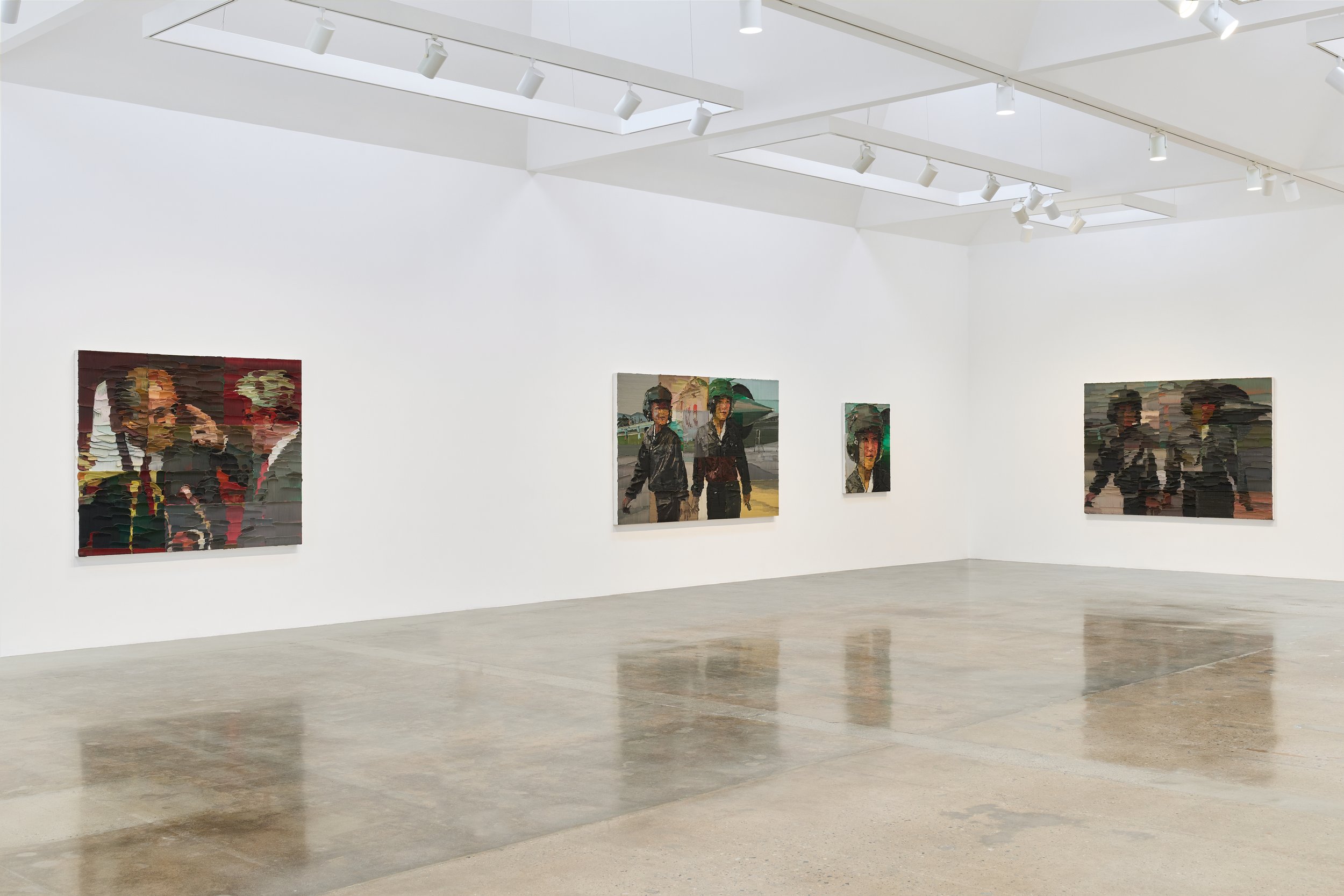
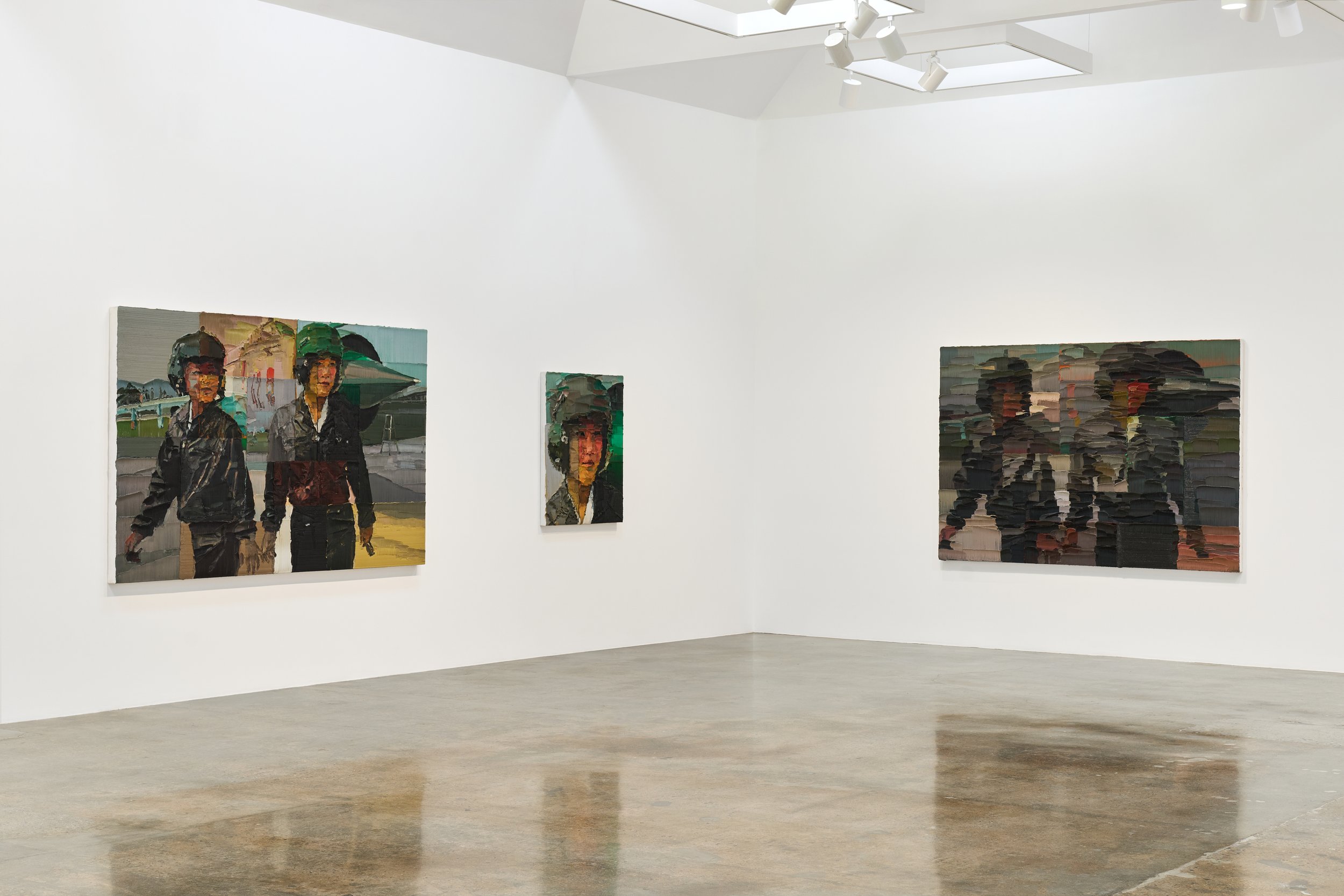
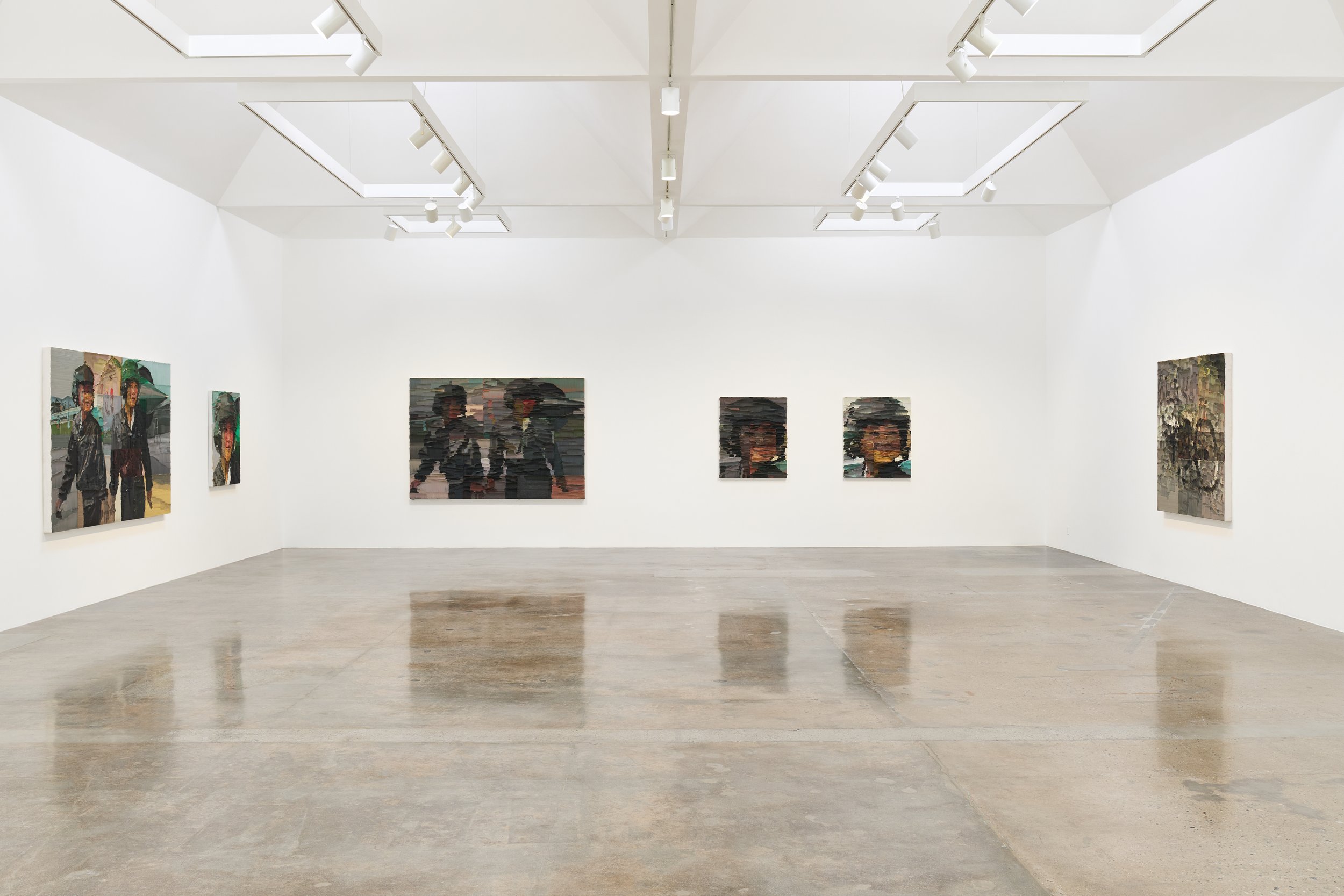


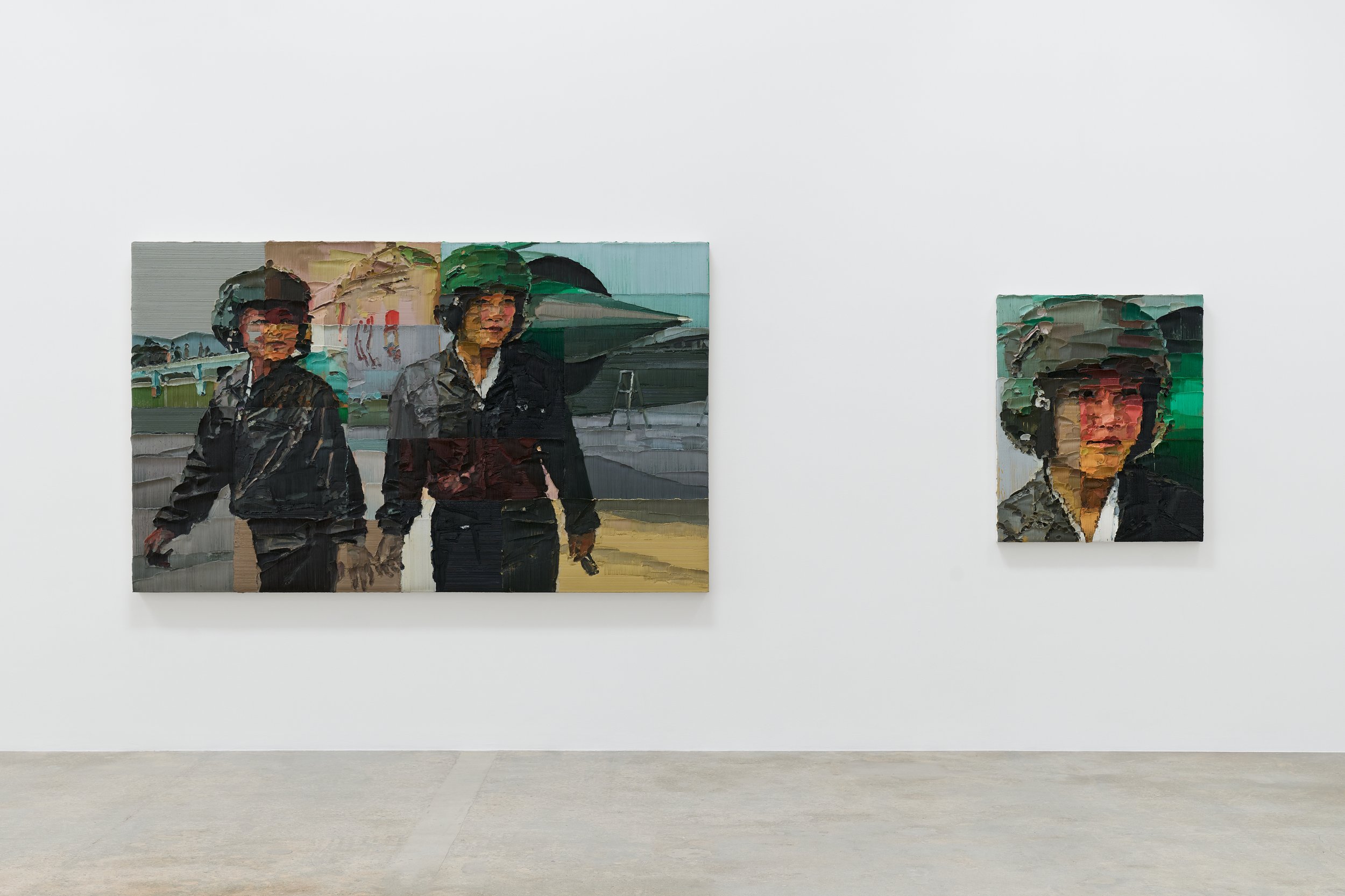
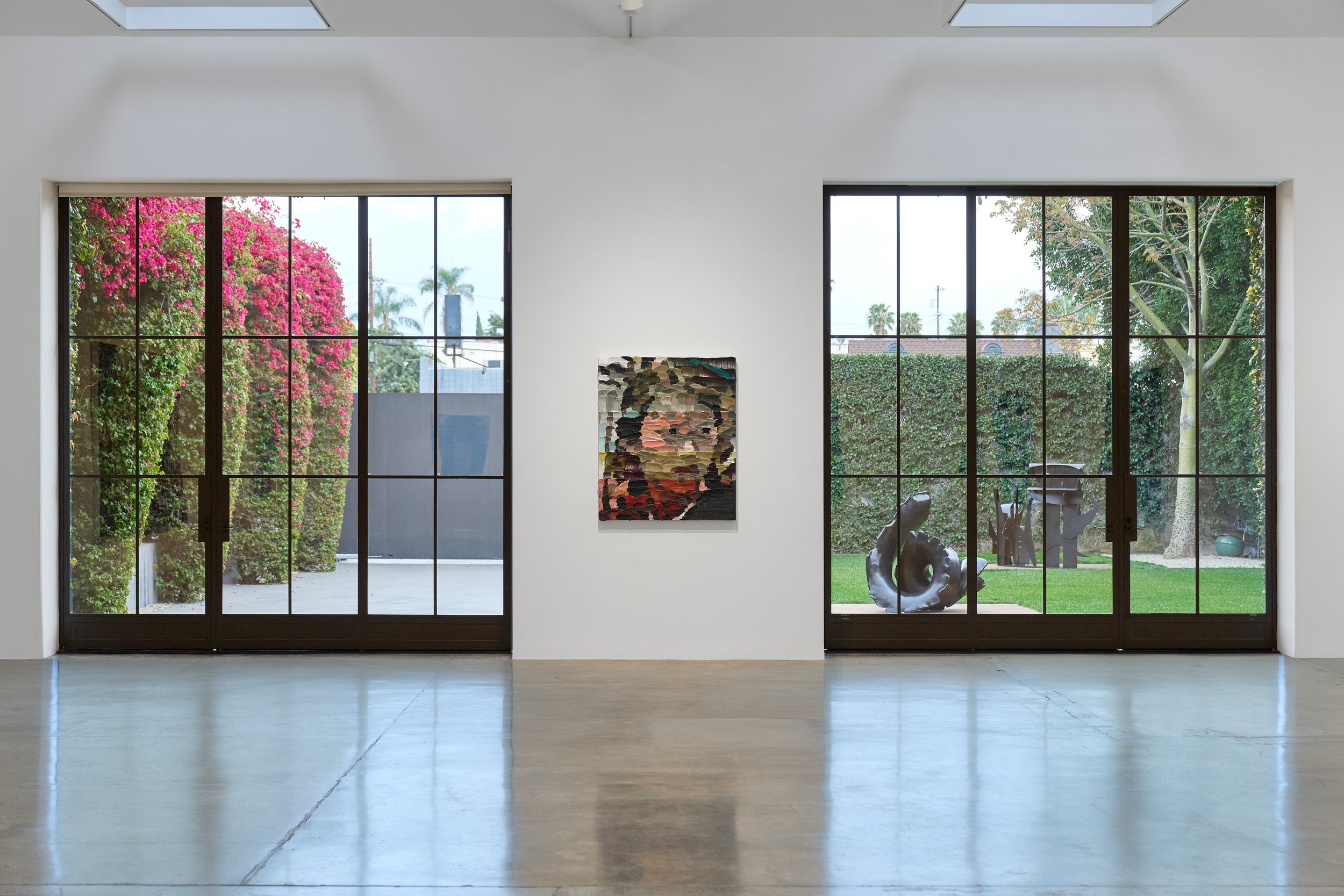
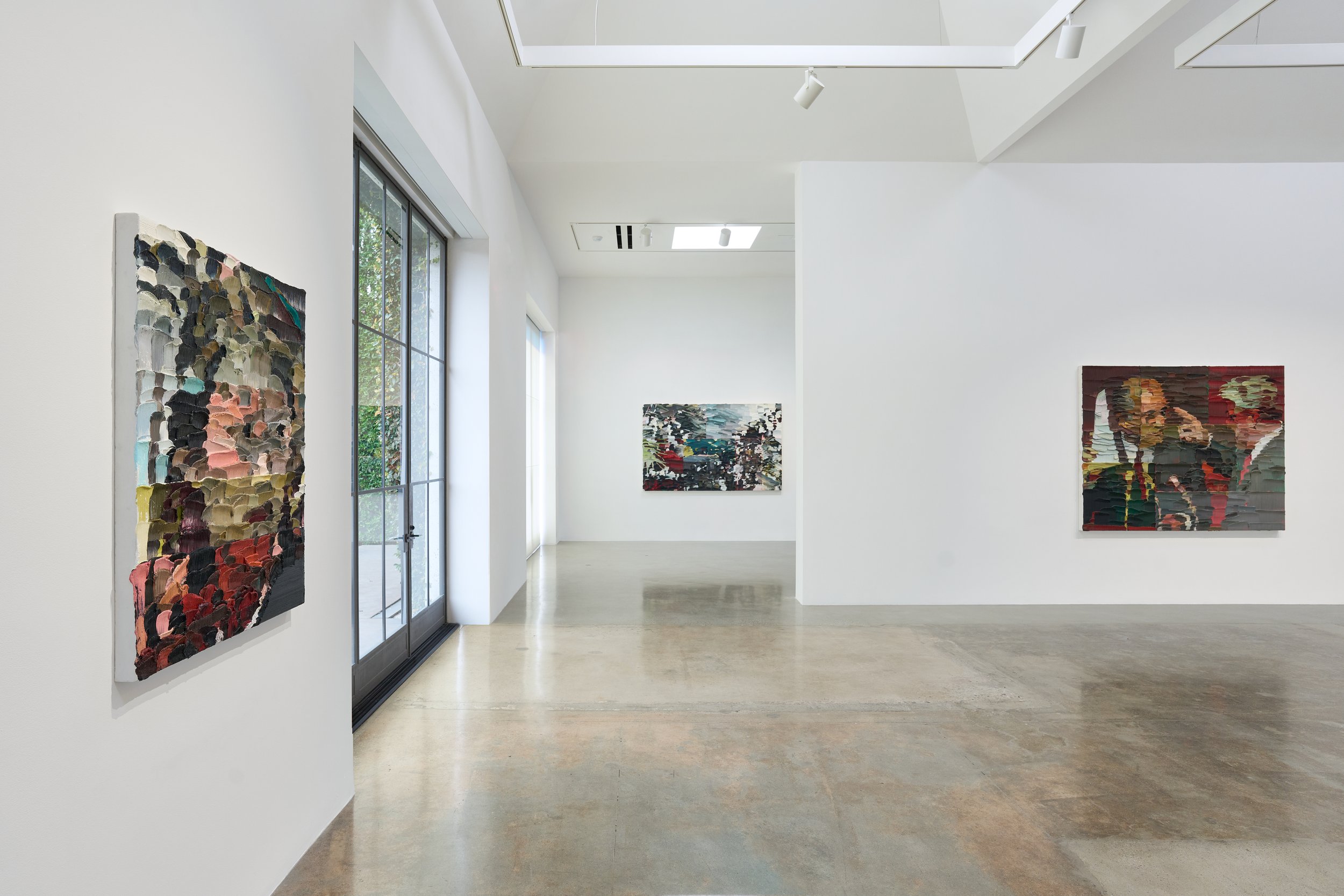
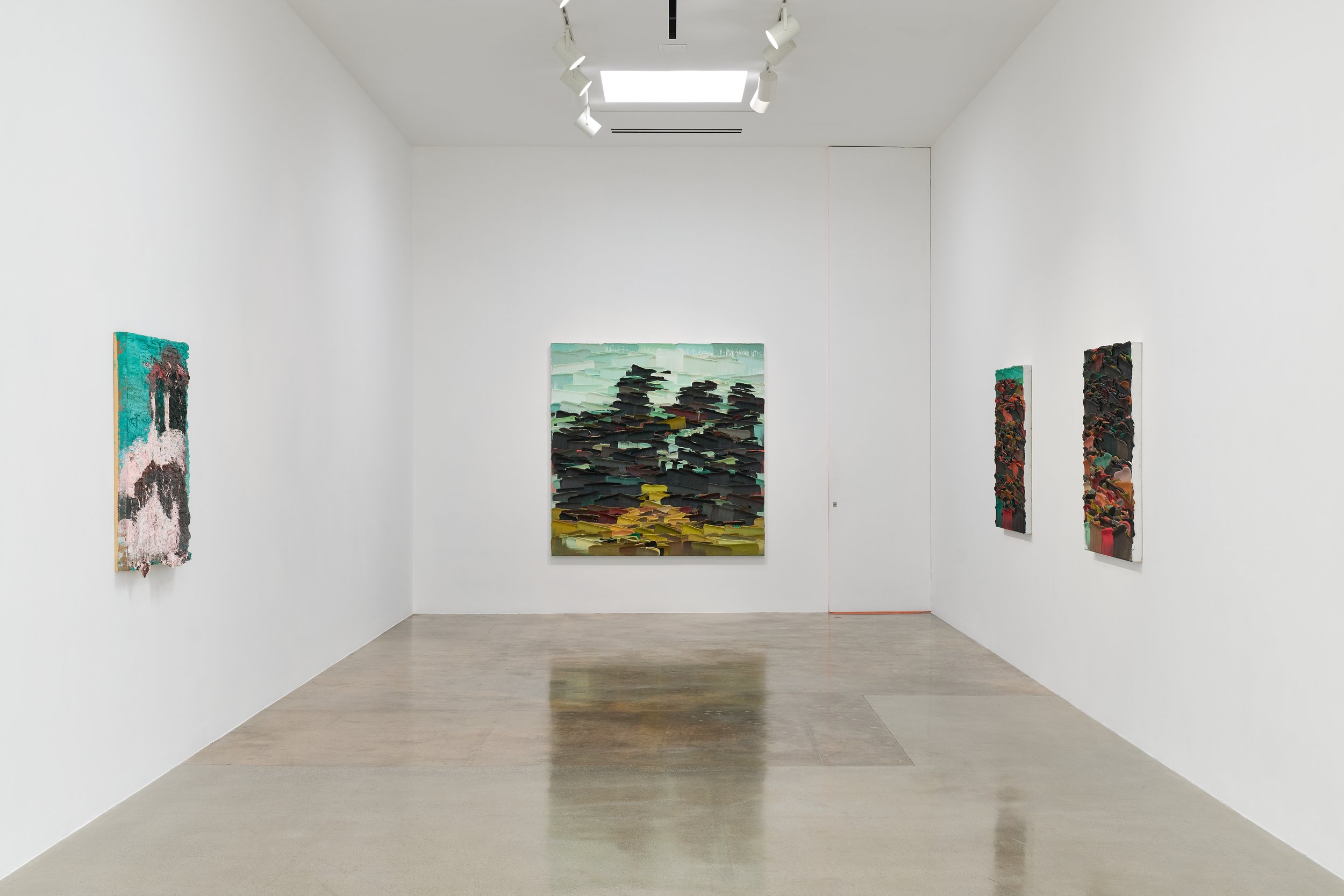

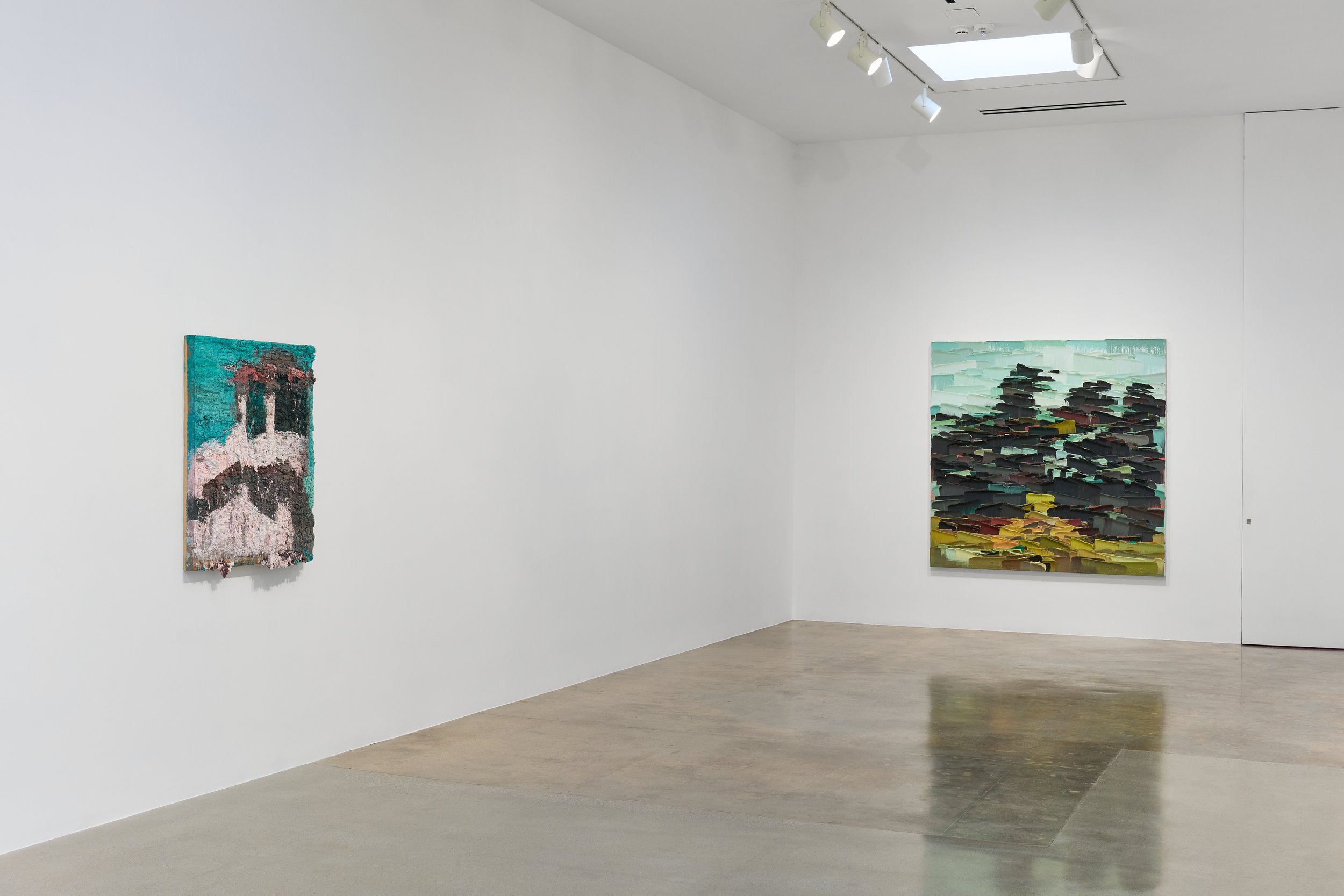
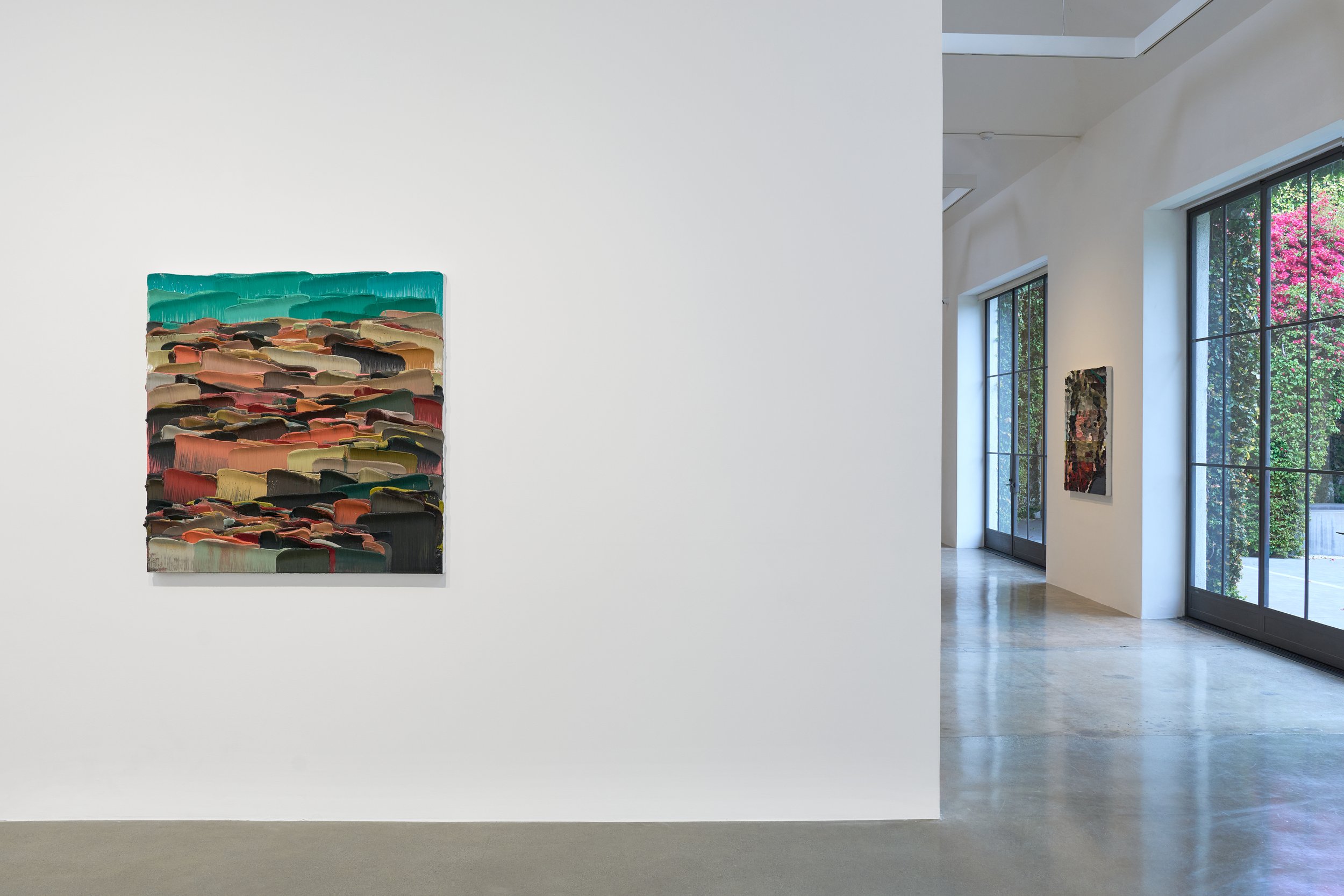
Li Songsong: The Past 1201 South La Brea Avenue, Los Angeles, CA 90019 March 16–April 27, 2024 Photography courtesy Pace Gallery
Li Songsong’s (b. 1973, Beijing) paintings animate the fragmentary nature of images and memory, paying particular attention to the people, events, and themes of modern and contemporary Chinese history. Li is interested in the way images cultivate histories and provoke memories, even if their relationship or reference to the past is nebulous and indirect. Although his compositions draw on found imagery—with a range of sources including restaurant advertisements, historical photographs, and movie stills, among others—Li freely reinterprets his sources, altering or omitting visual information. The resulting works eschew narratives, presenting pieces and traces of something rather than a totalizing record, creating new ways of looking at existing information.
Pace is a leading international art gallery representing some of the most influential contemporary artists and estates from the past century, holding decades-long relationships with Alexander Calder, Jean Dubuffet, Barbara Hepworth, Agnes Martin, Louise Nevelson, and Mark Rothko. Pace enjoys a unique U.S. heritage spanning East and West coasts through its early support of artists central to the Abstract Expressionist and Light and Space movements.
Since its founding by Arne Glimcher in 1960, Pace has developed a distinguished legacy as an artist-first gallery that mounts seminal historical and contemporary exhibitions. Under the current leadership of CEO Marc Glimcher, Pace continues to support its artists and share their visionary work with audiences worldwide by remaining at the forefront of innovation. Now in its seventh decade, the gallery advances its mission through a robust global program— comprising exhibitions, artist projects, public installations, institutional collaborations, performances, and interdisciplinary projects. Pace has a legacy in art bookmaking and has published over five hundred titles in close collaboration with artists, with a focus on original scholarship and on introducing new voices to the art historical canon.
Today, Pace has seven locations worldwide, including European footholds in London and Geneva as well as Berlin, where the gallery established an office in 2023. Pace maintains two galleries in New York—its headquarters at 540 West 25th Street, which welcomed almost 120,000 visitors and programmed 20 shows in its first six months, and an adjacent 8,000 sq. ft. exhibition space at 510 West 25th Street. Pace’s long and pioneering history in California includes a gallery in Palo Alto, which was open from 2016 to 2022. Pace’s engagement with Silicon Valley’s technology industry has had a lasting impact on the gallery at a global level, accelerating its initiatives connecting art and technology as well as its work with experiential artists. Pace consolidated its West Coast activity through its flagship in Los Angeles, which opened in 2022. Pace was one of the first international galleries to establish outposts in Asia, where it operates permanent gallery spaces in Hong Kong and Seoul, along with an office and viewing room in Beijing. In spring 2024, Pace will open its first gallery space in Japan in Tokyo’s new Azabudai Hills development.
For more information about this exhibition and others, please visit the Pace Gallery’s website here. Pace Gallery can be found on Instagram and Artsy, too.
Josef Koudelka: Industry
Josef Koudelka: Industry 540 West 25th Street, New York, NY 10001March 29–April 27, 2024 Photography courtesy Pace Gallery
New York – Pace is pleased to present an exhibition of work by Josef Koudelka at its 540 West 25th Street gallery in New York. The exhibition opened on March 29th and will be on view until April 27 of this year. This will be the artist’s first solo show in New York in nearly a decade, bringing together six large-scale panoramas he created between 1997 and 2010 as part of a project titled Industries. The exhibition will also include a display of small-scale, accordion-style maquettes of Mission Photographique Transmanche, Beyrouth Centre Ville, The Black Triangle, Reconnaissance-Wales, Lime Stone, Teatro del Tempo, Camargue, Piemonte, WALL, Ruins, and Solac. This presentation at Pace coincides with the release of Josef Koudelka: Next, the definitive and only authorized biography of the artist, published by Aperture. The book will be available for purchase on-site at the gallery during the run of the exhibition.
Italy, 2004 inkjet print mounted to aluminum 32-7/8" × 100-1/16" (83.5 cm × 254.2 cm), image 36-7/8" × 104-1/16" (93.7 cm × 264.3 cm), paper and mount 44-1/8" × 111-5/16" × 2-1/4" (112.1 cm × 282.7 cm × 5.7 cm), frame Edition 3 of 7, Edition of 7 + 4 APs No. 90259.03
Born in Czechoslovakia in 1938, Koudelka trained as an aeronautical engineer but began photographing Romani people—their everyday lives, their struggles, and their traditions—mainly in central European countries in the early 1960s, making a full-time commitment to photography later that decade. In 1968, he photographed the Soviet invasion of Prague, publishing his works under the initials P.P. (Prague photographer). Koudelka, who was anonymously awarded the Overseas Press Club’s Robert Capa Gold Medal for those photographs, left Czechoslovakia seeking political asylum in England, with assistance from the Magnum Photos cooperative, in 1970. His first book, Gypsies, was released by Aperture in 1975, and he has since produced more than a dozen publications of his work.
Germany, 2010 inkjet print mounted to aluminum 32-7/8" × 100-1/16" (83.5 cm × 254.2 cm), image 36-7/8" × 104-1/16" (93.7 cm × 264.3 cm), paper and mount 44-1/8" × 111-5/16" × 2-1/4" (112.1 cm × 282.7 cm × 5.7 cm), frame Edition 2 of 7, Edition of 7 + 4 APs No. 90257.02
Koudelka’s interest in the social and political dimensions of photography, evident in his earliest bodies of work, would endure through the following decades. He has been working in large-format, panoramic photography since 1986, capturing images of changing landscapes around the world—places that have been reshaped, altered, and in some cases devastated by the effects of industry, time, and war.
Germany, 1997 inkjet print mounted to aluminum 32-7/8" × 100-1/16" (83.5 cm × 254.2 cm), image 36-7/8" × 104-1/16" (93.7 cm × 264.3 cm), paper and mount 44-1/8" × 111-5/16" × 2-1/4" (112.1 cm × 282.7 cm × 5.7 cm), frame Edition 1 of 7, Edition of 7 + 4 APs No. 90260.01
Adopting a semi-nomadic lifestyle in pursuit of documenting these haunting, elegiac scenes, Koudelka produced deeply interconnected bodies of work that speak to the ways that the weight of history lingers within the natural world. During the late 1980s and early 1990s, the artist photographed the Berlin Wall; the streets of Beirut immediately following the Lebanese Civil War; outsized industrialization and pollution in the Black Triangle, a border region between Germany, Poland, and the Czech Republic; the Auschwitz concentration camp in Poland; and other places forever transformed by sociopolitical turmoil, violence, and environmental destruction.
Israel, 2009 inkjet print mounted to aluminum 32-7/8" × 100-1/16" (83.5 cm × 254.2 cm), image 36-7/8" × 104-1/16" (93.7 cm × 264.3 cm), paper and mount 44-1/8" × 111-5/16" × 2-1/4" (112.1 cm × 282.7 cm × 5.7 cm), frame Edition 1 of 7, Edition of 7 + 4 APs No. 90258.01
Also among Koudelka’s famous panoramic projects are his Ruins series, for which he photographed more than 200 archeological sites across Greece, Italy, Libya, Syria, and other countries between 1991 and 2015, and his body of work on Israel’s West Bank Wall, which he created over the course of seven trips to Israel and Palestine between 2008 and 2012. For immediate release “The face of the wounded landscape—it is marked by trouble, by suffering,” Koudelka tells his biographer, Melissa Harris. “It is the same as the face of people who have a difficult life. I am interested in real people, real faces … In this wounded landscape, I admire the fight for survival … Nature is stronger than man.”
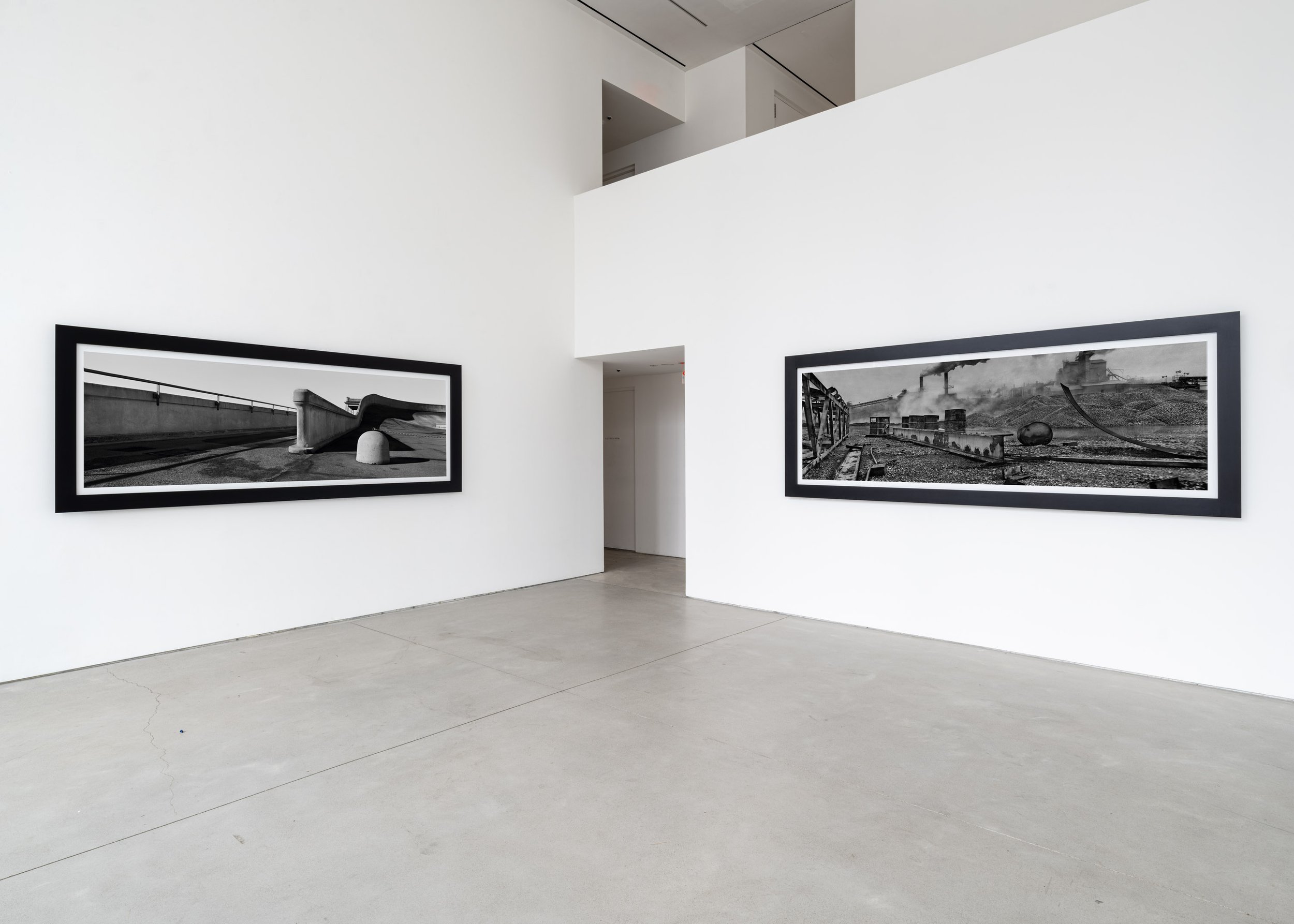

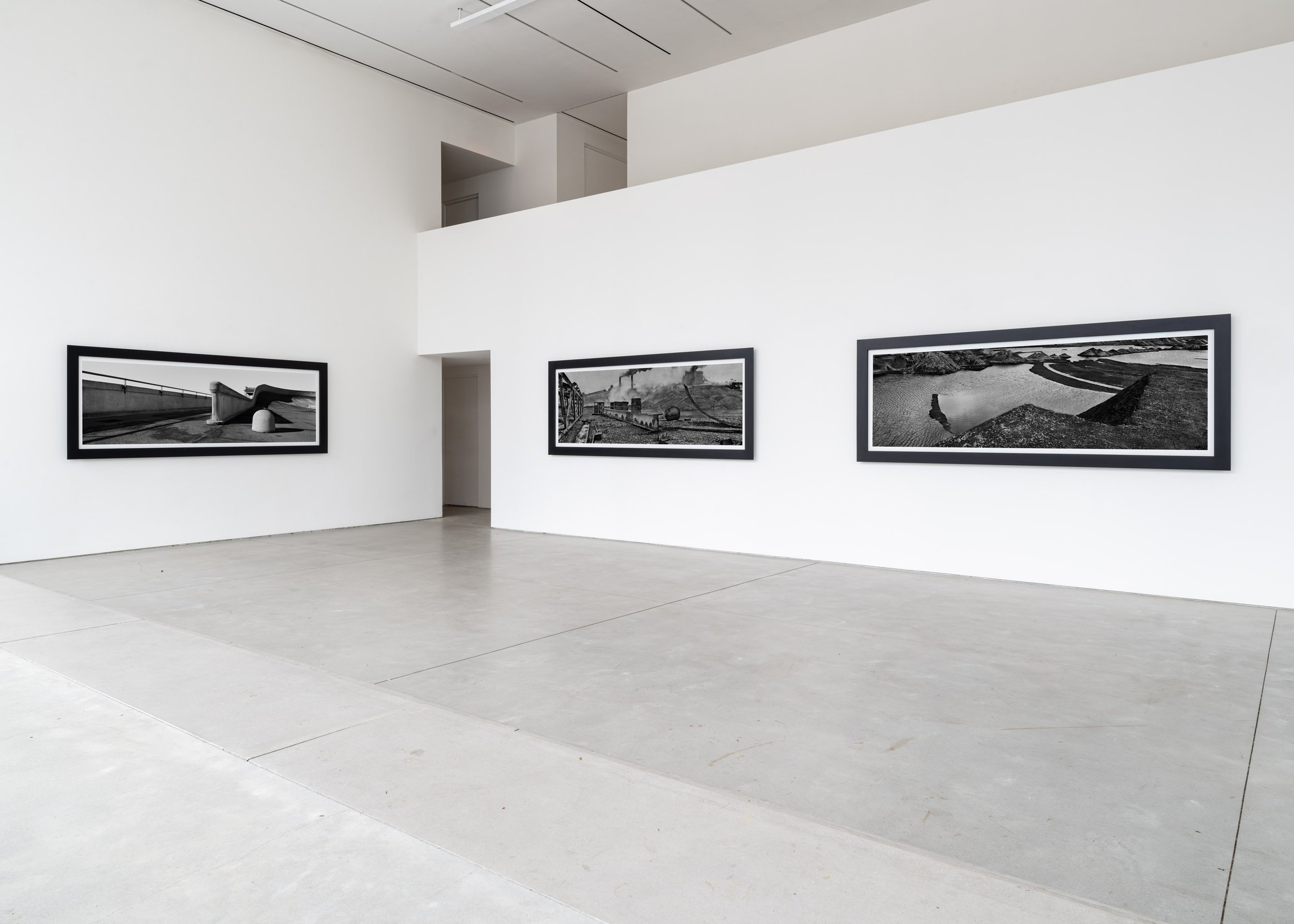
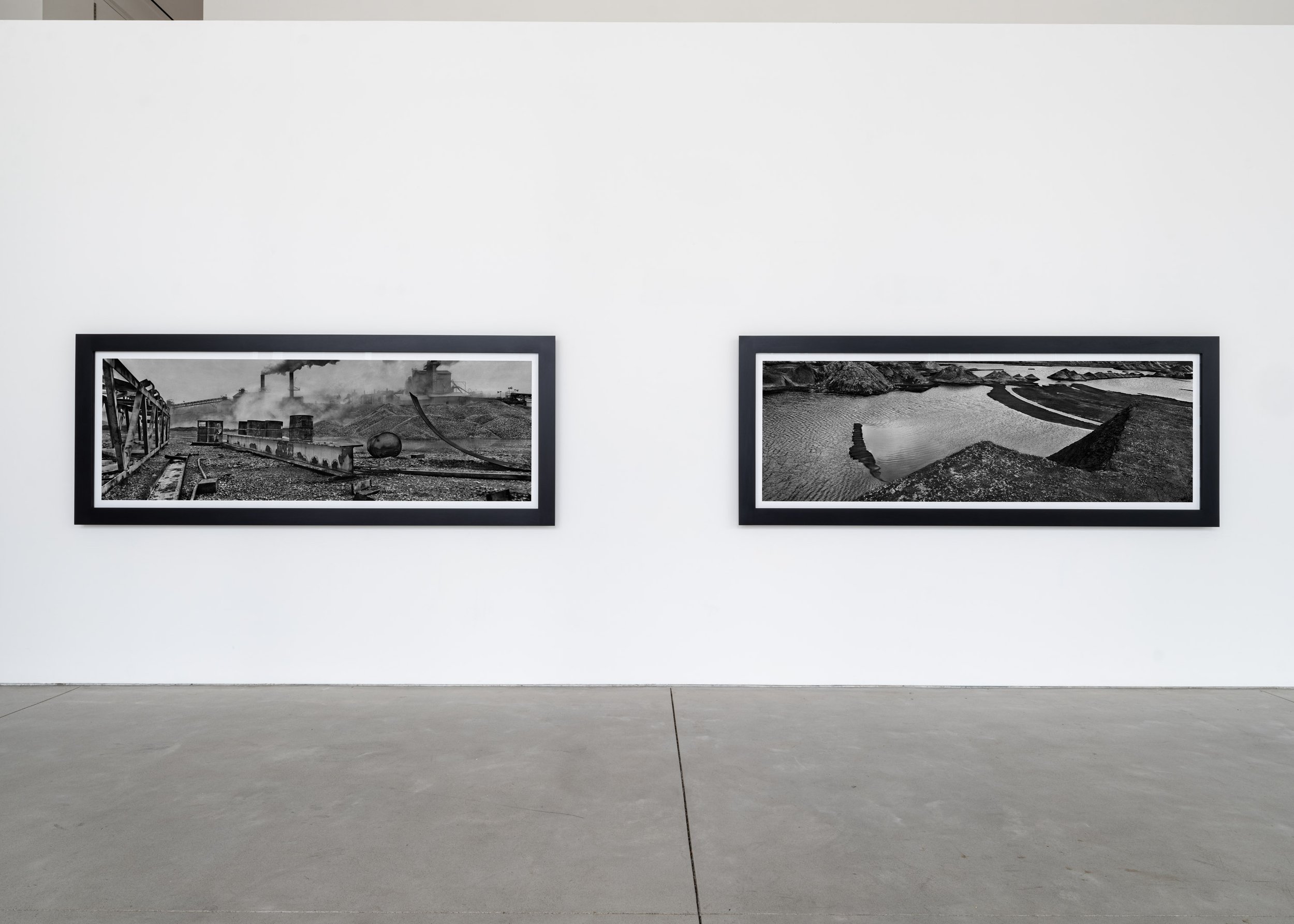
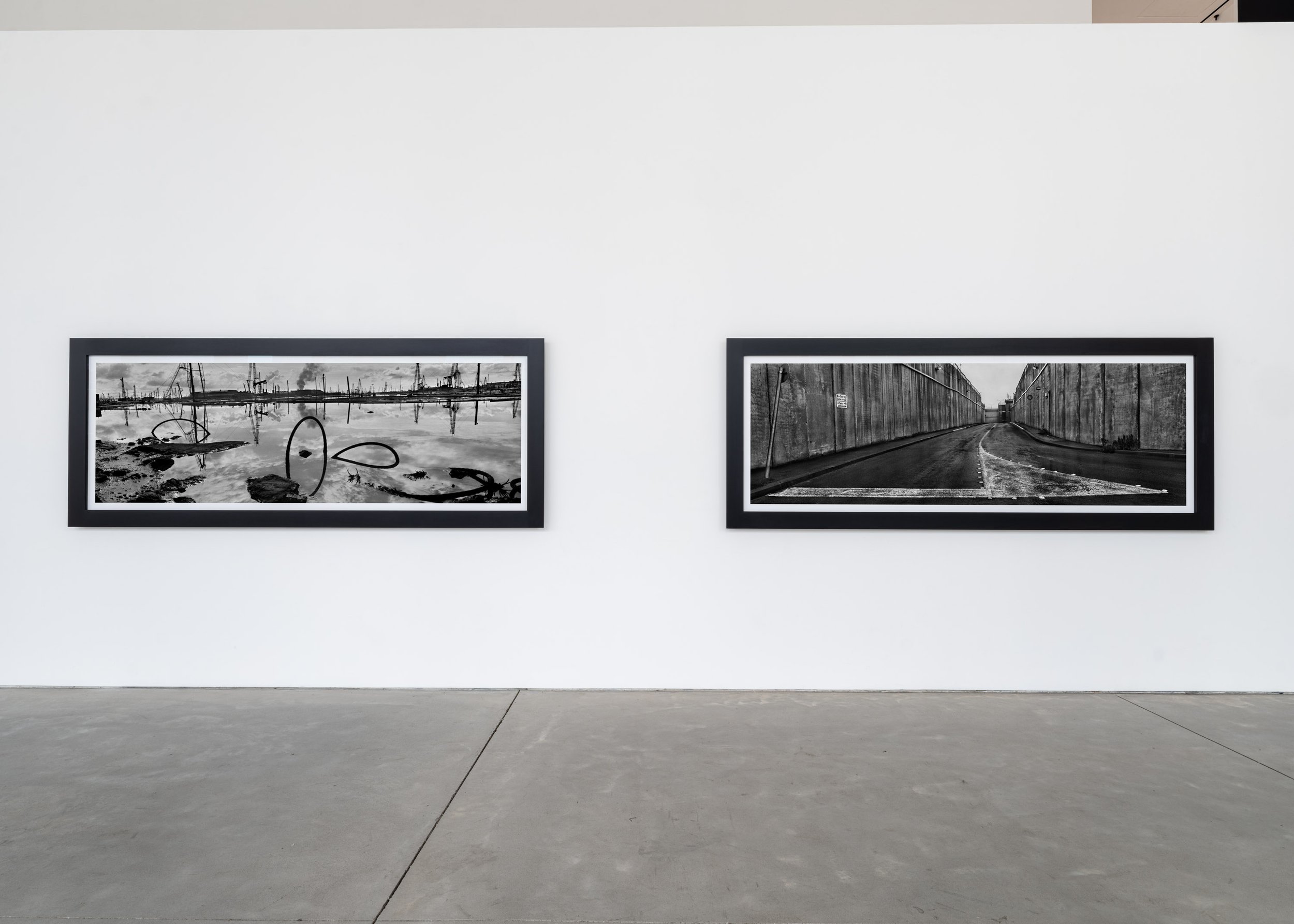
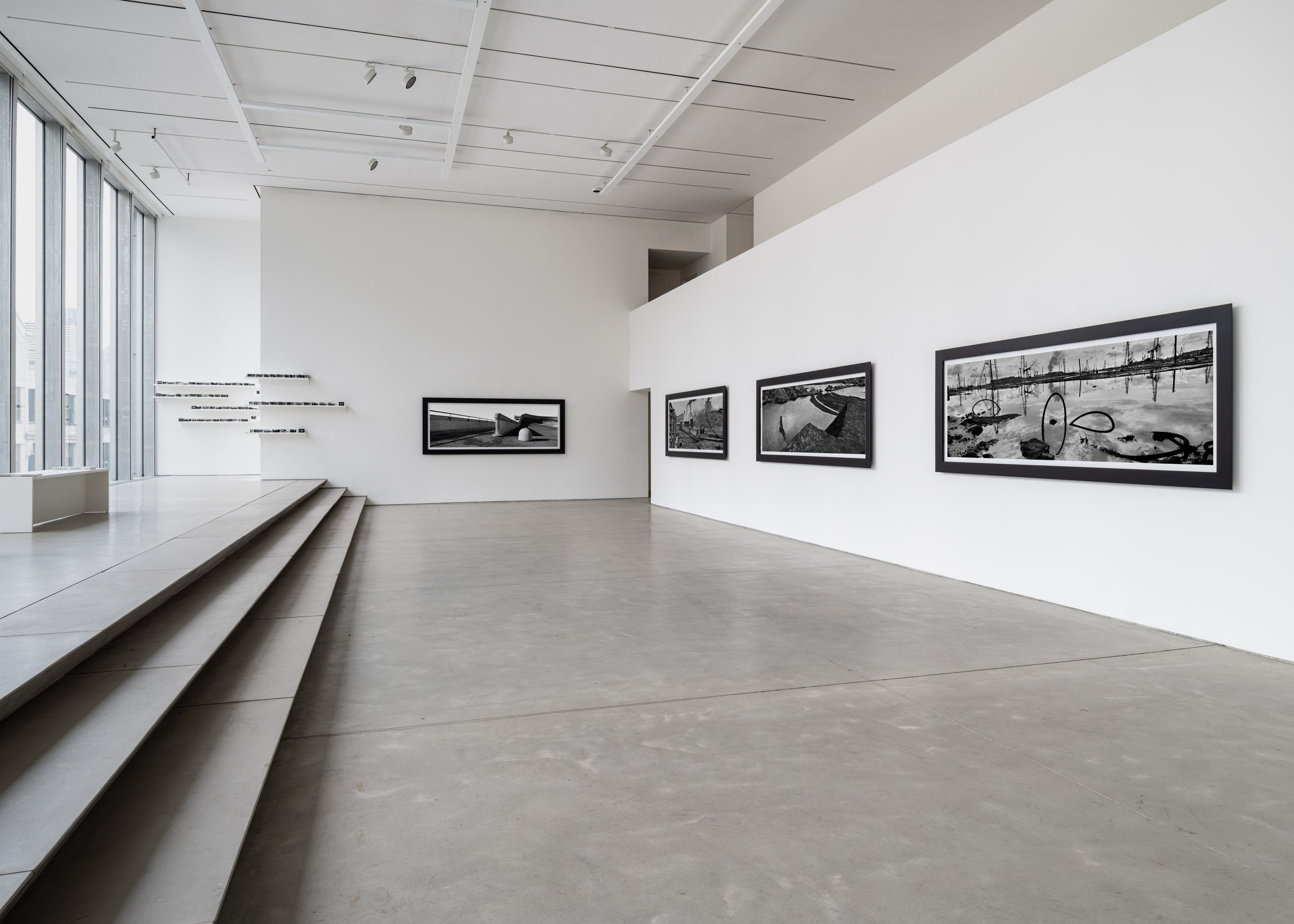
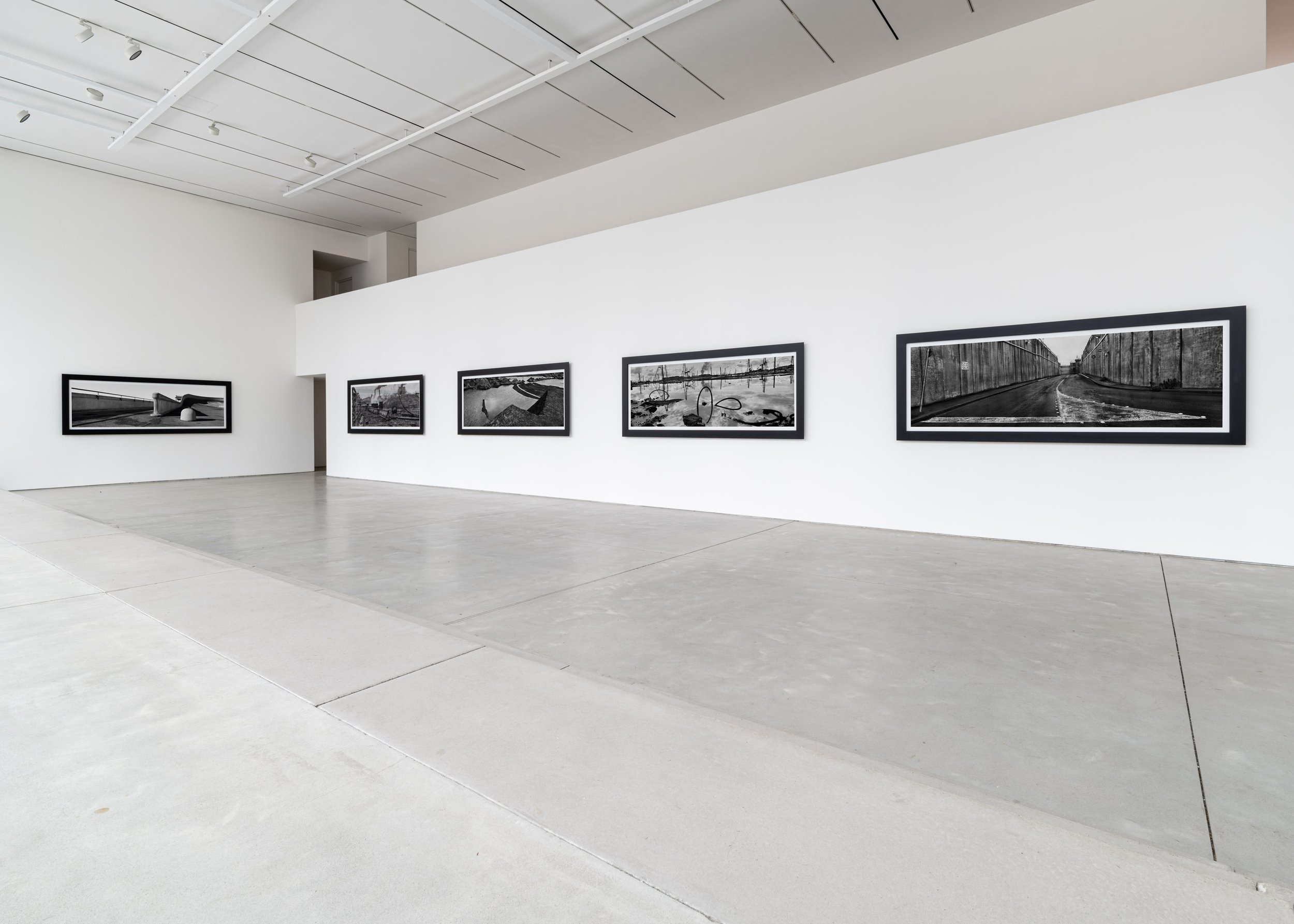
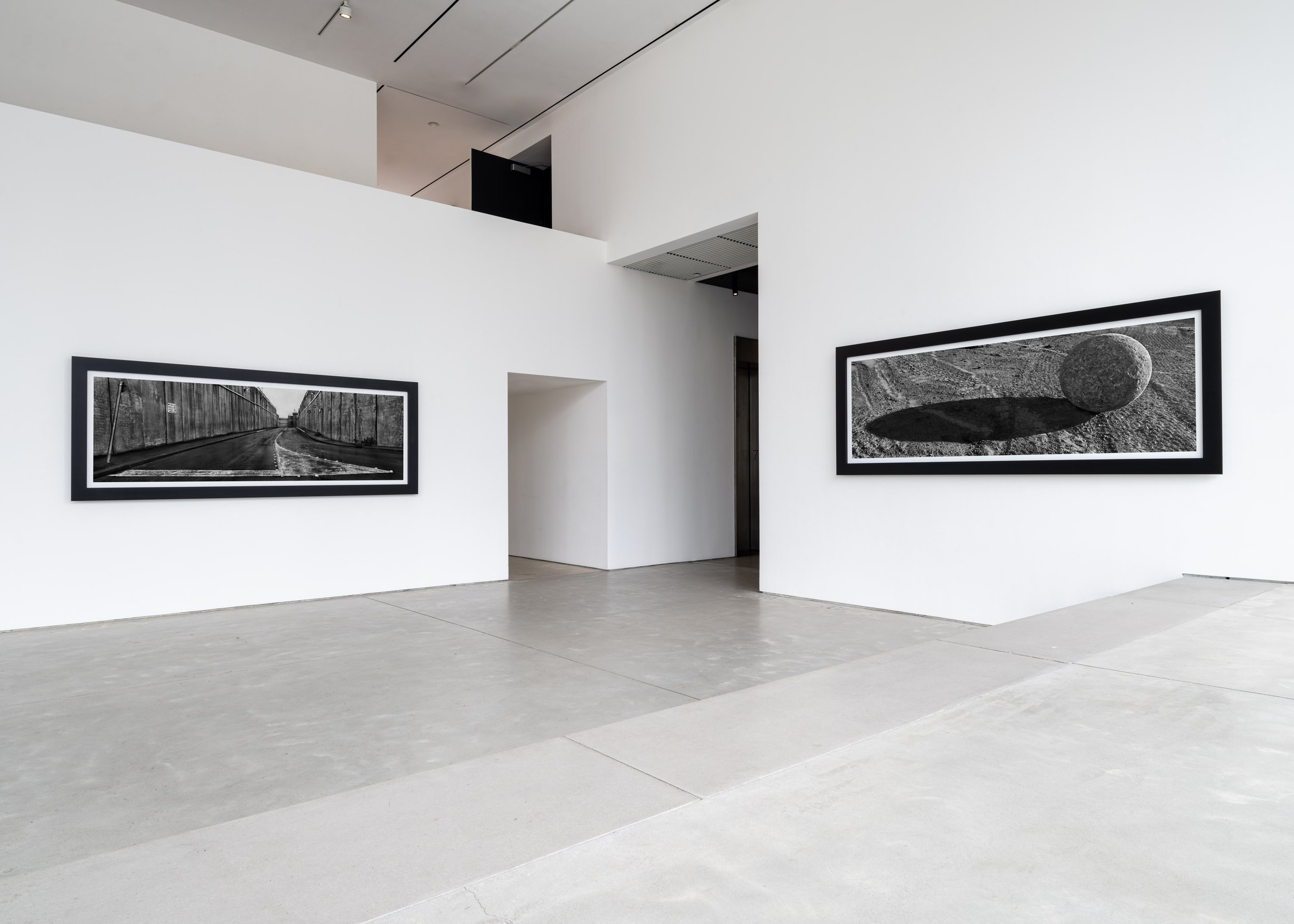
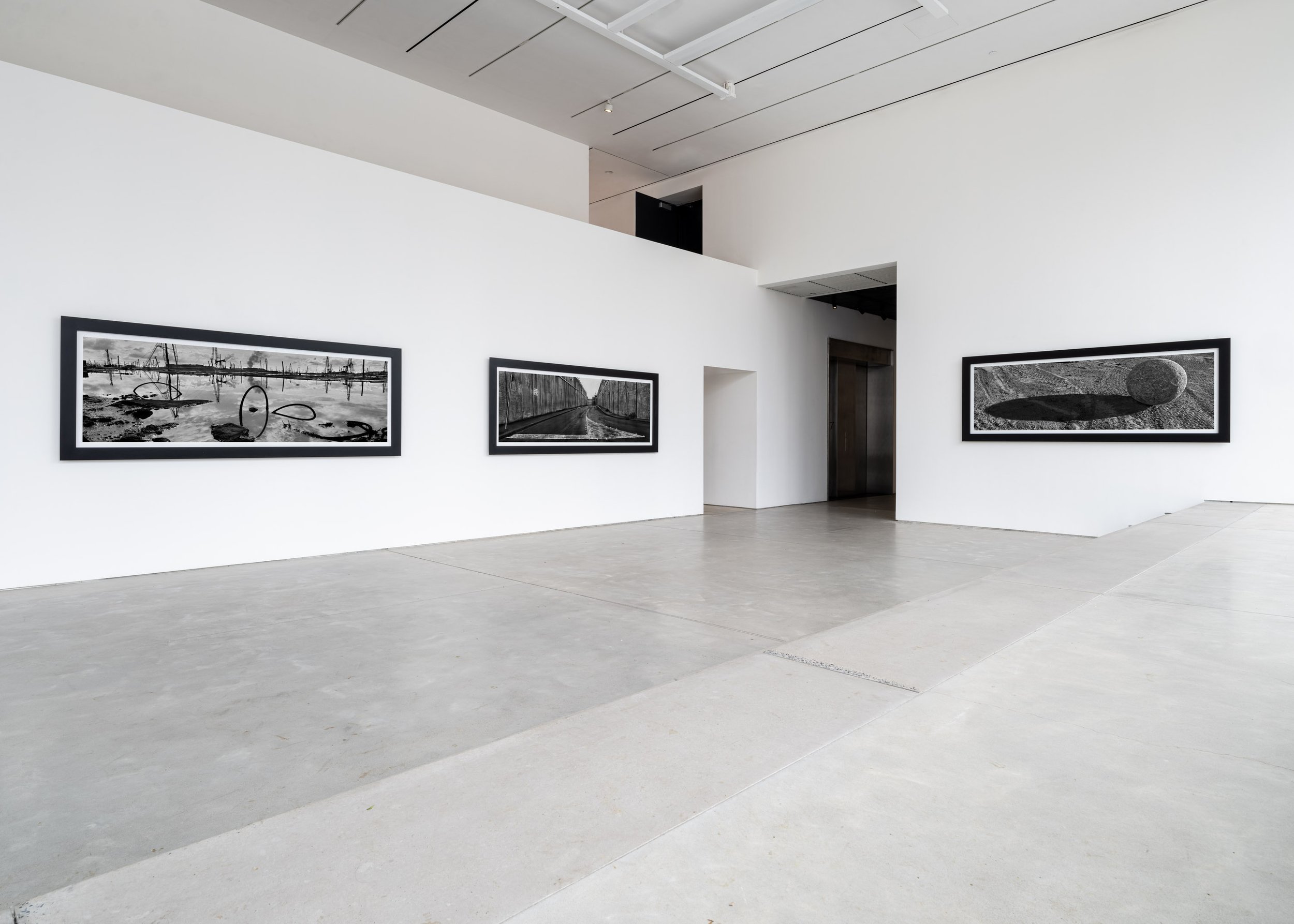
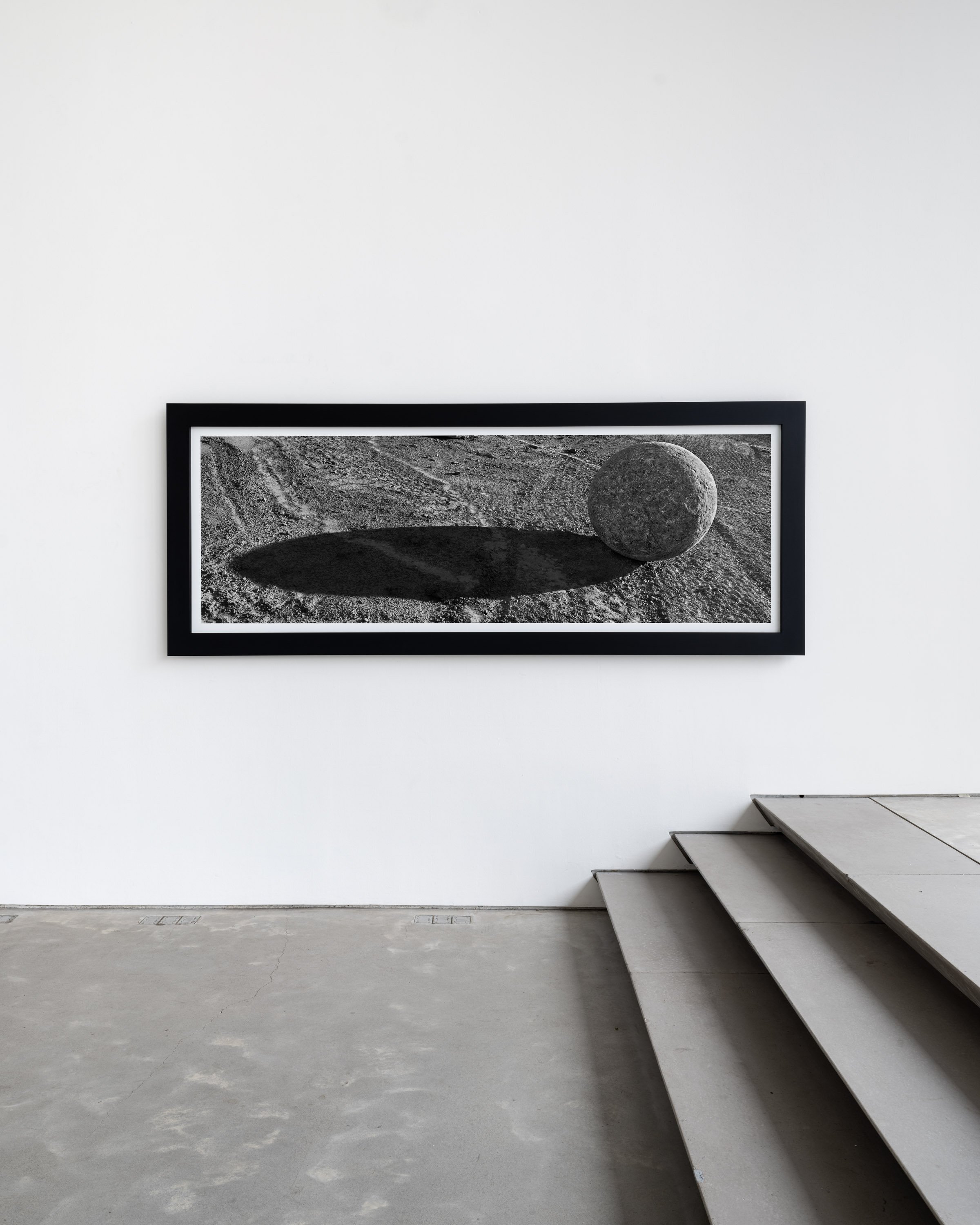
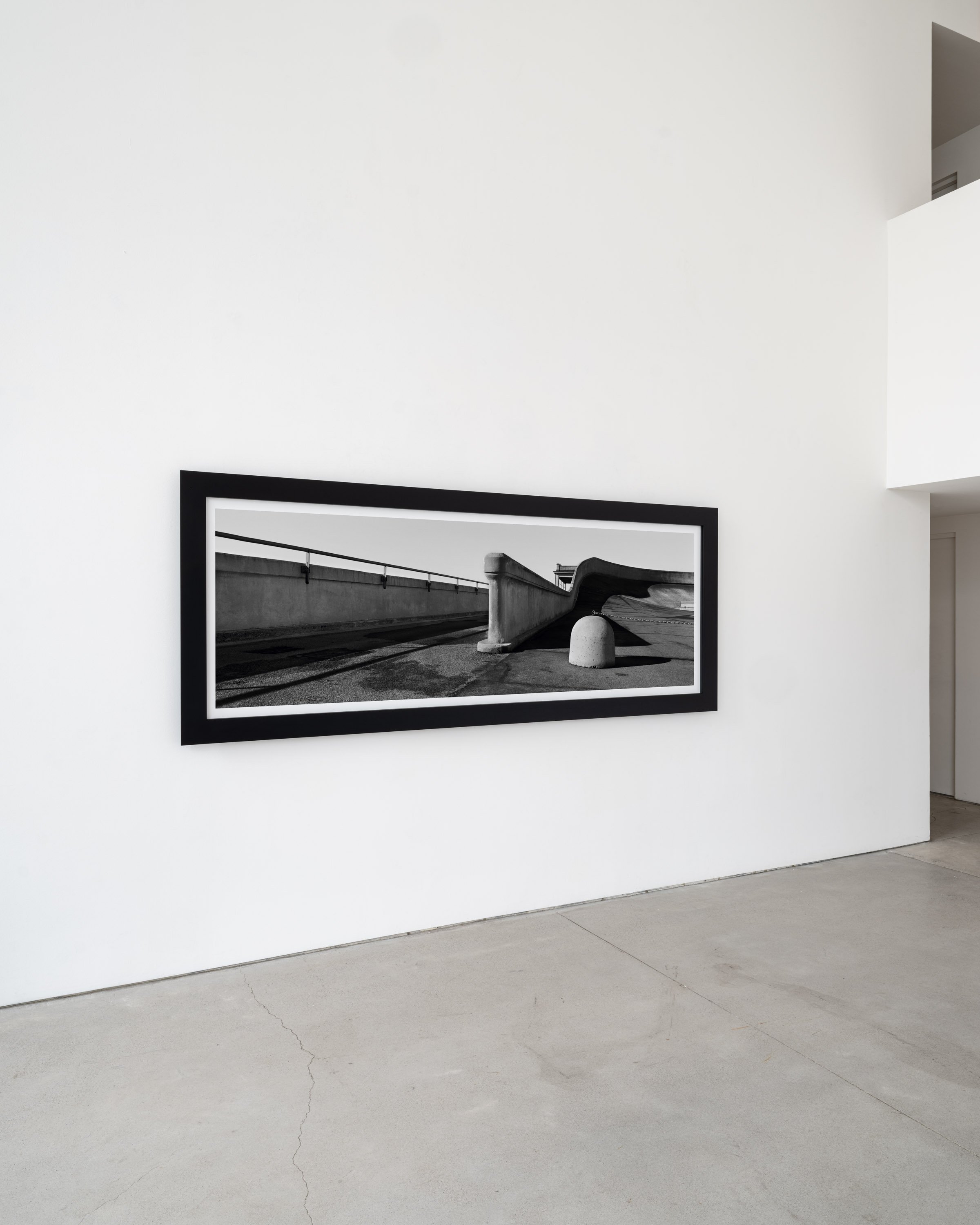
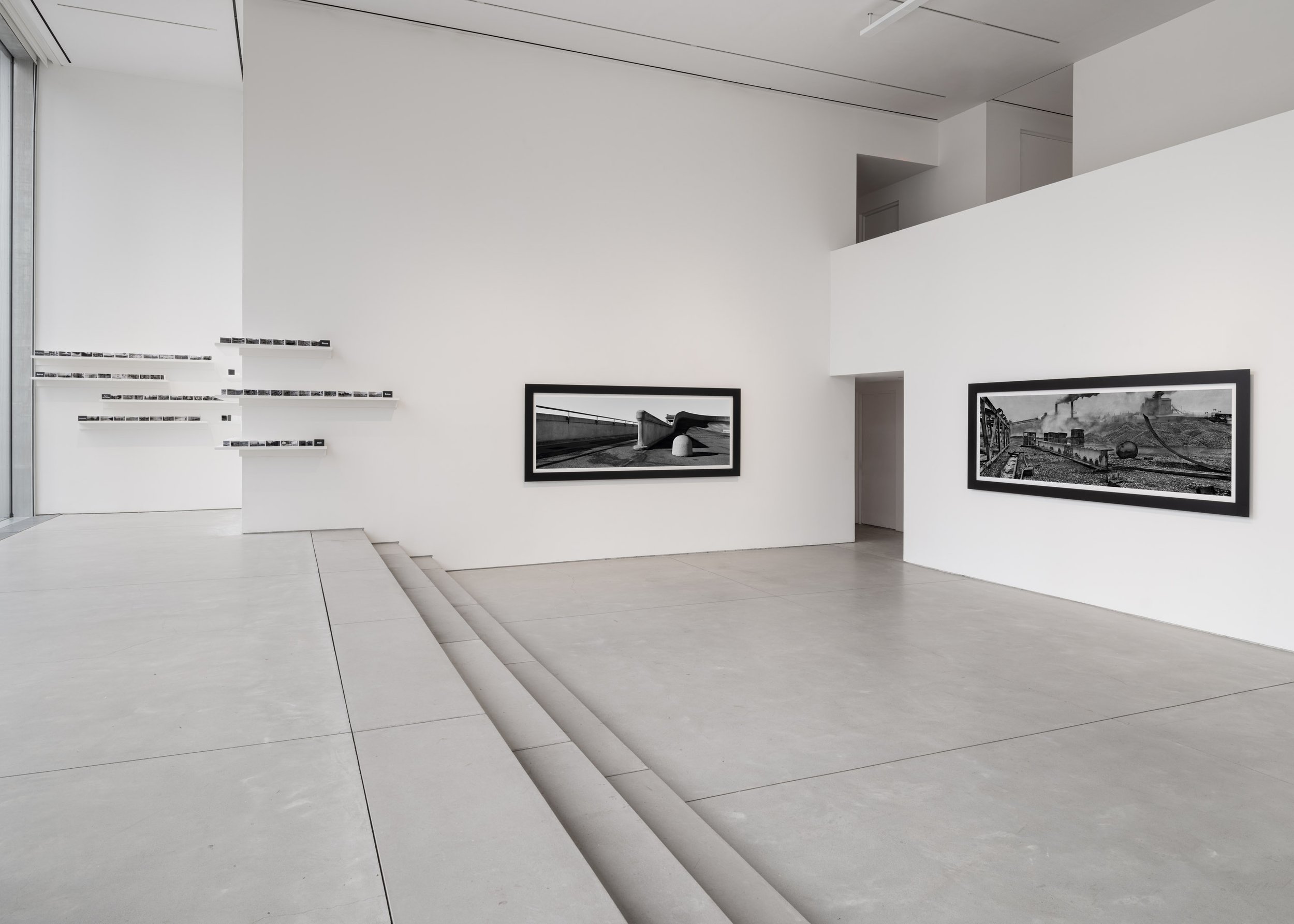
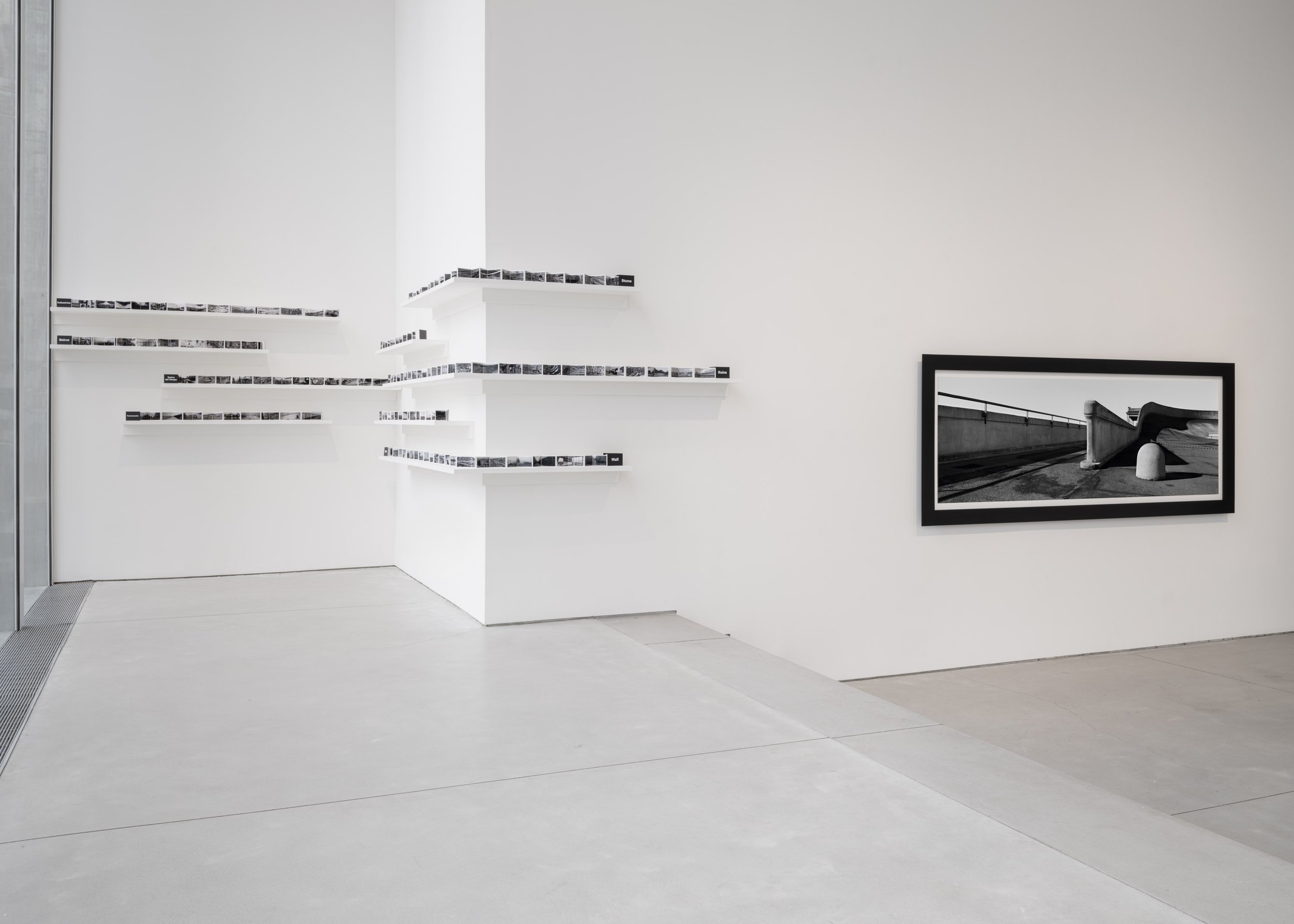
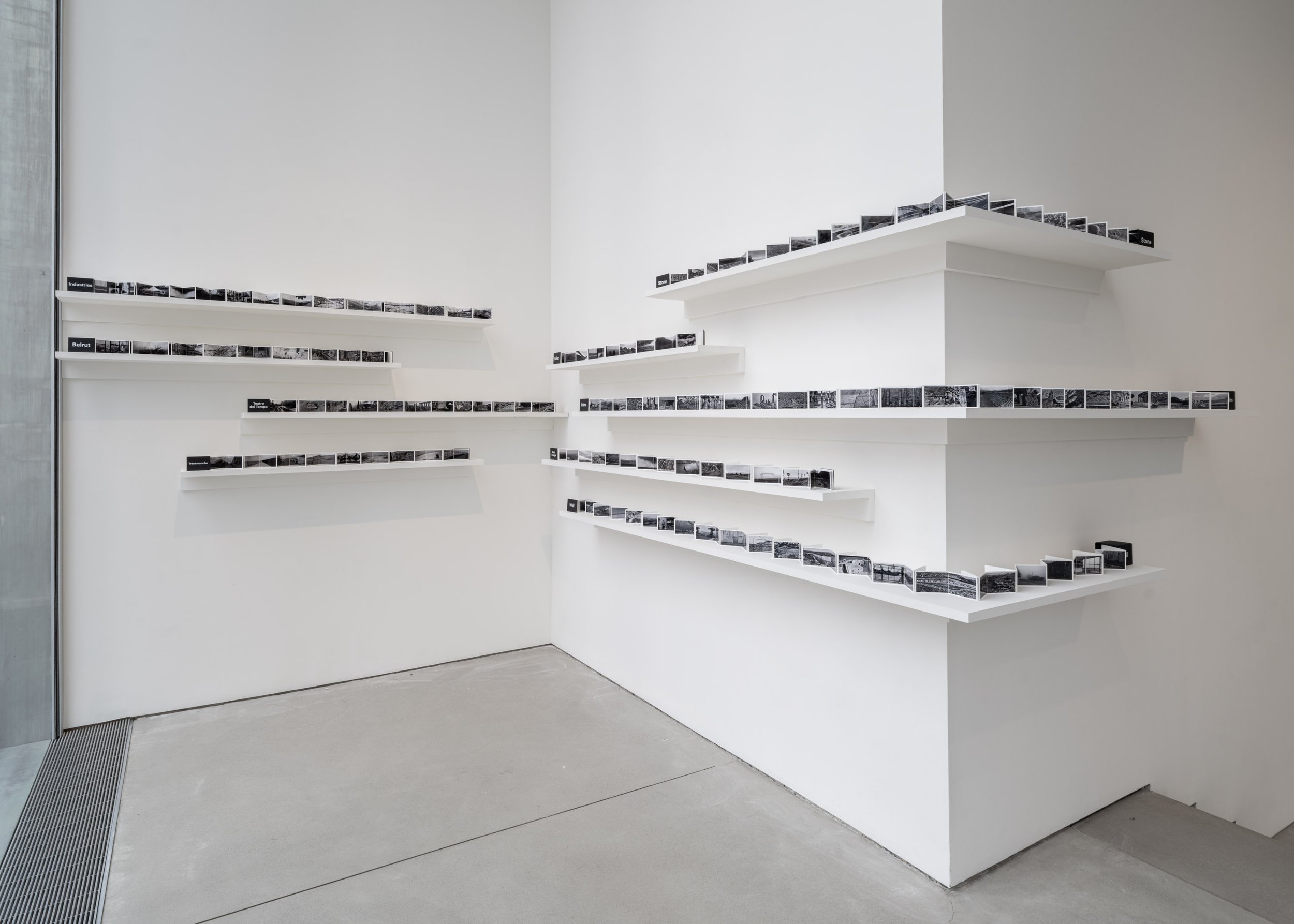
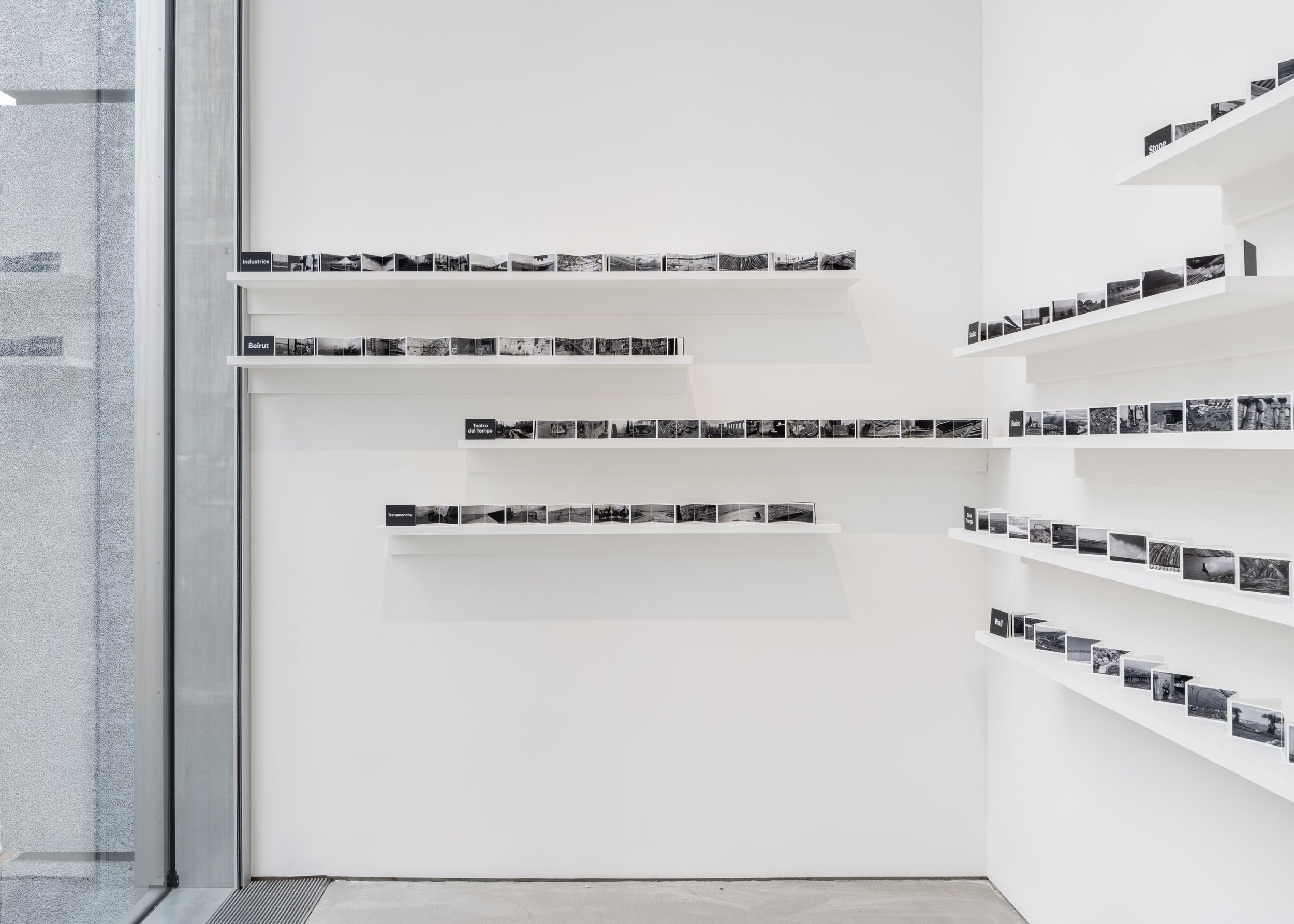


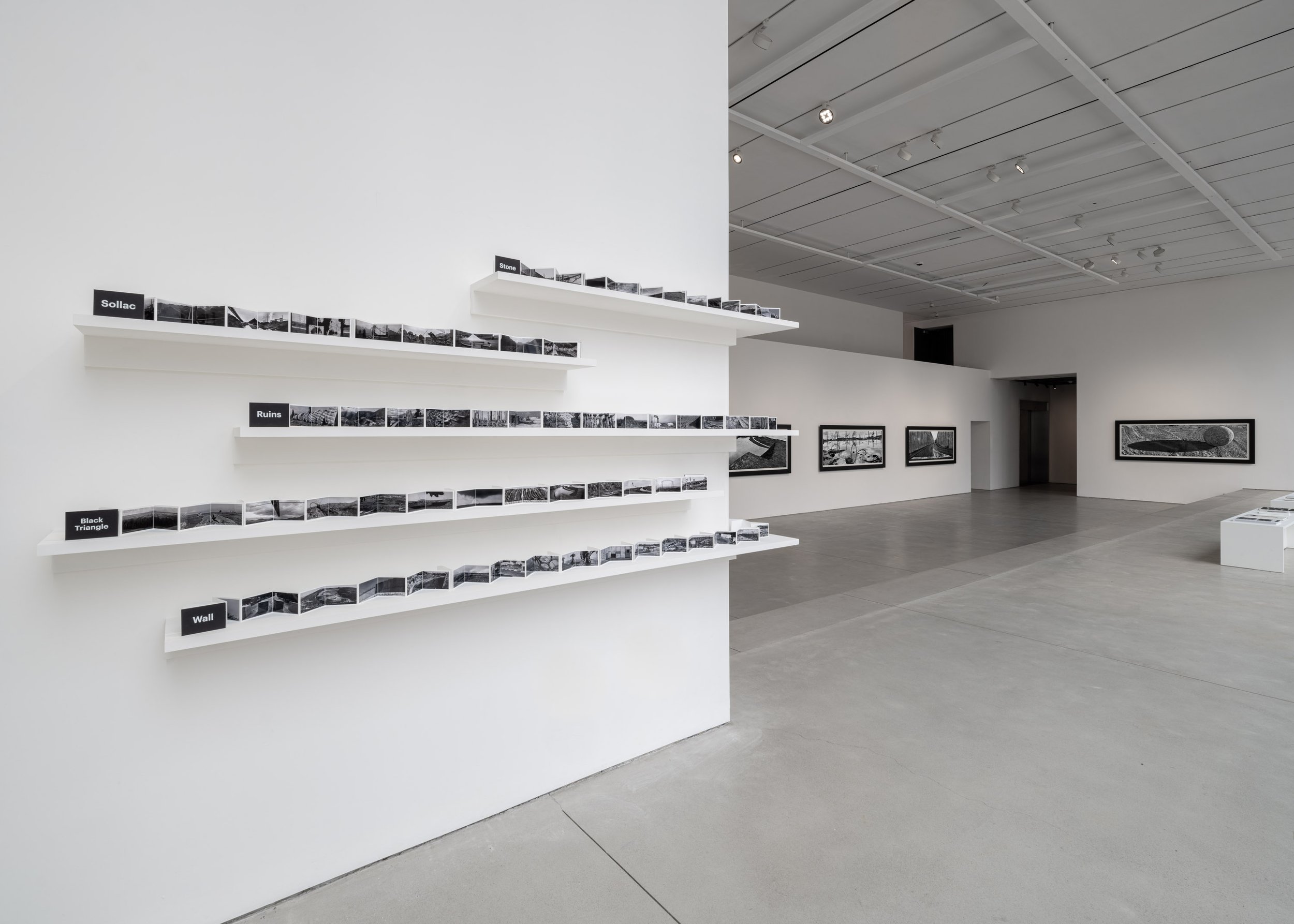

Josef Koudelka: Industry 540 West 25th Street, New York, NY 10001March 29–April 27, 2024 Photography courtesy Pace Gallery
The artist’s upcoming exhibition with Pace in New York, his first solo show in the city since 2015, will be presented on the gallery’s seventh floor against sweeping views of the Chelsea skyline. Measuring some nine feet in width, each of the six monumental panoramas that Koudelka has selected for the exhibition—captured across the United States, Germany, Italy, Azerbaijan, and Israel between 1997 and 2010—tells a different story.
Josef Koudelka (b. 1938) began his career as an aeronautical engineer in Prague and Bratislava, and began photographing stage productions for theater magazines. After documenting gypsy culture in Romania, Slovakia, and Western Europe, he committed to photography full-time in 1967. The following year, Koudelka photographed the Soviet invasion of Prague, publishing his images under the initials "P. P." (Prague Photographer) for fear of reprisal. He was anonymously awarded the Overseas Press Club's Robert Capa Gold Medal for this work in 1969. Since 1986, Koudelka has embraced and employed the expansive compositional format of the panorama. From his commissioned investigation of the French-English region impacted by the Channel Tunnel for La Mission Photographique Transmanche project, to his exploration of the political climate in Israel and Palestine, and his recent documentation of the persistence of classicism along the Mediterranean rim, Koudelka has continuously used panoramic cameras to showcase terrains that have been significantly shaped, altered, and even devastated by the effects of industry, time, and territorial conflict.
Azerbaijan, 1999inkjet print mounted to aluminum32-7/8" × 100-1/16" (83.5 cm × 254.2 cm),image36-7/8" × 104-1/16" (93.7 cm × 264.3 cm),paper and mount44-1/8" × 111-5/16" × 2-1/4" (112.1 cm × 282.7cm × 5.7 cm), frameEdition 4 of 7, Edition of 7 + 4 APsNo. 90256.04
Pace is a leading international art gallery representing some of the most influential contemporary artists and estates from the past century, holding decades-long relationships with Alexander Calder, Jean Dubuffet, Barbara Hepworth, Agnes Martin, Louise Nevelson, and Mark Rothko. Pace enjoys a unique U.S. heritage spanning East and West coasts through its early support of artists central to the Abstract Expressionist and Light and Space movements.
Since its founding by Arne Glimcher in 1960, Pace has developed a distinguished legacy as an artist-first gallery that mounts seminal historical and contemporary exhibitions. Under the current leadership of CEO Marc Glimcher, Pace continues to support its artists and share their visionary work with audiences worldwide by remaining at the forefront of innovation. Now in its seventh decade, the gallery advances its mission through a robust global program— comprising exhibitions, artist projects, public installations, institutional collaborations, performances, and interdisciplinary projects. Pace has a legacy in art bookmaking and has published over five hundred titles in close collaboration with artists, with a focus on original scholarship and on introducing new voices to the art historical canon.
Today, Pace has seven locations worldwide, including European footholds in London and Geneva as well as Berlin, where the gallery established an office in 2023. Pace maintains two galleries in New York—its headquarters at 540 West 25th Street, which welcomed almost 120,000 visitors and programmed 20 shows in its first six months, and an adjacent 8,000 sq. ft. exhibition space at 510 West 25th Street. Pace’s long and pioneering history in California includes a gallery in Palo Alto, which was open from 2016 to 2022. Pace’s engagement with Silicon Valley’s technology industry has had a lasting impact on the gallery at a global level, accelerating its initiatives connecting art and technology as well as its work with experiential artists. Pace consolidated its West Coast activity through its flagship in Los Angeles, which opened in 2022. Pace was one of the first international galleries to establish outposts in Asia, where it operates permanent gallery spaces in Hong Kong and Seoul, along with an office and viewing room in Beijing. In spring 2024, Pace will open its first gallery space in Japan in Tokyo’s new Azabudai Hills development.
For more information about this exhibition and others, please visit the Pace Gallery’s website here. Pace Gallery can be found on Instagram and Artsy, too.
Thomas Nozkowski : Everything in the World
Thomas Nozkowski: Everything in the World540 West 25th Street, New York, NY 10001March 8–April20, 2024 Photography courtesy Pace Gallery
New York – Pace is pleased to present an exhibition of works by Thomas Nozkowski at its 540 West 25th Street gallery in New York which opened on March 8 and will be on view until April 20. Focusing on the artist’s practice during the 1970s and 1980s, this presentation, titled Thomas Nozkowski: Everything in the World, will include the artist’s signature, intimatelyF scaled 16” x 20” canvas compositions alongside several large-scale paintings that have not been publicly exhibited in decades and three painted wood sculptures. The show will be accompanied by a new catalogue produced by Pace Publishing, featuring a new essay by Martin Clark, director of the Camden Art Centre in London.
Untitled (6-36), 1987 PAINTING oil on linen on panel 16" × 20" (40.6 cm × 50.8 cm) 17" × 21" × 1-1/2" (43.2 cm × 53.3 cm × 3.8 cm), framed No. 89583 © Thomas Nozkowski, courtesy Pace Gallery
Over more than four decades, Nozkowski developed a singular approach to painting that rejected established aesthetic conventions.The artist, who died in 2019 at age 75, is known for his richly colored and textured abstractions inspired by his memories, everyday experiences, and encounters in the landscapes surrounding his longtime home in upstate New York. In this way, he developed a distinctive visual language of forms, symbols, and notations grounded in his own reality while defying obvious legibility. Constellations of biomorphic and geometric abstractions become worlds unto themselves, which Nozkowski forged as part of a lengthy and exacting process.
Untitled (4-120), 1986 PAINTING oil on linen on panel 16" × 20" (40.6 cm × 50.8 cm) 17" × 21" × 1-1/2" (43.2 cm × 53.3 cm × 3.8 cm), framed No. 89579© Thomas Nozkowski, courtesy Pace Gallery
In this exhibition of his work, it centers on a hugely formative period of the artist’s career during which he set out specific aesthetic terms for his practice. The show’s title, Everything in the World, brings the relationship between Nozkowski’s abstractions and his daily observations to the fore. Anything and everything in his environment—an object, a surface, a quality of light—could capture his curiosity and attention, becoming the source material for a painting.
Untitled (4-14), 1982 PAINTING oil on linen on panel 16" × 20" (40.6 cm × 50.8 cm) No. 89575 © Thomas Nozkowski, courtesy Pace Gallery
Breaking away from the aesthetics of Minimalism and Abstract Expressionism, the artist embarked on an intensely experimental journey, raising formal and conceptual questions about the expressive potential of abstraction that he would continue revisiting in the decades to come—and that would define his approach for the rest of his life. The 1970s and 1980s also saw major changes in Nozkowski’s personal life, including the birth of his son and the purchase of his first property in New York’s Hudson Valley—a place that would become an enduring inspiration for his work.
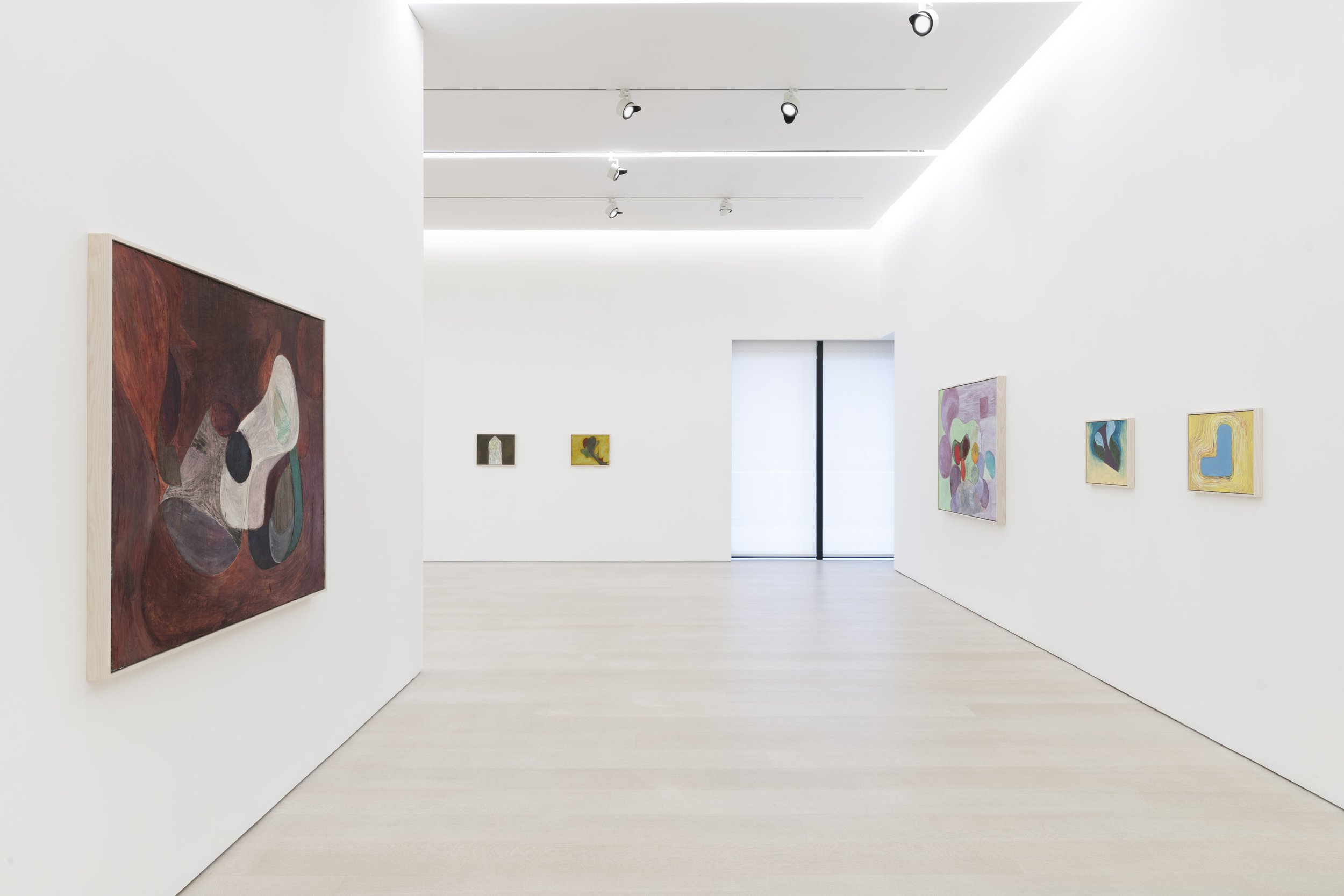
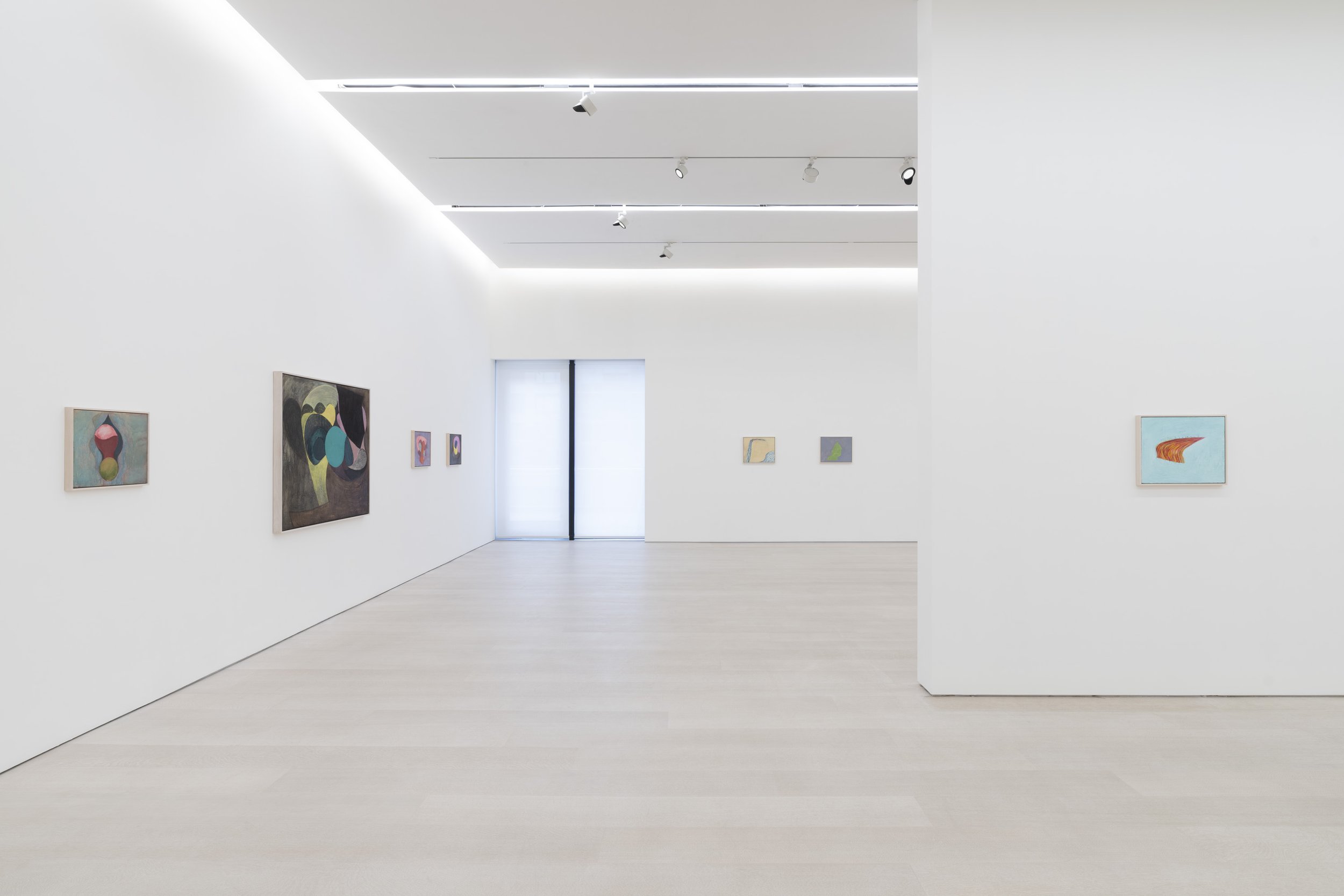

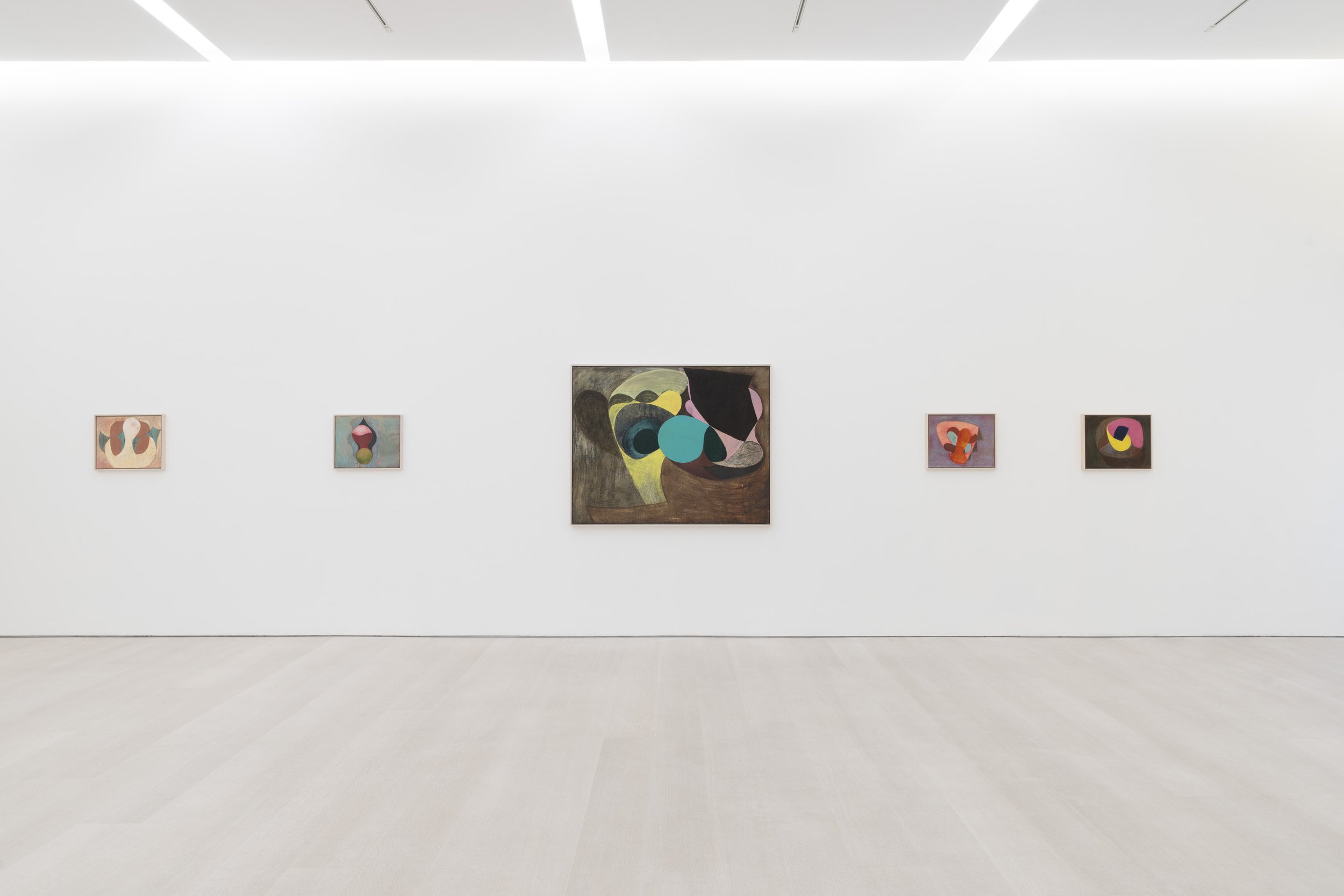
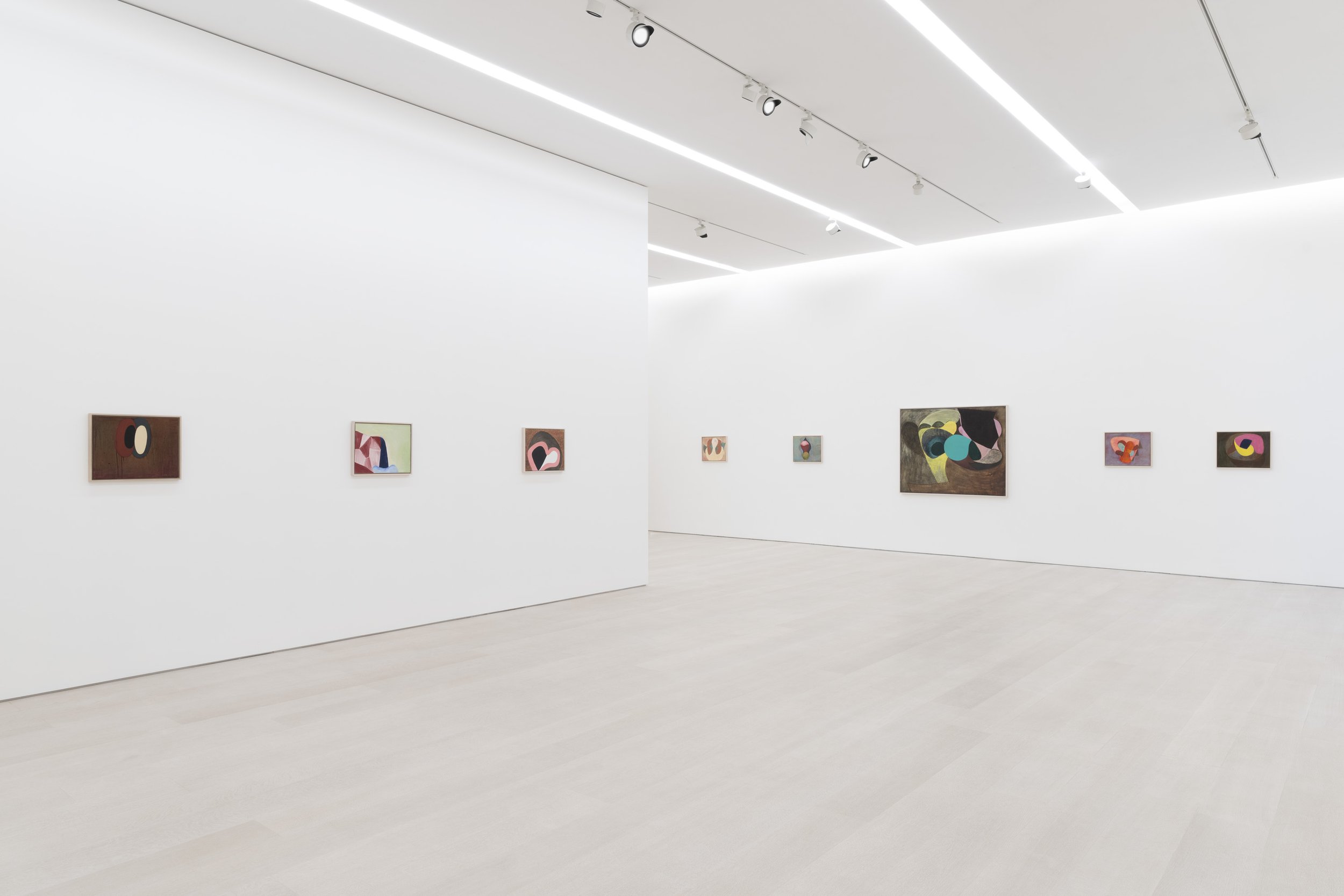
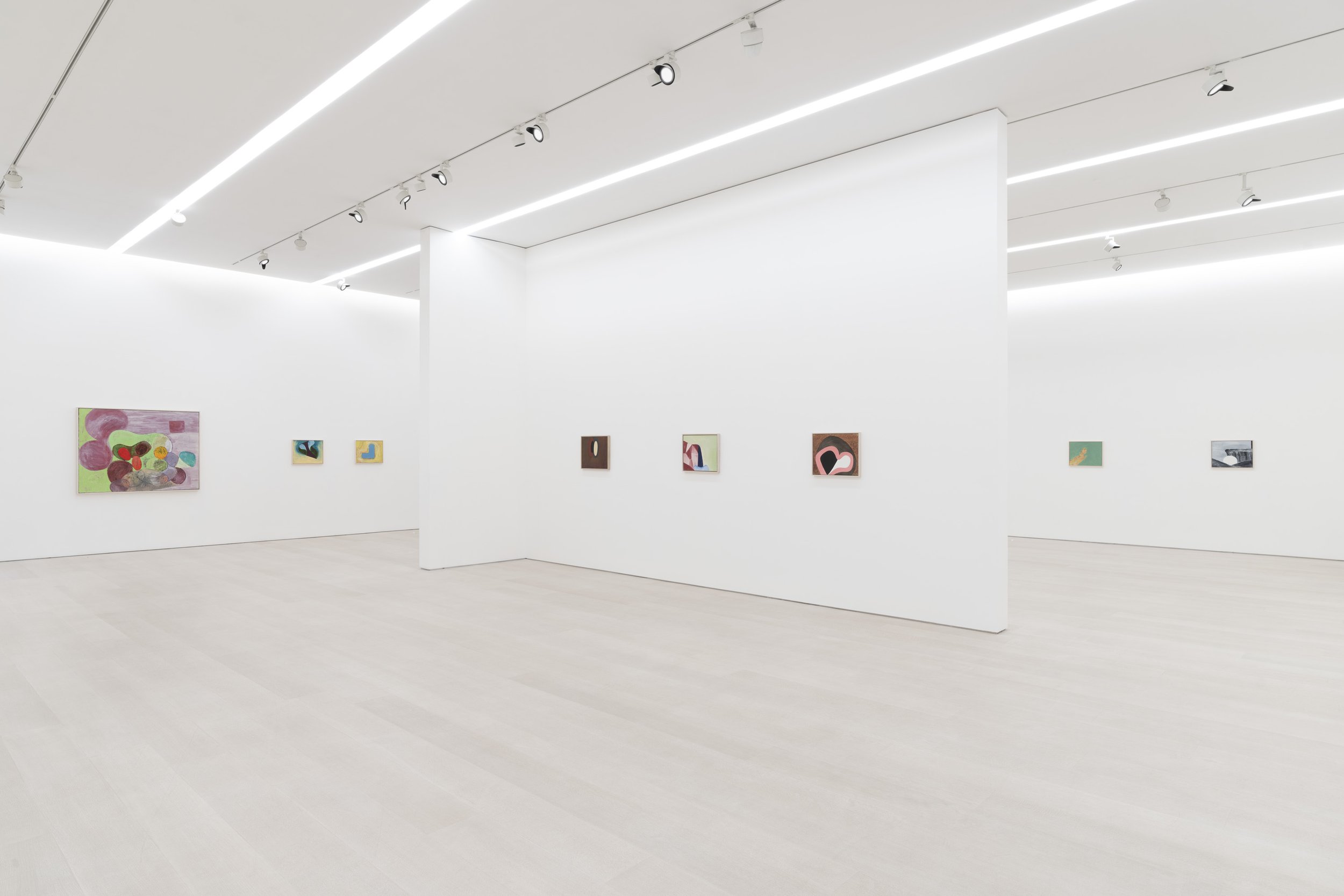
Thomas Nozkowski: Everything in the World 540 West 25th Street, New York, NY 10001March 8–April 20, 2024 Photography courtesy Pace Gallery
The artist made fewer than ten large-scale canvases in his life, and four of these rare works will be exhibited with more than 20 of his classic, small-scale paintings in Pace’s forthcoming show in New York. Three of Nozkowski’s idiosyncratic, conical, painted wood sculptures from 1979 will also figure in the presentation—these objects reflect his interest in the material presence and physicality of paint in its encounters with different surfaces. Together, these works speak to the exploratory ethos that guided Nozkowski over the course of two decades. For immediate release Arriving in New York after the first wave of Abstract Expressionism and during the rise of Pop Art and Minimalism,
Untitled (2-94), 1975 PAINTING oil on linen on panel 16" × 20" (40.6 cm × 50.8 cm) 17" × 21" × 1-1/2" (43.2 cm × 53.3 cm × 3.8 cm) No. 89571© Thomas Nozkowski, courtesy Pace Gallery
Thomas Nozkowski (b. 1944, Teaneck, New Jersey; d. 2019, New York) completed his undergraduate degree in 1967 at Cooper Union. He defied the dismissal of painting at the time, embracing the medium and dedicating himself to an inventive and focused body of work attuned to his subjective experience of the world. His prolific oeuvre reveals an ability to shift between various media, ranging from ballpoint pen and pencil to gouache and oils. Eschewing large-scale formats and resistant to established styles or recurrent motifs, Nozkowski developed a varied and influential artistic practice.
Untitled (2-59), 1979 PAINTING oil paint on canvas board 16" × 20" (40.6 cm × 50.8 cm) 17" × 21" × 1-1/2" (43.2 cm × 53.3 cm × 3.8 cm), framed No. 64470 © Thomas Nozkowski, courtesy Pace Gallery
Pace is a leading international art gallery representing some of the most influential contemporary artists and estates from the past century, holding decades-long relationships with Alexander Calder, Jean Dubuffet, Barbara Hepworth, Agnes Martin, Louise Nevelson, and Mark Rothko. Pace enjoys a unique U.S. heritage spanning East and West coasts through its early support of artists central to the Abstract Expressionist and Light and Space movements.
Since its founding by Arne Glimcher in 1960, Pace has developed a distinguished legacy as an artist-first gallery that mounts seminal historical and contemporary exhibitions. Under the current leadership of CEO Marc Glimcher, Pace continues to support its artists and share their visionary work with audiences worldwide by remaining at the forefront of innovation. Now in its seventh decade, the gallery advances its mission through a robust global program— comprising exhibitions, artist projects, public installations, institutional collaborations, performances, and interdisciplinary projects. Pace has a legacy in art bookmaking and has published over five hundred titles in close collaboration with artists, with a focus on original scholarship and on introducing new voices to the art historical canon.
Today, Pace has seven locations worldwide, including European footholds in London and Geneva as well as Berlin, where the gallery established an office in 2023. Pace maintains two galleries in New York—its headquarters at 540 West 25th Street, which welcomed almost 120,000 visitors and programmed 20 shows in its first six months, and an adjacent 8,000 sq. ft. exhibition space at 510 West 25th Street. Pace’s long and pioneering history in California includes a gallery in Palo Alto, which was open from 2016 to 2022. Pace’s engagement with Silicon Valley’s technology industry has had a lasting impact on the gallery at a global level, accelerating its initiatives connecting art and technology as well as its work with experiential artists. Pace consolidated its West Coast activity through its flagship in Los Angeles, which opened in 2022. Pace was one of the first international galleries to establish outposts in Asia, where it operates permanent gallery spaces in Hong Kong and Seoul, along with an office and viewing room in Beijing. In spring 2024, Pace will open its first gallery space in Japan in Tokyo’s new Azabudai Hills development.
For more information about this exhibition and others, please visit the Pace Gallery’s website here. Pace Gallery can be found on Instagram and Artsy, too.
Delcy Morelos and Ettore Spalletti
Installation view: Delcy Morelos, Ettore Spalletti, “Esa Esquina Soy Yo”, Marian Goodman Gallery, New York, 2023 Courtesy of Delcy Morelos and Marian Goodman Gallery Photo credit: Alex Yudzon
Marian Goodman Gallery in New York is pleased to announce the upcoming exhibition by Delcy Morelos and Ettore Spalletti, which opened Wednesday, March 13, and will be on view through 20 April 2024. The exhibition's opening reception was held on Wednesday, 13 March, from 6 to 8 p.m.
Esa esquina soy yo will present works that span three decades and offer a dialogue between these two artists. The exhibition highlights distinct practices and processes, traversing past and present, bringing to light dual influences and trajectories, from Andean cosmology to explorations of color, geometries and relationship with space. In this exhibition we see their dynamic activation and a sublime transcendence.
In his work, where painting and sculpture merge together, Ettore Spalletti (1940-2019) offers a dialogue between classicism and contemporaneity. In his search for an essential dimension and a new idea of spatiality, there is a constant dialogue with the art of the past and, in particular, with the masters of Italian Renaissance art, from Piero della Francesca to Raffaello. His language eliminates all forms of rhetoric, recovering geometries and archetypal forms according to concepts that clearly distinguish him from Minimal Art.
Installation view: Delcy Morelos, Ettore Spalletti, “Esa Esquina Soy Yo”, Marian Goodman Gallery, New York, 2023 Courtesy of Fondazione Ettore Spalletti; Delcy Morelos and Marian Goodman Gallery Photo credit: Alex Yudzon
Fundamental to his poetics are the transformation of materials (alabaster, onyx, marble) and, above all, the definition of a particular painting technique. The painted surfaces, obtained through multiple layers of color impasto repeated over several days at the same time, following the final abrasion, are characterized by the presence of a certain amount of white pigment that, as it breaks, becomes a source of light. The light that comes from within the work intertwines itself with the variations of natural light that add color to color. Far from being absolutely monochrome, Spalletti’s painted surfaces offer a texture which gives breath to the image.
Color in Spalletti’s works always reveals a depth, just as in the words of Paul Valéry -"Ce qu'il y a de plus profond dans l'homme, c'est la peau”- with which the artist titled his solo exhibition at Galerie Marian Goodman in Paris in 2018. Contrary to contemporary trends, Spalletti spent his life in his native places, loving to call his studio home.
Ettore Spalletti Senza titolo, (grigio chiaro), 2019 Color impasto on board, tapered frame on 4 sides, gold leaf Courtesy of Fondazione Ettore Spalletti and Marian Goodman Gallery Photo credit: Alex Yudzon
Delcy Morelos' indigenous traditions inform her memories of her homeland and its hierarchies of skin, race, land and violence. Invoking a bodily materiality in her layers of paint poured and slowly applied to textile or fabric supports, the artist lets the paint drip, pool and solidify, creating vast pictorial fields that move away from the picture plane and extend to ceramics, textiles and large-scale immersive installations. Her evocative treatment of color suggests both the body and the earth, revealing what is most sacred to the artist and drawing a connection between the body and violence. Morelos' chromatic exploration of the color red, for example, especially in her early works, implies blood and matrilineal force. Taking cues from Andean ancestral traditions, Morelos favors textiles and fabrics and natural materials such as plant and mineral fibers, earth, clay, and soil. Conceiving of a fictional and primordial cosmos, her experiential artworks are made for the human senses and create “an alchemy that awakens different emotions in each person.”
Ettore Spalletti Carte rosa, 1998 Color impasto on panel, painted front and back Courtesy of Fondazione Ettore Spalletti and Marian Goodman Gallery Photo credit: Alex Yudzon
Spalletti's pink diptych, Carte rosa, 1998, is the anchor of the North Gallery space, in dialogue with Morelos' series, Eva, from 2013. The work is made with an impasto of color painted on the front and back of two slender wooden paper panels that move in response to atmospheric shifts. The color pink is, as the artist tells it, the color of the human skin "which never has a fixity of its own but is continually transformed through the mood we experience." Next to these, Morelos' work, Eva, 2013, extends into three-dimensional space and volumetric form. A fabric structure, suspended in space, stands across from of a series of works, Eva. 1-10, 2013. Objectively geometric, they are made with clay, brick dust and binder on cotton weave, with earth tones that recall soil and color, life and the female body. As Morelos said, the earth contains in its womb the very cycles of life, death and rebirth, and is a feminine deity.
Delcy Morelos Eva, 2013 Clay, brick dust, and acrylic binder on cotton weave Courtesy of Delcy Morelos and Marian Goodman Gallery Photo credit: Alex Yudzon
In the North Gallery Viewing Room, a series of works by Morelos made with thick layers of acrylic on cotton thread, titled The Double Negation (La doble negación), 2008, bring the minimalist grid closer to the dense tactility of paint droplets, which serve to structure the surfaces of the lattice works. In the center of the room is Spalletti's Colonna, portacipria, 2016: a circular form of pink onyx, concealing within it a powder of the same color, rests on a white marble column, a form dear to Spalletti, which has spanned the entire history of art and architecture.
In the South Gallery is Senza titolo, azzurro, 1990, with its three-sided bull frame. Light blue for Spalletti, as the artist put it, is "an atmospheric color, in which we are continually immersed, it is the color of the sky [...] ours is a sky of meditation, when you take a walk by the sea towards evening the line of the horizon is no longer visible, the sea joins the sky. You feel that space never ends, there is no image, but if you try to pierce the blue with a finger, what do you find? You are in contemplative reality. I think of Beato Angelico." Mobile, 1994, a sculpture painted in a different shade of pink than the Carte rosa in the North Gallery space, offers an example of Spalletti's research into the relationship between sculpture and spatiality. The three-dimensional volume, placed in mid-air, seems to come out the wall and interacts with Senza titolo (grigio chiaro), 2019, whose profile is animated by a girandola frame on the four sides characterized by the use of gold leaf.
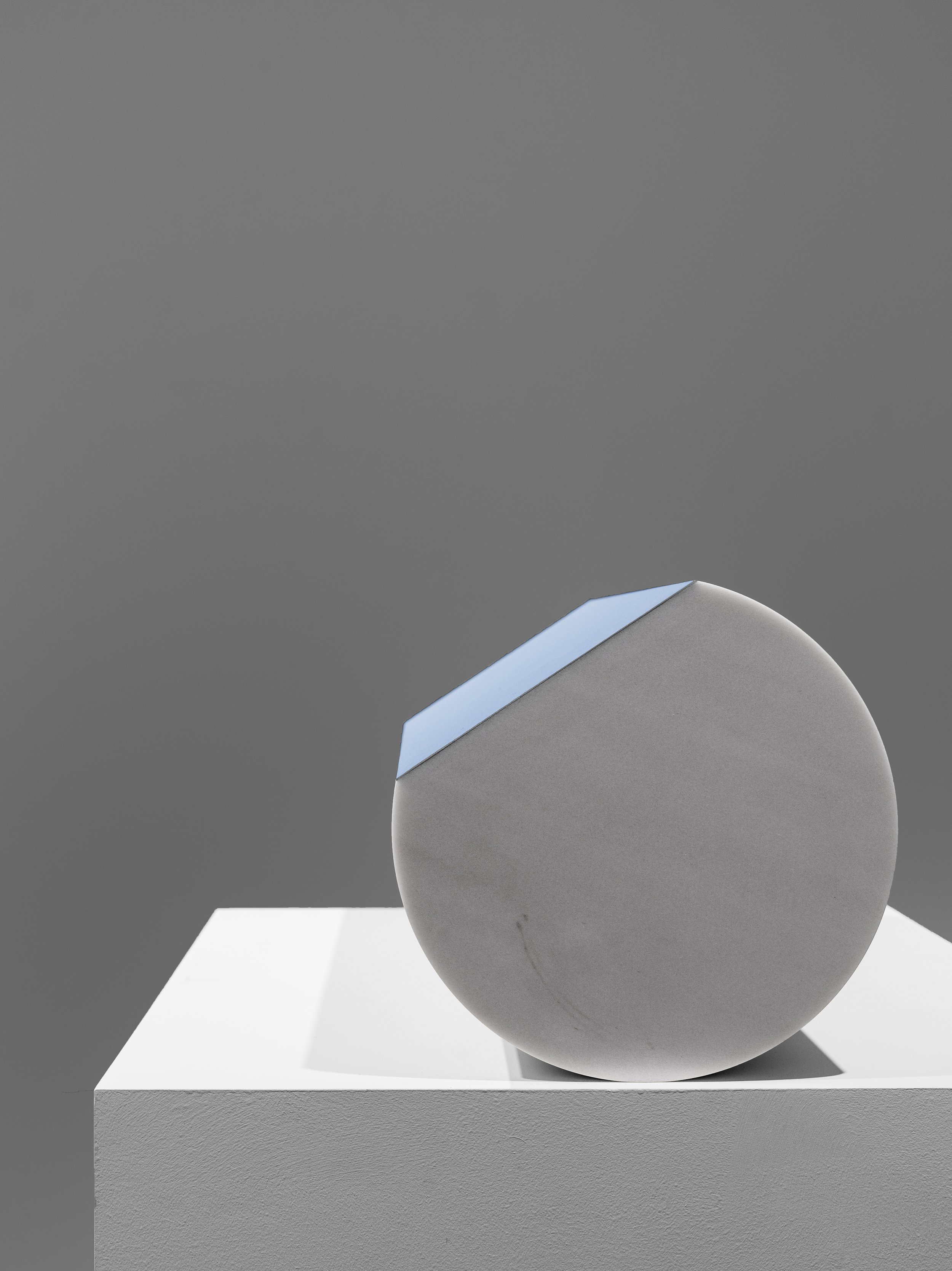
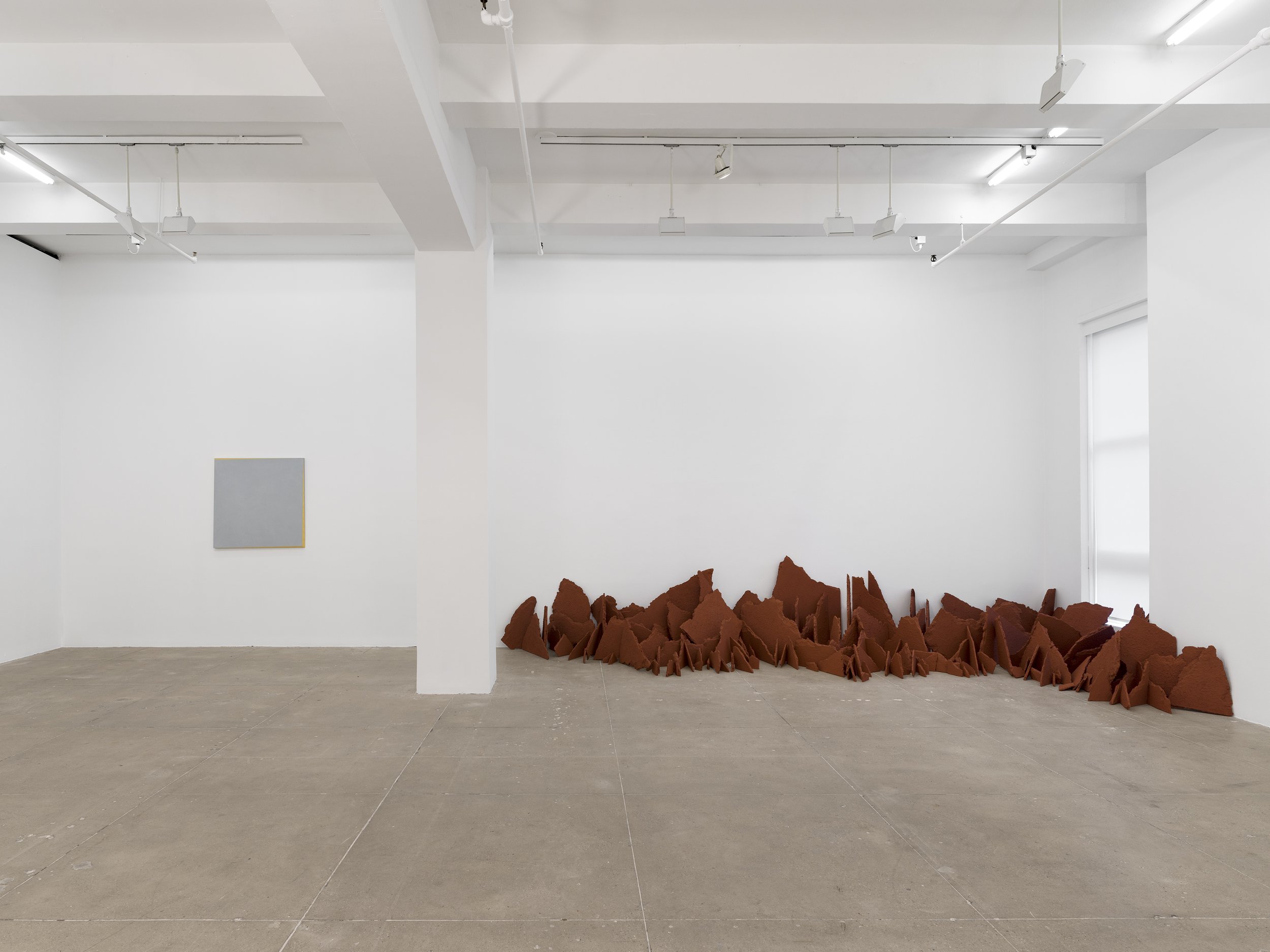
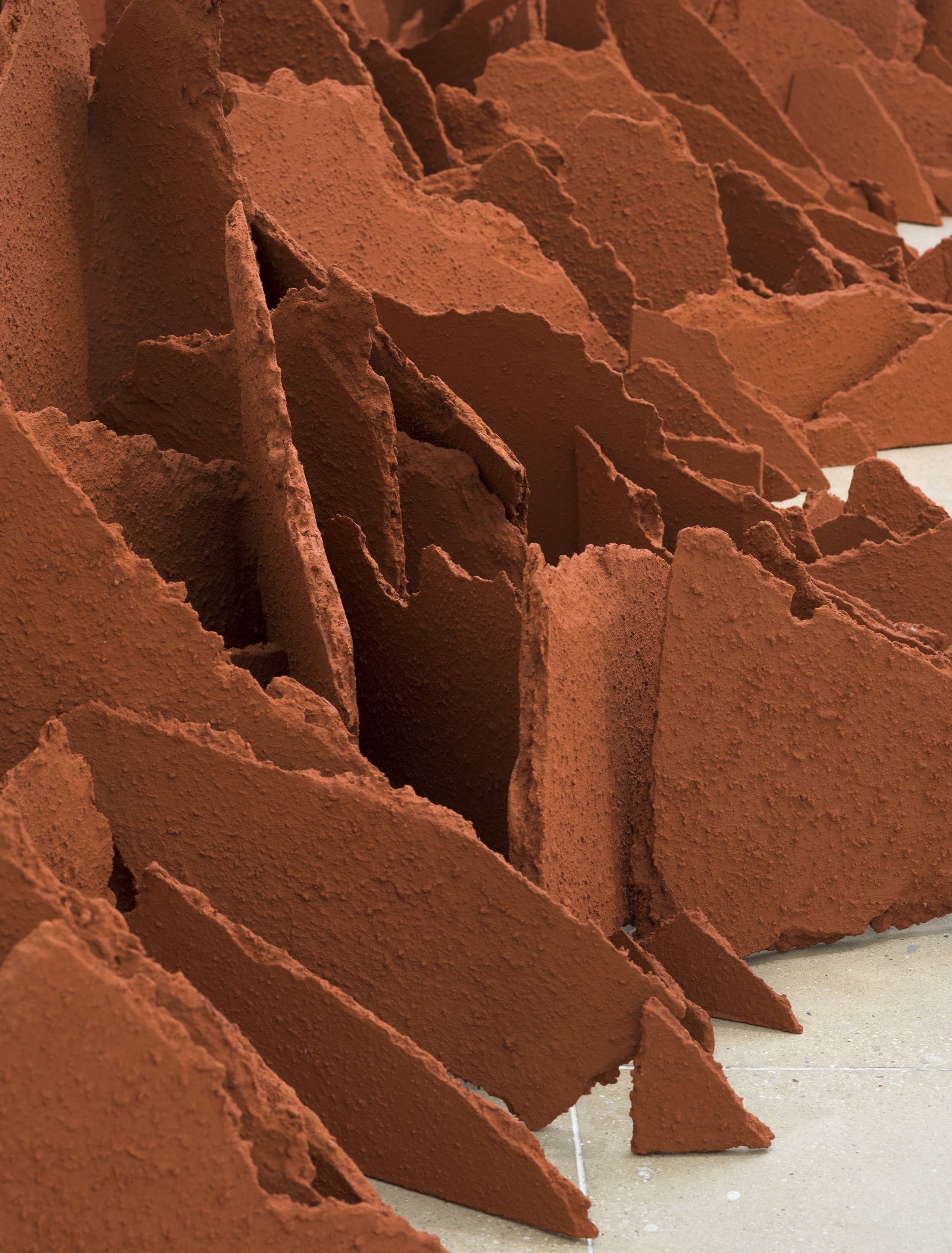

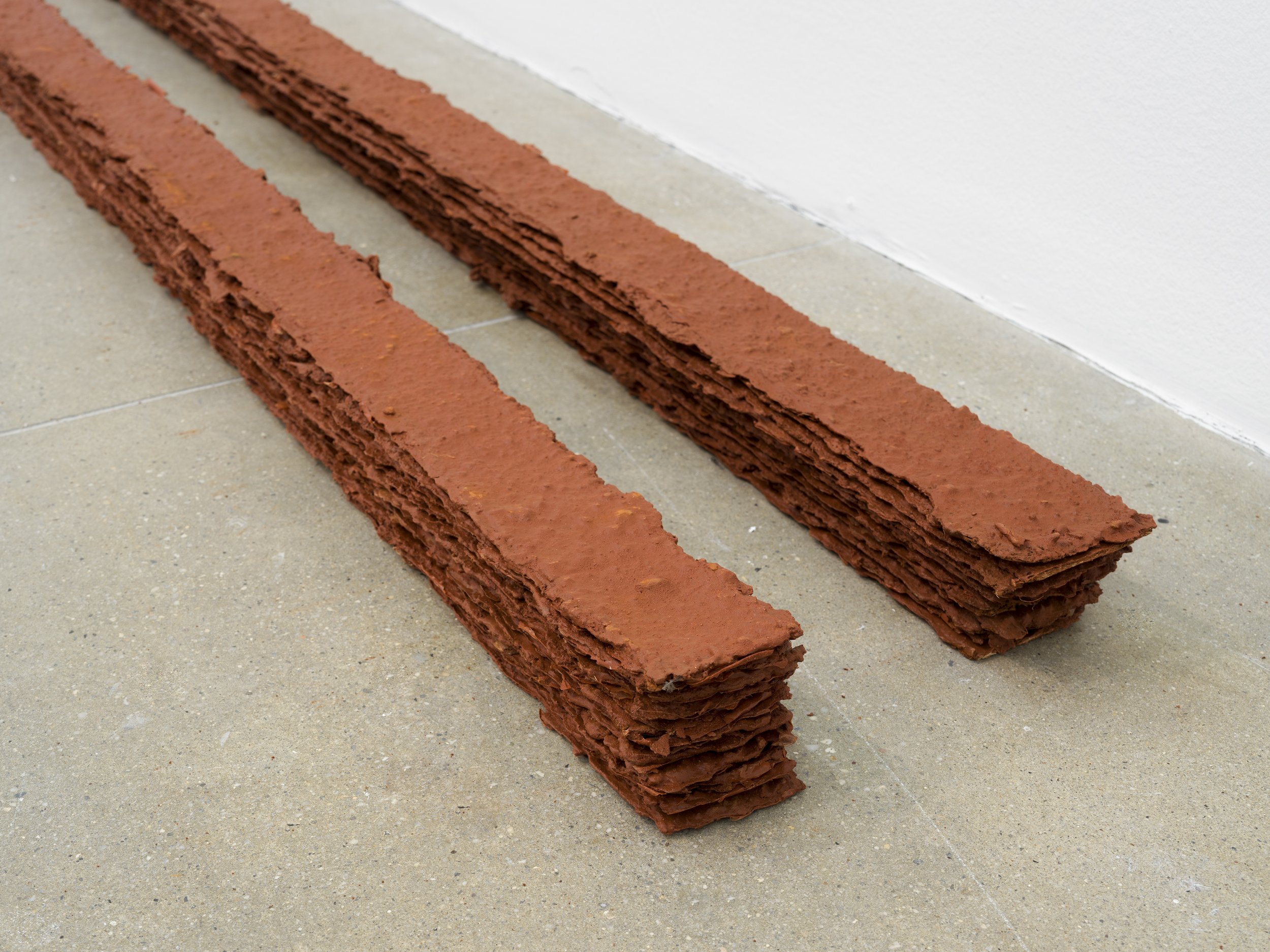
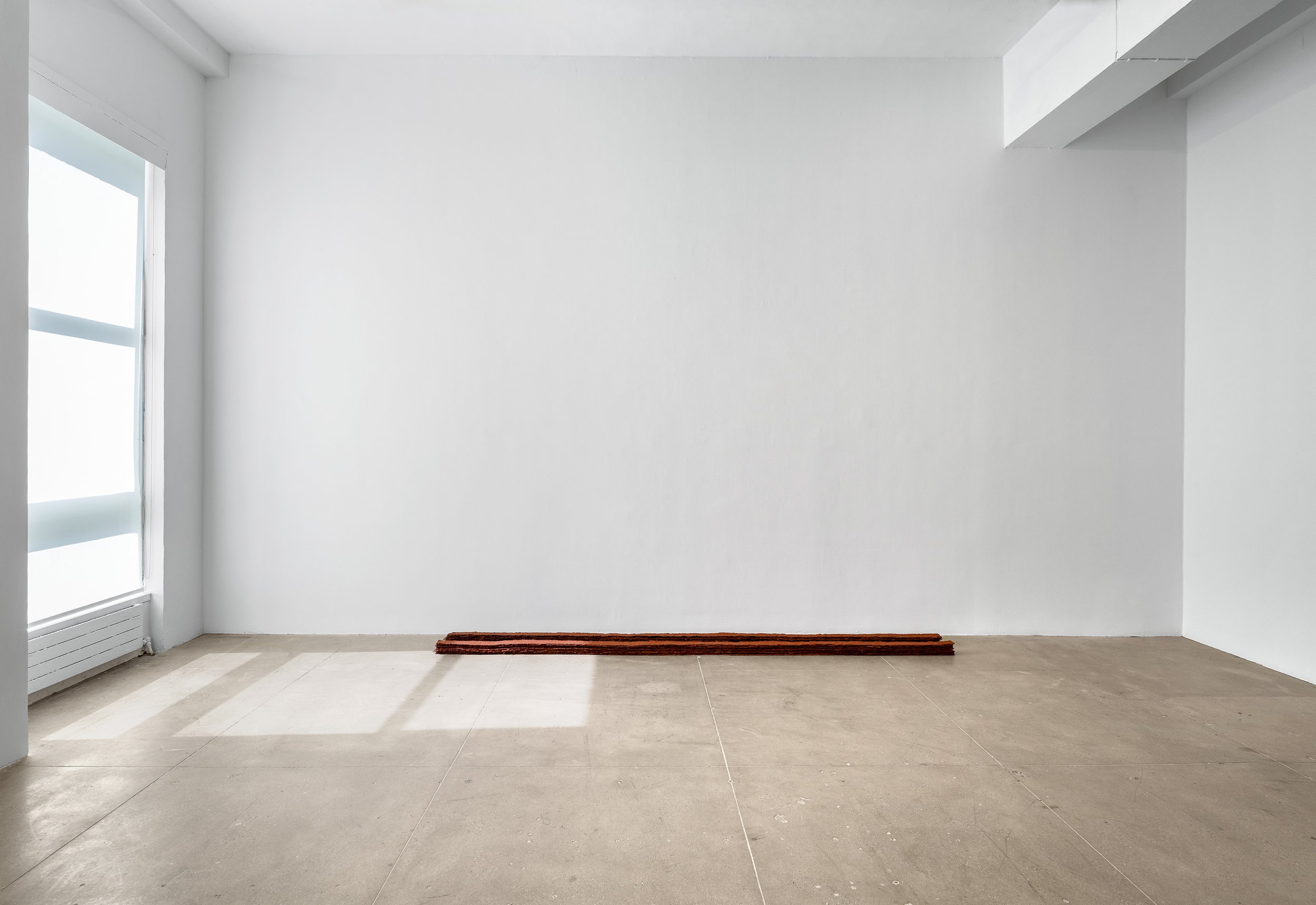

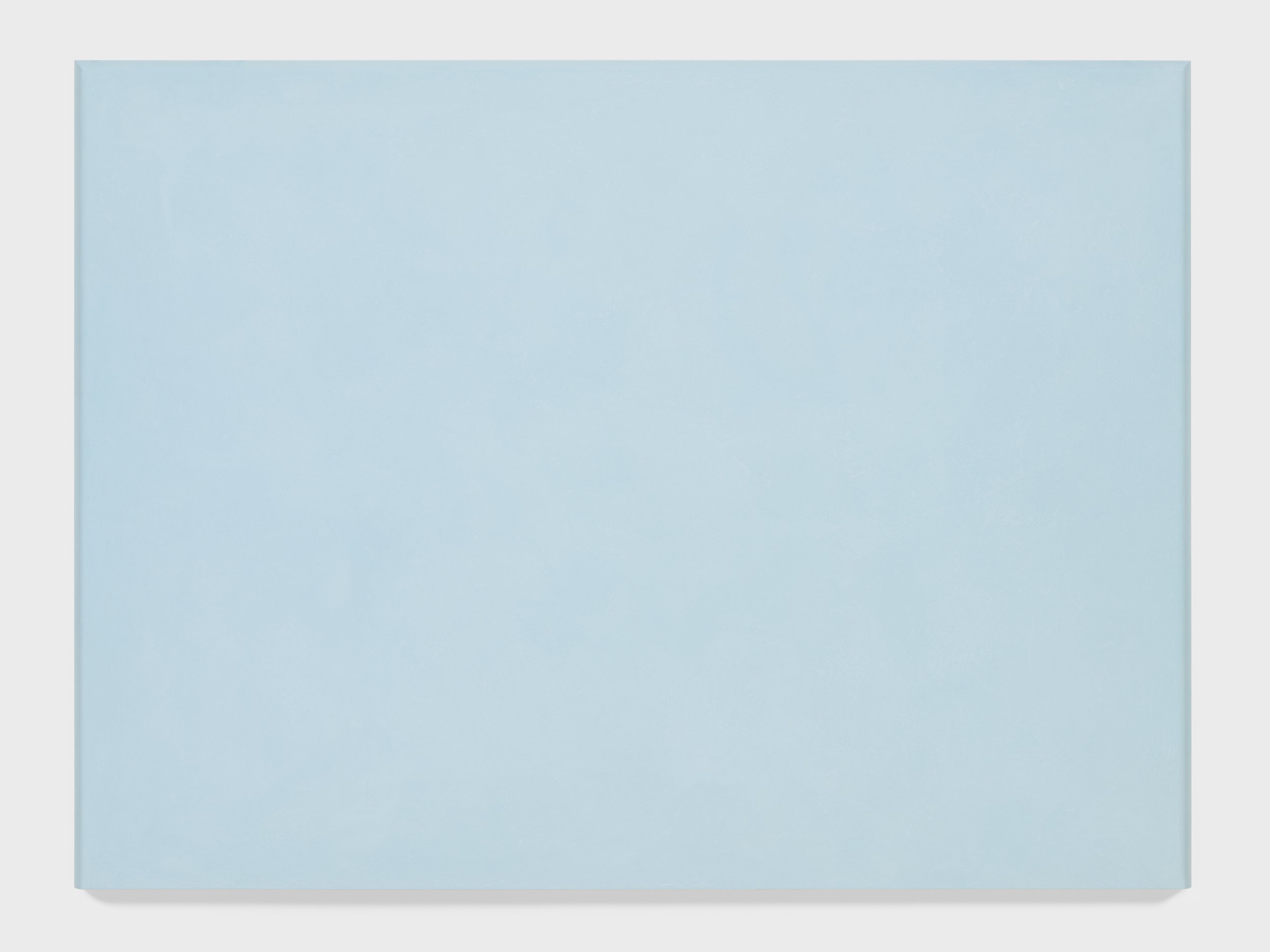
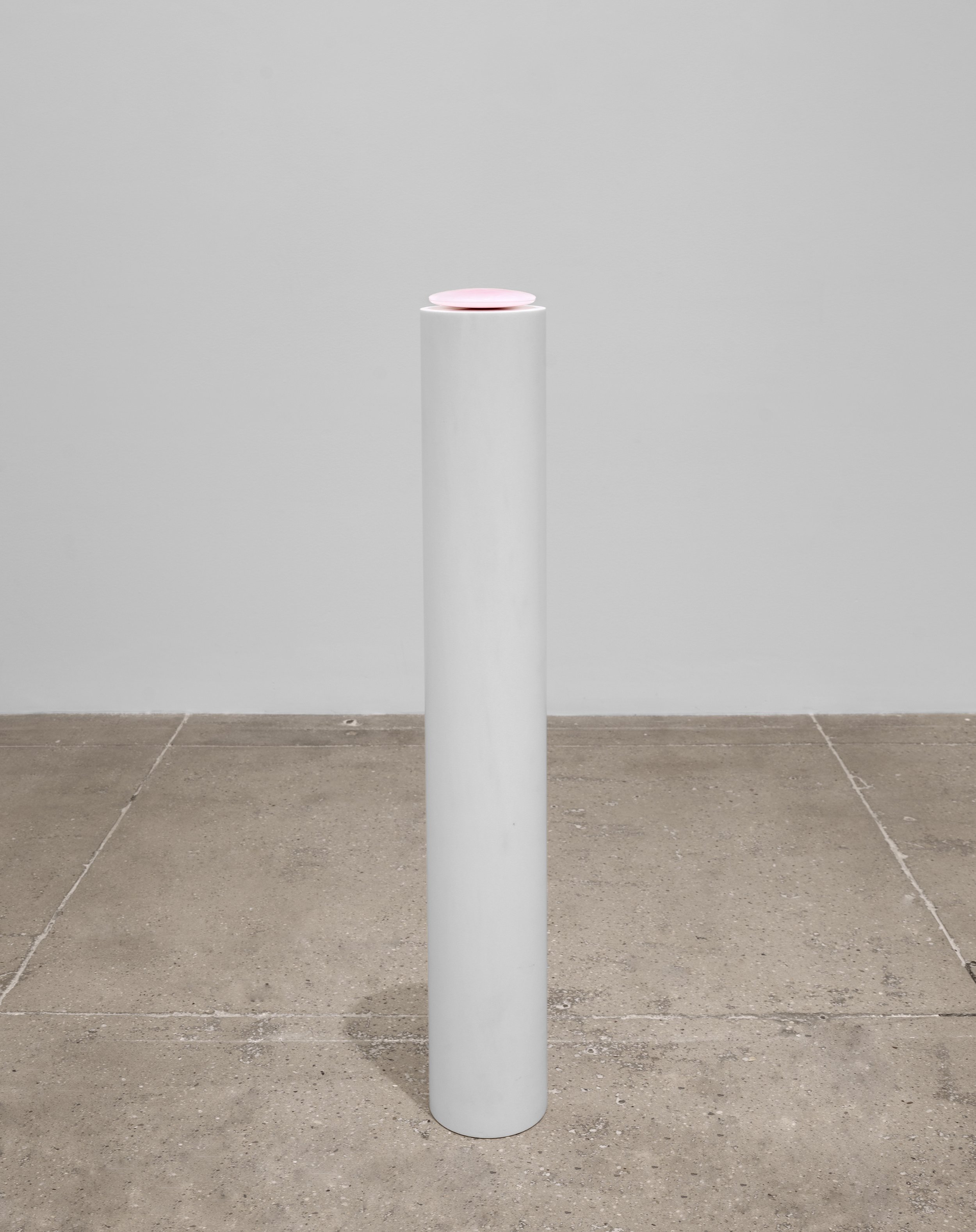
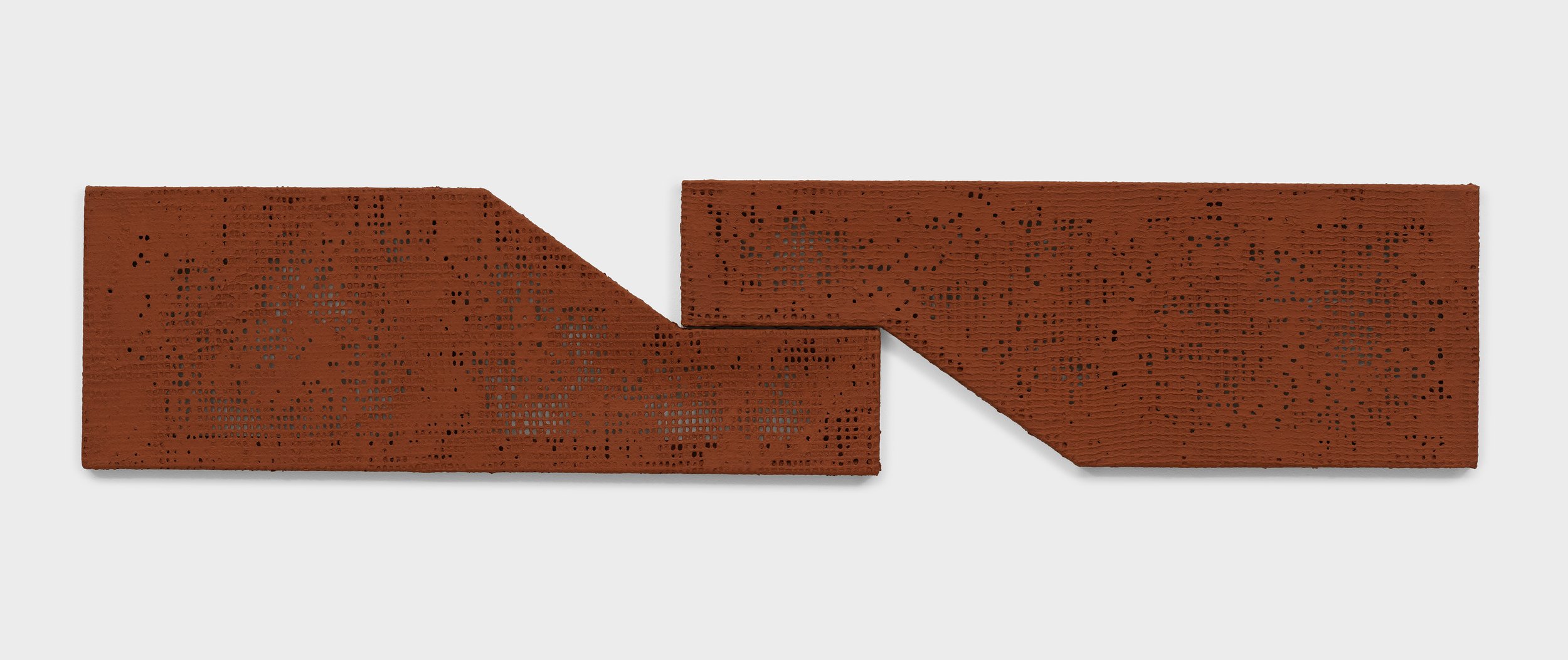
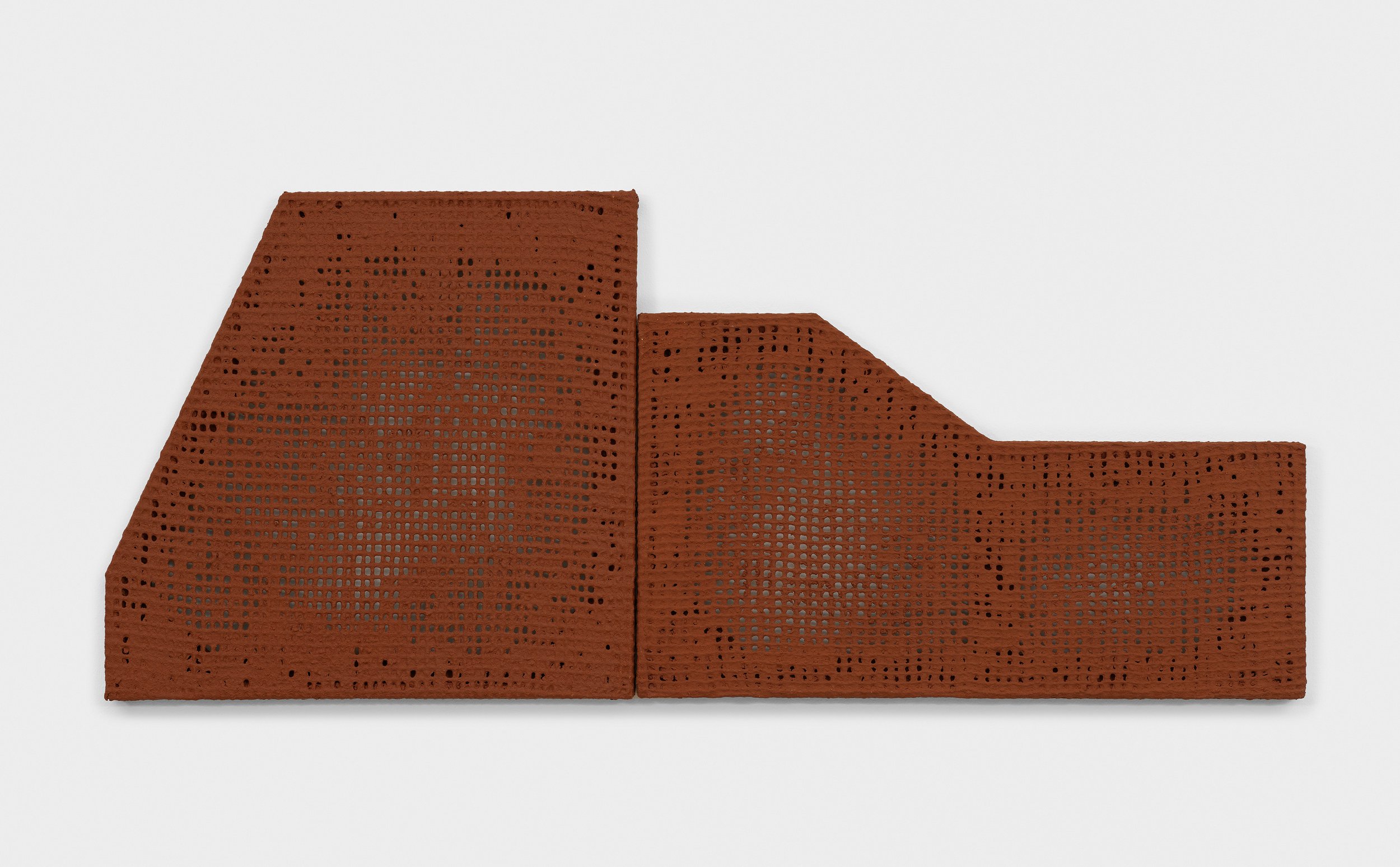
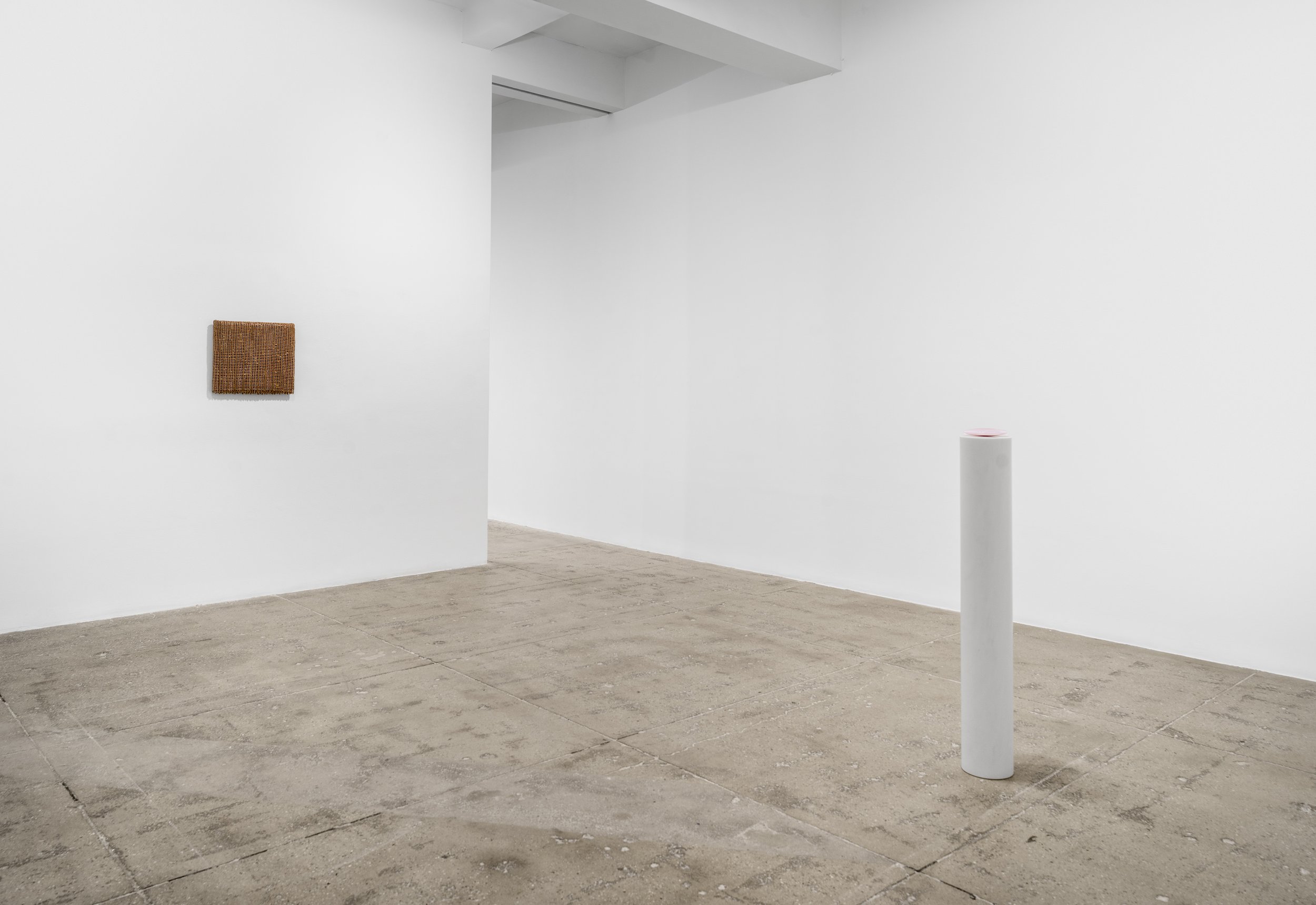
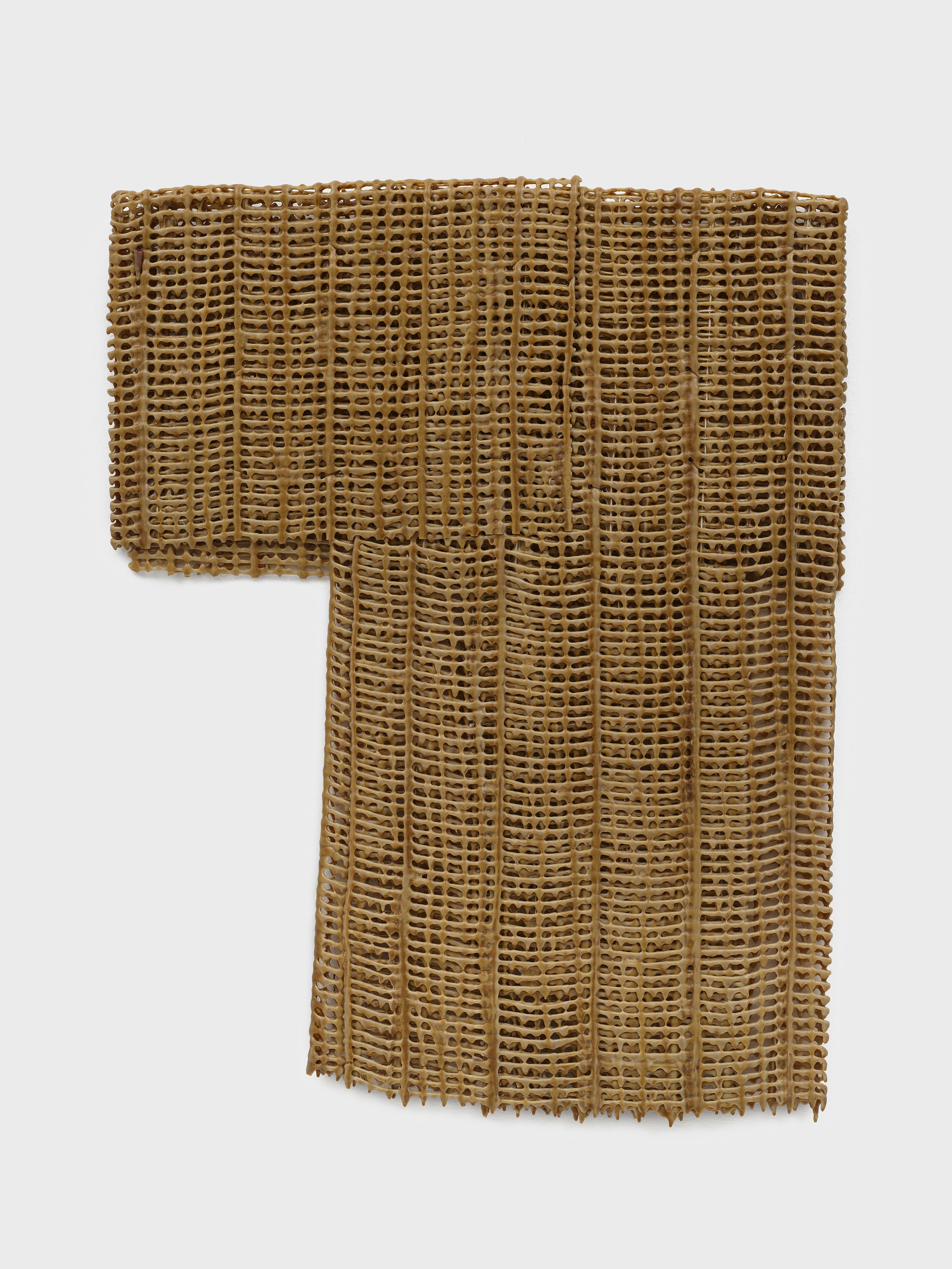

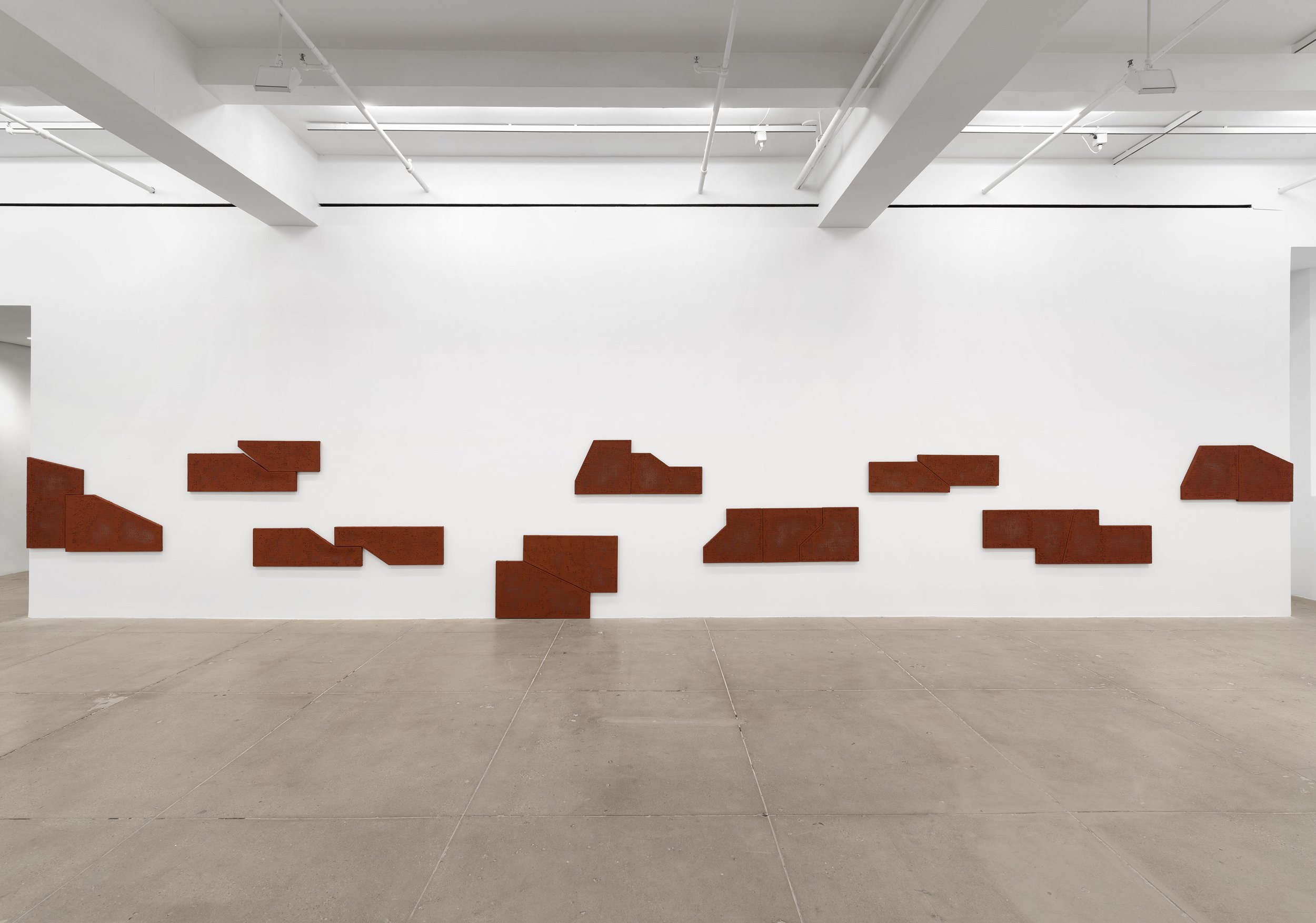
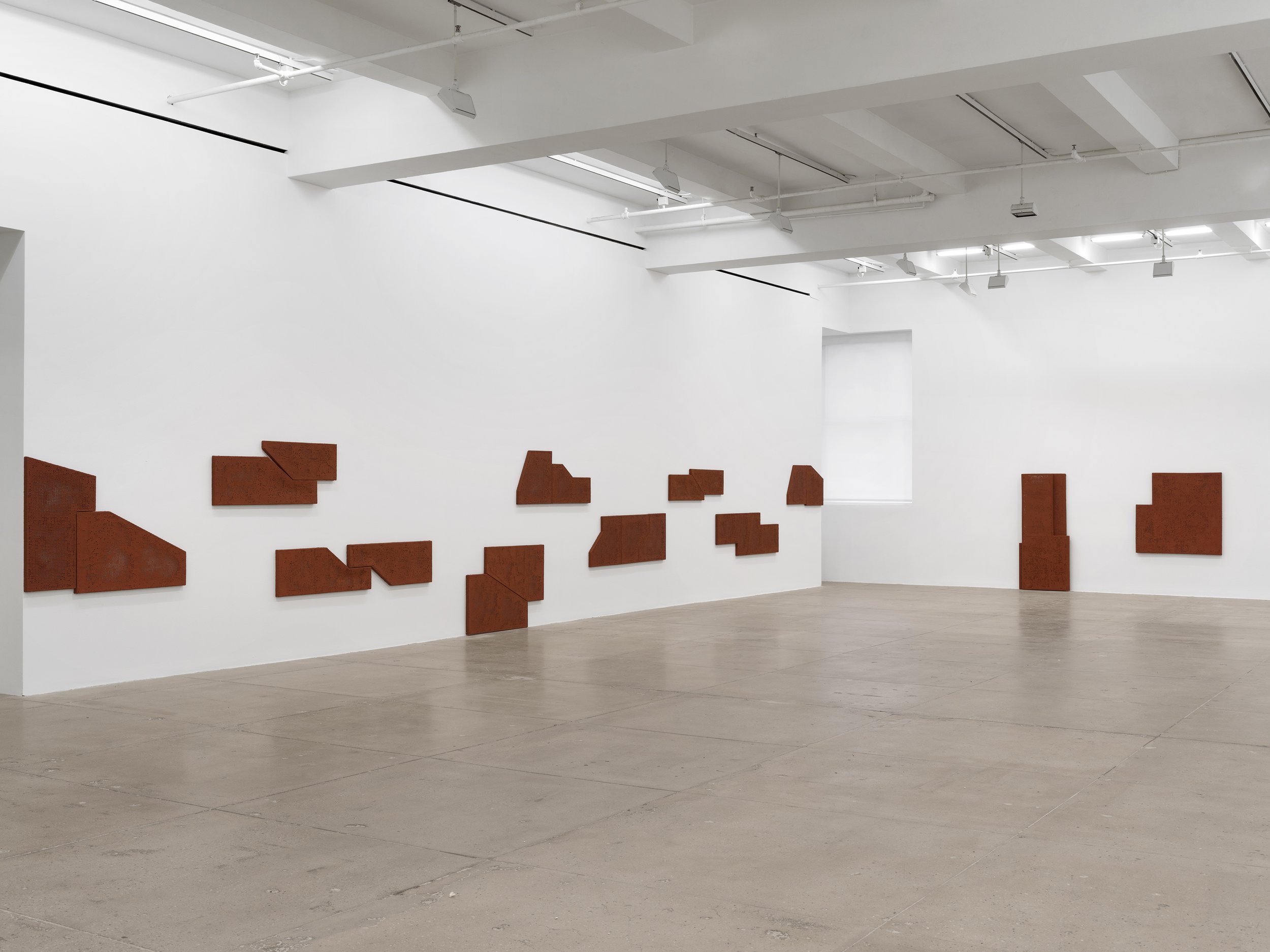
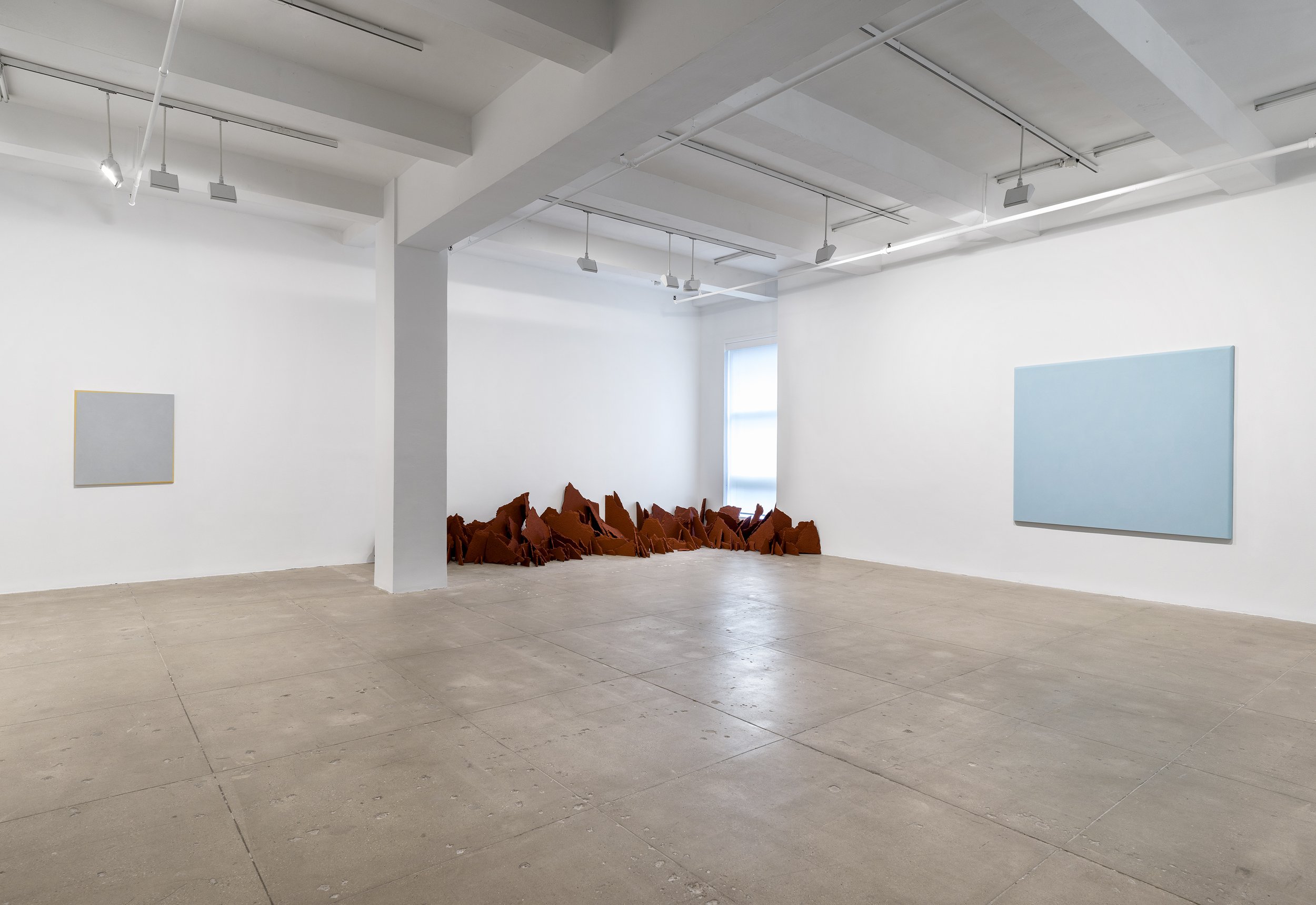
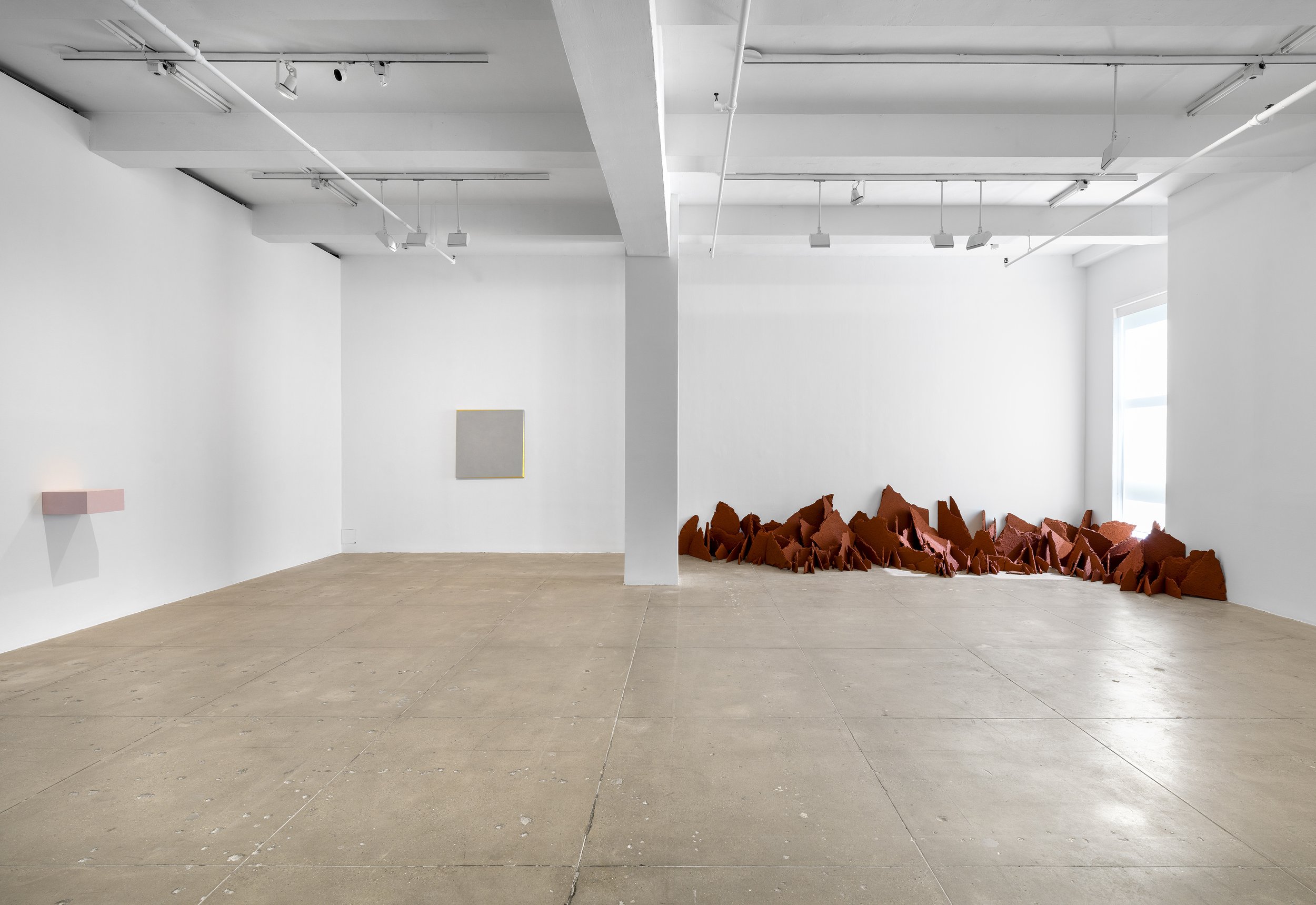
Installation view: Delcy Morelos, Ettore Spalletti, “Esa Esquina Soy Yo”, Marian Goodman Gallery, New York, 2023 Courtesy of Fondazione Ettore Spalletti and Marian Goodman Gallery Photo credit: Alex Yudzon
Morelos' Eva, 2013, acrylic on jute, an installation of the same title made with earth and binder on chipboard, marks Morelos' decisive shift from the pictorial plane to structures in space, anticipating her sculptural practice and large-scale experiential and multisensory installations.
At the Pulitzer Arts Foundation in St. Louis, Interwoven, a solo exhibition of Morelos' work, is scheduled to run from 8 March through 4 August 2024. Delcy Morelos: El Abrazo, on view at Dia Chelsea through 20 July 2024, features two immersive earth-based installations, Cielo terrenal (Earthly Heaven) 2023 and El abrazo (The Embrace) 2023. A catalogue will be published in conjunction with the exhibition.
Ettore Spalletti: Parole di colore, an installation that opened in September 2023 and inaugurated the new Robert Olnick Pavilion at Magazzino Italian Art in Cold Spring, NY, is on view through 6 January 2025, and a publication will accompany the exhibition.
Born in 1967 in Tierralta in the region of Córdoba in Colombia, Delcy Morelos studied at the Cartagena School of Fine Arts. She lives and works in Bogotá. Her practice is rooted in ancestral Andean cosmovision and the aesthetics of Minimal Art. Morelos’ abstract works, with their formidable evocations, inspire rumination on the interplay between human beings and earth, the human body and materiality.
Solo exhibitions include Interwoven, Pulitzer Arts Foundation, St. Louis, MO (2024); El Abrazo, Dia Chelsea, New York (2023); El lugar del alma, Museo Moderno, Buenos Aires, Argentina (2022); Enie, Fundación NC-Arte, Bogotá (2018); Inner Earth, Röda Sten Konsthall, Göteborg, Sweden (2018); La Sombra Terrestre (The Shadow of the Earth), Fundación Fuga, Bogotá (2015); Barranquilla Museum of Modern Art (2006); Gt Gallery, Flax Arts Studios Residence Program, Belfast, Northern Ireland (2006); Academia Superior de Artes de Bogota, Santa Fe Gallery, Bogota (2004); and Color que soy, Museo de Arte de la Universidad Nacional de Colombia (2002).
Selected group exhibitions include The Milk of Dreams, Arsenale Pavilion at the 59th Venice Biennale (2022); Still Alive, Aichi Trienniale in Japan (2022); Something (you can't see, on the other side, of a wall from this side) casts a shadow, SOMArts Culural Center, San Francisco (2018); Medellín, une histoire colombienne des années 1950 à aujourd’hui, Musée des Abattoirs, Toulouse, France (2017); Du som jag, Havremagasinet, Boden, Sweden (2016) and Sami Center for Contemporary Art, Karasjok, Norway (2017); 7 Mercosul Biennial, Grito e escuta (Screaming and Listening), Porto Alegre, Brazil (2009); MDE 07, Espacios de hospitalidad (Hospitality Spaces), Medellín (2007); ES2002 Tijuana/II International Biennial, Tijuana Cultural Center CECUT, Mexico (2002), and the VI Havana Biennial, Cuba (1997).
Ettore Spalletti (1940-2019) was born in Cappelle sul Tavo (Pescara), where he spent his entire life. Compared to contemporary contexts, Spalletti developed a singular, solitary voice and a body of work that transcends any movement that circumscribes an artist to regional or ideological boundaries.
Spalletti has been the protagonist of important international exhibitions, the most recent of which at Nouveau Musee National de Monaco, Monaco (2019) and at Palazzo Cini, Venice (2015). In 2014, three public institutions asked Spalletti to create three exhibitions at the same time at MADRE - Museo d'Arte Contemporanea Donnaregina, Naples, at GAM - Galleria Civica d'Arte Moderna e Contemporanea, Turin, and at MAXXI - Museo Nazionale delle Arti del XXI Secolo, Rome. Other solo exhibitions include: GNAM - Galleria Nazionale d'Arte Moderna, Rome (2010); Museum Kurhaus, Kleve (2009); Académie de France, Villa Medici, Rome (2006); Henry Moore Institute, Leeds (2005); Castello di Rivoli - Museo d'Arte Contemporanea, Rivoli, Turin (2004); Fundación la Caixa, Madrid (2000); Museo di Capodimonte, Naples (1999); Musée d'Art Moderne et Contemporain, Strasbourg (1998); MUHKA - Museum van Hedendaagse Kunst, Antwerp (1995); Solomon R. Guggenheim Museum, New York (1993); ARC - Musée d'Art Moderne de la Ville de Paris, Paris (1991); SMAK - Ghent, Ghent (1983); Museum Folkwang, Essen (1982).
In 2021, after the artist's passing, the Galleria Nazionale d’Arte Moderna e Contemporanea in Rome dedicated a retrospective exhibition to him. Spalletti has participated in the Venice Biennale (1982, 1993, 1995 and 1997) and documenta VII (1982), documenta IX (1992). His major commissioned works include the Chapel of Villa Serena, Pescara, Italy (2016), in collaboration with architect Patrizia Leonelli, and La salle des départs at the Hôpital Raymond-Poincaré, Garches, France (1996), a project for which he was awarded the order of Chevalier des Arts et Lettres de la République Française.
Works by Spalletti can be found, among others, in the permanent collections of the Solomon R. Guggenheim Museum, New York; MUMOK, Vienna; Castello di Rivoli, Turin; MAXXI, Rome-L'Aquila; Galleria Nazionale d'Arte Moderna e Contemporanea, Rome; Villa Litta Menafoglio Panza di Biumo, Varese; Centre Pompidou, Paris; Fondation Louis Vuitton, Paris; Museum Kurhaus, Kleve; SMAK, Ghent; MUHKA, Antwerp; Nouveau Musee National de Monaco, Monaco.
For more information about the exhibit, please visit the Marian Goodman Gallery’s site. The gallery can be found on Instagram and Artsy, too.
Michal Rovner:Pragim
Michal Rovner: Pragim 540 West 25th Street, New York, NY 10001 March 8 – April 18, 2024 Photography courtesy Pace Gallery
New York – Pace is pleased to present an exhibition of works by Michal Rovner at its 540 West 25th Street gallery in New York. Which opened on March 8th and will be on view until the April 18, the show, titled Pragim—the Hebrew word for Poppies—will feature prints, video works, and installations from a series the artist started in 2019. Over the last five years, as part of this long-term project, Rovner has filmed and drawn wild poppies that grow in her field in Israel.
Pragim- 2 (detail), 2024 PRINT archival pigment print 80-1/4" × 50" × 2" (203.8 cm × 127 cm × 5.1 cm), framed No. 90459.01 © Michal Rovner / Artists Rights Society (ARS), New York
For more than 30 years, Rovner’s practice has centered on universal questions of the human condition—bringing issues of identity, place, and dislocation to the fore. The poppy—which carries different associations and meanings around the world—embodies both fragility and fortitude, as well as memorial and loss. The ongoing war has impacted the artist’s perspective on her Pragim works, as they now also powerfully reflect the state of unrest and anguish afflicting the region. Using a dark palette of black, gray, and red, the artist imbues her human-scale staccato swaying poppies with harsh and tragic qualities.
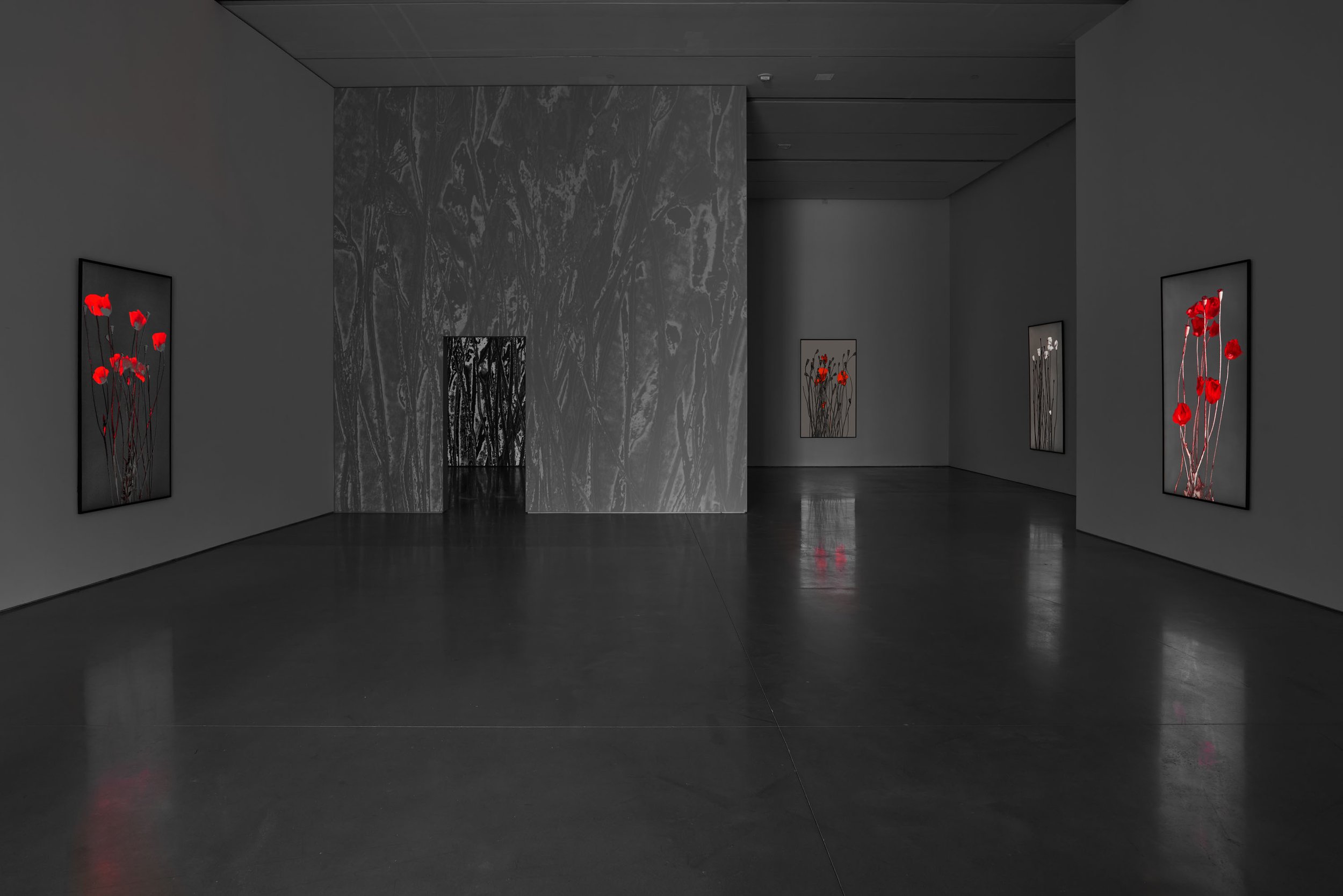
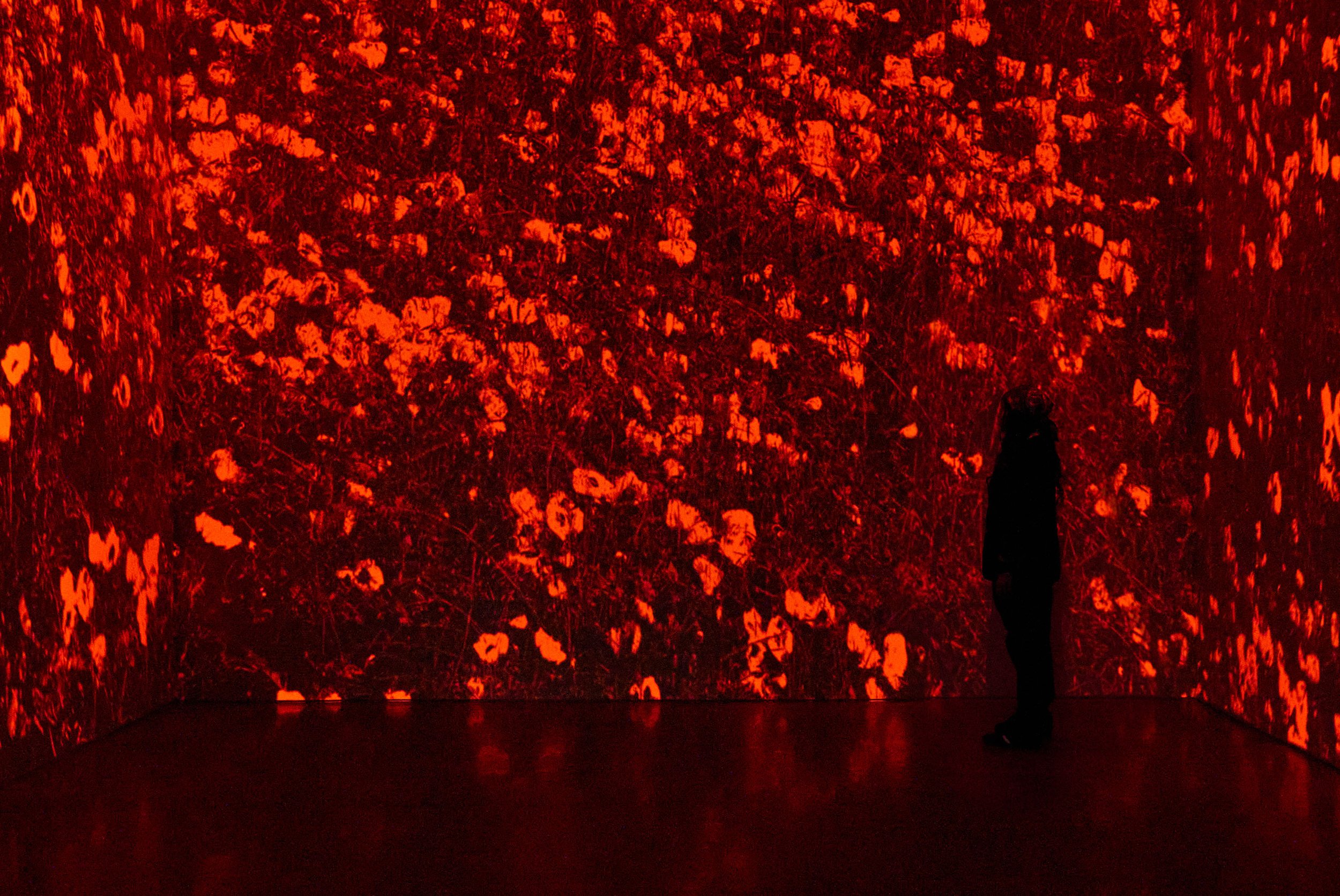
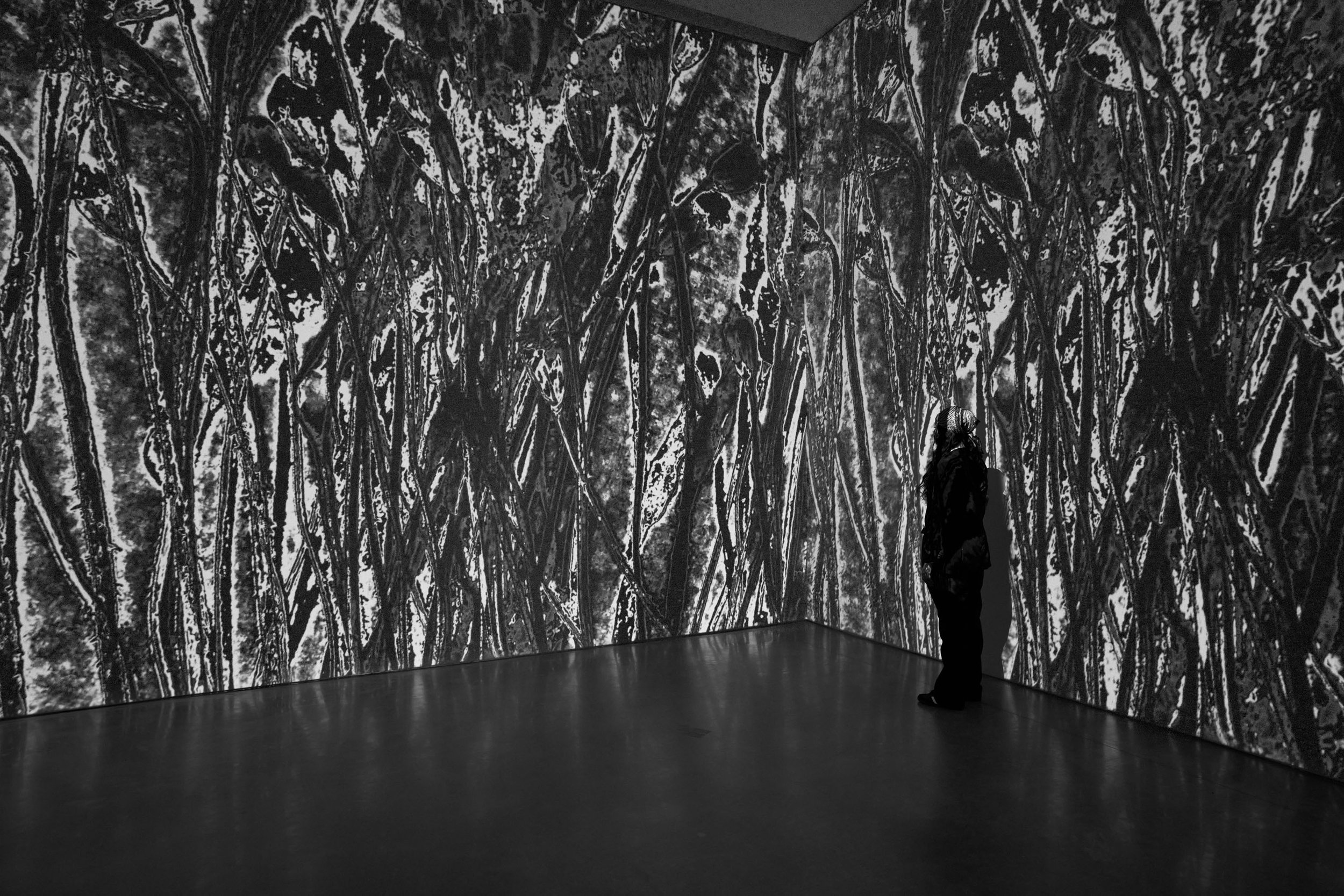
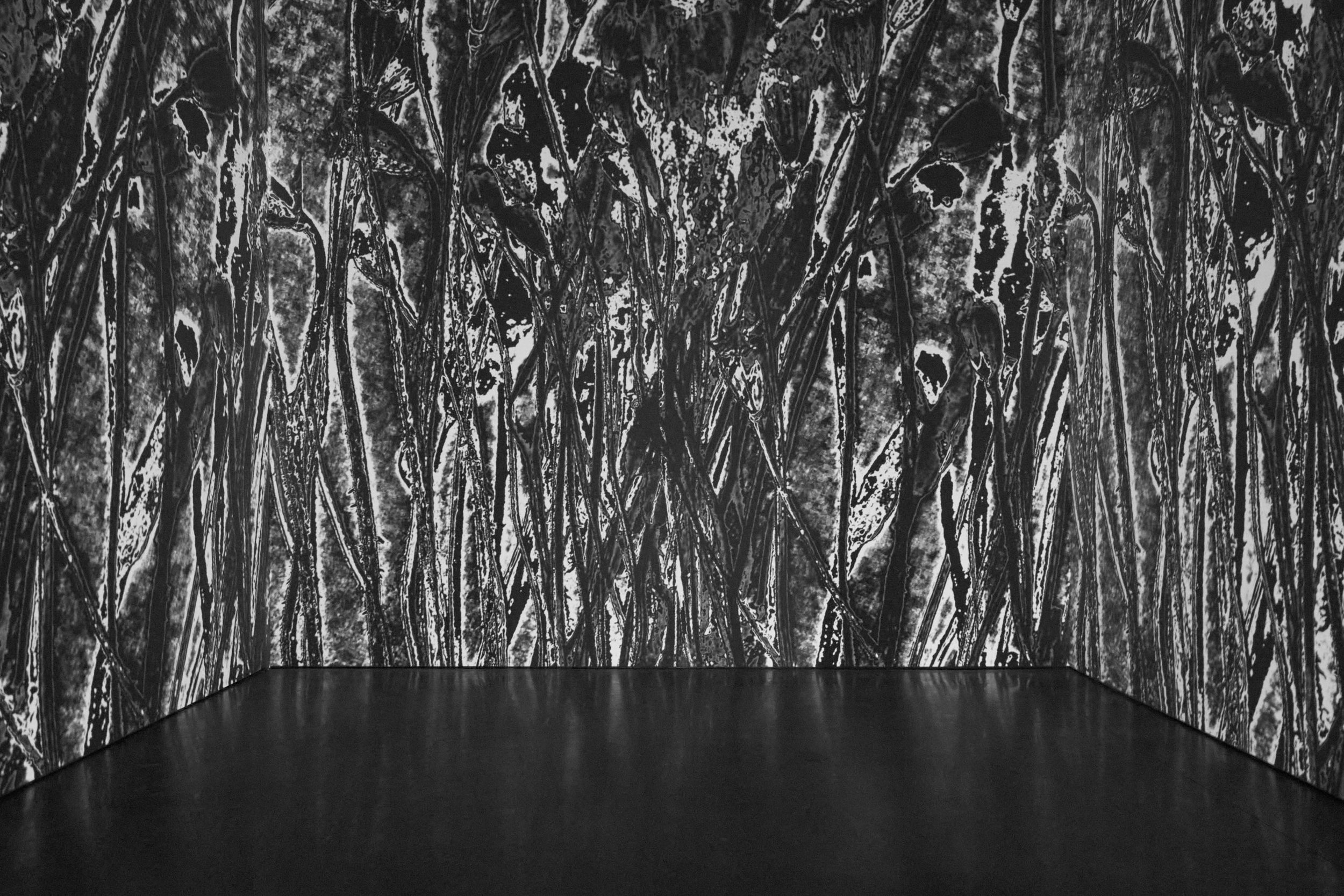

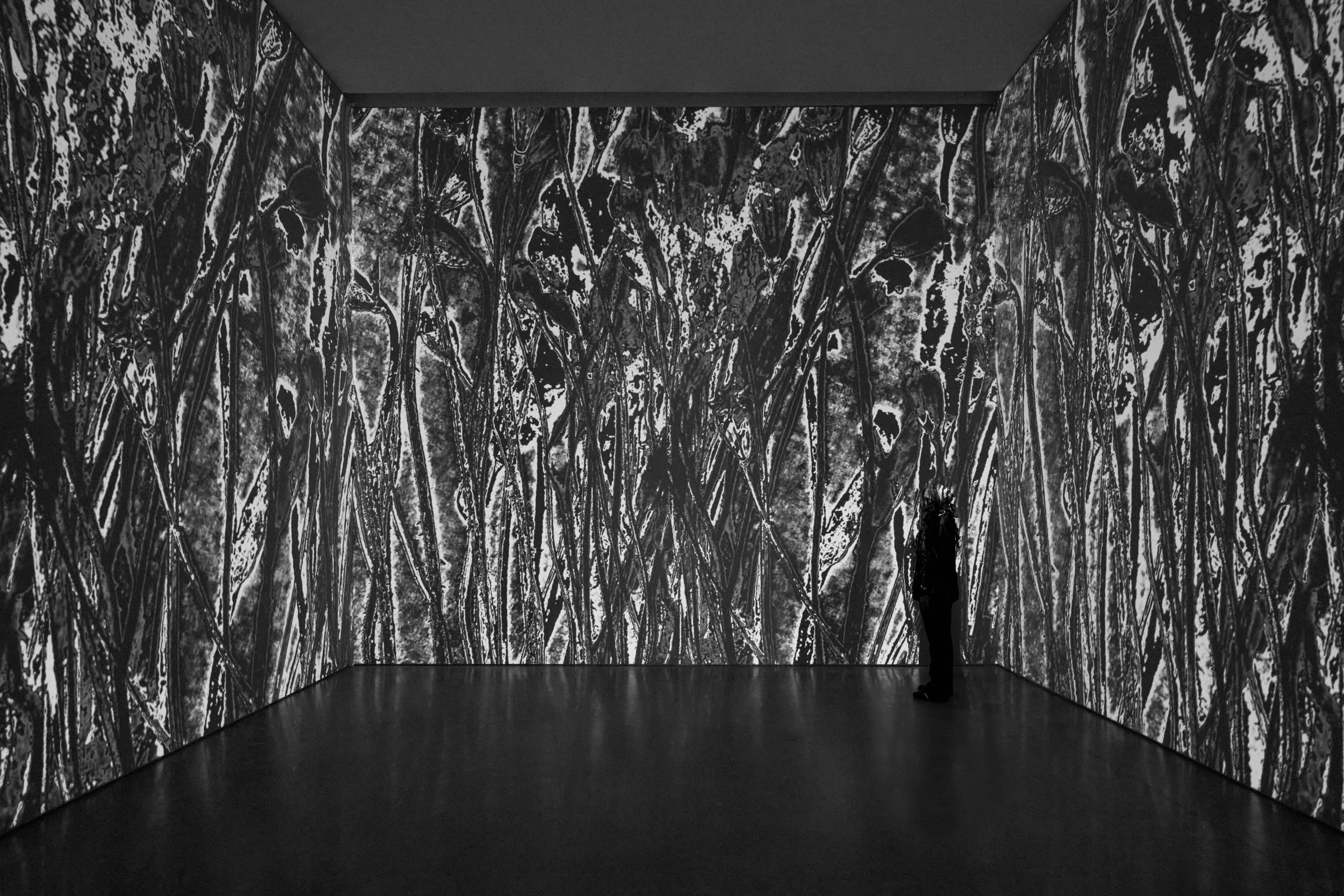
Michal Rovner: Pragim 540 West 25th Street, New York, NY 10001 March 8 – April 18, 2024 Photography courtesy Pace Gallery
Working across drawing, printmaking, video, sculpture, and installation, the artist often obscures identifying details and specifics of time and place in her layered compositions, creating abstract yet resonant reflections of reality and the human experience. One of her most famous projects is Makom (Place), a series of monumental cubic structures composed of stones of dismantled or destroyed Israeli and Palestinian homes from Jerusalem, Bethlehem, Haifa, the Galilee, and the border between Israel and Syria.
Pragim-3, 2024 PRINT archival pigment print 80-1/4" × 50" × 2" (203.8 cm × 127 cm × 5.1 cm), framed No. 90460.01 © Michal Rovner / Artists Rights Society (ARS), New York
The Makom series echoes conflicts in the past and present. Working with Israeli and Palestinian masons, Rovner addresses the possibility of creating together, in a shared experience of reconstructing and rebuilding.
Red Light, 2024 VIDEO LCD screen 74-13/16" × 42-1/2" × 5-3/8" (190 cm×108cm×13.7cm) No. 91051.01 © Michal Rovner / Artists Rights Society (ARS), New York
Michal Rovner (b. 1957, Tel Aviv, Israel) works with drawing, printmaking, video, sculpture, and installation to reflect on the continuum of human experience. Her work shifts constantly between the poetic and the political, using imagery that invokes the fragility of existence, identity, dislocation, and time. Generally avoiding direct representation of specific issues or events, Rovner reinterprets the present and historical memory. She records and erases visual information, obscuring specifics of time and place through gestural, abstract qualities. For immediate release Important historic exhibitions and installations of her work include Michal Rovner: The Space Between, Whitney Museum of American Art (2002); Against Order? Against Disorder?, Venice Biennale (2003); Incidental Affairs, Suntory Museum, Osaka (2009); Michal Rovner: Histoires, Musée du Louvre, Paris (2011); and Michal Rovner: Transitions, Canary Wharf, London (2019). Rovner’s work resides in numerous public collections worldwide including The Art Institute of Chicago, Illinois; Solomon R. Guggenheim Museum, New York; The Metropolitan Museum of Art, New York; Paris Audiovisuel, France (Collection of the City of Paris); and The Israel Museum, Jerusalem, Israel, among others.
Pace is a leading international art gallery representing some of the most influential contemporary artists and estates from the past century, holding decades-long relationships with Alexander Calder, Jean Dubuffet, Barbara Hepworth, Agnes Martin, Louise Nevelson, and Mark Rothko. Pace enjoys a unique U.S. heritage spanning East and West coasts through its early support of artists central to the Abstract Expressionist and Light and Space movements.
Since its founding by Arne Glimcher in 1960, Pace has developed a distinguished legacy as an artist-first gallery that mounts seminal historical and contemporary exhibitions. Under the current leadership of CEO Marc Glimcher, Pace continues to support its artists and share their visionary work with audiences worldwide by remaining at the forefront of innovation. Now in its seventh decade, the gallery advances its mission through a robust global program— comprising exhibitions, artist projects, public installations, institutional collaborations, performances, and interdisciplinary projects. Pace has a legacy in art bookmaking and has published over five hundred titles in close collaboration with artists, with a focus on original scholarship and on introducing new voices to the art historical canon.
Today, Pace has seven locations worldwide, including European footholds in London and Geneva as well as Berlin, where the gallery established an office in 2023. Pace maintains two galleries in New York—its headquarters at 540 West 25th Street, which welcomed almost 120,000 visitors and programmed 20 shows in its first six months, and an adjacent 8,000 sq. ft. exhibition space at 510 West 25th Street. Pace’s long and pioneering history in California includes a gallery in Palo Alto, which was open from 2016 to 2022. Pace’s engagement with Silicon Valley’s technology industry has had a lasting impact on the gallery at a global level, accelerating its initiatives connecting art and technology as well as its work with experiential artists. Pace consolidated its West Coast activity through its flagship in Los Angeles, which opened in 2022. Pace was one of the first international galleries to establish outposts in Asia, where it operates permanent gallery spaces in Hong Kong and Seoul, along with an office and viewing room in Beijing. In spring 2024, Pace will open its first gallery space in Japan in Tokyo’s new Azabudai Hills development.
For more information about this exhibition and others, please visit the Pace Gallery’s website here. Pace Gallery can be found on Instagram and Artsy, too.
Loie Hollowell: Dilation Stage
Loie Hollowell: Dilation Stage 540 West 25th Street, New York, NY 10001March 8–April 20, 2024 Photography courtesy Pace Gallery
New York – Pace is pleased to present Dilation Stage, an exhibition of new large-scale drawings by Loie Hollowell, at its 540 West 25th Street gallery in New York, which opened on March 8 and will be on view until April 20. This presentation marks Hollowell’s second solo show with Pace in New York and her first exhibition in the city dedicated exclusively to her works on paper. Dilation Stage will coincide with her first museum survey, on view at the Aldrich Contemporary Art Museum in Ridgefield, Connecticut, through August 11.
Nine Centimeters Dilated, September 21, 2023 WORK ON PAPER soft pastel on paper 26" × 30" (66 cm × 76.2 cm) framed, 29-15/16" × 33- 15/16" (76 cm × 86.2 cm) No. 89269 © Loie Hollowell, courtesy Pace Gallery
Hollowell is known for her otherworldly paintings and drawings of bodily landscapes. Through a unique lexicon of geometric and organic forms that represent elements of her body, the artist explores experiences of sex, pregnancy, childbirth, breastfeeding, and motherhood. Manipulating real and illusory space on the canvas, she uses radiant colors, varied textures, and protruding sculptural elements to draw viewers into her energetic compositions.
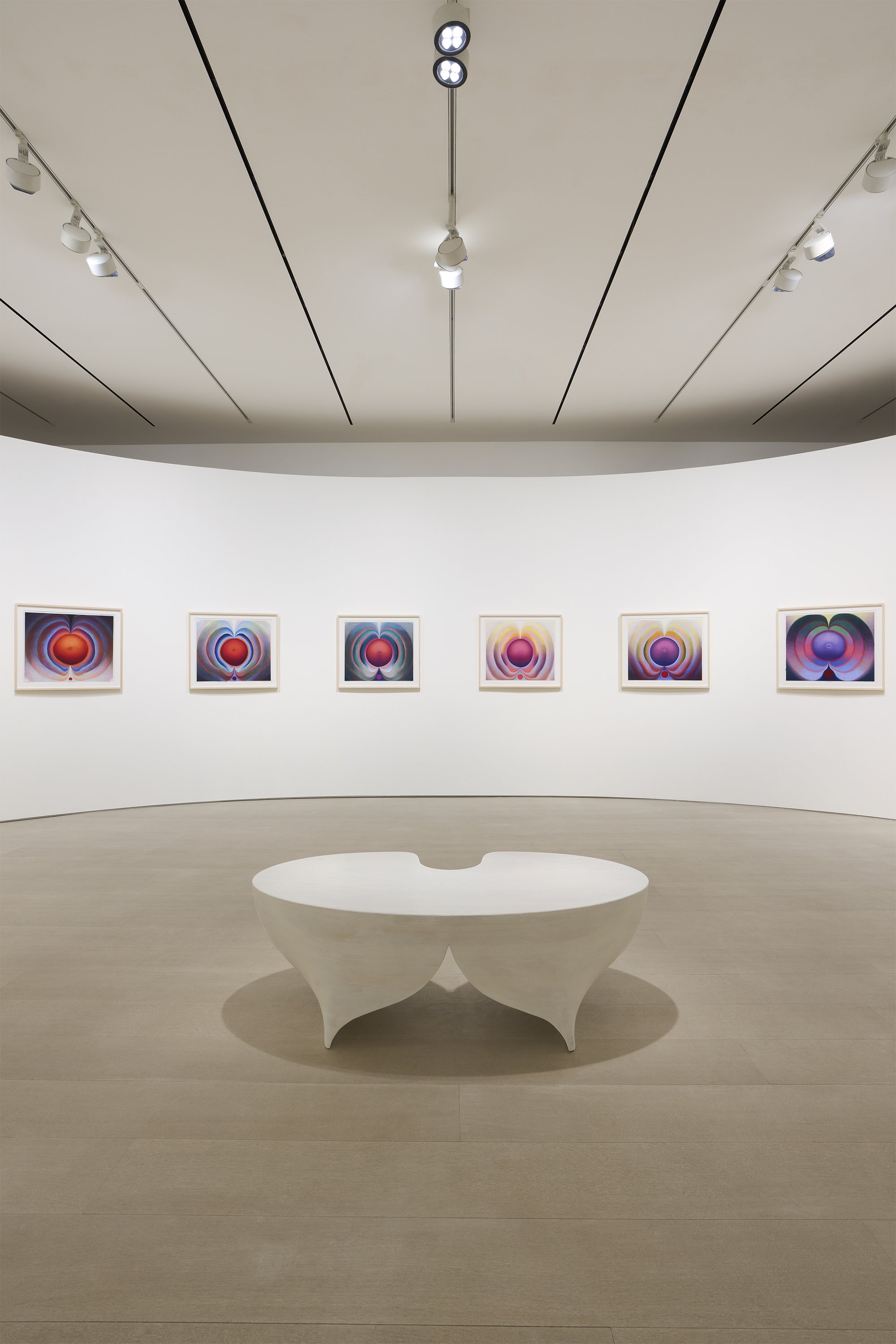
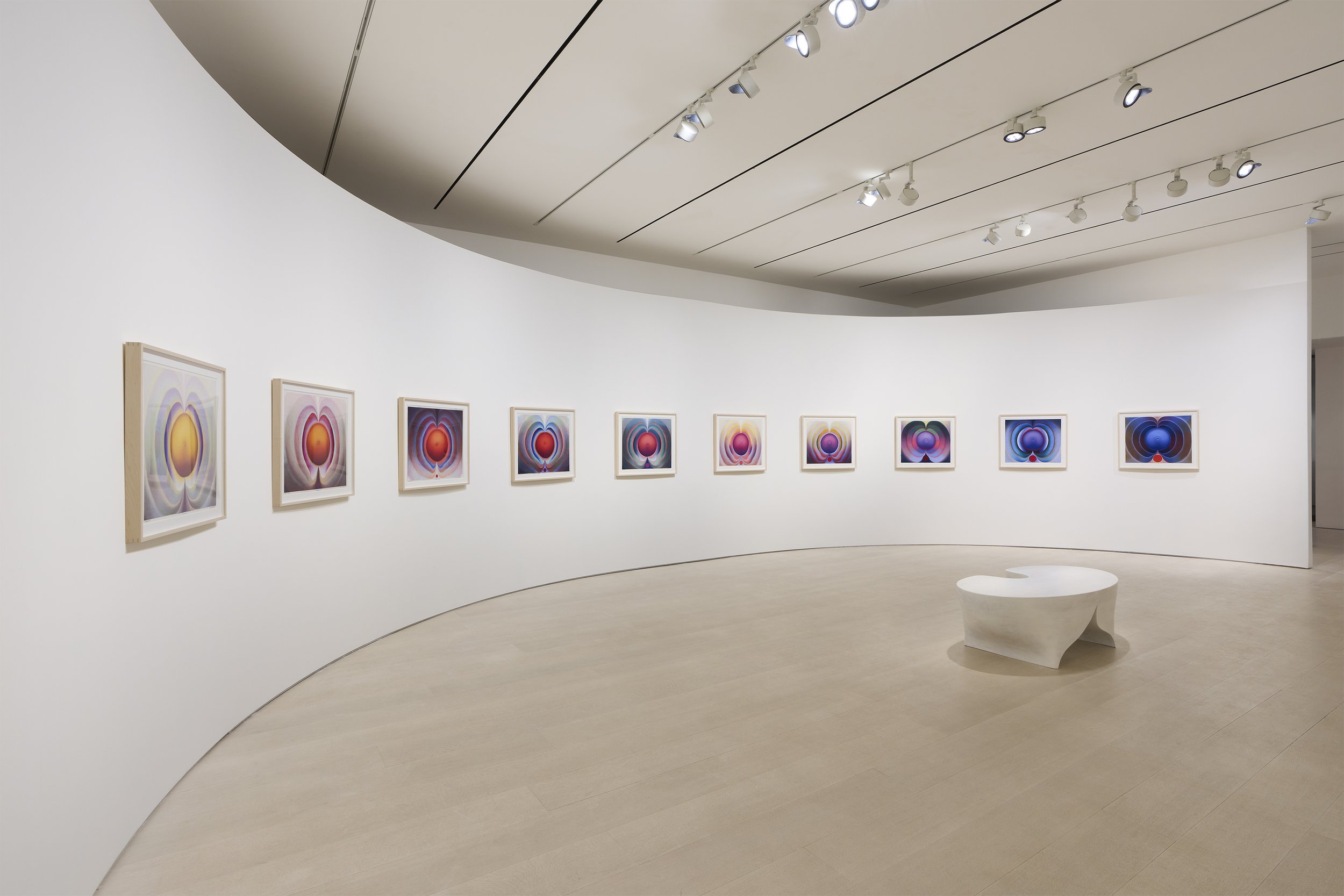
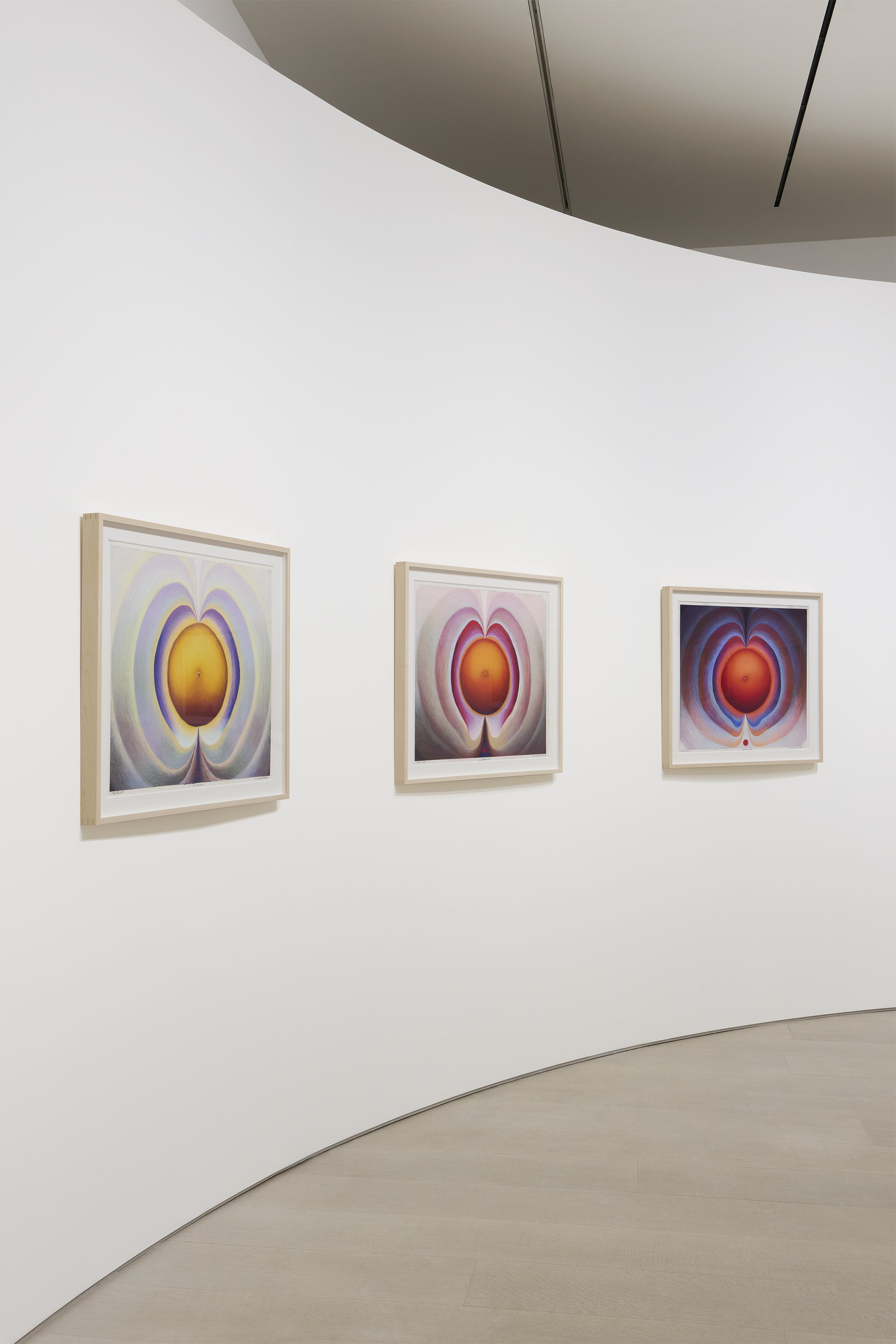
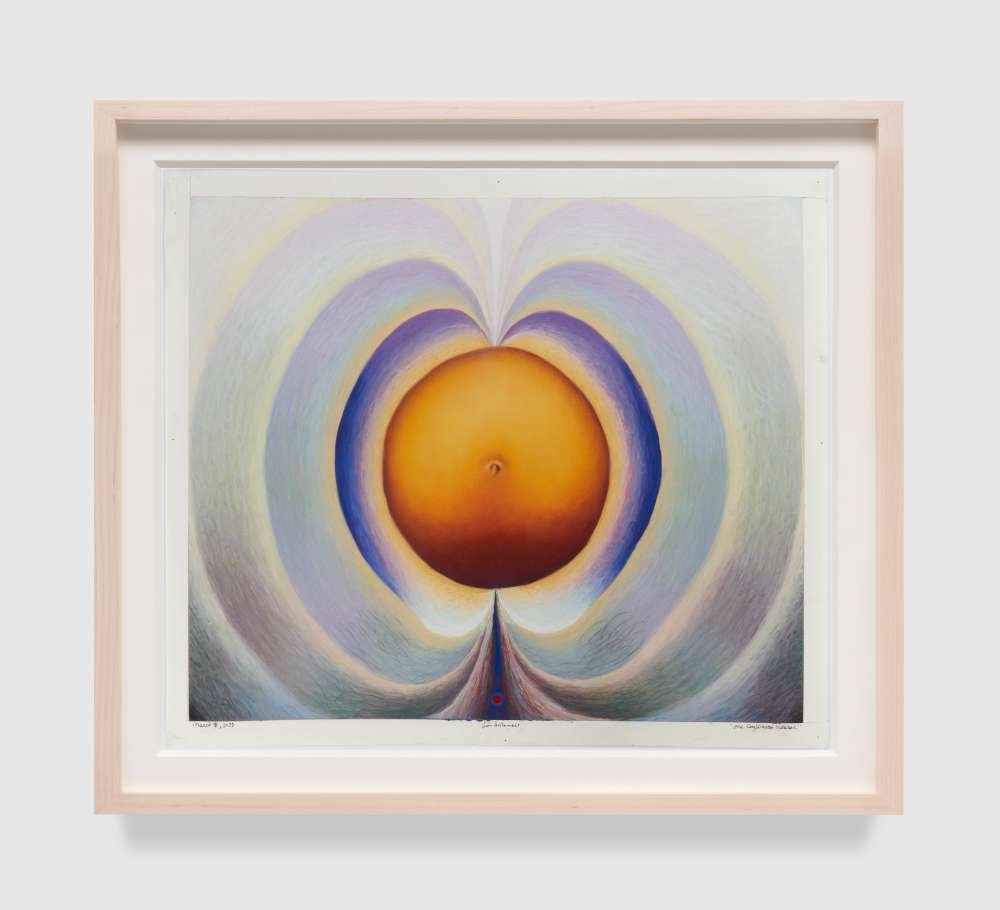
Loie Hollowell: Dilation Stage 540 West 25th Street, New York, NY 10001March 8–April 20, 2024 Photography courtesy Pace Gallery
In her show with Pace in New York, Hollowell presents ten new pastel drawings that document the dilation stage of labor, in which the cervix opens and effaces from one to ten centimeters, allowing the baby to move into the birth canal. Displayed sequentially on a rounded wall that reflects the shape of a pregnant belly, these drawings feature, at their centers, depictions of Hollowell’s own pregnant abdomen, rendered to scale. Below each belly is a circle the exact size of the effaced cervix as it expands. Meanwhile, radiating bands of color—which represent the increasingly intense pain of contractions during the dilation stage—fill the spaces around the bellies. In each composition, these rippling colors respond to the hue of the swollen wombs from which they emanate— Hollowell assigns light colors to minimally painful contractions, while intensely painful contractions take on dark colors. The cervical “circles” at the bottom of each drawing seem to pulse as the series progresses, culminating in a blazing cadmium red.
Four Centimeters Dilated, March 22, 2023 WORK ON PAPER soft pastel on paper 26"×28"(66cm×71.1cm) framed, 29-15/16" × 33- 15/16" (76 cm × 86.2 cm) No. 87553 © Loie Hollowell, courtesy Pace Gallery
For this body of work, in which color is a highly charged force, Hollowell adopts a wide ranging palette to express the mental and physical sensations she has experienced while giving birth. “When the first contractions started with each of my pregnancies, I was filled with joy and excitement that I would soon be meeting my baby,” Hollowell says. “I rendered this stage in yellow, like the sun on a cloudless day, full of light and optimism. As my cervix dilated, the pain became increasingly intense and sharp, so I moved into bright, deep reds for that stage. My second birth was at home in a birthing tub—I was enveloped in buoyant, luke-warm water while also having this searing and heavy pain. I felt only an ultramarine blue could rightfully signify that experience.”
Two Centimeters Dilated, March 10, 2023 WORK ON PAPER soft pastel on paper 26"×30"(66cm×76.2cm) framed, 29-15/16" × 33- 15/16" (76 cm × 86.2 cm) No. 87551 © Loie Hollowell, courtesy Pace Gallery
In addition to these drawings, the exhibition includes a unique birthing bench that Hollowell created collaboratively with her husband, sculptor Brian Caverly. The history of the birthing chair—which has been used by women in labor throughout millennia—extends all the way back to 1450 BCE Egypt. In Caverly and Hollowell’s rendition, which visitors are invited to sit on, space is created not just for the birther, but also for the partner, midwife, doula, doctor, or any other witness to the transcendent journey of birth.
Later this year, Pace will present an exhibition of new paintings by Hollowell at its Los Angeles gallery. Details about this presentation will be announced in due course.
Loie Hollowell (b. 1983, raised in Woodland, CA) is recognized for her paintings that evoke bodily landscapes, using geometric shapes to move a figure or its actions into abstraction. Her work explores themes of sexuality, often through allusions to the human form with an emphasis on women’s bodies. An investigation of autobiography became evident in Hollowell’s early work, which explored the use of gradient staining techniques on cotton supports as a metaphor for intimate spaces—meditations on sleep and bodily fluids. These canvases evolved into figurative painting, introducing female nudes as subject matter as well as the use of reflection and mirroring. Her subsequent work exhibited a shift toward abstraction, characterized by radiating silhouettes and a pulsating color palette. With its strong colors, varied textures, and geometrical symmetry, Hollowell’s practice is situated in lineage with the work of the Transcendental Painting Group (1938–41), Georgia O’Keeffe, Gulam Rasool Santosh, and Judy Chicago.
Pace is a leading international art gallery representing some of the most influential contemporary artists and estates from the past century, holding decades-long relationships with Alexander Calder, Jean Dubuffet, Barbara Hepworth, Agnes Martin, Louise Nevelson, and Mark Rothko. Pace enjoys a unique U.S. heritage spanning East and West coasts through its early support of artists central to the Abstract Expressionist and Light and Space movements.
Since its founding by Arne Glimcher in 1960, Pace has developed a distinguished legacy as an artist-first gallery that mounts seminal historical and contemporary exhibitions. Under the current leadership of CEO Marc Glimcher, Pace continues to support its artists and share their visionary work with audiences worldwide by remaining at the forefront of innovation. Now in its seventh decade, the gallery advances its mission through a robust global program— comprising exhibitions, artist projects, public installations, institutional collaborations, performances, and interdisciplinary projects. Pace has a legacy in art bookmaking and has published over five hundred titles in close collaboration with artists, with a focus on original scholarship and on introducing new voices to the art historical canon.
Today, Pace has seven locations worldwide, including European footholds in London and Geneva as well as Berlin, where the gallery established an office in 2023. Pace maintains two galleries in New York—its headquarters at 540 West 25th Street, which welcomed almost 120,000 visitors and programmed 20 shows in its first six months, and an adjacent 8,000 sq. ft. exhibition space at 510 West 25th Street. Pace’s long and pioneering history in California includes a gallery in Palo Alto, which was open from 2016 to 2022. Pace’s engagement with Silicon Valley’s technology industry has had a lasting impact on the gallery at a global level, accelerating its initiatives connecting art and technology as well as its work with experiential artists. Pace consolidated its West Coast activity through its flagship in Los Angeles, which opened in 2022. Pace was one of the first international galleries to establish outposts in Asia, where it operates permanent gallery spaces in Hong Kong and Seoul, along with an office and viewing room in Beijing. In spring 2024, Pace will open its first gallery space in Japan in Tokyo’s new Azabudai Hills development.
For more information about this exhibition and others, please visit the Pace Gallery’s website here. Pace Gallery can be found on Instagram and Artsy, too.
Chuck Close : Red, Yellow and Blue: The Last Paintings
Fred/Diptych, 2017-2018 PAINTING oil on canvas 36" × 30" × 1-1/4" (91.4 cm × 76.2 cm × 3.2 cm), two panels, each No. 69339 © Chuck Close, courtesy Pace Gallery
New York – Pace is pleased to present an exhibition of the last paintings of Chuck Close at its 510 West 25th Street gallery in New York which opened on February 23 and will be on view until April 13, 2024. This is the gallery’s first presentation dedicated to the artist's work since his death in 2021; this show features a selection of paintings, photographs, and works on paper—most of which have never been exhibited before—that reflect Close’s significant contributions to the history of art. Since it began representing Close in 1977, Pace has exhibited each new body of his work, and this presentation will complete that cycle.
Brad, 2020-2021 PAINTING oil on canvas 36" × 30" (91.4 cm × 76.2 cm) No. 77931 ©Chuck Close, courtesy Pace Gallery
The exhibition is accompanied by a catalogue featuring a previously unpublished 2018 interview between Close and the artist Cindy Sherman—originally commissioned by The Brooklyn Rail—as well as a new critical essay by Carter Ratcliff, which considers Close’s final works in depth. These texts appear alongside an essay by Barbara Knappmeyer that examines the artist’s renderings of the face in the context of facial recognition technology.
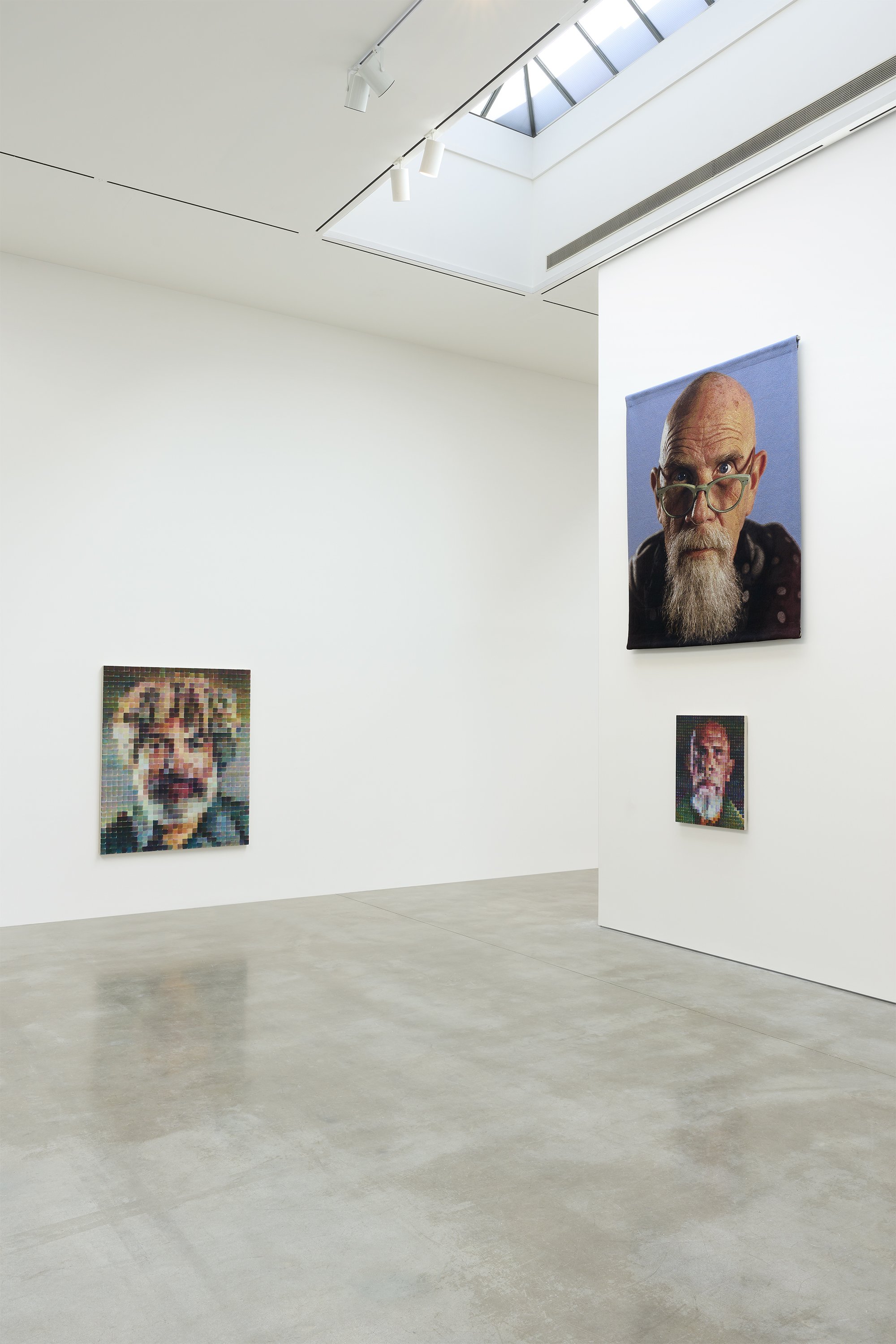
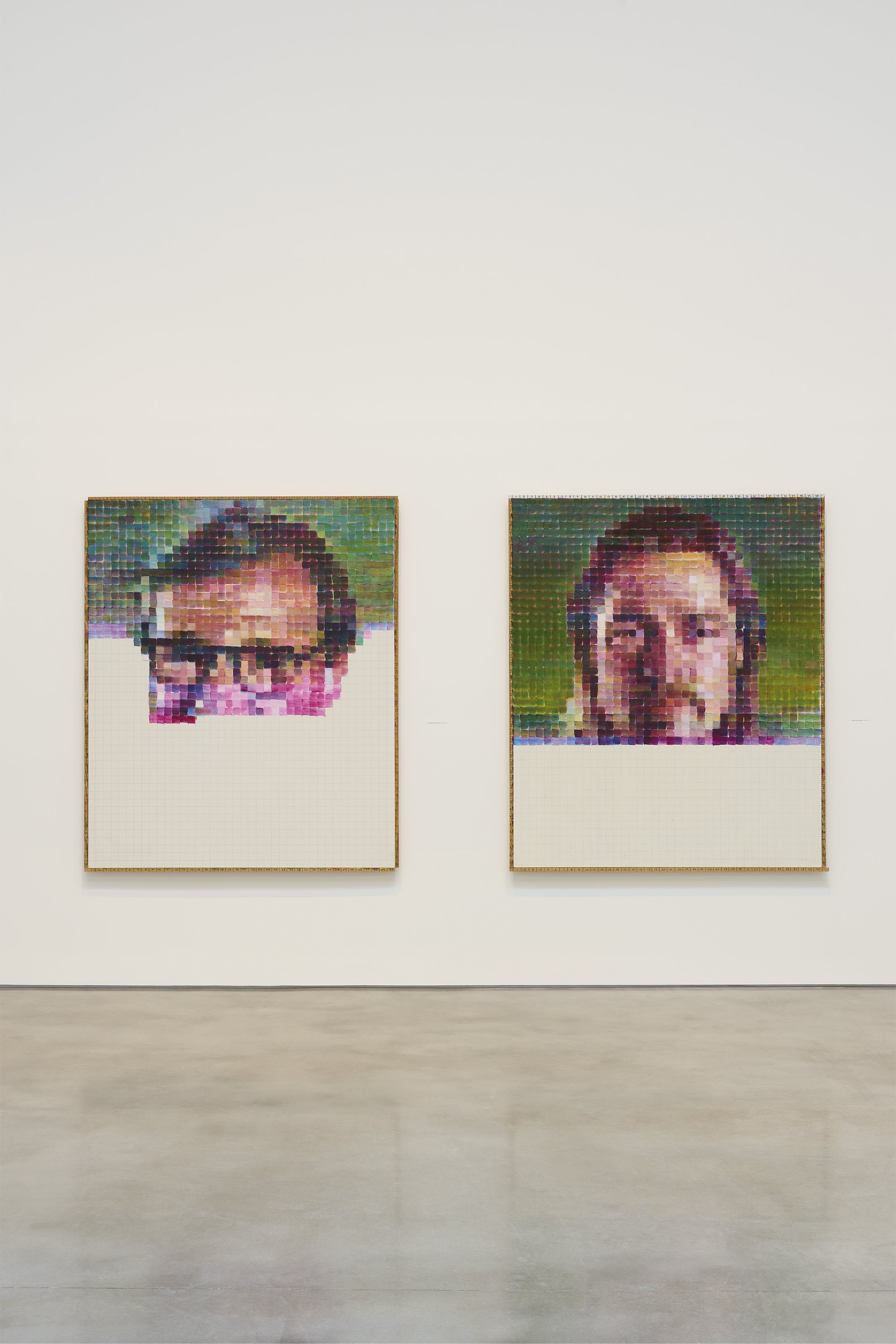
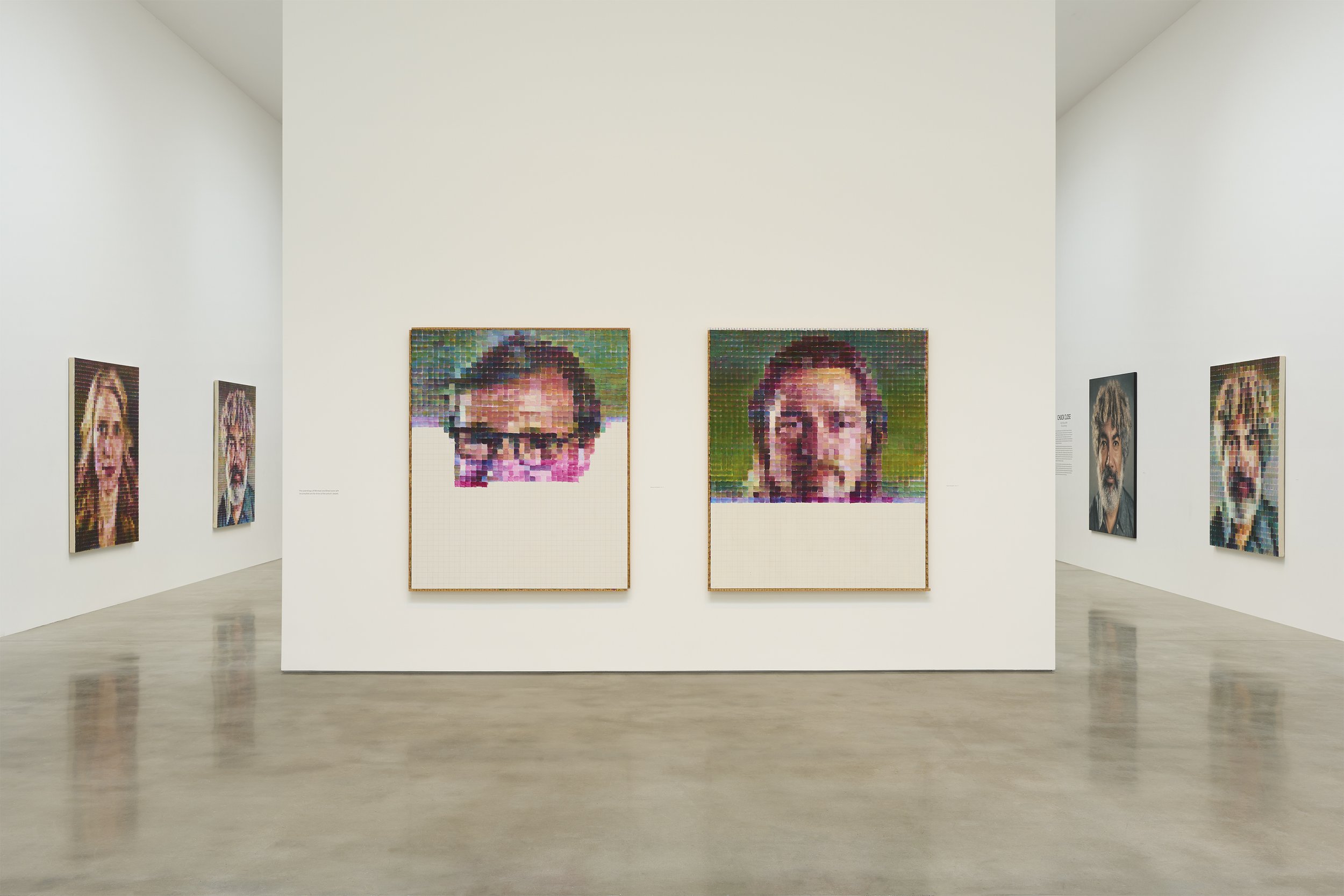
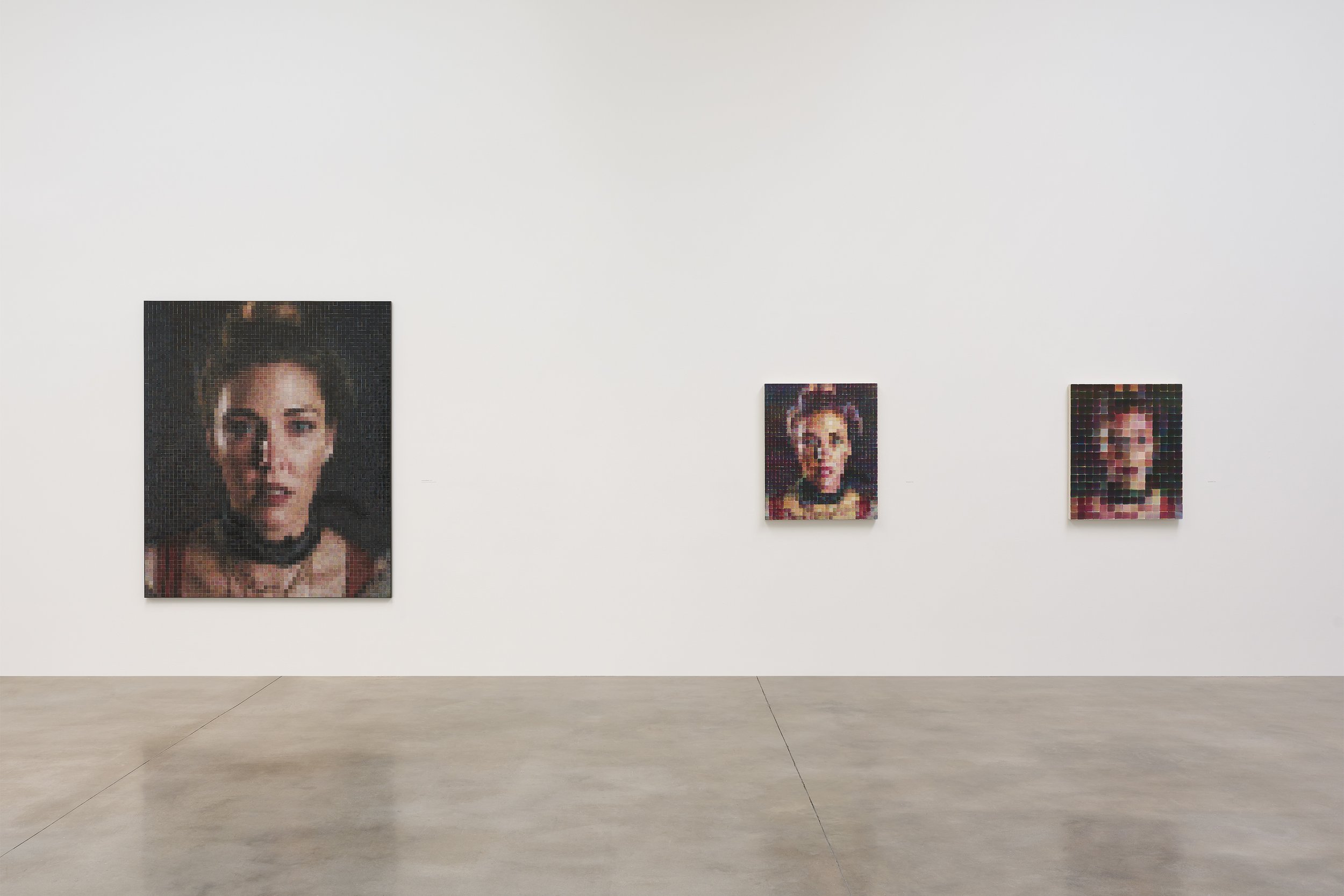
Chuck Close, Red, Yellow and Blue: The Last Paintings 510 West 25th Street, New York, NY 10001 February 23 – April 13, 2024 Photography courtesy Pace Gallery
Since the 1970s, Close has been known for his innovative approach to conceptual portraiture, systematically transposing his subjects’ likenesses from photographs into gridded paintings. Over the course of five decades, his work challenged conventional modes of representation across a wide range of media, including various forms of painting, printmaking, drawing, collage, daguerreotypes, Polaroid photography, and tapestry.
Baby Jane, 2018-2019 PAINTING oil on canvas 102-1/2" × 84" (260.4 cm × 213.4 cm) No. 73510©Chuck Close, courtesy Pace Gallery
The artist posed a radical proposition with his approach to painting, going against the grain of art world trends during the late 1960s and 1970s, when Minimalism, abstraction, and seriality were dominant, and portraiture and photorealism were largely overlooked. Pace’s exhibition spotlights Close’s final body of paintings, which includes works that have never been publicly exhibited. These full-color portraits and self-portraits employ a palette of only three colors: red, yellow, and blue.
Claire, 2020 PAINTING oil on canvas 72" × 60" (182.9 cm × 152.4 cm) No. 77932 ©Chuck Close, courtesy Pace Gallery
Layering transparent glazes of paint, Close created an effect of abstract likeness entirely different from that of his previous work. The complex color relationships that unfold in these paintings are visible at the bleeding edges of each square within the grid, where the ragged ends of each individual color are visible. Meditating on the power of color itself, Close’s final works suggest the constructive aesthetics of Impressionism, where form is built up through a chromatic architecture of brushstrokes. Appearing more abstract than representational to the human eye, the likenesses in these portraits come into greater focus when viewed from a distance or through the lens of a camera, an act of transfiguration that speaks to the artist’s interest in modes of perception and information processing.
Close realized these formal achievements in his last works while grappling with long-term health issues precipitated by a spinal aneurysm that he suffered in 1988 at the age of 48. Having lost the use of his arms and legs as a result of the aneurysm, Close was told by doctors that he would never be able to paint again. Through a grueling process of rehabilitation, he eventually regained his ability to paint by using a brush-holding device strapped to his wrists and forearms. Working through this disability for the rest of his life, he was forced to teach himself how to paint in an entirely new way, reinventing his approach to the medium in the middle of his career. In his final works, Close continued to push against the constraints of his physical disability to reinvent his own painterly language once again.
Even prior to his aneurysm, however, Close struggled with other disabilities. Throughout his childhood and adolescence, he used art as a means of navigating severe dyslexia and prosopagnosia, or face blindness. Having studied at the University of Washington, Yale, and the Akademie der Bildenden Künste in Vienna, he began teaching at the University of Massachusetts, Amherst—where he would present his first solo exhibition—in the mid-1960s. Upon relocating to New York, the artist continued to explore new modes of realism, using an airbrush to paint blackand-white, highly detailed photographic portraits of himself, his family, and his friends onto large-scale canvases, a practice he would continue for the rest of his career. Close began in the late 1970s to make use of a grid system based on a physical relationship to his support. The resulting works read like pixelated mosaics wherein the viewer deciphers a unified image within juxtaposed colors, shapes, lines, and fingerprints. The artist’s first retrospective, titled Close Portraits, was organized by the Walker Art Center in Minneapolis in 1980. That show traveled to the St. Louis Art Museum in Missouri and the Museum of Contemporary Art Chicago before closing at the Whitney Museum of American Art in New York. In the early 1990s, he began experimenting with portraiture through the production of silk tapestries and, in 2003, he furthered this investigation, creating editions of large-scale Jacquard tapestry portraits. In 1998, the Museum of Modern Art in New York presented a full-scale retrospective of Close’s career that included more than 90 paintings, drawings, and photographs, cementing his status as one of the most influential artists of his generation.
Fred II, 2017 PAINTING oil on canvas 72"×60"×2"(182.9cm× 152.4 cm × 5.1 cm) No. 68273 © Chuck Close, courtesy Pace Gallery
Chuck Close’s (b. 1940, Monroe, Washington; d. 2021, New York) commitment to process and media characterized his approach to portraiture. He began creating portraits based on photographs in the late 1960s, using a grid to map each facial detail, which he would then recreate in exacting detail through painting. Beginning in the late 1970s,
Close began to diverge from his highly detailed approach, instead constructing images that are still organized by a grid, but with layers of autonomous shapes and colors that cohere into his subject’s face when viewed from a distance. Close constantly revitalized his practice through varied media and modes of representation and his oeuvre encompassed many modes of art-making, including painting, printmaking, drawing, collage, daguerreotype and Polaroid photography, mosaic, and tapestries.
Pace is a leading international art gallery representing some of the most influential contemporary artists and estates from the past century, holding decades-long relationships with Alexander Calder, Jean Dubuffet, Barbara Hepworth, Agnes Martin, Louise Nevelson, and Mark Rothko. Pace enjoys a unique U.S. heritage spanning East and West coasts through its early support of artists central to the Abstract Expressionist and Light and Space movements.
Since its founding by Arne Glimcher in 1960, Pace has developed a distinguished legacy as an artist-first gallery that mounts seminal historical and contemporary exhibitions. Under the current leadership of CEO Marc Glimcher, Pace continues to support its artists and share their visionary work with audiences worldwide by remaining at the forefront of innovation. Now in its seventh decade, the gallery advances its mission through a robust global program— comprising exhibitions, artist projects, public installations, institutional collaborations, performances, and interdisciplinary projects. Pace has a legacy in art bookmaking and has published over five hundred titles in close collaboration with artists, with a focus on original scholarship and on introducing new voices to the art historical canon.
Today, Pace has seven locations worldwide, including European footholds in London and Geneva as well as Berlin, where the gallery established an office in 2023. Pace maintains two galleries in New York—its headquarters at 540 West 25th Street, which welcomed almost 120,000 visitors and programmed 20 shows in its first six months, and an adjacent 8,000 sq. ft. exhibition space at 510 West 25th Street. Pace’s long and pioneering history in California includes a gallery in Palo Alto, which was open from 2016 to 2022. Pace’s engagement with Silicon Valley’s technology industry has had a lasting impact on the gallery at a global level, accelerating its initiatives connecting art and technology as well as its work with experiential artists. Pace consolidated its West Coast activity through its flagship in Los Angeles, which opened in 2022. Pace was one of the first international galleries to establish outposts in Asia, where it operates permanent gallery spaces in Hong Kong and Seoul, along with an office and viewing room in Beijing. In spring 2024, Pace will open its first gallery space in Japan in Tokyo’s new Azabudai Hills development.
For more information about this exhibition and others, please visit the Pace Gallery’s website here. Pace Gallery can be found on Instagram and Artsy, too.
Rollie McKenna: Making a Life in Photography
Rollie McKenna, Making A Life In Photography: Rollie McKenna, Installation view, Vassar College’s Frances Lehman Loeb Art Center Photo credit: Thomas Barratt Photography
Vassar College’s Frances Lehman Loeb Art Center presents Making A Life In Photography: Rollie McKenna, the first survey of the prolific career of American photographer Rosalie (Rollie) Thorne McKenna, the exhibition opened on February 17 of this year and will be on view until June 2, 2024.
Rollie McKenna, Laura Gilpin, 1962, Gelatin silver print, Frances Lehman Loeb Art Center, Vassar College, Gift of the artist, 1987.53.67 © The Rosalie Thorne McKenna Foundation, Courtesy Center for Creative Photography, The University of Arizona Foundation Dimensions: 5 x 6 15/16 in.
McKenna, Vassar Class of 1940, worked independently as a sought-after architectural and portrait photographer, making unique yet underrecognized contributions to American modernism and documentary photography. McKenna’s work was published in numerous books and magazines including Vogue, Vanity Fair, and Fortune. The Museum of Modern Art’s 1955 landmark exhibition Latin American Modernism Since 1945 featured her architectural photographs. She made iconic portraits of artists and writers, including W. H. Auden, Elizabeth Bishop, Alexander Calder, Truman Capote, T. S. Eliot, Laura Gilpin, Henry Moore, Sylvia Plath, Ezra Pound, Anne Sexton, Dylan Thomas, and Eudora Welty. Using her camera, McKenna forged an unusual path for a woman in mid-twentieth-century America toward personal and creative freedom. She embraced photography to explore the complexities of human experience—including her own queer and feminist life.
Rollie McKenna, Alexander Calder, Acoustic Ceiling, Carlos Raúl Villanueva, Aula Magna, Universidad Central de Venezuela, Caracas, Venezuela 1952–1953, 1954–55, Ferrotyped gelatin silver print, Frances Lehman Loeb Art Center, Vassar College, Transfer from the Vassar College Art Department, SC.55.19 © The Rosalie Thorne McKenna Foundation, Courtesy Center for Creative Photography, The University of Arizona Foundation Dimensions: 7 1/2 x 8 in.
Making a Life in Photography offers a new thematic frame to consider the significance of McKenna’s contributions to photography: Her career as an independent, working photographer enabled her to make an independent life; and in turn, her self-determination motivated her to pursue photography. In reference to the framework of the exhibition, Mary-Kay Lombino, Deputy Director and Emily Hargroves Fisher ’57 and Richard B. Fisher Curator at the Loeb, says, “We emphasize McKenna’s entrepreneurship and work outside of the darkroom to demonstrate, especially to an audience of undergraduate students thinking about making their own way in the world, that artists are not simply born into creativity, but rather, they make careers as creative professionals.”
Rollie McKenna, Anne Sexton, 1961, Gelatin silver print; printed 1983, Frances Lehman Loeb Art Center, Vassar College, Purchase, Francis Woolsey and Helen Silkman Bronson, class of 1924, Fund, 1983.5 © The Rosalie Thorne McKenna Foundation, Courtesy Center for Creative Photography, The University of Arizona Foundation Dimensions: 13 1/2 x10 7/8 in.
McKenna’s rich history of self-determination and spirit goes beyond her photography: As the US entered World War II, she enlisted in Women Accepted for Voluntary Emergency Service (WAVES), becoming the first woman to attain the rank of sharpshooter in the U.S. Navy and receiving the Navy Expert Pistol Shot Medal in 1943. During her brief and only marriage, McKenna returned to Vassar in 1948 and 1949 to pursue a master’s degree in the history of art, with special dispensation secured by professor of art history Agnes Rindge Claflin under the G.I. Bill.
Rollie McKenna, Dylan Thomas, 1953, Gelatin silver print; printed 1983, Frances Lehman Loeb Art Center, Vassar College, Purchase, Francis Woolsey and Helen Silkman Bronson, class of 1924, Fund, 1983.6 © The Rosalie Thorne McKenna Foundation, Courtesy Center for Creative Photography, The University of Arizona Foundation Dimensions: 14 9/16 x 12 3/16 in.
The exhibition, presented thematically in four galleries, features over 100 gelatin silver prints made during the artist’s lifetime, drawn primarily from the Loeb’s collection with the addition of several key loans. Exhibition themes include People & Places, McKenna’s Modernism, Life & Photography, and McKenna at Work, while other issues such as artistic legacy, the complexities of privilege, and accepted conventions of both womanhood and photographic genre are addressed. “This career retrospective of McKenna, who is the most represented individual photographer in the Loeb’s collection, highlights her work as emblematic not only of the Loeb, but as part of her history with Vassar College,” says T. Barton Thurber, the Anne Hendricks Bass Director of the Loeb Art Center.
Vassar College’s Frances Lehman Loeb Art Center presents Making A Life In Photography: Rollie McKenna, the first survey of the prolific career of American photographer Rosalie (Rollie) Thorne McKenna, on view February 17–June 2, 2024. Photo credit: Thomas Barratt Photography
Complementing the exhibition in the Loeb, a satellite exhibition, Rollie McKenna’s Photography: In Print and at Vassar, featuring McKenna’s photographs published in books and magazines and photos taken for and of Vassar, will be shown in the Thompson Library. The Library’s Archives and Special Collections houses archival documents and work prints that relate to McKenna’s time on campus as a student and later as a frequent visiting photographer covering student life, campus architecture, special events, and faculty personalities. Among the work is a 1955 story from Seventeen magazine, “Anne Goes to Vassar,” written and photographed by McKenna, which chronicles the story of Anne Breukelman, class of 1958, during her first days at Vassar. The Library exhibition is located on the first floor, just beyond the main entrance and circulation desk, on view from February 22–June 2, 2024.
Vassar College’s Frances Lehman Loeb Art Center presents Making A Life In Photography: Rollie McKenna, the first survey of the prolific career of American photographer Rosalie (Rollie) Thorne McKenna, on view February 17–June 2, 2024. Photo credit: Thomas Barratt Photography
The Loeb exhibition is also accompanied by a fully illustrated catalog, co-published by Vassar College and Scala Arts Publishers, including contributions by Jessica D. Brier, Mary-Kay Lombino, Rebecca Senf, T. Barton Thurber, and Luísa Valle.
Making a Life in Photography: Rollie McKenna is generously supported by the Rosalie Thorne McKenna Foundation and the Hoene Hoy Photography Fund.
Rollie McKenna, Elizabeth Bishop, 1954, Gelatin silver print, Frances Lehman Loeb Art Center, Vassar College, Gift of the artist, 1987.53.35 © The Rosalie Thorne McKenna Foundation, Courtesy Center for Creative Photography, The University of Arizona Foundation Dimensions: 8 3/4 x 7 1/4 in.
In this two-part lecture by Mindy Seu and Celine Wong Katzman, Seu will do a performative reading of the Cyberfeminism Index followed by Wong Katzman’s introduction to building intersectional feminist, archival, and curatorial frameworks in the contemporary art world.
Co-sponsored by the Vassar Art Department and the Loeb Art Center.
Exhibition curators Jessica D. Brier and Mary-Kay Lombino, joined by Loeb Director T. Barton Thurber and Visiting Assistant Professor of Art Luísa Valle, will lead an exhibition tour focusing on highlights from McKenna’s prolific career.
Vassar College’s Frances Lehman Loeb Art Center presents Making A Life In Photography: Rollie McKenna, the first survey of the prolific career of American photographer Rosalie (Rollie) Thorne McKenna, on view February 17–June 2, 2024. Photo credit: Thomas Barratt Photography
About the Frances Lehman Loeb Art Center
The Frances Lehman Loeb Art Center is a teaching and learning museum, free and open to all, supporting Vassar College’s educational mission and communities. Formerly the Vassar College Art Gallery, the Loeb is the first art museum at a college or university that was part of the institution’s original plan. Today, the permanent collection includes over 22,000 works, comprised of paintings, sculptures, drawings, photographs, textiles, and glass and ceramic wares. The Loeb strives to be a catalyst for scholarly, creative, and social justice work by Vassar students and others. It aims to reflect a commitment to broaden, and amplify, the voices represented in the museum setting, and to ensure that the Loeb’s programs and practices have a positive impact on campus and beyond. To learn more, please visit vassar.edu/theloeb or follow @theloeb.
Rollie McKenna, Juan O’Gorman, Gustavo Saavedra & Juan Martínez de Vasco, Biblioteca Central (Central University), Ciudad Universitaria, Mexico City, Mexico 1951–1953, 1954–55, Gelatin silver print, Frances Lehman Loeb Art Center, Vassar College, Transfer from the Vassar College Art Department, SC.55.4 © The Rosalie Thorne McKenna Foundation, Courtesy Center for Creative Photography, The University of Arizona Foundation Dimensions: 6 x 9 1/2 in.
Commitment to DEAI
The Frances Lehman Loeb Art Center, Vassar College commits to Diversity, Equity, Access, and Inclusion (DEAI) as core values across its culture, systems, and practices. We pledge to allocate resources (human and financial) to create and sustain a museum culture in which difference is celebrated. The Loeb staff is dedicated to integrating DEAI priorities into gallery installations, programming, interpretation, collections management, acquisitions, and internal processes. Our ongoing work is guided by an intention to care for all people engaged with the Loeb while welcoming the exchange of ideas, enriching experiences, and diverse perspectives through art.
Admission to the Frances Lehman Loeb Art Center is free and all galleries are wheelchair accessible. The Loeb is now open to the public every day (except Monday) from 10:00 a.m. to 5:00 p.m. The Loeb is located at 124 Raymond Avenue near the entrance to the Vassar College campus. Parking is available on Raymond Avenue. Directions to the Vassar campus in Poughkeepsie, NY, are available at https://www.vassar.edu/visit/tour#directions.
The Art Center is also accessible via the Dutchess County Public Transit, Bus Route L. For additional information, the public may call (845) 437-5632 or visit https://www.vassar.edu/theloeb.
Rollie McKenna, Vassar College, Ferry House—Exterior, 1951, Gelatin silver print, Frances Lehman Loeb Art Center, Vassar College, Gift of the artist, 1987.53.99 © The Rosalie Thorne McKenna Foundation, Courtesy Center for Creative Photography, The University of Arizona Foundation Dimensions: 6 3/4 x 8 5/8 in.
Land Acknowledgement
We acknowledge that Vassar stands upon the homelands of the Munsee Lenape, Indigenous peoples who have an enduring connection to this place despite being forcibly displaced by European colonization. Munsee Lenape peoples continue today as the Stockbridge-Munsee Community in Wisconsin, the Delaware Tribe and the Delaware Nation in Oklahoma, and the Munsee-Delaware Nation in Ontario. This acknowledgment, however, is insufficient without our reckoning with the reality that every member of the Vassar community since 1861 has benefited from these Native peoples’ displacement, and it is hollow without our efforts to counter the effects of structures that have long enabled—and that still perpetuate—injustice against Indigenous Americans. To that end, we commit to build and sustain relationships with Native communities; to expand opportunities at Vassar for Native students, as well as Native faculty and other employees; and to collaborate with Native nations to know better the Indigenous peoples, past and present, who care for this land.
Rollie McKenna, Lever House, New York City, 1956, Gelatin silver print, Frances Lehman Loeb Art Center, Vassar College, Gift of the artist, 1987.53.105 © The Rosalie Thorne McKenna Foundation, Courtesy Center for Creative Photography, The University of Arizona Foundation Dimensions: 7 1/8 x 12 3/4 in.
Picasso: Drawing from Life
Installation view: Picasso: Drawing from Life, 2024. The Art Institute of Chicago, Chicago. Courtesy of The Art Institute of Chicago.
CHICAGO—The Art Institute of Chicago is pleased to announce Picasso: Drawing from Life, opened on November 11, 2023, and will be on view through April 8, 2024. This year marks 50 years since the death of Spanish artist Pablo Picasso in 1973, and the Art Institute of Chicago is joining hundreds of presentations worldwide in honoring the artist’s legacy.
Installation view: Picasso: Drawing from Life, 2024. The Art Institute of Chicago, Chicago. Courtesy of The Art Institute of Chicago.
Picasso is often presented as a singular artistic genius solely responsible for his creative force, but he would not have achieved his immense success without the many people who supported him. The exhibition will highlight the stories of those who may previously have been lost in the shadow of Picasso—his artistic collaborators, printers, dealers, lovers, and family. Spanning the entirety of his 70-year career, including pieces from 1899 through 1969, this is a celebration of the Art Institute of Chicago’s extensive collection of Picasso’s works on paper and other pivotal works from the prolific artist. It will feature more than 60 objects, including drawings, prints, and illustrated books, along with a handful of paintings, and a sculpture.
Installation view: Picasso: Drawing from Life, 2024. The Art Institute of Chicago, Chicago. Courtesy of The Art Institute of Chicago.
“Picasso did not become the artist we know today on his own,” said Jay A. Clarke, Rothman Family Curator, Prints and Drawings. “Throughout his long career, Picasso collaborated with dealers, printers, and other artists who helped him to achieve fame and challenge him creatively.”
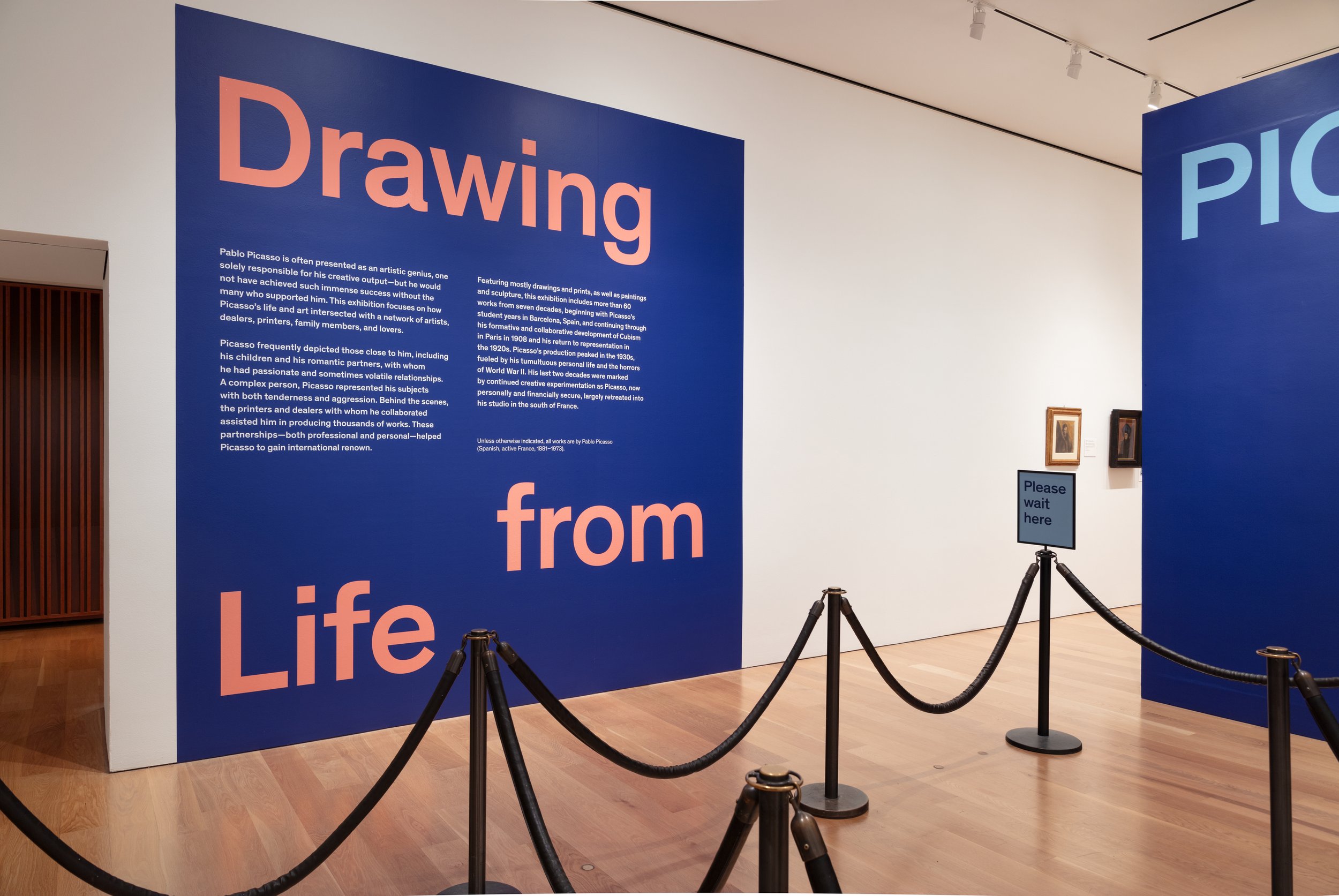
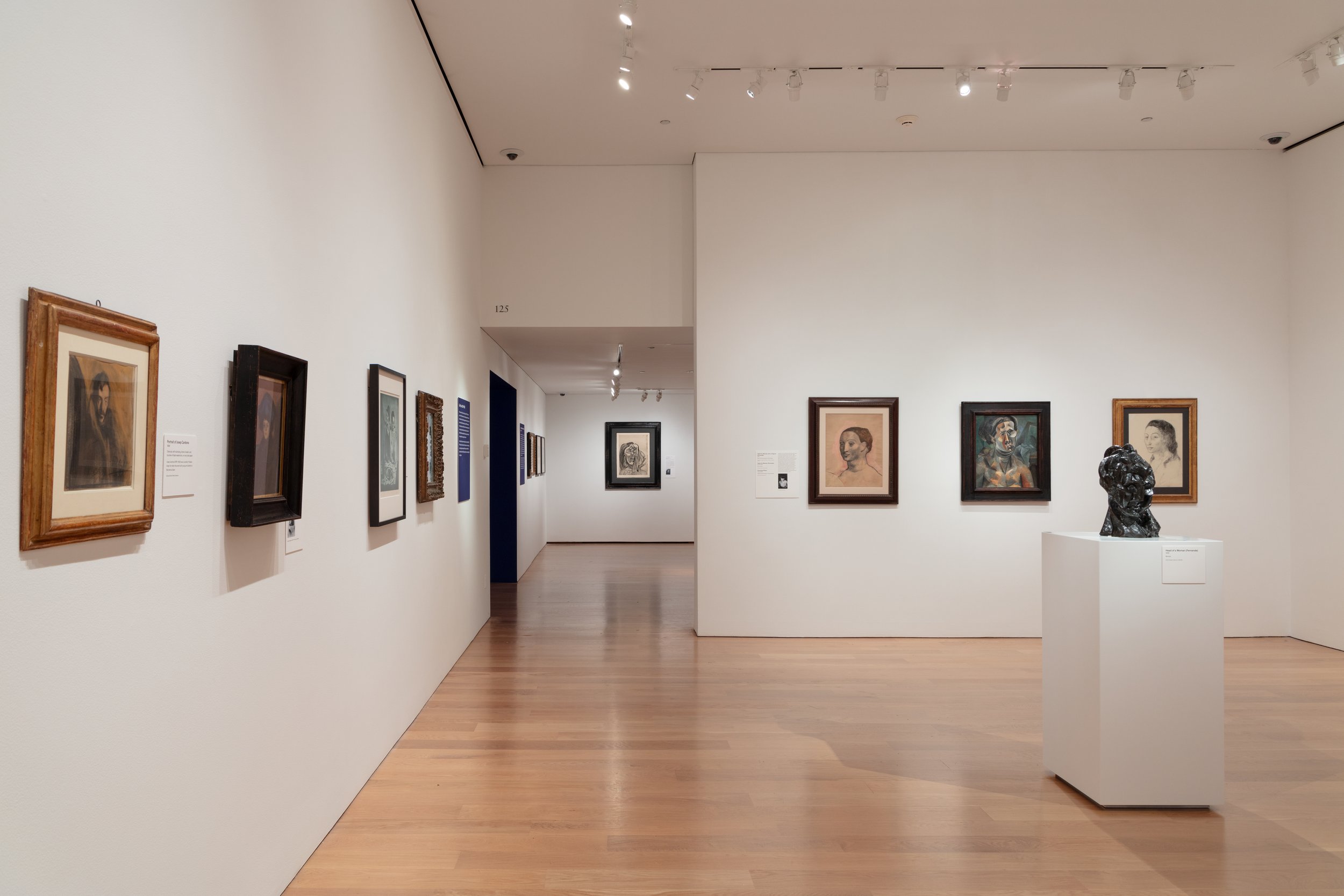
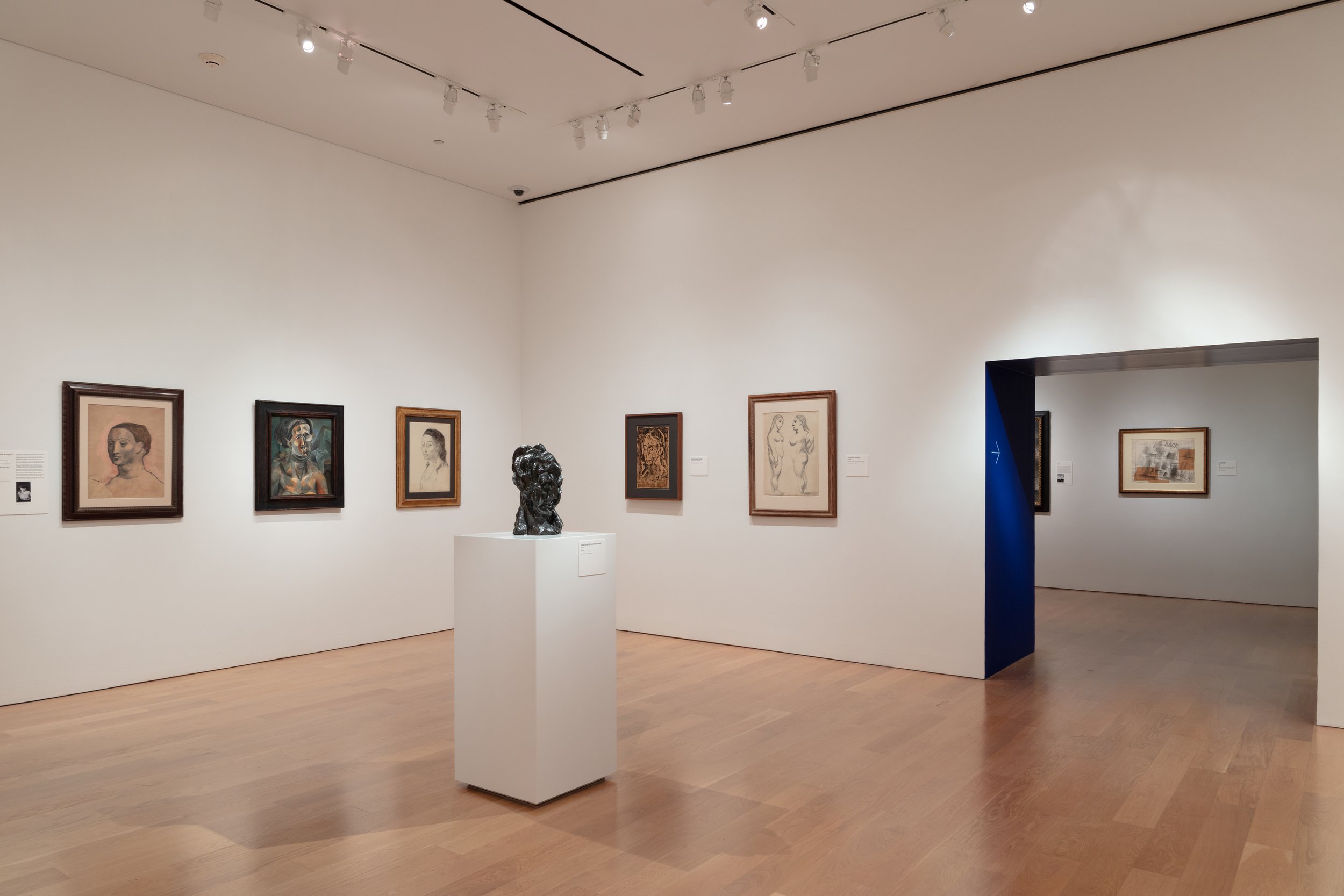
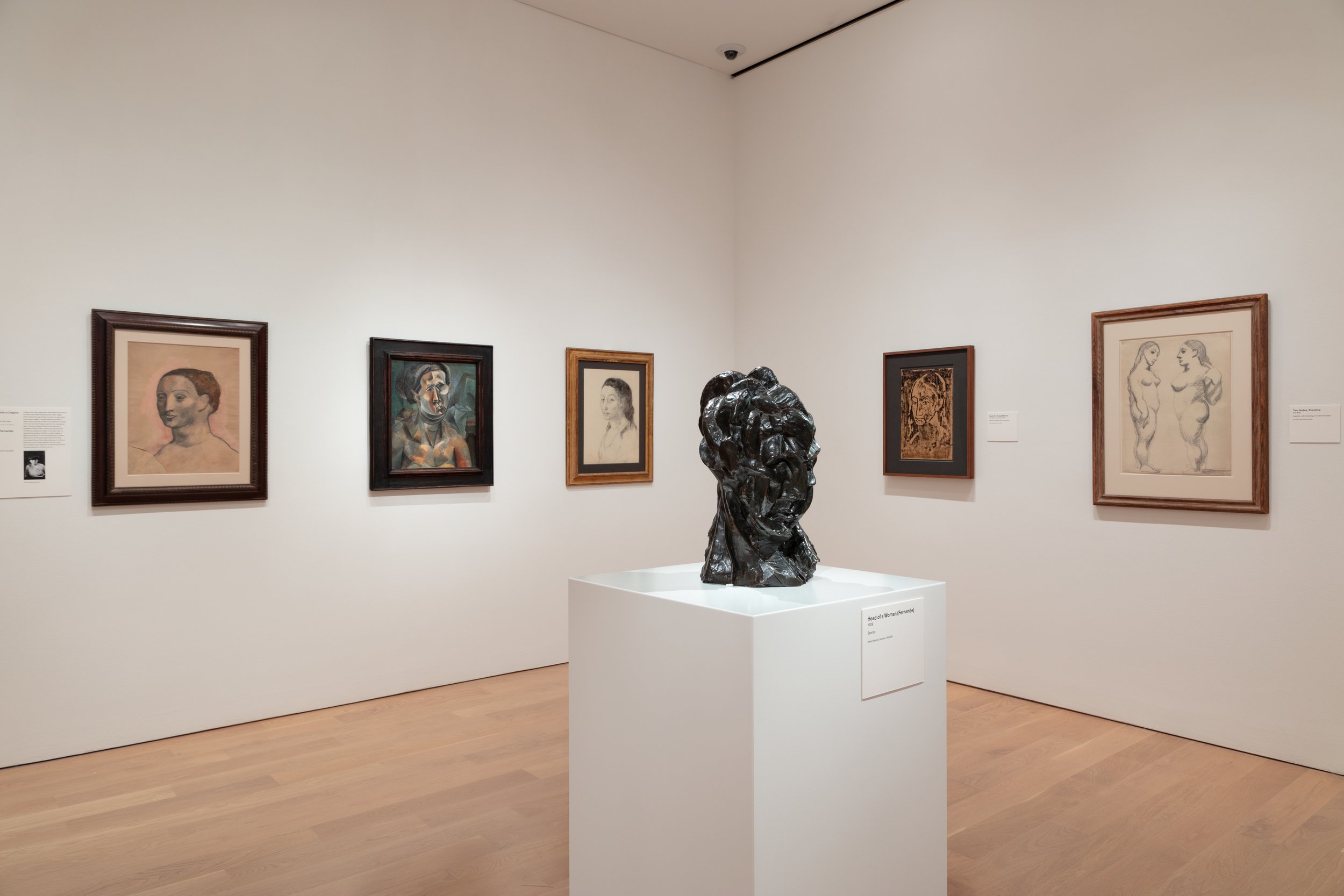
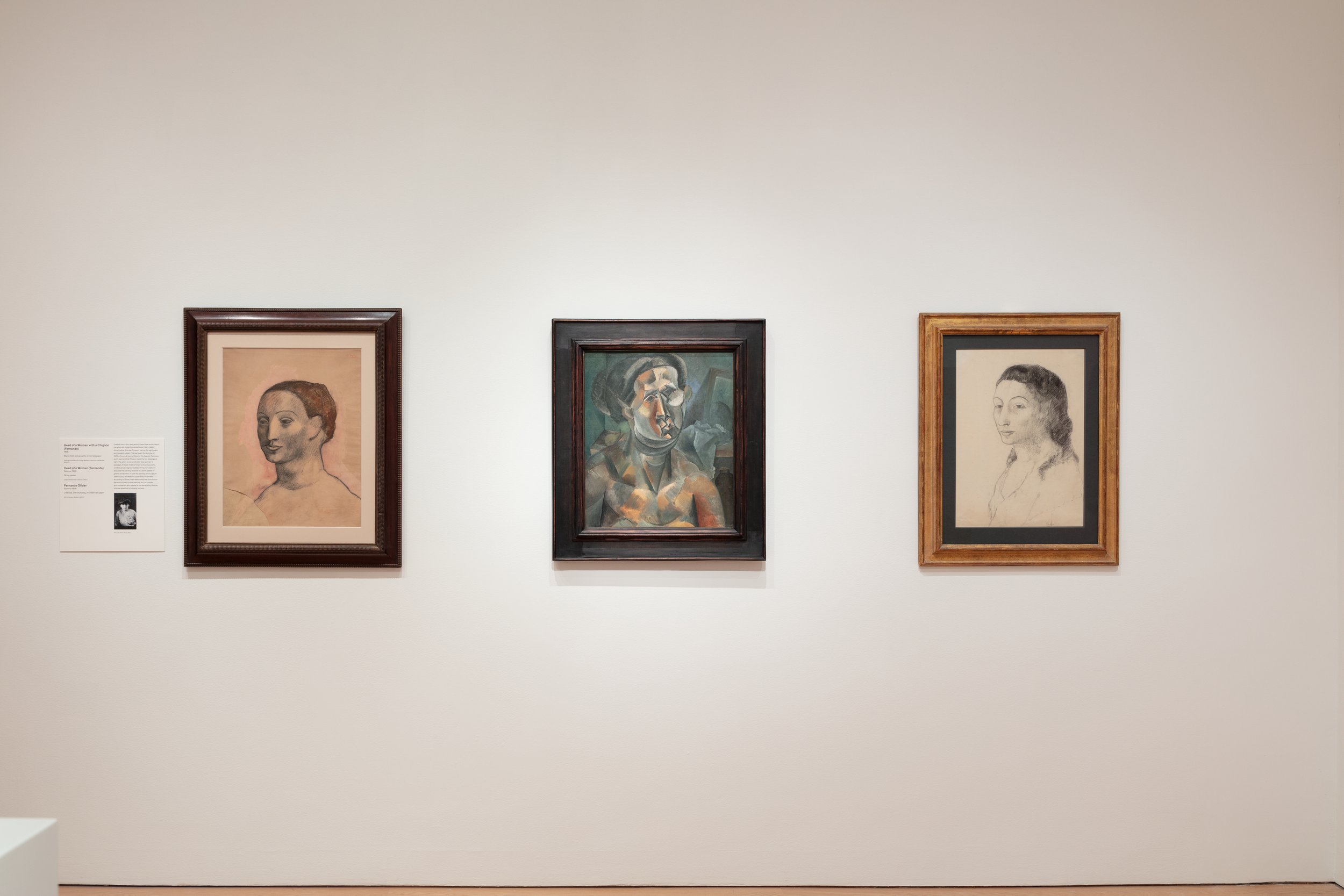
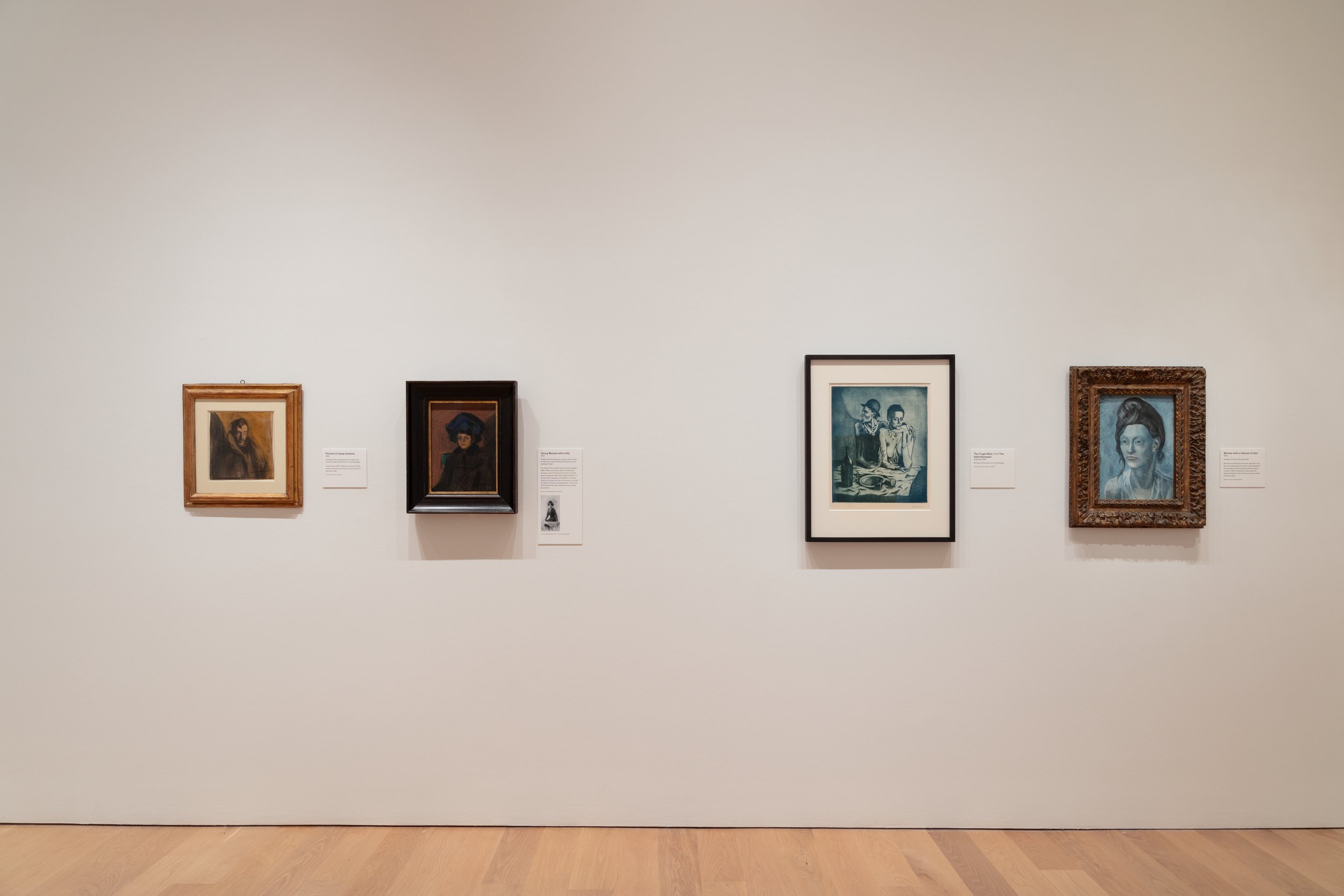
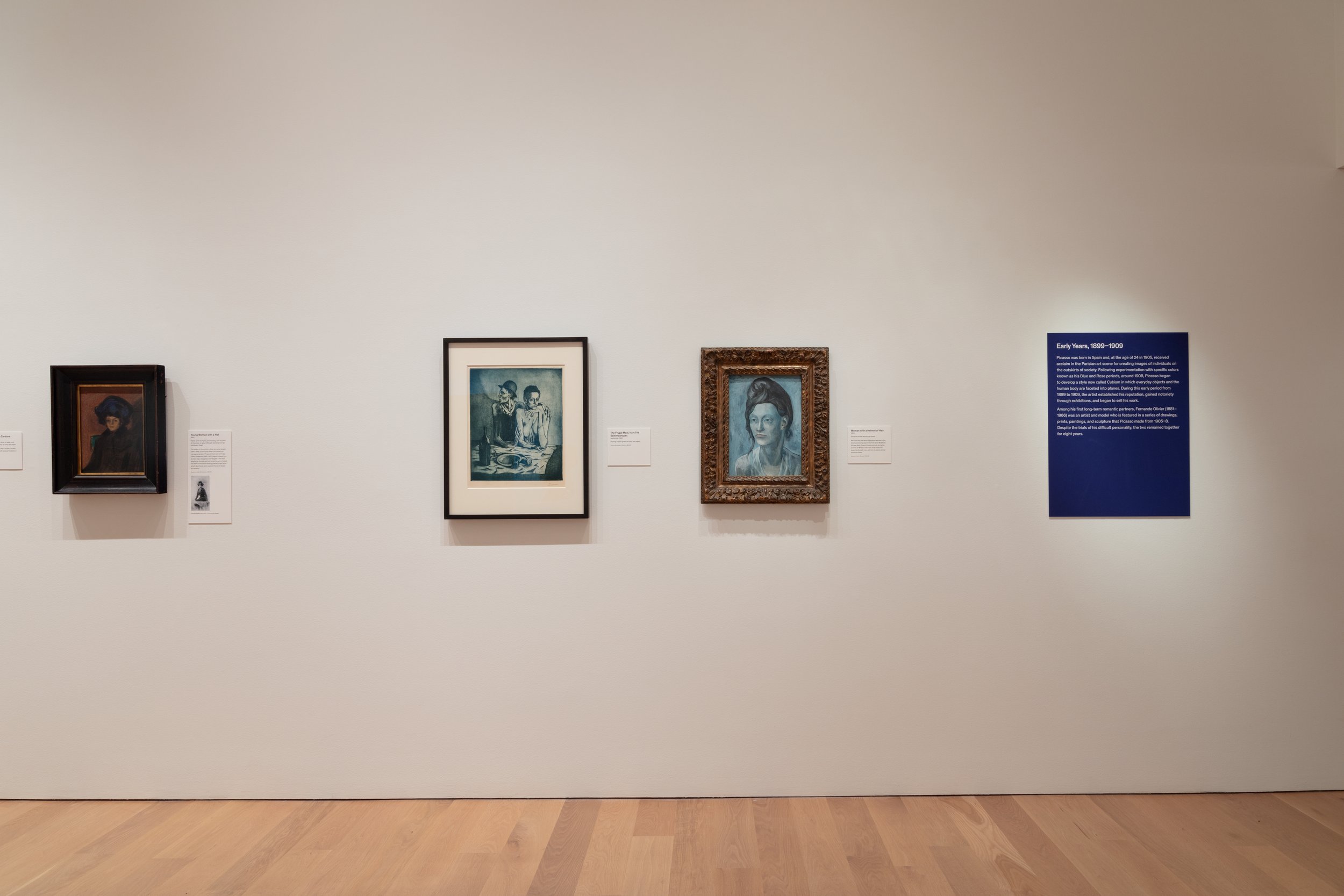
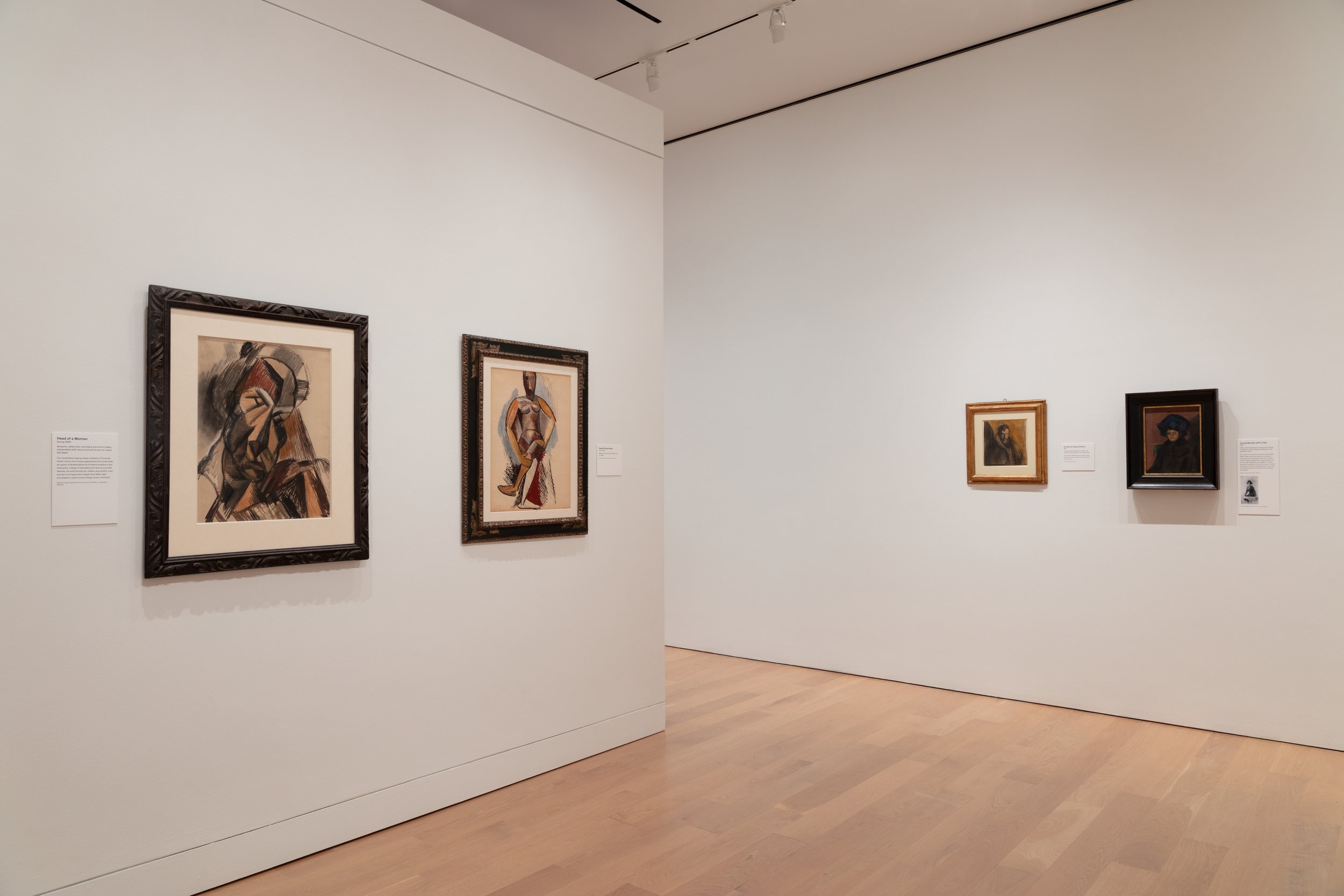
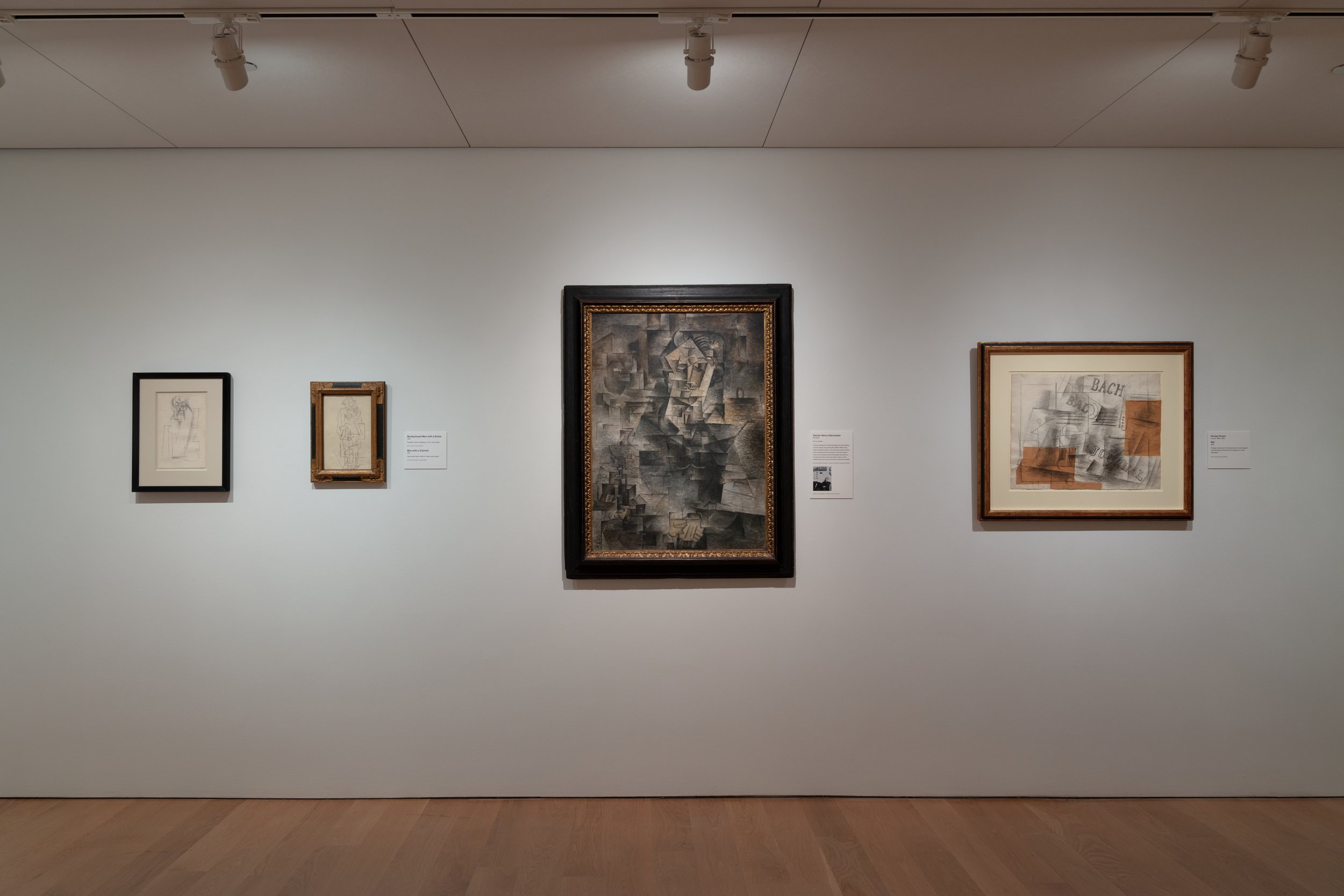
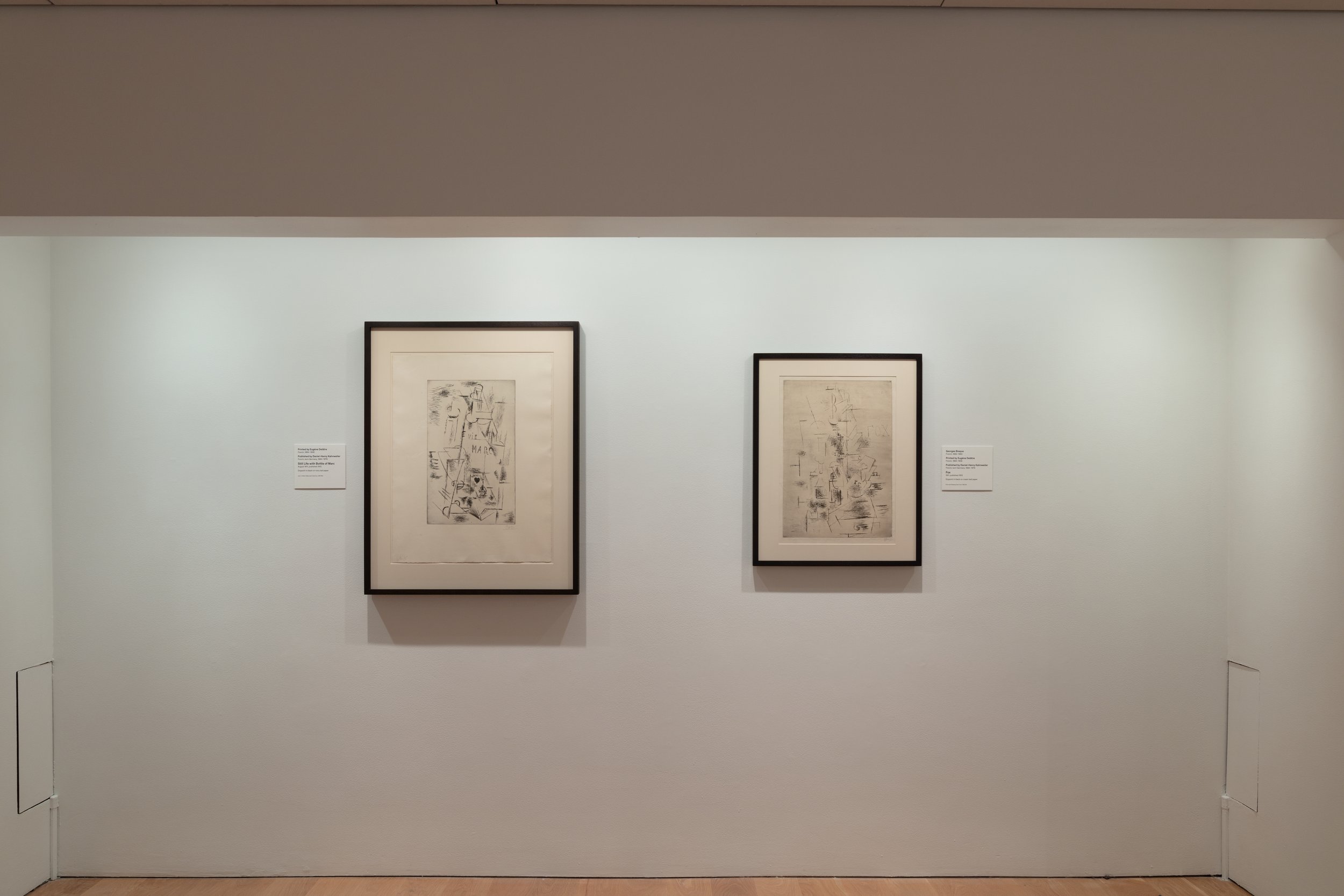
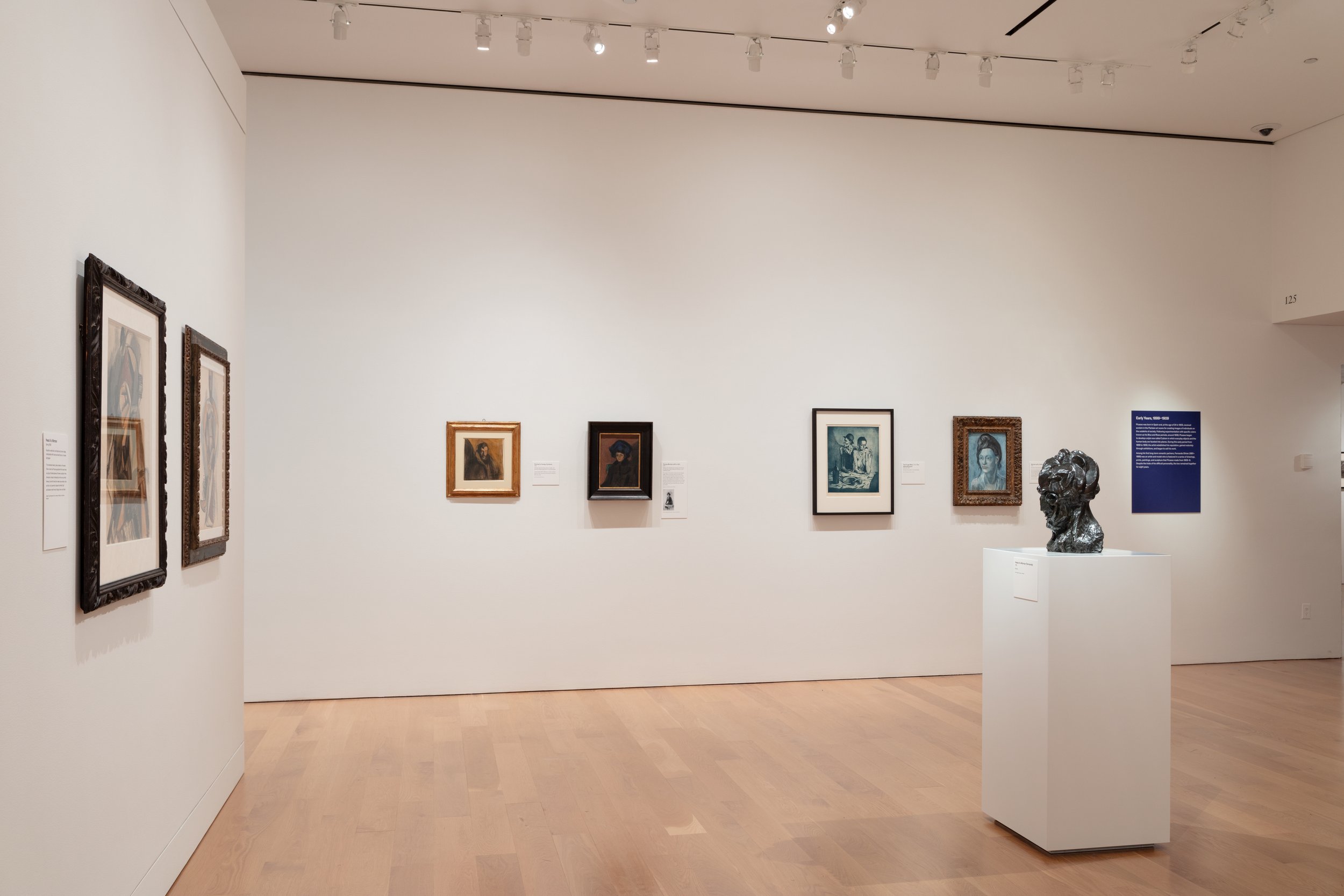
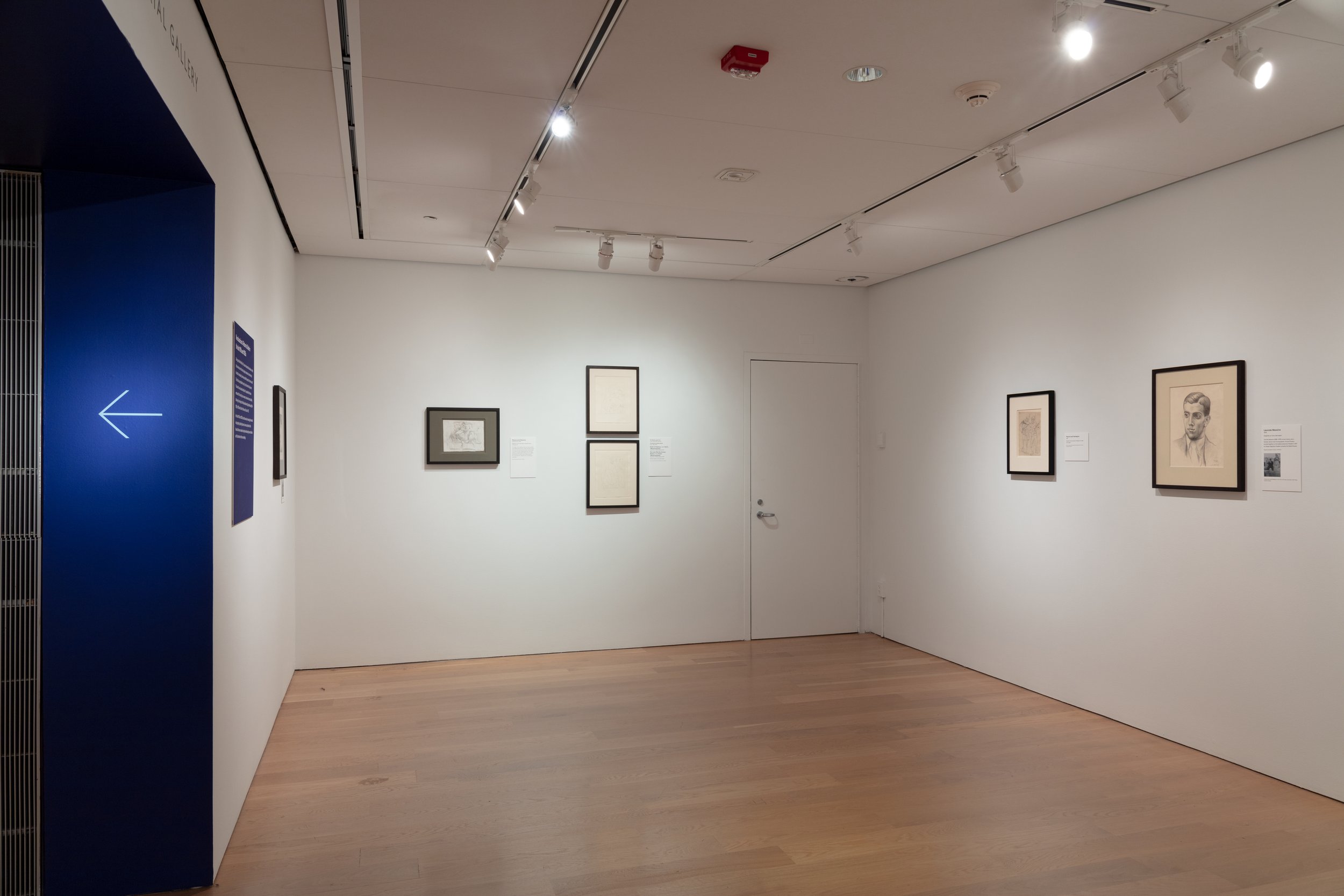
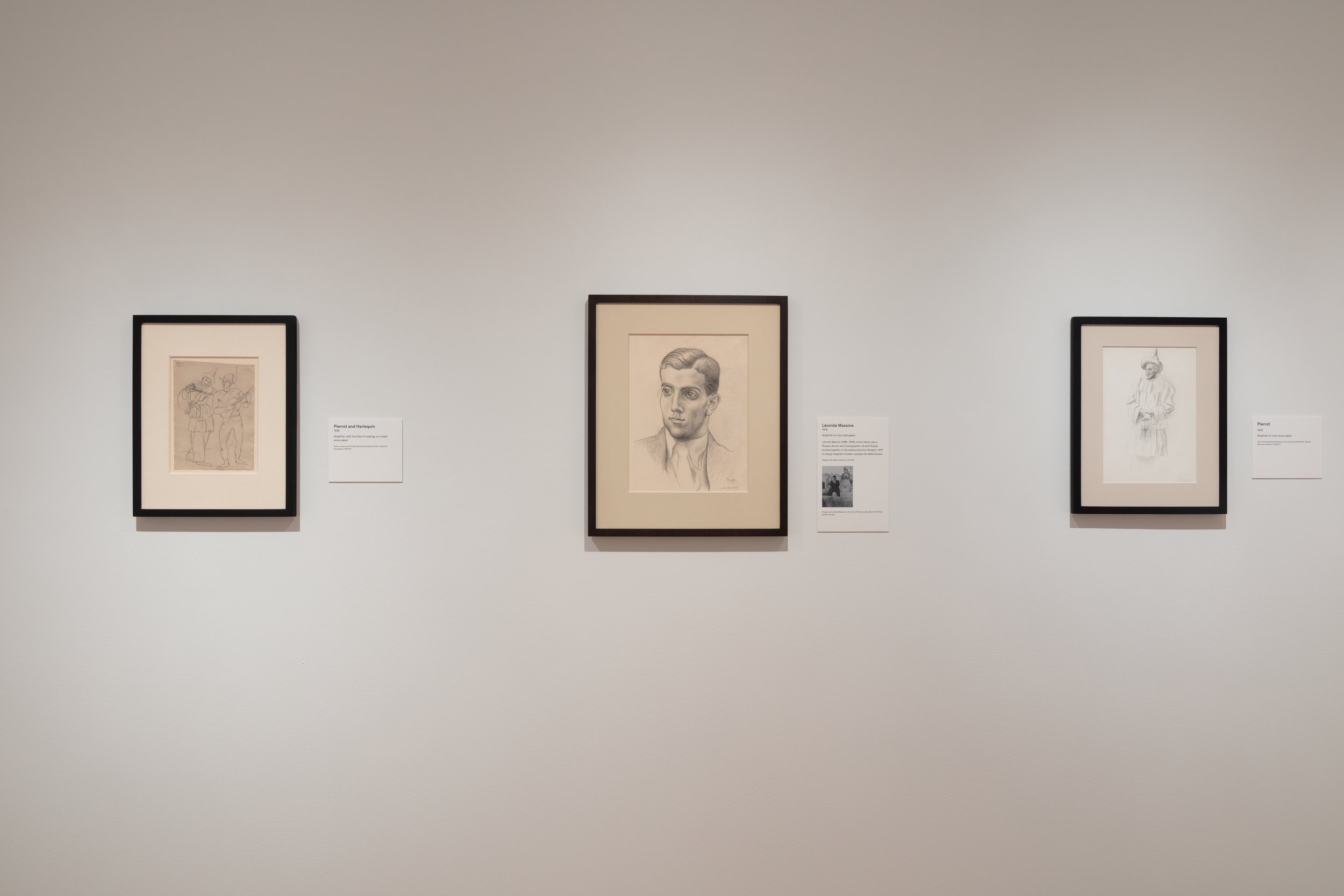
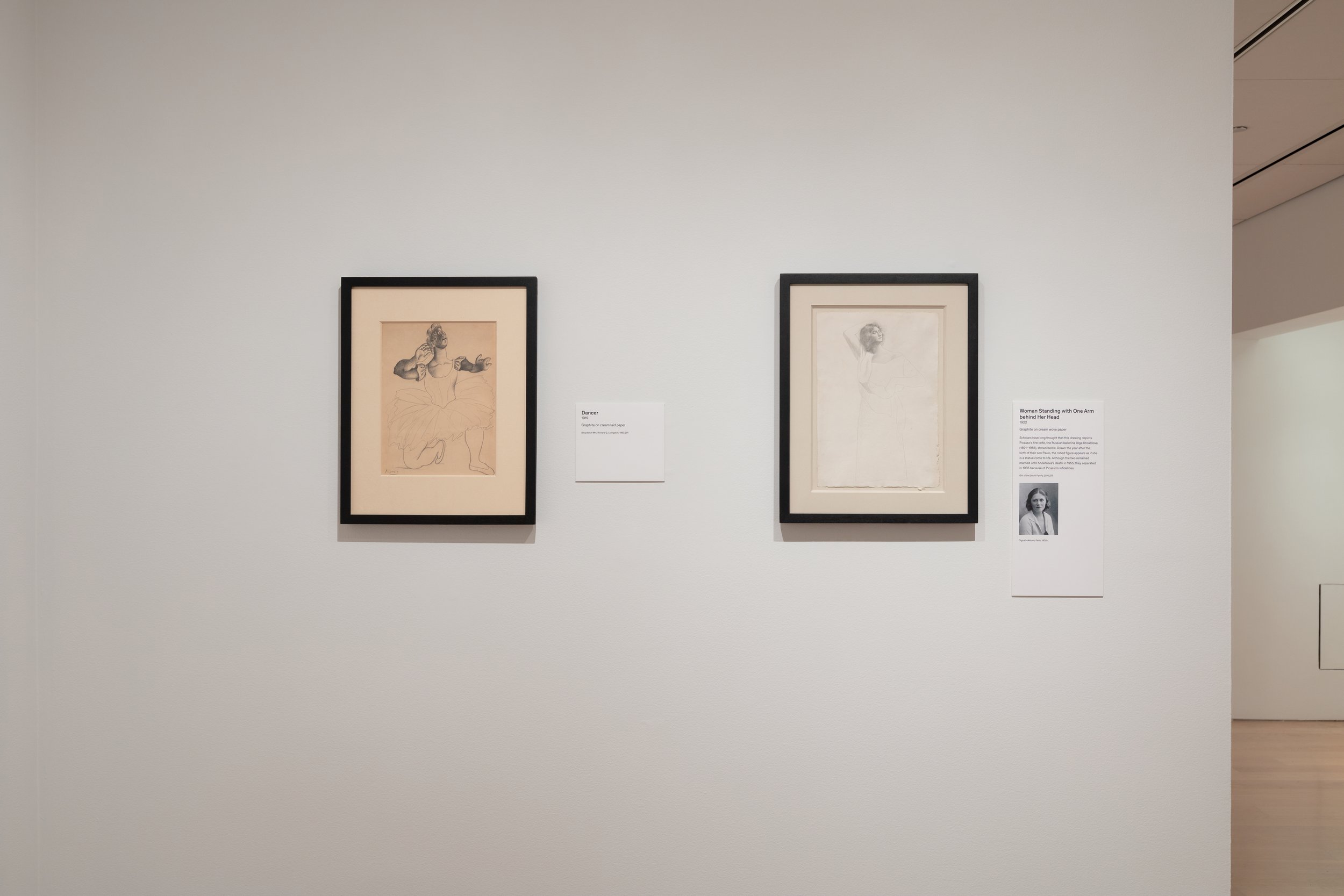

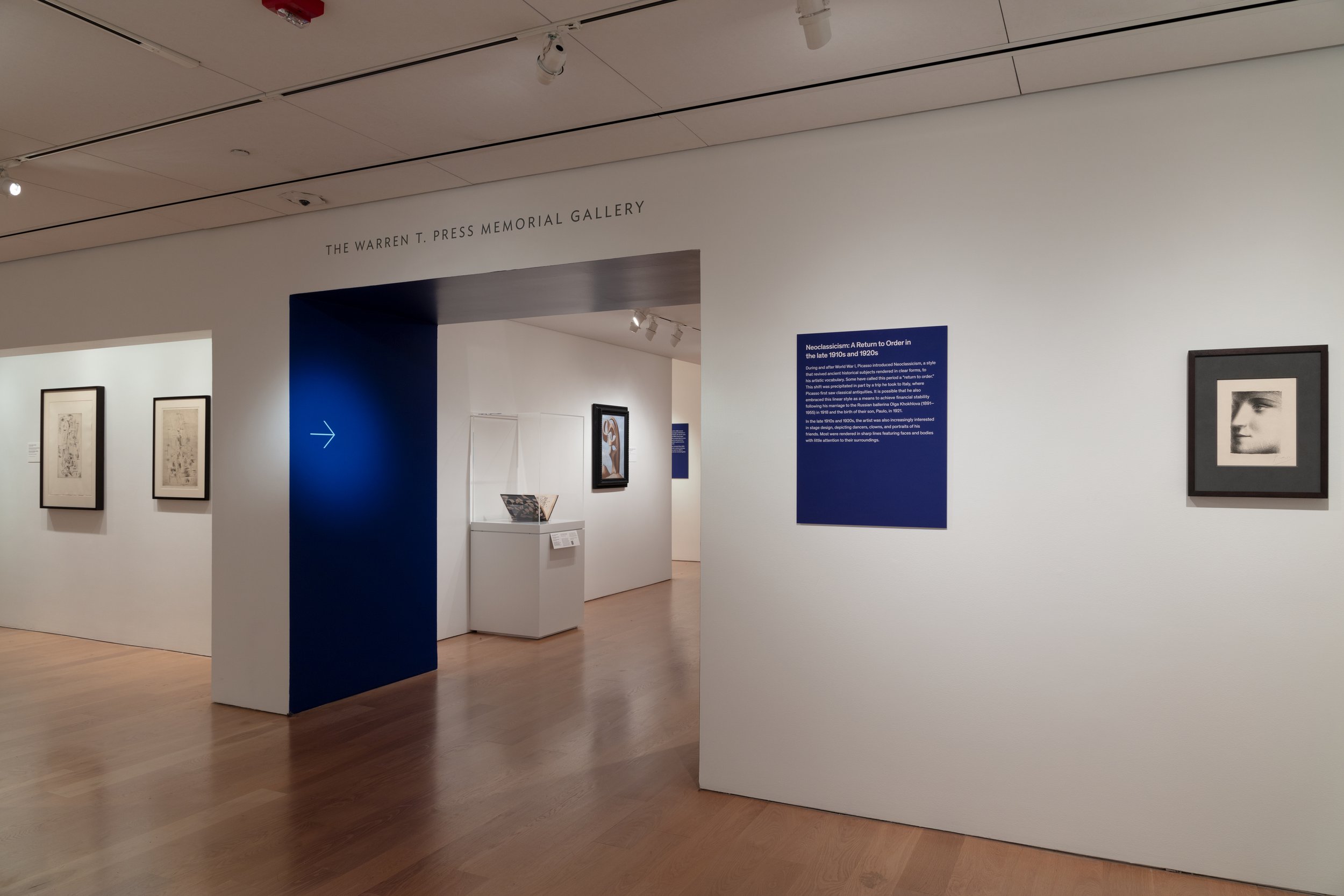
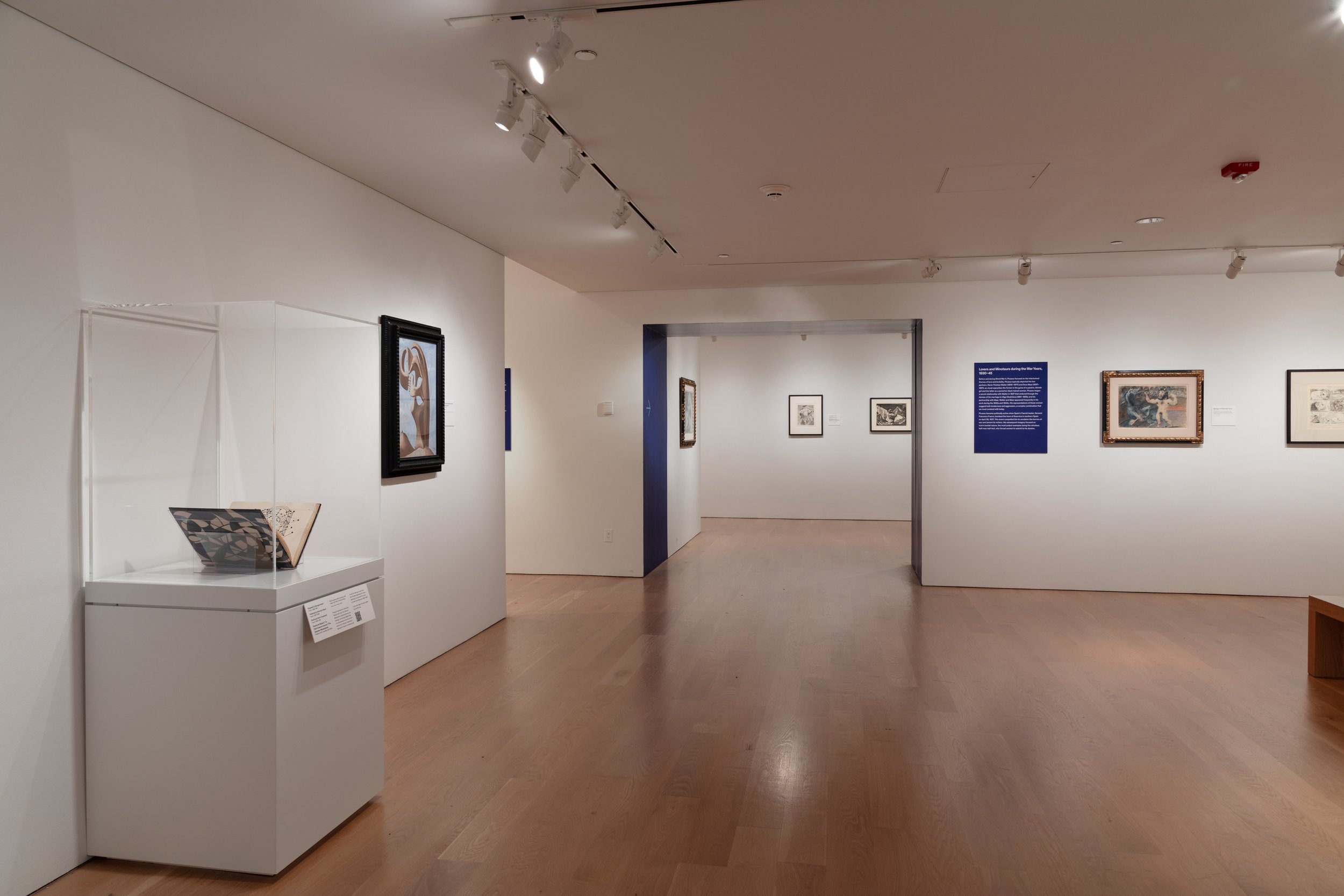
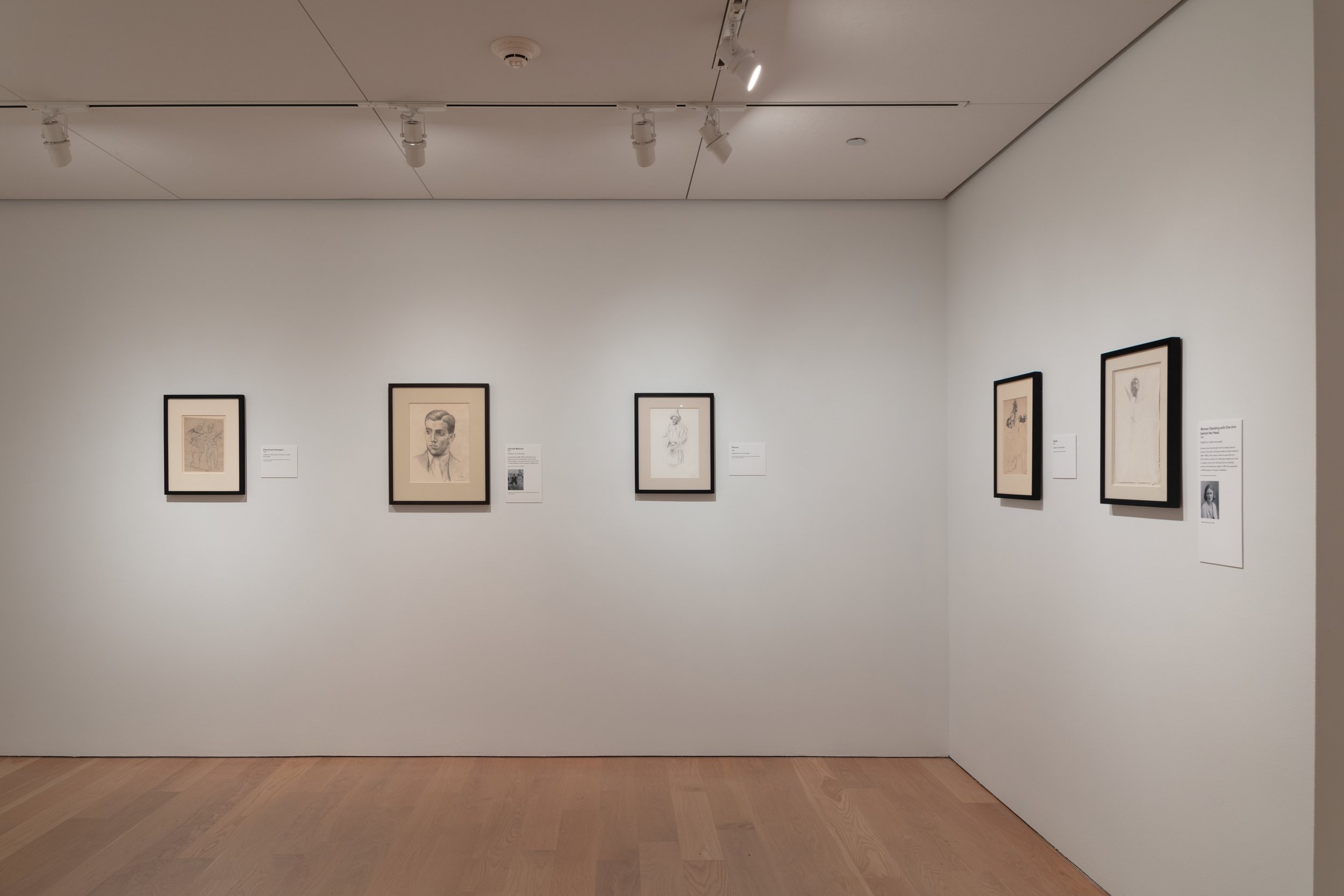


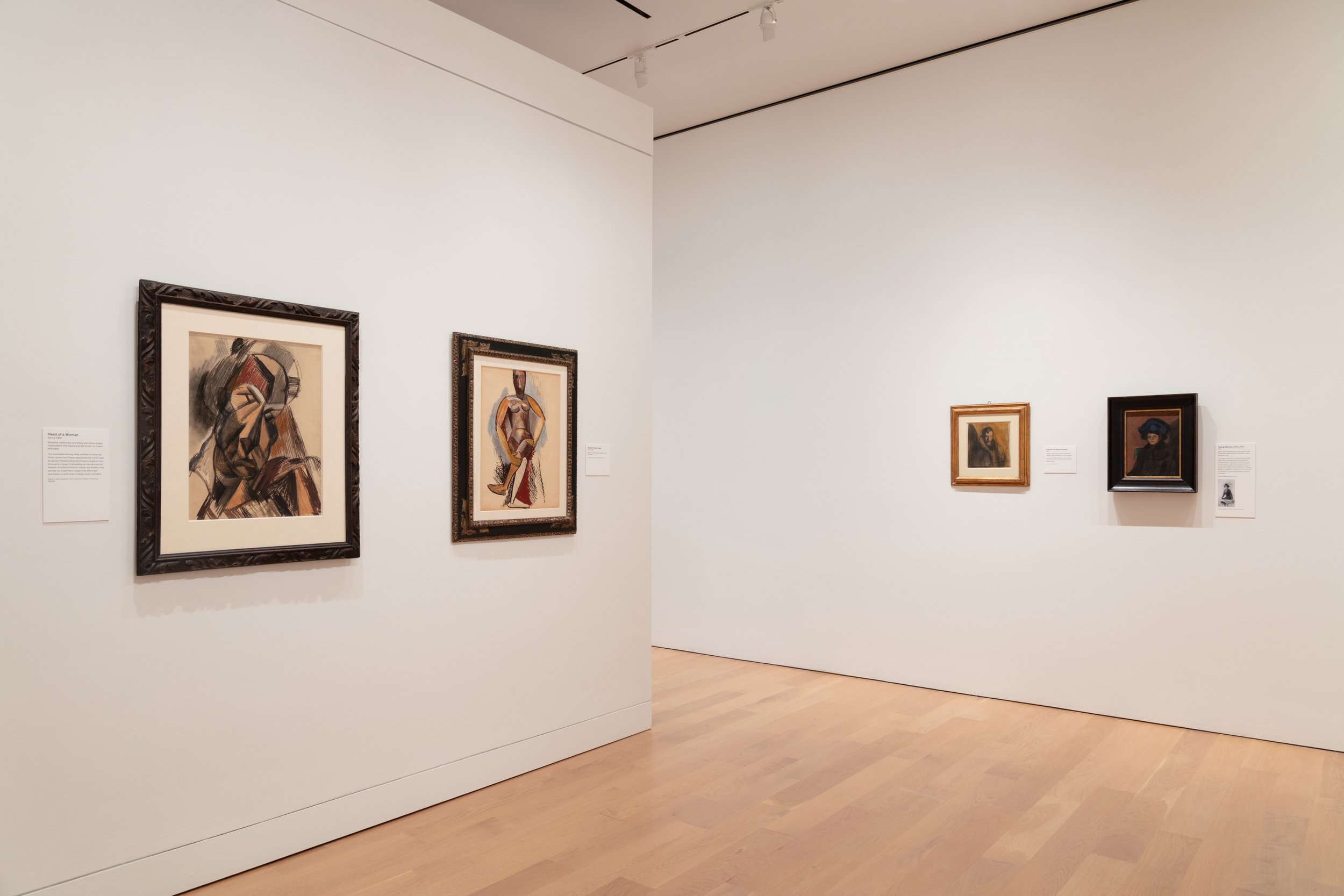
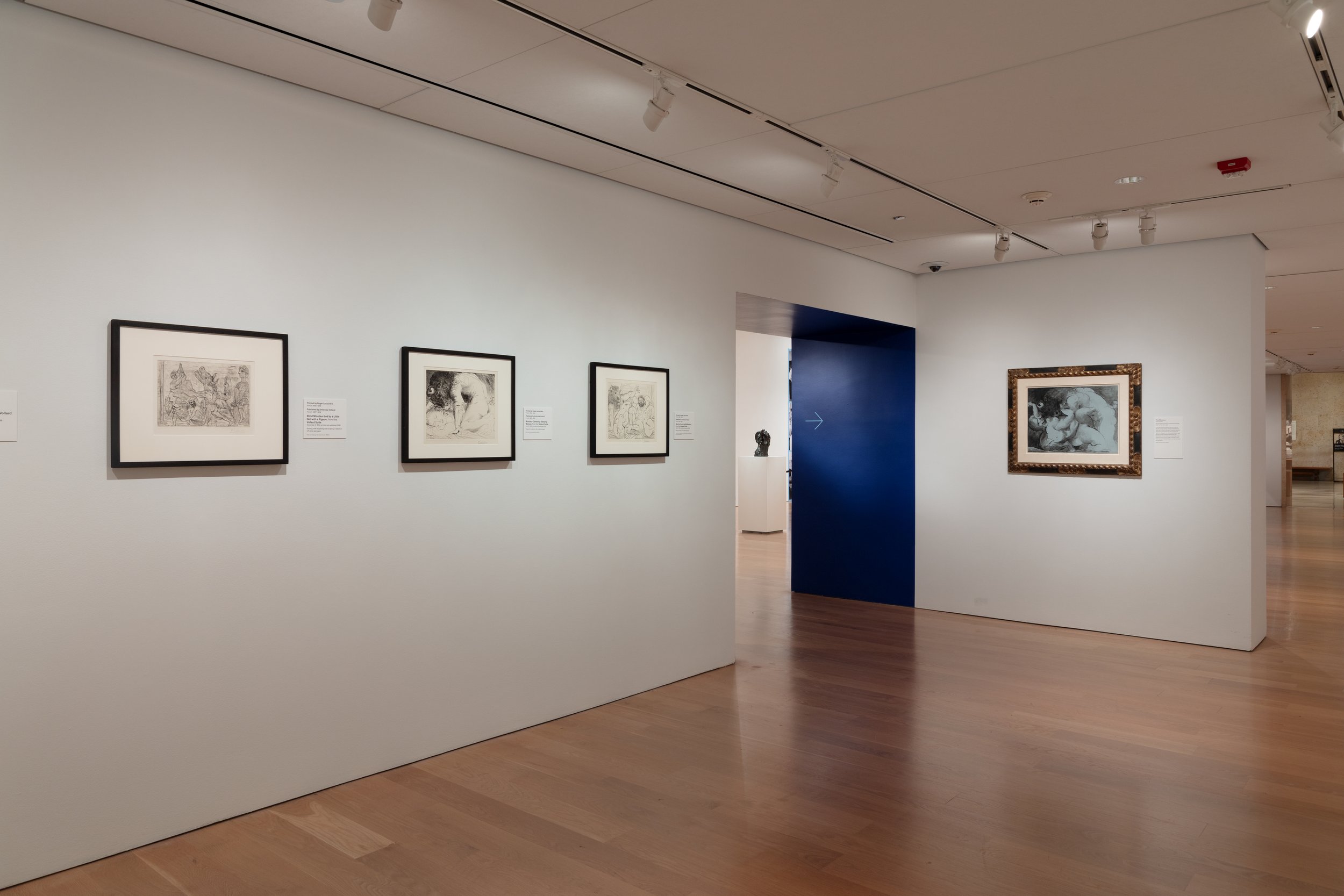

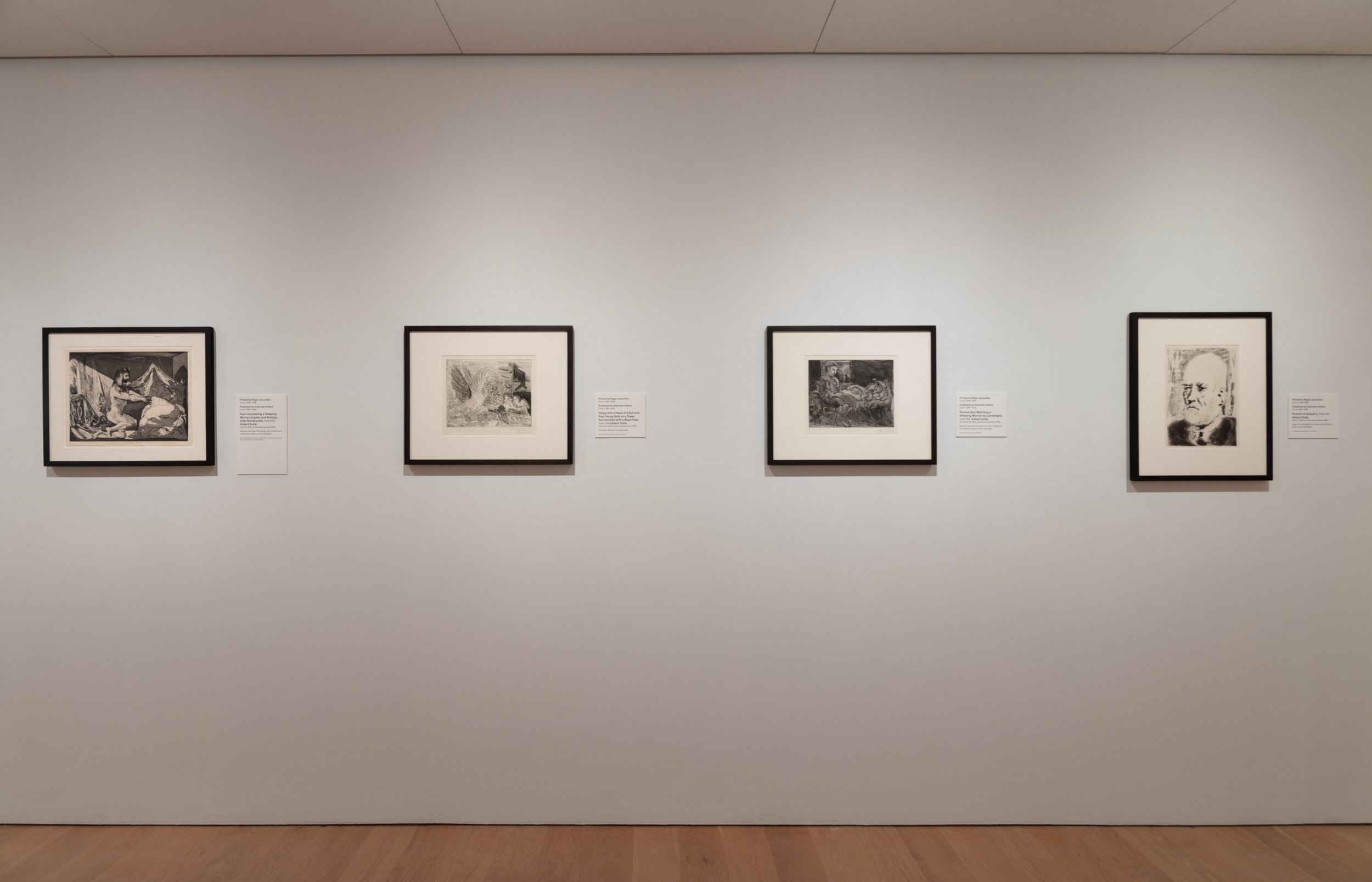
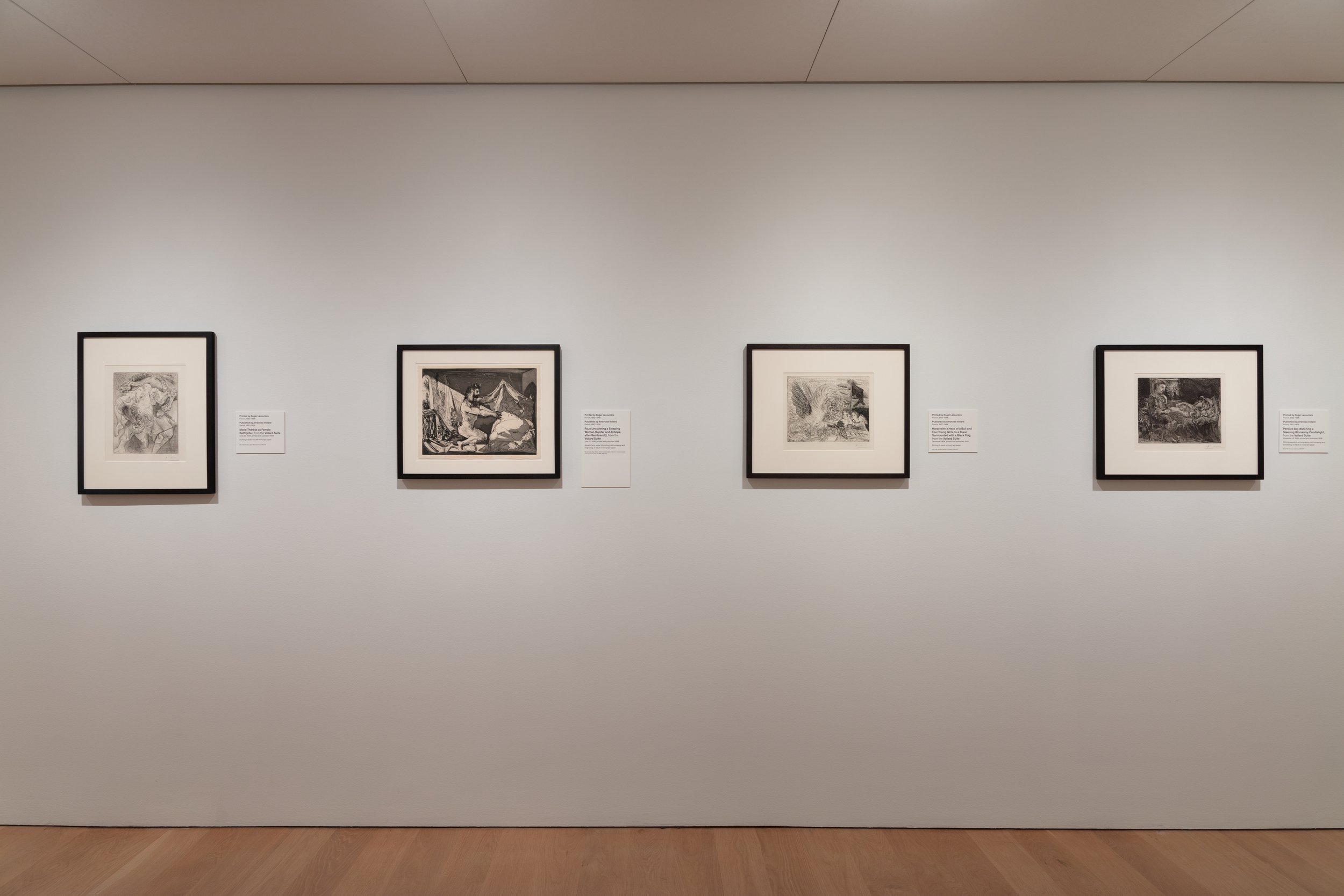
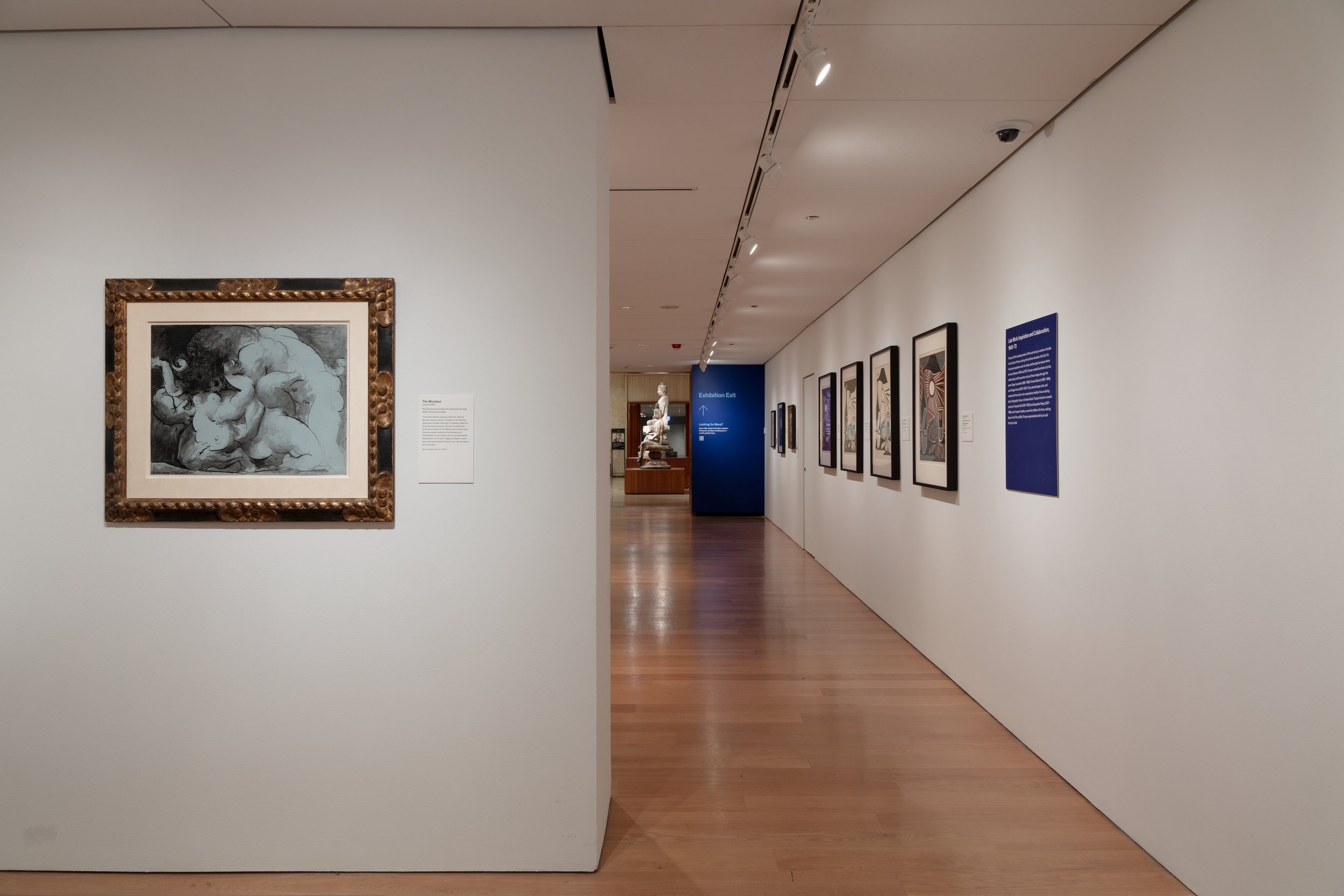
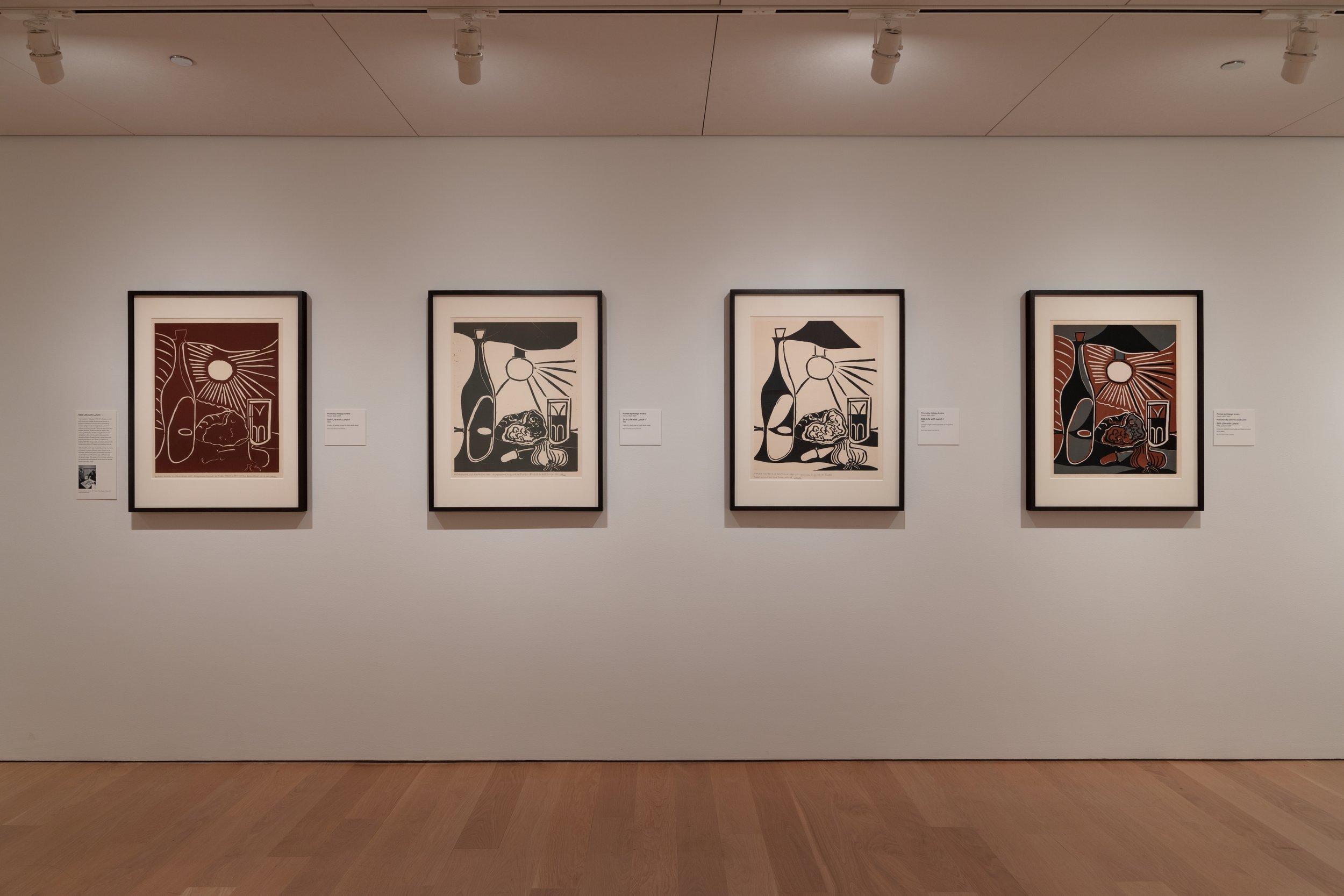
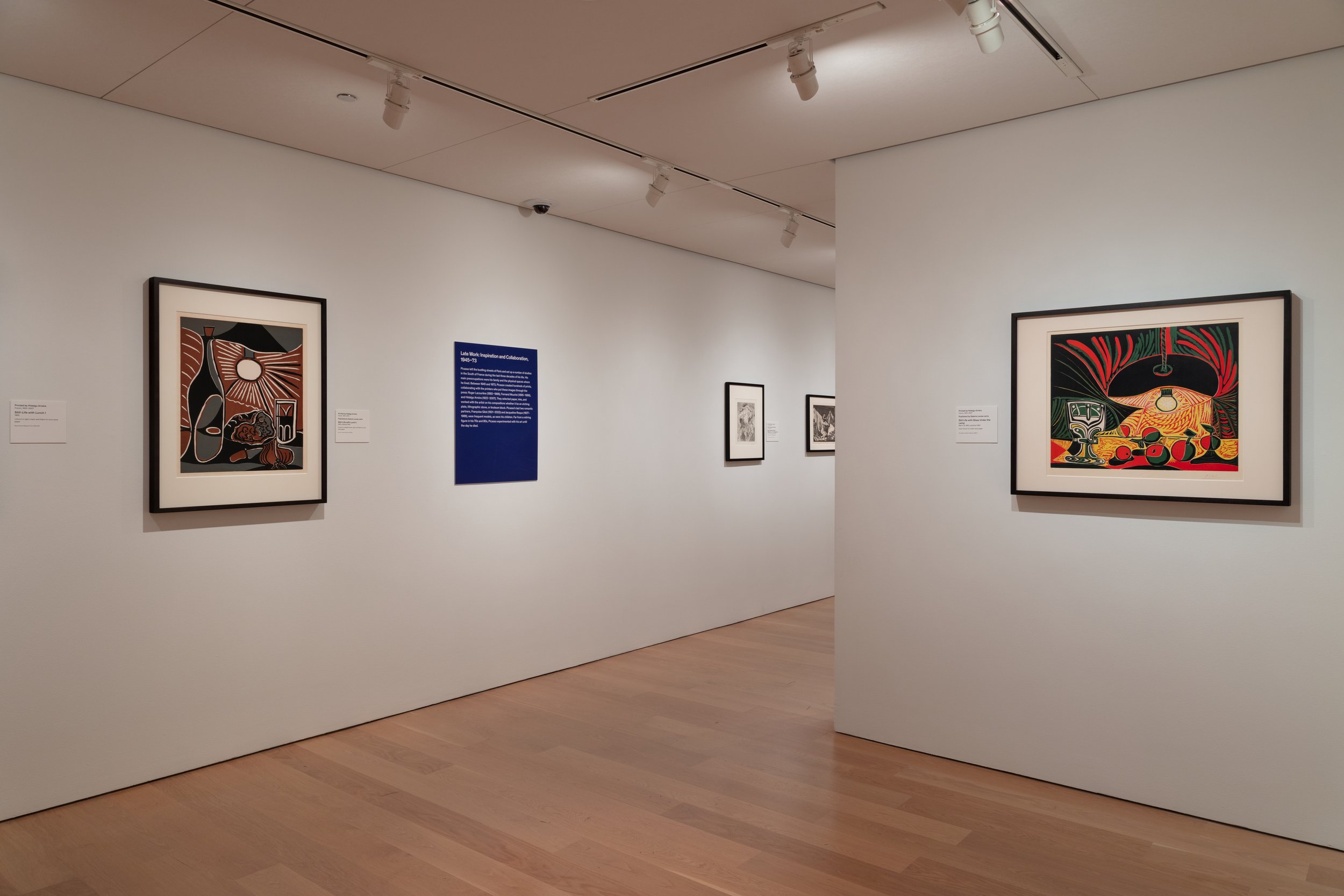
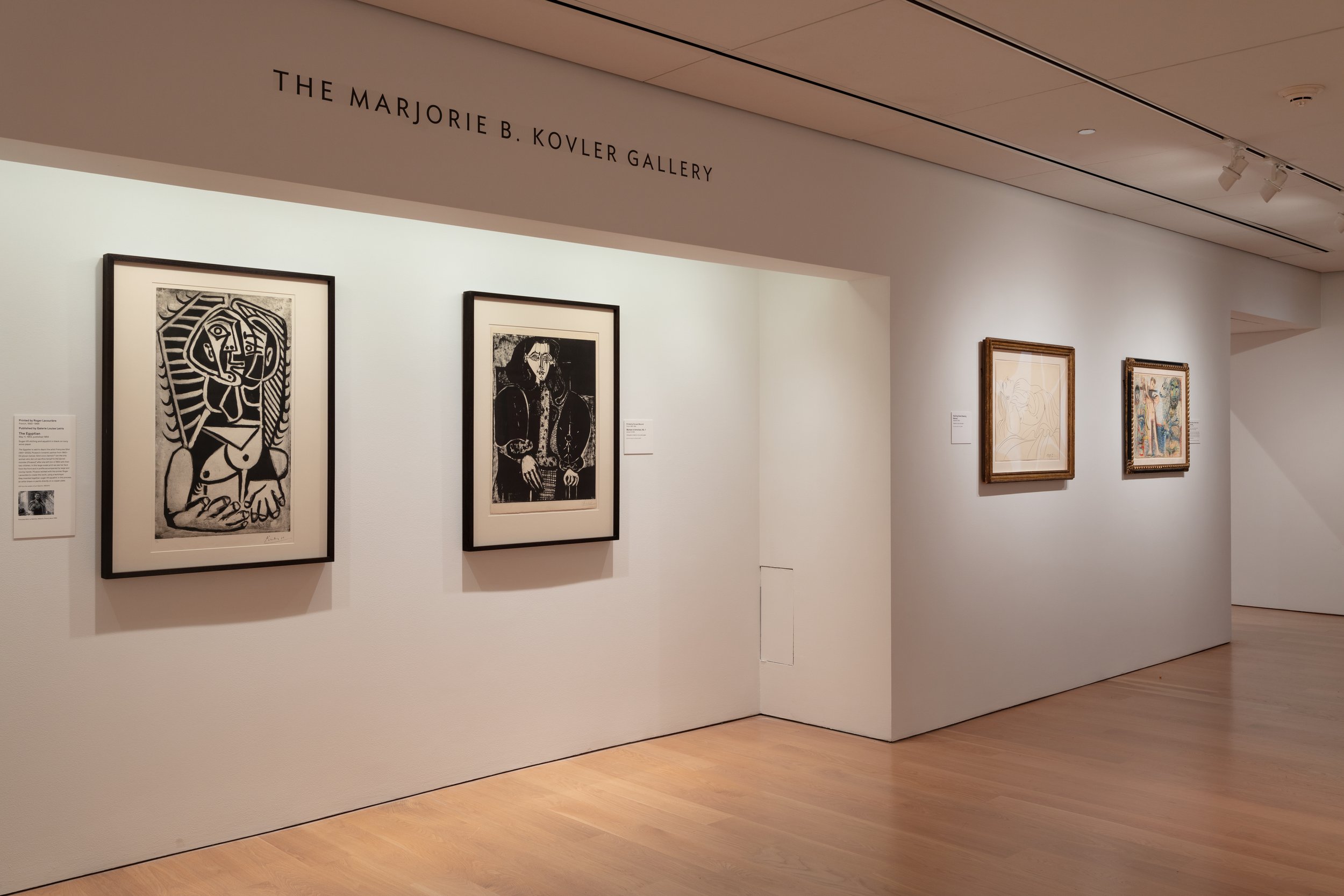
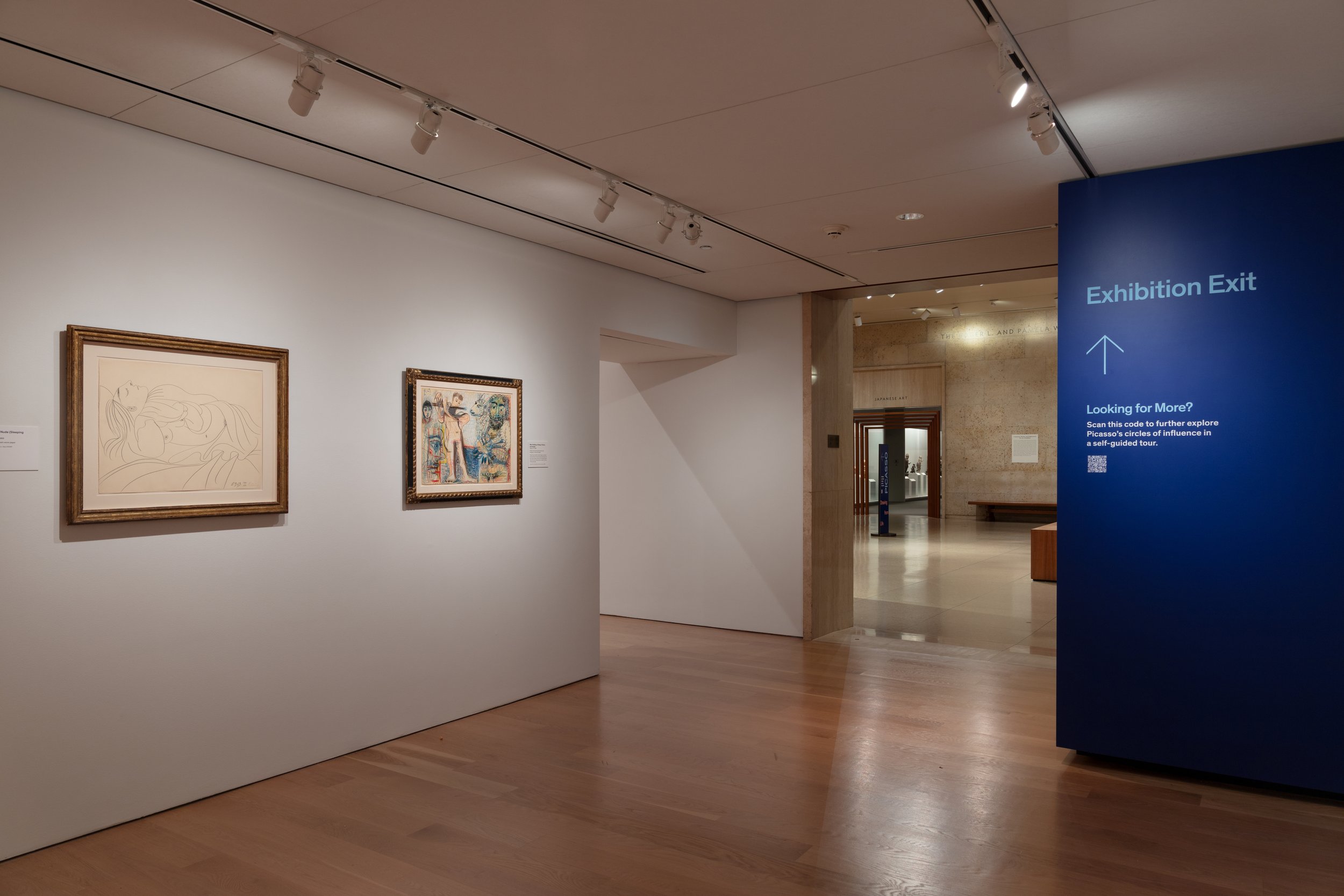
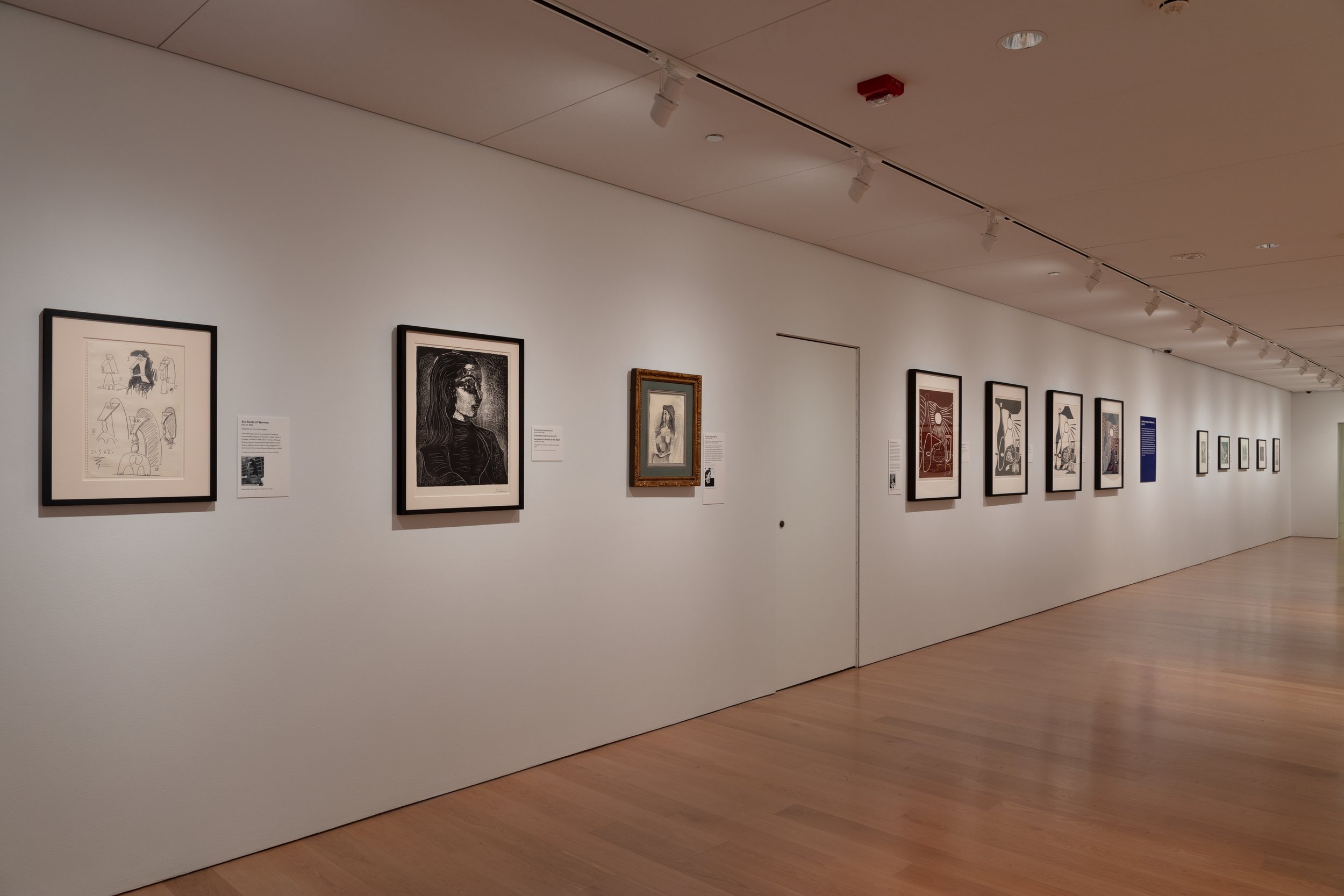
Installation view: Picasso: Drawing from Life, 2024. The Art Institute of Chicago, Chicago. Courtesy of The Art Institute of Chicago.
Organized chronologically, the exhibit highlights those who influenced him at different points in time, including his gallerist Daniel-Henry Kahnweiler, fellow artist George Braque, lovers including Fernande Olivier, Marie-Thérèse Walter, and Dora Maar, and his family.
Installation view: Picasso: Drawing from Life, 2024. The Art Institute of Chicago, Chicago. Courtesy of The Art Institute of Chicago.
“A lot of his art gets lost in the drama of his life, or at least what people think they know about his life,” said Emily Ziemba, Director of Curatorial Administration and Research Curator, Prints and Drawings. “But he made his amazing works of art aided by a fascinating group of people around him.”
Picasso: Drawing from Life is curated by Jay A. Clarke and Emily Ziemba
For more information about the exhibition and other exhibitions, please visit The Art Institute of Chicago's website here. The institute can also be found on Facebook, Instagram, and YouTube.
Radical Clay: Contemporary Women Artists from Japan
Installation view: Radical Clay: Contemporary Women Artists from Japan, 2024. The Art Institute of Chicago, Chicago. Courtesy of The Art Institute of Chicago
CHICAGO—The Art Institute of Chicago is pleased to announce Radical Clay: Contemporary Women Artists from Japan opened on December 16, 2023, and will be on view until June 3, 2024. The exhibition features 40 stunning works by 36 different women artists from across Japan, showcasing the inventiveness and variety of work that is driving the ceramics movement forward.
While women have been historically underrecognized for their contributions to the ceramics field, this show brings both established and emerging women artists to the forefront and focuses on the explosion of innovative and technically ambitious compositions by such artists, particularly since 1970.
Installation view: Radical Clay: Contemporary Women Artists from Japan, 2024. The Art Institute of Chicago, Chicago. Courtesy of The Art Institute of Chicago
“There are so many strong contemporary women artists from Japan that are truly pushing the limits in ceramics and clay beyond what we’ve ever seen traditionally,” said Janice Katz, Roger L. Weston Associate Curator of Japanese Art, the Art Institute of Chicago. “This show brings together artists on the cutting edge of invention in terms of materials, glaze, and technique, and we are thrilled to recognize their contributions to the global ceramics field.”
The creators featured in the show span several generations of women contemporary artists, and while they have been featured in other shows, this is the first major exhibition to position these artists together to highlight their collective achievements and impact. Three artists featured in the show–Mishima Kimiyo (born 1932), Tsuboi Asuka (born 1932), and Ogawa Machiko (born 1946)–began their careers decades ago and continue to produce groundbreaking sculptures that drive the clay medium in a new direction. Konno Tomoko (born 1965), Aoki Katsuyo (born 1972), and Oishi Sayaka (born 1979) are part of younger generations and are represented by pieces featuring bodily distortion to fantastical decoration. These women have routinely confronted expectations about their practice and often refuse gender-imposed constraints in their work, approaching subjects in unconventional ways.
Installation view: Radical Clay: Contemporary Women Artists from Japan, 2024. The Art Institute of Chicago, Chicago. Courtesy of The Art Institute of Chicago
The exhibition is accompanied by a richly illustrated catalog with essays and insights by Janice Katz, Joe Earle, and Hollis Goodall. Additionally, bringing these artists to global attention has been made possible by the generous collaboration with Carol and Jeffrey Horvitz, who shared all of the selected pieces in the show from their exemplary collection.

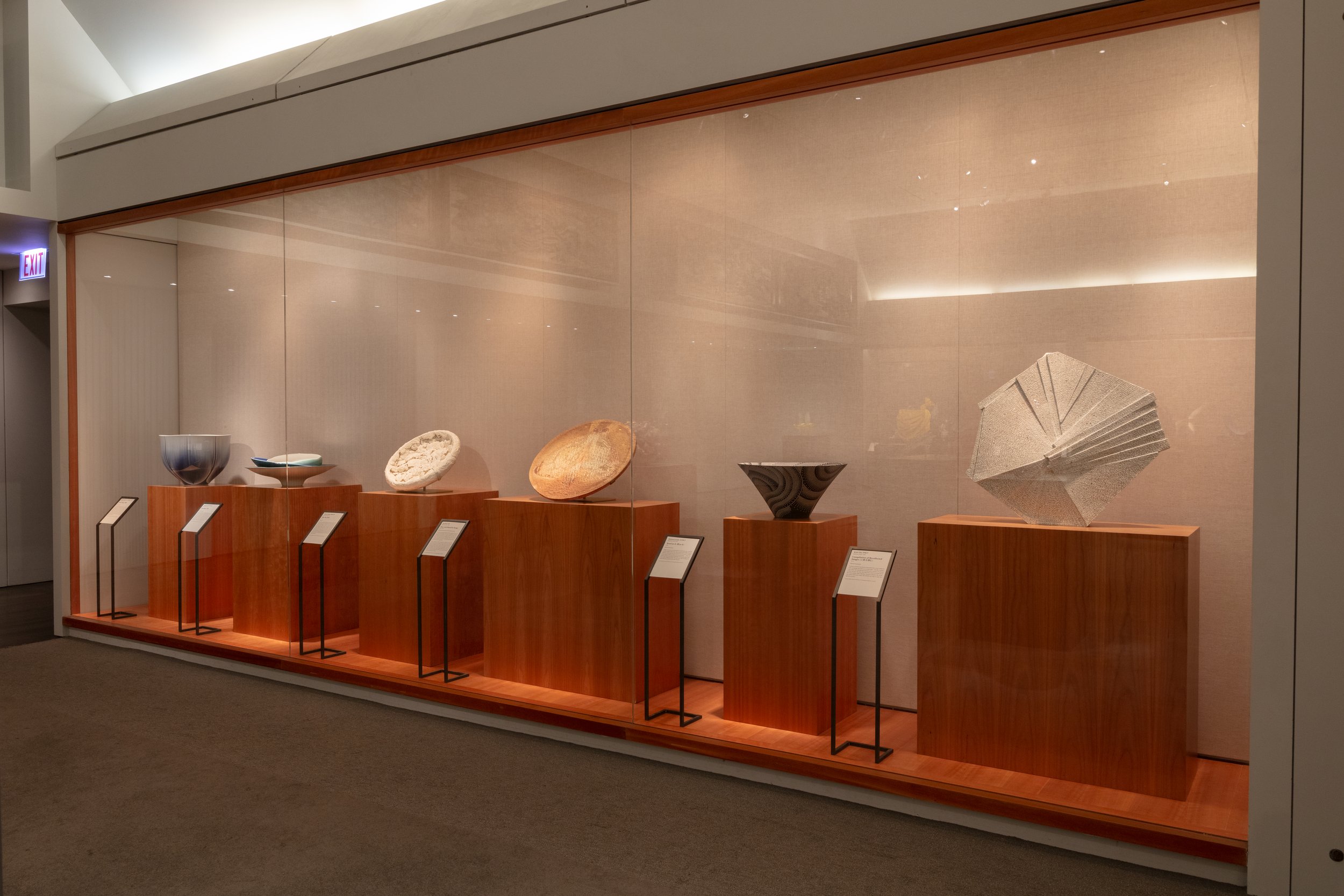


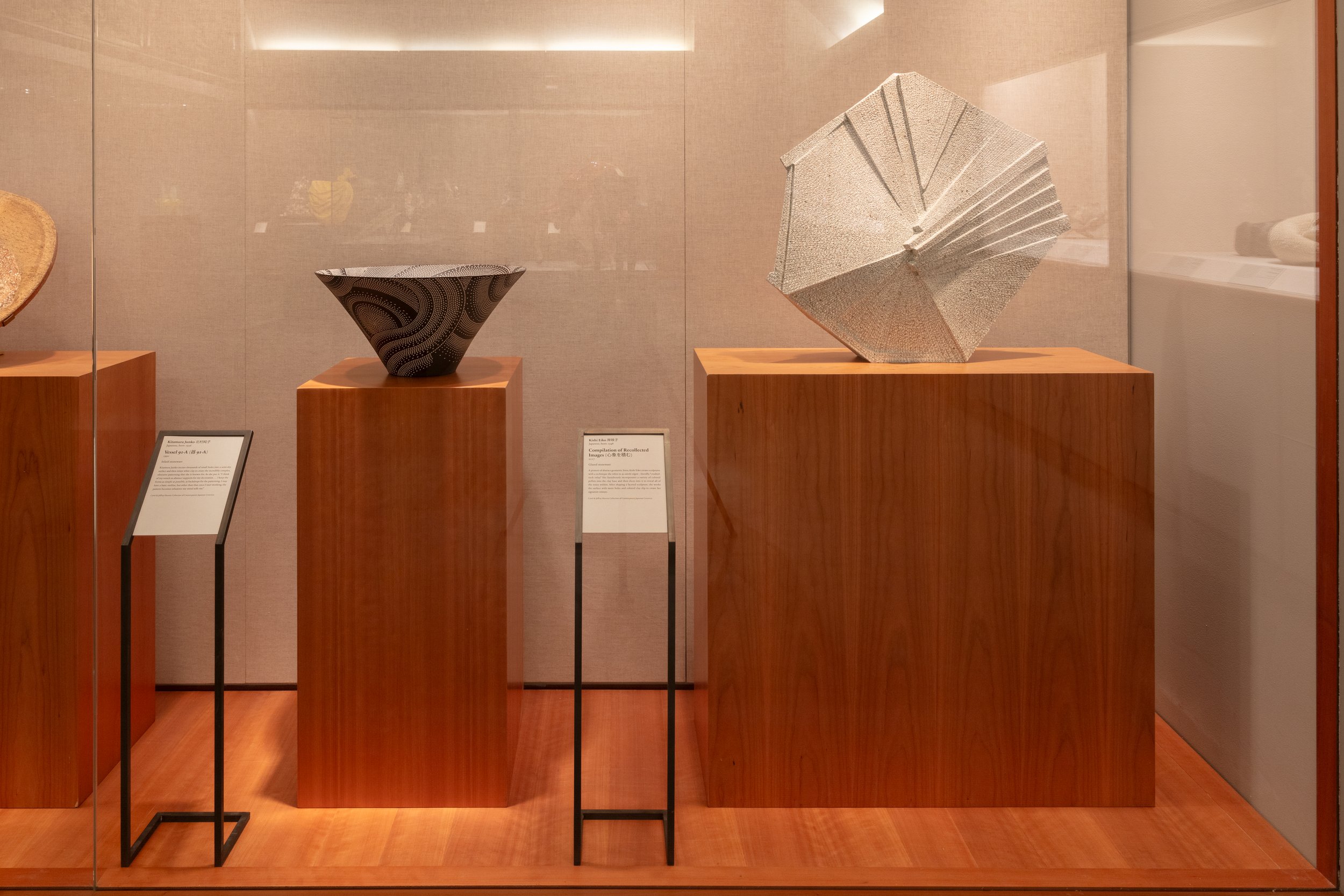
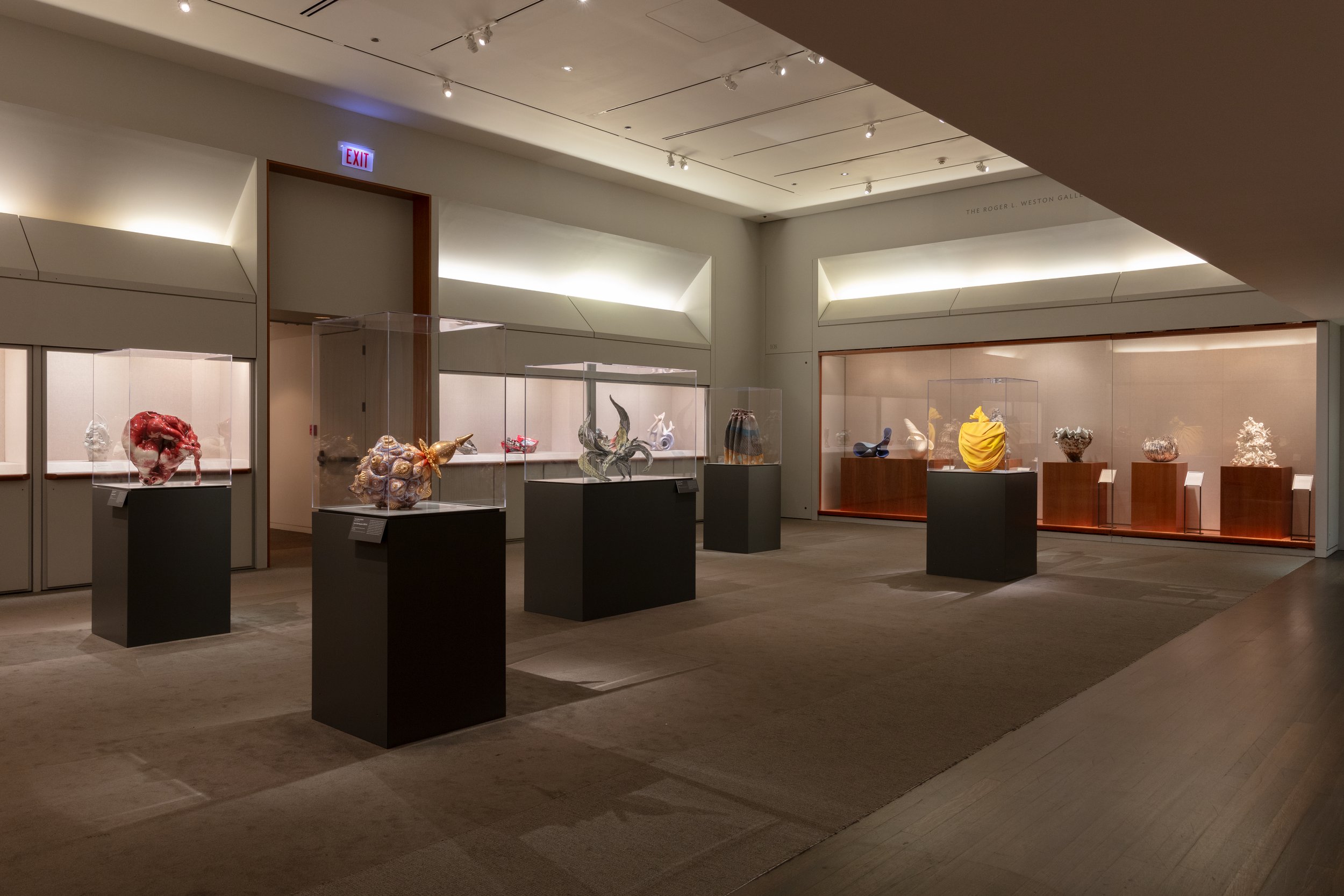

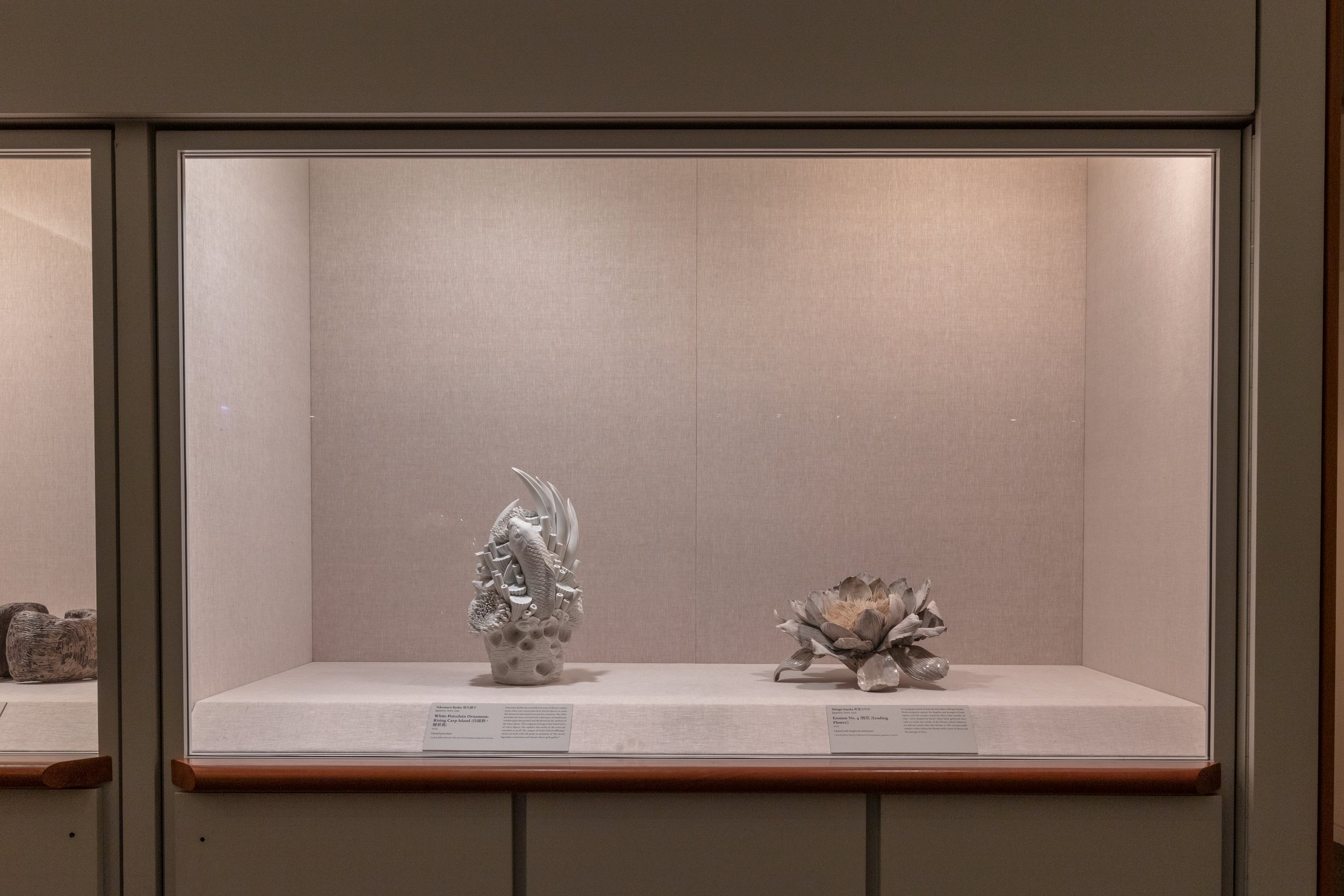
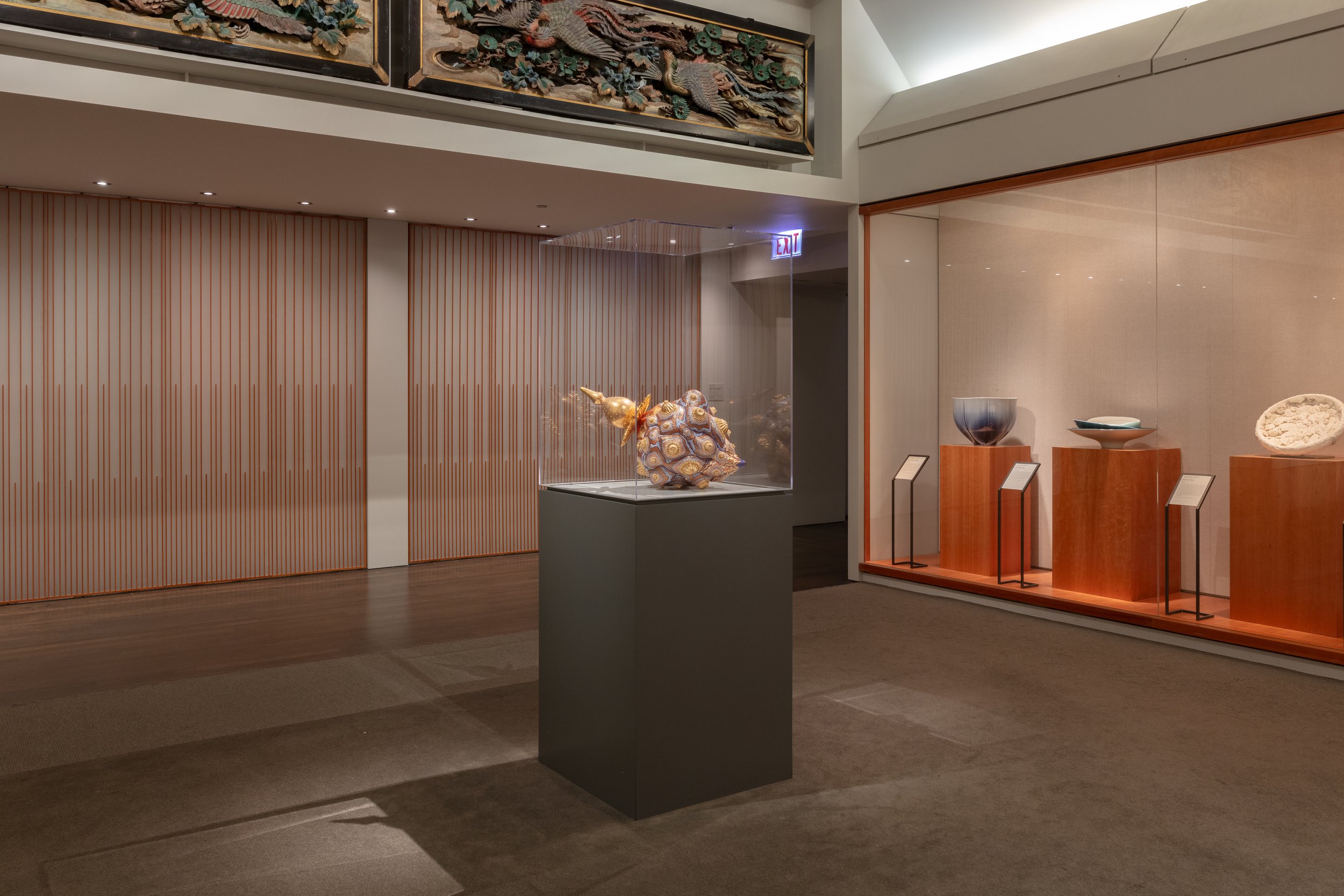
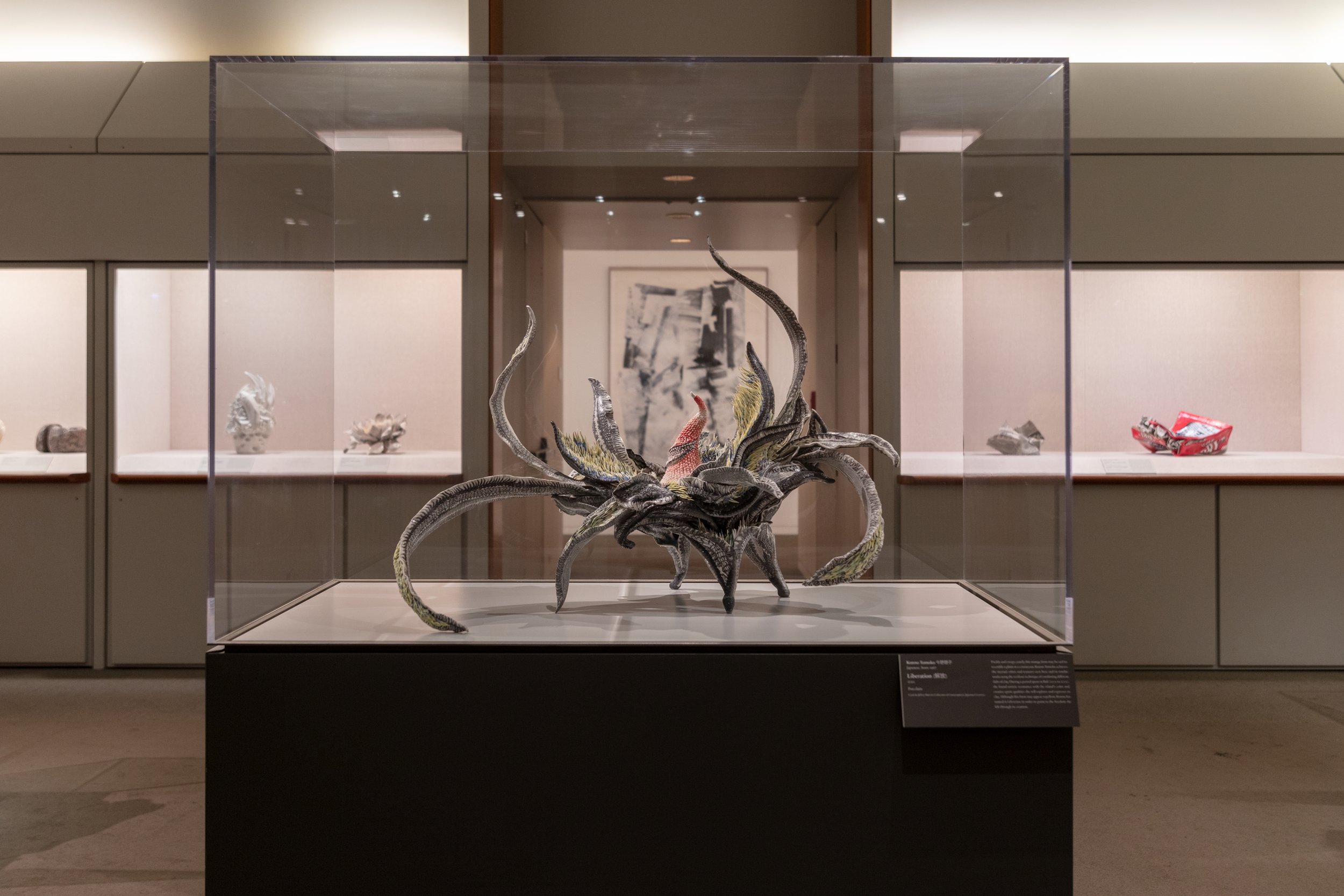
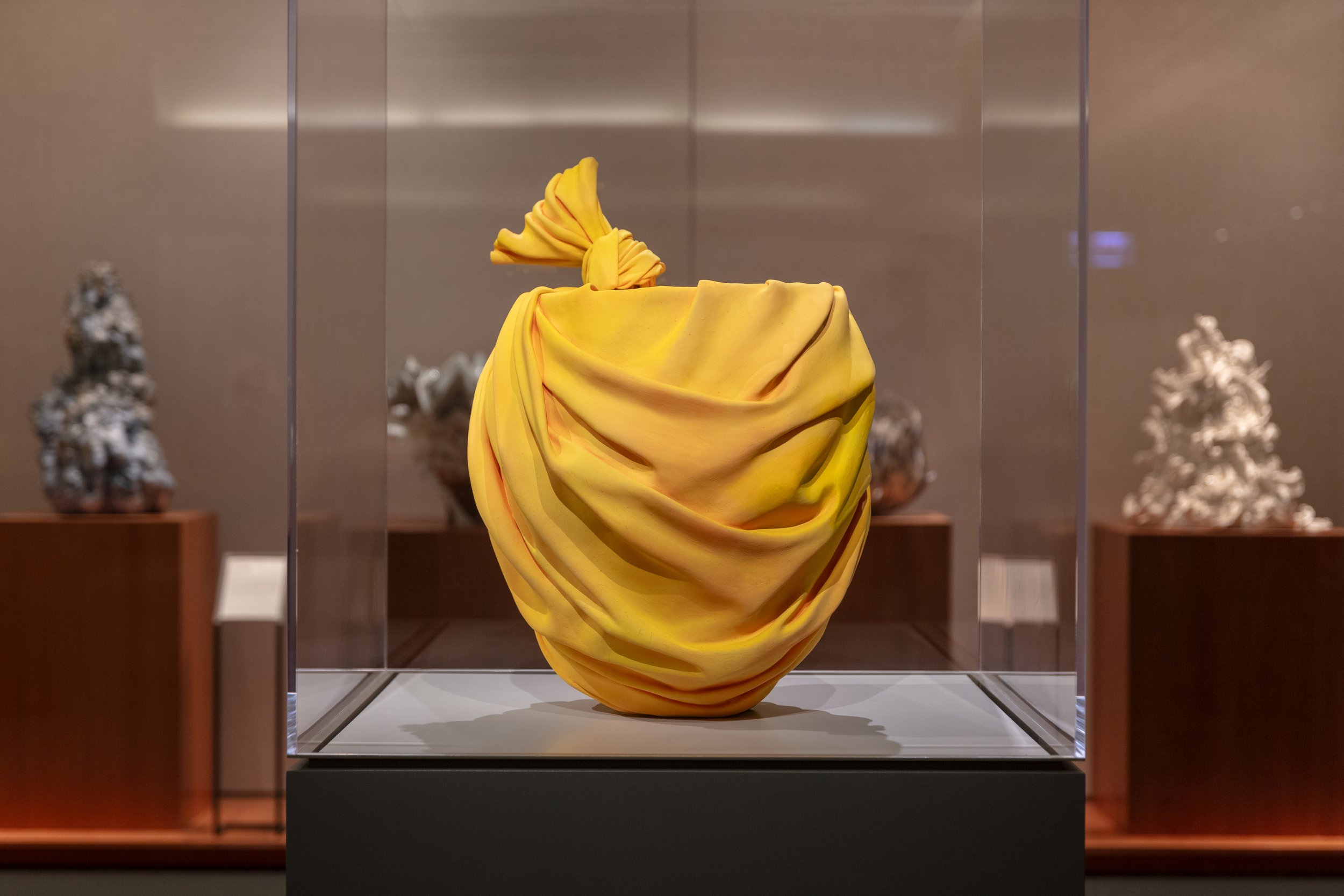

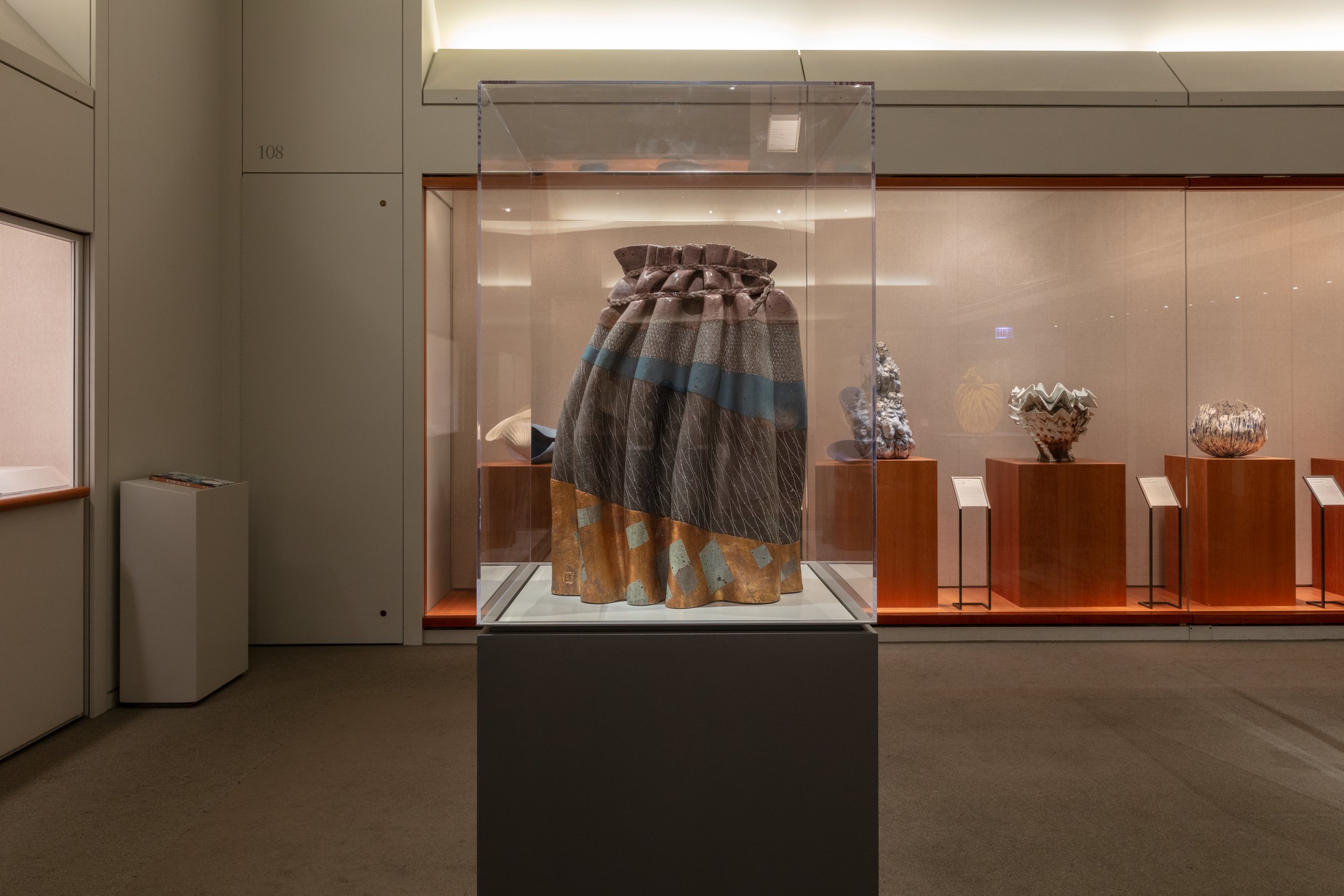
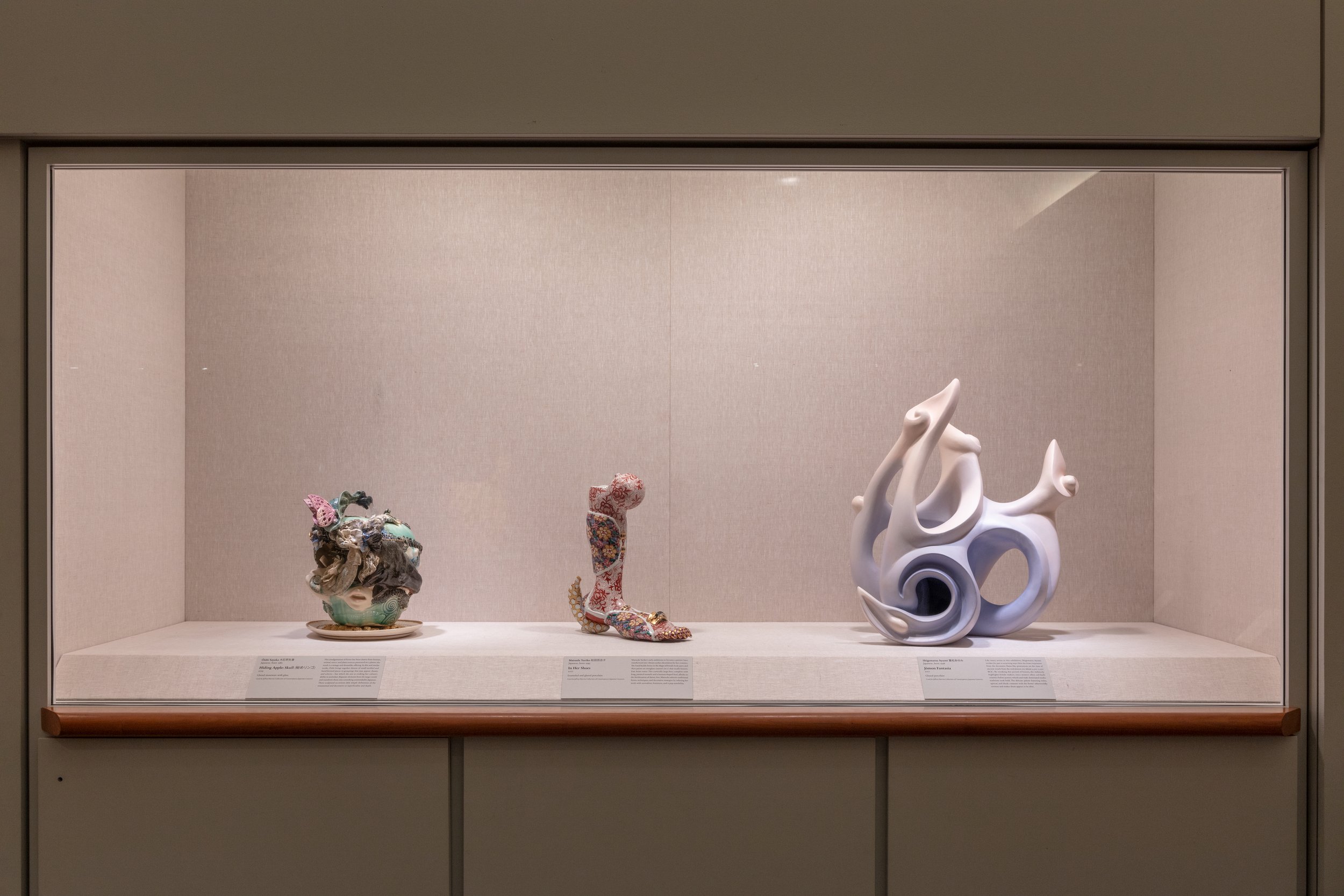
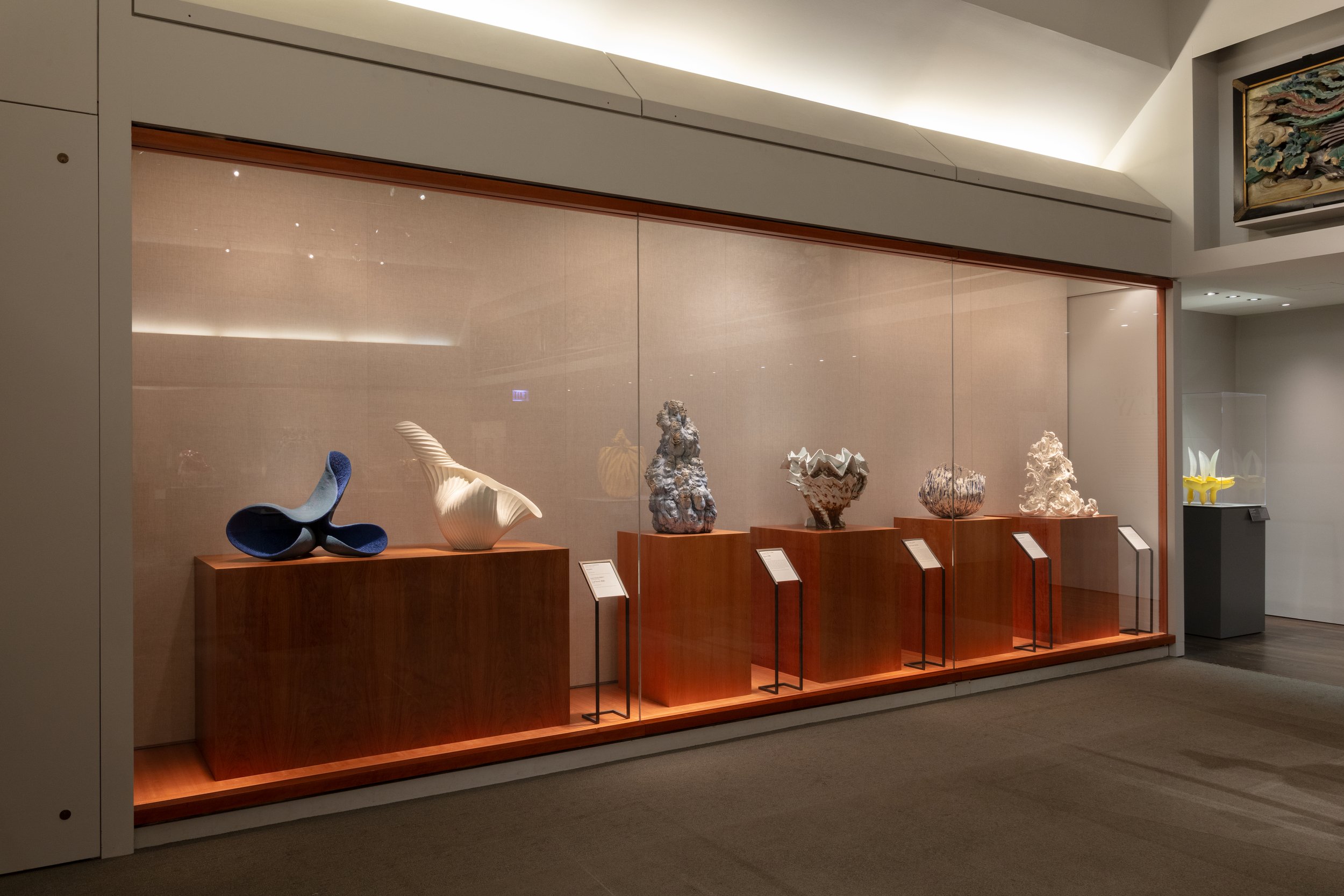
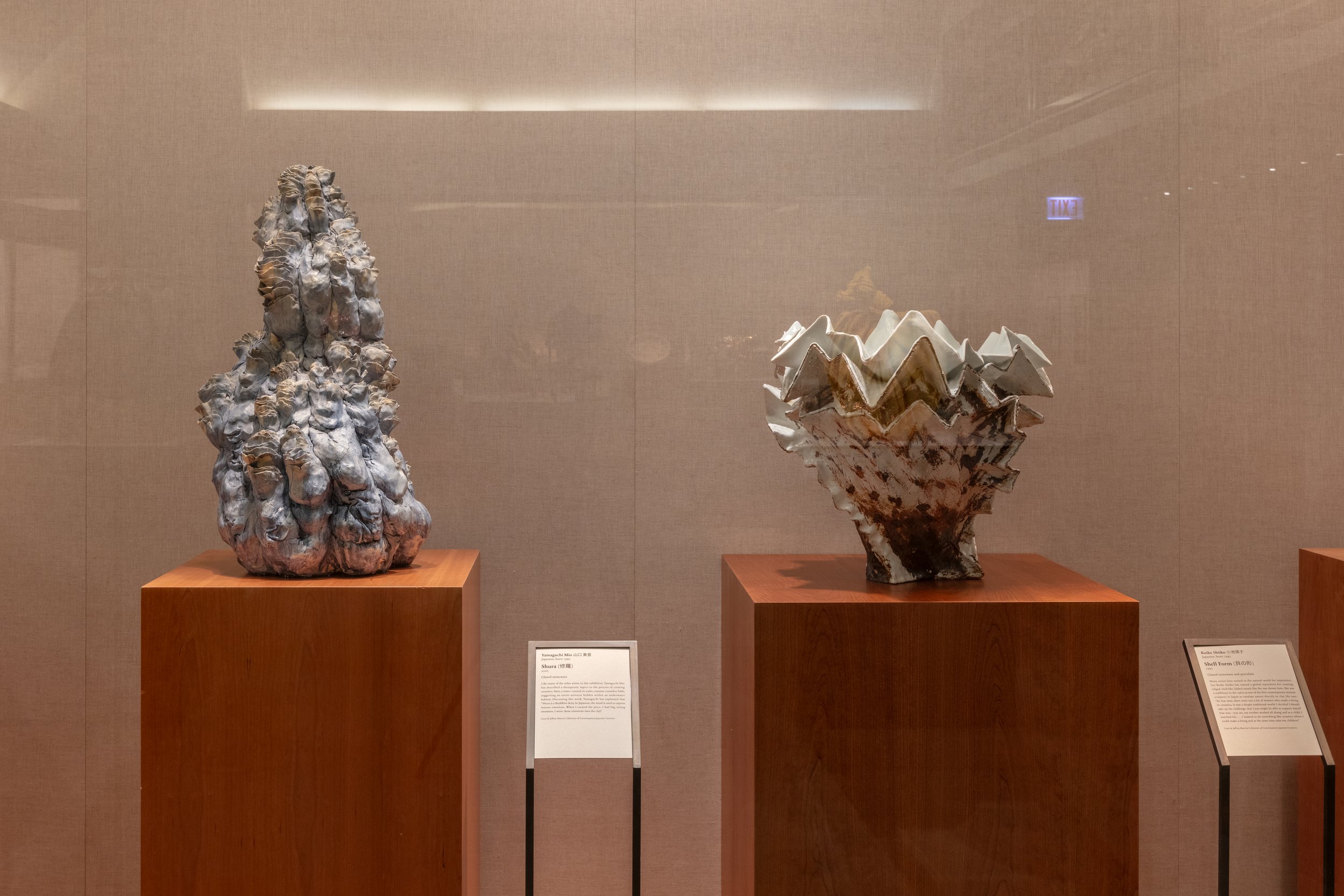
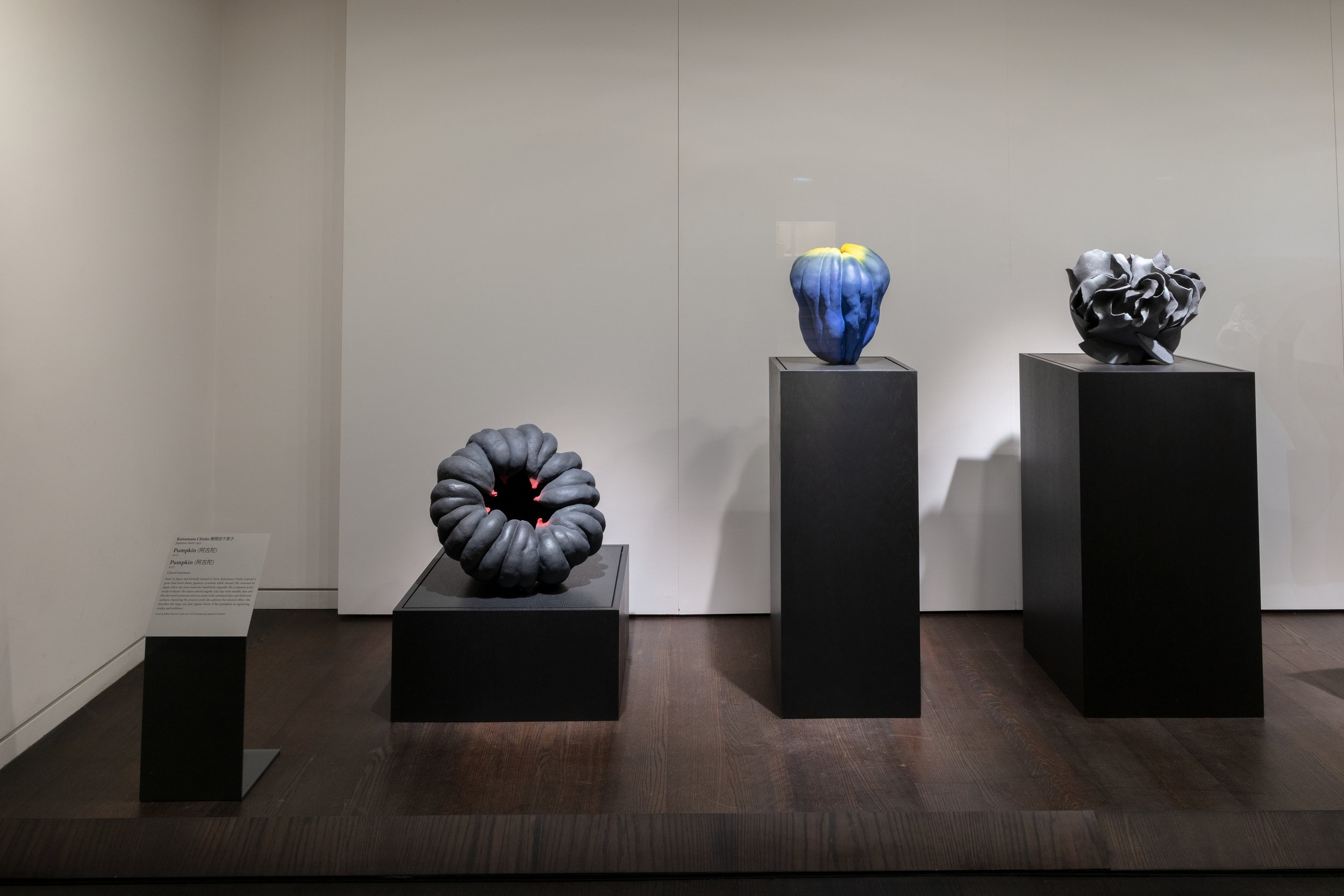
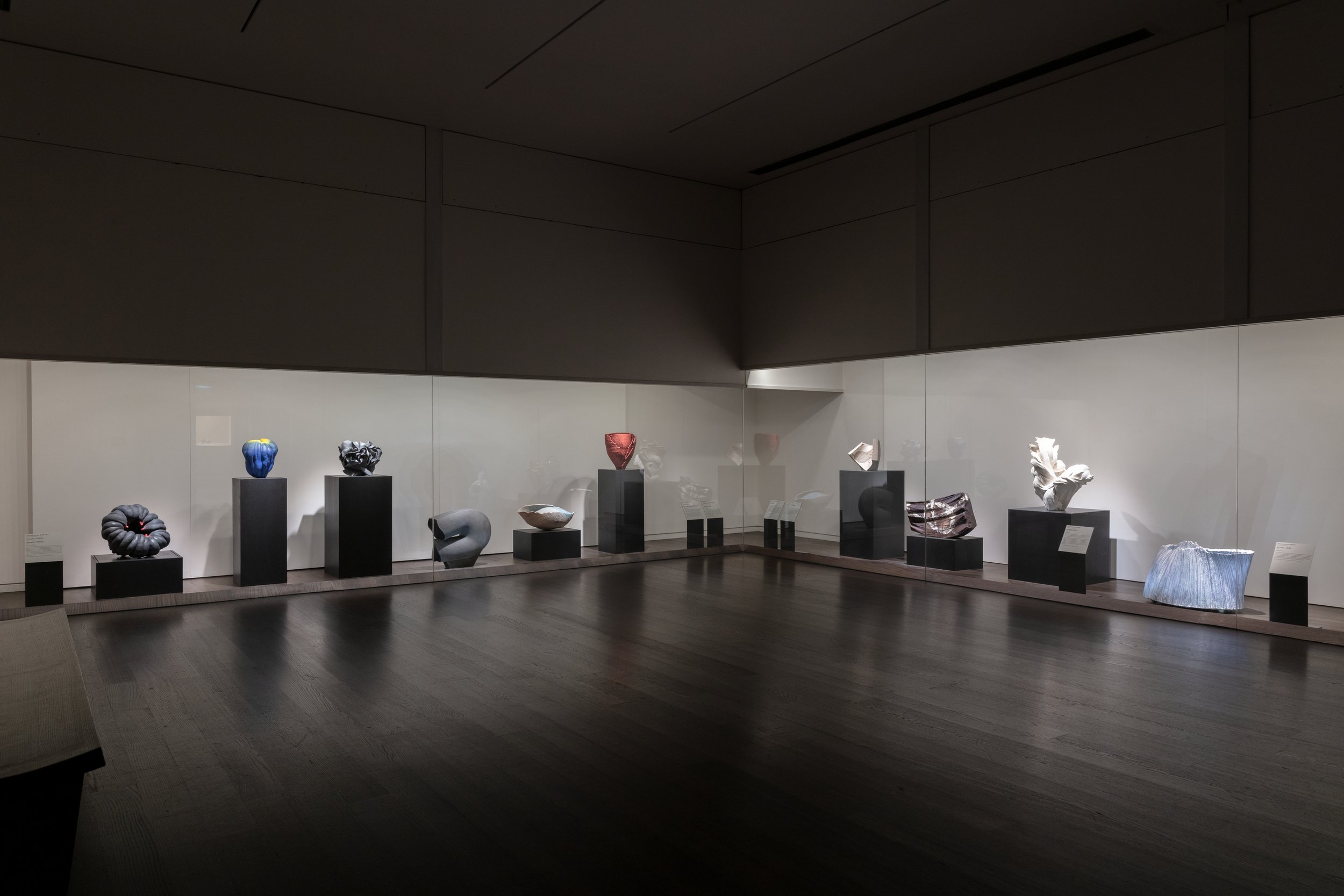

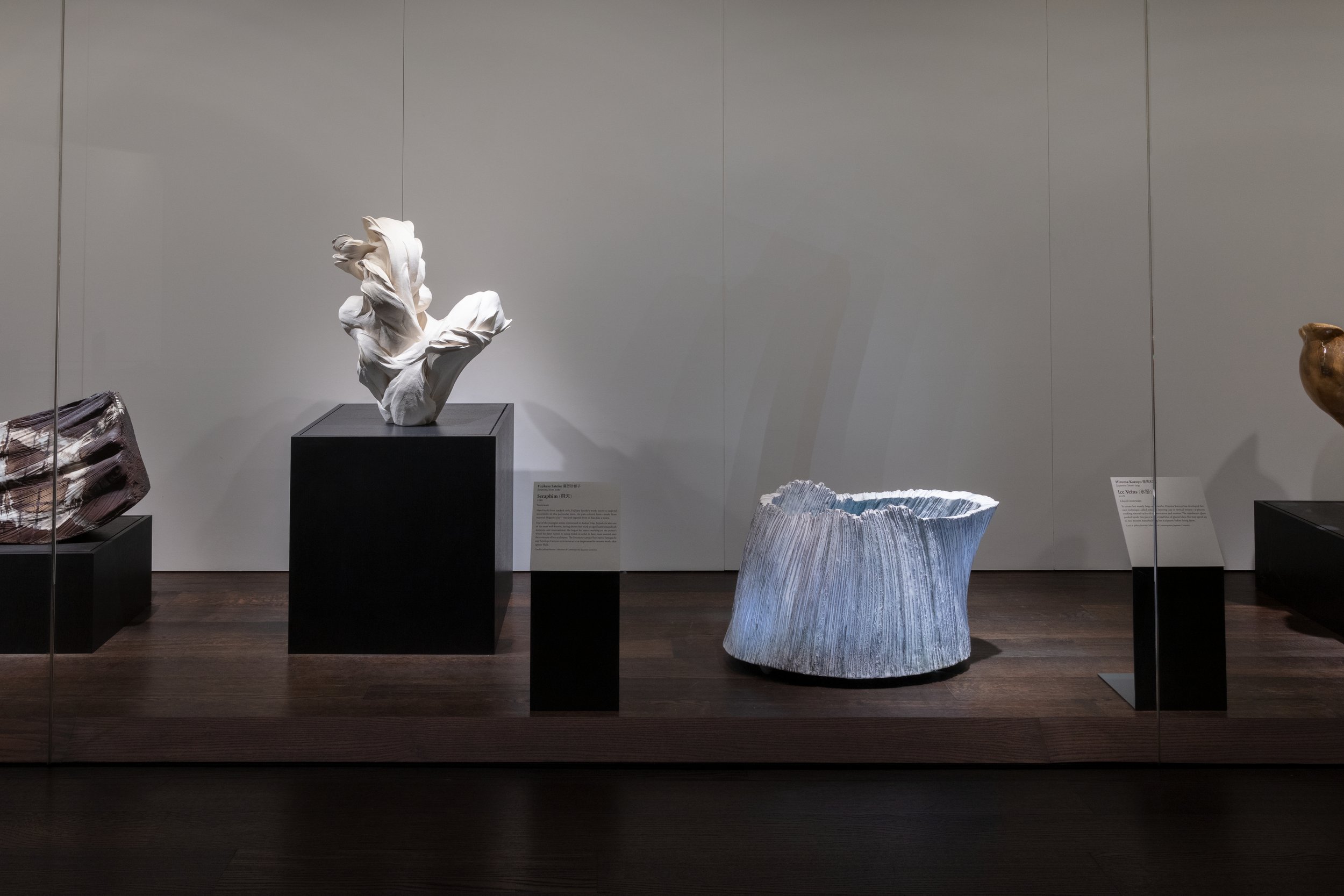

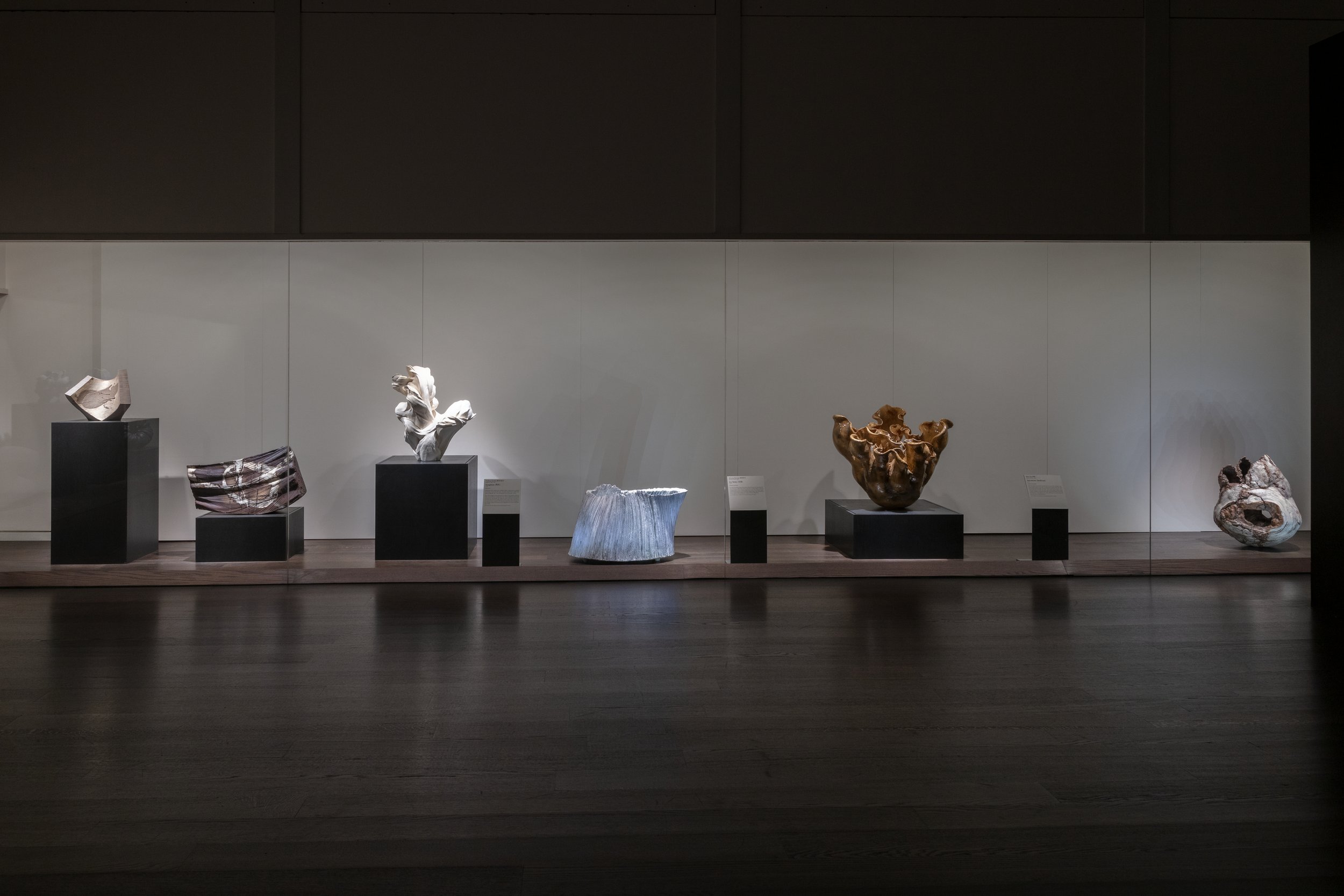
Installation view: Radical Clay: Contemporary Women Artists from Japan, 2024. The Art Institute of Chicago, Chicago. Courtesy of The Art Institute of Chicago
Radical Clay: Contemporary Women Artists from Japan is curated by the Art Institute of Chicago’s Janice Katz
SPONSORS
Lead support for Radical Clay: Contemporary Women Artists from Japan is generously provided by Carol & Jeffrey Horvitz.
Additional support is contributed by the Japan Foundation.
For more information about the exhibition and other exhibitions, please visit The Art Institute of Chicago's website here. The institute can also be found on Facebook, Instagram, and YouTube.
Ming Smith: Feeling the Future
Photograph by Chanell Stone, courtesy of Aperture
Charleston, S.C. – The International African American Museum (IAAM) will house a special exhibition by Ming Smith this winter and early spring. Ming Smith: Feeling the Future opened on January 31 and will be on view through April 28, 2024. A reception was held on Tuesday, January 30, at IAAM, 14 Wharfside Street, in downtown Charleston; guests had the opportunity to engage with solo artist Ming Smith about her career and legacy. They also had the chance to partake in a self-guided tour of the entire museum from 7:00 p.m. to 9:00 p.m.
Amen Corner Sisters (Harlem, New York) by Ming Smith courtesy of IAAM
Ming Smith: Feeling the Future explores the artist’s unparalleled and under-recognized career from the early 1970s through the present. Smith’s first solo exhibition at a major institution is traveling from its debut site, the Contemporary Art Museum (CAM) of Houston. The collection encompasses a multitude of artistic expressions that represent her vibrant and multi-layered practice, which is grounded in portraiture, as it amplifies the heartbeat of Black life in the United States. Drawn from the full complexity of Smith’s oeuvre, Feeling the Future places works from the artist’s five decades of creation in conversation with one another while it embraces the cultural movements she witnessed and participated in. Exploring themes such as Afrofuturism, Black cultural expression, representation, and social examination, the exhibition offers a guided tour into unperceived moments of life as captured by one of the most profoundly gifted artists of her generation.
Chicago Art Ensemble by Ming Smith, courtesy of IAAM.
“Ming Smith is one of the most important photographers of our time. As the first woman to join Kamoinge – a groundbreaking Black photography collective – she has broken barriers that live at the intersection of race and gender. Her work can be found at the most significant institutions in the world, from The Whitney to the Schomburg, and has been shown at many more, including Tate Modern and MoMA. Still, few of us are yet to know her name, though many know her work. Her iconic images of artists like Tina Turner and Nina Simone have come across our timelines and, for a moment, stopped us in time. That’s how remarkable her lens is as it captures the soul of the moment, the movement, and the person. With this solo exhibition, traveling from CAM, we will have the opportunity to not only discover more of her work, but through the work, we will get to meet and to know Ming Smith,” noted Malika Pryor, chief engagement and learning officer at IAAM.
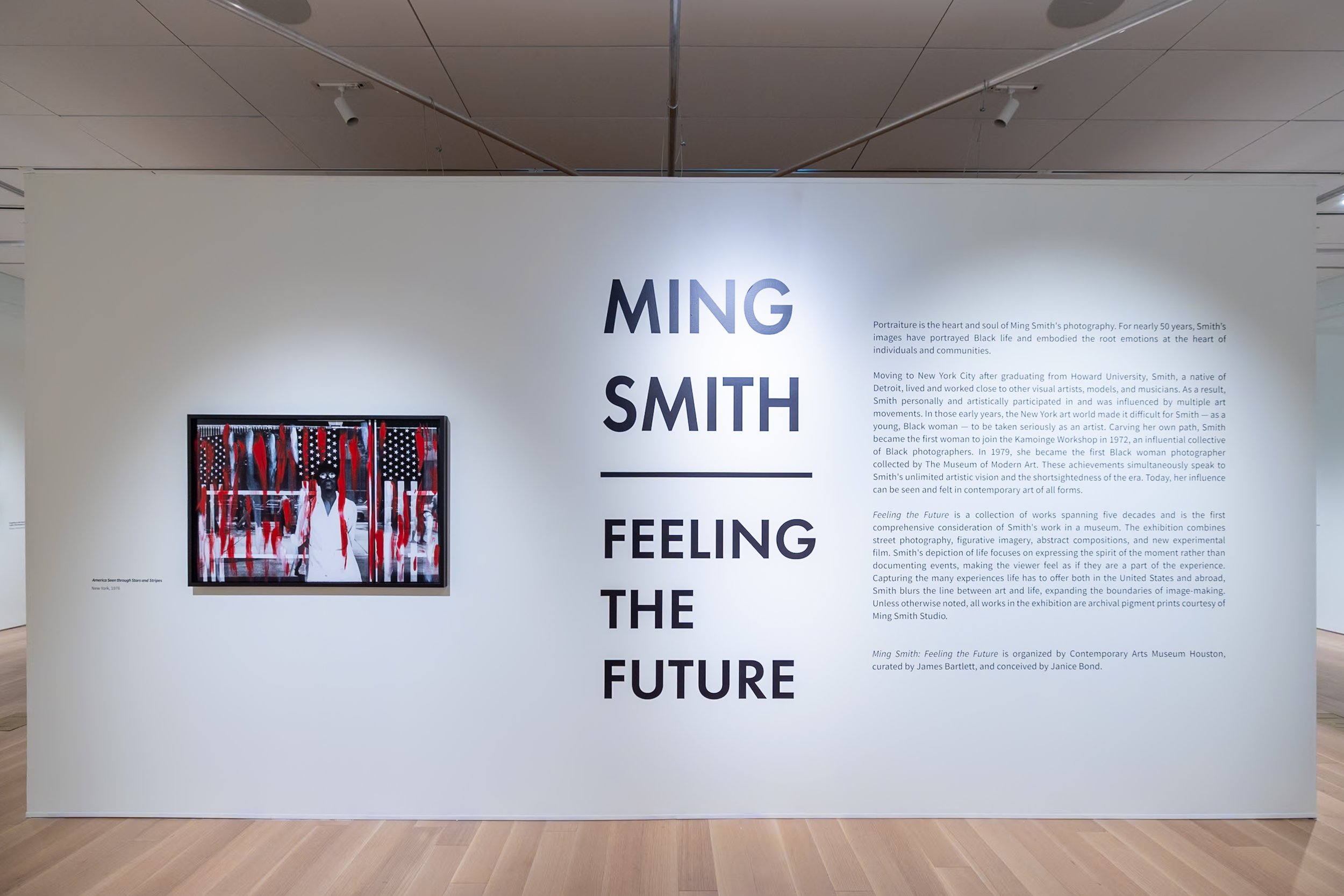
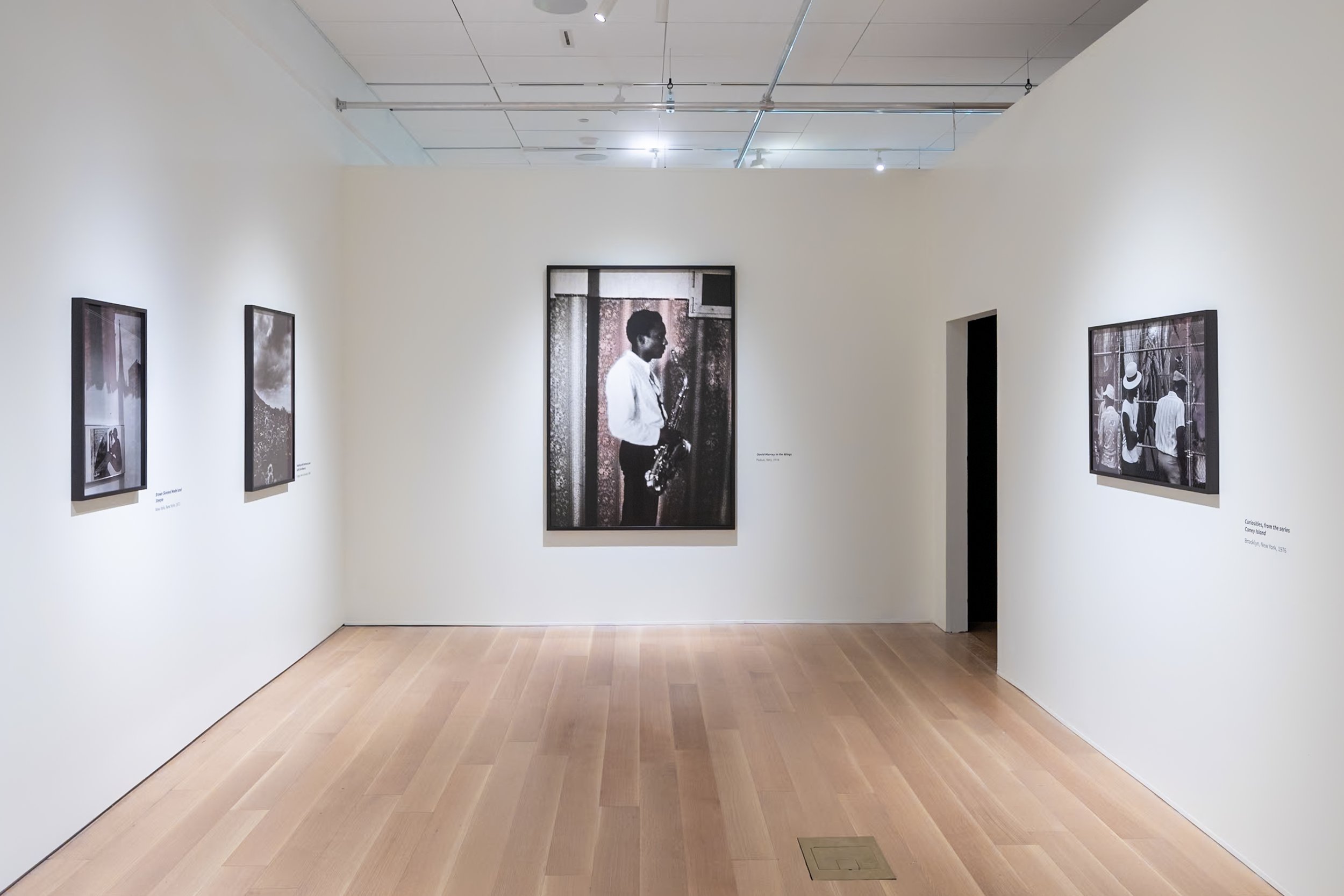
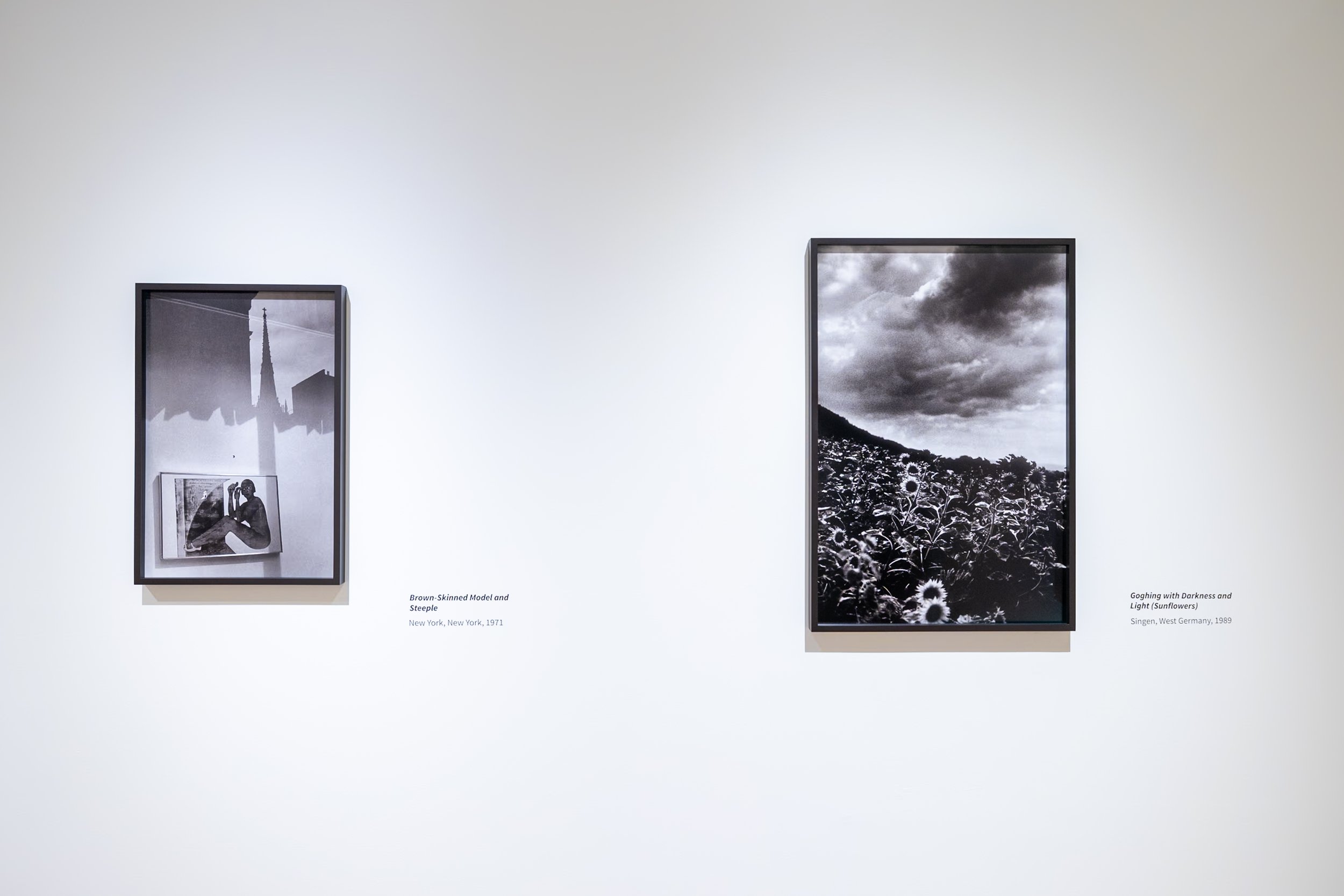
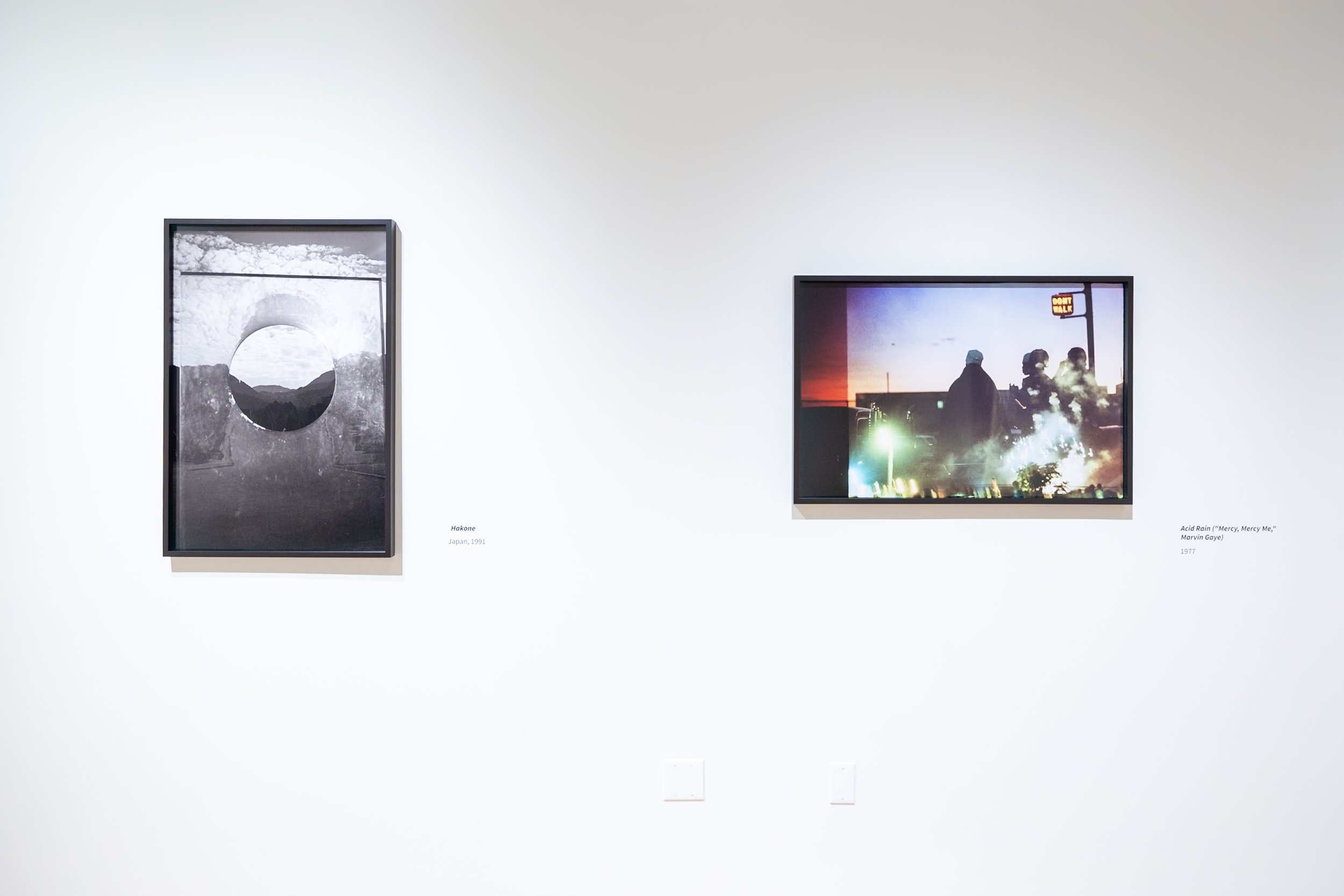
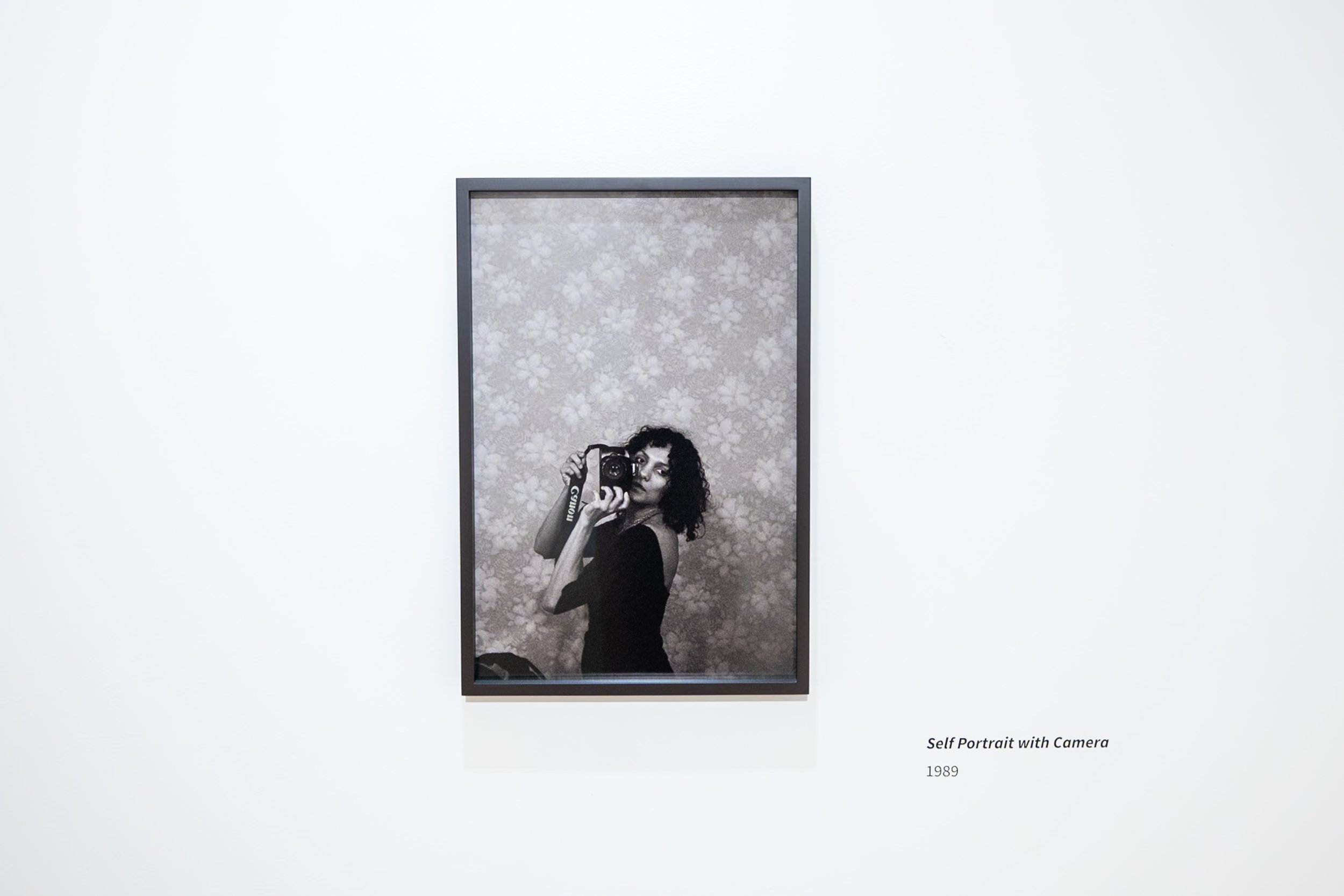
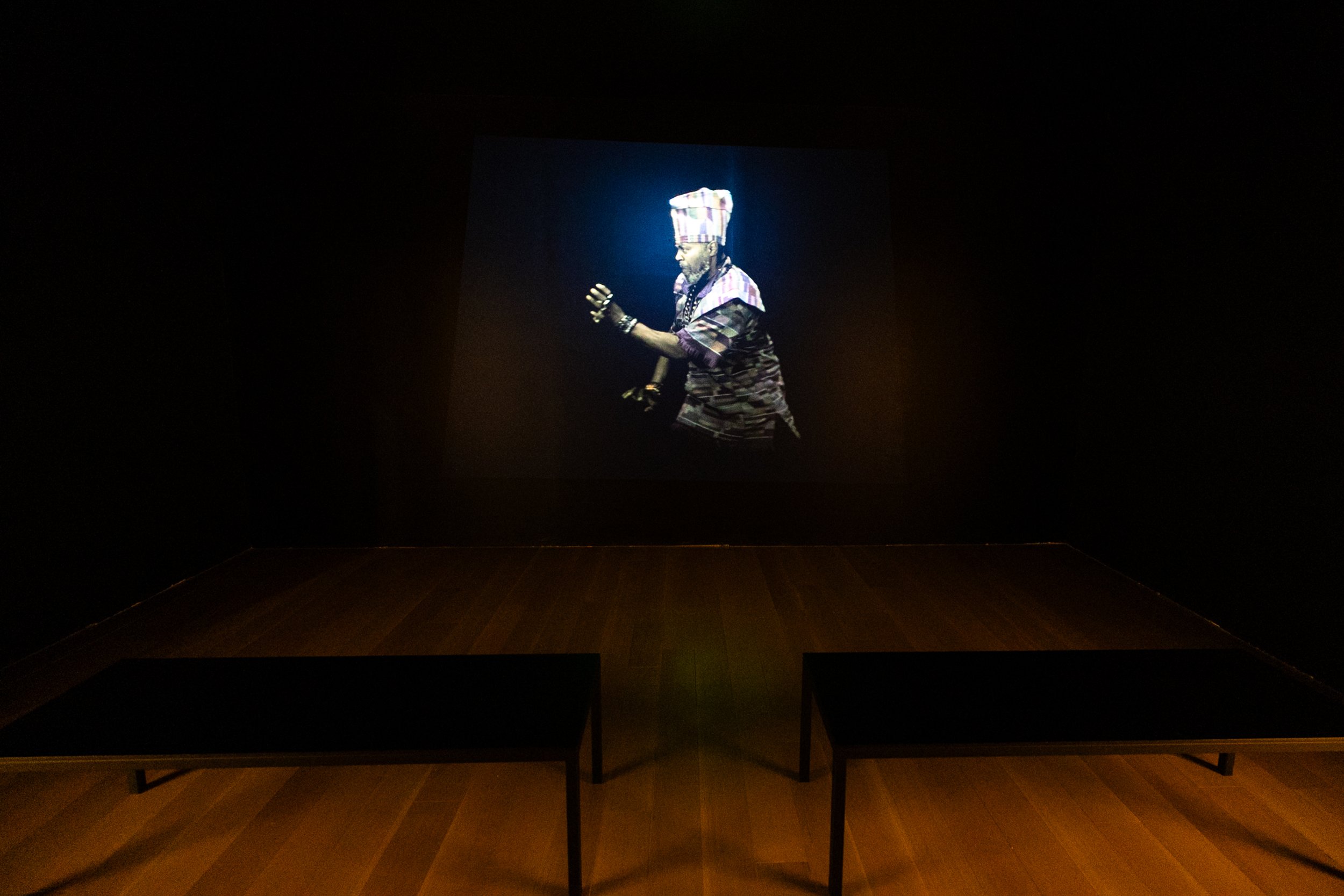
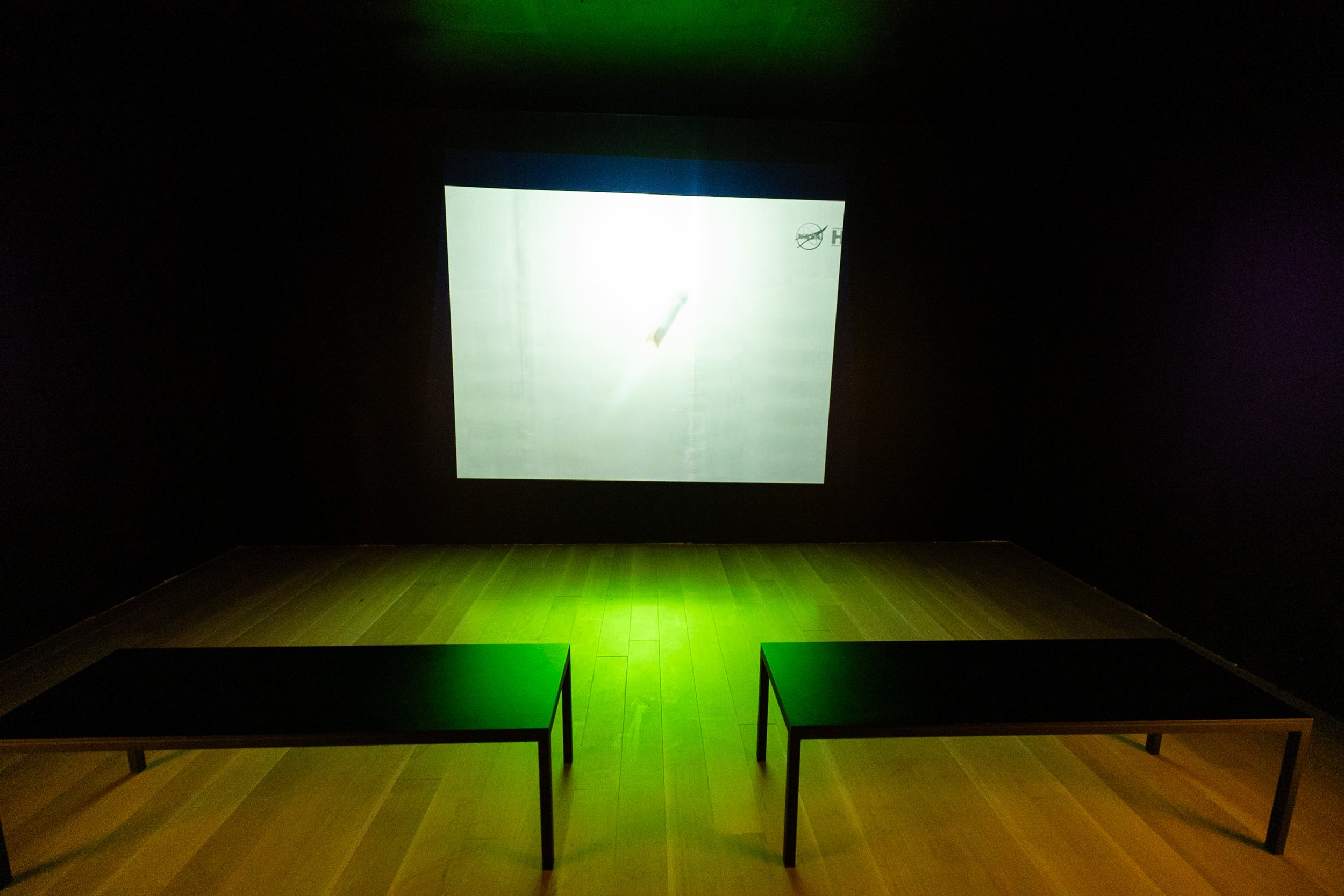
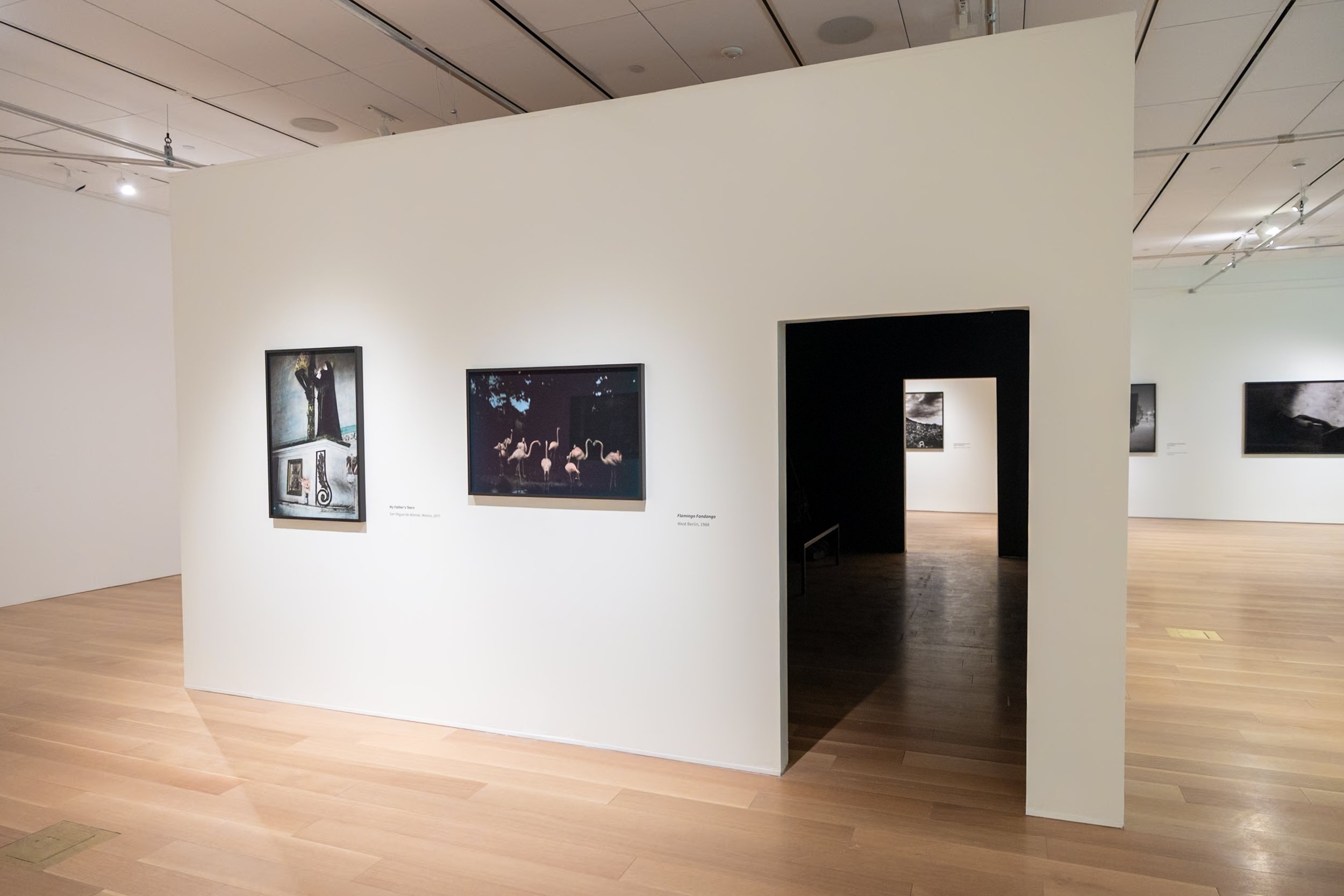
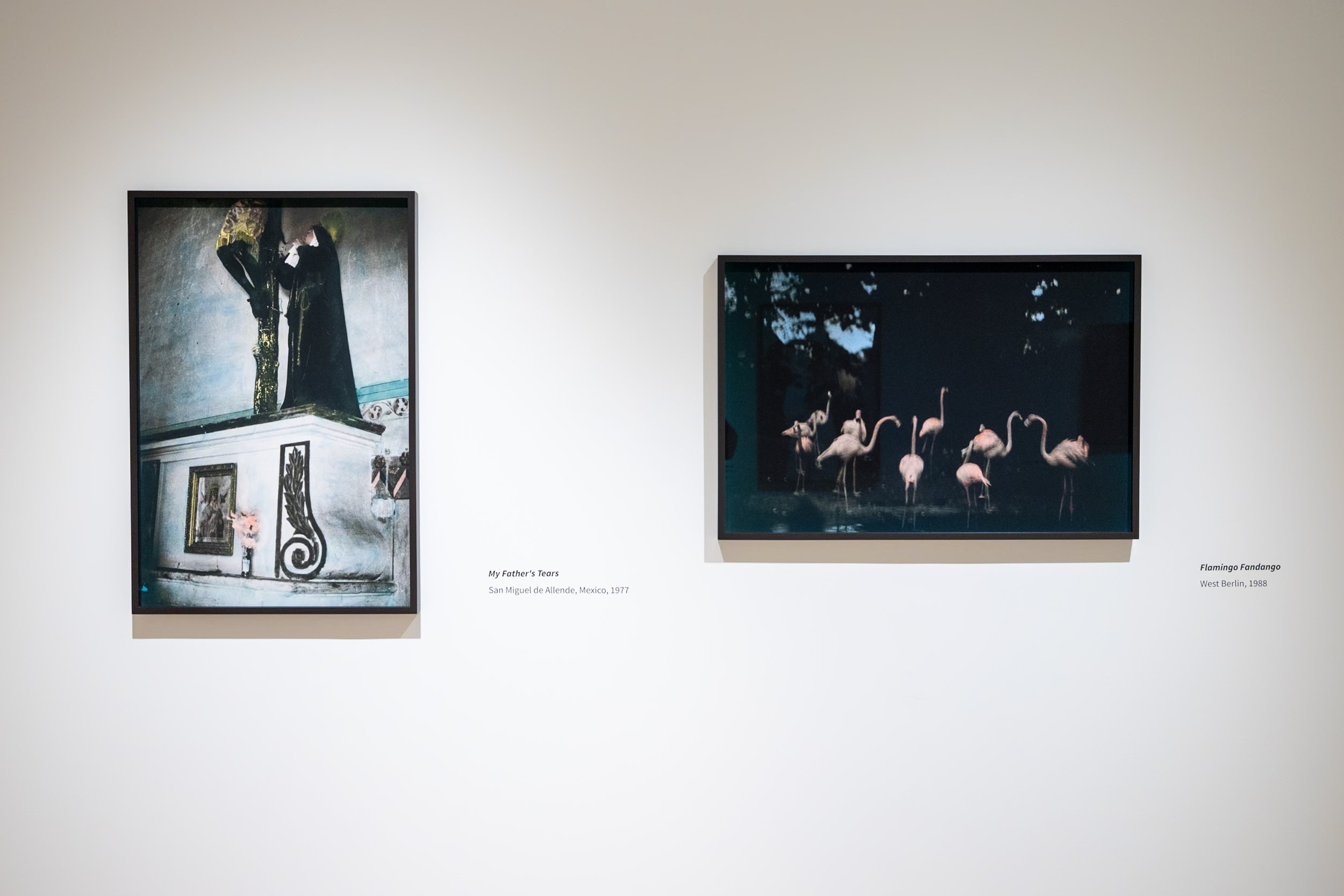
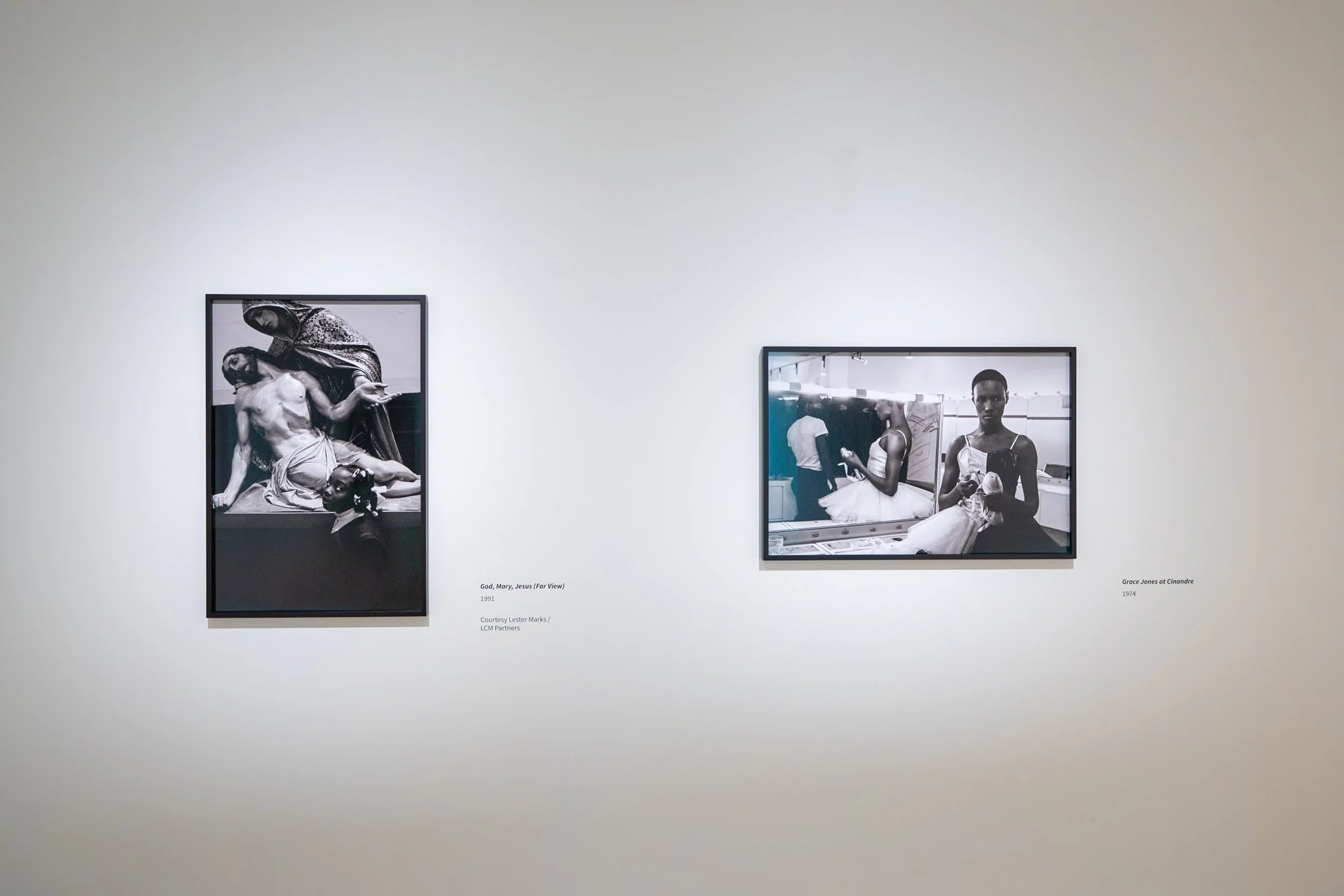
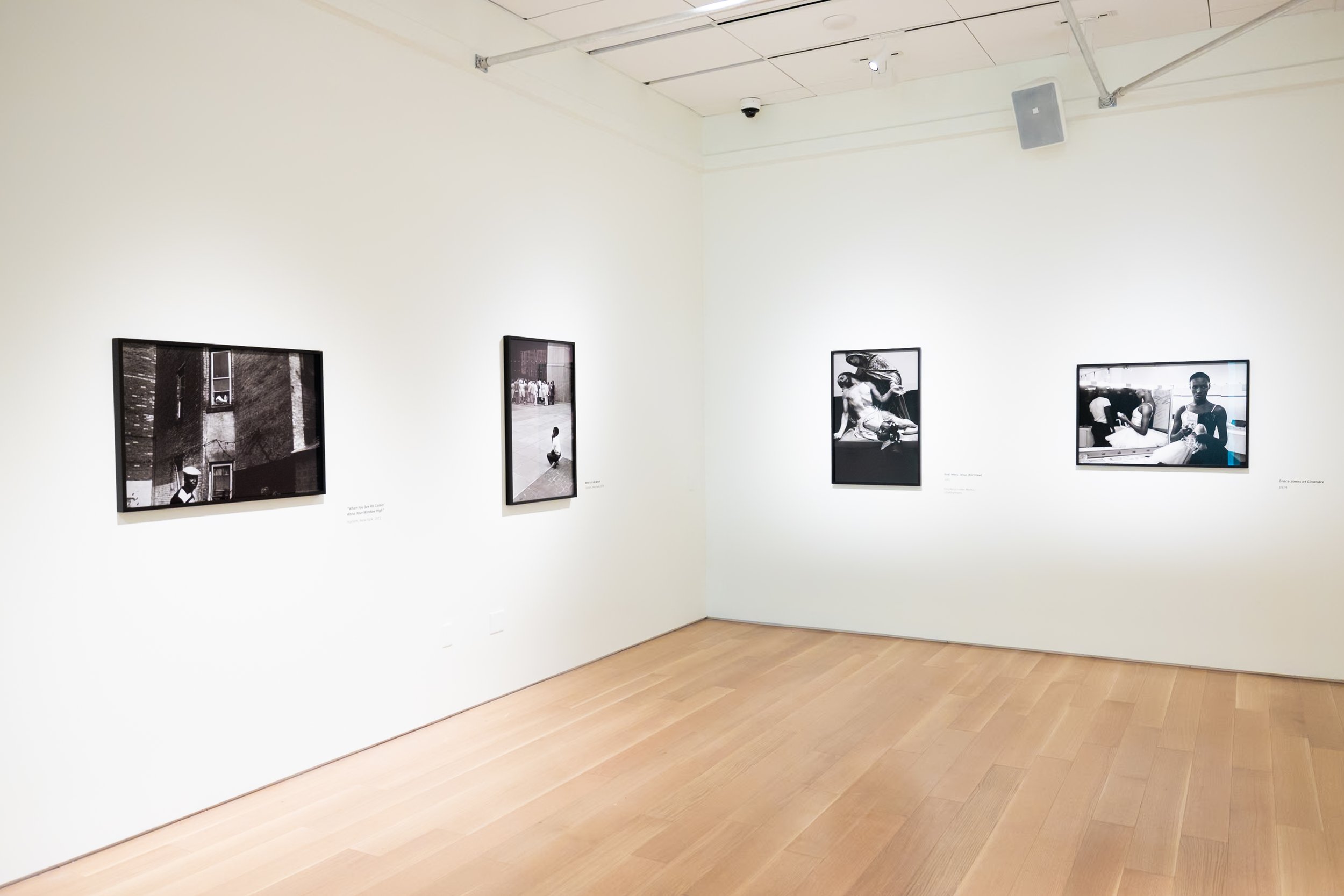

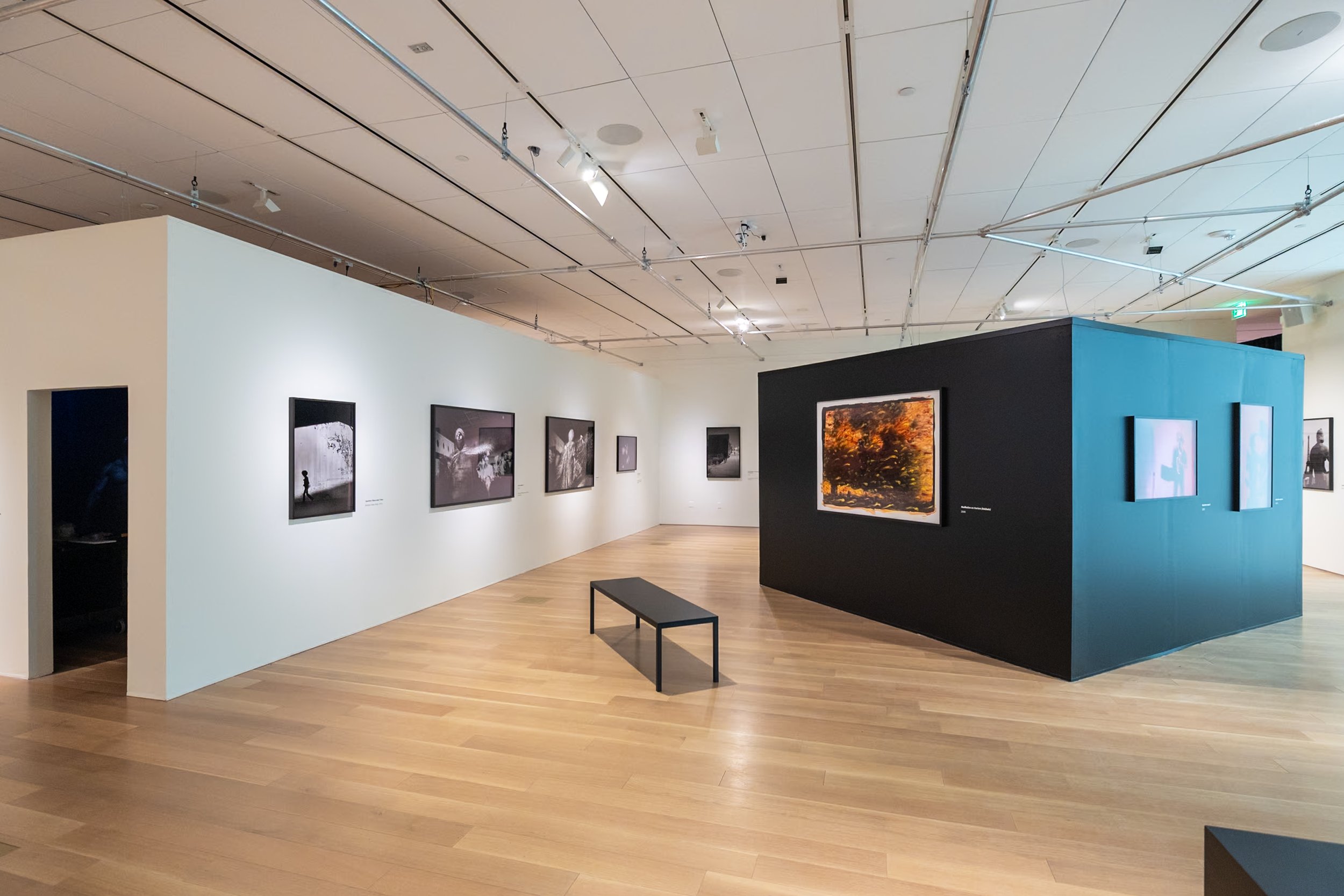

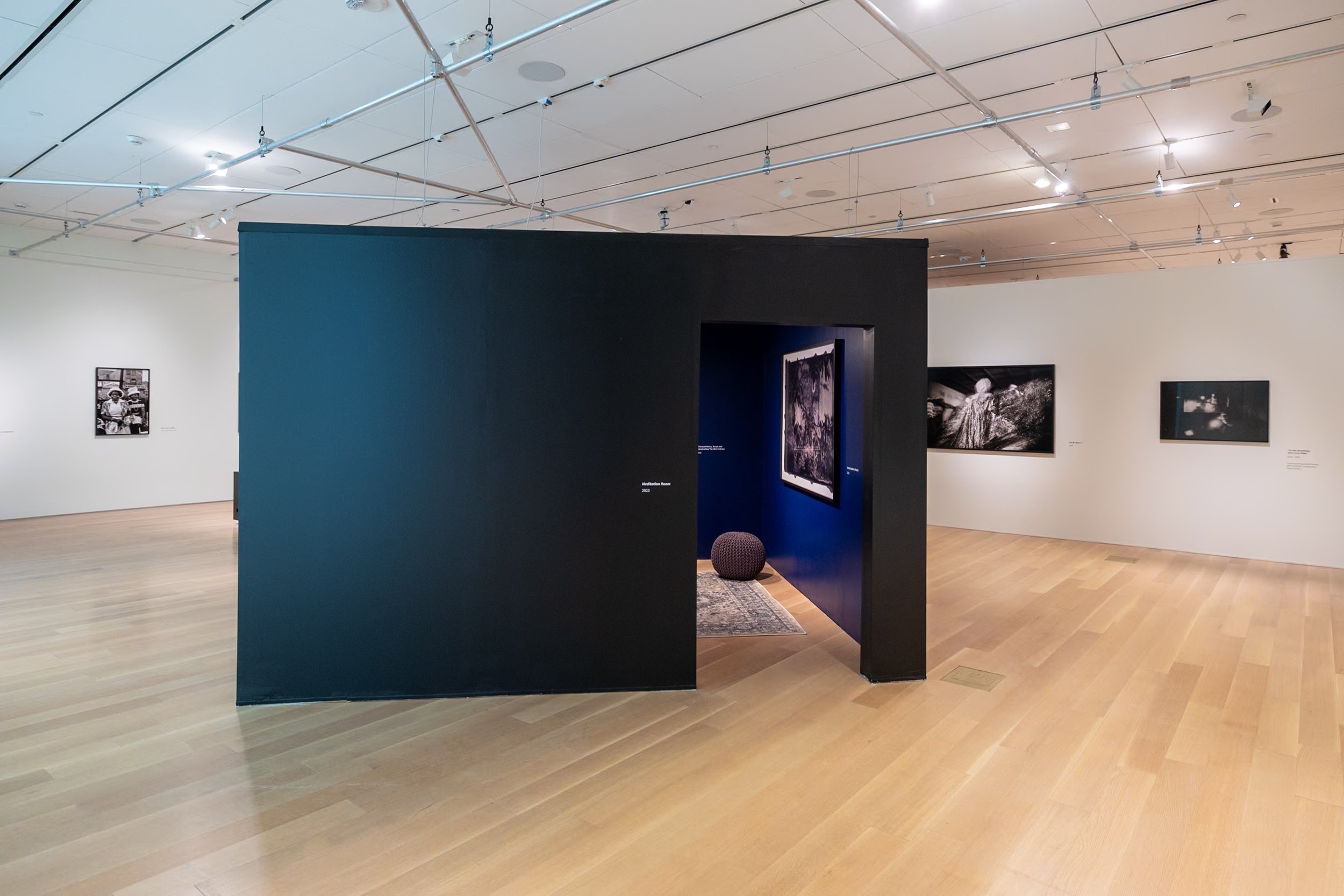
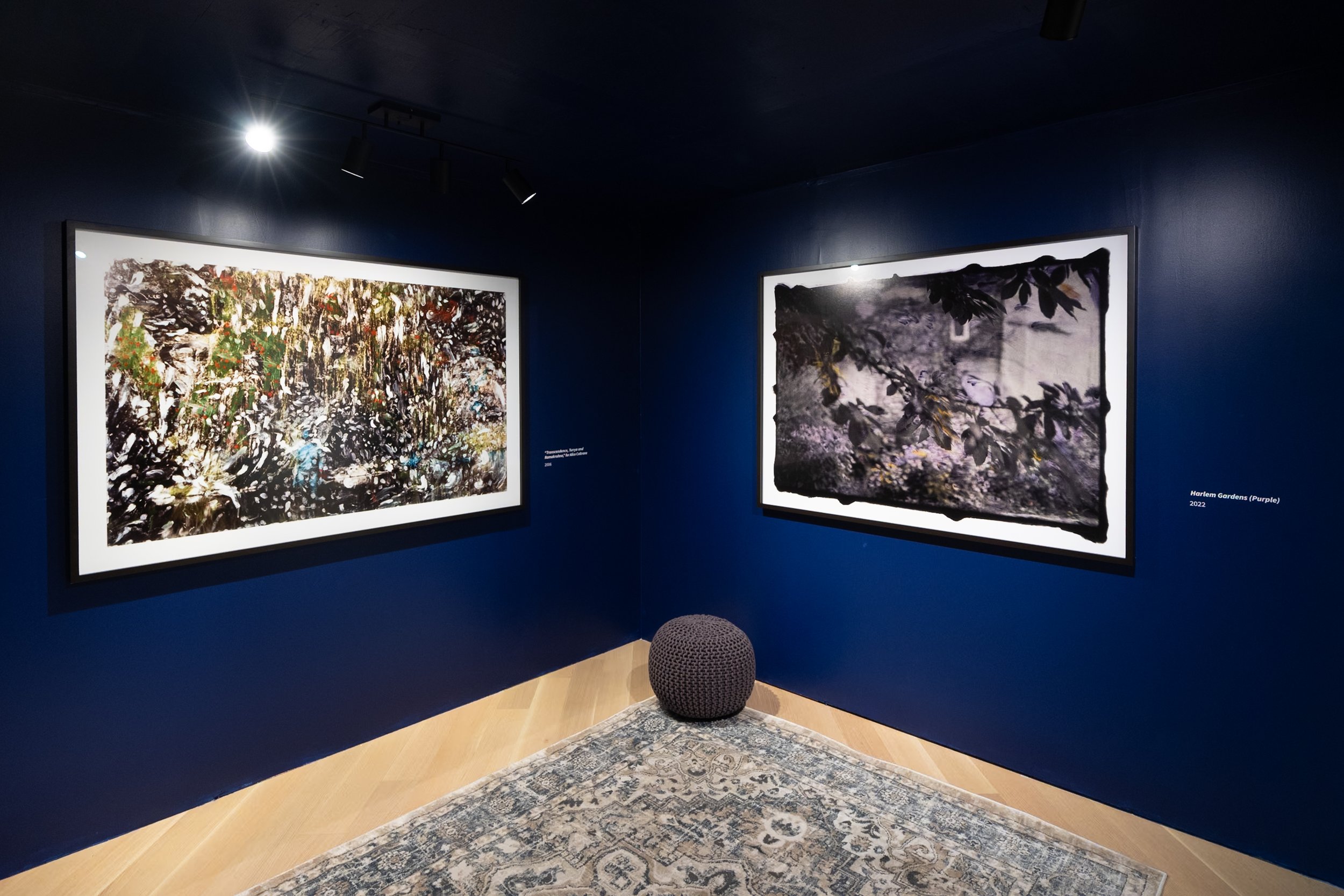
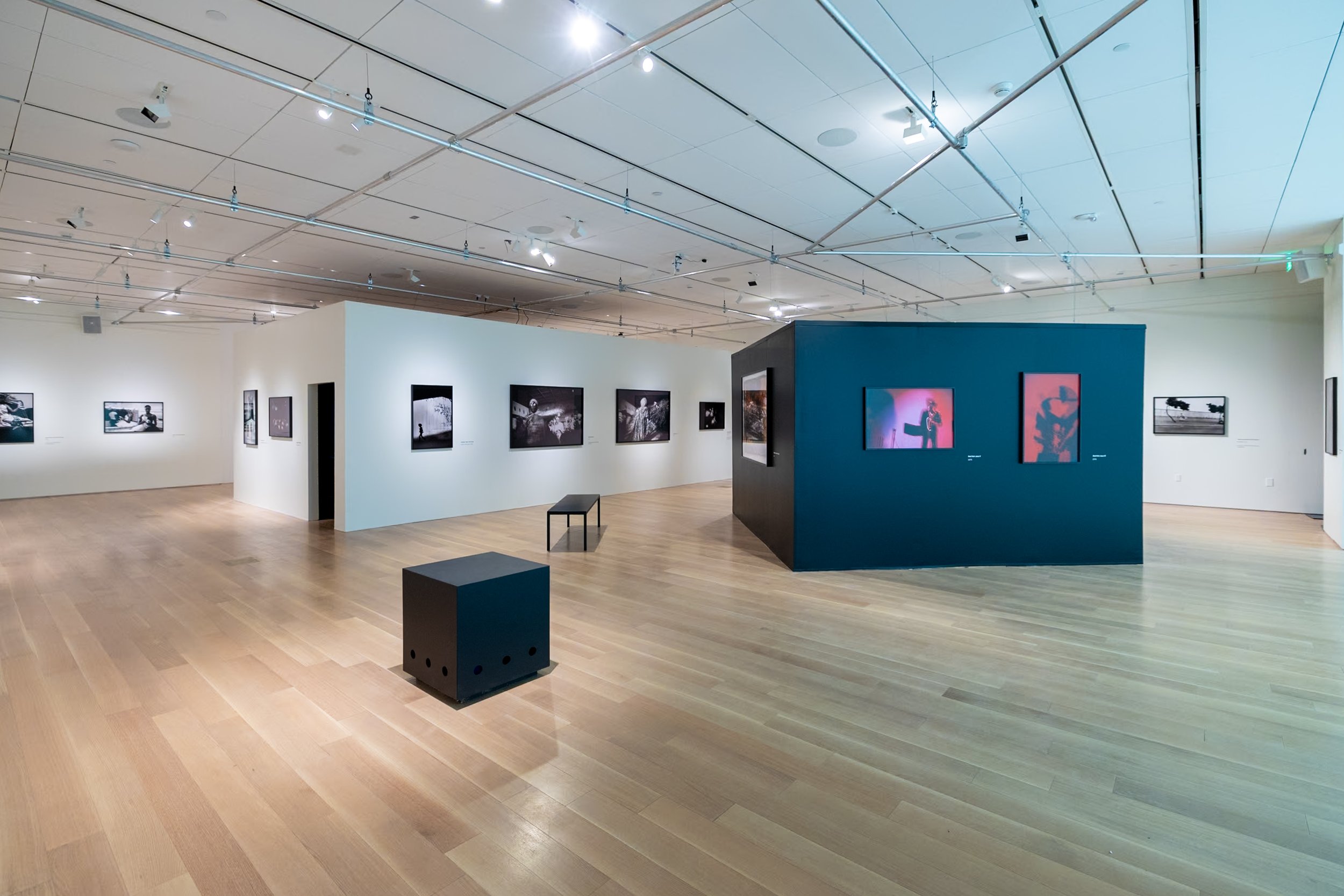
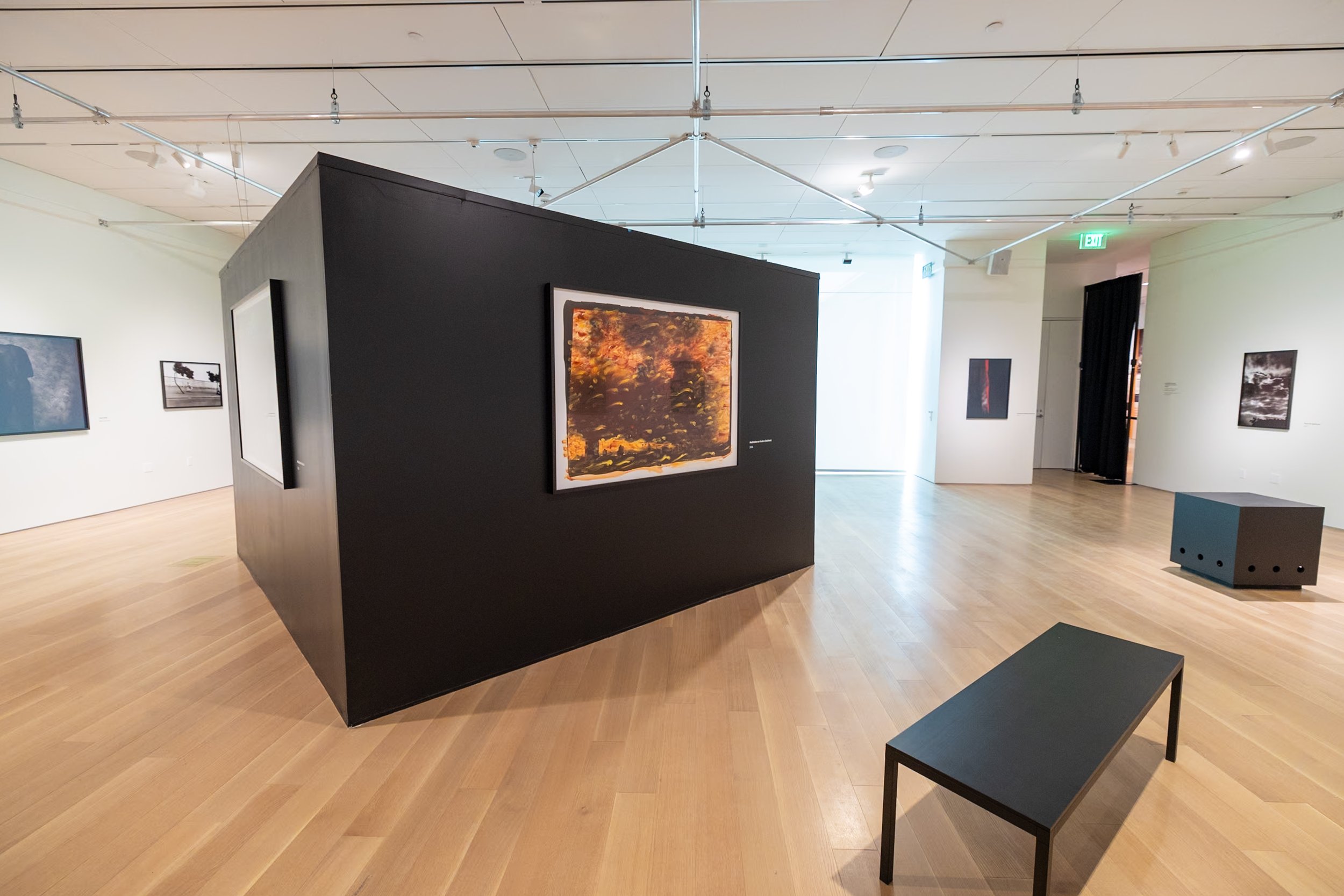
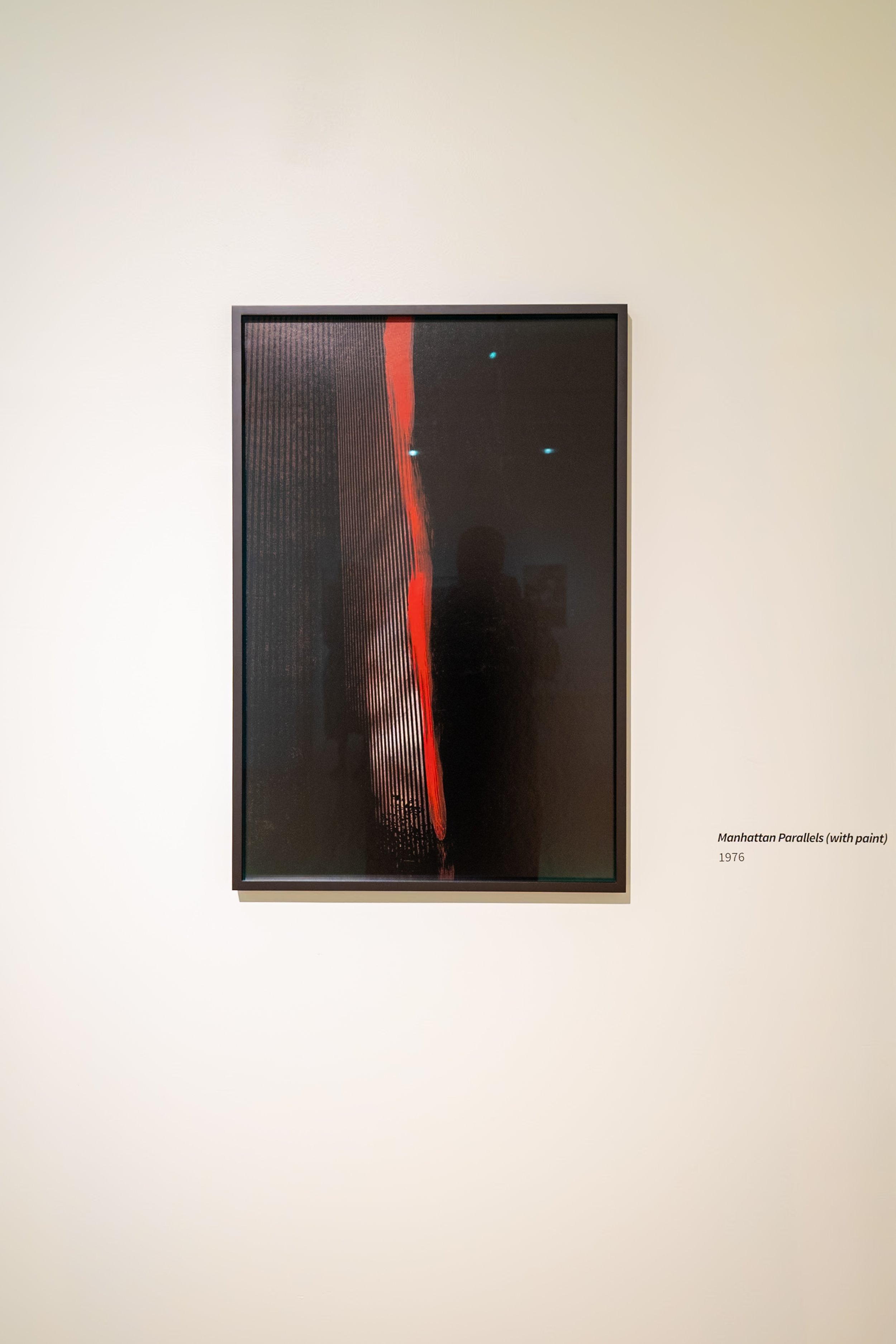
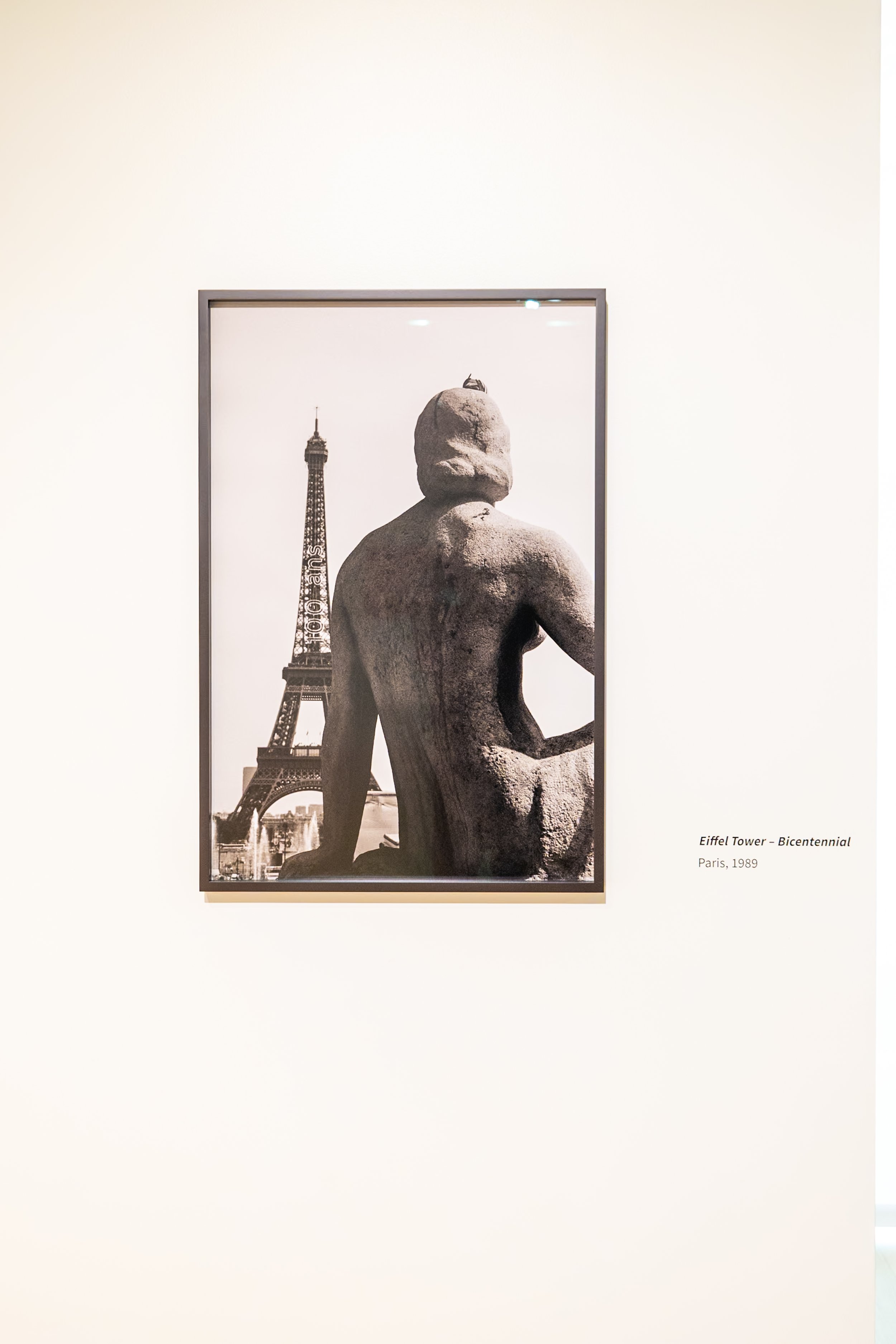
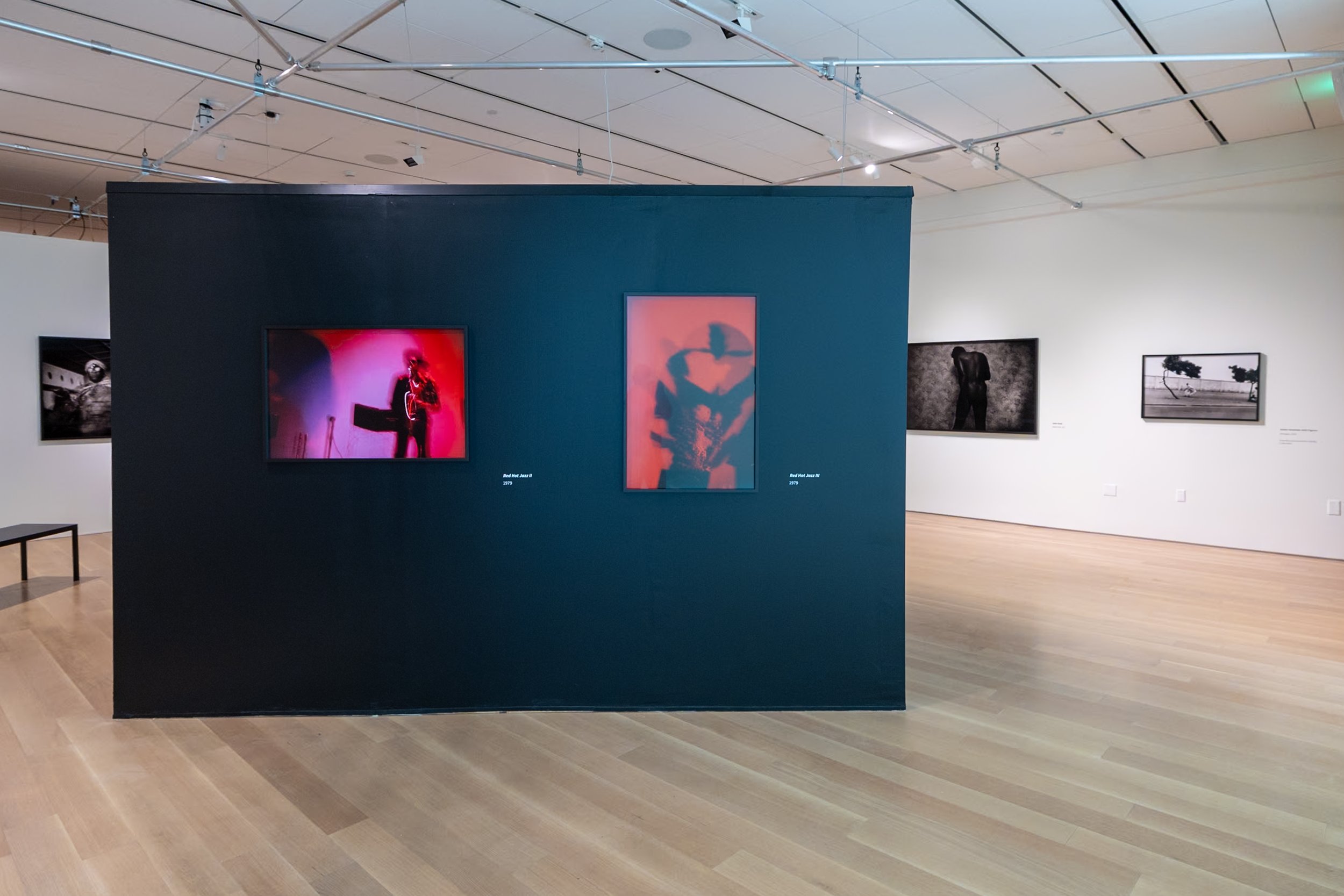
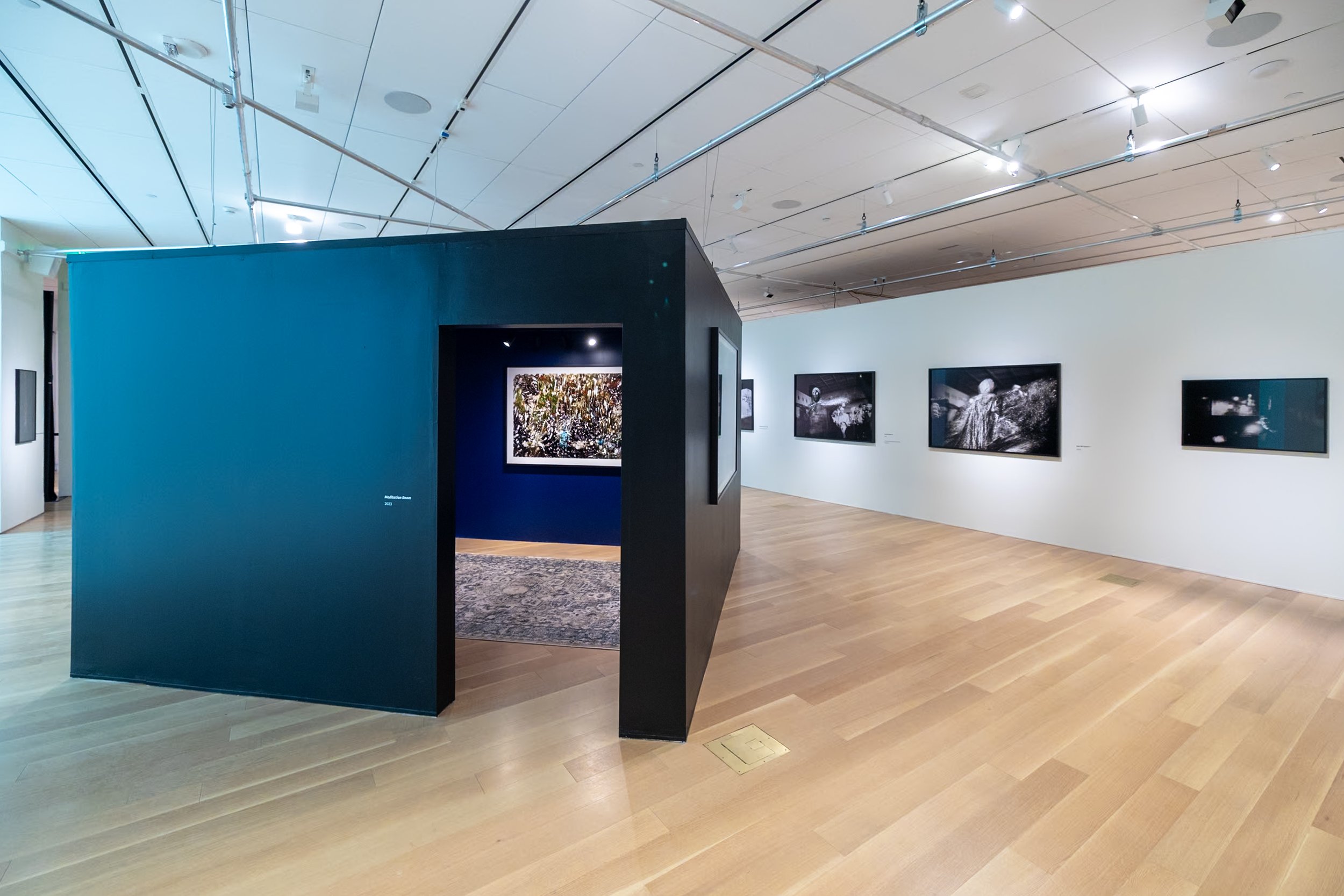
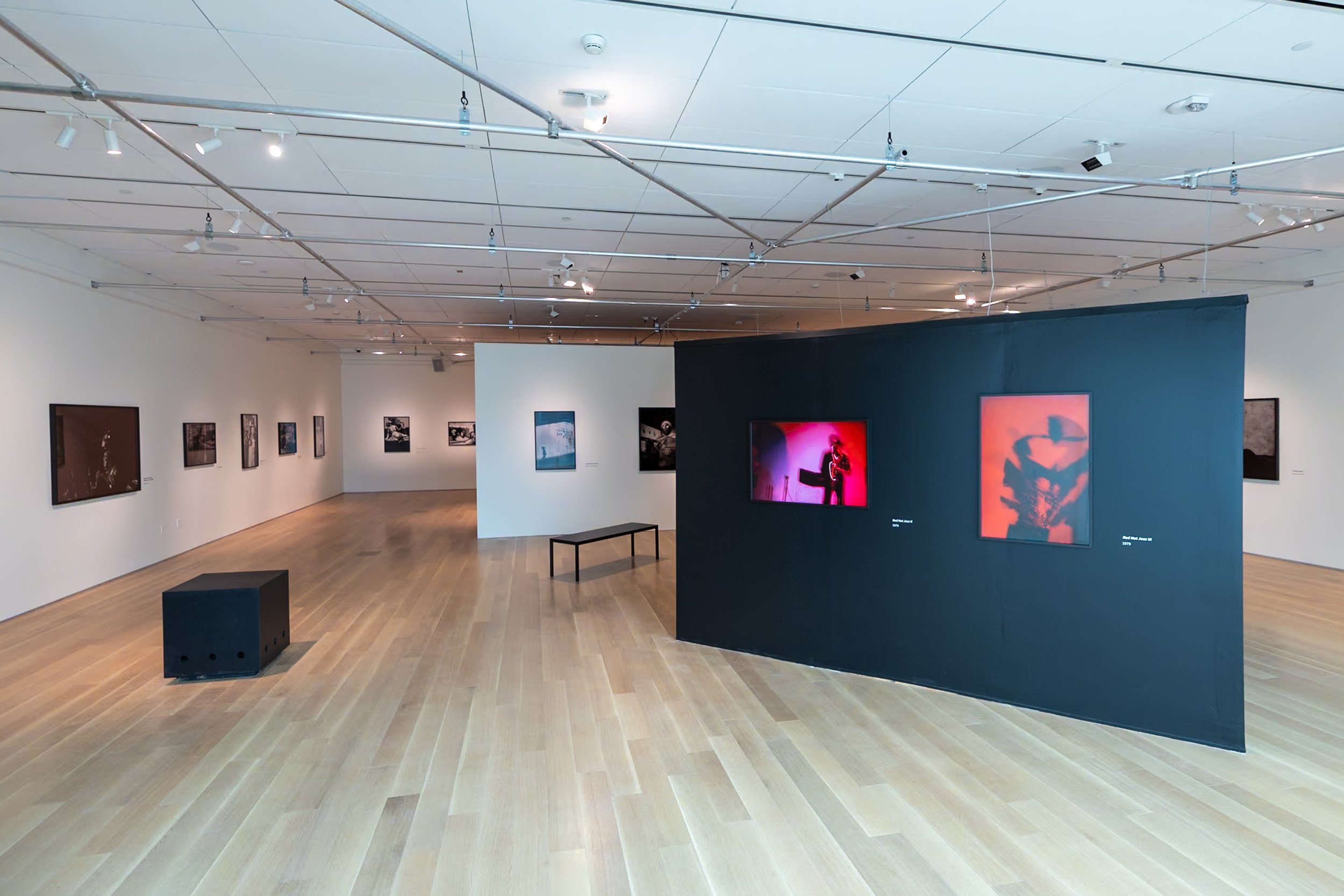
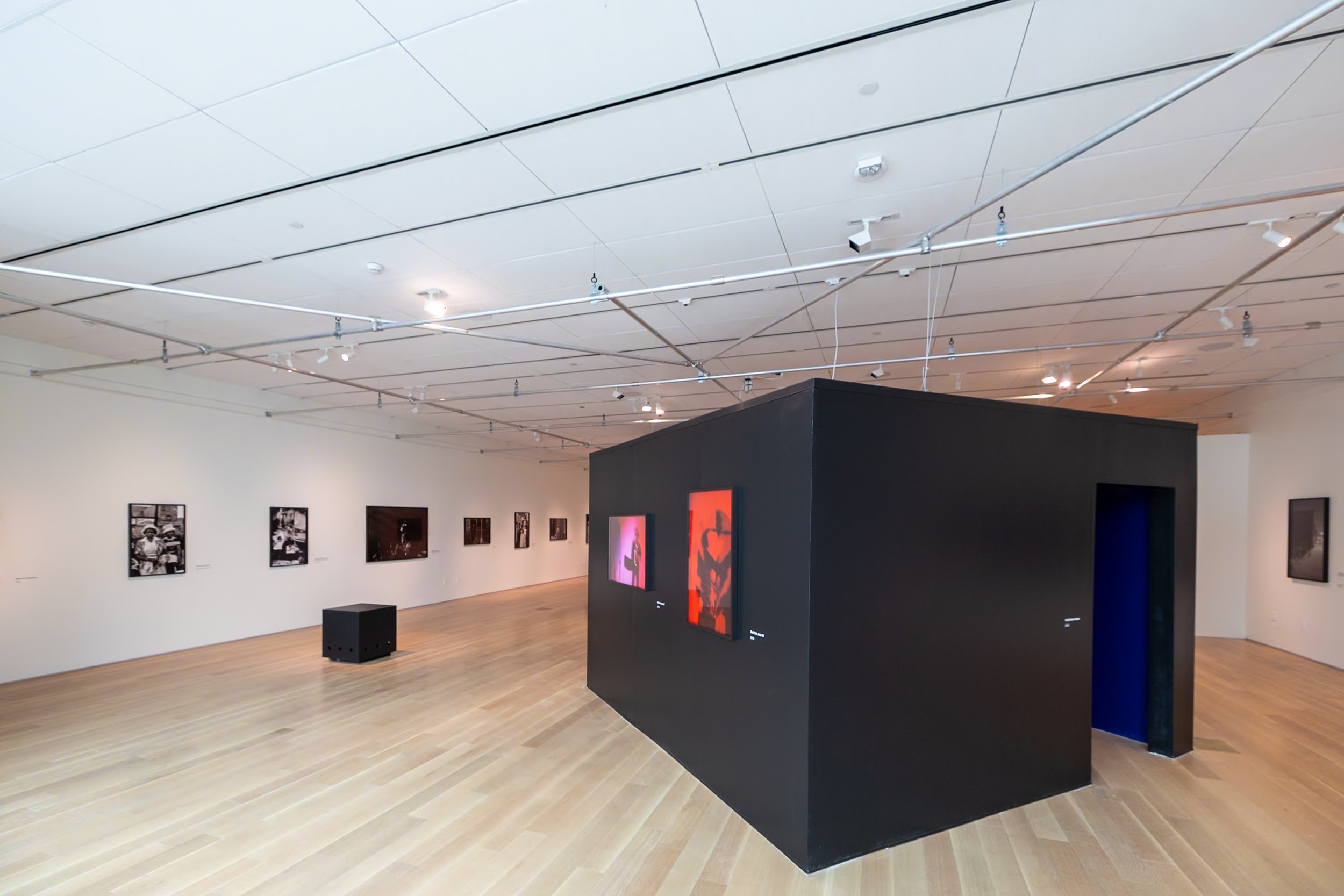
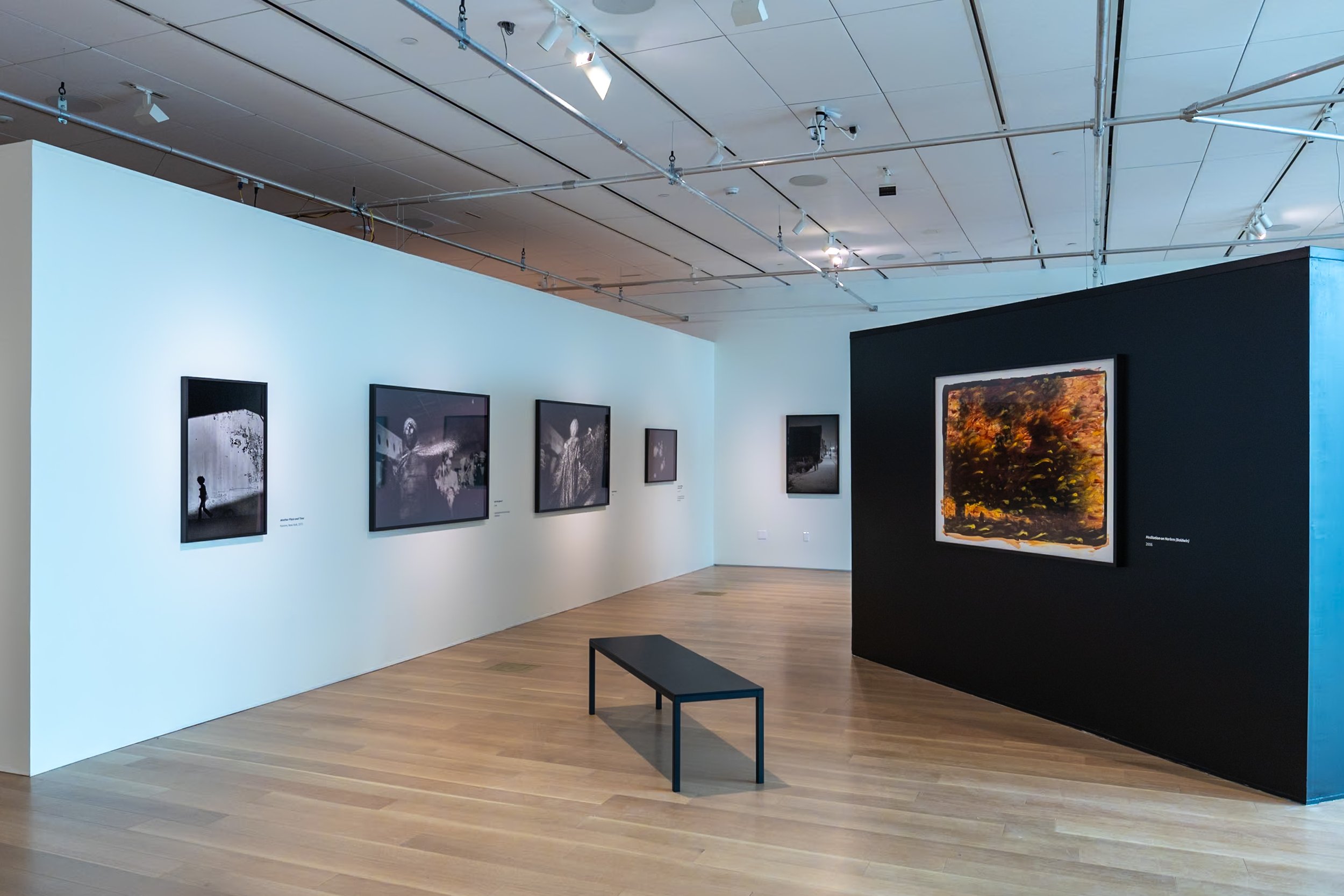

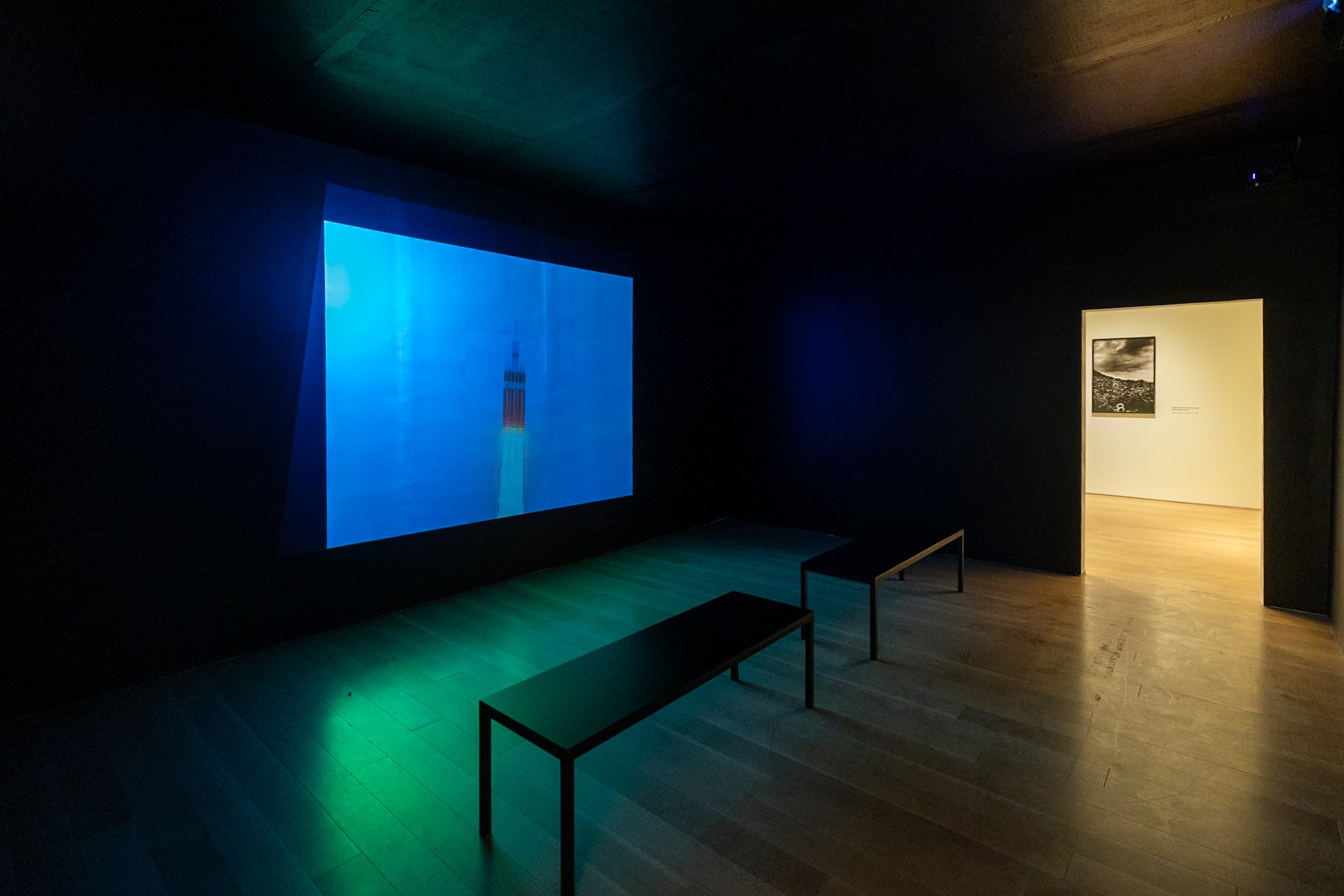
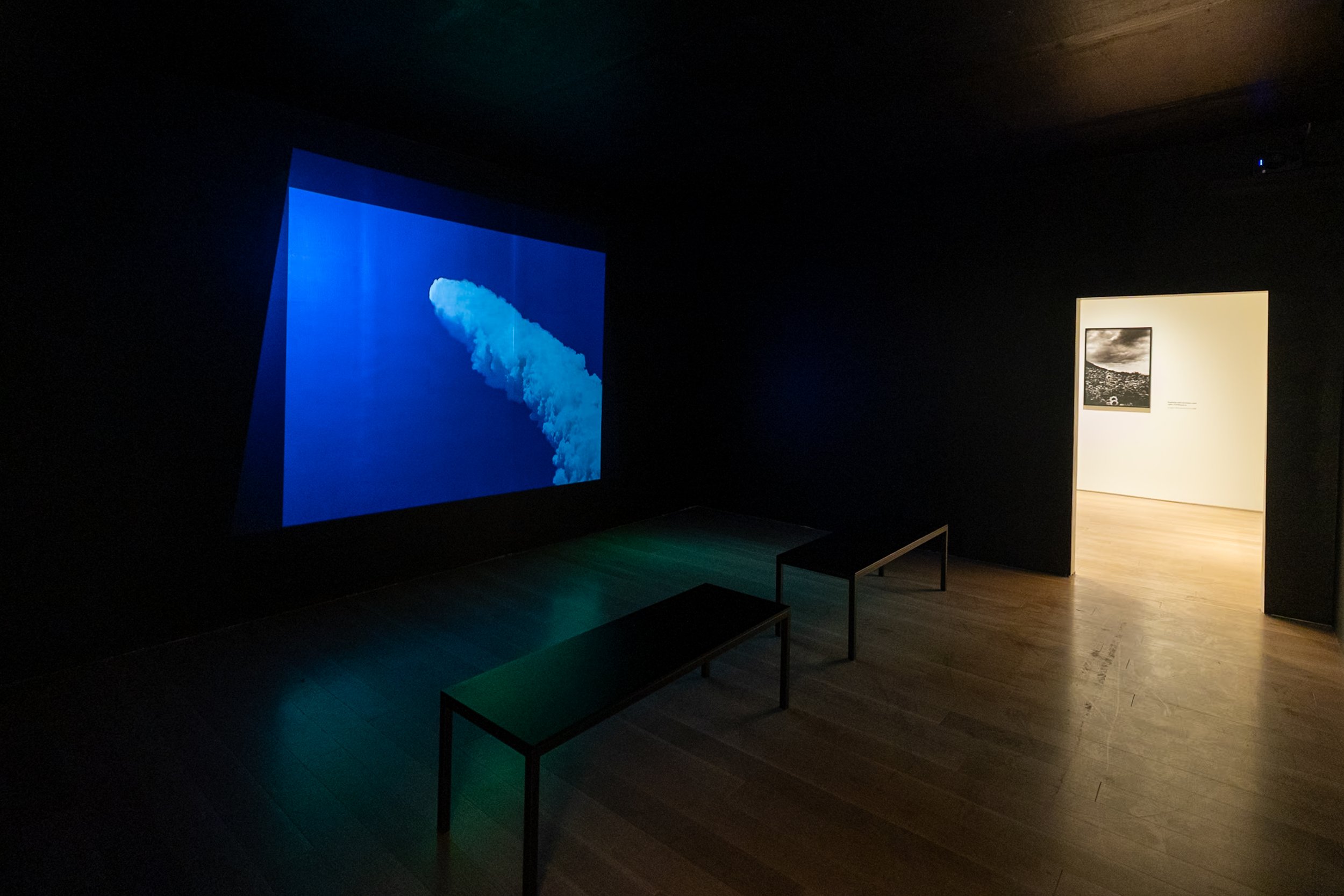
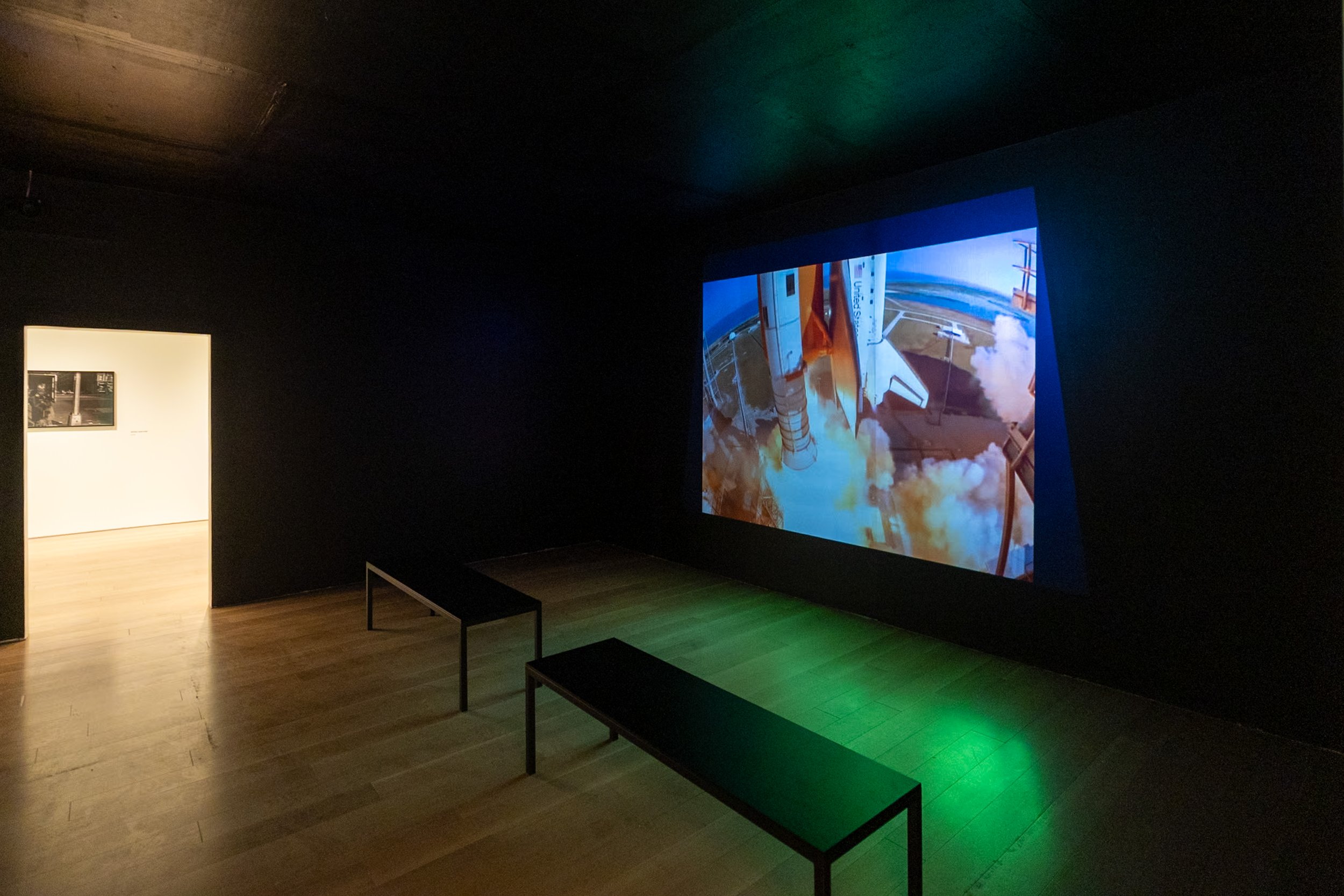
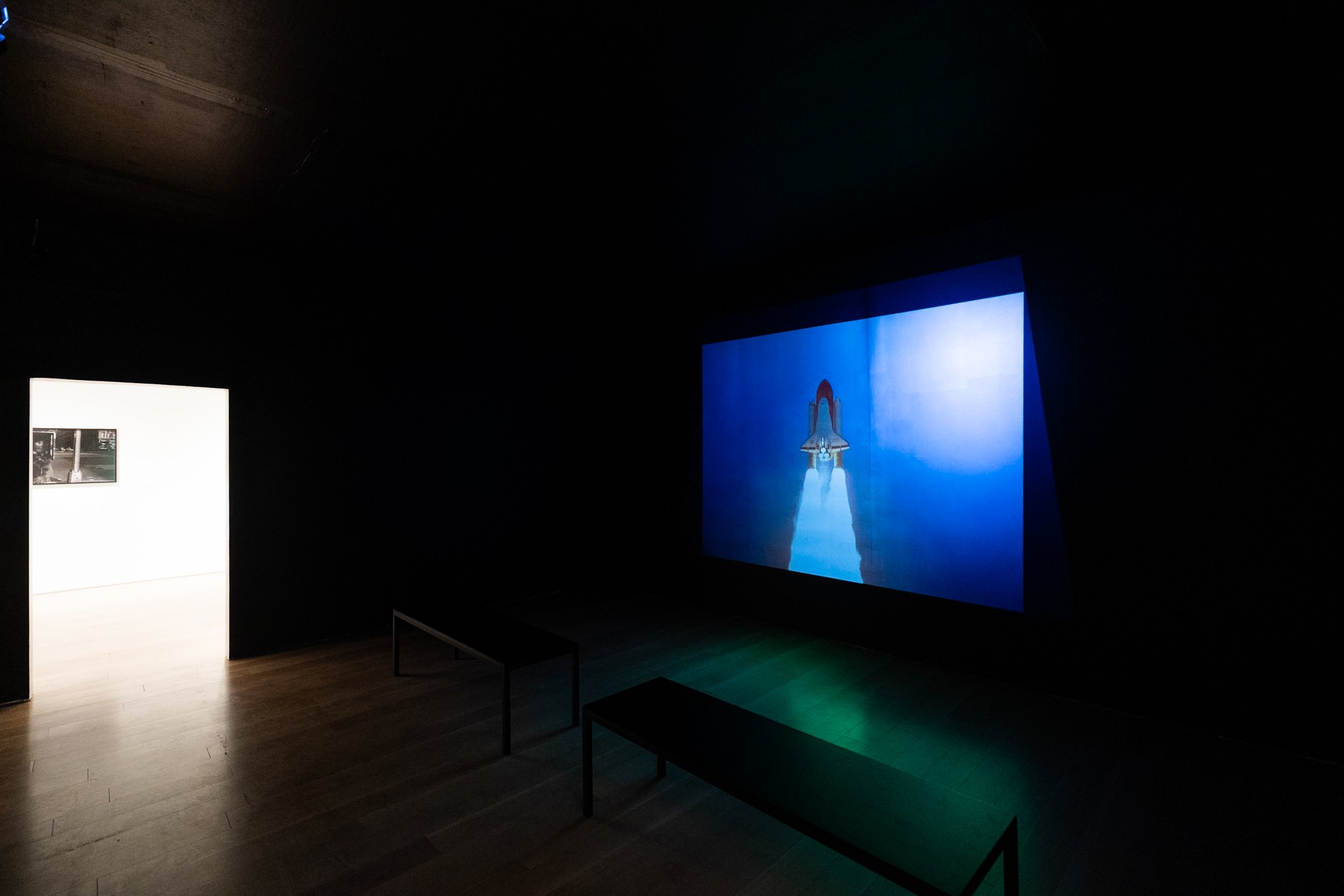
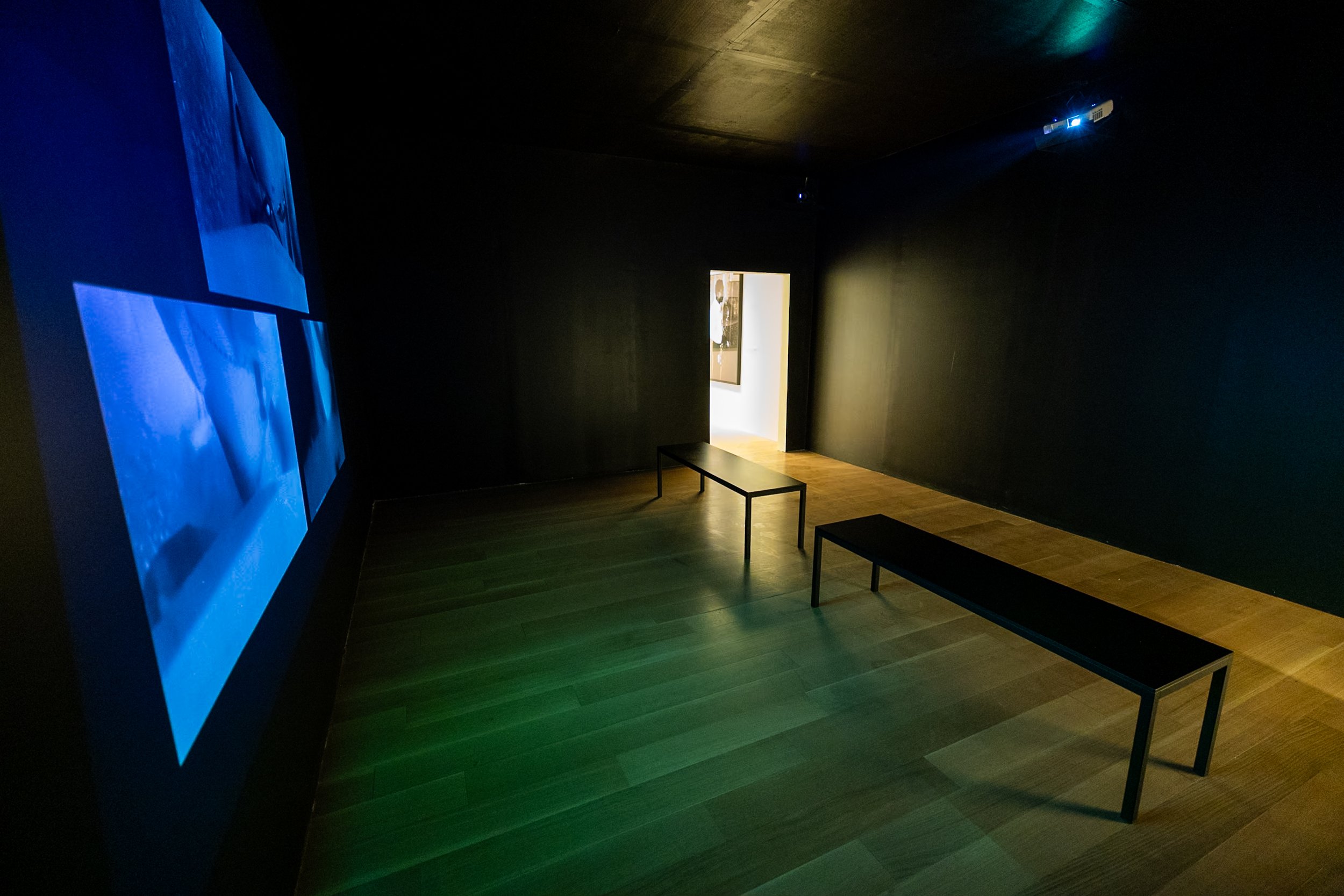
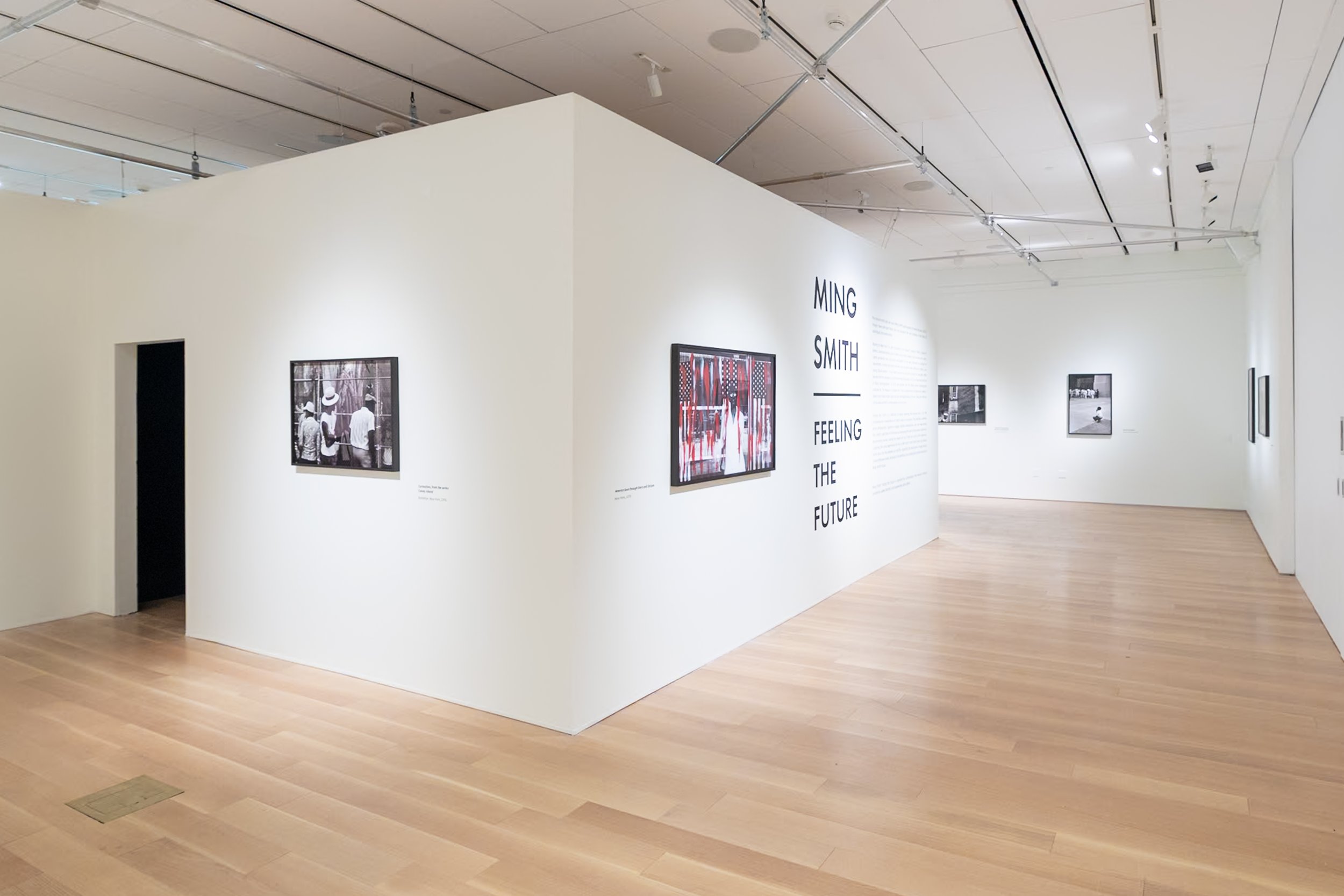
Installation view: Ming Smith: Feeling the Future January 31 through April 28, 2024. The International African American Museum (IAAM), Charleston, South Carolina. Courtesy of The International African American Museum (IAAM)
The International African American Museum (IAAM) explores the history, culture, and impact of the African American journey on Charleston, the nation, and the world, shining light and sharing stories of the diverse journeys, origins, and achievements of descendants of the African Diaspora. Across eleven galleries and a memorial garden with art, objects, artifacts, and multi-media interaction, IAAM is a champion of authentic, empathetic storytelling of American history. As a result, the museum will stand as one of the nation’s newest platforms for the disruption of institutionalized racism as it evolves today. The mission of IAAM is to honor the untold stories of the African American journey at the historically sacred site of Gadsden’s Wharf and beyond.
Installation view: Ming Smith: Feeling the Future January 31 through April 28, 2024. The International African American Museum (IAAM), Charleston, South Carolina. Courtesy of The International African American Museum (IAAM)
Editor's Note: The attached photos include a current picture of Ming Smith photographed by Chanell Stone, courtesy of Aperture, as well as Amen Corner Sisters and Chicago Art Ensemble by Ming Smith, courtesy of IAAM.
Please visit the International African American Museum's website here for more information about its current and future exhibitions.












